Mitral Valve Disease and the
Cavalier King Charles Spaniel
Page 2 -- Research News
-
 Mitral
Valve Disease Main Page
Mitral
Valve Disease Main Page - Research News
- -- 2026
- -- 2025
- -- 2024
- -- 2023
- -- 2022
- -- 2021
- -- 2020
- -- 2019
- -- 2018
- -- 2017
- -- 2016
- -- 2015
- -- 2014
- -- 2013
- -- 2012
- -- 2011
- -- 2010
- -- 2009
- -- 2008
- -- 2007
- -- 2005
- Veterinary Resources -- Page 3
Research News
2026 News
January 2026: Polish researchers summarize the numerous candidate genes and pathways for MVD in cavaliers.
 In a
December 2025 article, a team of Polish veterinary specialists
(Maksymilian Lewicki, Sylwia Barbara Górczyńska-Kosiorz, Piotr
Frydrychowski, Zuzanna Sidoruk, Agnieszka Noszczyk-Nowak [right])
review the current state of knowledge of the potential candidate genes
and signaling and pathways explaining the genetic basis for the
"exceptionally high predisposition" and early onset of myxomatous mitral
valve disease (MVD) in cavalier King Charles spaniels. They include
associations between MVD severity and polymorphisms in these genes:
NEBL, ACE, CDK6, HEPACAM2, COL5A1, and FAH, as well as evidence
implicating TGF-B signaling, serotonin signaling, and extracellular
matrix remodeling pathways. They conclude:
In a
December 2025 article, a team of Polish veterinary specialists
(Maksymilian Lewicki, Sylwia Barbara Górczyńska-Kosiorz, Piotr
Frydrychowski, Zuzanna Sidoruk, Agnieszka Noszczyk-Nowak [right])
review the current state of knowledge of the potential candidate genes
and signaling and pathways explaining the genetic basis for the
"exceptionally high predisposition" and early onset of myxomatous mitral
valve disease (MVD) in cavalier King Charles spaniels. They include
associations between MVD severity and polymorphisms in these genes:
NEBL, ACE, CDK6, HEPACAM2, COL5A1, and FAH, as well as evidence
implicating TGF-B signaling, serotonin signaling, and extracellular
matrix remodeling pathways. They conclude:
"The available literature mentioned in this review strongly supports the view that MMVD is a complex, multigenic disease, with no single high-penetrance mutation responsible for early onset and severe course of the disease identified to date. Instead, a combination of regulatory variants, altered signaling pathways, and breed-specific genetic bottlenecks contribute to disease expression. The polygenic nature of the disease poses a particular breeding challenge. Even with the knowledge currently available, it remains extremely difficult to identify individuals highly predisposed to the disease and eliminate them from breeding. To date, the most effective breeding programs rely on clinical examination of the patient and diagnostic imaging, rather than on the animals' genetic profile."
 EDITOR'S
NOTE: This is a tidy summation of all of the published
research thus far on the t0pic of genetic causes of MVD in the CKCS. Its
conclusion is that we do not have any definitive answers yet, and that a
lot more work needs to be done, including combining genome-wide studies,
transcriptomics, and functioning of cardiac tissue, in order to explain
the early onset of MVD in our breed. We here have very little
expectation that such integrative work will be done. However, focusing
upon TGF-B signaling and serotonin signaling alone may be enough to
point the way to a simpler solution.
EDITOR'S
NOTE: This is a tidy summation of all of the published
research thus far on the t0pic of genetic causes of MVD in the CKCS. Its
conclusion is that we do not have any definitive answers yet, and that a
lot more work needs to be done, including combining genome-wide studies,
transcriptomics, and functioning of cardiac tissue, in order to explain
the early onset of MVD in our breed. We here have very little
expectation that such integrative work will be done. However, focusing
upon TGF-B signaling and serotonin signaling alone may be enough to
point the way to a simpler solution.
RETURN TO TOP
2025 News
December 2025:
FDA finally gives full approval to Vetmedin to delay
onset of CHF in dogs in Stage B2 of MVD.
 On
December 19, 2025, the U. S. Food and Drug Administration announced
that its
2022 conditional approval of Vetmedin (pimobendan) to delay the onset
of congestive heart failure (CHF) in dogs diagnosed with Stage B2 of
mitral valve disease (heart murmur + enlargement) has been upgraded to
full approval. It took Vetmedin's maker, Boehringer Ingelheim Animal
Health USA, 3 years to accummulate enough data to satisfy FDA that full
approval was warranted for this drug, which has been used without FDA
approval since 2016 to treat MVD-affected dogs prior to CHF.
On
December 19, 2025, the U. S. Food and Drug Administration announced
that its
2022 conditional approval of Vetmedin (pimobendan) to delay the onset
of congestive heart failure (CHF) in dogs diagnosed with Stage B2 of
mitral valve disease (heart murmur + enlargement) has been upgraded to
full approval. It took Vetmedin's maker, Boehringer Ingelheim Animal
Health USA, 3 years to accummulate enough data to satisfy FDA that full
approval was warranted for this drug, which has been used without FDA
approval since 2016 to treat MVD-affected dogs prior to CHF.
EDITOR'S NOTE: There still is reason to be cautious about deciding when to start administering this drug to MVD-affected dogs. Vetmedin has been a poison pill for some MVD-affected dogs, to the point of causing acceleration of their MVD and even sudden death. Studies have found that the earlier in the stage of MVD, the riskier it can be for some dogs.
In this 2007 French study, "Comparative Adverse Cardiac Effects of Pimobendan and Benazepril Monotherapy in Dogs with Mild Degenerative Mitral Valve Disease: A Prospective, Controlled, Blinded, and Randomized Study", the researchers found (a) "increased systolic function in the PIMO group by comparison to baseline value as assessed by fractional shortening"; (b) "the maximum area and peak velocity of the regurgitant jet signal increased, whereas these variables remained stable in the BNZ group"; (c) "histologic grades of mitral valve lesions were more severe in the PIMO group than in the BNZ group"; and (d) "acute focal hemorrhages, endothelial papillary hyperplasia, and infiltration of chordae tendinae with glycosaminoglycans were observed in the mitral valves of dogs from the PIMO group but not in those of the BNZ group." They concluded:"This study demonstrates that long-term administration of PIMO in dogs with asymptomatic MVD is associated with an increase in systolic function and, concomitantly, a progressive worsening of MVD with development of specific mitral valve lesions." (Emphasis added.)In this 2005 study "Increased Mitral Valve Regurgitation and Myocardial Hypertrophy in Two Dogs With Long-Term Pimobendan Therapy", normal doses of pimobendan were determined to have increased mitral valve regurgitation and caused ventricular hypertrophy in the dogs in that study.
And, even in the 2016 EPC Study, which concluded that pimobendan was safe and effective for delaying the onset of CHF in MVD-affected dogs with significant left chamber enlargement, 8.4% of the dogs in the pimobendan group died suddenly of cardiac arrest prior to CHF. Here is the maker's own list of Adverse Effects" to Vetmedin:
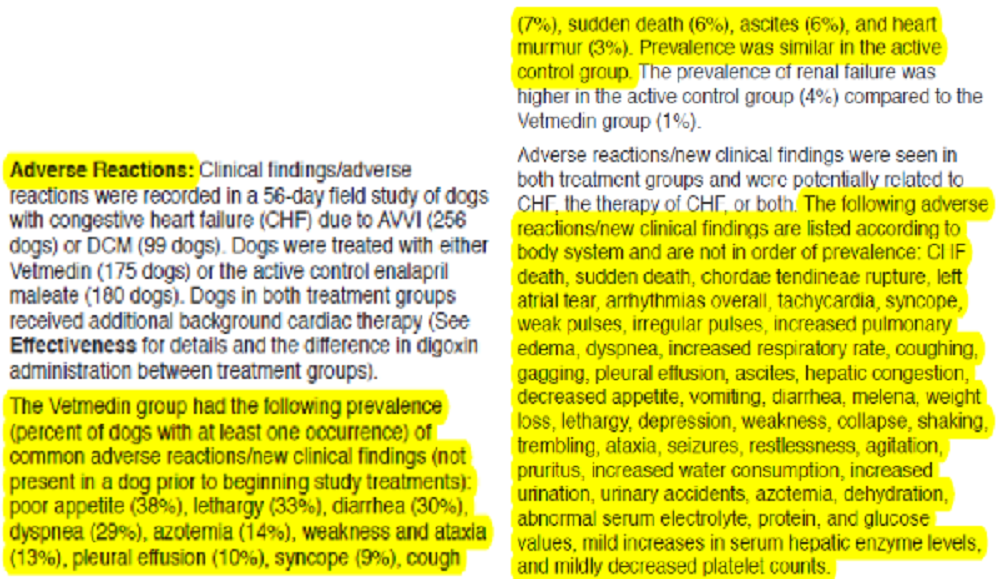
Far too many general practice (GP) veterinarians have been prescribing pimobendan to MVD-dogs far too early in the progression of the disease. A typical horrid example is the GP vet hearing a murmur over the mitral valve and in knee-jerk fashion prescribing the pimobenden without the benefit of either a set of x-rays or echocardiogram. Such vets do not have a clue as to what they are doing, and they put their MVD patients at tremendous risk. If at all possible, only veterinary cardiologists or internal medicine specialists should be making the judgment as to when MVD-affected dogs should be administered pimobendan.
It is best to have your dog examined by a veterinarian within 2 weeks of starting to administer pimobendan. If you notice any odd and troubling reactions to pimobendan, notify your dog's cardiologist immediately. Troubling signs include the heart beats pounding so hard that the dog's chest shakes with each beat, an inability of the dog to settle, and an inability of the dog to lie down and sleep.

December 2025:
Deep learning software, MetronMind, aids veterinarians measure VHS
and VLAS heart sizes of x-rays of cavaliers and other breeds.
 In a
December 2025 article, researchers Sonya G. Gordon, John J.
Craig (right), Sonya Wesselowski, and Alice H. Watson compared traditional
methods of measuring VHS (vertebral heart size) and VLAS (vertebral left
atrium size) on x-rays of 1,058 dogs, including 300 cavalier King
Charles spaniels, with MetronMind, an artificial intelligence deep
learning software program. They report "minimal differences were found
between traditional and modified methods (VHS-T vs VHS-M and VLAS-T and
VLAS-M) that were not of a clinically relevant magnitude." They
concluded:
In a
December 2025 article, researchers Sonya G. Gordon, John J.
Craig (right), Sonya Wesselowski, and Alice H. Watson compared traditional
methods of measuring VHS (vertebral heart size) and VLAS (vertebral left
atrium size) on x-rays of 1,058 dogs, including 300 cavalier King
Charles spaniels, with MetronMind, an artificial intelligence deep
learning software program. They report "minimal differences were found
between traditional and modified methods (VHS-T vs VHS-M and VLAS-T and
VLAS-M) that were not of a clinically relevant magnitude." They
concluded:
"The deep learning enabled software, MetronMind, provided VHS and VLAS measurements which are comparable to a trained observer. Finally, VHS and VLAS measurements from right lateral radiographs failed to agree with those from left lateral radiographs sufficiently enough to be interchangeable. Consequently, right lateral radiographs remain the view of choice for measuring VHS and VLAS."
EDITOR'S NOTE: Author Dr. Sonya G. Gordon is on the advisory board for MetronMind, and author John J. Craig is the chief executive officer of MetronMind.
November 2025:
No homozygous wild-type NEBL gene variants were found in a MVD
study of 371 cavalier King Charles spaniels.
 In a
November 2025 article, Australian and Dutch researchers (Caroline
Melis, Claire Wade, Claudia Rozendom, Frank G. Van Steenbeek
[right], Niek J.
Beijerink) evaluated the wild-type allele frequency of the nebulette
(NEBL) gene in blood samples from 175 cavalier King Charles spaniels in
the Netherlands and from 196 in Australia (371 total), They report
finding that among all of those CKCSs, no dogs were homozygous for the
wild-type allele variants. Only 1 dog (0.57%) from the Netherlands was
heterozygous, and 9 dogs (4.6%) from Australia were heterozygous for the
wild-type allele variants. They acknowledged that another recent study
had identified 9 candidate genes that are associated with longevity in
CKCSs, and that the NEBL gene was not one of them. They concluded that
"selective breeding for the wild-type NEBL allele in the CKCS is nearly
impossible, as it will result in the formation of a severe genetic
bottleneck. Selection of breeding CKCS on wildtype NEBL variants should
not be used on its own due to the low prevalence in this breed and due
to the polygenic character of the disease."
In a
November 2025 article, Australian and Dutch researchers (Caroline
Melis, Claire Wade, Claudia Rozendom, Frank G. Van Steenbeek
[right], Niek J.
Beijerink) evaluated the wild-type allele frequency of the nebulette
(NEBL) gene in blood samples from 175 cavalier King Charles spaniels in
the Netherlands and from 196 in Australia (371 total), They report
finding that among all of those CKCSs, no dogs were homozygous for the
wild-type allele variants. Only 1 dog (0.57%) from the Netherlands was
heterozygous, and 9 dogs (4.6%) from Australia were heterozygous for the
wild-type allele variants. They acknowledged that another recent study
had identified 9 candidate genes that are associated with longevity in
CKCSs, and that the NEBL gene was not one of them. They concluded that
"selective breeding for the wild-type NEBL allele in the CKCS is nearly
impossible, as it will result in the formation of a severe genetic
bottleneck. Selection of breeding CKCS on wildtype NEBL variants should
not be used on its own due to the low prevalence in this breed and due
to the polygenic character of the disease."
EDITOR'S NOTE: There is no surprise here, but there are a couple of interesting side facts to point out. It is unfortunate that in a study like this one, the dogs came from only 2 countries -- the Netherlands and Australia -- making them somewhat insular in different ways. The percentage of heterozygous wild-type NEBL genes was over 8 times more prevalent among the Australian cavaliers than the Dutch dogs. We think we have an explanation. The insularity of the Dutch cohort of dogs could be due to King Charles spaniels having been prevalent in the Netherlands for several centuries. While surely most all cavaliers in Australia originally were imported from the UK over the past century, the Netherlands has had its own stock of handsome CKCSs without need for much or any importation. But the bottom line remains: MAYBE, just MAYBE, the wild-type variant can produce cavaliers which develop less severe cases of MVD. But that possibility has not even been empirically studied in this article or any other one. (See our review of the Australian 2022 study, below.) And, other studies' findings of genes relevant to MVD in the breed have not even come up with NEBL as a prospect.
November 2025:
Dr. Chris Orton reports results of 134 TEER surgeries from 2021
through 2025.
 At
an
October 2025 presentation before the American College of Veterinary
Surgeons (ACVS) summit, Dr. Chris Orton of Colorado State University's
veterinary school (right) updated
his team's transcatheter edge-to-edge device (TEER) statistics
following a total of 134 cases, 35 patients (28%) being cavalier King
Charles spaniels. See this chart (below) from his presentation
for the details about those patients. He reported that 80% of the TEER
dogs were alive a year after their procedure, and 78% were alive after
two years. He said that following TEER, the average sizes of the left
atrium (LA:Ao) and left ventricle (LVIDdN) are reduced, and that some of
them return to the normal range. The regurgitant volume on average is
reduced by more than 50%, and the regurgitation fraction is reduced from
an average of over 60% to as low as 30% a year after the procedure. See,
also, this
December 2025 article.
At
an
October 2025 presentation before the American College of Veterinary
Surgeons (ACVS) summit, Dr. Chris Orton of Colorado State University's
veterinary school (right) updated
his team's transcatheter edge-to-edge device (TEER) statistics
following a total of 134 cases, 35 patients (28%) being cavalier King
Charles spaniels. See this chart (below) from his presentation
for the details about those patients. He reported that 80% of the TEER
dogs were alive a year after their procedure, and 78% were alive after
two years. He said that following TEER, the average sizes of the left
atrium (LA:Ao) and left ventricle (LVIDdN) are reduced, and that some of
them return to the normal range. The regurgitant volume on average is
reduced by more than 50%, and the regurgitation fraction is reduced from
an average of over 60% to as low as 30% a year after the procedure. See,
also, this
December 2025 article.

October 2025:
Severe left atrial
enlargement, but not congestive heart failure, increases the probability
of coughing in MVD-affected small-breed dogs.
 In an
October 2025 article, veterinary cardiologists Mark Rishniw
(right),
Michele Borgarelli, Luca Ferasin, and Giulio Menciotti examined the
effect of left atrial (LA) size and presence or absence of congestive
heart failure (CHF) in small-breed dogs with mitral valve disease on the
probability of coughing. They hypothesized that coughing probability
would increase with increasing left atrial enlargement but not with CHF.
They examined the records of 352 dogs with varying degrees of LA
enlargement, up to severe enlargement, which the categorized as having a
left atrium-to-aortic root ratio (LA:Ao) greater than 2.29. They report
finding that only severe LA enlargement esulted in an increased
probability of coughing in MVD-affected dogs. They found that dogs
lesser degrees of LA enlargement had similar probabilities of coughing
as dogs without any enlargement. They further found that CHF was not an
independent predictor of coughing. They concluded that they found no
evidence that CHF contributes to or increases the probability of
coughing in dogs with MVD and that severe LA enlargement does increase
this probability. They urged that clinicians should not include coughing
(or its absence) when considering whether dogs with MVD have CHF or not.
Specifically, they stated:
In an
October 2025 article, veterinary cardiologists Mark Rishniw
(right),
Michele Borgarelli, Luca Ferasin, and Giulio Menciotti examined the
effect of left atrial (LA) size and presence or absence of congestive
heart failure (CHF) in small-breed dogs with mitral valve disease on the
probability of coughing. They hypothesized that coughing probability
would increase with increasing left atrial enlargement but not with CHF.
They examined the records of 352 dogs with varying degrees of LA
enlargement, up to severe enlargement, which the categorized as having a
left atrium-to-aortic root ratio (LA:Ao) greater than 2.29. They report
finding that only severe LA enlargement esulted in an increased
probability of coughing in MVD-affected dogs. They found that dogs
lesser degrees of LA enlargement had similar probabilities of coughing
as dogs without any enlargement. They further found that CHF was not an
independent predictor of coughing. They concluded that they found no
evidence that CHF contributes to or increases the probability of
coughing in dogs with MVD and that severe LA enlargement does increase
this probability. They urged that clinicians should not include coughing
(or its absence) when considering whether dogs with MVD have CHF or not.
Specifically, they stated:
"Our study should dispel the idea that pulmonary edema causes coughing in dogs with mitral valve disease -- indeed, clinicians should ignore the presence of coughing when making a diagnosis of CHF in dogs with mitral valve disease. Specifically, clinicians cannot make the assumption that a coughing dog with a murmur has CHF -- a diagnostic error that clinicians in first-opinion practice often make. While some dogs with CHF developed a cough only when they presented with CHF, the logistic regression analysis did not identify CHF as an independent predictor of coughing. Furthermore, given that the pattern of probabilities associated with coughing in these dogs mirrored that of dogs with subclinical MMVD, our findings suggested that these dogs quite possibly developed a cough because of their left atrial enlargement, and not the development of CHF per se."
October 2025: Dechra introduces an on-line interactive heart model showing the stages of mitral valve disease. Dechra, a UK veterinary pharmaceutical manufacturer, has introduced an on-line interactive model of a dog's heart affected by mitral valve disesase, showing the interior structural changes in the mitral valve and left atrium and left ventricle, as the MVD progresses from Stage A to B to C to D. The animation is accessible at this link. The image below is a combination of screen shots of the four stages, which are animated on Dechra's website.

September 2025:
Dr. Justin Carlson
reports 49 case studies of MVD-affected dogs treated with
Entresto.
 At
the June 2025 ACVIM Forum,
Dr. Justin Carlson (right) presented
a lecture, "Beyond the Guidelines: Sacubitril/Valsartan (ARNi)
(Entresto)", in which he reported on 49 case studies of
MVD-affected dogs in late Stage C or Stage D ("pretty bad cases that I thought were not
going to do very well"), 7 of which were cavalier King Charles spaniels
(and 7 Maltese and 6 Yorkies). Among those 49 patients in which he
substituted Entresto (sacubitril/ valsartan - S/V) for an ACE-inhibitor
(such as benazepril or enalapril) and spironolactone, their mean
survival time was 474 days, with a median survival time of 381 days, and an
overall survival range from 152 to 1,989 days. He compared those results
to those of the
VALVE Study trial and the
QUEST Study. In the VALVE Study of Stage C dogs (in which the
ACE-inhibitor ramipril was added to the combination of furosemide and
pimobendan), the median survival time was only 214 days.
In the QUEST Study (in which Stage C dogs received either pimobendan or
benazepril), the median survival time was only 267 days
for pimobendan alone. He emphasized that the patients in his group of 49
dogs being treated with S/V were late Stage C or Stage D dogs,
meaning that they were in far worse shape than the Stage C dogs just
developing heart failure which were the subjects of the VALVE and QUEST
studies.
At
the June 2025 ACVIM Forum,
Dr. Justin Carlson (right) presented
a lecture, "Beyond the Guidelines: Sacubitril/Valsartan (ARNi)
(Entresto)", in which he reported on 49 case studies of
MVD-affected dogs in late Stage C or Stage D ("pretty bad cases that I thought were not
going to do very well"), 7 of which were cavalier King Charles spaniels
(and 7 Maltese and 6 Yorkies). Among those 49 patients in which he
substituted Entresto (sacubitril/ valsartan - S/V) for an ACE-inhibitor
(such as benazepril or enalapril) and spironolactone, their mean
survival time was 474 days, with a median survival time of 381 days, and an
overall survival range from 152 to 1,989 days. He compared those results
to those of the
VALVE Study trial and the
QUEST Study. In the VALVE Study of Stage C dogs (in which the
ACE-inhibitor ramipril was added to the combination of furosemide and
pimobendan), the median survival time was only 214 days.
In the QUEST Study (in which Stage C dogs received either pimobendan or
benazepril), the median survival time was only 267 days
for pimobendan alone. He emphasized that the patients in his group of 49
dogs being treated with S/V were late Stage C or Stage D dogs,
meaning that they were in far worse shape than the Stage C dogs just
developing heart failure which were the subjects of the VALVE and QUEST
studies.
Dr. Carlson said that the owners of 39 of his 49 patients (80%) reported their dogs had noticeably improved energy levels. The owners of 28 of the dogs (57%) reported that their dogs were coughing less. He found that "in a lot of these dogs", the S/V allowed for the safe reduction of diuretics, and in "a handful of these dogs", he has since stopped any diuretic medications, and "they are doing great." He reported that, over time, there was "a statistically significant difference" in the sizes of the left ventricle and left atrial ratio. He found in some dogs that over time their left atriums were back to normal in size.
As for adverse effects, he had only 2 of the 49 dogs with gastrointestinal distress. As for renal values, only one patient had significant worsening renal values, with 3 having increased azotemia in 4 months and 5 having significantly decreased renal values after 4 months.
Dr. Carlson recommends "up-titration" of dosages of S/V, meaning starting at a low dosage and then increasing it, over 2 to 4 weeks, depending upon the dog's response and the blood test results. He stops both ACE-inhibitors and spironolactone when he starts the S/V, waiting 36 hours. His recommended dosage range in 15-30 mg/kg twice a day.
In a paper presented at the 2025 ACVIM Forum, cardiologists Ryan Fries, Elizabeth Malcolm, Sonya Gordon, and Justin Carlson wrote:
"When utilizing Entresto in a group of canine patients (n=49) with congestive heart failure secondary to myxomatous mitral valvular disease or dilated cardiomyopathy, Entresto was well tolerated, with fewer than 5% of patients having undesirable side effects when titrated appropriately. While a FETCH questionnaire was not completed on patients, there was an overwhelming owner-noted improvement to the patients' quality of life when optimal dosing of Entresto was achieved based on owner report history during follow-up. Up-titration of the medication was done over the span of 1-6 weeks in most patients, with some patients requiring an extended up-titration over multiple months. Survival, echocardiographic, and dose-response data will be presented in a future manuscript. Based on the encouraging data from this cohort of patients, the optimal dosing, timing of up-titration, and ideal start time in patient disease stage warrant further study in a prospective manner."
 EDITOR'S
NOTE: All of this information certainly is the best of
good news for affected dogs in the late stages of MVD and in
declining cardiac health. We look forward to that "future
manuscript", and hopefully it will be in the very near future. Far
too many board certified veterinary cardiologists still profess
ignorance about Entresto and its value in slowing the progression of
MVD in the late stages. Incredibly, a just released major
canine cardiology
reference manual, published for veterinarians, fails to even
mention Entresto at all.
EDITOR'S
NOTE: All of this information certainly is the best of
good news for affected dogs in the late stages of MVD and in
declining cardiac health. We look forward to that "future
manuscript", and hopefully it will be in the very near future. Far
too many board certified veterinary cardiologists still profess
ignorance about Entresto and its value in slowing the progression of
MVD in the late stages. Incredibly, a just released major
canine cardiology
reference manual, published for veterinarians, fails to even
mention Entresto at all.
As for "further study in a prospective manner", don't hold your breath. When a miracle drug like this one arrives on the scene, it becomes very difficult to find volunteers for the control group in such studies. A valuable topic of such a study would be the earliest stage in which Entresto can be safely and effectively started. Avoiding Stage C (congestive heart failure) entirely is a commendable target goal.
September 2025:
Heart surgeons successfully use taut-line hitch knot to adjust
artificial chordae lengths in open heart surgery on a cavalier.
 In
a
September 2025 article, Turkish cardiologists Murat Vurucu
(right), Aykut Cokogullu, and Bugra Ozcan performed open heart
mitral valve repair surgery on a cavalier King Charles spaniel in heart
failure with severe mitral regurgitation. The dog's pre-operative vitals
included vertebral heart score (VHS) of 15.0, left atrial-to-aortic root
ratio (LA/Ao) of 2.87, and left ventricular internal diameter in
diastole (LVIDd) of 46.1 mm. They performed semi-circular suture
annuloplasty and chordal reconstruction using ePTFE sutures. Artificial
chordae lengths were adjusted using a modified taut-line hitch (TLH)
knot technique. The taut-line hitch (left) is a nautical knot
with an adjustable loop for lines under tension. It can be re-adjusted
periodically to maintain
In
a
September 2025 article, Turkish cardiologists Murat Vurucu
(right), Aykut Cokogullu, and Bugra Ozcan performed open heart
mitral valve repair surgery on a cavalier King Charles spaniel in heart
failure with severe mitral regurgitation. The dog's pre-operative vitals
included vertebral heart score (VHS) of 15.0, left atrial-to-aortic root
ratio (LA/Ao) of 2.87, and left ventricular internal diameter in
diastole (LVIDd) of 46.1 mm. They performed semi-circular suture
annuloplasty and chordal reconstruction using ePTFE sutures. Artificial
chordae lengths were adjusted using a modified taut-line hitch (TLH)
knot technique. The taut-line hitch (left) is a nautical knot
with an adjustable loop for lines under tension. It can be re-adjusted
periodically to maintain
 tension
and is particularly useful in setting the proper tension of a series of
chordae supporting the mitral valve during repair surgery. The surgery
was successful, and 3 months post-surgery vitals were reduced to VHS =
12.0, LA/Ao = 1.78, and LVIDd = 33.3 mm. At the long-term follow-up a
year later, no clinical signs of congestive heart failure were observed.
tension
and is particularly useful in setting the proper tension of a series of
chordae supporting the mitral valve during repair surgery. The surgery
was successful, and 3 months post-surgery vitals were reduced to VHS =
12.0, LA/Ao = 1.78, and LVIDd = 33.3 mm. At the long-term follow-up a
year later, no clinical signs of congestive heart failure were observed.
August 2025:
Study on correlation between cardiac cough and radiographic
signs leads to grossly exaggerated conclusion.
 In an
August 2025 article, an international team of radiographic
researchers (Kira Y. van Opstal, Mark D. Kittleson, Erik Teske, Edoardo
Auriemma, Henk van den Broek, Giliola Spattini, Federico R. Vilaplana
Grosso, Viktor Szatmári [right]) investigated the relationship between chronic
cough and radiographic signs of bronchial narrowing (i.e., compression
or collapse) in dogs with cardiomegaly and severe left atrial
enlargement due to mitral valve disease (MVD). Four radiographers
examined 26 sets of static x-rays of MVD-affected dogs with chronic
coughing and 25 without such coughing. Of 14 breeds, 18 of the 51 sets
of x-rays were of cavalier King Charles spaniels, the breed with the
most dogs in the study. They report finding
that "dogs with and without cough exhibit similar frequencies of severe
bronchial narrowing, making radiographic identification of these changes
meaningless for predicting cough status."
In an
August 2025 article, an international team of radiographic
researchers (Kira Y. van Opstal, Mark D. Kittleson, Erik Teske, Edoardo
Auriemma, Henk van den Broek, Giliola Spattini, Federico R. Vilaplana
Grosso, Viktor Szatmári [right]) investigated the relationship between chronic
cough and radiographic signs of bronchial narrowing (i.e., compression
or collapse) in dogs with cardiomegaly and severe left atrial
enlargement due to mitral valve disease (MVD). Four radiographers
examined 26 sets of static x-rays of MVD-affected dogs with chronic
coughing and 25 without such coughing. Of 14 breeds, 18 of the 51 sets
of x-rays were of cavalier King Charles spaniels, the breed with the
most dogs in the study. They report finding
that "dogs with and without cough exhibit similar frequencies of severe
bronchial narrowing, making radiographic identification of these changes
meaningless for predicting cough status."
Their main conclusion was that "subjective radiographic signs of severe left principal bronchial narrowing do not reliably predict chronic cough in dogs with cardiomegaly and LA [left atrial] dilation secondary to severe MR [mitral regurgitation]." Nevertheless, they went on to reach the further conclusion that "Bronchial compression by an enlarged heart and left atrium is an unlikely cause of chronic cough in dogs with severe primary mitral valve regurgitation." They acknowledged that limitations in their study included the fact that they did not make use of dynamic radiographic imaging, such as such as computed tomography, fluoroscopy, or bronchoscopy. Since the cardiac cycle is dynamic, it has a constant and significant effect upon imaging the size of the heart, and static x-rays are but a snapshot of one of a variation of dimensions of the heart as it beats through each cycle. Also, there was no effort to obtain such a static image at a point when the dog was engaged in its cough, in order to determine the actual role the LA played at the time each cough occurred.
EDITOR'S NOTE: What we have here is a failure to associate the researchers' data and findings with their conclusion. In other words, they accurately acknowledge that snapshot x-rays "do not reliably predict chronic cough in dogs with cardiomegaly and LA [left atrial] dilation secondary to severe MR [mitral regurgitation]" (at least in 26 sets of x-rays). But they don't stop there. They go on to falsely claim that, therefore:
"Bronchial compression by an enlarged heart and left atrium is an unlikely cause of chronic cough in dogs with severe primary mitral valve regurgitation." They expand their disassociation between the evidence and their bogus conclusion by stating: "This might make the term 'cardiac cough' redundant." They wish, apparently! They show no factual basis for that incredible stretch of a conclusion. They thus are engaging in a form of tabloid journalism, stating their very limited findings but then grossly exaggerating their conclusion. Either that, or un-edited Artifical Intelligence (AI) has played a role in the drafting of this article. The end effect of this is wasting everyone's time.
August 2025:
Revised MINE (Mitral INsufficiency Echocardiographic) scoring
deletes fractional shortening from the equation in predicting severity
of MVD in dogs.
 In an
August 2025 article, the team of Italian veterinary cardiology
researchers who devised the
MINE (Mitral INsufficiency
Echocardiographic) scoring system in 2021 (Tommaso Vezzosi
[right], Giovanni
Grosso, Liva Vatne, Francesco Porciello, Elena Dall'Aglio, Carlo
Guglielmini, Helena Broch, Dave Dickson, Marta Croce, Valentina Patata,
Federica Marchesotti, Rosalba Tognetti, Mark Rishniw, Oriol Domenech)
have re-examined their MINE formulation using 749 dogs, including 129
(17.2%) cavalier King Charles spaniels. The original MINE formula
includes our echocardiographic measurements -- (1) the left
atrium-to-aorta ratio (LA/Ao); (2) the left ventricular end-diastolic
diameter normalized for body weight (LVIDDn); (3) the left ventricular
fractional shortening (FS); and (4) the E-wave transmitral peak velocity
(E-vel) -- that have been associated with survival
In an
August 2025 article, the team of Italian veterinary cardiology
researchers who devised the
MINE (Mitral INsufficiency
Echocardiographic) scoring system in 2021 (Tommaso Vezzosi
[right], Giovanni
Grosso, Liva Vatne, Francesco Porciello, Elena Dall'Aglio, Carlo
Guglielmini, Helena Broch, Dave Dickson, Marta Croce, Valentina Patata,
Federica Marchesotti, Rosalba Tognetti, Mark Rishniw, Oriol Domenech)
have re-examined their MINE formulation using 749 dogs, including 129
(17.2%) cavalier King Charles spaniels. The original MINE formula
includes our echocardiographic measurements -- (1) the left
atrium-to-aorta ratio (LA/Ao); (2) the left ventricular end-diastolic
diameter normalized for body weight (LVIDDn); (3) the left ventricular
fractional shortening (FS); and (4) the E-wave transmitral peak velocity
(E-vel) -- that have been associated with survival
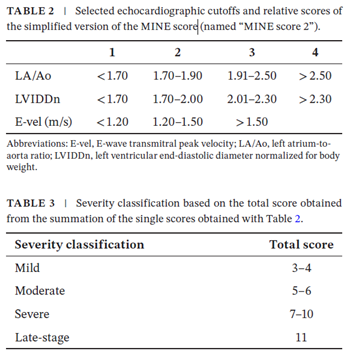 in MVD-affected dogs.
The researchers revised "MINE 2" formula eliminates fractional
shortening (FS) percentage because they have found that FS% "did not
show independent association with cardiac outcomes in the current
investigation. Therefore their simplified "MINE 2" formula is limited to
three measurements -- LA:Ao, LVIDdN, and E-vel. The researchers also
create a sub-category of Stage B2 of MVD, formerly described as "severe"
Stage B2 to now "advanced" Stage B2, meaning being at high risk for
reaching congestive heart failure (CHF). Tables 2 and 3 (at left) show
the researchers' MINE score 2 cut-offs for MVD-affected dogs in Stage
B2. The researchers also suggest that by classifying a severe MINE 2
score, clinical trials using that classification could evaluate such
dogs benefitting from "supplementary treatment in addition to
pimobendan." Presumably they mean adding a diuretic before the dog
reaches CHF.
in MVD-affected dogs.
The researchers revised "MINE 2" formula eliminates fractional
shortening (FS) percentage because they have found that FS% "did not
show independent association with cardiac outcomes in the current
investigation. Therefore their simplified "MINE 2" formula is limited to
three measurements -- LA:Ao, LVIDdN, and E-vel. The researchers also
create a sub-category of Stage B2 of MVD, formerly described as "severe"
Stage B2 to now "advanced" Stage B2, meaning being at high risk for
reaching congestive heart failure (CHF). Tables 2 and 3 (at left) show
the researchers' MINE score 2 cut-offs for MVD-affected dogs in Stage
B2. The researchers also suggest that by classifying a severe MINE 2
score, clinical trials using that classification could evaluate such
dogs benefitting from "supplementary treatment in addition to
pimobendan." Presumably they mean adding a diuretic before the dog
reaches CHF.
EDITOR'S NOTE: Ho-hum. The initial version of MINE, back in 2021, never impressed us, for more than a couple of reasons. The two main measurements of MINE are LA:Ao and LVIDdN, using the totally false and repeatedly disproven assumption that LA:Ao = 1.6 defined an enlarged left atrium in all dogs of all breeds, and that LVIDdN = 1.7 likewise defined an enlarged left ventricle in all dogs of all breeds. The evidence disproving those assumptions being species-wide is 100%. If you want to know whether the left atrium (LA) is getting larger, you compare measurements of the LA over time, and if the later measurement of the LA is significantly larger than the earlier one, you have confirmation that, indeed yes, that LA is getting larger and therefore the MVD is progressing.
One other troublesome reality about the LA:Ao ratio is that the Ao (abbreviation for the measurement of the dog's aortic root) is not a constant. The LA itself could be of the exact same measurement in both echo exams, taken months or years apart, but if the dimension of the Ao in the later echo exam is smaller than it was in the earlier one, the later LA:Ao will be higher than the previous one, and to the unobservant cardiologist, that would conclusively (and totally inaccurately) establish progression of the MVD. Reliance upon the LVIDdN has similar deficiencies. One is the choice of exponent used in the rather complicated formula to arrive at the LVIDdN. There are at least 3 to choose from. Which one to choose is debatable and breed-specific.
Cardiologists who look for easy answers using faulty reasoning do not impress us. If they just would compare earlier, baseline measurements, with current ones, such as the previous diameter of the LA wuth the latest one, they would have the answer to the question (Has the heart enlarged?) without all of the algebraic equations relying upon repeatedly falsifed species-wide assumptions, such as this one, MINE Score 2.
Apparently a motivation of these researchers is to predict "the time to cardiac endpoint", which can mean the onset of congestive heart failure (CHF) or cardiac death, depending upon the examiner's morbidity code. We never have understood this obsession which some -- indeed many -- cardiologists seem to have with predicting when their patients are expected to die. And they seem compelled to share their predictions with their patients' owners, even when that is the last bit of information which the owners would ever consider wanting to have. Perhaps because all of our MVD experiences have been limited to cavaliers, and in all such cases, the dogs advanced to Stage C and died of MVD, we assume such progression will occur in 100% of cases and keep being aware of outward signs of the onset of CHF, particularly average sleeping respiratory rates above 29 breaths per minute.
August 2025: Study
comparing three combination medications treating 211 Stage C (heart
failure) MVD-affected dogs made no significant difference in terms of
cardiac death.
 In
an
August 2025 article, Italian researchers (Giovanni Romito
[right], Sara Ghilardi, Chiara Mazzoldi, Fabio Maria Colombo,
Giulia Ciprian, Mara Bagardi, Chiara Locatelli, Paola Giuseppina
Brambilla) compared the results of treating 211 dogs diagnosed to be in
heart failure (Stage C) due to mitral valve disease (MVD), which were
treated with three combinations of medications. Thirty of the dogs were
cavalier King Charles spaniels (14%), the breed with the most dogs in
the study. The combinations were (1) dual therapy -- DT (furosemide and
pimobendane) 65 dogs, (2) triple therapy -- TT (furosemide, pimobendan,
and benazepril) 105 dogs, and (3) quadruple therapy -- QT (furosemide,
pimobendan, benazepril, and spironolactone) 41 dogs. All of the dogs
were being treated at veterinary schools in Italy. The researchers
report that no statistically significant differences were observed among
the DT, TT, and QT. They found that the QT and TT did not provide a
higher clinically evident cardiac protective effect compared to DT. They
concluded that DT was not inferior to TT and QT in terms of cardiac
death in dogs with Stage C MVD included in this study.
In
an
August 2025 article, Italian researchers (Giovanni Romito
[right], Sara Ghilardi, Chiara Mazzoldi, Fabio Maria Colombo,
Giulia Ciprian, Mara Bagardi, Chiara Locatelli, Paola Giuseppina
Brambilla) compared the results of treating 211 dogs diagnosed to be in
heart failure (Stage C) due to mitral valve disease (MVD), which were
treated with three combinations of medications. Thirty of the dogs were
cavalier King Charles spaniels (14%), the breed with the most dogs in
the study. The combinations were (1) dual therapy -- DT (furosemide and
pimobendane) 65 dogs, (2) triple therapy -- TT (furosemide, pimobendan,
and benazepril) 105 dogs, and (3) quadruple therapy -- QT (furosemide,
pimobendan, benazepril, and spironolactone) 41 dogs. All of the dogs
were being treated at veterinary schools in Italy. The researchers
report that no statistically significant differences were observed among
the DT, TT, and QT. They found that the QT and TT did not provide a
higher clinically evident cardiac protective effect compared to DT. They
concluded that DT was not inferior to TT and QT in terms of cardiac
death in dogs with Stage C MVD included in this study.
EDITOR'S NOTE: This type of research -- a retrospective study -- is fraught with downsides. In this case, in particular, the number of dogs is quite low. While 211 dogs may seem like a lot, they are divided between 3 categories. All of these dogs are Italian therefore limited by insularity. And, most importantly to us, there were only 30 cavaliers, again, all Italian. So, the study is interesting, and it tends to confirm The VALVE Study's results, but it is not meaningful research in terms of limiting CHF medications to pimobendan and furosemide (DT).
In The VALVE Study, a team of German and Swiss researchers compared treating MVD-affected dogs in congestive heart failure (CHF - Stage C) with and without the ACE-Inhibitor ramipril. They divided 158 dogs (only 8 cavaliers - 5%) diagnosed with MVD and in CHF into two groups. Group DT (double therapy) consisted of 77 dogs (including 4 cavaliers - 5%) treated with furosemide (Lasix) and pimobendan (Vetmedin). Group TT (triple therapy) included 79 dogs (4 CKCSs - 5%) treated also with ramipril. They hypothesized that the addition of the ACE-Inhibitor would extend the survival time compared to the double therapy group. They found and concluded:
"In conclusion, the addition of an ACEI [ACE-Inhibitor] to pimobendan and a diuretic, as recommended in the ACVIM guidelines for the treatment of chronic stage C MMVD, did not have a significant effect on survival time in dogs with CHF caused by MMVD. Therefore, recommending TT as standard treatment for such dogs does not seem justified.Indeed, the results of this study showed that not including ramipril extended the average survival time by 41 days longer than adding the ACE-Inhibitor to the treatment cocktail. In effect, ramipril caused the MVD to progress more rapidly than just treating with a diuretic and pimobendan.
August 2025:
ForteGold combines torsemide, pimobendan, enalapril, and
spironolactone in one tablet.
 In an
August 2025 article, Korean researchers (Jiyoung Park, Jiyoon Lee,
Sang-Joon Lee, Changbaig Hyun [right]) studied the effectiveness of a tablet
(ForteGold) which combined one pill a fixed dose of four drugs typically
prescribed for dogs in Stage C of mitral valve disease (MVD): torsemide
(0.2mg), pimobendan (0.6mg), enalapril maleate (1.0mg), and
spironolactone (2.0mg), dosed at one tablet per 2kg of body weight,
administered twice daily, over 56 days, compared with single doses of
the same drugs in a compounded powder form, to 28 dogs in each
group. Torsemide is a diuetic which rarely is prescribed initially and
instead is switched for furosemide if and when furosemide begins to fail
being effective. Apart from that, this combination of medications is a
standard tratement, often called an MVD cocktail or "quad therapy". The authors report
that:
In an
August 2025 article, Korean researchers (Jiyoung Park, Jiyoon Lee,
Sang-Joon Lee, Changbaig Hyun [right]) studied the effectiveness of a tablet
(ForteGold) which combined one pill a fixed dose of four drugs typically
prescribed for dogs in Stage C of mitral valve disease (MVD): torsemide
(0.2mg), pimobendan (0.6mg), enalapril maleate (1.0mg), and
spironolactone (2.0mg), dosed at one tablet per 2kg of body weight,
administered twice daily, over 56 days, compared with single doses of
the same drugs in a compounded powder form, to 28 dogs in each
group. Torsemide is a diuetic which rarely is prescribed initially and
instead is switched for furosemide if and when furosemide begins to fail
being effective. Apart from that, this combination of medications is a
standard tratement, often called an MVD cocktail or "quad therapy". The authors report
that:
"Both groups exhibited significant improvements in clinical signs, including exercise intolerance, appetite, respiratory effort, and coughing, with the ForteGold group showing earlier and more sustained responses. Blood chemistry and electrolyte levels remained within normal ranges, indicating a favorable safety profile. Radiographic assessments revealed a gradual decrease in vertebral heart score and normalization of lung fields by Day 56 in both groups. Echocardiographic parameters (LA/Ao, LVIDd/Ao, MVE) improved significantly, with the ForteGold group demonstrating earlier enhancements. NT-proBNP levels decreased in both groups, with a more pronounced reduction in the ForteGold group. No significant changes were observed in SDMA and cPL levels, suggesting stable renal and pancreatic functions."
They concluded that "The fixed-dose combination tablet (Sentorphil® ForteGold) offers a clinically effective and safer alternative to compounded powdered medications for managing MMVD in dogs. Its formulation ensures accurate dosing, improved owner compliance, and enhanced clinical outcomes."
EDITOR'S NOTE: If ever there could be a more impractical gimmick proposed to treat MVD-affected dogs, we cannot imagine what it would be. The main drawbacks to ForteGold are: (1) rarely are Stage C dogs started out with toresemide as the prescribed diuretic. Maybe in Korea, but not in the rest of the world, the go-to first choice of a duretic is furosemide. And (2) when the dosages are so limited in a combination form of four drugs, the cardiologist loses the options of varying the doses of each drug for each patient.
But the most disturbing gimmick in this study is that the researchers did not compare their multi-tablet with the brand-name drugs produced by their original patent holders. In other words, the "control group" of 28 dogs were given "compounded powdered" versions of those drugs, presumably prepared by an independent pharmacy, and not the brand-name torsemide tablet, or the Boehringer Ingelheim Vetmedin tablet, and so on. As noted by the authors in their article, "compounded powdered mixtures, which may lead to dosing inaccuracies and reduced compliance." As they stated specifically:"In many Asian veterinary settings, cardiac medications are frequently compounded into powdered mixtures to simplify administration. However, this practice introduces variability in drug bioavailability, absorption, and dosing consistency. Inaccurate preparation and poor owner compliance can compromise therapeutic outcomes and increase the risk of side effects or treatment failure."So, this study may have relevance only to a limited territory of the world. But as for the rest of us, if we can obtain brand-name pills for each of the four ingredients, the flexibility that various dosages offer should trump this fixed-dosage combination tablet.
July 2025:
BENEFIT Project shows echocardiographers follow no single,
standard method of measuring left atrium size.
 In a
July 2025 article called The BENEFIT Project, an international
team of veterinary cardiologists (Momo Yu-Wen Kuo [right] , M.
Dirven; J. Haggstrom; S.G. Gordon; K. Hoglund; E. Cote; T.-L. Lu; M.
Rishniw; Y.-W. Hung; I. Ljungvall) polled 533 echocardiographers (which
included cardiologists, radiologists, and other echo specialists) to
determine their methods of measuring the size of the left atrium (LA) of
dogs. The LA is one of the two left chambers of the dogs' hearts which
may enlarge during the progression of mitral valve disease. Changes in
the size of the LA determine if and when the dog should be
In a
July 2025 article called The BENEFIT Project, an international
team of veterinary cardiologists (Momo Yu-Wen Kuo [right] , M.
Dirven; J. Haggstrom; S.G. Gordon; K. Hoglund; E. Cote; T.-L. Lu; M.
Rishniw; Y.-W. Hung; I. Ljungvall) polled 533 echocardiographers (which
included cardiologists, radiologists, and other echo specialists) to
determine their methods of measuring the size of the left atrium (LA) of
dogs. The LA is one of the two left chambers of the dogs' hearts which
may enlarge during the progression of mitral valve disease. Changes in
the size of the LA determine if and when the dog should be
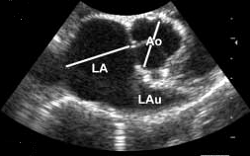 medicated
with pimobendan. They noted that the size of the LA varies during the
cardiac cycle, and that the timing influences LA measurements. In
addition, they report finding that the results from the study
demonstrate that even when echocardiographers obtain the same view to
assess LA size, considerable variation exists in image acquisition,
selection, and caliper placement, which may inevitably result in
increased variability in LA (and aortic root) measurements. This is
called interobserver variation.
medicated
with pimobendan. They noted that the size of the LA varies during the
cardiac cycle, and that the timing influences LA measurements. In
addition, they report finding that the results from the study
demonstrate that even when echocardiographers obtain the same view to
assess LA size, considerable variation exists in image acquisition,
selection, and caliper placement, which may inevitably result in
increased variability in LA (and aortic root) measurements. This is
called interobserver variation.
EDITOR'S NOTE: This study establishes what we've suspected for a long time -- that echocardiography is not an exact science, and that, down deep, cardiologists are human, and the human factor can always screw up hoped-for perfection. Thus, this study confirms the importance of having the same person perform all of the echo scans on the same dog. It is of little value to have different cardiologists over time conduct echo scans on the same dog, if they do not measure the size of the
LA in the same precise manner. The information obtained can become apples and oranges and, in sum, totally worthless. This can put the dog at risk of either being over medicated, because of an incorrect finding that the LA is enlarged when it really is not, or being not medicated at all when the LA really is enlarged but the echo scan measurement suggests that it is not enlarged.
The only assured way to use echocardiography to determine if the dog's left atrium (or left ventricle) is enlarged is to compare at least two echo scan measurements, taken at least months apart, and finding that the later measurement is significantly larger than the earlier one. If the same cardiologist performs all such echo scans, the likelihood of consistency in obtaining those measurements is assured. If the measurements are obtained by different cardiologists, then being assured of such consistency could be no more than a crap shoot.
July 2025:
Melanie Hezzell summarizes things we need to know about mitral
valve disease in cavaliers.
 Dr. Melanie Hezzell
(right), a board certified veterinary cardiologist and
professor of cardiology at the UK's Univ. of Bristol, has written a
June 2025 article summarizing diagnosing and treating mitral valve
disease before the onset of heart failure in canines, with particular
emphasis upon cavalier King Charles spaniels. Here are her own words,
with a few of our [NOTES] added:
Dr. Melanie Hezzell
(right), a board certified veterinary cardiologist and
professor of cardiology at the UK's Univ. of Bristol, has written a
June 2025 article summarizing diagnosing and treating mitral valve
disease before the onset of heart failure in canines, with particular
emphasis upon cavalier King Charles spaniels. Here are her own words,
with a few of our [NOTES] added:
"Breeds with a known predisposition to develop MMVD include Cavalier King Charles spaniels (CKCS)."
"The lifetime prevalence of MMVD in CKCS approaches 100 per cent, whereas the prevalence of the disease in non-CKCS breeds is around 14 per cent."
"It is reasonable to classify a pet dog of an at-risk breed that is not intended for breeding as stage A [see Table 1 below] based on absence of an audible murmur alone, as clinically significant MMVD is reliably accompanied by an audible murmur. Annual auscultation (eg, at the time of routine vaccination) is recommended in these cases. However, it would be reasonable to recommend annual echocardiographic screening in dogs intended for breeding, even in the absence of an audible murmur. Dogs should not be used for breeding if they develop a moderate or louder murmur and/or echocardiographic evidence of significant mitral degeneration is seen on a breed screening assessment."
"Approximately 70 per cent of dogs with stage B1 disease will never develop CHF and will eventually die due to concurrent non-cardiac disease. They will 'die with' MMVD rather than 'dying from' the disease. " [NOTE: Of course, this 70% does not apply to the cavalier breed.]
"The ACVIM consensus statement also recommends that thoracic radiographs are obtained during the preclinical phase of the disease as a baseline for comparison if the patient subsequently presents with respiratory signs (ie, suspected CHF). As most dogs with MMVD are middle aged or older and of breeds frequently affected by primary respiratory disease (eg, tracheal collapse, chronic bronchitis, etc) some radiographic abnormalities might be expected at baseline. These changes can be difficult to interpret in a patient with clinical signs of CHF if baseline images are not available for comparison." [NOTE: Baseline x-rays, taken as soon as a mumur first is detected, are very helpful in determining if any enlargement has occurred subsequently.]
"It should be noted that the normal range for VHS in dogs is 8.4-10.5 and several breed-specifi c reference intervals include higher values (eg, the reference interval for VHS in CKCS is 9.6-11.6). " [NOTE: Cavaliers with no MVD and normal-sized hearts have had reported VHS values as high as 11.9.]
"Summary:• Mitral valve disease is common in dogs; however, the majority of dogs will remain in the preclinical phase of the disease and die from non-cardiac causes.
• In dogs not intended for breeding, stage A mitral valve disease can be differentiated from stage B by auscultation (ie, the detection of a left apical systolic heart murmur). Careful auscultation at least once per year is recommended in stage A dogs.
• Wherever possible, echocardiography is recommended for the differentiation of stage B1 and B2, as this is the single most accurate test. However, where echocardiography is not feasible, alternative approaches include measurement of vertebral heart sum on thoracic radiographs. [NOTE: Two or more echo scans or x-rays, one of which is a baseline, would be much more accurate in detecting enlargement than would a single echo scan.]
• The cornerstone of management of stage B2 mitral valve disease is treatment with pimobendan. Surgical and hybrid interventional treatments are also available; however, access to these treatments remains limited. [NOTE: She does not mention any other Stage B2 drugs, such as ACE-inhibitors (e.g., enalapril, benazepril) or Entresto.]
• It is important to note that dogs with preclinical mitral valve disease may cough, either due to compression of the left mainstem bronchus by an enlarged LA or due to concurrent respiratory disease. In the absence of more specific clinical signs of CHF (ie, tachypnoea and dyspnoea) coughing is unlikely to indicate that CHF has developed."
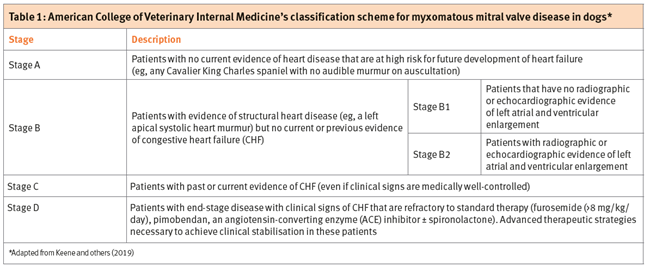
June 2025:
UK study of MVD-affected dogs concludes that Grade IV murmur
alone may warrant starting pimobendan.
 In a
June 2025 article, a team of UK researchers (Camilla Pegram,
Karla Diaz-Ordaz, Dave C. Brodbelt, Yu-Mei Chang, Adrian Boswood
[right], Jenny
Wilshaw, Carmen A. T. Reep, Sarah Balling, Jaya Sahota, David B. Church,
Dan G. O'Neill) reviewed the medical records of 928 dogs diagnosed with
mitral valve disease and at least a Grade IV murmur
over the mitral valve, to compare the
difference in survival times between dogs administered
pimobendan
and those not so administered. The dogs all were at least 6 years old
and no heavier than 15 kg (33 lb). The dogs were placed in the
pimobendan group if they started pimobendan within 6 months of the Grade
IV murmur first being detected. There were 178 dogs in the pimobendan
group, of which 60 (33.7%) were cavalier King Charles spaniels (CKCSs),
and there were 750 dogs in the non-pimobendan group, of which 241
(32.1%) were CKCSs. The cavalier breed was the one with the largest
number of dogs of all breeds. The investigators report that: "Dogs
prescribed pimobendan had 311 fewer days of health lost to CHF
[congestive heart failure] (95% CI
224-395 days) within 5 years. Dogs prescribed pimobendan lived longer
(adjusted mean survival time 1051 days, 95% CI 967-1125) than dogs not
prescribed pimobendan (905 days, 95% CI 871-940 days)." They did not
break down their data by breed, unfortunately. They concluded:
In a
June 2025 article, a team of UK researchers (Camilla Pegram,
Karla Diaz-Ordaz, Dave C. Brodbelt, Yu-Mei Chang, Adrian Boswood
[right], Jenny
Wilshaw, Carmen A. T. Reep, Sarah Balling, Jaya Sahota, David B. Church,
Dan G. O'Neill) reviewed the medical records of 928 dogs diagnosed with
mitral valve disease and at least a Grade IV murmur
over the mitral valve, to compare the
difference in survival times between dogs administered
pimobendan
and those not so administered. The dogs all were at least 6 years old
and no heavier than 15 kg (33 lb). The dogs were placed in the
pimobendan group if they started pimobendan within 6 months of the Grade
IV murmur first being detected. There were 178 dogs in the pimobendan
group, of which 60 (33.7%) were cavalier King Charles spaniels (CKCSs),
and there were 750 dogs in the non-pimobendan group, of which 241
(32.1%) were CKCSs. The cavalier breed was the one with the largest
number of dogs of all breeds. The investigators report that: "Dogs
prescribed pimobendan had 311 fewer days of health lost to CHF
[congestive heart failure] (95% CI
224-395 days) within 5 years. Dogs prescribed pimobendan lived longer
(adjusted mean survival time 1051 days, 95% CI 967-1125) than dogs not
prescribed pimobendan (905 days, 95% CI 871-940 days)." They did not
break down their data by breed, unfortunately. They concluded:
"Clinically, the current findings suggest that preclinical grade IV murmur diagnosis may offer an appropriate intervention stage to begin pimobendan therapy in dogs with presumed DMVD [degenerative mitral valve disease]."
 EDITOR'S NOTE:
These researchers apparently did not investigate
whether any of the dogs had been diagnosed with heart enlargement (by
x-rays or
echo scans) in
addition to having at least a Grade IV murmur. Since it long has been
recommended that dogs should not be
EDITOR'S NOTE:
These researchers apparently did not investigate
whether any of the dogs had been diagnosed with heart enlargement (by
x-rays or
echo scans) in
addition to having at least a Grade IV murmur. Since it long has been
recommended that dogs should not be
 prescribed pimobendan unless they
have significant left-chamber enlargement, regardless of their grade of
murmur, it seems that obtaining that additional bit of information would
have been vital to the safety of the patients. Since they did not do
that, they essentially were "flying blind", as if they assumed that if
the murmur was Grade IV, it did not matter whether the dogs' hearts were
enlarged or not, insofar as the safety and effectiveness of pimobendan
was concerned. They just did not know what they did not know, and they
were not concerned enough to find out.
prescribed pimobendan unless they
have significant left-chamber enlargement, regardless of their grade of
murmur, it seems that obtaining that additional bit of information would
have been vital to the safety of the patients. Since they did not do
that, they essentially were "flying blind", as if they assumed that if
the murmur was Grade IV, it did not matter whether the dogs' hearts were
enlarged or not, insofar as the safety and effectiveness of pimobendan
was concerned. They just did not know what they did not know, and they
were not concerned enough to find out.
Board certified veterinary cardiologist Lance Visser recently pointed out in a recorded presentation before colleagues,
"This is where I will get on my soapbox just a little bit and say: We do want to avoid treatment with pimobendan solely based on the murmur. I think that can be misleading."
Prof. Melanie Hezzell similarly stated in her June 2025 article:
"[M]urmur grade alone is not sufficiently accurate to differentiate stages B1 and B2 MMVD, additional testing is required."
Here is why: The researchers of this article point out in their introduction that:
"Approximately ... 70% of dogs in stage B1 DMVD have a grade III/VI or quieter murmur."
Since Stage B1 means no (or minimal) heart enlargement, then if 70% of dogs without
significant heart enlargement have Grade III or
lower murmurs, that would mean that the other 30% of dogs without
significant enlargement
have Grade IV or higher murmurs. So, this suggests that if clinicians
arbitrarily follow these researchers' advice and prescribe pimobendan to 100%
of their MVD-affected patients with a Grade IV murmur, there is a likelihood that 30%
of them will not have significant heart enlargement and be placed at higher risk of
adverse reactions to the drug. Pimobendan does not behave like a sugar
pill if administered prematurely. It has been known to rapidly increase
the progression of MVD in some dogs if started too early, and that
progression can include sudden
 death due to
atrial fibrillation and/or
ruptured chordae. Indeed, even in the pimobendan group in the
EPIC
Trial, in which all of the dogs allegedly had left-sided heart enlargement
but were not in heart failure, 8.5% of them died suddenly of cardiac
causes.
death due to
atrial fibrillation and/or
ruptured chordae. Indeed, even in the pimobendan group in the
EPIC
Trial, in which all of the dogs allegedly had left-sided heart enlargement
but were not in heart failure, 8.5% of them died suddenly of cardiac
causes.
June 2025:
Cavaliers were at greater risk of adverse post-operative events
following mitral valve surgeries at Japan's JASMINE center.
 In
a
June 2025 article, Japanese veterinary cardiology surgeons (Kentaro
Kurogochi, Shimon Furusato, Emi Takahashi, Miho Tabata, Masashi Mizuno,
Yasuyuki Nii) led by Dr. Masami Uechi (right) reviewed the
short-term (under 100 days) and long-term (up to 1,400 days) risk of
death factors of dogs undergoing mitral valve repair (MVR) at the
JASMINE Veterinary Cardiovascular Medical Center in Japan from 2017
through 2020. They categorized the post-operative events as (1)
"all-cause mortality", meaning death for any reason; (2) onset of
congestive heart failure (CHF); and (3) having to undergo a second MVR
surgery. Of 1,019 patients, including 66 cavalier King Charles spaniels
(6.5%), 57 dogs died during the short term period, and 4 experienced
congestive heart failure (CHF), and none required additional MVR
surgery. In the long term period, and 167 dogs died, and 44 experienced
CHF, and, again, none had another MVR. While they did not provide any
breed-specific data, they singled out cavaliers as having a higher
"hazard ratio" in the late post-operative period than did chihuahuas.
They explained about cavaliers, specifically:
In
a
June 2025 article, Japanese veterinary cardiology surgeons (Kentaro
Kurogochi, Shimon Furusato, Emi Takahashi, Miho Tabata, Masashi Mizuno,
Yasuyuki Nii) led by Dr. Masami Uechi (right) reviewed the
short-term (under 100 days) and long-term (up to 1,400 days) risk of
death factors of dogs undergoing mitral valve repair (MVR) at the
JASMINE Veterinary Cardiovascular Medical Center in Japan from 2017
through 2020. They categorized the post-operative events as (1)
"all-cause mortality", meaning death for any reason; (2) onset of
congestive heart failure (CHF); and (3) having to undergo a second MVR
surgery. Of 1,019 patients, including 66 cavalier King Charles spaniels
(6.5%), 57 dogs died during the short term period, and 4 experienced
congestive heart failure (CHF), and none required additional MVR
surgery. In the long term period, and 167 dogs died, and 44 experienced
CHF, and, again, none had another MVR. While they did not provide any
breed-specific data, they singled out cavaliers as having a higher
"hazard ratio" in the late post-operative period than did chihuahuas.
They explained about cavaliers, specifically:
"Interestingly, previous research has indicated that the morphology of the mitral valve annulus in Cavalier King Charles Spaniels can differ from that of other breeds, with this breed tending to have shorter and thicker mitral valve leaflets. These differences may affect the surgical outcomes of regurgitant reduction."
They conclude by observing a higher incidence of early post-operative events rather than later ones, and that patients being operated upon when in Stage D of mitral valve disease being at greater risk of the onset of such events.
June 2025:
Left ventricular early inflow-outflow index (LVEIO) in cavaliers
is reportedly significantly higher than in other breeds.
 In a
June 2025 abstract presented at the 2025 ACVIM Forum, UK
researchers Marco Mazzarella (right), Gavin McAulay, Matthew Butler, Rebecca
Foster, Natalie Finch, Jade Ward, Wasutorn Yangwanitset, Metaxia
Tsakiroglou, and Melanie Hezzell studied 21 cavalier King Charles
spaniels and 13 dogs of other breeds, all diagnosed with mitral valve
disease, allegedly in ACVIM Stage B1 (meaning, no enlargement), to
determine if the left ventricular early inflow-outflow index (LVEIO)
differs in cavaliers compared to the other breeds. The LVEIO is a
Doppler estimate of mitral regurgitation severity. They report:
In a
June 2025 abstract presented at the 2025 ACVIM Forum, UK
researchers Marco Mazzarella (right), Gavin McAulay, Matthew Butler, Rebecca
Foster, Natalie Finch, Jade Ward, Wasutorn Yangwanitset, Metaxia
Tsakiroglou, and Melanie Hezzell studied 21 cavalier King Charles
spaniels and 13 dogs of other breeds, all diagnosed with mitral valve
disease, allegedly in ACVIM Stage B1 (meaning, no enlargement), to
determine if the left ventricular early inflow-outflow index (LVEIO)
differs in cavaliers compared to the other breeds. The LVEIO is a
Doppler estimate of mitral regurgitation severity. They report:
"LVEIO was significantly higher in CKCS (5.42 [3.06-7.98]) vs non-CKCS dogs (4.67 [3.04-11.45]). LVEIO can be easily obtained and might provide further information about MMVD severity in dogs. However, a breed-specific range for CKCS should be considered for more accurate assessment."
 EDITOR'S NOTE: Any study such as this one which relies upon the
2019
ACVIM Consensus Statement's definition of Stage B1 (meaning, a normal
sized heart of any dog of any breed means having an LA/Ao below 1.6 or a
LVIDdN below 1.7) runs the risk of using Garbage-In-Garbage-Out data
when it comes to cavalier King Charles spaniels. That Stage B1
definition is simply nonsense; it is not based upon any scientific
research whatsoever. If you assume that any cavalier with a LA/Ao of
1.59 has a normal sized heart, then you are making an ass out of
yourself. It is
EDITOR'S NOTE: Any study such as this one which relies upon the
2019
ACVIM Consensus Statement's definition of Stage B1 (meaning, a normal
sized heart of any dog of any breed means having an LA/Ao below 1.6 or a
LVIDdN below 1.7) runs the risk of using Garbage-In-Garbage-Out data
when it comes to cavalier King Charles spaniels. That Stage B1
definition is simply nonsense; it is not based upon any scientific
research whatsoever. If you assume that any cavalier with a LA/Ao of
1.59 has a normal sized heart, then you are making an ass out of
yourself. It is
 very likely, that any or all of these 21 CKCSs with
LA/Ao ratios between 1.4 and 1.59 actually had enlarged left atria. In
such a case, that really skews the inputing data, and so the whole study
becomes meaningless. These researchers make our point: They find that
the LVEIO of cavaliers differs markedly from the LVEIO of most other
breeds. What they miss however, is that a lot of echo values of
cavaliers differ markedly from other breeds, and that includes both the
LA/Ao and the LVIDdN.
very likely, that any or all of these 21 CKCSs with
LA/Ao ratios between 1.4 and 1.59 actually had enlarged left atria. In
such a case, that really skews the inputing data, and so the whole study
becomes meaningless. These researchers make our point: They find that
the LVEIO of cavaliers differs markedly from the LVEIO of most other
breeds. What they miss however, is that a lot of echo values of
cavaliers differ markedly from other breeds, and that includes both the
LA/Ao and the LVIDdN.
June 2025:
Pimobendan plus omecamtiv mecarbil improved heart ejection
fraction in healthy dogs.
 In
a
June 2025 abstract presented at the 2025 ACVIM Forum, researchers Phillip Lawson (right),
Victor Rivas, Kentaro Kurogochi, Caitlin Hargrove, Sandra Losa, Aida
Gonzalez, Megan Leber, Sarah Holdt, Bill Tyrrell, Joshua Stern report on
the COMPOSE Study, in which 6 healthy laboratory dogs were treated
intravenously with a combination of pimobendan and
omecamtiv mecarbil
(OM) to determine their safety and effectiveness in increasing
canine myocardial systolic function. They report finding that the dogs'
left verticular ejection fraction significantly increased with dual
therapy compared to pimobendan or OM alone. They recommend future
studies in dogs with mitral valve disease.
In
a
June 2025 abstract presented at the 2025 ACVIM Forum, researchers Phillip Lawson (right),
Victor Rivas, Kentaro Kurogochi, Caitlin Hargrove, Sandra Losa, Aida
Gonzalez, Megan Leber, Sarah Holdt, Bill Tyrrell, Joshua Stern report on
the COMPOSE Study, in which 6 healthy laboratory dogs were treated
intravenously with a combination of pimobendan and
omecamtiv mecarbil
(OM) to determine their safety and effectiveness in increasing
canine myocardial systolic function. They report finding that the dogs'
left verticular ejection fraction significantly increased with dual
therapy compared to pimobendan or OM alone. They recommend future
studies in dogs with mitral valve disease.
June 2025:
Korean TEER surgeries for MVD dogs have mixed results.
 In
a
June 2025 article, South Korean cardiologists (Jeong-Min Lee,
Kyoung-a Youp [right], Sun-Tae Lee, Ah-Ra Lee, Young-Wook Cho,
Youn-Seo Jung, Jiwoong Her, Seung-Keun Lee) reported on the results of
20 transcatheter edge-to-edge (TEER) mitral valve repair procedures
between September 2023 and June 2024 at the Korea Animal Medical Center
in Cheongju, South Korea. The dogs were 4 Maltese, 4 mixed-breed dogs, 3
schnauzers, 2 pomeranians, 2 chihuahuas, 2 miniature poodles, and 1 each
of dachshund, Shih Tzu, and spitz. All dogs underwent transthoracic
echocardiography (TTE) and
transesophageal echocardiography (TEE) before
deciding on TEER. Pf the 20 dogs, 13 (65%) survived. Preoperative mitral
valve disease (MVD) was classified as stage B2 in 3 cases, stage C in 11
cases, and stage D in 6 cases. Seven dogs died within 9 days because of
mitral leaflet tear or single-leaflet device attachment (4/7 dogs,
57.1%), tracheal collapse (1/7 dogs, 14.3%), presumed post-procedure
neurologic deficit with a history of hydrocephalus (1/7 dogs, 14.3%),
and presumed cardiogenic shock (1/7 dogs, 14.3%). Notwithstanding the
low survival rate, 3 months after TEER the authors reported significant
reductions in vertebral heart score (VHS) - 11.6 (9.6-13.1) before vs.
11.0 (8.3-11.9) following surgery; vertebral left atrial size (VLAS) -
2.90 (2.1-3.6) vs. 2.60 (2.0-3.3); left atrium-to-aortic root ratio
(LA/Ao) - 2.09 (1.5-2.5) vs. 1.69 (1.3-2.2); left ventricular
end-diastolic diameter normalized for body weight (LVIDdN) - 2.1
(1.5-2.3) vs. 1.76 (1.4-2.2); regurgitant fraction (RF) - 77.83%
(73.2-83.0) vs. 55.38% (20.5-73.6)]; and regurgitant volume - 3.96 ml/kg
(2.1-6.2) vs. 1.25 ml/kg (0.4-3.5). They concluded: "Transcatheter
edge-to-edge repair resulted in a significant reduction in left atrium
and ventricle size and should be further investigated as a potential
treatment option for dogs with MMVD."
In
a
June 2025 article, South Korean cardiologists (Jeong-Min Lee,
Kyoung-a Youp [right], Sun-Tae Lee, Ah-Ra Lee, Young-Wook Cho,
Youn-Seo Jung, Jiwoong Her, Seung-Keun Lee) reported on the results of
20 transcatheter edge-to-edge (TEER) mitral valve repair procedures
between September 2023 and June 2024 at the Korea Animal Medical Center
in Cheongju, South Korea. The dogs were 4 Maltese, 4 mixed-breed dogs, 3
schnauzers, 2 pomeranians, 2 chihuahuas, 2 miniature poodles, and 1 each
of dachshund, Shih Tzu, and spitz. All dogs underwent transthoracic
echocardiography (TTE) and
transesophageal echocardiography (TEE) before
deciding on TEER. Pf the 20 dogs, 13 (65%) survived. Preoperative mitral
valve disease (MVD) was classified as stage B2 in 3 cases, stage C in 11
cases, and stage D in 6 cases. Seven dogs died within 9 days because of
mitral leaflet tear or single-leaflet device attachment (4/7 dogs,
57.1%), tracheal collapse (1/7 dogs, 14.3%), presumed post-procedure
neurologic deficit with a history of hydrocephalus (1/7 dogs, 14.3%),
and presumed cardiogenic shock (1/7 dogs, 14.3%). Notwithstanding the
low survival rate, 3 months after TEER the authors reported significant
reductions in vertebral heart score (VHS) - 11.6 (9.6-13.1) before vs.
11.0 (8.3-11.9) following surgery; vertebral left atrial size (VLAS) -
2.90 (2.1-3.6) vs. 2.60 (2.0-3.3); left atrium-to-aortic root ratio
(LA/Ao) - 2.09 (1.5-2.5) vs. 1.69 (1.3-2.2); left ventricular
end-diastolic diameter normalized for body weight (LVIDdN) - 2.1
(1.5-2.3) vs. 1.76 (1.4-2.2); regurgitant fraction (RF) - 77.83%
(73.2-83.0) vs. 55.38% (20.5-73.6)]; and regurgitant volume - 3.96 ml/kg
(2.1-6.2) vs. 1.25 ml/kg (0.4-3.5). They concluded: "Transcatheter
edge-to-edge repair resulted in a significant reduction in left atrium
and ventricle size and should be further investigated as a potential
treatment option for dogs with MMVD."
May 2025:
Digital stethoscopes, phonocardiogram signals, and deep learning
combine to measure mitral regurgitation severity in MVD-affected dogs.
 In
a
May 2025 article, South Korean researchers (Soh-Yeon Lee, Sully Lee,
Se-Hoon Kim, HyeSun Chang, Won-Yang Cho, Min-Ok Ryu, Jihye Choi,
Hwa-Young Yoon, Kyoung-Won Seo [right]) examined 460 dogs
diagnosed with mitral valve disease (MVD) using digital stethoscopes
(WP-100 digital stethoscope), phonocardiogram signals, and three
different deep learning programs -- convolutional neural network (CNN6),
patch-mix audio spectrogram transformer (PaSST), and residual neural
network (ResNET38). They focused upon the severity of mitral
regurgitation (MR) -- mild, moderate, severe -- and compared the data
obtained using stethoscopes to echocardiograms of each dog and their
MINE scores. They report finding that "the CNN6-Fbank model achieved an
accuracy of 94.12%, specificity of 97.30%, sensitivity of 94.12%,
precision of 92.63%, and F1 score of 93.32%, outperforming the PaSST and
ResNet38 models overall and demonstrating robust performance across most
metrics." They concluded: "Deep learning models, particularly CNN6, can
effectively assess MR severity in dogs with MMVD using digital
stethoscope recordings. This approach provides a rapid, noninvasive, and
reliable adjunct to echocardiography, potentially enhancing diagnosis
and outcomes. Future studies should focus on broader clinical validation
and real-time application of this technology."
In
a
May 2025 article, South Korean researchers (Soh-Yeon Lee, Sully Lee,
Se-Hoon Kim, HyeSun Chang, Won-Yang Cho, Min-Ok Ryu, Jihye Choi,
Hwa-Young Yoon, Kyoung-Won Seo [right]) examined 460 dogs
diagnosed with mitral valve disease (MVD) using digital stethoscopes
(WP-100 digital stethoscope), phonocardiogram signals, and three
different deep learning programs -- convolutional neural network (CNN6),
patch-mix audio spectrogram transformer (PaSST), and residual neural
network (ResNET38). They focused upon the severity of mitral
regurgitation (MR) -- mild, moderate, severe -- and compared the data
obtained using stethoscopes to echocardiograms of each dog and their
MINE scores. They report finding that "the CNN6-Fbank model achieved an
accuracy of 94.12%, specificity of 97.30%, sensitivity of 94.12%,
precision of 92.63%, and F1 score of 93.32%, outperforming the PaSST and
ResNet38 models overall and demonstrating robust performance across most
metrics." They concluded: "Deep learning models, particularly CNN6, can
effectively assess MR severity in dogs with MMVD using digital
stethoscope recordings. This approach provides a rapid, noninvasive, and
reliable adjunct to echocardiography, potentially enhancing diagnosis
and outcomes. Future studies should focus on broader clinical validation
and real-time application of this technology."
May 2025:
Italian cardiology researchers find hydrochlorothiazide may
prevent recurring relapses of heart failure in MVD-affected dogs in
Stage D.
 In
a
May 2025 article, Italian cardiology researchers Giovanni Romito
(right), Chiara Mazzoldi, Laura Calebotta, Prisca Castagna,
Nazzareno Giuseppe Pelle, Carlotta Valente, Helen Poser, and Carlo
Guglielmini examined the short-term and long-trm effects of
hydrochlorothiazide (HCTZ) in 38 dogs, including 4 (10.5%) cavalier King
Charles spaniels suffereing from relapsing congestive heart failure
(CHF) due to mitral valve disease (MVD). Hydrochlorothiazide is a
thiazide diuretic is typically administered in combination with a
loop diuretic (e.g., furosemide) if the loop diuretic alone does not
adequately control fluid retention. They report finding that, at a
median of 7 days after adding HCTZ to the medication cocktail,
creatinine, urea, and total calcium levels significantly increased,
while sodium and potassium levels significantly decreased. While no dog
developed severe electrolyte abnormalities, some dogs showed severe
increases in creatinine and urea. After a median of 95 days, no
significant echocardiographic changes developed. Episodes of CHF were
more frequent before (median, one every 68 days) than after (median, one
every 124 days) after startiing HCTZ.
In
a
May 2025 article, Italian cardiology researchers Giovanni Romito
(right), Chiara Mazzoldi, Laura Calebotta, Prisca Castagna,
Nazzareno Giuseppe Pelle, Carlotta Valente, Helen Poser, and Carlo
Guglielmini examined the short-term and long-trm effects of
hydrochlorothiazide (HCTZ) in 38 dogs, including 4 (10.5%) cavalier King
Charles spaniels suffereing from relapsing congestive heart failure
(CHF) due to mitral valve disease (MVD). Hydrochlorothiazide is a
thiazide diuretic is typically administered in combination with a
loop diuretic (e.g., furosemide) if the loop diuretic alone does not
adequately control fluid retention. They report finding that, at a
median of 7 days after adding HCTZ to the medication cocktail,
creatinine, urea, and total calcium levels significantly increased,
while sodium and potassium levels significantly decreased. While no dog
developed severe electrolyte abnormalities, some dogs showed severe
increases in creatinine and urea. After a median of 95 days, no
significant echocardiographic changes developed. Episodes of CHF were
more frequent before (median, one every 68 days) than after (median, one
every 124 days) after startiing HCTZ.
May 2025:
UK researchers find starting pimobendan once grade IV mitral
murmur is detected may delay heart failure in dogs with MVD.
 In
an
April 2025 presentation to the 2025 Congress of the British Small
Animal Veterinary Association (BSAVA), UK researchers Camilla Pegram
(right), Karla Diaz-Ordaz, David Brodbelt, Yu-Mei Chang, Adrian
Boswood, Jenny Wilshaw, Carmen Reep, Sarah Balling, Jaya Sahota, David
Church, and Dan O'Neill examined the medical records of 928 small dogs
diagnosed with mitral valve disease and having a grade IV mitral valve
murmur. They found that 178 of those dogs were prescribed pimobendan
within 6 months of that grade IV diagnosis, and the remaining 750 dogs
were not. They found that, overall, the dogs prescribed pimobendan
within 6 months of the grade IV diagnosis "had 311 fewer days of health
lost to CHF [congestive heart failure] within 5 years. The adjusted mean
survival time for dogs treated with pimobendan was 1,051 days, compared
to 905 days for dogs not treated. They concluded that: "Clinically, the
findings suggest that preclinical grade IV murmur diagnosis may be an
appropriate intervention stage to begin pimobendan therapy in dogs."
(See a more detailed discussion of this research above in June 2025.)
In
an
April 2025 presentation to the 2025 Congress of the British Small
Animal Veterinary Association (BSAVA), UK researchers Camilla Pegram
(right), Karla Diaz-Ordaz, David Brodbelt, Yu-Mei Chang, Adrian
Boswood, Jenny Wilshaw, Carmen Reep, Sarah Balling, Jaya Sahota, David
Church, and Dan O'Neill examined the medical records of 928 small dogs
diagnosed with mitral valve disease and having a grade IV mitral valve
murmur. They found that 178 of those dogs were prescribed pimobendan
within 6 months of that grade IV diagnosis, and the remaining 750 dogs
were not. They found that, overall, the dogs prescribed pimobendan
within 6 months of the grade IV diagnosis "had 311 fewer days of health
lost to CHF [congestive heart failure] within 5 years. The adjusted mean
survival time for dogs treated with pimobendan was 1,051 days, compared
to 905 days for dogs not treated. They concluded that: "Clinically, the
findings suggest that preclinical grade IV murmur diagnosis may be an
appropriate intervention stage to begin pimobendan therapy in dogs."
(See a more detailed discussion of this research above in June 2025.)
April 2025:
Heart-healthy Italian cavaliers have larger left ventricles (LV)
than the ACVIM's 2019 Consensus Statement's definition of normal LVs.
 In an
April 2025 article in which previously performed
echocardiograms of 218 purportedly heart-healthy Italian cavalier King
Charles spaniels (CKCSs) were analyzed, investigators (Domenico Caivano
(right),
Paolo Ferrari, Mark Rishniw) report finding that the subject CKCSs had
larger normal LVIDdN measurements than the ACVIM's 2019 Consensus
Statement's species-wide cut-off value of 1.7. This finding is
consistent with previously reported LVIDdN ranges for cavaliers. This
article concludes that:
In an
April 2025 article in which previously performed
echocardiograms of 218 purportedly heart-healthy Italian cavalier King
Charles spaniels (CKCSs) were analyzed, investigators (Domenico Caivano
(right),
Paolo Ferrari, Mark Rishniw) report finding that the subject CKCSs had
larger normal LVIDdN measurements than the ACVIM's 2019 Consensus
Statement's species-wide cut-off value of 1.7. This finding is
consistent with previously reported LVIDdN ranges for cavaliers. This
article concludes that:
"Furthermore, Cavalier King Charles spaniels often have normalized left ventricular dimensions thatexceed guideline limits, suggesting that the current criteria for ventriculomegaly might be inappropriate for this breed."
The investigators also found that among the 218 Italian CKCSs, the normal (meaning, not enlarged) left atrium-to-aortic root ratios (LA:Ao) ranged from 0.71 to 1.75. The 2019 ACVIM's Consensus Statement claims that for all breeds of dogs, a LA:Ao of 1.6 or below defines a normal-sized left atrium. However, Figure 1(A) (right) of this study shows that the vast majority of the cavaliers had LA:Ao ratios below 1.5.
EDITOR'S NOTE: The investigators conclude, inaccurately and misleadingly, that "Cavalier King Charles spaniels have LA:Ao not smaller than other breeds." This is majorly irresponsible hyperbole, rejecting the findings of two prior studies which they acknowledge their study contradicts, and a couple others which they ignore.* Particularly misleading in this quoted statement is its suggestion that all cavaliers have LA:Ao ratios at least as large as all other breeds of dog. Pure nonsense.
For example, consider that the chart at Figure 1(A) above here shows that 75% of all ofthe cavaliers in the study had LA:Ao ratios of 1.4 or below. The 4 tallest bars in the middle of that chart show that 106 of the cavaliers had LA:Ao ratios between 1.2 and 1.35, which are significantly lower than the 2019 ACVIM Consensus Statement's arbitrary species-wide 1.6 ratio signifying a "normal-sized" heart. If, as this study concludes, "Cavalier King Charles spaniels have LA:Ao not smaller than other breeds", then the highest bars by far should be much farther to the right, in the region between 1.5 and 1.6! The editors of the publishing journal, the Journal of Veterinary Cardiology, are showing themselves to be absolute fools for letting this steaming load of pseudo-science slip by them!
What if any of those cavaliers, with a normal left atrium (LA) of, say, 1.2, had another echo scan a year later and was found to have developed mitral valve disease (MVD) with an enlarged LA with a ratio of, say, 1.35? That cavalier in fact would have a significantly enlarged left atrium, but according to this article, would have no enlargement at all! Indeed, did the investigators search for subsequent echo scans of the dogs in thisstudy to see whether any did develop MVD with enlarged LAs? After all, we are dealing with cavaliers here, a breed of which any dog almost assuredly will develop MVD and have an enlarged LA at some point in its life. To say that a dog had a normal-sized heart at one ratio and yet not find a later echo scan for that same dog to determine if there had been any change for the worse, really amounts to Garbage-In-Garbage-Out type of data.
As for these investigators' definition of "other breeds", they fail to provide any information about which other breeds. They pick echo scans of 379 "healthy dogs of various breeds" and report that their overall LA:Ao range was 0.79 to 1.77 with a median of 1.27, while they claim the range for their cavalier group was 0.76 to 1.71 with a median of 1.29. What this data really tells us is that the ACVIM's defintion of a normal-sized LA:Ao ratio, which is >1.6 species-wide, is totally bogus not only for cavaliers but for "other breeds" as well. By the time any dog with a normal-sized LA:Ao ratio of 1.27 or 1.29 reaches anywhere close to 1.6, that dog's left atrium is extremely engorged, but not enough to satisfy the ACVIM or these investigators. These investigators appear not to realize that they have disproven the accuracy of the ACVIM's species-wide's definition of an enlarged left atrium.
Also, considering that cavaliers from only country, Italy (and not a country in which the breed pred0minates, like the UK or USA), were included in the study, warrants concerns about insularity, at the very least. And, most importantly, to refuse to acknowledge that just maybe these 4 previous studies*, which comprised 221 heart-healthy cavaliers with LA:Ao ratios ranging from 0.47 to 1.36, also could amount to valid contradictory findings, suggests some odd underlying unobjective motive.
If the data provided in this study is to be taken at face value, then the investigators' findings and conclusion should have been that (a) 218 Italian cavaliers' normal-sized left atria, as measured by LA:Ao ratios, were found to be anywhere from much lower (0.71) to slightly higher (1.75) than the 2019 ACVIM Consensus Statement's species-wide definition of an enlarged left atrium, and (b) their normal-sized left ventricles, as measured by LVIDdN values, are higher than the 2019 ACVIM Consensus Statement's definition of enlarged left ventricles, and therefore (c) the 2019 ACVIM Consensus Statement's definition of enlarged left heart chambers is completely worthless when applied to these cavaliers in Italy, and, indeed, "other breeds" as well.
*Haggstrom J.,
Heart sounds and murmurs: changes related to severity of chronic
valvular disease in the Cavalier King Charles spaniel. J. Vet.
Intern. Med. March 1995;9(2):75-85.
Hansson, K., Left atrial
to aortic root indices using two-dimensional and M-mode
echocardiography in cavalier King Charles spaniels with and without
left atrial enlargement. Vet. Rad. & Ultra. November
2002;43(6):568-575.
Misbach, C., Echocardiography and
conventional Doppler examination in clinically healthy adult
Cavalier King Charles Spaniels: effect of body weight, age, and
gender, and establishment of reference intervals. J. Vet. Cardio.
June 2014;16(2):91-100.
Bagardi, M., Circulating miR-30b-5p is
upregulated in Cavalier King Charles Spaniels affected by early
myxomatous mitral valve disease. PlosONE. July 2022;17(7):e0266208.
April 2025:
Chinese herbs and acupuncture successfully treat 36
MVD-affected dogs in heart failure.
 In a
February 2025 article, Chinese investigators Yu Cheng and
Deng-Shan Shiau (right) report the successful treatment of 36 dogs diagnosed to
be in heart failure due to mitral valve disease (MVD), using Chinese
herbs and acupuncture. The dogs were of 10 breeds, not including any
cavaliers. Most of the dogs previously had been treated unsuccessfully
with pimobendan, diuretics, ACE-inhibitors, and spironolactone. Each
dog received personalized TCVM (Traditional Chinese Veterinary Medicine)
diagnosis and treatment, including acupuncture and herbal formulas (Shen
Calmera, Heart Qi Tonica, Breathe Easier Ba, and Su Zi Jiang Qi).
Following TCVM treatment, nearly all of the dogs showed reduced sizes of
their left atria and improved mitral regurgitation levels. Clinical
signs, including fatigue, coughing, panting, and sleep disturbance,
improved significantly. They concluded:
In a
February 2025 article, Chinese investigators Yu Cheng and
Deng-Shan Shiau (right) report the successful treatment of 36 dogs diagnosed to
be in heart failure due to mitral valve disease (MVD), using Chinese
herbs and acupuncture. The dogs were of 10 breeds, not including any
cavaliers. Most of the dogs previously had been treated unsuccessfully
with pimobendan, diuretics, ACE-inhibitors, and spironolactone. Each
dog received personalized TCVM (Traditional Chinese Veterinary Medicine)
diagnosis and treatment, including acupuncture and herbal formulas (Shen
Calmera, Heart Qi Tonica, Breathe Easier Ba, and Su Zi Jiang Qi).
Following TCVM treatment, nearly all of the dogs showed reduced sizes of
their left atria and improved mitral regurgitation levels. Clinical
signs, including fatigue, coughing, panting, and sleep disturbance,
improved significantly. They concluded:
"this retrospective study provides evidence that TCVM may serve as an effective complementary or alternative therapy for managing canine heart failure, particularly in situations where conventional Western treatments are not viable."
April 2025:
Cavalier develops lethal blood clot due to turbulent blood flow
caused by advanced mitral valve disease.
 In
an
April 2025 article by Italian cardiac clinicians Giovanni Romito
(right), Chiara Mazzoldi, Matteo Di Benedetto, and Silvia
Sabattini. an 11-year-old cavalier King Charles spaniel previously
diagnosed with Stage B2 mitral valve disease (MVD) developed respiratory
distress and abdominal distension. Fluid in the lungs and abdomen
(ascites) were diagnosed. An echocardiographic scan revealed an atrial
septal defect (ASD) in addition to moderate enlargement of both the left
atrium and left ventricle. An ASD is a small hole in the interatrial
septum, a thin membrane wall separating the left and right atria, the
two upper chambers of the heart. A blood clot (intracardiac thrombosis
-- ICT) within the ASD also was detected. The dog was treated with blood
thinning drugs for the clot, in addition to MVD medications. The dog
died 138 days after discharge, and the clinicians performed a necropsy
(post-mortem examination) which revealed advanced (Type 4) lesions on
the mitral valve leaflets, enlargement of the two left heart chambers,
several lesions within the left atrium, attributed to jets of blood
regurgitating through the mitral valve, extensive damage to the
endothelial cells of the left atrium, and the ASD and a blood clot
trapped within the ASD. They concluded that the blood clot was triggered
by the dog's advanced stage of MVD.
In
an
April 2025 article by Italian cardiac clinicians Giovanni Romito
(right), Chiara Mazzoldi, Matteo Di Benedetto, and Silvia
Sabattini. an 11-year-old cavalier King Charles spaniel previously
diagnosed with Stage B2 mitral valve disease (MVD) developed respiratory
distress and abdominal distension. Fluid in the lungs and abdomen
(ascites) were diagnosed. An echocardiographic scan revealed an atrial
septal defect (ASD) in addition to moderate enlargement of both the left
atrium and left ventricle. An ASD is a small hole in the interatrial
septum, a thin membrane wall separating the left and right atria, the
two upper chambers of the heart. A blood clot (intracardiac thrombosis
-- ICT) within the ASD also was detected. The dog was treated with blood
thinning drugs for the clot, in addition to MVD medications. The dog
died 138 days after discharge, and the clinicians performed a necropsy
(post-mortem examination) which revealed advanced (Type 4) lesions on
the mitral valve leaflets, enlargement of the two left heart chambers,
several lesions within the left atrium, attributed to jets of blood
regurgitating through the mitral valve, extensive damage to the
endothelial cells of the left atrium, and the ASD and a blood clot
trapped within the ASD. They concluded that the blood clot was triggered
by the dog's advanced stage of MVD.
March 2025:
Dr. Dewey Carpenter announces a successful transapical beating
heart mitral valve replacement in a dog.
 In
February 2025, Sawgrass Veterinary Cardiology in Royal Palm Beach,
Florida USA announced that Dr. Dewey Carpenter (right) and his
surgical team performed a successful transapical mitral valve
replacement procedure on a dog, the first such surgery in the United
States. They reported after 36 hours that the device "is showing
excellent flow with zero regurgitation or perivalvular leakage."
The valve was designed by Hung Yu Medical. However. on
March
10, 2025, Sawgrass announced that the patient was euthanized after
developing acute anuric renal failure and did not respond to treatment.
In
February 2025, Sawgrass Veterinary Cardiology in Royal Palm Beach,
Florida USA announced that Dr. Dewey Carpenter (right) and his
surgical team performed a successful transapical mitral valve
replacement procedure on a dog, the first such surgery in the United
States. They reported after 36 hours that the device "is showing
excellent flow with zero regurgitation or perivalvular leakage."
The valve was designed by Hung Yu Medical. However. on
March
10, 2025, Sawgrass announced that the patient was euthanized after
developing acute anuric renal failure and did not respond to treatment.
Transapical surgeries involve replacing the deteriorated mitral valve with a bioprosthetic mitral valve while the heart continues to function normally. The heart is not stopped or by-passed, and it is not accessed through a vein. Instead, while the dog is under anesthesia, an incision is made in the skin between the ribs, and the heart is visible to the surgeons. This is called a thoracotomy. A needle-like surgical probe, to which is attached the artifiical mitral valve, is inserted through the exterior wall at the apex of the heart, guided by 2D and 3D transesophageal echocardiography (TEE). Once the artificial valve is in place, the probe is withdrawn. For more information, see our MVD webpage linked here.
March 2025:
Royal Veterinary College reports on open heart surgery results
for mitral valve disease patients.
 In
a
February 2025 article, Dr. Daniel J. Brockman (right) and
his team of cardiologists and other specialists (Thomas D. Greensmith,
Matteo Rossanese, Alison Young, Sarah L. Carey, Thaleia-Rengina
Stathopoulou, Carolina Palacios Jimenez, Nigel Cross) in open heart
surgeries of 132 canine mitral valve disease patients at the Royal
Veterinary College in the UK between July 2015 and November 2022, report
on their procedures and success rates. Of the 132 dogs, 31 (23.5%) were
cavalier King Charles spaniels. The short-term survival rate - meaning
dogs discharged from the hospital following surgeries - was 81%
(107/132), which included 26 of the 31 cavaliers (83.9%). They note that
their short-term survival rate improved over time. Their article
includes discussion of the strategies utilized in selecting candidates
and their "learning curve" and organizational commitment to the program.
In
a
February 2025 article, Dr. Daniel J. Brockman (right) and
his team of cardiologists and other specialists (Thomas D. Greensmith,
Matteo Rossanese, Alison Young, Sarah L. Carey, Thaleia-Rengina
Stathopoulou, Carolina Palacios Jimenez, Nigel Cross) in open heart
surgeries of 132 canine mitral valve disease patients at the Royal
Veterinary College in the UK between July 2015 and November 2022, report
on their procedures and success rates. Of the 132 dogs, 31 (23.5%) were
cavalier King Charles spaniels. The short-term survival rate - meaning
dogs discharged from the hospital following surgeries - was 81%
(107/132), which included 26 of the 31 cavaliers (83.9%). They note that
their short-term survival rate improved over time. Their article
includes discussion of the strategies utilized in selecting candidates
and their "learning curve" and organizational commitment to the program.
February 2025:
Left atrial decompression resolves cavalier's heart failure
episodes.
 In a
February 2025 article, clinicans (Pierre Foulex, Valerie Chetboul
[right], Charlotte Misbach, Niels Gomez, Camille Poissonnier, Jenna
Pacini, Latifa Khenissi, Nicolas Borenstein) described two case studies of
left atrial decompression (LAD), one of which was a cavalier in heart
failure due to MVD with severe mitral regurgitation (74%), the left
atrium (LA) and left ventrile "markedly enlarged", pulmonary edema, and
two ruptured chordae tendineae. LAD is a nimimally invasive surgical procedure in
which a small hole is created in the internal wall of the heart between
the left atrium and the right atrium. This
is called creating an acquired atrial septal defect, or
an atrial septostomy. The goal is to
reduce pressure in the enlarged by left atrium by allowing blood rom it
to flow directly into the right atrium. (See diagram at right.)
This is considered a last ditch effort to treat mainly dogs with
advanced congestive heart failure -- Stage D -- in which medications no
longer can compensate for the progression of the MVD. Two months after
the LAD procedure on this cavalier, the LA size and pressure had
decreased and continued to improve for 4 more months. The dog remained
free of CHF signs for 10 months and then died suddenly while asleep.
In a
February 2025 article, clinicans (Pierre Foulex, Valerie Chetboul
[right], Charlotte Misbach, Niels Gomez, Camille Poissonnier, Jenna
Pacini, Latifa Khenissi, Nicolas Borenstein) described two case studies of
left atrial decompression (LAD), one of which was a cavalier in heart
failure due to MVD with severe mitral regurgitation (74%), the left
atrium (LA) and left ventrile "markedly enlarged", pulmonary edema, and
two ruptured chordae tendineae. LAD is a nimimally invasive surgical procedure in
which a small hole is created in the internal wall of the heart between
the left atrium and the right atrium. This
is called creating an acquired atrial septal defect, or
an atrial septostomy. The goal is to
reduce pressure in the enlarged by left atrium by allowing blood rom it
to flow directly into the right atrium. (See diagram at right.)
This is considered a last ditch effort to treat mainly dogs with
advanced congestive heart failure -- Stage D -- in which medications no
longer can compensate for the progression of the MVD. Two months after
the LAD procedure on this cavalier, the LA size and pressure had
decreased and continued to improve for 4 more months. The dog remained
free of CHF signs for 10 months and then died suddenly while asleep.
January 2025:
UK Study finds daily subcutaneous furosemide injections control
MVD-affected dogs' breathing rates when oral diuretics fail.
 In
a
January 2025 article, UK researchers Sergio Federico Lombardo, Heidi
Ferasin, and Luca Ferasin (right) sought to determine if
subcutaneous (under the skin) furosemide hypodermic injections would
control signs of congestive heart failure in dogs (and cats) following
failure of administering oral pills. They observed that many
MVD-affected dogs develop a resistance to orally administered diuretics
for a variety of reasons, including "renal distal tubular hypertrophy
(nephron remodeling), activation of the sympathetic nervous system and
reninangiotensin aldosterone system, decreased diuretic delivery to the
kidney (e.g. hypoalbuminemia) and/or secretion into the proximal
convoluted tubule (e.g. chronic kidney disease), as well as reduced
gastrointestinal absorption." They provided the owners of 13 dogs,
including 3 cavalier King Charles spaniels, with injectable doses of
furosemide, at a median dose of 5.5 mg/Kg/day, divided into two equal
doses 12 hours apart. The found that in all cases there was "a good
clinical response" based upon "satisfactory control of the animal's
breathing rate and effort and overall pet owner's satisfaction." They
concluded:
In
a
January 2025 article, UK researchers Sergio Federico Lombardo, Heidi
Ferasin, and Luca Ferasin (right) sought to determine if
subcutaneous (under the skin) furosemide hypodermic injections would
control signs of congestive heart failure in dogs (and cats) following
failure of administering oral pills. They observed that many
MVD-affected dogs develop a resistance to orally administered diuretics
for a variety of reasons, including "renal distal tubular hypertrophy
(nephron remodeling), activation of the sympathetic nervous system and
reninangiotensin aldosterone system, decreased diuretic delivery to the
kidney (e.g. hypoalbuminemia) and/or secretion into the proximal
convoluted tubule (e.g. chronic kidney disease), as well as reduced
gastrointestinal absorption." They provided the owners of 13 dogs,
including 3 cavalier King Charles spaniels, with injectable doses of
furosemide, at a median dose of 5.5 mg/Kg/day, divided into two equal
doses 12 hours apart. The found that in all cases there was "a good
clinical response" based upon "satisfactory control of the animal's
breathing rate and effort and overall pet owner's satisfaction." They
concluded:
"This study showed that furosemide administered subcutaneously appears to be an efficacious and feasible therapeutic option for providing control of signs of cardiac congestion in both dogs and cats with previous unsatisfactory response to oral diuresis."
RETURN TO TOP
2024 News
December 2024:
Colorado State Univ. reports on 50 transcatheter edge-to-edge
mitral valve repair (TEER) surgeries.
 In a
December 2024 article, the heart surgery team at Colorado State
University's veterinary school (Brianna M. Potter [right], E. Christopher Orton,
Brian A. Scansen, Katie M. Abbott-Johnson, Lance C. Visser, I-Jung B.
Chi, Evan S. Ross, Bruna Del Nero, Lalida Tantisuwat, Ellen T. Krause,
Marlis L. Rezende, Khursheed Mama) reported on the outcome of
transcatheter edge-to-edge mitral valve repair (TEER) surgeries on 50
dogs, 13 of which (26%) were cavalier King Charles spaniels. This was a
feasibility study conducted from 2021 through April 2023. Overall, the
procedural feasibility was 96% based on delivery of at least one device
in 48 of the 50 dogs. Six other dogs were judged to be inappropriate for
TEER, after being placed under anesthesia, based on unfavorable mitral
valve functional anatomy or anterior-posterior dimension, and TEER was
not attempted.
In a
December 2024 article, the heart surgery team at Colorado State
University's veterinary school (Brianna M. Potter [right], E. Christopher Orton,
Brian A. Scansen, Katie M. Abbott-Johnson, Lance C. Visser, I-Jung B.
Chi, Evan S. Ross, Bruna Del Nero, Lalida Tantisuwat, Ellen T. Krause,
Marlis L. Rezende, Khursheed Mama) reported on the outcome of
transcatheter edge-to-edge mitral valve repair (TEER) surgeries on 50
dogs, 13 of which (26%) were cavalier King Charles spaniels. This was a
feasibility study conducted from 2021 through April 2023. Overall, the
procedural feasibility was 96% based on delivery of at least one device
in 48 of the 50 dogs. Six other dogs were judged to be inappropriate for
TEER, after being placed under anesthesia, based on unfavorable mitral
valve functional anatomy or anterior-posterior dimension, and TEER was
not attempted.
The V-Clamp device was not implanted in two dogs due to failure to capture the leaflets. Both dogs were discharged from the hospital. One of these dogs died of progressive heart failure 6 weeks after the surgery. The other dog died suddenly the day after hospital discharge. There were no deaths during the surgeries. Two dogs were euthanized before being discharged from the hospital, due to worsened mitral regurgitation after the surgery. Overall procedural success based on successful deployment of at least one clamp and discharge from the hospital was 92%. Nine dogs had two clamps delivered. One dog had three clamps delivered. The adverse device-related event rate was 6.3% based on three nonfatal incidents. All three events were attributed to operator error and inexperience. The authors concluded:
"In conclusion, initial feasibility results support continued development of TEER as a procedurally feasible, relatively low-risk, and low morbidity treatment for severe degenerative MR in dogs. Evidence of short-term efficacy is promising but will need verification with longer-term follow up. Operator experience, earlier intervention, and evolving understanding of favorable functional anatomy for edge-to-edge repair may result in the better reductions in MR severity in the future."
December 2024:
Nine genes associated with long-lived cavaliers in the Czech Republic
are identified.
 In a
December 2024 article, genetic researchers (Evzen
Korec [right], Lenka Ungrová, Josef Kalvas, Jirí Hejnar) examined the genetic
makeup of 24 13+ year old cavalier King Charles spaniels, to determine
which genes may be associated with longevity in the breed. All 24 13+
year old cavaliers and 17 younger "reference" CKCSs were owned by CKCS
club members in the Czech Republic. Nine candidate genes were
identified: B3GALNT1, NLRP1 like, PARP14 IQCJ-SCHIP1, COL9A1, COL19A1,
SDHAF4, B3GAT2, and DIRC2. They concluded:
In a
December 2024 article, genetic researchers (Evzen
Korec [right], Lenka Ungrová, Josef Kalvas, Jirí Hejnar) examined the genetic
makeup of 24 13+ year old cavalier King Charles spaniels, to determine
which genes may be associated with longevity in the breed. All 24 13+
year old cavaliers and 17 younger "reference" CKCSs were owned by CKCS
club members in the Czech Republic. Nine candidate genes were
identified: B3GALNT1, NLRP1 like, PARP14 IQCJ-SCHIP1, COL9A1, COL19A1,
SDHAF4, B3GAT2, and DIRC2. They concluded:
"The current knowledge shows that all the genes with SNPs [single-nucleotide polymorphisms] described in this study as associated with longevity in CKCS could directly or indirectly influence health and prolong life. We identified genes associated with common longevity-influencing factors such as cancer, immunity, DNA damage, cellular repair, and oxidative stress. We also found genes that may play a role in the tissue structure and formation. Most importantly, longevity-associated SNPs were found in genes that play a role in heart diseases, which are the major cause of death in the CKCS. We described SNPs in two collagen genes associated with longevity in the CKCS. Collagens were previously described to undergo morphological changes in the dogs affected with mitral valve disease, and changes in their expression in affected CKCS to have a direct effect on longevity. Our results show that the detected longevity-associated SNPs could also serve as potential markers of diseases."
November 2024:
Liquid
form of Vetmedin has arrived in the USA.
 Vetmedin
Solution is pimobendan in an oral solution, manufactured by Boehringer
Ingelheim, the maker of all versions of pimobendan marketed as Vetmedin.
It is a flavorless liquid. This liquid version was
approved by the USA's Food & Drug Administration (FDA) in February 2024
and has been introduced to the market in the USA in November 2024. The
package includes a syringe for measuring the dosage and delivering it
into the dog's mouth.
Vetmedin
Solution is pimobendan in an oral solution, manufactured by Boehringer
Ingelheim, the maker of all versions of pimobendan marketed as Vetmedin.
It is a flavorless liquid. This liquid version was
approved by the USA's Food & Drug Administration (FDA) in February 2024
and has been introduced to the market in the USA in November 2024. The
package includes a syringe for measuring the dosage and delivering it
into the dog's mouth.
Pimobendan is a benzimidazole pyridazinone derivative and is classified as an inodilator (a calcium sensitizer and phosphodiesterase-III inhibitor and a positive inotrope) and arteriovenous dilator, which reportedly has a potent, positive affect upon the force with which the heart muscle contracts, and also mildly eases the resistance in the circulatory system by dilating blood vessels. Pimobendan typically is prescribed at the dosage rate of 0.2 to 0.3 mg/kg (1 kg = 2,2 lbs) every 12 hours on an empty stomach. The Vetmedin website and its Client Information Sheet recommend giving it an hour before meals. A recent meal reportedly significantly decreases absorption. Read more about pimobendan on our MVD webpage linked here.
November 2024:
An artificial intelligence algorithm of x-rays for predicting
556 dogs' MVD stages has promising results in a European study.
 In
an
August 2024 article, veterinary researchers from Italy, Poland, and
Switzerland (Carlotta Valente [right], Marek Wodzinski, Carlo
Guglielmini, Helen Poser, David Chiavegato, Alessandro Zotti, Roberto
Venturini, Tommaso Banzato) developed a "heart convolutional neural
network" (CNN) for the purpose of predicting the stage of MVD (B1, B2,
C, D) and MINE scores of canine patients, using data from x-rays. X-rays
of the hearts of 556 dogs were examined. The overall precision in
predicting MVD from the lateral x-rays, according to the ACVIM
guidelines, was 67%, with a precision of healthy: 68%, Stage B1: 69%,
Stage B2: 51%, Stage C: 73%, and Stage D: 33% respectively. The overall
precision in predicting MVD from the x-rays, according to the MINE score
was 60%, with a precision of healthy: 59%, Stage B1: 66%, Stage B2: 30%,
Stage C: 69% and Stage D: 40% respectively.
In
an
August 2024 article, veterinary researchers from Italy, Poland, and
Switzerland (Carlotta Valente [right], Marek Wodzinski, Carlo
Guglielmini, Helen Poser, David Chiavegato, Alessandro Zotti, Roberto
Venturini, Tommaso Banzato) developed a "heart convolutional neural
network" (CNN) for the purpose of predicting the stage of MVD (B1, B2,
C, D) and MINE scores of canine patients, using data from x-rays. X-rays
of the hearts of 556 dogs were examined. The overall precision in
predicting MVD from the lateral x-rays, according to the ACVIM
guidelines, was 67%, with a precision of healthy: 68%, Stage B1: 69%,
Stage B2: 51%, Stage C: 73%, and Stage D: 33% respectively. The overall
precision in predicting MVD from the x-rays, according to the MINE score
was 60%, with a precision of healthy: 59%, Stage B1: 66%, Stage B2: 30%,
Stage C: 69% and Stage D: 40% respectively.
November 2024:
Cavaliers' pulmonary vein diameters increase as mitral valve
disease progresses, in a French study of 100 CKCSs.
 In
a
September 2024 presentation before the European College of
Veterinary Internal Medicine - Companion Animals (ECVIM-CA) Congress,
French veterinary cardiology researchers Carlotta Ferri, J. Besso, H.
Gaillot, Y. Ruel, A. Agoulon, Christophe Bourguignon, C. Mey, and
Vassiliki Gouni (right) compared the diameters of pulmonary
veins in 100 cavalier King Charles spaniels at various stages of mitral
valve disease, including 28 heart-healthy and 72 MVD-affected CKCSs.
They report finding that, as MVD progresses to congestive heart failure
(CHF), the pulmonary vein (PV) diameter at location PV2 increases. They
conclude that measuring PV2 can be used as parameter to identify CKCSs
in early CHF and aid in the decision-making process for commencing
treatment with diuretics.
In
a
September 2024 presentation before the European College of
Veterinary Internal Medicine - Companion Animals (ECVIM-CA) Congress,
French veterinary cardiology researchers Carlotta Ferri, J. Besso, H.
Gaillot, Y. Ruel, A. Agoulon, Christophe Bourguignon, C. Mey, and
Vassiliki Gouni (right) compared the diameters of pulmonary
veins in 100 cavalier King Charles spaniels at various stages of mitral
valve disease, including 28 heart-healthy and 72 MVD-affected CKCSs.
They report finding that, as MVD progresses to congestive heart failure
(CHF), the pulmonary vein (PV) diameter at location PV2 increases. They
conclude that measuring PV2 can be used as parameter to identify CKCSs
in early CHF and aid in the decision-making process for commencing
treatment with diuretics.
November 2024:
3-D echocardiography may predict the age of onset of mitral
valve disease in heart-healthy cavaliers.
 In
a
September 2024 presentation before the European College of
Veterinary Internal Medicine - Companion Animals (ECVIM-CA) Congress,
USA veterinary cardiologists A. Franchini (right), G.
Menciotti, H. Jeong, S. Lahmers, and M. Borgarelli reported their study
of 76 cavalier King Charles spaniels between the ages of 1 and 3 years,
which, at the outset of the study had not been diagnosed with mitral
valve disease (MVD). The dogs were examined by three-dimensional
transthoracic echocardiography (3DTTE) to assess variables in the
structure of the mitral valves while the dogs are heart-healthy. The
categories included the non-planar angle (NPA), the tenting area of the
valve, and the tenting volume normalized by body weight (nTnV). The
researchers kept track of the cavaliers as they aged. They found that
some structural variables obtained by 3DTTE predicted early onset of MVD
in the dogs, most specifically being a lower value of nTnV. They
concluded that 3DTTE could be used in CKCS breeding programs to screen
for potential breeding stock with reduced prevalence of MVD.
In
a
September 2024 presentation before the European College of
Veterinary Internal Medicine - Companion Animals (ECVIM-CA) Congress,
USA veterinary cardiologists A. Franchini (right), G.
Menciotti, H. Jeong, S. Lahmers, and M. Borgarelli reported their study
of 76 cavalier King Charles spaniels between the ages of 1 and 3 years,
which, at the outset of the study had not been diagnosed with mitral
valve disease (MVD). The dogs were examined by three-dimensional
transthoracic echocardiography (3DTTE) to assess variables in the
structure of the mitral valves while the dogs are heart-healthy. The
categories included the non-planar angle (NPA), the tenting area of the
valve, and the tenting volume normalized by body weight (nTnV). The
researchers kept track of the cavaliers as they aged. They found that
some structural variables obtained by 3DTTE predicted early onset of MVD
in the dogs, most specifically being a lower value of nTnV. They
concluded that 3DTTE could be used in CKCS breeding programs to screen
for potential breeding stock with reduced prevalence of MVD.
November 2024:
Cavalier in heart failure receives 16 medications over 13 days
of hospitalization.
 In
an
October 2024 article, University of Florida veterinary clinicians
(Cailey Banken [right], Autumn N. Harris, Rachel
Conway, Eduardo J. Benjamin, Robin Shoemaker, Darcy Adin) report on the
care of a 7-year -old cavalier King Charles spaniel treated for 12 days
at its hospital, following 24 hours at a general practice clinic.
Echocardiography showed severe mitral valve disease (MVD) with severe
mitral regurgitation, severe left ventricular enlargement, and severe
left atrial enlargement. The dog was diagnosed with congestive heart
failure (CHF) due to the MVD, and prior to presentment at the
university, his general practice veterinarian had treated him with
furosemide, torsemide,
pimobendan, and oxygen therapy for 24 hours
without successfully resolving the CHF. At the hospital, clinicians
placed the dog in an oxygen cage and treated him with continuous
IV infusions of furosemide for 17 hours, plus oral doses of
pimobendan every 8 hours, which resolved the CHF
condition. In addition, Two small blood clots were noted on the left
atrium wall, so the dog was prescribed clopidogrel (Plavix).
The cavalier also developed suspected pancreatitis, so he was treated
with ondansetron (Zofran), maropitant citrate
(Cerenia), capromorelin (Entyce),
buprenorphine (Buprenex), methadone (Mylan),
pantoprazole (Protoni), mirtazapine (Remeron),
and metoclopramide. Because of progressive electrolyte
abnormalities, potassium chloride and tolvaptan
(Samsca) were started on Day 4, and amlodipine
(Norvsac) was started on Day 5 of hospitalization. The dog did
not receive any ACE inhibitor medication, as he had the
ACE
polymorphism heterozygosity. He was discharged after 12 days of
hospitalization, and he successfully underwent open heart surgery for
mitral valve repair 7 months later.
In
an
October 2024 article, University of Florida veterinary clinicians
(Cailey Banken [right], Autumn N. Harris, Rachel
Conway, Eduardo J. Benjamin, Robin Shoemaker, Darcy Adin) report on the
care of a 7-year -old cavalier King Charles spaniel treated for 12 days
at its hospital, following 24 hours at a general practice clinic.
Echocardiography showed severe mitral valve disease (MVD) with severe
mitral regurgitation, severe left ventricular enlargement, and severe
left atrial enlargement. The dog was diagnosed with congestive heart
failure (CHF) due to the MVD, and prior to presentment at the
university, his general practice veterinarian had treated him with
furosemide, torsemide,
pimobendan, and oxygen therapy for 24 hours
without successfully resolving the CHF. At the hospital, clinicians
placed the dog in an oxygen cage and treated him with continuous
IV infusions of furosemide for 17 hours, plus oral doses of
pimobendan every 8 hours, which resolved the CHF
condition. In addition, Two small blood clots were noted on the left
atrium wall, so the dog was prescribed clopidogrel (Plavix).
The cavalier also developed suspected pancreatitis, so he was treated
with ondansetron (Zofran), maropitant citrate
(Cerenia), capromorelin (Entyce),
buprenorphine (Buprenex), methadone (Mylan),
pantoprazole (Protoni), mirtazapine (Remeron),
and metoclopramide. Because of progressive electrolyte
abnormalities, potassium chloride and tolvaptan
(Samsca) were started on Day 4, and amlodipine
(Norvsac) was started on Day 5 of hospitalization. The dog did
not receive any ACE inhibitor medication, as he had the
ACE
polymorphism heterozygosity. He was discharged after 12 days of
hospitalization, and he successfully underwent open heart surgery for
mitral valve repair 7 months later.
October 2024: Artificial
intelligence algorithm accurately grades most heart murmurs in cavaliers
diagnosed with mitral valve disease.
 In
an
October 2024 article, a team of UK veterinary researchers and
artificial intelligence (AI) engineers (Andrew McDonald [right],
Jose Novo Matos, Joel Silva, Catheryn Partington, Eve J. Y. Lo, Virginia
Luis Fuentes, Lara Barron, Penny Watson, Anurag Agarwal) report on the
design of a machine-learning algorithm capable of accurately detecting
and grading mitral valve murmurs using electronic stethoscope
recordings. A machine-learning algorithm is a set of rules or processes
used by an AI system to perform functions. Machine-learning is the core
of most AI applications. In this study, the 15 second digitally recorded
sounds of the left apex, left base, and right-sided auscultation
positions over the heart of each dog were transformed into a normalized
log-spectrogram time-frequency representation, followed by a
bi-directional recurrent neural network with gated recurrent unit cells
trained to predict the presence of a murmur. A neural network is a
formula designed to solve specific tasks, with gating recurrent unit
cells used to selectively update the network as it performs its
functions. Of the 343 dogs diagnosed with mitral valve disease (MVD or
MMVD) in this study, the cavalier King Charles spaniel was the most
common breed, consisting of 88 dogs (25.7%). All dogs received a full
physical and echocardiographic examination by a cardiologist to grade
any murmurs and identify the heart disease. The AI algorithm, based upon
one designed for heart murmur detection in humans, was fine-tuned with
dog data to predict the cardiologist's murmur grade from the audio
recordings of the electronic stethoscopes. The investigators reported
that the algorithm detected murmurs of any grade with a sensitivity of
87.9% and a specificity of 81.7%. The predicted grade exactly matched
the cardiologist's grade in 57% of the recordings. The algorithm's
prediction of loud or thrilling murmurs effectively differentiated
between stage B1 and B2 MVD, with a sensitivity of 81.4% and a
specificity of 73.9%. They concluded that a machine-learning algorithm
trained on humans can be successfully adapted to grade heart murmurs in
dogs caused by common cardiac diseases and assist in differentiating
preclinical MVD.
In
an
October 2024 article, a team of UK veterinary researchers and
artificial intelligence (AI) engineers (Andrew McDonald [right],
Jose Novo Matos, Joel Silva, Catheryn Partington, Eve J. Y. Lo, Virginia
Luis Fuentes, Lara Barron, Penny Watson, Anurag Agarwal) report on the
design of a machine-learning algorithm capable of accurately detecting
and grading mitral valve murmurs using electronic stethoscope
recordings. A machine-learning algorithm is a set of rules or processes
used by an AI system to perform functions. Machine-learning is the core
of most AI applications. In this study, the 15 second digitally recorded
sounds of the left apex, left base, and right-sided auscultation
positions over the heart of each dog were transformed into a normalized
log-spectrogram time-frequency representation, followed by a
bi-directional recurrent neural network with gated recurrent unit cells
trained to predict the presence of a murmur. A neural network is a
formula designed to solve specific tasks, with gating recurrent unit
cells used to selectively update the network as it performs its
functions. Of the 343 dogs diagnosed with mitral valve disease (MVD or
MMVD) in this study, the cavalier King Charles spaniel was the most
common breed, consisting of 88 dogs (25.7%). All dogs received a full
physical and echocardiographic examination by a cardiologist to grade
any murmurs and identify the heart disease. The AI algorithm, based upon
one designed for heart murmur detection in humans, was fine-tuned with
dog data to predict the cardiologist's murmur grade from the audio
recordings of the electronic stethoscopes. The investigators reported
that the algorithm detected murmurs of any grade with a sensitivity of
87.9% and a specificity of 81.7%. The predicted grade exactly matched
the cardiologist's grade in 57% of the recordings. The algorithm's
prediction of loud or thrilling murmurs effectively differentiated
between stage B1 and B2 MVD, with a sensitivity of 81.4% and a
specificity of 73.9%. They concluded that a machine-learning algorithm
trained on humans can be successfully adapted to grade heart murmurs in
dogs caused by common cardiac diseases and assist in differentiating
preclinical MVD.
October 2024:
UK researchers find MVD-affected dogs' Shock Index can predict
the onset of heart failure in cavaliers and other breeds.
 In a
May 2024 article, UK researchers Hannah Matson (right) and Efa A. Llewellyn
reviewed the medical records of 98 dogs diagnosed with mitral valve
disease (MVD), including 17 cavalier King Charles spaniels (17.4%) to
determine if the dogs' Shock Indes (SI) would increase as the severity
of their MVD progressed, and whether the SI would be an effective
predictor or the onset of congestive heart failure (CHF). The SI is
defined as the ratio of the patient's heart rate (H) divided by its
systolic blood pressure (SBP). SI is used regularly in human medicine to
dertermine the presence of shock, due to cardiovascular disease and a
raft of other disorders, including trauma,sepsis,and systemic
inflammtory response syndrome. A SI below 1.0 has been found sensitive
and specific for the presence of shock. The researchers stated:
In a
May 2024 article, UK researchers Hannah Matson (right) and Efa A. Llewellyn
reviewed the medical records of 98 dogs diagnosed with mitral valve
disease (MVD), including 17 cavalier King Charles spaniels (17.4%) to
determine if the dogs' Shock Indes (SI) would increase as the severity
of their MVD progressed, and whether the SI would be an effective
predictor or the onset of congestive heart failure (CHF). The SI is
defined as the ratio of the patient's heart rate (H) divided by its
systolic blood pressure (SBP). SI is used regularly in human medicine to
dertermine the presence of shock, due to cardiovascular disease and a
raft of other disorders, including trauma,sepsis,and systemic
inflammtory response syndrome. A SI below 1.0 has been found sensitive
and specific for the presence of shock. The researchers stated:
"In conclusion, dogs with MMVD had an increased SI compared with a control population in this study, and SI was found to be an independent predictor of CHF within a confirmed MMVD population. SI may therefore be a useful parameter to calculate in these dogs; however, prospective studies are required to validate its use, particularly in a general dyspneic population."
September 2024:
Proximal isovelocity surface area (PISA) method of measuring
mitral valve regurgitation is applied to 64 cavaliers successfully.
 In a
September 2024 article, Norway and Denmark researchers (Jørgen Koch
[right],
Inge V. Engeland, Jakob L. Willesen, Anders S. Schrøder, Caroline H.
Gleerup, Maiken B. T. Bach) applied the proximal isovelocity surface
area (PISA) method (also called the flow convergence method) ,
specifically focusing on the PISA radius (PISA-r), used to measure
mitral regurgitation severity in humans, to 64 cavalier King Charles
spaniels and 60 chihuahuas, all diagnosed with mitral valve disease in
various stages. The PISA method is based on the hydrodynamic continuity
principle, which is that as blood approaches a flat regurgitant opening,
its velocity increases to form concentric, hemispheric shells of
increasing velocity and decreasing surface area. The researchers
concluded:
In a
September 2024 article, Norway and Denmark researchers (Jørgen Koch
[right],
Inge V. Engeland, Jakob L. Willesen, Anders S. Schrøder, Caroline H.
Gleerup, Maiken B. T. Bach) applied the proximal isovelocity surface
area (PISA) method (also called the flow convergence method) ,
specifically focusing on the PISA radius (PISA-r), used to measure
mitral regurgitation severity in humans, to 64 cavalier King Charles
spaniels and 60 chihuahuas, all diagnosed with mitral valve disease in
various stages. The PISA method is based on the hydrodynamic continuity
principle, which is that as blood approaches a flat regurgitant opening,
its velocity increases to form concentric, hemispheric shells of
increasing velocity and decreasing surface area. The researchers
concluded:
"In conclusion, the PISA method, specifically PISA-r, was reliable for assessing MR severity in dogs with MMVD. By simplifying the diagnosis and management of MR, this research can potentially improve the life and management of MMVDaffected dogs."
August 2024:
Intravenous (IV) medetomidine-vatinoxan is used to sedate
MVD-affected cavaliers for echo scans in Finnish study.
 In
an
August 2024 article, a team of Finnish researchers (Elisa Valimaki
[right], H. Leppanen, H. Turunen, M. Raekallio, J. Honkavaara)
studied the impact of intravenous (IV) medetomidine and vatinoxan to
sedate 12 MVD-affected dogs in Stage B1 (murmur but no enlargement)
during echocardiographic evaluations. of dogs with stage B1 mitral
valve disease.
Four of the dogs (25%) were cavalier King Charles spaniels. They report
finding "Intravenous medetomidine and vatinoxan caused only mild
hemodynamic changes and could be considered safe and useful for sedating
dogs with stage B1 MMVD." They cautioned, however, that effects on some
systolic and diastolic variables were notable and should be taken into
account.
In
an
August 2024 article, a team of Finnish researchers (Elisa Valimaki
[right], H. Leppanen, H. Turunen, M. Raekallio, J. Honkavaara)
studied the impact of intravenous (IV) medetomidine and vatinoxan to
sedate 12 MVD-affected dogs in Stage B1 (murmur but no enlargement)
during echocardiographic evaluations. of dogs with stage B1 mitral
valve disease.
Four of the dogs (25%) were cavalier King Charles spaniels. They report
finding "Intravenous medetomidine and vatinoxan caused only mild
hemodynamic changes and could be considered safe and useful for sedating
dogs with stage B1 MMVD." They cautioned, however, that effects on some
systolic and diastolic variables were notable and should be taken into
account.
May 2024:
Study of 198 cavaliers shows MVD-affected dogs in Stage B1 have
enlarged left atriums.
 In a
May 2024 article by Italian cardiology investigators (Paolo
Savarino, Serena Crosara, Marco Poggi, Stefano Oricco [right], Veronica
Chiavassa, Andrea Degiovanni, Alberto Tarducci), they report on their
study of the atrial dimension and function at the different stages of
mitral valve disease (MVD) as defined by the ACVIM's 2019 MVD Consensus
Statement -- Stages A, B1, B2, C, and D. They obtained several
echocardiograph measurements in addition to the left-artium-to-aorta
(LA/Ao) ratio prescribed by the ACVIM's Consensus Statement. These
measurements included left atrial anteroposterior diameter normalized
for body weight (LADn) and left atrial P volume (LAVp). When comparing
dogs in Stage A and Stage B1, they report finding significant atrial
enlargement in Stage B1 dogs. Specifically, they found that Stage B1
dogs have increased LADn, suggesting that enlargement of the left atrium
(LA) already has begun in Stage B1 cavaliers, even though the ACVIM's
2019 Consensus Statement insists that Stage B1 cavaliers have normal
sized LAs when in fact their LAs already have been enlarging. They also
find that a notable difference in the functioning of the LA between
Stages A and B1, and that the active and passive left atrial emptying
fractions are useful in detecting dysfunction of the LA in MVD-affected
CKCSs.
In a
May 2024 article by Italian cardiology investigators (Paolo
Savarino, Serena Crosara, Marco Poggi, Stefano Oricco [right], Veronica
Chiavassa, Andrea Degiovanni, Alberto Tarducci), they report on their
study of the atrial dimension and function at the different stages of
mitral valve disease (MVD) as defined by the ACVIM's 2019 MVD Consensus
Statement -- Stages A, B1, B2, C, and D. They obtained several
echocardiograph measurements in addition to the left-artium-to-aorta
(LA/Ao) ratio prescribed by the ACVIM's Consensus Statement. These
measurements included left atrial anteroposterior diameter normalized
for body weight (LADn) and left atrial P volume (LAVp). When comparing
dogs in Stage A and Stage B1, they report finding significant atrial
enlargement in Stage B1 dogs. Specifically, they found that Stage B1
dogs have increased LADn, suggesting that enlargement of the left atrium
(LA) already has begun in Stage B1 cavaliers, even though the ACVIM's
2019 Consensus Statement insists that Stage B1 cavaliers have normal
sized LAs when in fact their LAs already have been enlarging. They also
find that a notable difference in the functioning of the LA between
Stages A and B1, and that the active and passive left atrial emptying
fractions are useful in detecting dysfunction of the LA in MVD-affected
CKCSs.
EDITOR'S NOTE: This should be the final nail in the coffin for the ACVIM's 2019 Consensus
Statement's advice for diagnosing MVD in cavalier King Charles spaniels. We have been ranting against that consensus statement for the past 5 years, and now a study of 198 MVD-affected cavaliers has proven us to have been correct. The bottom line from this Italian study is that the ACVIM's cut off of LA/Ao ratio of 1.6 between normal sized LAs and enlarged ones is totally worthless when applied to cavaliers. Cardiologists now need to take and report other echocardiographic measurements, including the LADn and the LAVp. Ideally, even though this report does not mention it, is that the raw data measurements in periodic echo scan results over months or years, and not just a single one, should be compared with each other when diagnosing MVD and its proper stages, instead of relying upon the bogus recommendations in the 2019 ACVIM Consensus Statement.
March 2024:
French study of 128 cavaliers with MVD finds the 2019
ACVIM Consensus Statement's Stage B1 and B2 definitions are erroneous
for CKCSs.
 In a
March 2024 article, French researchers Valerie Chetboul
(right),
Camille Poissonnier, Pierre Foulex, Maria Paz Alvarado, emilie
Trehiou-Sechi, Vittorio Saponaro, Peggy Passavin, and Loïc Desquilbet
studied the echocardiographic measurements of 155 cavalier King Charles
spaniels (128 diagnosed with mitral valve disease and 27 without MVD),
comparing linear measurements of the left atrium (LA) with volumetric
measurements, including monoplane and biplane Simpson's methods of discs
(SMOD) and area-length methods (ALM).
In a
March 2024 article, French researchers Valerie Chetboul
(right),
Camille Poissonnier, Pierre Foulex, Maria Paz Alvarado, emilie
Trehiou-Sechi, Vittorio Saponaro, Peggy Passavin, and Loïc Desquilbet
studied the echocardiographic measurements of 155 cavalier King Charles
spaniels (128 diagnosed with mitral valve disease and 27 without MVD),
comparing linear measurements of the left atrium (LA) with volumetric
measurements, including monoplane and biplane Simpson's methods of discs
(SMOD) and area-length methods (ALM).
They made numerous observations, but before we get to the most significant ones, let us summarize their findings:
The 2019 ACVIM Consensus Statement definitions of Stages B1 and B2 of MVD (see poster below) should not be applied to CKCSs, because if they are applied, cavalier patients classified in Stage B1 (meaning no enlargement) may really be in Stage B2 (meaning, have enlarged left atrium and left ventricle) and do not get treated with pimobendan when they ought to be so treated.
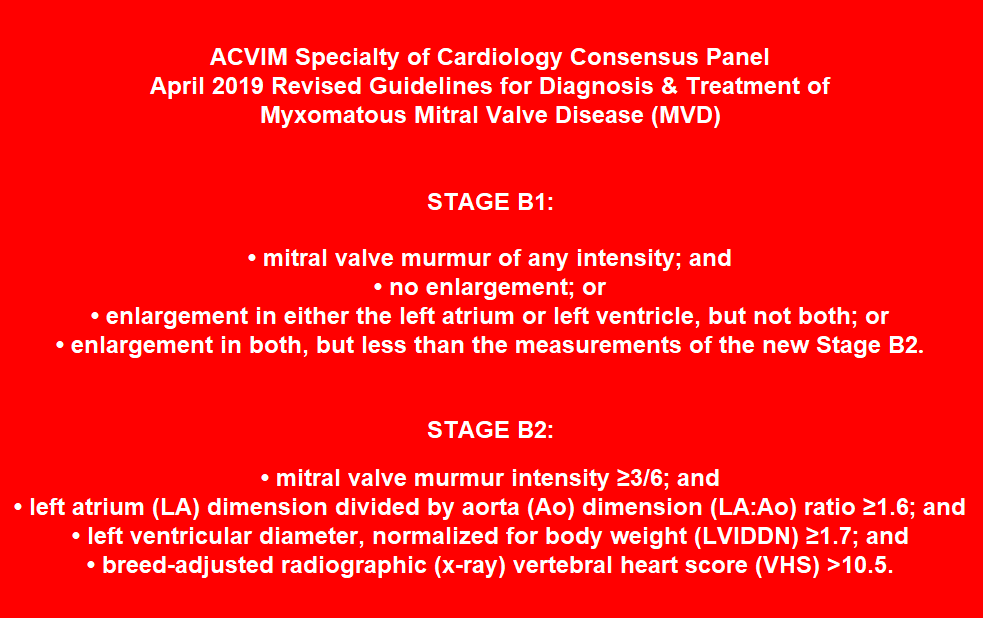
Here are the French investigators' major observations:
• The 2019 ACVIM Consensus Statement's (and 2016 EPIC Study's) classification cut-offs of LA enlargement [LA:Ao >1.6 and LVIDdN >1.7] "do not correctly fit with the CKCS breed regarding both LA and LV sizes. Therefore, in the present study, CKCS breed-specific reference intervals (instead of the ACVIM multi-breed cut-offs) were used to define LA and LV enlargement".
• In healthy CKCS dogs (ACVIM stage A), the median LA:Ao ratios were ... 1.02 (0.90-1.12) at end-systole.
• 37% of the 2019 ACVIM stage B1 CKCSs demonstrated LA enlargement.
• "Regarding LA and LV dilation criteria, there is now scientific evidence that the proposed multibreed echocardiographic [2019] ACVIM [Consensus Statement] cut-offs [LA:Ao >1.6 and LVIDdN >1.7] do not perfectly fit for several specific breeds, and the use of breed-specific reference intervals would be more appropriate. As recently demonstrated by Rishniw and Brown, approximately 10% of healthy CKCSs would be misclassified as having LV enlargement using the ACVIM-recommended scaling exponent (0.294) and the cut-off of 1.7 for normalized end-diastolic LV internal diameter. The study published by Misbach et al dedicated to the establishment of echocardiographic reference intervals in a large population of healthy CKCSs also demonstrated the discrepancy between their LV breed-specific reference intervals (assessed according to the Clinical Laboratory and Standard Institute recommendations) and the predictive reference intervals obtained in the same population using Cornell's formula."
• "Regarding LA size, CKCS dogs seem to have smaller end-diastolic and end-systolic LA dimensions than most other breeds."
• "Based on these data, the end-systolic LA:Ao ratio cut-off value of 1.6 proposed by the 2019 consensus ACVIM statement to detect end-systolic LA enlargement in all-breed dogs appears inappropriate (i.e., too high) for CKCSs, with a risk of missing some mild LA dilations."
• "[A] sub-population [31 dogs -- 37%] of ACVIM B1 dogs with normal LA/Ao ratios actually showed LA dilation detected by LA volume calculation, which was not apparent when applying end-diastolic and end-systolic LA:Ao ratios."
• "Additionally, among the 31 CKCSs with normal end-systolic LA:Ao ratio but increased LASvol/BW volume, 19/31 (61%) showed increased end-diastolic LV [left ventricle] diameter. In other words, these 19 dogs were characterized by mitral valve regurgitation severe enough to have induced both LA and LV dilation (with a median RF value of 38%). Thus, according to the 2019 ACVIM classification, these dogs may actually belong to ACVIM stage B2."
• "LA volumetric quantification should the method of first choice for assessing LA size particularly to stratify ACVIM stage B dogs. Additionally, the early identification of LA enlargement in stage B dogs is of practical interest, as these dogs at risk for decompensation may benefit from a closer longitudinal follow-up than others."
EDITOR'S NOTE: This is the study we have been waiting for since 2016, when the EPIC Study was published. In our Blog, we've been accurately describing the LA:Ao >1.6 and LVIDdN >1.7 cut-offs between normal and enlarged CKCS hearts, in both the EPIC Study and the 2019 ACVIM Consensus Statement, as being arbitrary, bogus, and total nonsense. This French study establishes that as a scientifically documented fact, and most importantly, that the 2019 ACVIM Consensus Statement's definitions of Stages B1 and B2 of mitral valve disease DO NOT APPLY TO CAVALIER KING CHARLES SPANIELS!
Cavaliers may be placed at risk of veterinary malpractice if cardiologists follow the ACVIM's Stages B1 and B2 classifications. Unfortunately, given the intellectual shallowness of so many veterinarians, including cardiologists, we predict this veterinary journal article will go largely unnoticed by them.
March 2024:
German veterinary school offers minimally invasive mitral valve
TEER surgery for MVD-dogs.
 In March 2024, in Munich, Germany, the Ludwig-Maximilians University
(LMU) small animal clinic announced that its cardiovascular team, led by
Dr. Gerhard Wess (right), is providing the
Transcatheter Edge-to-Edge (TEER)
mitral clamp (V-Clamp) technique to MVD-affected dogs in Stage C and in
"advanced Stage B2", which they define as having these minimum
echocardiographic measurements:
In March 2024, in Munich, Germany, the Ludwig-Maximilians University
(LMU) small animal clinic announced that its cardiovascular team, led by
Dr. Gerhard Wess (right), is providing the
Transcatheter Edge-to-Edge (TEER)
mitral clamp (V-Clamp) technique to MVD-affected dogs in Stage C and in
"advanced Stage B2", which they define as having these minimum
echocardiographic measurements:
• LAD (left atrial dimension) >1.9
• LA/Ao (left atrium dimension divided by aorta dimension) >1.9
• LVIDD-n (left ventricle dimension) >1.9
Contact the clinic at Kardio@med.vetmed.uni-muenchen.de
February 2024:
Danish study of 55 cavaliers finds no association between mitral
valve disease and syringomyelia in the breed.
 In
a
February 2024 article, Danish researchers (Maiken B. T. Bach
[right], Camilla L. Stougaard, Maria S. Thøfner, Maria J. Reimann,
Ulrik Westrup, Jørgen Koch, Merete Fredholm, Torben Martinussen, Mette
Berendt, Lisbeth H. Olsen) compared the mitral valve measurements of the
left atrium and left ventricle and murmur grade of 55 cavalier King
Charles spaniels which also had been MRI scanned and diagnosed with or
without syringmyelia (SM). Of the 55 CKCSs, 22 had symptomatic SM, 18
had asymptomatic SM, and 15 had no SM. Of the 55 cavaliers, 13 had no
MVD signs, 32 were diagnosed with MVD Stage B1, 7 with Stage B2, and 3
with Stage C. In Denmark, MVD breeding restrictions issued by the Danish
Kennel Club, assessing mitral regurgitation murmurs and mitral valve
prolapse severities have proven to effectively reduce the prevalence of
early-onset MVD in CKCS, excluding only approximately 5% from breeding.
Therefore, one of the investigators' motivations was a concern that
those Danish breeding restrictions could potentially influence the
prevalence of SM. The secondary aim of the study was to investigate the
severity of MVD in SM-affected cavaliers with and without clinical signs
of SM. The investigators report finding no significant difference in
left atrial (LA) and left ventricle (LV) measurements between CKCSs with
or without SM. However, they did find that CKCS with symptomatic SM had
"significantly smaller" LA and LV dimensions, compared to those with
asymptomatic SM and those without SM.
In
a
February 2024 article, Danish researchers (Maiken B. T. Bach
[right], Camilla L. Stougaard, Maria S. Thøfner, Maria J. Reimann,
Ulrik Westrup, Jørgen Koch, Merete Fredholm, Torben Martinussen, Mette
Berendt, Lisbeth H. Olsen) compared the mitral valve measurements of the
left atrium and left ventricle and murmur grade of 55 cavalier King
Charles spaniels which also had been MRI scanned and diagnosed with or
without syringmyelia (SM). Of the 55 CKCSs, 22 had symptomatic SM, 18
had asymptomatic SM, and 15 had no SM. Of the 55 cavaliers, 13 had no
MVD signs, 32 were diagnosed with MVD Stage B1, 7 with Stage B2, and 3
with Stage C. In Denmark, MVD breeding restrictions issued by the Danish
Kennel Club, assessing mitral regurgitation murmurs and mitral valve
prolapse severities have proven to effectively reduce the prevalence of
early-onset MVD in CKCS, excluding only approximately 5% from breeding.
Therefore, one of the investigators' motivations was a concern that
those Danish breeding restrictions could potentially influence the
prevalence of SM. The secondary aim of the study was to investigate the
severity of MVD in SM-affected cavaliers with and without clinical signs
of SM. The investigators report finding no significant difference in
left atrial (LA) and left ventricle (LV) measurements between CKCSs with
or without SM. However, they did find that CKCS with symptomatic SM had
"significantly smaller" LA and LV dimensions, compared to those with
asymptomatic SM and those without SM.
February 2024:
53.2% of cavaliers died from cardiovascular disease in 17 year
Italian study.
 In
a
February 2024 article, Italian researchers Mariana Roccaro
(right), Romolo Salini, Marco Pietra, Micaela Sgorbini, Eleonora
Gori, Maurizio Dondi, Paolo E. Crisi, Annamaria Conte, Paolo Dalla
Villa, Michele Podaliri, Paolo Ciaramella, Cristina Di Palma, Annamaria
Passantino, Francesco Porciello, Paola Gianella, Carlo Guglielmini,
Giovanni L. Alborali, Sara Rota Nodari, Sonia Sabatelli, Angelo Peli.
examined the death records of 4,957 dogs between 2004 and 2020,
including 62 cavalier King Charles spaniels. They found that
"degenerative diseases affected mostly the Cavalier King Charles spaniel
(51.6%)", and that "The breeds with the highest relative proportion of
cardiovascular causes of death were the Cavalier King Charles Spaniel
(53.2%) and Chihuahua (33.3%)." They also reported that "myxomatous
mitral valve disease [was] the most commonly diagnosed cardiovascular
disease in dogs."
In
a
February 2024 article, Italian researchers Mariana Roccaro
(right), Romolo Salini, Marco Pietra, Micaela Sgorbini, Eleonora
Gori, Maurizio Dondi, Paolo E. Crisi, Annamaria Conte, Paolo Dalla
Villa, Michele Podaliri, Paolo Ciaramella, Cristina Di Palma, Annamaria
Passantino, Francesco Porciello, Paola Gianella, Carlo Guglielmini,
Giovanni L. Alborali, Sara Rota Nodari, Sonia Sabatelli, Angelo Peli.
examined the death records of 4,957 dogs between 2004 and 2020,
including 62 cavalier King Charles spaniels. They found that
"degenerative diseases affected mostly the Cavalier King Charles spaniel
(51.6%)", and that "The breeds with the highest relative proportion of
cardiovascular causes of death were the Cavalier King Charles Spaniel
(53.2%) and Chihuahua (33.3%)." They also reported that "myxomatous
mitral valve disease [was] the most commonly diagnosed cardiovascular
disease in dogs."
February 2024:
An artificial intelligence computer program can accurately
measure left ventricle dimensions from echocardiographic scans.
 In a
February 2024 article, a world-wide team of veterinary
echocardiographers -- cardiologists and radiographers -- (Catherine C.
Stowell [right], Valeria Kallassy, Beth Lane, Jonathan Abbott, Kieran Borgeat,
David Connolly, Oriol Domenech, Joanna Dukes-McEwan, Luca Ferasin,
Josefa Fernández Del Palacio, Chris Linney, Jose Novo Matos, Ilaria
Spalla, Nuala Summerfield, Tommaso Vezzosi, James P. Howard, Matthew J.
Shun-Shin, Darrel P. Francis, Virginia Luis Fuentes), compared their
measurements of the left ventricles (LV) in 461 canine echocardiograms,
including those of 39 cavalier King Charles spaniels, with an artificial
intelligence program (a neural network) designed to process LV data from
echocardiograms in the same fashion as do the veterinary
echocardiographers in their practices. They concluded that:
In a
February 2024 article, a world-wide team of veterinary
echocardiographers -- cardiologists and radiographers -- (Catherine C.
Stowell [right], Valeria Kallassy, Beth Lane, Jonathan Abbott, Kieran Borgeat,
David Connolly, Oriol Domenech, Joanna Dukes-McEwan, Luca Ferasin,
Josefa Fernández Del Palacio, Chris Linney, Jose Novo Matos, Ilaria
Spalla, Nuala Summerfield, Tommaso Vezzosi, James P. Howard, Matthew J.
Shun-Shin, Darrel P. Francis, Virginia Luis Fuentes), compared their
measurements of the left ventricles (LV) in 461 canine echocardiograms,
including those of 39 cavalier King Charles spaniels, with an artificial
intelligence program (a neural network) designed to process LV data from
echocardiograms in the same fashion as do the veterinary
echocardiographers in their practices. They concluded that:
"An artificial intelligence network can be trained to adequately measure linear LV dimensions, with performance indistinguishable from that of experts."
RETURN TO TOP
2023 News
December 2023:
MVD-affected cavaliers with mutations of the
renin-angiotensin-aldosterone gene may be less likely to reach
congestive heart failure.
 This abstract was presented at the September 2023 33d ECVIM-CA
Congress by MJ Reimann, K Meurs (right), J Stern, J Møller, T Martinussen, I
Ljungvall, J Haggstrom, LH Olsen on the subject of
"Renin-angiotensin-aldosterone and phosphodiesterase system gene
polymorphisms associated with congestive heart failure in Cavalier King
Charles Spaniels with myxomatous mitral valve disease". In previous
research, members of this team have reported finding the presence of
polymorphisms* in cavaliers' genes related
to their kidney's RAAS (renin-angiotensin-aldosterone system). When
activated, the RAAS acts to narrow the blood vessels, increase blood
pressure, and conserve sodium. These effects of an activated RAAS
prevent the MVD-affected heart from compensating for the damage done to
the heart by MVD. Thus, the main purpose of angiotensin converting
enzyme inhibitors (ACE-I) such as benazepril and enalapril is to offset
the effects of the activated RAAS upon the heart.
This abstract was presented at the September 2023 33d ECVIM-CA
Congress by MJ Reimann, K Meurs (right), J Stern, J Møller, T Martinussen, I
Ljungvall, J Haggstrom, LH Olsen on the subject of
"Renin-angiotensin-aldosterone and phosphodiesterase system gene
polymorphisms associated with congestive heart failure in Cavalier King
Charles Spaniels with myxomatous mitral valve disease". In previous
research, members of this team have reported finding the presence of
polymorphisms* in cavaliers' genes related
to their kidney's RAAS (renin-angiotensin-aldosterone system). When
activated, the RAAS acts to narrow the blood vessels, increase blood
pressure, and conserve sodium. These effects of an activated RAAS
prevent the MVD-affected heart from compensating for the damage done to
the heart by MVD. Thus, the main purpose of angiotensin converting
enzyme inhibitors (ACE-I) such as benazepril and enalapril is to offset
the effects of the activated RAAS upon the heart.
In this current research abstract, the authors' aim was to determine the impact of certain angiotensin converting enzyme (ACE) gene polymorphisms upon the presence of congestive heart failure (CHF) in MVD-affected cavaliers. They included 182 CKCSs in their study, of which 107 were diagnosed with CHF and 75 others, all over 8 years of age, were not in CHF. They report finding that cavaliers with an ACE polymorphism were less likely to have CHF compared to CKCSs without a polymorphism. They concluded that an ACE polymorphism may play a role in protecting MVD-affected cavaliers from reaching CHF. They also included results of their study of polymorphisms of the cavaliers' phosphodiesterase system genes, and concluded that CKCSs with the PDE5A polymorphism gene had increased odds for CHF compared to dogs without that mutation.
* Polymorphism refers to the presence of two or more variant forms of a specific DNA sequence that can occur among different dogs or breeds.
 December
2023:
Dick White Referrals Veterinary Centre halts MVD open heart
surgeries. Dick White Referrals (DWR) has announced that,
effective December 6, 2023, Dr. Poppy Bristow has decided to cease
performing open heart surgeries, and therefore DWR has halted its open
heart surgery program for the foreseeable future.
December
2023:
Dick White Referrals Veterinary Centre halts MVD open heart
surgeries. Dick White Referrals (DWR) has announced that,
effective December 6, 2023, Dr. Poppy Bristow has decided to cease
performing open heart surgeries, and therefore DWR has halted its open
heart surgery program for the foreseeable future.
November 2023:
Danish researchers identify 56 genes which vary between
MVD-affected cavaliers with and without congestive heart failure.
 In
a
November 2023 article, a team of Danish cardiologists and
geneticists (Maria J Reimann, Signe Cremer, Liselotte Christiansen, Emil
Ibragimov, Fei Gao, Susanna Cirera, Merete Fredholm, Lisbeth H Olsen,
Peter Karlskov-Mortensen [right]) performed mitral valve
transcriptome analysis on 34 cavalier King Charles spaniels, all
diagnosed with mitral valve disease. Of them, 19 were not in heart
failure (CHF) and 15 were. They identified 56 genes which are
differentially expressed between the two groups. They confirmed an
enrichment of genes related to the TNFβ-signaling pathway, extracellular
matrix organization, vascular development, and endothelium damage, which
also have been identified in previous studies.The genes with the
greatest difference in expression between the two groups are CNTN3 and
MYH1, both of which encode proteins, which are predicted to have an
effect on the contractile activity of myocardial cells, which in turn
may have an effect on valvular performance and hemodynamics across the
mitral valve. They postulate that this may result in shear forces with
impact on MVD progression. (See, also, this
January 2023 posting.)
In
a
November 2023 article, a team of Danish cardiologists and
geneticists (Maria J Reimann, Signe Cremer, Liselotte Christiansen, Emil
Ibragimov, Fei Gao, Susanna Cirera, Merete Fredholm, Lisbeth H Olsen,
Peter Karlskov-Mortensen [right]) performed mitral valve
transcriptome analysis on 34 cavalier King Charles spaniels, all
diagnosed with mitral valve disease. Of them, 19 were not in heart
failure (CHF) and 15 were. They identified 56 genes which are
differentially expressed between the two groups. They confirmed an
enrichment of genes related to the TNFβ-signaling pathway, extracellular
matrix organization, vascular development, and endothelium damage, which
also have been identified in previous studies.The genes with the
greatest difference in expression between the two groups are CNTN3 and
MYH1, both of which encode proteins, which are predicted to have an
effect on the contractile activity of myocardial cells, which in turn
may have an effect on valvular performance and hemodynamics across the
mitral valve. They postulate that this may result in shear forces with
impact on MVD progression. (See, also, this
January 2023 posting.)
October 2023:
Colorado State Univ. study finds that vertebral left atrial size
(VLAS) and murmur grade aid diagnosing heart failure in MVD-affected
dogs.
 In an
October 2023 article, Colorado State University veterinary school
investigators (Evan S. Ross, Lance C. Visser [right], Nicholas
Sbardellati, Brianna M. Potter, Alex Ohlendorf, Brian A. Scansen)
studied the x-rays, echocardiograms, and other medical records of 114
dogs, including 4 cavalier King Charles spaniels, to compare the
diagnositic accuracy of vertebral heart size (VHS) values and vertebral
left atrial size (VLAS) measurements in predicting congestive heart failure
(CHF) in dogs diagnosed with mitral valve disease (MVD). They
arbitrarily defined heart enlargement as "LA/Ao_Sx >1.68 and LAD/AoD_Lx
>2.54." They found increased VHS values for dogs not actually in CHF to
have occurred in 54% of the cases, and increased VLAS values in
only 24% of dogs without CHF. They report that the "optimal cutoff"
between CHF and not CHF was a VLAS value above 2.3 vertebrae. They
concluded that:
In an
October 2023 article, Colorado State University veterinary school
investigators (Evan S. Ross, Lance C. Visser [right], Nicholas
Sbardellati, Brianna M. Potter, Alex Ohlendorf, Brian A. Scansen)
studied the x-rays, echocardiograms, and other medical records of 114
dogs, including 4 cavalier King Charles spaniels, to compare the
diagnositic accuracy of vertebral heart size (VHS) values and vertebral
left atrial size (VLAS) measurements in predicting congestive heart failure
(CHF) in dogs diagnosed with mitral valve disease (MVD). They
arbitrarily defined heart enlargement as "LA/Ao_Sx >1.68 and LAD/AoD_Lx
>2.54." They found increased VHS values for dogs not actually in CHF to
have occurred in 54% of the cases, and increased VLAS values in
only 24% of dogs without CHF. They report that the "optimal cutoff"
between CHF and not CHF was a VLAS value above 2.3 vertebrae. They
concluded that:
"... when echocardiography is unavailable, VLAS and murmur grade have clinical utility to aid in differentiating cardiogenic from noncardiogenic causes of respiratory signs, whereas VHS might be less useful. These results might be especially useful to help rule out CHF in dogs with respiratory signs and increased VHS."
October 2023:
Dr. Corcoran's team finds diseased mitral valve leaflet cells
can be reversed to normal cells by regulating SMAD2.
 In
an
October 2023 article, a team of cardiologists and geneticists at The
Roslin Institute of the University of Edingurgh (Andrew J. McNair, Greg
R. Markby, Qiyu Tang, Vicky E. MacRae), led by Dr. Brendan M. Corcoran
(right), examined the mitral valves of 12 deceased dogs -- 6
with normal hearts and 6 with MVD-diseased hearts, including one
cavalier King Charles spaniel -- to identify changes in downstream
signals in the TGFβ pathway in canine mitral valve disease (MVD) and
examine the effects of antagonism of one significant signal, SMAD2. SMAD
are a family of proteins that are the main signal transducers for
receptors of the transforming growth factor beta (TGFβ) superfamily,
which plays a vital role in regulating cell development and growth.
SMAD2 is a protein that is encoded by the SMAD2 gene. SMAD2 mediates the
signal of TGFβ and regulates certain cellular-damaging processes,
including converting normal quiescent valve interstitial cells (qVICs)
of the mitral valve into disease-derived activated myofibroblasts
(aVICs). SMAD2 protein expression can be regulated ("antagonized") by
inserting certain other proteins which in this case were able to
transition diseased aVICs cells back to the normal phenotype qVICs. They
also found similar characteristics in another TGFβ pathway, identified
as PI3K/AKT/mTOR. The team's ultimate goal is to develop new therapies
for treating MVD in dogs by preventing normal mitral valve cells from
being converted to diseased cells and also by reverting diseased cells
back to normal ones.
In
an
October 2023 article, a team of cardiologists and geneticists at The
Roslin Institute of the University of Edingurgh (Andrew J. McNair, Greg
R. Markby, Qiyu Tang, Vicky E. MacRae), led by Dr. Brendan M. Corcoran
(right), examined the mitral valves of 12 deceased dogs -- 6
with normal hearts and 6 with MVD-diseased hearts, including one
cavalier King Charles spaniel -- to identify changes in downstream
signals in the TGFβ pathway in canine mitral valve disease (MVD) and
examine the effects of antagonism of one significant signal, SMAD2. SMAD
are a family of proteins that are the main signal transducers for
receptors of the transforming growth factor beta (TGFβ) superfamily,
which plays a vital role in regulating cell development and growth.
SMAD2 is a protein that is encoded by the SMAD2 gene. SMAD2 mediates the
signal of TGFβ and regulates certain cellular-damaging processes,
including converting normal quiescent valve interstitial cells (qVICs)
of the mitral valve into disease-derived activated myofibroblasts
(aVICs). SMAD2 protein expression can be regulated ("antagonized") by
inserting certain other proteins which in this case were able to
transition diseased aVICs cells back to the normal phenotype qVICs. They
also found similar characteristics in another TGFβ pathway, identified
as PI3K/AKT/mTOR. The team's ultimate goal is to develop new therapies
for treating MVD in dogs by preventing normal mitral valve cells from
being converted to diseased cells and also by reverting diseased cells
back to normal ones.
October 2023:
Study of 226 cavaliers finds x-rays and blood tests are best at
predicting Stage B2 of mitral valve disease.
 In
an
October 2023 article, a team of veterinary cardiologists (Sonya
Wesselowski [right], Sonya G. Gordon, Ryan Fries, Ashley B.
Saunders, K.Tess Sykes, Jordan Vitt, Bruno Boutet, Jens Haggstrom, Saki
Kadotani, Jonathan Stack, Brian G. Barnett) performed various cardiac
tests -- vertebral heart size (VHS),
N-terminal pro B-type natriuretic
peptide blood test (NT-proBNP),
vertebral left atrial size (VLAS), and
electrocardiography -- to determine which tests best predict
echocardiography findings of Stage B1 or Stage B2 (LA/Ao>1.6 and
LVIDdN>1.7) of mitral valve disease, based upon the
2019 ACVIM Consensus
Statement. Their stated goals were to develop breed-specific cut-offs
for individual screening tests and develop predictive models in
combination for identifying Stage B2 cavaliers in cases in which no
echocardiographic examinations are available. They produced these
reference interval (RI) and full range findings for each type of test:
In
an
October 2023 article, a team of veterinary cardiologists (Sonya
Wesselowski [right], Sonya G. Gordon, Ryan Fries, Ashley B.
Saunders, K.Tess Sykes, Jordan Vitt, Bruno Boutet, Jens Haggstrom, Saki
Kadotani, Jonathan Stack, Brian G. Barnett) performed various cardiac
tests -- vertebral heart size (VHS),
N-terminal pro B-type natriuretic
peptide blood test (NT-proBNP),
vertebral left atrial size (VLAS), and
electrocardiography -- to determine which tests best predict
echocardiography findings of Stage B1 or Stage B2 (LA/Ao>1.6 and
LVIDdN>1.7) of mitral valve disease, based upon the
2019 ACVIM Consensus
Statement. Their stated goals were to develop breed-specific cut-offs
for individual screening tests and develop predictive models in
combination for identifying Stage B2 cavaliers in cases in which no
echocardiographic examinations are available. They produced these
reference interval (RI) and full range findings for each type of test:
VHS: Stage B1 (167 CKCSs): Reference Interval 10.2-11.0; full range 8.5-12.5. Stage B2 (45 CKCSs): Reference Interval 11.0-12.0; range 10.0-13.1. A VHS 11.5 had high specificity for predicting stage B2.
VLAS: Stage B1: Reference Interval 1.7-2.1; full range 1.2-3.2; Stage B2: Reference Interval 1.9-2.6; range 1.6-3.4
VHS + VLAS: Stage B1: Reference Interval 11.9-13.0; range 10.1-15.2; Stage B2: Reference Interval 12.9-14.5; range 11.7-15.9.
NT-proBNP: Stage B1: Reference Interval 515.2-917.3; range 250.0-2208.4; Stage B2: Reference Interval 960.4-1972.8; range 478.8-3656.8. An NT-proBNP 1138 pmol/L had high specificity for predicting stage B2.
LA/Ao: Stage B1: Reference Interval 1.20-1.38; range 0.76-1.97; Stage B2: Reference Interval 1.68-1.86; range 1.61-2.77
LVIDdN: Stage B1: Referencc Interval 1.39-1.62; range 1.15-2.03; Stage B2: Reference Interval 1.77-2.00; range 1.71-2.53
They concluded that if only one diagnostic test was being performed, "NT-proBNP and VHS have good utility for predicting echocardiographic stage B2 MMVD in CKCS as individual tests", and that "VLAS measurement did not perform as well as VHS in CKCS." However, they recommend that more than one test be relied upon, and the more tests, the better.
 EDITOR'S
NOTE: This study relies upon the totally baseless
assumptions that:
EDITOR'S
NOTE: This study relies upon the totally baseless
assumptions that:
(1) all cavaliers with echocardiographic measurements of LA/Ao>1.6 and LVIDdN>1.7 should be treated with pimobendan, and that
(2) if any cavaliers have only one of echo measurement in those ranges and not both, then they should not be treated with pimobendan.
No effort is made in this study to determine if any of the dogs actually have enlarged left heart chambers. These two baseline measurements -- LA/Ao>1.6 and LVIDdN>1.7 -- have no scientific relevance to enlarged hearts in cavaliers or in any breed of dog. They simply were made up by the three chief EPIC Study investigators (two of whom are listed as participants in this study as well) way back in 2011 before any of their EPIC Study research was conducted, and they have stuck to those defining measurements ever since, even conning the ACVIM to incorporate them into the 2019 re-definitions of Stages B1 and B2. So, at the outset of this study, the researchers use a bogus standard and then compare actual data derived from 226 cavaliers to try to match that bogus standard. Thus, this study was destined to fail, and so it has.
The reference intervals which they have published are interesting, but have nothing to do with whether the 226 dogs had enlarged left heart chambers or not. But the commentary in the study is full of ironical hypocracy. Here are actual quotes:
"This suggests that biomarker cut-offs or predictive models including NT-proBNP that are derived from non-breed specific data may not perform as well as breed-specific models or cut-offs for predicting stage B2 MMVD. Similarly, objective radiographic measurements of cardiac size such as the vertebral heart size (VHS) are also known to vary by breed, with a variety of breed-specific normal VHS reference intervals previously published." (What irony! It apparently never has dawned upon any of these researchers that actual LA/Ao and LVIDdN measurements likewise -- at a minimum -- are breed-specific! Not to mention that their LA/Ao>1.6 and LVIDdN>1.7 definition is not even based upon any species-wide published data.)
"... [I]f echocardiography is not pursued and cut-offs are being relied upon to determine whether to initiate pharmacologic therapy, high specificity cut-offs should be utilized to minimize false positives and erroneous treatment of stage B1 dogs." (Why worry now about "false positives", considering no thought was given to that possibility when that arbitrary definition of Stage B2 was dreamed up?! Keep in mind that when this Stage B2 definition first was used, in the EPIC Study, 8.4% of the dogs being treated with pimobendan -- 15 of them -- died of cardiac-related sudden deaths!)
What should be (but certainly is not) the "Bottom Line" of this study is that, if you want to determine if your cavalier King Charles spaniel has significant enlargement of the left side of its heart, compare an earlier echo scan with a current one, or an earlier chest x-ray with a current one, and if the measurement in the current one is significantly higher than the earlier one, then the dog's heart is enlarged and should be treated with pimobendan. What these people are engaging in here in this study is an exercise in irrelevant numbers.
October 2023:
Artificial intelligence-based method of detecting MVD stages
from x-rays cannot match up with the 2019 ACVIM Stage B2 definition.
 In a
September 2023 article, Italian, Polish, and Swiss cardiologists
(Carlotta Valente, Marek Wodzinski, Carlo Guglielmini, Helen Poser,
David Chiavegato, Alessandro Zotti, Roberto Venturini, Tommaso Banzato
[right]) applied an artificial intelligence (AI) algorithm to heart
x-rays of 1,242 dogs diagnosed with mitral valve disease (MVD), in an
effort to match the x-ray diagnoses with the 2019 ACVIM definitions of
Stages B1, B2, C, and D of MVD. They found that their algorithm had
"high accuracy" in predicting Stages B1, C, and D, but not Stage B2.
They found that "a significant number", 23.6%, of the dogs classified as
being in Stage B2 by echocardiograms were "misclassifed" by the AI
algorithm as Stage B1. They termed the accuracy level for detecting
Stage B2 dogs as only "moderate".
In a
September 2023 article, Italian, Polish, and Swiss cardiologists
(Carlotta Valente, Marek Wodzinski, Carlo Guglielmini, Helen Poser,
David Chiavegato, Alessandro Zotti, Roberto Venturini, Tommaso Banzato
[right]) applied an artificial intelligence (AI) algorithm to heart
x-rays of 1,242 dogs diagnosed with mitral valve disease (MVD), in an
effort to match the x-ray diagnoses with the 2019 ACVIM definitions of
Stages B1, B2, C, and D of MVD. They found that their algorithm had
"high accuracy" in predicting Stages B1, C, and D, but not Stage B2.
They found that "a significant number", 23.6%, of the dogs classified as
being in Stage B2 by echocardiograms were "misclassifed" by the AI
algorithm as Stage B1. They termed the accuracy level for detecting
Stage B2 dogs as only "moderate".
EDITOR'S NOTE: We know what their problem was with the Stage B2 classification. The ACVIM's 2019 definition of Stage B2 is completely bogus. Thus, this AI algorithm was destined to fail when trying to predict Stage B2 of MVD. That Stage B2 classification is based upon an arbitrary species-wide definition of left chamber enlargement: left atrium size being LA/Ao >1.6 and left ventricle size being LVIDDN >1.7. It was well established long before that bogus definition was dreamed up that the normal sized heart chambers of different breeds have different dimensions. Indeed, we have cited (with quotations) over two dozen veterinary journal articles on the subjects of various breeds making that very observation. See the list at this link.
October 2023:
Pimobendan study finds its absorption and elimination in
MVD-affected dogs is highly variable and unrelated to stage of MVD and
other factors.
 In a
September 2023 article, North Carolina State veterinary researchers
(Anna K. McManamey, Teresa C. DeFrancesco [right], Kathryn M.
Meurs, Mark G. Papich) studied 54 dogs diagnosed in various stages of
mitral valve disease, including 14 (24.5%) cavalier King Charles
spaniels, to determine how a dog's age, breed, body condition score,
stage of MVD (Stages B2, C, and D), and dosage would affect the
pharmacokinetics (the process by which a drug is absorbed, distributed,
metabolized, and eliminated by the body) of the drug pimobendan. Once
the drug is consumed, it metabolizes to O-desmethyl-pimobendan (ODMP).
They report finding that the absorption and elimination of pimobendan
and its metabolite ODMP were "highly variable" and not dependent upon
age, body weight or condition score, stage of MVD, dose, or any other
measured factor. They were unable to identify any source of this
variability.
In a
September 2023 article, North Carolina State veterinary researchers
(Anna K. McManamey, Teresa C. DeFrancesco [right], Kathryn M.
Meurs, Mark G. Papich) studied 54 dogs diagnosed in various stages of
mitral valve disease, including 14 (24.5%) cavalier King Charles
spaniels, to determine how a dog's age, breed, body condition score,
stage of MVD (Stages B2, C, and D), and dosage would affect the
pharmacokinetics (the process by which a drug is absorbed, distributed,
metabolized, and eliminated by the body) of the drug pimobendan. Once
the drug is consumed, it metabolizes to O-desmethyl-pimobendan (ODMP).
They report finding that the absorption and elimination of pimobendan
and its metabolite ODMP were "highly variable" and not dependent upon
age, body weight or condition score, stage of MVD, dose, or any other
measured factor. They were unable to identify any source of this
variability.
EDITOR'S NOTE: This study started out to be promising, because the investigators announced that they were going to compare cavaliers to all other breeds. They included five times as many CKCSs as any other breed, and they stated:
"The most represented breed was Cavalier King Charles Spaniel (CKCS); therefore, this was examined as a categorical covariate as CKCS vs all others. ... Sources of variability examined were dog age, weight, dose, body condition score, stage of heart disease (B2, C, and D; B2 and combined C, D), serum creatinine concentration, serum alkaline phosphatase activity, and breed (CKCS vs other breeds)."
Unfortunately, they did not keep their promise. They provide absolutely no data unique to our breed in their entire article. But, nevertheless, the reported results of not finding any statistically significant source (stage of MVD, age, dosage, etc.) is useful information. We have found that the effects of pimobendan in treating dogs with MVD can be unpredictable. For some, it is a God-send, perking them up and even reducing the degree of enlargement of their heart chambers. For others, it drags them down or seems to have no effect at all. And for a few, it worsens their heart conditions, even causing immediate death, presumably due to atrial fibrillation or rupture of chordae tendenae. Pimobendan can be a crap shoot, and this study adds to that reputation.
 September
2023:
University of Florida launches open heart surgery for
MVD-affected dogs. On September 27, 2023, the University of
Florida veterinary school announced that it has launched an open heart
surgery program for dogs with mitral valve disease (MVD). Under the
direction of Dr. Katsuhiro Matsuura (right), his surgery team
is performing three to four surgeries per month. Read the details of the
announcement in
this press release, and also see
the main webpage here.
September
2023:
University of Florida launches open heart surgery for
MVD-affected dogs. On September 27, 2023, the University of
Florida veterinary school announced that it has launched an open heart
surgery program for dogs with mitral valve disease (MVD). Under the
direction of Dr. Katsuhiro Matsuura (right), his surgery team
is performing three to four surgeries per month. Read the details of the
announcement in
this press release, and also see
the main webpage here.
September 2023:
PDE5A polymorphism in 52 MVD-affected cavaliers did not affect
platelet aggregation or pimobendan's effect upon platelets.
 In a
September 2023 article, a worldwide team of researchers (Maria J.
Reimann, Daniel N. Faisst, Mads Knold, Kathryn M. Meurs, Joshua A.
Stern, Signe E. Cremer, Jacob E. Møller, Ingrid Ljungvall, Jens
Haggstrom, Lisbeth H. Olsen [right]) reported their study of the
relationship between platelet aggregation in the blood and the
introduction of pimobendan as a treatment for mitral valve disease (MVD)
in cavalier King Charles spaniels. It has been hypothesized that
platelet aggregation plays a role in the onset and progression of MVD in dogs. Platelets express the phosphodiesterase (PDE)
genes PDE5 and PDE3. Thus, inhibiting platelet aggregation and
suppressing these PDE genes has been a major aim of pimobendan
treatment. Mutations (polymorphisms) of the PDE5A gene have been found to
decrease the PDE5-inhibitor effect of the drug sildenafil on treating
pulmonary hypertension in dogs. These investigators hypothesized that
such a polymorphism of PDE5A in cavaliers would increase platelet
aggregation and also reduce the response of pimobendan overall in
treating MVD in CKCSs. They studied 52 client-owned cavaliers in
Denmark: 10 in Stage A (no auscultatory heart murmur and no or minimal
mitral regurgitation); 29 in Stage B1 (using the 2019 definition); and
13 in Stage B2 (LA/Ao >1.6 and LVIDDN > 1.7). Their gene testing found
that the PDE5A polymmorphism E90K is highly prevalent in cavaliers, with
46% heterozygous (carriers) and 42% homozygous (affected), and only 12%
of the normal "wild-type" dogs. More importantly, they found that
cavaliers with the PDE5A:E90K polymorphism did not appear to have
altered platelet function or response to pimobendan treatment.
In a
September 2023 article, a worldwide team of researchers (Maria J.
Reimann, Daniel N. Faisst, Mads Knold, Kathryn M. Meurs, Joshua A.
Stern, Signe E. Cremer, Jacob E. Møller, Ingrid Ljungvall, Jens
Haggstrom, Lisbeth H. Olsen [right]) reported their study of the
relationship between platelet aggregation in the blood and the
introduction of pimobendan as a treatment for mitral valve disease (MVD)
in cavalier King Charles spaniels. It has been hypothesized that
platelet aggregation plays a role in the onset and progression of MVD in dogs. Platelets express the phosphodiesterase (PDE)
genes PDE5 and PDE3. Thus, inhibiting platelet aggregation and
suppressing these PDE genes has been a major aim of pimobendan
treatment. Mutations (polymorphisms) of the PDE5A gene have been found to
decrease the PDE5-inhibitor effect of the drug sildenafil on treating
pulmonary hypertension in dogs. These investigators hypothesized that
such a polymorphism of PDE5A in cavaliers would increase platelet
aggregation and also reduce the response of pimobendan overall in
treating MVD in CKCSs. They studied 52 client-owned cavaliers in
Denmark: 10 in Stage A (no auscultatory heart murmur and no or minimal
mitral regurgitation); 29 in Stage B1 (using the 2019 definition); and
13 in Stage B2 (LA/Ao >1.6 and LVIDDN > 1.7). Their gene testing found
that the PDE5A polymmorphism E90K is highly prevalent in cavaliers, with
46% heterozygous (carriers) and 42% homozygous (affected), and only 12%
of the normal "wild-type" dogs. More importantly, they found that
cavaliers with the PDE5A:E90K polymorphism did not appear to have
altered platelet function or response to pimobendan treatment.
EDITOR'S NOTE: As a side note, these researchers persist in arbitrarily defining left atrium (LA) enlargement in all cavaliers as LA/Ao >1.6 and left ventricle (LV) enlargment as LVIDDN > 1.7. It is well documented that those reference ranges are totally bogus, especially for cavaliers. If any professionally responsible veterinary cardiologist wants to accurately diagnose a cavalier with heart enlargement, she does not apply a fraudulent species-wide definition. She examines the dog on an individiual basis, including x-rays of the heart and comparisons with previous echo scans and x-rays to detect any significant enlargement. If applying this arbitrary, bogus, species-wide definition (LA/Ao >1.6 and LVIDDN > 1.7) is how she diagnoses her individual clinical patients before determining if and when to administer pimobendan, then she is treading heavily into the field of malpractice.
July 2023:
Turkish study of
MVD-affected cavaliers finds 2.25 is the VLAS cut off for an enlarged
left atrium.
 In a
July 2023 article, three researchers at the Istanbul University
(Gonul Remzi [right], Hande Sağoğlu, Murat Suzan) studied the hearts of 24
cavalier King Charles spaniels -- 6 in Stage A (the control group), 6 in
Stage B1, 6 in Stage B2, and 6 in Stage C -- to determine the VLAS
(Vertebral Left Atrial Size, using x-rays of the dogs' hearts) and
compare those VLAS measurements to echocardiographic measurements of the
2019 ACVIM stages of mitral valve disease (MVD). They report and confirm
several now obvious findings about left atrium and overall heart size
changes as MVD progresses, such as "VHS [Vertebral Heart Size] and VLAS
values were significantly higher in the MMVD group than in the control
group." They conclude:
In a
July 2023 article, three researchers at the Istanbul University
(Gonul Remzi [right], Hande Sağoğlu, Murat Suzan) studied the hearts of 24
cavalier King Charles spaniels -- 6 in Stage A (the control group), 6 in
Stage B1, 6 in Stage B2, and 6 in Stage C -- to determine the VLAS
(Vertebral Left Atrial Size, using x-rays of the dogs' hearts) and
compare those VLAS measurements to echocardiographic measurements of the
2019 ACVIM stages of mitral valve disease (MVD). They report and confirm
several now obvious findings about left atrium and overall heart size
changes as MVD progresses, such as "VHS [Vertebral Heart Size] and VLAS
values were significantly higher in the MMVD group than in the control
group." They conclude:
"As a result of this study in Cavalier King Charles spaniel dogs, a cut-off VLAS value >2.25 in dogs with MMVD was found to be a cost-effective, easy-to-use, and reliable method to detect left atrial enlargement and monitor disease. However, the atrial enlargement does not always point in the same direction because of the overall structure of the heart, pulmonary edema, effusion, mass formation, and so on. Considering the limitations of radiographic diagnosis in the presence of additional diseases and the possible inclusion of breed-specific differences, new studies on this topic are needed."
 EDITOR'S NOTE: This was a very small study -- only 24 cavaliers --
but its details include some very interesting echocardiographic
measurements. First of all, let us reiterate that the
ACVIM's 2019
definitions of Stages B1 and B2 are completely bogus. We re-state that
because these researchers are trying to relate x-ray measurements to
those ACVIM echo definitions. So, in effect, these researchers are
comparing x-ray calculations of actual cavaliers to imaginary echo
measurements. That pretty much makes this effort a complete waste of
time. Nevertheless, let us look at the data, because it highlights how
phony the ACVIM is in its 2019 definitions.
EDITOR'S NOTE: This was a very small study -- only 24 cavaliers --
but its details include some very interesting echocardiographic
measurements. First of all, let us reiterate that the
ACVIM's 2019
definitions of Stages B1 and B2 are completely bogus. We re-state that
because these researchers are trying to relate x-ray measurements to
those ACVIM echo definitions. So, in effect, these researchers are
comparing x-ray calculations of actual cavaliers to imaginary echo
measurements. That pretty much makes this effort a complete waste of
time. Nevertheless, let us look at the data, because it highlights how
phony the ACVIM is in its 2019 definitions.
The left atrium-to-aorta ratio (LA/Ao) is very telling. The ACVIM totally unscientifically defined an enlarged left atrium as having a LA/Ao of at least 1.6 for any dog of any breed. In this study, the Stage A cavaliers (meaning they had no MVD whatsoever -- no murmur, no enlargement, no nothing) had a range of LA/Ao ratios from 1.12 to 1.22. The Stage B1 dogs (meaning a murmur but allegedly absolutely no left atrial enlargement) had a range from 1.37 to 1.49. The Stage B2 dogs (meaning, according to the ACVIM, a murmur and left atrial enlargement) had a range from 1.51 to 1.63.
Now, considering that the ACVIM defined Stage B2 as having a minimum LA/Ao ratio of 1.6, how could these researchers place any cavaliers in the Stage B2 class when their LA/Ao ratios were between 1.51 and 1.59? We think we know the answer: These researchers could not in good conscience ignore the fact that those dogs with LA/Ao ratios below 1.6 nevertheless clearly had enlarged left atria. These data also highlight the glaring fact that when the Stage A dog with the largest left atrium had a LA/Ao of 1.22 and the Stage B1 dog (remember, no enlargement in Stage B1 dogs) with the lowest LA/Ao was 1.37, there is something odd going on*. The spread between 1.22 and 1.37 is very significant, and in reality it screams the fact that the Stage B1 dogs with LA/Ao ratios of 1.37 to 1.49 really did have enlarged left atria.
So, on the one hand, this study only confirms the obvious about how MVD progresses in the CKCS. On the other, it confirms how bogus the ACVIM's 2019 definitions of Stages B1 and B2 are. And remember, bogus definitions of Stages B1 and B2 translate to veterinary malpractice when those definitions determine when to start medicating MVD.
* How could cavaliers with no murmur have LA/Ao ratios no higher than 1.22 and cavaliers with a murmur but no enlargement have LA/Ao ratios no lower than 1.37 and up to 1.49? We think the answer is that those Stage B1 CKCSs really did have enlarged left atria. That is one more phony aspect of the ACVIM's 2019 definitions. Cardiologists no longer are allowed to "call 'em like they see 'em." Instead, they have to squeeze into the tiny box that the ACVIM had fashioned.
 July
2023:
University of Florida announces the start of open heart mitral
valve surgeries. The University of Florida's Small
Animal Hospital announced that beginning in July 2023, it will start a
program of open heart surgeries using cardiopulmonary bypass to repair
mitral valves of dogs in Stages C and D, and advanced Stage B2, of
mitral valve disease. Dr. Katsuhiro Matsuura (right) is
joining the staff of the hospital to lead the program. The cost for
each surgery is expected to be between $45,000 and $50,000. See the
details at
this webpage. Read more about Dr. Matsuura at our
June 2022 article below.
July
2023:
University of Florida announces the start of open heart mitral
valve surgeries. The University of Florida's Small
Animal Hospital announced that beginning in July 2023, it will start a
program of open heart surgeries using cardiopulmonary bypass to repair
mitral valves of dogs in Stages C and D, and advanced Stage B2, of
mitral valve disease. Dr. Katsuhiro Matsuura (right) is
joining the staff of the hospital to lead the program. The cost for
each surgery is expected to be between $45,000 and $50,000. See the
details at
this webpage. Read more about Dr. Matsuura at our
June 2022 article below.
July 2023:
Taurine supplementation
serves no purpose in a study including MVD-affected cavaliers.
 In a
July 2023 article, a team of University of Florida researchers (Sara
Brethel, Seth Locker, Renee Girens, Paulo Rivera, Darcy Adin [right])
and University of North Carolina State's Kathryn Meurs, tested 14 dogs,
including 4 (29%) cavalier King Charles spaniels, diagnosed with
congestive heart failure (CHF) due to mitral valve disease (MVD) for a
two-week period to see if taurine supplementation would suppress their
renin-angiotensin-aldosterone system (RAAS). None of the dogs were
taurine-deficient. They report finding that oral taurine supplementation
did not have a suppressive effect upon the RAAS in this group of dogs
with naturally occurring CHF secondary to MVD.
In a
July 2023 article, a team of University of Florida researchers (Sara
Brethel, Seth Locker, Renee Girens, Paulo Rivera, Darcy Adin [right])
and University of North Carolina State's Kathryn Meurs, tested 14 dogs,
including 4 (29%) cavalier King Charles spaniels, diagnosed with
congestive heart failure (CHF) due to mitral valve disease (MVD) for a
two-week period to see if taurine supplementation would suppress their
renin-angiotensin-aldosterone system (RAAS). None of the dogs were
taurine-deficient. They report finding that oral taurine supplementation
did not have a suppressive effect upon the RAAS in this group of dogs
with naturally occurring CHF secondary to MVD.
EDITOR'S NOTE: This study was small in number (14 dogs*) and in time (14 days), but serves to show that adding taurine to the diets of MVD-affected dogs in heart failure serves no purpose whatsoever apart from producing expensive urine. When peddlers of canine heart supplements include taurine in their formulas (such as the "Five Leaf Botanicals Canine Heart Health Program for Canine Heart Disease"), they are not focused at all upon MVD.
For more veterinary journal articles finding that MVD-affected dogs do not need taurine supplementation, see this review. We have found none concluding that adding taurine improves the condtion of MVD-affected dogs, unless their bloodwork shows a taurine deficiency.
* The researchers were satisified with the number of dogs. They wrote: "A priori power analysis showed a minimum of 12 dogs would be needed to show a significant decrease in angiotensin II concentrations between V1 and V2 with a power of 80% and significance level of 5%".
July 2023:
Purina's Pro Plan CardioCare kibble dog food fails the cavalier
test.
 In a
July 2023 article by an international team of veterinary
cardiologists and nutritionists (Mark A. Oyama [right], Brian A. Scansen, Adrian
Boswood, Guilherme Goldfeder, Steven Rosenthal, Richard Cober, Kendra
LaFauci, Ryan C. Friese, Márcia Gomes, Yu-Mei Ruby Chang, Qinghong Li)
tested Purina's Pro Plan CardioCare kibble dog food on a group of 101
MVD-affected dogs, including 29 cavalier King Charles spaniels (29%),
all in Stage B1, over a 365 day period to see if it met its claims that
it would slow or arrest echocardiographic left heart enlargement in
Stage B1 dogs. The special ingredients in Purina's food included vitamin
E, fish oil (for omega-3s), taurine, carnitine, magnesium, and
medium-chain triglycerides (MCTs). After a year of dogs being fed the
Purina recipe or a control diet, the researchers reported that:
In a
July 2023 article by an international team of veterinary
cardiologists and nutritionists (Mark A. Oyama [right], Brian A. Scansen, Adrian
Boswood, Guilherme Goldfeder, Steven Rosenthal, Richard Cober, Kendra
LaFauci, Ryan C. Friese, Márcia Gomes, Yu-Mei Ruby Chang, Qinghong Li)
tested Purina's Pro Plan CardioCare kibble dog food on a group of 101
MVD-affected dogs, including 29 cavalier King Charles spaniels (29%),
all in Stage B1, over a 365 day period to see if it met its claims that
it would slow or arrest echocardiographic left heart enlargement in
Stage B1 dogs. The special ingredients in Purina's food included vitamin
E, fish oil (for omega-3s), taurine, carnitine, magnesium, and
medium-chain triglycerides (MCTs). After a year of dogs being fed the
Purina recipe or a control diet, the researchers reported that:
"In conclusion, a specially formulated diet was not associated with significant changes in LAD [left atrium dimension] and LVIDd [left ventricle dimension] when fed to dogs with mild subclinical DMVD for 1 year as compared to control diet. Additional studies are needed to better understand the effect of diet and the metabolome in dogs with DMVD.
 EDITOR'S NOTE:
Forgive us for this "I told ya so", but that is
exactly what we did in a Blog article dated November 18, 2021
("Don't be fooled by Purina's hype of its new 'Pro Plan CardioCare'
kibble dog food"). This
Purina recipe was a sad joke from Day One. Even Purina's own researchers
warned in
a previous study, that, "Large studies with more dogs from
different breeds should be conducted to confirm the results." Well, this
current study is that "large study with ... different breeds". But that
warning did not stop Purina from rushing this load of crap to market in
January 2022 with the most false hype (still on its website): "Purina
Pro Plan Veterinary Diets CC CardioCare contains innovative and advanced
nutrition to support cardiac function in dogs." No, it
does not!
EDITOR'S NOTE:
Forgive us for this "I told ya so", but that is
exactly what we did in a Blog article dated November 18, 2021
("Don't be fooled by Purina's hype of its new 'Pro Plan CardioCare'
kibble dog food"). This
Purina recipe was a sad joke from Day One. Even Purina's own researchers
warned in
a previous study, that, "Large studies with more dogs from
different breeds should be conducted to confirm the results." Well, this
current study is that "large study with ... different breeds". But that
warning did not stop Purina from rushing this load of crap to market in
January 2022 with the most false hype (still on its website): "Purina
Pro Plan Veterinary Diets CC CardioCare contains innovative and advanced
nutrition to support cardiac function in dogs." No, it
does not!
June 2023:
Laboklin offers a genetic test for mitral valve disease in
cavaliers.
 The
UK veterinary diagnostics testing laboratory Laboklin is offering a
genetic test for cavalier King Charles spaniels for mutations of the
nebulette gene (NEBL). In a
December 2022 study, Australian geneticists report finding that six
CKCSs with the heterozygous wild-type version of the NEBL gene,
rather than the homozygous NEBL1-3 alleles of that gene, had
smaller left atria (LA:Ao) and left ventricles (LVIDdN). They wrote
that, " It is expected that the dogs heterozygous for wild-type alleles
at these loci will experience reduced risk of mortality as a result of
their lower LVIDdN and LA:Ao measurements."
The
UK veterinary diagnostics testing laboratory Laboklin is offering a
genetic test for cavalier King Charles spaniels for mutations of the
nebulette gene (NEBL). In a
December 2022 study, Australian geneticists report finding that six
CKCSs with the heterozygous wild-type version of the NEBL gene,
rather than the homozygous NEBL1-3 alleles of that gene, had
smaller left atria (LA:Ao) and left ventricles (LVIDdN). They wrote
that, " It is expected that the dogs heterozygous for wild-type alleles
at these loci will experience reduced risk of mortality as a result of
their lower LVIDdN and LA:Ao measurements."
Laboklin's test #8831 requires whole blood samples and is charging US$76.80/UK£48.00 for each test.
 EDITOR'S
NOTE: The December 2022 study compared only six cavaliers
with the wild-type NEBL gene to 172 CKCSs with the mutations. Allegedly
the six had lower measurements of their left atria and left ventricles
than the 172 with mutations, and then the study's investigators seem to
make the hurried conclusion that:
EDITOR'S
NOTE: The December 2022 study compared only six cavaliers
with the wild-type NEBL gene to 172 CKCSs with the mutations. Allegedly
the six had lower measurements of their left atria and left ventricles
than the 172 with mutations, and then the study's investigators seem to
make the hurried conclusion that:
"The lower cardiac measurements in the [six] heterozygous dogs indicate a significantly reduced risk of severe MMVD disease. Our analysis suggests that despite relative fixation of the NEBL risk alleles, healthy reference alleles at NEBL1-3 exist in low frequency in the CKCS breed and can be used to reduce MMVD severity and mortality."
We are not so sure, but the consequences of the testing results is that more of the heterozygous dogs will be added to the gene pool, which otherwise would not be considered to be mated at all. So, "no harm, no foul".
June 2023:
Long term outcomes of 111 MVD-affected dogs following left
atrial decompression surgeries are reported.
 In a
June 2023 abstract, a team of cardiologists at the VCA West Los
Angeles Animal Hospital (Kevin L. Phipps [right], Justin Allen,
Kirstie Barrett) reported on the long term outcomes of 111 dogs
surgically treated with
left atrial decompression (LAD)
between October
2018 and September 2021. All of the dogs were diagnosed with severe
mitral valve disease, including late Stage B2, Stage C, or Stage D. They
report:
In a
June 2023 abstract, a team of cardiologists at the VCA West Los
Angeles Animal Hospital (Kevin L. Phipps [right], Justin Allen,
Kirstie Barrett) reported on the long term outcomes of 111 dogs
surgically treated with
left atrial decompression (LAD)
between October
2018 and September 2021. All of the dogs were diagnosed with severe
mitral valve disease, including late Stage B2, Stage C, or Stage D. They
report:
• 22 dogs (20%) had closure of the atrial septal defect surgically created by the team.
• 40 dogs (36%) developed right-sided congestive heart failure due to the LAD.
• 25 dogs (22.5%) had hospitalizations since their LAD procedures.
• Survival times following LAD were from 1 day to 1,82 days, with a median time of 379 days.
They concluded:
"Left atrial decompression was associated with a satisfactory survival time, given the severity of disease in the patient population. Right-sided congestive heart failure is common after the procedure, though onset is variable. Closure of the iatrogenic atrial septal defect is uncommon, and incidence can be minimized by ensuring transseptal puncture occurs within the fossa ovalis."
June 2023:
Colorado State Univ. reports 95% success rate in minimally
invasive canine mitral valve surgeries.
 In
a
June 2023 abstract, the veterinary heart surgery team at Colorado
State University (Brianna M. Potter [right], E. Christopher
Orton, I-Jung Chi, Brian Scansen, Katie Abbott-Johnson, Lance Visser,
Ellen Shaub) reported on the feasibility of
transcatheter edge-to-edge (TEER) repairs to mitral valves of
MVD-affected dogs, using the
mitral V-clamp device.
Over a two-year period 40 MVD-affected dogs (Stage B2: 12; Stage C: 26;
Stage D: 2) were enrolled in the clinical study, an FDA-approved
feasibil ity stude. The Stage B2 dogs all had severe mitral
regurgitation (MR). TEER was performed using transesophageal
echocardiography and fluoroscopy. All dogs survived the surgical
procedure. Thirty-eight (38) of the 40 dogs (95%) survived to discharge
at the hospital. Most dogs were discharged within two days following
surgery. The adverse event rate was three events (6.2%), which consisted
of (a) a single-leaflet detachment, (b) one V-clamp unlocked, and (c)
one clamp embolization to prevent abnormal bleeding. All three events
were non-fatal and successfully treated with a second clamp. Nine months
following hospital discharge, survival was 87.4% due to all causes and
91.1% cardiac-related. They concluded that: "Initial feasibility results
support continued development of TEER as a low-risk and effective
treatment for degenerative MR in dogs."
In
a
June 2023 abstract, the veterinary heart surgery team at Colorado
State University (Brianna M. Potter [right], E. Christopher
Orton, I-Jung Chi, Brian Scansen, Katie Abbott-Johnson, Lance Visser,
Ellen Shaub) reported on the feasibility of
transcatheter edge-to-edge (TEER) repairs to mitral valves of
MVD-affected dogs, using the
mitral V-clamp device.
Over a two-year period 40 MVD-affected dogs (Stage B2: 12; Stage C: 26;
Stage D: 2) were enrolled in the clinical study, an FDA-approved
feasibil ity stude. The Stage B2 dogs all had severe mitral
regurgitation (MR). TEER was performed using transesophageal
echocardiography and fluoroscopy. All dogs survived the surgical
procedure. Thirty-eight (38) of the 40 dogs (95%) survived to discharge
at the hospital. Most dogs were discharged within two days following
surgery. The adverse event rate was three events (6.2%), which consisted
of (a) a single-leaflet detachment, (b) one V-clamp unlocked, and (c)
one clamp embolization to prevent abnormal bleeding. All three events
were non-fatal and successfully treated with a second clamp. Nine months
following hospital discharge, survival was 87.4% due to all causes and
91.1% cardiac-related. They concluded that: "Initial feasibility results
support continued development of TEER as a low-risk and effective
treatment for degenerative MR in dogs."
June 2023:
Three-year survival rate for cavaliers following open-heart
mitral valve surgery is 66% at Japan's Jasmine Center.
 In
a
June 2023 abstract, veterinary heart surgeons Kentaro Kurogochi
(right) and Masami Uechi reviewed the three-year survival rate of
444 dogs, including 206 chihuahuas (46%) and 40 cavalier King Charles
spaniels (9%) following open-heart mitral valve surgery at the Jasmine
Center in Japan. They report finding that the three-year survival rates
were 75% for chihuahuas and 66% for CKCSs. Other breeds, totalling 198
dogs, had a survival rate of 67%. They noted that the cavaliers had
significantly higher vertebral heart scores, left atrial aortic root
ratios, and diastolic left ventricular normalized dimensions, both
before and following surgery, as examined at 6 months, one year, and
three years. They found that reduced heart size following surgery was
less in cavaliers than other breeds. They therefore recommended that
"early surgical intervention might be better for improving reverse
remodeling in CKCS."
In
a
June 2023 abstract, veterinary heart surgeons Kentaro Kurogochi
(right) and Masami Uechi reviewed the three-year survival rate of
444 dogs, including 206 chihuahuas (46%) and 40 cavalier King Charles
spaniels (9%) following open-heart mitral valve surgery at the Jasmine
Center in Japan. They report finding that the three-year survival rates
were 75% for chihuahuas and 66% for CKCSs. Other breeds, totalling 198
dogs, had a survival rate of 67%. They noted that the cavaliers had
significantly higher vertebral heart scores, left atrial aortic root
ratios, and diastolic left ventricular normalized dimensions, both
before and following surgery, as examined at 6 months, one year, and
three years. They found that reduced heart size following surgery was
less in cavaliers than other breeds. They therefore recommended that
"early surgical intervention might be better for improving reverse
remodeling in CKCS."
June 2023:
Torsemide increased heart rate and lowered blood pressure,
compared to furosemide.
 In
a
May 2023 article, a team of Iranian researchers and one from
Australia (Farzaneh Hosseini, Zeinab Mahmoudi Filabadi, Peter B Hill,
Morteza Hosseininejad [right]) compared the effects of the loop
diuretics furosemide and torsemide on certain echocardiographic
measurements and blood pressure, in five healthy crossbreed dogs. They
found that torsemide significantly reduced blood pressure an hour after
administration, while furosemide did not, and also that torsemide
increased heart rate above that of furosemide. They report finding no
other significant differences between the treatment groups.
In
a
May 2023 article, a team of Iranian researchers and one from
Australia (Farzaneh Hosseini, Zeinab Mahmoudi Filabadi, Peter B Hill,
Morteza Hosseininejad [right]) compared the effects of the loop
diuretics furosemide and torsemide on certain echocardiographic
measurements and blood pressure, in five healthy crossbreed dogs. They
found that torsemide significantly reduced blood pressure an hour after
administration, while furosemide did not, and also that torsemide
increased heart rate above that of furosemide. They report finding no
other significant differences between the treatment groups.
May 2023:
Dr. Rishniw proposes species-wide LA:Ao ratio limits for
normal sized and enlarged hearts.
 In a
May 2023 article, USA veterinary cardiologist Mark Rishniw
proposes species-wide ranges of left-atrium-to-aorta ratios (LA:Ao) for
dogs with healthy, normal-sized hearts and for dogs with mitral valve
disease and various stages of enlargement of the left atrium. He based
his proposals upon the review of 33 echocardiographic images of the LA
and aorta of an unidentified group of dogs by 79 veterinarians (58 board
certified cardiologists, 11 candidates for board certification, and 10
other veterinarians), all of whom submitted answers to his questionaire.
Based upon a plurality of the answers provided by the participants, he
proposes these LA:Ao limits for degrees of enlargement when measured
from the right parasternal short-axis view at end-diastole:
In a
May 2023 article, USA veterinary cardiologist Mark Rishniw
proposes species-wide ranges of left-atrium-to-aorta ratios (LA:Ao) for
dogs with healthy, normal-sized hearts and for dogs with mitral valve
disease and various stages of enlargement of the left atrium. He based
his proposals upon the review of 33 echocardiographic images of the LA
and aorta of an unidentified group of dogs by 79 veterinarians (58 board
certified cardiologists, 11 candidates for board certification, and 10
other veterinarians), all of whom submitted answers to his questionaire.
Based upon a plurality of the answers provided by the participants, he
proposes these LA:Ao limits for degrees of enlargement when measured
from the right parasternal short-axis view at end-diastole:
Normal <1.6
Mild between 1.6 and 1.9
Moderate between 1.9 and 2.2
Severe >2.2.
He concluded:
"This study provides the first critical approach to classifying left atrial enlargement in dogs for atria imaged in the right parasternal short-axis and long-axis views at the onset of ventricular diastole (coincident with closure of the aortic valve or just prior to the opening of the mitral valve). Using these values as a reference standard, investigators could provide similar limits for classifying left atrial enlargement in dogs using other views or other points in the cardiac cycle. These data might help consistently stratify dogs with left atrial enlargement into clinically meaningful populations when considering various management strategies."
 EDITOR'S NOTE:
From a scientific standpoint, Dr. Rishniw's "study" is so pseudo that it
calls for a bullet-point list:
EDITOR'S NOTE:
From a scientific standpoint, Dr. Rishniw's "study" is so pseudo that it
calls for a bullet-point list:
• His stated objective is "To propose echocardiographic left-atrial-to-aortic ratio (LA:Ao) limits for defining ordinal categories of left atrial (LA) enlargement in dogs."
• His method for reaching that objective bears no rational relationship to it.
• He starts out with echo scans from only 33 dogs, all of un-identified breeds.
• He gave the 79 respondents no other information, apart from the echo scans. So, they did not have earlier scans with which to compare the LA dimensions, and they had no other data about the dogs with which to determine if their LAs were normal or enlarged, such as what the breed of each dog was.
• He found a "plurality" (meaning, not even a majority) of the participants scored scans showing LA:Ao < 1.6 as being "normal", meaning no enlargement. He (rightly) attributed this classification of < 1.6 to the "common adoption" of 1.6 being the species-wide cut-off between normal and enlarged, thanks to the 2016 EPIC Study's "arbitrarily chosen" (Dr. Rishniw's own description in a 2022 article) definition and the subsequent 2019 ACVIM's Consensus Statement blindly using the same cut-off.
• He concluded from the foregoing that he had acquired "expert opinion" (from those 79 respondents who were largely led by their noses) that the LA:Ao limits for degrees of enlargement for all dogs of all breeds were:
Normal < 1.6
Mild between 1.6 and 1.9
Moderate between 1.9 and 2.2
Severe > 2.2
• In a 2019 article, he stated that the top species-wide normal LA:Ao ratio of 1.6 underestimated the true range, "resulting in misdiagnosis of some healthy dogs with LA:AoMAX slightly exceeding this [1.6] limit as having left atrial enlargement. ... Our finding that LA:AoMAX, obtained from the right parasternal short-axis view, might exceed 1.6 in approximately 10% of dogs has clinical implications." So, in this current article, he flatly contradicts his 2019 findings and conclusions.
• In a 2022 article, he stated regarding the LA:Ao's companion top species-wide normal left ventricle measurement of LVIDDN of 1.7 that it was "arbitrarily chosen" and that such breeds as the CKCS "likely require breed-specific reference intervals for LVIDDN to correctly identify left ventricular enlargement."
There is a glaring lacuna between the sparce data Dr. Rishniw provided the "experts" and the species-wide conclusion which he has drawn, and it is compounded by his 180º reversal from his prior position that breed-specific reference intervals are essential in order to avoid "misdiagnosis of some healthy dogs ... as having left atrial enlargement."
Dr. Rishniw has completely ignored any thought of the well established fact that different breeds of dogs have different sizes of normal left atria. Some breeds, like the cavalier King Charles spaniel, have smaller normal left atria than some other breeds, like the English bulldog, which have larger normal LAs. For example, a MVD-affected cavalier with a LA:Ao below 1.4 could already be in heart failure, while an English bulldog with a LA:Ao much higher than 1.6 could have a normal-sized heart. Indeed, we have (at this link) a list of over two dozen veterinary journal articles finding that breed-specific ranges of LA:Ao ratios are essential to diagnosing and treating MVD.
So, on balance, it would seem that Dr. Rishniw's advice in this article is totally worthless. What he has produced in this article is not scientific, and if any veterinarians follow it (indeed, use it as their excuse), they may well be committing malpractice.
May 2023:
Two chihuahuas' mitral valve leaflets heal themselves
following rupture of chordae tendineae.
 In a
May 2023 article, cardiologist Sonya Wesselowski (right)
reports the case studies of two chihuahuas in which their MVD-affected
mitral valves appear to have healed themselves. Both chihuahuas were
mature males. Both suddenly developed symptoms of CHF and were treated
on an emergency basis. They both were found to have a ruptured chordae
tendineae, resulting in lack of coordination (flail) of one of the two
leaflets of the mitral valve, thereby causing severe backflow of blood
through the mitral valve (mitral regurgitation), enlarged left atria and
left ventricles, and fluid in their lungs. Treatment included injected
furosemide, oxygen, and oral pimobendan, which stabilized their CHF
symptoms, after which they continued to be treated with the diuretic,
pimobendan, and ACE-inhibitors. In Case #1, despite the ruptured chord,
the dog's heart size had reduced, and his mitral valve was functioning
well enough to discontinue the furosemide and enalapril. In Case #2,
after 18 months, the dog's heart no longer was enlarged and MR was
substantially reduced, so the furosemide and spironolactone were
discontinued. A year later, the pimobendan and benazepril were stopped.
The author observed that:
In a
May 2023 article, cardiologist Sonya Wesselowski (right)
reports the case studies of two chihuahuas in which their MVD-affected
mitral valves appear to have healed themselves. Both chihuahuas were
mature males. Both suddenly developed symptoms of CHF and were treated
on an emergency basis. They both were found to have a ruptured chordae
tendineae, resulting in lack of coordination (flail) of one of the two
leaflets of the mitral valve, thereby causing severe backflow of blood
through the mitral valve (mitral regurgitation), enlarged left atria and
left ventricles, and fluid in their lungs. Treatment included injected
furosemide, oxygen, and oral pimobendan, which stabilized their CHF
symptoms, after which they continued to be treated with the diuretic,
pimobendan, and ACE-inhibitors. In Case #1, despite the ruptured chord,
the dog's heart size had reduced, and his mitral valve was functioning
well enough to discontinue the furosemide and enalapril. In Case #2,
after 18 months, the dog's heart no longer was enlarged and MR was
substantially reduced, so the furosemide and spironolactone were
discontinued. A year later, the pimobendan and benazepril were stopped.
The author observed that:
"While both dogs continued to have evidence of a MV flail segment on subsequent echocardiograms, the size of the gap between the anterior and posterior MV leaflets as a result of the flail segment subjectively appeared to decrease over time."
Dr. Wesselowski could only speculate upon the reasons for these two cases of the flail mitral valve leaflets compensating for the ruptured chords, including whether or not the drugs had any positive effect to the extent that they could be discontinued. She cited a similar case of a male human in whom, ten years after his emergency incident, his mitral valve leaflet had lengthened, enabling the MR to reduce and the heart chambers to reduce in size. She noted that these cases are rare but that they are exceptions to the general assumption that once a MVD-affected dog reaches heart failure (Stage C), the dog must continue in Stage C despite symptoms of CHF being resolved due to medical treatment.
EDITOR'S NOTE: This demonstrates that the "exception to the rule" can apply to dogs with mitral valve disease. In both cases, the cause of the severe mitral regurgitation, heart enlargement, and heart failure was a widened gap of the mitral valve due to an out-of-control leaflet because of the ruptured chordae. In both cases, over time, that gap reduced in size, enabling the valve to function more normally. One of Dr. Wesselowski's speculations is that the widened gap between the valves leaflets "reactivates embryonic development pathways that lead to increased MVD leaflet area and thickness." Since this onset of the widened gap was due to the sudden rupture of a chord, rather than the usual condition of the leaflets slowly degenerating -- causing the leaflets to thicken, shorten, stiffen, and develop nodules -- we speculate that these chihuahuas' mitral valve leaflets still had enough vigor to take advantage of whatever the embryonic development pathways may have had to offer.
April 2023:
Mark Rishniw proposes species-wide definitions of left atrial
(LA) to aorta (Ao) ratios for normal and enlarged hearts of MVD-affected
dogs.
 In an
April 2023 article, veterinary cardiologist Mark Rishniw (right) proposes a
species-wide range of left atrial (LA) to aorta (Ao) ratios (LA/Ao) for
MVD-affected dogs with normal sized hearts (based upon 238 healthy dogs)
and hearts of three categories (mild, moderate, severe) of enlargement
(of 33 dogs with enlargement). In his article, he does not identify the
breeds of any of the dogs. His ranges of grades of LA/Ao using the most
common method, the right parasternal short-axis (RPSA) view, are:
In an
April 2023 article, veterinary cardiologist Mark Rishniw (right) proposes a
species-wide range of left atrial (LA) to aorta (Ao) ratios (LA/Ao) for
MVD-affected dogs with normal sized hearts (based upon 238 healthy dogs)
and hearts of three categories (mild, moderate, severe) of enlargement
(of 33 dogs with enlargement). In his article, he does not identify the
breeds of any of the dogs. His ranges of grades of LA/Ao using the most
common method, the right parasternal short-axis (RPSA) view, are:
LA/Ao (RPSA)
Normal, less than 1.6
Mild, between 1.6 and 1.9
Moderate, between 1.9 and 2.2
Severe, more than 2.2
He also proposed these LA/Ao limits when measured from the less common right parasternal long-axis view (RPLA) at end-diastole:
LA/Ao (RPLA)
Normal, less than 2.1
Mild, between 2.1 and 2.5
Moderate, between 2.5 and 2.7
Severe, more than 2.7
EDITOR'S NOTE: This has to be one of the weirdest articles ever
written on the subject of the parameters of the LA/Ao in dogs diagnosed
with MVD. We say that because Dr. Rishniw here is proposing a
species-wide set of grades, from normal to severe enlargement, despite
the fact that previously he has consistently criticized any species-wide
definitions of enlarged heart chambers. In the past, he has labeled such
parameters as
 "essentially arbitrarily chosen", and warned that many
dogs of several breeds could be incorrectly classified as having
enlargement when they actually did not, and that as result could be
treated with pimobendan when they should not. Indeed, in a
2019 article,
Dr. Rishniw reported finding that:
"essentially arbitrarily chosen", and warned that many
dogs of several breeds could be incorrectly classified as having
enlargement when they actually did not, and that as result could be
treated with pimobendan when they should not. Indeed, in a
2019 article,
Dr. Rishniw reported finding that:
"In our current study, approximately 10% of apparently healthy dogs exceeded this [LA:Ao = 1.6] limit. ... Our finding that LA:AoMAX, obtained from the right parasternal short-axis view, might exceed 1.6 in approximately 10% of dogs has clinical implications."
So, what's up, Doc?
April 2023:
Brachycephalic obstructive airway syndrome (BOAS) affected left
atrium parameters independent of mitral valve disease, in a Slovenia
study.
 In a
February 2023 article, Slovenian researchers (M. Brloznik, A. Nemec
Svete, V. Erjavec & A. Domanjko Petric [right]) compared the echocardiographic
measurements in three brachycephalic dog breeds -- 30 French bulldogs,
15 pugs, and 12 Boston terriers -- having signs of
brachycephalic
obstructive airway syndrome (BOAS), to determine possible
echocardiographic differences between brachycephalic and
non-brachycephalic dogs and to evaluate possible echocardiographic
changes due to BOAS. There obtained several echocardiographic
measurements, including the left artium-to-aorta ratio (LA/Ao). They
report finding that the LA/Ao values for the French bulldogs were 1.56
(1.44-1.60), and for pugs were 1.49 (1.45-1.62), and for Boston terriers
were 1.55 (1.50-1.68). They found that for all three breeds, dogs with
signs of BAOS had different parameters than did dogs of the same breed
without BAOS, as well as significant differences in echocardiographic
parameters between the dogs of the three brachycephalic breeds and
non-brachycephalic dogs. They concluded:
In a
February 2023 article, Slovenian researchers (M. Brloznik, A. Nemec
Svete, V. Erjavec & A. Domanjko Petric [right]) compared the echocardiographic
measurements in three brachycephalic dog breeds -- 30 French bulldogs,
15 pugs, and 12 Boston terriers -- having signs of
brachycephalic
obstructive airway syndrome (BOAS), to determine possible
echocardiographic differences between brachycephalic and
non-brachycephalic dogs and to evaluate possible echocardiographic
changes due to BOAS. There obtained several echocardiographic
measurements, including the left artium-to-aorta ratio (LA/Ao). They
report finding that the LA/Ao values for the French bulldogs were 1.56
(1.44-1.60), and for pugs were 1.49 (1.45-1.62), and for Boston terriers
were 1.55 (1.50-1.68). They found that for all three breeds, dogs with
signs of BAOS had different parameters than did dogs of the same breed
without BAOS, as well as significant differences in echocardiographic
parameters between the dogs of the three brachycephalic breeds and
non-brachycephalic dogs. They concluded:
"We found significant differences in echocardiographic parameters between dogs of the three brachycephalic breeds and non-brachycephalic dogs, implying that breed-specific echocardiographic reference values should be used in clinical practice. In addition, significant differences were observed between brachycephalic dogs with and without signs of BOAS. The observed echocardiographic differences suggest higher right heart diastolic pressures affecting right heart function in brachycephalic dogs with and without signs of BOAS, and several of the differences are consistent with findings in OSA patients. Most of the changes of the heart morphology and function can be attributed to brachycephaly alone and not to the symptomatic stage."
 EDITOR'S NOTE: Well, well, well. Once again we find that the
EPIC
Study's and
ACVIM 2019 Consensus Statement's species-wide definition of
left atrial enlargement -- the LA/Ao > 1.60 -- is totally false. Indeed,
we have known all along that the EPIC/ACVIM definition was bogus -- not
based upon any published veterinary evidence whatsoever. Among just the
few dogs in two of these breeds, the pug and the Boston, the ranges of
LA/Ao for dogs with normal sized hearts and no diagnosis of mitral valve
disease (MVD) at all exceed EPIC/ACVIM's arbitrary cut off between
normal and enlarged left atria. A serious consequence of cardiologists
following EPIC/ACVIM definition is that pugs and Bostons only with a MVD
murmur and no enlargement would be diagnosed with enlargement and
prescribed pimobendan anyway. Published studies have found that treating
dogs with pimobendan prior to significant enlargement could result in
the rapid progression of MVD. In the EPIC Study itself, 8.5% of the dogs
in the pimobendan group died suddenly of cardiac arrest without having
reached congestive heart failure.
EDITOR'S NOTE: Well, well, well. Once again we find that the
EPIC
Study's and
ACVIM 2019 Consensus Statement's species-wide definition of
left atrial enlargement -- the LA/Ao > 1.60 -- is totally false. Indeed,
we have known all along that the EPIC/ACVIM definition was bogus -- not
based upon any published veterinary evidence whatsoever. Among just the
few dogs in two of these breeds, the pug and the Boston, the ranges of
LA/Ao for dogs with normal sized hearts and no diagnosis of mitral valve
disease (MVD) at all exceed EPIC/ACVIM's arbitrary cut off between
normal and enlarged left atria. A serious consequence of cardiologists
following EPIC/ACVIM definition is that pugs and Bostons only with a MVD
murmur and no enlargement would be diagnosed with enlargement and
prescribed pimobendan anyway. Published studies have found that treating
dogs with pimobendan prior to significant enlargement could result in
the rapid progression of MVD. In the EPIC Study itself, 8.5% of the dogs
in the pimobendan group died suddenly of cardiac arrest without having
reached congestive heart failure.
On top of all of the foregoing, we find from this study that dogs with BAOS can have changes in their hearts' measurements and functions due not to MVD at all, but due to the BAOS. This means that cardiologists cannot continue to rely upon simplistic species-wide echocardiographic measurements to diagnose the presence of heart enlargement, or even the existence of MVD at all, in brachycephalic dogs if they have symptoms of BAOS. Cardiologists who have been enjoying the dumbing down of their practice since the EPIC Study now are faced with a new learning curve.
March 2023:
UK researchers find the cause of MVD and remedies to the
progression of MVD in dogs.
 In a
March 2023 article, University of Edinburgh researchers (Qiyu Tang,
Greg R. Markby, Andrew J. MacNair, Keyi Tang, Michal Tkacz, Maciej
Parys, Kanchan Phadwal, Vicky E. MacRae, Brendan M. Corcoran [right])
report finding some very important relationships between cellular
transmissions and the deterioration of the mitral valve in MVD-affected
dogs. Their findings indicate potential medical remedies to delay the
progression of MVD and possibly even reverse that process.
In a
March 2023 article, University of Edinburgh researchers (Qiyu Tang,
Greg R. Markby, Andrew J. MacNair, Keyi Tang, Michal Tkacz, Maciej
Parys, Kanchan Phadwal, Vicky E. MacRae, Brendan M. Corcoran [right])
report finding some very important relationships between cellular
transmissions and the deterioration of the mitral valve in MVD-affected
dogs. Their findings indicate potential medical remedies to delay the
progression of MVD and possibly even reverse that process.
Their research focuses on the "valve interstitial cells" (VICs), the most common form of cell in all three layers of the dog's mitral valve. Healthy VICs are called "quiescent" VICs (qVICs). The transforming growth factor beta (TGF-β) is a category of proteins involved in communicating with various cells, including VICs, and has been shown to convert healthy qVICs into abnormal, diseased "activated myofibroblast" versions (aVICs), by sending specific signals through a "pathway"consisting of the phosphoinositide 3-kinase (PI3K)/protein kinase B (AKT)/mammalian target of rapamycin (mTOR), which regulates cell differentiation. This PI3K/AKT/mTOR/p70 S6K pathway has been identified as contributing to several cardiovascular disorders, and in our case, converting healthy qVICs to diseased myofibroblast versions, aVICs, in MVD-affected dogs.
In this current study, the mitral valves of six diseased dogs, including a cavalier King Charles spaniel, and six healthy dogs were examined. The diseased dogs' valves included aVICs and the healthy dogs' valves included qVICs. The researchers found in the diseased aVICs high levels of TGF-β secreted into the mitral valves and activation of the PI3K/AKT/mTOR pathway. Once the VICs were converted from qVICs to aVICs, they were programmed to not expire, so they continued to exist in their abnormal state and continued to secrete a complex mixture of factors causing continual cell matrix disorganization and alter the behavior of nearby otherwise healthy cells.
The researchers hypothesized that one or more medications, called antagonists, could inhibit the damaging signaling caused by TGF-β and PI3K/AKT/mTOR/p70 S6K, which converts the VICs from healthy to damaged. They called this "pharmacological inhibition". They selected a combination of drugs - LY294002 (an inhibitor of PI3K), copanlisib (Aliqopa, BAY-80-6946 - also a PI3K inhibitor), and alpelisib ( Piqray - another PI3K inhibitor). These three served to inhibit the PI3K signaling and restored the healthy qVICs and suppressed the damaging effects of the aVICs. They emphasize that all of this research has been performed outside of a real dog. They point out that:
"The findings of this study will require in vivo validation. Although in vitro primary cells isolated from clinical samples are largely able to reflect the disease parthenogenesis, in vivo validations are needed considering the drug metabolism, individual variance and clinical transitional research. However, there are a limited numbers of animal models available to study the pathogenesis of MMVD."
They conclude:
"In conclusion, TGF-β-induced PI3K/AKT/mTOR/p70 S6K signaling controls the phenotypic transformation and functions of VICs in canine MMVD. Pharmacological inhibition of PI3K signaling reverses diseased senescent VICs, with improved capacity for apoptosis and autophagy. Furthermore, downstream mTOR/p70 S6K signaling plays an important role in the regulation of VIC transformation, ECM protein synthesis, apoptosis, autophagy and senescence in MMVD. This work informs the naturally occurring disease in dogs as a novel large animal model to investigate human early stage MMVD and warrants further investigations of senolytic compounds or autophagy activators as a potential novel therapeutic strategy for the treatment of MMVD and other age-related degenerative disorders."
 EDITOR'S NOTE: These are ground-breaking scientific findings. Even
though this research essentially all has been in a Petri dish, if you
will, and is just preliminary, it establishes that an identified
cell-signaling protein, TGF-β, is the culprit in sending damaging
signals via a specific pathway, PI3K/AKT/mTOR/p70 S6K, to convert normal, healthy
mitral valve cells into demonic ones which are not only damaged
themselves but also act to damage surrounding otherwise healthy cells.
And, also importantly, three drugs have been identified which stop and
reverse these harmful effects upon the mitral valve's cells.
EDITOR'S NOTE: These are ground-breaking scientific findings. Even
though this research essentially all has been in a Petri dish, if you
will, and is just preliminary, it establishes that an identified
cell-signaling protein, TGF-β, is the culprit in sending damaging
signals via a specific pathway, PI3K/AKT/mTOR/p70 S6K, to convert normal, healthy
mitral valve cells into demonic ones which are not only damaged
themselves but also act to damage surrounding otherwise healthy cells.
And, also importantly, three drugs have been identified which stop and
reverse these harmful effects upon the mitral valve's cells.
This website, CavalierHealth.org, and its charitable trust have been providing financial support for Dr. Corcoran's research for several years and intend to continue to do so.
March 2023: Korean researchers devise a modified version of the vertebral left atrial size (VLAS) method of detecting heart enlargement in MVD-affected dogs. In a February 2023 article, a team of Korean veterinary researchers (Soyon An, Gunha Hwang, Seul Ah Noh, Young-Min Yoon, Hee Chun Lee, Tae Sung Hwang) assessed whether a modified version of the vertebral left atrial size (VLAS) method could be used as an indicator to detect heart enlargement in MVD-affected dogs. They studied the the x-rays of 57 small breed dogs diagnosed with mitral valve disease (MVD). They noted that in some x-rays, the margins of the caudal vena cava (CdVC) could not be seen clearly. To remedy this problem, they measured what could be observed in the x-rays. As they explained it (in technical terms):
"The m-VLAS was measured as the distance from the ventral aspect of the carina to the dorsal aspect of the intersection of the cardiac silhouette and the farthest LA caudal margin, not the CdVC, followed by drawing the same line beginning at the cranial edge of T4."
They concluded that their m-VLAS is a more specific indicator than the VLAS for predicting left side heart enlargement in small breed dogs, and that the m-VLAS can be used as a clinically useful radiographic measurement alternative to or better than the VLAS.
March 2023:
Turkish study of 25 cavaliers shows that the
electrocardiographic measurements of the QT interval can distinguish
between MVD-affected dogs and healthy dogs.
 In a
March 2023 article, a team of Turkish researchers (Hande Sağoğlu,
Remzi Gonül [right], Lora Koenhemsi, Emine Merve Alan, Suzan Murat,
Ashkan Seddigh Nia, Mehmet Erman Or) examined the electrocardiographic
"QT intervals" of 20 cavalier King Charles spaniels diagnosed with
mitral valve disease (MVD) and 5 healthy CKCS, along with x-ray values
and echocardiographic measurements. The QT interval is the time it takes
from when the heart's ventricles start to contract (the Q wave) until
they finish relaxing (the T wave). The purpose of the study was to
investigate the changes in QT interval duration in MVD-affected
cavaliers and to differentiate the QT interval in the stages of MVD --
B1, B2, and C. They applied their collected electrocardiographic data to
the Bazett formula, called a QT correction (QTc) value, a device used to
compare the corrected QT intervals of dogs with differing heart rates.
They report finding that there was no significant difference in the QT
duration between the B1, B2, and C stages of MVD, but that they observed
an increase in QTc value in the MVD-affected cavaliers of
all three stages when compared to the control group of CKCSs. They
concluded that:
In a
March 2023 article, a team of Turkish researchers (Hande Sağoğlu,
Remzi Gonül [right], Lora Koenhemsi, Emine Merve Alan, Suzan Murat,
Ashkan Seddigh Nia, Mehmet Erman Or) examined the electrocardiographic
"QT intervals" of 20 cavalier King Charles spaniels diagnosed with
mitral valve disease (MVD) and 5 healthy CKCS, along with x-ray values
and echocardiographic measurements. The QT interval is the time it takes
from when the heart's ventricles start to contract (the Q wave) until
they finish relaxing (the T wave). The purpose of the study was to
investigate the changes in QT interval duration in MVD-affected
cavaliers and to differentiate the QT interval in the stages of MVD --
B1, B2, and C. They applied their collected electrocardiographic data to
the Bazett formula, called a QT correction (QTc) value, a device used to
compare the corrected QT intervals of dogs with differing heart rates.
They report finding that there was no significant difference in the QT
duration between the B1, B2, and C stages of MVD, but that they observed
an increase in QTc value in the MVD-affected cavaliers of
all three stages when compared to the control group of CKCSs. They
concluded that:
"Bazett's formula correction of the QT interval can discriminate between healthy and MMVD-affected CKCS dogs when pulmonary edema, cough, and exercise intolerance have not yet occurred or when echocardiography cannot be performed."
 EDITOR'S NOTE: Studies such as these often have additional data which
can be enlightening, In this case, the researchers measured the LA/Ao
ratios of the 25 cavaliers, which is of particular interest when
comparing such data to the ACVIM's (and EPIC Study's) arbitrary
species-wide definition (LA/Ao > 1.6) of enlarged left atria (LA) in
MVD-affected dogs. They reported that the 6 cavaliers with enlarged
hearts (Stage B2) had LA/Ao ratios between 1.38 and 1.52, which are significantly lower
ratios than the minimum LA/Ao of 1.6 in the ACVIM
and EPIC Study species-wide definition of enlargement.
EDITOR'S NOTE: Studies such as these often have additional data which
can be enlightening, In this case, the researchers measured the LA/Ao
ratios of the 25 cavaliers, which is of particular interest when
comparing such data to the ACVIM's (and EPIC Study's) arbitrary
species-wide definition (LA/Ao > 1.6) of enlarged left atria (LA) in
MVD-affected dogs. They reported that the 6 cavaliers with enlarged
hearts (Stage B2) had LA/Ao ratios between 1.38 and 1.52, which are significantly lower
ratios than the minimum LA/Ao of 1.6 in the ACVIM
and EPIC Study species-wide definition of enlargement.
February 2023: Prednisolone treatments for 12 weeks cause damage to mitral valves in a Japanese study. In a February 2023 article, Japanese researchers (Sachiyo Tanaka, Shuji Suzuki, Misaki Shimura, Asaka Kawana, Aki Tanaka, Satoshi Soeta, Yasushi Hara) compared the effects of 12 weeks of high-doses of predisolone upon the mitral valves of 5 healthy laboratory beagles with 6 healthy control beagles. The dosage was 2 mg/kg of synthetic corticosteroid prednisolone. They report finding that the layers of tissues of the mitral valve leaflets of the predisolone-treated dogs were adversely affected after the 12 weeks of treatment, compared to the control group dogs. They concluded that long-term administration of synthetic glucocorticoids to dogs already diagnosed with mitral valve disease, may further contribute to mechanical abnormalities in the mitral valve.
EDITOR'S NOTE: While this information is somewhat troubling for cavaliers, in that it suggests that predisolone may worsen MVD, keep in mind that the dosages in this study were extremely large and that no dog should be prescribed them. The question arises as to whether smaller doses could have the same deleterious effect upon MVD-affected dogs. This study, of course, does not touch on that question.
January 2023:
Three genes in cavaliers may be "causative agents" of mitral
valve disease, per a Swedish study.
 In a
January 2023 article, University of Copenhagen investigators (Maria
J. Reimann, Signe Cremer, Liselotte Christiansen, Emil Ibragimov, Fei
Gao, Susanna Cirera, Merete Fredholm, Lisbeth H. Olsen, Peter
Karlskov-Mortensen [right]) report their examinations into the
genetic makeup of 34 elderly (mostly aged 10 years) Swedish cavalier
King Charles spaniels, 19 of which had no mitral valve disease (MVD) or
were in Stage B1 or B2, and 15 dogs in Stage C with severe MVD. Their
aim was to identify genes which expressed themselves differently and
which may explain the difference in the progression of MVD in the two
groups of cavaliers. They identified 56 genes which were differentially
expressed (DE) between the two groups. Of those 56 genes, several were
either "up-regulated" or "down-regulated" in the group with no MVD or in
its earlier stages, suggesting that these changes in those genes were an
appropriate reaction to whatever was the cause of their MVD, and that
those same genes in the dogs in the severe MVD group did not respond
accordingly. Of those genes, up-regulation of particularly ALDH1A2 and
RDH10 may be a compensatory reaction to MVD rather than a cause of
disease. If so, then this up-regulation resulted in the disease not
progressing into severe MVD with congestive heart failure (CHF). They
also found three other genes, MYH1, LOC102724058, and CNTN3, with the greatest
difference in expression between the two groups of cavaliers, and which
were not part of an orchestrated response to disease but instead may be
causative agents of MVD. They concluded:
In a
January 2023 article, University of Copenhagen investigators (Maria
J. Reimann, Signe Cremer, Liselotte Christiansen, Emil Ibragimov, Fei
Gao, Susanna Cirera, Merete Fredholm, Lisbeth H. Olsen, Peter
Karlskov-Mortensen [right]) report their examinations into the
genetic makeup of 34 elderly (mostly aged 10 years) Swedish cavalier
King Charles spaniels, 19 of which had no mitral valve disease (MVD) or
were in Stage B1 or B2, and 15 dogs in Stage C with severe MVD. Their
aim was to identify genes which expressed themselves differently and
which may explain the difference in the progression of MVD in the two
groups of cavaliers. They identified 56 genes which were differentially
expressed (DE) between the two groups. Of those 56 genes, several were
either "up-regulated" or "down-regulated" in the group with no MVD or in
its earlier stages, suggesting that these changes in those genes were an
appropriate reaction to whatever was the cause of their MVD, and that
those same genes in the dogs in the severe MVD group did not respond
accordingly. Of those genes, up-regulation of particularly ALDH1A2 and
RDH10 may be a compensatory reaction to MVD rather than a cause of
disease. If so, then this up-regulation resulted in the disease not
progressing into severe MVD with congestive heart failure (CHF). They
also found three other genes, MYH1, LOC102724058, and CNTN3, with the greatest
difference in expression between the two groups of cavaliers, and which
were not part of an orchestrated response to disease but instead may be
causative agents of MVD. They concluded:
"Based on these observations, we suggest that the primary cause of MMVD in CKCS may be found in a gene coding for one of the heart muscle proteins. However, the conclusion based on the present results is that an appropriate upregulation of MYH1 and downregulation of CNTN3, as a response to a so far unknown causative factor, can protect a dog with MMVD from developing CHF. An alternative conclusion is that an inappropriate downregulation and upregulation of MYH1 and CNTN3, respectively, in CKCS with MMVD may lead to development of CHF."
 EDITOR'S
NOTE: This could be a very important step in the
search for genetic causes of MVD in cavaliers, for a couple of reasons.
First, the investigators acknowledge that differences in the way genes
are expressed in cavaliers with and without severe MVD may be due to how
the dogs compensate for the onslaught of MVD rather than being the cause
of the MVD. Here, we find that two genes, ALDH1A2 and RDH10, are
reactive in cavaliers with no or mild MVD and not so in Stage C dogs,
and they do so in an orchestrated manner. Second, they identify three
other genes, MYH1, LOC102724058, and CNTN3, which do not appear to be
involved in compensating and therefore may be parts of the problem
puzzle. (See, also, this
November 2023 posting.)
EDITOR'S
NOTE: This could be a very important step in the
search for genetic causes of MVD in cavaliers, for a couple of reasons.
First, the investigators acknowledge that differences in the way genes
are expressed in cavaliers with and without severe MVD may be due to how
the dogs compensate for the onslaught of MVD rather than being the cause
of the MVD. Here, we find that two genes, ALDH1A2 and RDH10, are
reactive in cavaliers with no or mild MVD and not so in Stage C dogs,
and they do so in an orchestrated manner. Second, they identify three
other genes, MYH1, LOC102724058, and CNTN3, which do not appear to be
involved in compensating and therefore may be parts of the problem
puzzle. (See, also, this
November 2023 posting.)
January 2023:
Greek study of 30 dogs in Stage B2 of MVD shows left atrium
enlargement at LA/Ao ratios well below the ACVIM's minimum species-wide
definition of enlargement.
 In a
January 2023 article by a team of Greek researchers (Diana Rammal,
Christos K. Koutinas, Labrini V. Athanasiou, Melpomeni Tangalidi, Camila
P. Rubio, Jose J. Cerón, Androniki Tamvakis, Michael N. Patsikas, Zoe S.
Polizopoulou [right]), they examined 80 dogs diagnosed with mitral valve
disease, including 14 (17.5%) cavalier King Charles spaniels, the most
numerous breed in the study. They classified the dogs in stages B1 (31
dogs), B2 (30 dogs), C (12 dogs), and D (7 dogs). Stage B1 dogs were
asymptomatic without cardiomegaly (enlargement); Stage B2 dogs were
asymptomatic with cardiomegaly. They measured the dogs' left atria (LAs)
and calculated the left atrium/aorta (LA/Ao) ratios, finding a range of
Stage B1 dogs' LA/Ao ratios from 1.1 to 1.3 and a range of Stage B2
dogs' LA/Ao ratios from 1.4 to 1.6. Their measurements of the dogs' left
ventricles resulted in their left ventricular internal diameter in
diastole, normalized for body weight (LVIDdN) found a range of Stage B1
dogs' LVIDdN value from 1.5 to 1.9 and a range of Stage B2 dogs' LIVDdN
value from 1.7 to 2.2. These ranges of LA/Ao and LVIDdN sharply
contradict the species-wide minimum definition of enlarged left atria
(LA/Ao = 1.6) and left ventricles (LVIDdN = 1.7) established in the 2019
ACVIM Consensus Statement.
In a
January 2023 article by a team of Greek researchers (Diana Rammal,
Christos K. Koutinas, Labrini V. Athanasiou, Melpomeni Tangalidi, Camila
P. Rubio, Jose J. Cerón, Androniki Tamvakis, Michael N. Patsikas, Zoe S.
Polizopoulou [right]), they examined 80 dogs diagnosed with mitral valve
disease, including 14 (17.5%) cavalier King Charles spaniels, the most
numerous breed in the study. They classified the dogs in stages B1 (31
dogs), B2 (30 dogs), C (12 dogs), and D (7 dogs). Stage B1 dogs were
asymptomatic without cardiomegaly (enlargement); Stage B2 dogs were
asymptomatic with cardiomegaly. They measured the dogs' left atria (LAs)
and calculated the left atrium/aorta (LA/Ao) ratios, finding a range of
Stage B1 dogs' LA/Ao ratios from 1.1 to 1.3 and a range of Stage B2
dogs' LA/Ao ratios from 1.4 to 1.6. Their measurements of the dogs' left
ventricles resulted in their left ventricular internal diameter in
diastole, normalized for body weight (LVIDdN) found a range of Stage B1
dogs' LVIDdN value from 1.5 to 1.9 and a range of Stage B2 dogs' LIVDdN
value from 1.7 to 2.2. These ranges of LA/Ao and LVIDdN sharply
contradict the species-wide minimum definition of enlarged left atria
(LA/Ao = 1.6) and left ventricles (LVIDdN = 1.7) established in the 2019
ACVIM Consensus Statement.
EDITOR'S NOTE: Once again, the facts established in a clinical study of individual MVD-affected dogs show that the 2019 ACVIM Consensus Statement's definition of enlarged left chambers of the heart is totally erroneous. This Greek study data, not being breed-specific, is not as useful as studies of specific breeds, but still it does show how un-scientific the ACVIM's approach was when it blindly accepted the arbitrary definition of enlargement concocted by the EPIC Study authors in their 2016 report. The consequences of applying the ACVIM's (and EPIC's) definition of enlargement are not simply academic. For example, for dogs with obviously enlarged LAs but with LA/Ao ratios below 1.6, it means they will not be prescribed pimobendan despite the significant enlargement of their hearts, and for dogs with normal LAs but with LA/Ao ratios above 1.6, it means they will be prescribed pimobendan when they should not be, thereby putting those dogs at the risk of over-medication.
RETURN TO TOP
2022 News
December 2022:
Italian
cardiologists find that Stage B1 MVD-affected dogs live longer than
Stage B2 dogs.
 In a
December 2022 article, Italian cardiology researchers G. Grosso, T.
Vezzosi (right), O. Domenech, and R. Tognetti examined 440 dogs
diagnosed with mitral valve disease (MVD) to determine the prognostic
significance - mainly the livespans - of enlargement of the dogs' left
atrial and ventricular chambers. They categorized the dogs in ACVIM
Stages B1 and B2, but included in Stage B1 dogs (28%) which had mitral
regurgitation but no murmurs.
The ACVIM 2019 Consensus Statement defines
Stage B1 as including a murmur. Of the 440 dogs, 60 were cavalier King
Charles spaniels, the most of any breed, and there were a total of 34
breeds plus 157 mixed breed dogs. Of the 440 dogs, 167 died during the
study, and of those, only 72 died of cardiac-related causes, which
included cardiac-related euthanasia (49%), cardiogenic pulmonary edema
(36%), and sudden death (15%). They also distinguished between Stage B1
dogs with only enlarged left atriums (89.2%) and those with only
enlarged left ventricles (10.8%). The data does not include any
breed-specific categories. They concluded that Stage B1 dogs had longer
survival times than Stage B2 dogs, and that among Stage B1 dogs, those
with left atrial enlargement (LAE) lived shorter than those without LAE.
In a
December 2022 article, Italian cardiology researchers G. Grosso, T.
Vezzosi (right), O. Domenech, and R. Tognetti examined 440 dogs
diagnosed with mitral valve disease (MVD) to determine the prognostic
significance - mainly the livespans - of enlargement of the dogs' left
atrial and ventricular chambers. They categorized the dogs in ACVIM
Stages B1 and B2, but included in Stage B1 dogs (28%) which had mitral
regurgitation but no murmurs.
The ACVIM 2019 Consensus Statement defines
Stage B1 as including a murmur. Of the 440 dogs, 60 were cavalier King
Charles spaniels, the most of any breed, and there were a total of 34
breeds plus 157 mixed breed dogs. Of the 440 dogs, 167 died during the
study, and of those, only 72 died of cardiac-related causes, which
included cardiac-related euthanasia (49%), cardiogenic pulmonary edema
(36%), and sudden death (15%). They also distinguished between Stage B1
dogs with only enlarged left atriums (89.2%) and those with only
enlarged left ventricles (10.8%). The data does not include any
breed-specific categories. They concluded that Stage B1 dogs had longer
survival times than Stage B2 dogs, and that among Stage B1 dogs, those
with left atrial enlargement (LAE) lived shorter than those without LAE.
EDITOR'S NOTE: Overall, this is a very unhelpful study with obvious findings and conclusions. First of all, the researchers have assumed that all MVD-affected dogs of all breeds have the same size hearts when enlarged, which of course is nonsense and has been shown to be such repeatedly in numerous breed-specific scientific studies. (A current list is linked here.)
In a way, we cannot single out these researchers for that fault because the entire ACVIM cardiology department has reached that same conclusion in their 2019 Consensus Statement's re-definition of Stage B2. But these researchers go one step beyond even the stupidity of the ACVIM when they re-define Stage B1 to include dogs without any murmurs. So, there should be no surprise that their Stage B1 dogs lived longer than Stage B2 dogs, since 28% of their Stage B1 dogs did not even have MVD. It is well established (elsewhere - certainly not in this study) that heart-healthy dogs can have some mitral regurgitation (MR), but unless the noise made by the MR is loud enough to signal a murmur - or, if the percentage of MR is significant enough even without making a murmur sound - then those dogs do not have MVD.
December 2022: New "heart-to-single-vertebra" ratio improves upon VHS measurements in dogs with curved spines. In a December 2022 article, University of Napoli, Italy researchers (Dario Costanza, Adelaide Greco, Diego Piantedosi, Dario Bruzzese, Maria Pia Pasolini, Pierpaolo Coluccia, Erica Castiello, Cláudia Sofia Baptista, Leonardo Meomartino) have devised a new, objective method to measure the vertebral heart size (VHS) in dogs withc curved spines or other vertebtal alterations. A primary objection to the VHS method of measuring the size of dogs' hearts has been that some dogs, and breeds such as the English bulldog, may have curved spines, making it impossible to measure lineally the length of several vertebrae. These authors have devised a method they call the heart-to-single-vertebra ratio (HSVR), which requires measuring separately the length of each single vertebra from T4 to T8, including the space between each vertebra, in centimeters (cm). (See image below.) The VHS method calls for taking two linear measurements of the heart on an x-ray, the vertical length (LA) and the horizontal length (SA), and then apply those measurments to the same dog's vertebrae, beginning at the thoracic vertebra T4. The sum of LA and SA, as expressed as the number of thoracic vertebrae, is the VHS value for that dog. (Go to this link for more information about the VHS method.) The HSVR is calculated by dividing the sum of the cardiac long (LA) and short axes (SA) in cm by the length of each vertebral body in cm. This method, in effect, takes the non-linear kinks in a dog's spine out of the VHS equation. The authors report finding that, out of 80 dogs' x-rays in the study, there were "strong correlations between VHS and HSVR" and showed "low bias between the methods". They concluded:
"In the authors' opinion, this new method, which is less time consuming and more objective, could offer a valuable alternative to VHS."
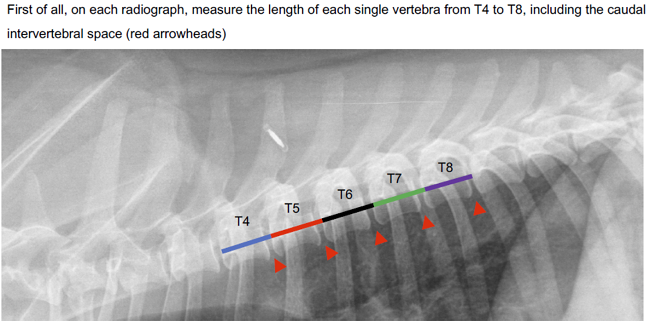
December 2022:
Australian geneticists locate the most significant
mutations of the nebulette (NEBL) gene affecting mitral valve disease in
cavaliers.
 In a
December 2022 article, Australian genetics researchers (Sophie
E. Mead, Niek J. Beijerink, Mitchell O'Brien, Claire M. Wade [right])
examined the genetic make up of 180 cavalier King Charles spaniels with
and without mitral valve disease (MVD) and in its various stages. They
focused on mutations of the nebulette gene located at NEBL1, NEBL2, and
NEBL3. Previous studies found that mutations in the nebulette gene
appear to be associated with heart enlargement, possibly due to a poorer
quality cytoskeletal framework of cardiomyocytes. These researchers
compared 6 cavaliers being heterozygous (having two different alleles of
the gene) for the protective/wild-type alleles of the NEBL gene, with
the other 172 CKCSs which were homozygous for the NEBL1-3 alleles. They
report finding that the 6 heterozygous dogs had smaller left atrium
(LA:Ao) and left ventricle (LVIDdN) values than did the homozygous dogs.
They concluded that:
In a
December 2022 article, Australian genetics researchers (Sophie
E. Mead, Niek J. Beijerink, Mitchell O'Brien, Claire M. Wade [right])
examined the genetic make up of 180 cavalier King Charles spaniels with
and without mitral valve disease (MVD) and in its various stages. They
focused on mutations of the nebulette gene located at NEBL1, NEBL2, and
NEBL3. Previous studies found that mutations in the nebulette gene
appear to be associated with heart enlargement, possibly due to a poorer
quality cytoskeletal framework of cardiomyocytes. These researchers
compared 6 cavaliers being heterozygous (having two different alleles of
the gene) for the protective/wild-type alleles of the NEBL gene, with
the other 172 CKCSs which were homozygous for the NEBL1-3 alleles. They
report finding that the 6 heterozygous dogs had smaller left atrium
(LA:Ao) and left ventricle (LVIDdN) values than did the homozygous dogs.
They concluded that:
"Since heterozygosity for the wild-type NEBL allele seems to reduce MMVD severity, CKCS breeders should plan to increase wild-type allele prevalence into the gene pool. There are two methods to accomplish this. The first is to apply genetic testing to identify registered CKCSs carrying the wild-type NEBL allele. Subsequently, breeders could be selecting for the wild-type allele, not against the derived allele, taking into consideration that selection for the wild-type allele should not reduce the gene pool too much. Second, breeders could introduce animals to the registry via an indexing scheme that enables the introduction of unregistered dogs (potentially of other breeds) carrying the wild-type NEBL allele into the registry system for this breed. While crossbreeding is a viable option for improving heart health in the CKCS, rules across many canine registries currently preclude this approach and such rules will likely take a long time to change. Selection for favourable dominant alleles present in the breed can be applied immediately. ... It is expected that the dogs heterozygous for wild-type alleles at these loci will experience reduced risk of mortality as a result of their lower LVIDdN and LA:Ao measurements."
Five of the 6 cavaliers with the wild-type NEBL1,2,3 normal variants had mitral valve disease, and 1 of those 5 had enlargement of its left atrium and ventricle (ACVIM Stage B2). See Table 5 from the December 2022 article, here:
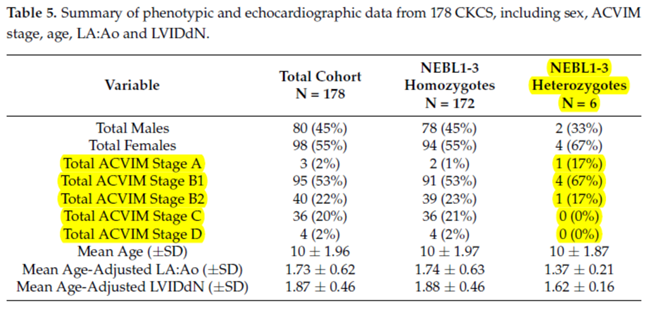
Dr. Wade stated in a video presentation about this study confessed that:
"The Australian population may not be the same as the population elsewhere in the world because we are an isolated continent and don't have to be imported. It is possible that things are not the same here as they are elsewhere."
 EDITOR'S NOTE: There are a few questionable or troubling issues
surrounding this study and the hype it is receiving in the CKCS breeding
community. Here is our list of issues:
EDITOR'S NOTE: There are a few questionable or troubling issues
surrounding this study and the hype it is receiving in the CKCS breeding
community. Here is our list of issues:
• In Dr. Wade's video presentation, she includes this statement: "Scientific evidence so far supports that dogs with the NEBL3 wild-type variant have later onset of MMVD." We cannot find any support for that statement in her December 2022 article, and she did not cite any other possible sources for it in her video presentation. To the contrary of that quotation, we find no evidence whatsoever to support the claim that dogs with the NEBL3 variant have later onset of MVD. No information has been provided about when any of those 6 dogs with that variant first were diagnosed with MVD. If you do not know when the dog developed a murmur, you necessarily do not know when the dog had the onset of MVD, since the murmur = onset.
• As we pointed out above, 5 of those 6 NEBL3 variant dogs already had been diagnosed with MVD before the start of the study, so no valid argument can be made that the NEBL3 variant prevents the onset of MVD.
• The researchers made a very false underlying assumption in their study -- that "Critical values are: LA:Ao <1.6 is healthy." (See the image at right.) When it comes to cavaliers, this assumption is totally bogus. For example, if a cavalier has an enlarged left atrium and an LA:Ao ratio of 1.41, necessarliy an LA:Ao ratio above 1.41 and below 1.6 is not healthy.
Despite the lack of validity of these claims, members of the commercial DNA testing community have been spreading the falsehoods as being the truth. GenSol and Laboklin, have introduced a genetic test for that gene in cavaliers, based upon blood or saliva samples submitted to them. Presumably the GenSol and Laboklin folks decided to take it upon themselves to follow up on this December 2022 study of the wild-type NEBL3 allele. But apparently neither of them has ever actually read that study.
Laboklin goes well beyond any published research by falsely claiming that "It is very unlikely that the dog will develop Myxomatous mitral valve disease (MMVD)." GenSol goes even further by claiming "These dogs have two copies of the normal gene and will neither develop Myxomatous Mitral Valve Disease nor pass this mutation to their offspring." There is nothing in the Australian study's article that supports that statement. In fact, the article flatly contradicts it. So, DNA testing buyer beware!
November 2022:
UK researchers find 100+ genetic mutations in cavaliers which
may be associated with mitral valve disease.
 In a
September 2022 abstract presented at the 32d European College of
Veterinary Internal Medicine - Companion Animals (ECVIM-CA) Congress, a
team of UK cardiology researchers (M. Hezzell [right], M. Wallace, J. Wilshaw,
A. Boswood, L. Davison) examined the blood samples of 121 cavalier King
Charles spaniels, along with numerous control dogs of other breeds, to
identify genetic mutations in cavaliers which may lead to the
application of "novel therapies" for treating mitral valve disease (MVD)
in the breed. They report having identified over 100 genetic variants of
potential importance in cavaliers diagnosed with MVD and associated
congestive heart failure (CHF). They found that many significant
variants were located in genes and biological pathways with potential
for therapeutic treatments, including transcriptional regulation,
calcium signaling, cell adhesion, inflammation, and wound healing. They
concluded that:
In a
September 2022 abstract presented at the 32d European College of
Veterinary Internal Medicine - Companion Animals (ECVIM-CA) Congress, a
team of UK cardiology researchers (M. Hezzell [right], M. Wallace, J. Wilshaw,
A. Boswood, L. Davison) examined the blood samples of 121 cavalier King
Charles spaniels, along with numerous control dogs of other breeds, to
identify genetic mutations in cavaliers which may lead to the
application of "novel therapies" for treating mitral valve disease (MVD)
in the breed. They report having identified over 100 genetic variants of
potential importance in cavaliers diagnosed with MVD and associated
congestive heart failure (CHF). They found that many significant
variants were located in genes and biological pathways with potential
for therapeutic treatments, including transcriptional regulation,
calcium signaling, cell adhesion, inflammation, and wound healing. They
concluded that:
"Evaluation of the impact on gene and cell function of the genetic variants associated with MMVD and CHF in MMVD is now required. These findings offer novel pathway targets for pharmacological intervention and future precision treatment of MMVD and CHF."
November 2022: UK veterinarians have been prescribing pimobendan to 62.7% of dogs without any diagnostic testing for heart enlargement, study shows. In a September 2022 abstract presented at the 32d European College of Veterinary Internal Medicine - Companion Animals (ECVIM-CA) Congress, a team of UK cardiology researchers (M. Silva, E. Bode, D. Singleton, M. Hezzell, H. Hodgkiss-Geere) examined the primary care veterinary records of 110 dogs (including 50 cavalier King Charles spaniels [45.5%]) which were prescribed pimobendan for mitral valve disease. They found that only 32.7% of the dogs were examined by echocardiography before being prescribed the pimobendan, and that 69 of the dogs (62.7%) were not tested for heart enlargement in any manner, neither echocardiography nor x-rays.
EDITOR'S NOTE: This study comes as no surprise. This proves that many primary care veterinarians know nothing about when to prescribe pimobendan (Vetmedin, Cardisure, Safeheart, Pimocard, Pimotab, Zelys) to dogs and seemingly do not care to find out. They are committing malpractice when they do so. Studies have established that administering pimobendan to dogs which do not have significantly enlarged hearts can do grave damage to those dogs' hearts.
See, as examples of the severe damage pimobendan can cause, this June 2016 article, this July 2007 article, this March 2005 article, this October 1989 article, and even the EPIC Study, in which 8.4% of the so-called Stage B2 dogs treated with pimobendan died suddenly of cardiac arrest.
November 2022:
Cavaliers with and
without mitral regurgitation have different shaped mital valves.
 In a
September 2022 abstract presented at the 32d European College of
Veterinary Internal Medicine - Companion Animals (ECVIM-CA) Congress, a
team of cardiologists at the Virginia-Maryland College of Veterinary
Medicine (G. Menciotti [right], M. Borgarelli, A. Franchini, S.M. Lahmers, H.W.
Jeong) used transthoracic three-dimensional echocardiography (3DTTE) to
examine the shapes of mitral valves in 80 cavalier King Charles
spaniels, 41 of which had no murmur, and the other 39 had grade 1 or
grade 2 murmurs. They found that the shapes of the mitral valves of the
MVD-affected cavaliers were "significantly different" from those with no
murmurs. The mitral valves of the MVD-affected CKCKs had wider
diameters, circumferences, and areas, and both of their mitral valve
leaflets had larger areas and lengths. Also, the angle between both
anterior and posterior leaflets and the annulus (ring around the valve)
was flatter in the MVD-affected dogs. They concluded:
In a
September 2022 abstract presented at the 32d European College of
Veterinary Internal Medicine - Companion Animals (ECVIM-CA) Congress, a
team of cardiologists at the Virginia-Maryland College of Veterinary
Medicine (G. Menciotti [right], M. Borgarelli, A. Franchini, S.M. Lahmers, H.W.
Jeong) used transthoracic three-dimensional echocardiography (3DTTE) to
examine the shapes of mitral valves in 80 cavalier King Charles
spaniels, 41 of which had no murmur, and the other 39 had grade 1 or
grade 2 murmurs. They found that the shapes of the mitral valves of the
MVD-affected cavaliers were "significantly different" from those with no
murmurs. The mitral valves of the MVD-affected CKCKs had wider
diameters, circumferences, and areas, and both of their mitral valve
leaflets had larger areas and lengths. Also, the angle between both
anterior and posterior leaflets and the annulus (ring around the valve)
was flatter in the MVD-affected dogs. They concluded:
"These findings indicate that CKCS with only mild MR [mitral regurgitation] have MV [mitral valve] morphological differences compared to CKCS without MR. This further supports previous research suggesting a role of MV morphology in the pathophysiology of MMVD, and further investigation of a causative link is warranted."
EDITOR'S NOTE: Our website, CavalierHealth.org, and its charitable trust, have been providing, and continue to provide, financial support to this on-going research.
September 2022:
Vertebral heart size (VHS) is the most accurate and reliable
x-ray method of measuring heart size, in a German study of 200 dogs.
 In
a
September 2022 article by German investigators Charanthorn Levicar
(right), Ingo Nolte, Jose Luis Granados-Soler, Fritjof Freise,
Jonathan Friedemann Raue, and Jan-Peter Bach, they report the results of
three veterinarians, with different levels of experience in examining
x-rays (radiographs), who reviewed 1,200 x-rays of 200 dogs (including 9
cavaliers) and measured the vertebral heart size (VHS), radiographic
left atrial dimension (RLAD), left atrial width (LAWidth), and the
vertebral left atrial size (VLAS) for each dog. The results were
compared to results from echocardiographic scans of each dog. They found
that the VHS, LAWidth, and VLAS were easier to define than the RLAD. The
interobserver agreement between the three examiners was almost perfect
for VHS (0.962) and good for the other radiographic measurements (RLAD:
0.778, LAWidth: 0.772, VLAS: 0.858). The VHS assigned the most dogs to
the correct stage. However, VHS, RLAD, LAWidth, and VLAS presented an
almost perfect intraobserver agreement. The dorsal left atrial margin of
the RLAD was the most difficult measurement point to identify. They
found that the VHS was the most reproducible radiographic method for
measuring the canine heart size and showed the highest agreement with
echocardiography. They concluded that VHS and VLAS were the obvious
choices for radiographic evaluation of the canine heart in the future.
In
a
September 2022 article by German investigators Charanthorn Levicar
(right), Ingo Nolte, Jose Luis Granados-Soler, Fritjof Freise,
Jonathan Friedemann Raue, and Jan-Peter Bach, they report the results of
three veterinarians, with different levels of experience in examining
x-rays (radiographs), who reviewed 1,200 x-rays of 200 dogs (including 9
cavaliers) and measured the vertebral heart size (VHS), radiographic
left atrial dimension (RLAD), left atrial width (LAWidth), and the
vertebral left atrial size (VLAS) for each dog. The results were
compared to results from echocardiographic scans of each dog. They found
that the VHS, LAWidth, and VLAS were easier to define than the RLAD. The
interobserver agreement between the three examiners was almost perfect
for VHS (0.962) and good for the other radiographic measurements (RLAD:
0.778, LAWidth: 0.772, VLAS: 0.858). The VHS assigned the most dogs to
the correct stage. However, VHS, RLAD, LAWidth, and VLAS presented an
almost perfect intraobserver agreement. The dorsal left atrial margin of
the RLAD was the most difficult measurement point to identify. They
found that the VHS was the most reproducible radiographic method for
measuring the canine heart size and showed the highest agreement with
echocardiography. They concluded that VHS and VLAS were the obvious
choices for radiographic evaluation of the canine heart in the future.
EDITOR'S NOTE: The most effective use of x-ray measurements of the hearts of MVD-affected dogs is to have periodic x-rays, taken first when the dog either has no MVD murmur or is first found to have a mild one, say grade 1 or 2, followed by another set of x-rays if and when the loudness of the murmur increases, say to grade 3 or 4. The initial set would be the baseline for measuring, at the very least, the VHS value, and then compare that first VHS value with later ones to determine if the heart has increased in size in the interim. So, the take away advice is that, as soon as the general practice veterinarian hears a mitral valve murmur the first time, the next step should be to get a set of high quality chest x-rays for that baseline measurement of VHS and whatever other measurements need to be taken (RLAD, LAWidth, VLAS).
September 2022:
Taurine levels in cavaliers do not differ significantly based
upon stages of mitral valve disease.
 In a
September 2022 article, Texas A&M veterinary school researchers
(Sonya Wesselowski [right], Amanda B. Blake, Sonya G. Gordon, Jan S.
Suchodolski, Joerg M. Steiner) examined the levels of taurine
concentration in the blood of 200 cavalier King Charles spaniels in
various stages of mitral valve disease (MVD). Twelve were in Stage A
(meaning no MVD murmur); 150 were in Stage B1 (murmur but no
enlargement); and 38 were in Stage B2 (murmur plus enlargement). None
were in Stages C or D (heart failure). They report finding that taurine
concentrations in both plasma and whole blood were "not significantly
different", regardless of the stage of MVD and also regardless of the
type of food being fed to the dogs. They devised reference intervals for
whole blood taurine (152 to 373 µM) and plasma taurine (51 to 217 µM)
concentrations in cavaliers. (See
this related May 2022 entry below.)
In a
September 2022 article, Texas A&M veterinary school researchers
(Sonya Wesselowski [right], Amanda B. Blake, Sonya G. Gordon, Jan S.
Suchodolski, Joerg M. Steiner) examined the levels of taurine
concentration in the blood of 200 cavalier King Charles spaniels in
various stages of mitral valve disease (MVD). Twelve were in Stage A
(meaning no MVD murmur); 150 were in Stage B1 (murmur but no
enlargement); and 38 were in Stage B2 (murmur plus enlargement). None
were in Stages C or D (heart failure). They report finding that taurine
concentrations in both plasma and whole blood were "not significantly
different", regardless of the stage of MVD and also regardless of the
type of food being fed to the dogs. They devised reference intervals for
whole blood taurine (152 to 373 µM) and plasma taurine (51 to 217 µM)
concentrations in cavaliers. (See
this related May 2022 entry below.)
EDITOR'S NOTE: This hopefully will bring an end to the nonsensical recent advice from several board certified veterinary cardiologists to the effect that their CKCS patients should avoid grain-free foods and be fed only certain dry foods which have grains as the main sources of protein. It is time these cardiologists stop pretending to act like they know what they are talking about in the field of canine nutrition.
September 2022:
Double doses of pimobendan did not improve kidney function in
MVD-affected dogs in Stage B2, in a U. of California-Davis study.
 In
a
September 2022 article, a team of University of California at Davis
veterinary researchers (Joanna L. Kaplan [right], Lance C.
Visser, Catherine T. Gunther-Harrington, Eric S. Ontiveros, Luke A.
Wittenburg, Carrie A. Palm, Joshua A. Stern) compared groups of dogs
diagnosed with mitral valve disease in Stage B2 (left chamber
enlargement), being administered standard doses of pimobendan (0.2 to
0.3 mg/kg q12) with double doses (0.5 to 0.6 mg/kg q12h), to determine
if the high doses would improve kidney function. They determined kidney
function by measuring the "glomerular filtration rate" (GFR) which is
the flow rate of filtered fluid through the kidneys. Thirty-one dogs
were in the study, but one had severe reactions to the high doses of
pimobendan and was withdrawn. Its owner reported behavior changes,
including aggression towards the owner and ataxia (loss of the ability
to coordinate muscular movement). The remaining 30 dogs were divided
into three groups -- 12 dogs in the standard dose of pimobendan group,
12 dogs (including 3 cavalier King Charles spaniels -- 25%) in the high
dose group, and 6 dogs (including one CKCS -- 17%) in the placebo group.
None of the remaining 24 dogs in the pimobendan groups had any reported
adverse reactions to the drug. The investigators reported that
pimobendan -- at either dosage level -- did not increase the GFR, and
that high doses did not have any advantages over low doses in their
effect upon the kidneys. However, the study found beneficial changes in
cardiac chamber size, systolic function and NT-proBNP in both pimobendan
groups.
In
a
September 2022 article, a team of University of California at Davis
veterinary researchers (Joanna L. Kaplan [right], Lance C.
Visser, Catherine T. Gunther-Harrington, Eric S. Ontiveros, Luke A.
Wittenburg, Carrie A. Palm, Joshua A. Stern) compared groups of dogs
diagnosed with mitral valve disease in Stage B2 (left chamber
enlargement), being administered standard doses of pimobendan (0.2 to
0.3 mg/kg q12) with double doses (0.5 to 0.6 mg/kg q12h), to determine
if the high doses would improve kidney function. They determined kidney
function by measuring the "glomerular filtration rate" (GFR) which is
the flow rate of filtered fluid through the kidneys. Thirty-one dogs
were in the study, but one had severe reactions to the high doses of
pimobendan and was withdrawn. Its owner reported behavior changes,
including aggression towards the owner and ataxia (loss of the ability
to coordinate muscular movement). The remaining 30 dogs were divided
into three groups -- 12 dogs in the standard dose of pimobendan group,
12 dogs (including 3 cavalier King Charles spaniels -- 25%) in the high
dose group, and 6 dogs (including one CKCS -- 17%) in the placebo group.
None of the remaining 24 dogs in the pimobendan groups had any reported
adverse reactions to the drug. The investigators reported that
pimobendan -- at either dosage level -- did not increase the GFR, and
that high doses did not have any advantages over low doses in their
effect upon the kidneys. However, the study found beneficial changes in
cardiac chamber size, systolic function and NT-proBNP in both pimobendan
groups.
September 2022:
Cavalier study shows that MicroRNA biomarker miR-30p-5p levels
may predict future severity of mitral valve disease.
 In a
September 2022 article, Italian veterinary researchers Sara
Ghilardi, Cristina Lecchi, Mara Bagardi [right], Giovanni
Romito, Fabio M. Colombo, Michele Polli, Celeste Franco, and Paola G.
Brambilla report comparing a microRNA biomarker with echocardiographic
measurements of cavalier King Charles spaniels diagnosed with various
degrees of mitral valve disease (MVD). MicroRNAs (miRNAs) are regulators
of gene expression in heart development and cardiac disorders. They are
detectable in blood plasma and serum. In this study, the investigators
focused on one of them, miR-30b-5p and compared its expression with
clinical and echocardiographic values of 35 CKCSs at different stages of
MVD. Their stated goal was to investigate reliable early miRNA
biomarkers of MVD, to see if they could offer additional advantages in
diagnosing the disease early in its progression and try to improve the
timing of treatment and life expectancy. They categorized the
MVD-affected cavaliers in Stages A, B1, B2, and C according to the 2019
ACVIM Consensus Statement definitions. They report finding that high
levels of plasma miR-30b-5p corresponded to lower LVIDdN (left ventricle
dimension value), ESVI (left ventricular end-systolic volume index),
EDVI (left ventricular end-diastolic volume index), and LA/Ao (left
atrial dimension value), all being echocardiographic values. They
concluded that their study allows the identification of a relationship
between high levels of miR-30b-5p and forms of MVD which appear
echocardiographically more stable over time in the CKCS.
In a
September 2022 article, Italian veterinary researchers Sara
Ghilardi, Cristina Lecchi, Mara Bagardi [right], Giovanni
Romito, Fabio M. Colombo, Michele Polli, Celeste Franco, and Paola G.
Brambilla report comparing a microRNA biomarker with echocardiographic
measurements of cavalier King Charles spaniels diagnosed with various
degrees of mitral valve disease (MVD). MicroRNAs (miRNAs) are regulators
of gene expression in heart development and cardiac disorders. They are
detectable in blood plasma and serum. In this study, the investigators
focused on one of them, miR-30b-5p and compared its expression with
clinical and echocardiographic values of 35 CKCSs at different stages of
MVD. Their stated goal was to investigate reliable early miRNA
biomarkers of MVD, to see if they could offer additional advantages in
diagnosing the disease early in its progression and try to improve the
timing of treatment and life expectancy. They categorized the
MVD-affected cavaliers in Stages A, B1, B2, and C according to the 2019
ACVIM Consensus Statement definitions. They report finding that high
levels of plasma miR-30b-5p corresponded to lower LVIDdN (left ventricle
dimension value), ESVI (left ventricular end-systolic volume index),
EDVI (left ventricular end-diastolic volume index), and LA/Ao (left
atrial dimension value), all being echocardiographic values. They
concluded that their study allows the identification of a relationship
between high levels of miR-30b-5p and forms of MVD which appear
echocardiographically more stable over time in the CKCS.
EDITOR'S NOTE: As noted above, these investigators categorized the MVD-affected cavaliers in Stages B1 and B2 according to the 2019 ACVIM Consensus Statement definitions. Those two definitions have been established by peer-reviewed, published research to be (a) totally bogus from a scientific standpoint, and (b) totally inaccurate when determining if CKCSs have or do not have enlargement of their left atria and/or left ventricles. Nevertheless, even with the inaccuaracies which necessarily result from applying those two ACVIM definitions (Stages B1 and B2), the classifications do, at least, grade the severity of MVD in the cavaliers in this study. And so, it may be, that despite the error in using the ACVIM definitions, the MVD-affected dogs in this study were correctly graded in terms of disease severity. Another incongruity in this study is that these investigators categorized 9 dogs at the start of the study (T0) as being in Stage B1 even though they had no heart murmur. The 2019 ACVIM Consensus Statement would classify those 9 cavaliers as being in Stage A. As of the second examination (T1), the number of Stage B1 dogs increased to 24, and 11 of those had no murmur.
September 2022:
Pug study disproves 2019 ACVIM Consensus Statement's
species-wide definition of LA:Ao > 1.6.
 In
a
September 2022 article by a team of German researchers (Pia Saskia
Wiegel, Rebekka Mach, Ingo Nolte [right], Fritjof Freise,
Charanthorn Levicar, Kristina Merhof, Jan-Peter Bach) of breed-specific
heart values of pug dogs, they selected 32 heart-healthy pugs to
calculate reference ranges of heart measurements, including the
vertebral heart score (VHS),
vertebral left atrial size (VLAS), and
radiographic left atrial dimension (RLAD). They also measured each dog's
left atrium size using the left atrium (LA) to aorta (Ao) ratio (LA:Ao)
value. They report that the mean LA:Ao of the 32 pugs was 1.32, with a
reference range from 0.97 to 1.62. This range high of 1.62 for
normal-sized left atria in heart-healthy pugs, therefore, is higher
than the
2019 ACVIM Consensus Statement's species-wide definition of an
enlarged LA in dogs diagnosed with mitral valve disease. This data shows
that the 2019 ACVIM Consensus Statement's LA:Ao definition of enlarged
LAs (> 1.60) is inaccurate when applied to pugs.
In
a
September 2022 article by a team of German researchers (Pia Saskia
Wiegel, Rebekka Mach, Ingo Nolte [right], Fritjof Freise,
Charanthorn Levicar, Kristina Merhof, Jan-Peter Bach) of breed-specific
heart values of pug dogs, they selected 32 heart-healthy pugs to
calculate reference ranges of heart measurements, including the
vertebral heart score (VHS),
vertebral left atrial size (VLAS), and
radiographic left atrial dimension (RLAD). They also measured each dog's
left atrium size using the left atrium (LA) to aorta (Ao) ratio (LA:Ao)
value. They report that the mean LA:Ao of the 32 pugs was 1.32, with a
reference range from 0.97 to 1.62. This range high of 1.62 for
normal-sized left atria in heart-healthy pugs, therefore, is higher
than the
2019 ACVIM Consensus Statement's species-wide definition of an
enlarged LA in dogs diagnosed with mitral valve disease. This data shows
that the 2019 ACVIM Consensus Statement's LA:Ao definition of enlarged
LAs (> 1.60) is inaccurate when applied to pugs.
August 2022:
Left atrium and ventricle measurements of 226 cavaliers proves
that the ACVIM's Stages B1 and B2 mitral valve definitions are
dangerously fallacious.
 In
a June 2022 session at the 2022 ACVIM Forum, cardiologists Sonya R.
Wesselowski and Sonya Gordon (right) presented "Prediction
of Stage B2 Mitral Valve Disease in Cavaliers with Longitudinal
Follow-Up", which was co-authored by Ryan Fries, Ashley Saunders,
K. Tess Sykes, Jordan Vitt, Bruno Boutet, Saki Kadotani, Jonathan Stack,
Brian Barnett, and Jens Haggstrom. They reported examining 226 cavalier
King Charles spaniels, which they classified as being in Stage A, Stage
B1, or Stage B2. They followed the
2019
ACVIM Consensus Statement definitions of Stages B1 and B2, which
means that if a dog has a mitral valve murmur and echo measurements of
LA:Ao >1.6 AND LVIDdN >1.7, then the dog is in Stage B2 and
entitled to being administered pimobendan, but if the dog does not have
at least BOTH of those minimum measurements, the dog is in
Stage B1 and denied pimobendan treatment.
In
a June 2022 session at the 2022 ACVIM Forum, cardiologists Sonya R.
Wesselowski and Sonya Gordon (right) presented "Prediction
of Stage B2 Mitral Valve Disease in Cavaliers with Longitudinal
Follow-Up", which was co-authored by Ryan Fries, Ashley Saunders,
K. Tess Sykes, Jordan Vitt, Bruno Boutet, Saki Kadotani, Jonathan Stack,
Brian Barnett, and Jens Haggstrom. They reported examining 226 cavalier
King Charles spaniels, which they classified as being in Stage A, Stage
B1, or Stage B2. They followed the
2019
ACVIM Consensus Statement definitions of Stages B1 and B2, which
means that if a dog has a mitral valve murmur and echo measurements of
LA:Ao >1.6 AND LVIDdN >1.7, then the dog is in Stage B2 and
entitled to being administered pimobendan, but if the dog does not have
at least BOTH of those minimum measurements, the dog is in
Stage B1 and denied pimobendan treatment.
While the ACVIM definition of Stage B1 requires that the dog have a murmur, these investigators classified in Stage B1 any dog which did not have a murmur but did have mitral regurgitation and echocardiographic evidence of deterioration of the mitral valve. They found that of the 226 dogs, 14 were in Stage A, 167 were in Stage B1, and 45 were in Stage B2.
Their measurements of the cavaliers' ranges of LA:Ao ratios and LVIDdN values showed why the 2019 ACVIM Consensus Statement's Stages B1 and B2 definitions are dangerously defective. For example, they found that a cavalier had a LA:Ao ratio as high as 1.97, but since that dog's LVIDdN value was below 1.7, the dog was in Stage B1, despite an extremely enlarged left atrium. Similarly, another cavalier had a LVIDdN value as high as 2.03, but since its LA:Ao was below 1.6, that dog was in Stage B1, despite an extremely enlarged left ventricle.
The overall range of LA:Ao ratios of the Stage B1 cavaliers was from 0.76 to 1.97, and the overall range of LVIDdN values of the Stage B1 cavaliers was from 1.15 to 2.03. As for the Stage A cavaliers, meaning heart-healthy dogs with no murmurs and no signs of mitral valve remodeling or regurgitation, the overall LA:Ao ratios were from 1.00 to 1.28, and the overall range of LVIDdN values were from 1.11 to 1.51. Previous published, peer-reviewed studies have established that the high point of the LA:Ao range for cavaliers with normal-sized hearts is way below 1.6. See this chart:
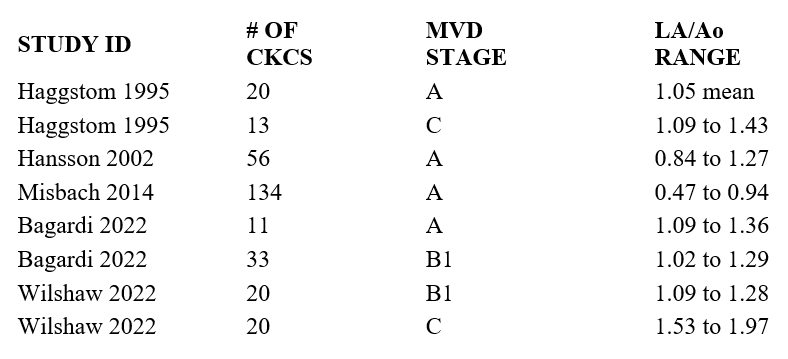
This data establishes the dangerous fallacy of the ACVIM's 2019 definitions of Stages B1 and B2, which put MVD-affected cavaliers at serious risk by denying those with obvious severe heart enlargement of treatment with the only drug found to delay the onset of heart failure.
August 2022:
Repeated echo measurements of leaflet-annulus index indicates
widening of mitral valve in MVD-affected dogs.
 In
an
August 2022 article, Japanese reseachers (Mitsuhiro Isaka
[right], Shinichi Hisada, Ryuji Araki, Hiroshi Ueno) used
echocardiography to measure the mitral valve leaflet-annulus index (LAI)
of 83 dogs, including 9 (10.8%) cavalier King Charles spaniels, all
diagnosed with mitral valve disease (MVD). The LAI is a complicated
calculation which involves taking various measurements of the mitral
valve leaflets. The LAI of each dog was compared to other echo
measurements, including the left ventricular end-diastolic internal
diameter normalized to body weight (LVIDDN), the left atrium to aorta
ratio (LA/Ao), and the grade of mitral regurgitation (MR). They report
finding that the LAI correlated significantly with both the LVIDDN and
LA/Ao. They also observed that the chronic volume overload from MR
caused the left ventricle to expand, which in turn caused the mitral
annulus to expand, resulting in increased mitral regurgitation.
In
an
August 2022 article, Japanese reseachers (Mitsuhiro Isaka
[right], Shinichi Hisada, Ryuji Araki, Hiroshi Ueno) used
echocardiography to measure the mitral valve leaflet-annulus index (LAI)
of 83 dogs, including 9 (10.8%) cavalier King Charles spaniels, all
diagnosed with mitral valve disease (MVD). The LAI is a complicated
calculation which involves taking various measurements of the mitral
valve leaflets. The LAI of each dog was compared to other echo
measurements, including the left ventricular end-diastolic internal
diameter normalized to body weight (LVIDDN), the left atrium to aorta
ratio (LA/Ao), and the grade of mitral regurgitation (MR). They report
finding that the LAI correlated significantly with both the LVIDDN and
LA/Ao. They also observed that the chronic volume overload from MR
caused the left ventricle to expand, which in turn caused the mitral
annulus to expand, resulting in increased mitral regurgitation.
August 2022:
Texas A&M study establishes preliminary mitral valve dimension
ranges for heart-healthy cavaliers.
 In an
August 2022 article, Texas A&M researchers (Sonya Wesselowski
[right], Ashley B. Saunders, Stephen Werre, Sonya G.Gordon) performed
echocardiographic examinations of 40 cavalier King Charles spaniels to
obtain measurements of their mitral valves to establish preliminary,
breed-specific reference intervals. They observed that:
In an
August 2022 article, Texas A&M researchers (Sonya Wesselowski
[right], Ashley B. Saunders, Stephen Werre, Sonya G.Gordon) performed
echocardiographic examinations of 40 cavalier King Charles spaniels to
obtain measurements of their mitral valves to establish preliminary,
breed-specific reference intervals. They observed that:
"Breed-specific reference intervals have proven valuable across a variety of different echocardiographic measurements in dogs but may be particularly important within the CKCS breed when it comes to the MV [mitral valve]."
They also were concerned about the effects of repeatability (by the same echo operator and others) and sedation would have on the measurements. The mitral valve changes shape and size during the heart cycle, so care must be taken to select the same frame during each examination, since one frame and the next can produce variation in leaflet appearance and measurement differences. They acknowledged that:
"While the utility of these measurements for breed-screening is likely low, research utility exists and has shown that 2-dimensional measurement of the CKCS MV annulus appears to vary from previously published normal values in a mixed population of dogs, with greater annular diameter at end-systole than at end-diastole in most of the present population of CKCS."
August 2022:
Slovenia researchers find in 3-month study that CoQ10
may decrease inflammation in Stage C MVD-affected dogs.
 In a
July 2022 article, a team of Slovenian researchers (Natalia
Druzhaeva, Alenka Nemec Svete, Gabrijela Tavcar-Kalcher, Janja Babic,
Alojz Ihan, Katka Pohar, Uros Krapez, Aleksandra Domanjko Petric
[right]) studied the effects of CoQ10 supplementation (100 mg of
ubiquinone twice daily) for three months on dogs diagnosed with either
Stage B2 mitral valve disease (MVD) (murmur plus enlargement) or Stage C
(congestive heart failure -- CHF), compared to placebo
groups of Stage B2 and Stage C dogs and a group of healthy control dogs.
This is the longest term study of CoQ10 in MVD-affected dogs, to date.
They report these findings:
In a
July 2022 article, a team of Slovenian researchers (Natalia
Druzhaeva, Alenka Nemec Svete, Gabrijela Tavcar-Kalcher, Janja Babic,
Alojz Ihan, Katka Pohar, Uros Krapez, Aleksandra Domanjko Petric
[right]) studied the effects of CoQ10 supplementation (100 mg of
ubiquinone twice daily) for three months on dogs diagnosed with either
Stage B2 mitral valve disease (MVD) (murmur plus enlargement) or Stage C
(congestive heart failure -- CHF), compared to placebo
groups of Stage B2 and Stage C dogs and a group of healthy control dogs.
This is the longest term study of CoQ10 in MVD-affected dogs, to date.
They report these findings:
• Plasma CoQ10 concentrations were significantly higher in the CoQ10 groups of Stages B2 and C dogs than in the placebo groups and healthy dogs.
• Doses of 100 mg twice per day significantly increased plasma CoQ10 concentration in both CoQ10 groups (Stage B2 and CHF) compared to the placebo groups.
• A significant increase in plasma CoQ10 concentration was observed in the CoQ10 groups compared to the placebo groups.
• No significant adverse effects were noticed during the study.
• No positive effects of CoQ10 on echocardiographic parameters were detected.
• Only neutrophil percentage and lymphocyte percentage and concentration in CHF dogs were positively affected by supplementation.
They concluded that the positive effect of CoQ10 supplementation -- decreasing the neutrophil percentage and increasing the lymphocyte percentages in CHF dogs -- may indicate the anti-inflammatory role of CoQ10 in systemic inflammation in dogs with CHF due to MVD.
August 2022:
Ohio State researchers find cardiac MRI did not detect
clinically relevant
fibrosis in MVD-affected cavaliers.
 In an
August 2022 article, Ohio State cardiology researchers (William
A. Clark, Randolph L. Winter [right], Turi K. Aarnes, Eric M. Green,
Katarzyna Mikrut, Patrick Ruz, Daniel Addison, Jaylyn D. Rhinehart,
Karsten E. Schober, Harry T. Friel) examined 4 cavalier King Charles
spaniels diagnosed with mitral valve disease and left chamber heart
enlargement, and 2 other MVD-affected dogs, along with 6 clear-heart
control dogs, to determine whether cardiac magnetic resonance imaging
(cMRI) could detect detect myocardial ischemia and fibrosis and also
whether circulating biomarker concentrations (cardiac troponin I
In an
August 2022 article, Ohio State cardiology researchers (William
A. Clark, Randolph L. Winter [right], Turi K. Aarnes, Eric M. Green,
Katarzyna Mikrut, Patrick Ruz, Daniel Addison, Jaylyn D. Rhinehart,
Karsten E. Schober, Harry T. Friel) examined 4 cavalier King Charles
spaniels diagnosed with mitral valve disease and left chamber heart
enlargement, and 2 other MVD-affected dogs, along with 6 clear-heart
control dogs, to determine whether cardiac magnetic resonance imaging
(cMRI) could detect detect myocardial ischemia and fibrosis and also
whether circulating biomarker concentrations (cardiac troponin I
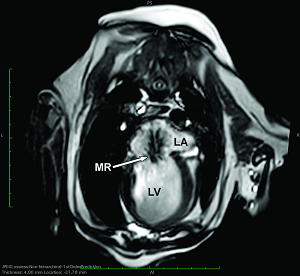 concentrations and galectin-3 concentrations) could be used as
predictors of myocardial changes identified on cMRI. They found some
results surprising: While MVD-affected dogs had significantly higher
cardiac troponin I concentrations than control dogs, the galectin-3
concentrations did not differ between groups. They also detected
myocardial fibrosis was detected in dogs in both groups, and found that
no dogs had obvious myocardial perfusion deficits. They attributed the
lack of significant differences in myocardial fibrosis between healthy
dogs and those with MVD as a possible explanation as to why no
veterinary clinical trial has thus far demonstrated a significant
survival benefit when dogs with preclinical MVD have been treated with
angiotensin-converting enzyme (ACE) inhibitors. They observed that:
concentrations and galectin-3 concentrations) could be used as
predictors of myocardial changes identified on cMRI. They found some
results surprising: While MVD-affected dogs had significantly higher
cardiac troponin I concentrations than control dogs, the galectin-3
concentrations did not differ between groups. They also detected
myocardial fibrosis was detected in dogs in both groups, and found that
no dogs had obvious myocardial perfusion deficits. They attributed the
lack of significant differences in myocardial fibrosis between healthy
dogs and those with MVD as a possible explanation as to why no
veterinary clinical trial has thus far demonstrated a significant
survival benefit when dogs with preclinical MVD have been treated with
angiotensin-converting enzyme (ACE) inhibitors. They observed that:
"[D]ogs with advanced MMVD may not develop focal areas of myocardial fibrosis significantly more often than what may occur during the normal aging process."
(Above, see cMRI image of the left-side chambers of a CKCS's heart, showing mitral regurgitation [MR] between the enlarged atrium [LA] and enlarged ventricle [LV].)
EDITOR'S NOTE: The Cavalier Health Fund, our charitable trust, partially funded this research at the Ohio State University's College of Veterinary Medicine.
July 2022:
Nine healthy dogs fed only Hill's Prescription Diet h/d dry food
developed steady activation of their renin-angiotensin-aldosterone
system (RAAS).
 In
a
July 2022 article, Iowa State Univ. researchers (Samantha Sotillo,
Jessica L. Ward [right], Emilie Guillot, Oliver Domenig,
Lingnan Yuan, Joseph S. Smith, Vojtech Gabriel, Chelsea A.
Iennarella-Servantez, Jonathan P. Mochel) fed nine healthy dogs a
low-sodium diet of Hill's Prescription Diet h/d dry food for five days.
Their levels of sodium reached such low levels that it resulted in steady activiation of the dogs'
renin-angiotensin-aldosterone system (RAAS). The researchers
intentionally wanted to activate the RAAS in order to conduct a study of
dosages of benazepril, an angiotensin converting enzyme inhibitor
(ACE-I).
In
a
July 2022 article, Iowa State Univ. researchers (Samantha Sotillo,
Jessica L. Ward [right], Emilie Guillot, Oliver Domenig,
Lingnan Yuan, Joseph S. Smith, Vojtech Gabriel, Chelsea A.
Iennarella-Servantez, Jonathan P. Mochel) fed nine healthy dogs a
low-sodium diet of Hill's Prescription Diet h/d dry food for five days.
Their levels of sodium reached such low levels that it resulted in steady activiation of the dogs'
renin-angiotensin-aldosterone system (RAAS). The researchers
intentionally wanted to activate the RAAS in order to conduct a study of
dosages of benazepril, an angiotensin converting enzyme inhibitor
(ACE-I).
EDITOR'S NOTE: Far too many veterinarians, including some board certified cardiologists, have been instructing owners of MVD-affected cavaliers to eliminate as much sodium in their dogs' daily meals as possible. What they seemingly do not know is that too little sodium will activate the dogs' kidneys' RAAS, which is one of the side effects of MVD which must be avoided. Indeed, the reason that ACE-inhibitors, such as benazepril and enalapril are prescribed to MV-affected dogs, is to prevent activation of the RAAS. Also, excessively low sodium levels is an electrolyte disorder called hyponatremia.
So, here we have a case in which the investigators wanted to activate the RAAS of healty dogs to study the effectiveness of benazepril. To do so, they intentionally fed these dogs with Hill's Prescription Diet h/d dry food. This food should not be fed to any dogs ever.
July 2022:
Japanese cardiologists find EPIC/ACVIM definition of enlarged
left ventricle may cause toy breeds with advanced MVD to remain
untreated.
 In
a
June 2022 article, a team of Japanese cardiologists (Noriko Isayama
[right], Yusuke Uchimura, Kenta Sasaki, Erika Maeda, Toshihisa
Takahashi, Megumi Watanabe) examined the echocardiograms (and other
heart-related physical conditions) of 86 toy breed dogs weighing less
than 5 kg. (11 lbs.), all with healthy hearts. The breeds included 40
toy poodles, 25 chihuahuas, 7 Yorkshire terriers, 4 papillons, and ten
dogs of other breeds. None were cavalier King Charles spaniels. Their
aim was to estimate the reference values definition used in the
EPIC
Study and the
2019 ACVIM Consensus Statement for normal-sized left
ventricles, the "left ventricular end-diastolic internal diameter
corrected for body weight (LVIDDN)", for small breed dogs weighing <5
kg. They noted that the EPIC Study's and the ACVIM Consensus Statement's
(EPIC/ACVIM) species-wide cut-off between a normal and enlarged LVIDDN
value is 1.7. They observed that the existing LVIDDN reference values do
not include toy breeds in the data, and that a wide range of weight of
dogs is included in calculating the current species-wide reference
values. They report finding that if the EPIC/ACVIM definition of an
enlarged left ventricle was used for these small breed dogs:
In
a
June 2022 article, a team of Japanese cardiologists (Noriko Isayama
[right], Yusuke Uchimura, Kenta Sasaki, Erika Maeda, Toshihisa
Takahashi, Megumi Watanabe) examined the echocardiograms (and other
heart-related physical conditions) of 86 toy breed dogs weighing less
than 5 kg. (11 lbs.), all with healthy hearts. The breeds included 40
toy poodles, 25 chihuahuas, 7 Yorkshire terriers, 4 papillons, and ten
dogs of other breeds. None were cavalier King Charles spaniels. Their
aim was to estimate the reference values definition used in the
EPIC
Study and the
2019 ACVIM Consensus Statement for normal-sized left
ventricles, the "left ventricular end-diastolic internal diameter
corrected for body weight (LVIDDN)", for small breed dogs weighing <5
kg. They noted that the EPIC Study's and the ACVIM Consensus Statement's
(EPIC/ACVIM) species-wide cut-off between a normal and enlarged LVIDDN
value is 1.7. They observed that the existing LVIDDN reference values do
not include toy breeds in the data, and that a wide range of weight of
dogs is included in calculating the current species-wide reference
values. They report finding that if the EPIC/ACVIM definition of an
enlarged left ventricle was used for these small breed dogs:
"... the possibility is high that by the time these toy breed dogs start receiving treatment, according to the current [EPIC/ACVIM] guidelines of diagnosis criteria of stage B2 of MMVD, they already reach a very advanced stage of the disease. Previous reports, including the EPIC study, focused mainly on dogs with BW [body weight] >4 kg, and the diagnostic criteria for toy breed dogs remain mostly unexplored. Therefore, along with diagnostic criteria, we should consider starting treatment as B2 for dogs weighing <5 kg with an LVIDDN of >1.6." (Emphasis added.)
They concluded that:
"Instead of the current [EPIC/ACVIM] threshold of LVIDDN >1.7, we propose a value of >1.6 to be included in the [Stage] B2 criterion of the ACVIM consensus statement and guide clinicians in deciding when to start treatment of mitral valve disease in small breed dogs for small breed dogs. ... The results of our study will guide clinicians in deciding when to start treatment for MMVD in small breed dogs."
 EDITOR'S
NOTE: Once again, the EPIC Study's species-wide definition
of heart enlargement has been proven to be totally bogus and
life-threateningly dangerous.
We've been warning about this fact since
the EPIC Study was published in 2016, and
we publicly warned the ACVIM
to not follow the EPIC Study's bogus definition in 2017, two years
before that august group of ten wizards blindly decided to follow EPIC
anyway. Here we find that for nearly all breeds of toy dogs -- those
weighing less than 11 lbs. -- they could have severely enlarged left
ventricles, but if the cardiologists followed the EPIC/ACVIM cut-off of
LVIDDN = 1.7, all of those dogs would be classified as having
normal-sized hearts in Stage B1, meaning not to be prescribed
pimobendan. As we've said all along, it is time -- actually long
past time -- that the EPIC Study and the 2019 ACVIM Consensus Statement
be retracted and re-written to conform to reality.
EDITOR'S
NOTE: Once again, the EPIC Study's species-wide definition
of heart enlargement has been proven to be totally bogus and
life-threateningly dangerous.
We've been warning about this fact since
the EPIC Study was published in 2016, and
we publicly warned the ACVIM
to not follow the EPIC Study's bogus definition in 2017, two years
before that august group of ten wizards blindly decided to follow EPIC
anyway. Here we find that for nearly all breeds of toy dogs -- those
weighing less than 11 lbs. -- they could have severely enlarged left
ventricles, but if the cardiologists followed the EPIC/ACVIM cut-off of
LVIDDN = 1.7, all of those dogs would be classified as having
normal-sized hearts in Stage B1, meaning not to be prescribed
pimobendan. As we've said all along, it is time -- actually long
past time -- that the EPIC Study and the 2019 ACVIM Consensus Statement
be retracted and re-written to conform to reality.
July 2022:
Texas A&M cardiologists
attempt to predict cavaliers in Stage B2 without echo scans, using
x-rays and blood tests.
 In a
June 2022 presentation at the 2022 ACVIM Forum, Texas A&M
cardiologists Sonya R. Wesselowski (right) and Sonya G. Gordon
examined the records of 226 cavalier King Charles spaniels diagnosed
with varying degrees of asymptomatic mitral valve disease (MVD or MMVD)
to predict which ones of them were in Stage B2 of MVD based on x-rays,
blood tests, and other diagnostic methods, assuming the unavailabiity of
echocardiographic scanning. They began by classifying each dog as Stage
A, B1, or B2 using echocardiography. The used the 2019 ACVIM Consensus
Statement's definition of enlarged hearts as the minimum cut-off for
Stage B2, which is "LA [left atrium] to aortic (Ao) ratio >1.6 and left
ventricular internal dimension in diastole normalized for body weight
(LVIDDN) >1.7." Cavaliers that failed to meet the minimum definition of
Stage B2 were defined as being in Stage B1. They then identified
cut-offs for non-echo measurements: (a) vertebral heart size (VHS); (b)
vertebral left atrial size (VLAS); (c) P+QRS duration
(electrocardiographic P wave + Q-wave, R-wave, and J-point of S-wave);
and (d) NTproBNP (natriuretic peptides test). The investigators found:
In a
June 2022 presentation at the 2022 ACVIM Forum, Texas A&M
cardiologists Sonya R. Wesselowski (right) and Sonya G. Gordon
examined the records of 226 cavalier King Charles spaniels diagnosed
with varying degrees of asymptomatic mitral valve disease (MVD or MMVD)
to predict which ones of them were in Stage B2 of MVD based on x-rays,
blood tests, and other diagnostic methods, assuming the unavailabiity of
echocardiographic scanning. They began by classifying each dog as Stage
A, B1, or B2 using echocardiography. The used the 2019 ACVIM Consensus
Statement's definition of enlarged hearts as the minimum cut-off for
Stage B2, which is "LA [left atrium] to aortic (Ao) ratio >1.6 and left
ventricular internal dimension in diastole normalized for body weight
(LVIDDN) >1.7." Cavaliers that failed to meet the minimum definition of
Stage B2 were defined as being in Stage B1. They then identified
cut-offs for non-echo measurements: (a) vertebral heart size (VHS); (b)
vertebral left atrial size (VLAS); (c) P+QRS duration
(electrocardiographic P wave + Q-wave, R-wave, and J-point of S-wave);
and (d) NTproBNP (natriuretic peptides test). The investigators found:
"In summary, both NT-proBNP and VHS have good utility for predicting stage B2 MMVD in CKCS as individual tests. Prediction models for stage B2 MMVD in CKCS incorporating variables from more than one testing modality have superior discriminatory ability. This highlights the value of a more comprehensive approach to staging, using a variety of combinations of readily available diagnostic tests to identify dogs that would most benefit from confirmatory echocardiography, or alternatively, to establish a diagnosis of stage B2 with acceptable clinical accuracy if echocardiography is not available. These data also emphasize positive impact of breed-specific approaches on overall accuracy."
 EDITOR'S NOTE:
This study proves that "Garbage In" equals "Garbage
Out". The only thing these investigators got right was their final
conclusion: "These data also emphasize positive impact of breed-specific
approaches on overall accuracy." Ironically, they start out by ignoring
that recommendation. Their first mistake was to assume that all 226
cavaliers in this study would have normal sized hearts as long as their
LA/Ao was under 1.6 and their LVIDDN was under 1.7. They chose to apply
a totally bogus, species-wide definition of an enlarged heart instead of
using a set of breed-specific cut-off measurements. The ACVIM's 2019
Consensus Statement's definition of Stage B2 is totally unscientific --
not based upon ANY evidence whatsoever. The three lead investigators of
the EPIC Study (of which Dr. Gordon was one) simply made up that
definition -- LA/Ao = 1.6 & LVIDDN = 1.7 -- from whole cloth.
EDITOR'S NOTE:
This study proves that "Garbage In" equals "Garbage
Out". The only thing these investigators got right was their final
conclusion: "These data also emphasize positive impact of breed-specific
approaches on overall accuracy." Ironically, they start out by ignoring
that recommendation. Their first mistake was to assume that all 226
cavaliers in this study would have normal sized hearts as long as their
LA/Ao was under 1.6 and their LVIDDN was under 1.7. They chose to apply
a totally bogus, species-wide definition of an enlarged heart instead of
using a set of breed-specific cut-off measurements. The ACVIM's 2019
Consensus Statement's definition of Stage B2 is totally unscientific --
not based upon ANY evidence whatsoever. The three lead investigators of
the EPIC Study (of which Dr. Gordon was one) simply made up that
definition -- LA/Ao = 1.6 & LVIDDN = 1.7 -- from whole cloth.
The fact is that there is an abundance of breed-specific data for the
cut-offs of the LA/Ao and LVIDDN for cavaliers in peer-reviewed
veterinary journal literature. A
2014 study of 134 cavaliers with
healthy hearts  showed a LA/Ao range from 0.47 to 0.94 (instead of up to
1.6). A 2002 study of 166 cavaliers found that the upper limit of a
normal-sized left atrium was 1.27 (instead of 1.6). A
1995 study of 79
cavaliers found that MVD-affected cavaliers with LA/Ao as low as 1.43
had both enlarged LAs and had clinical signs of heart failure. Other
studies have found similar discrepancies in the definition of LVIDDN for
cavaliers. These investigators ignored these facts and headed out on
their "Garbage In" adventure trip to Austin for the 2022 ACVIM Forum.
The end result is that none of their findings have any meaning because
they did not take this study seriously. What a waste! Especially for the
226 cavalier King Charles spaniels.
showed a LA/Ao range from 0.47 to 0.94 (instead of up to
1.6). A 2002 study of 166 cavaliers found that the upper limit of a
normal-sized left atrium was 1.27 (instead of 1.6). A
1995 study of 79
cavaliers found that MVD-affected cavaliers with LA/Ao as low as 1.43
had both enlarged LAs and had clinical signs of heart failure. Other
studies have found similar discrepancies in the definition of LVIDDN for
cavaliers. These investigators ignored these facts and headed out on
their "Garbage In" adventure trip to Austin for the 2022 ACVIM Forum.
The end result is that none of their findings have any meaning because
they did not take this study seriously. What a waste! Especially for the
226 cavalier King Charles spaniels.
July 2022:
German study of biomarkers in 64 MVD-affected dogs finds
natriuretic peptide NT-proBNP and cardiac troponin I have value in
diagnosing MVD stages.
 In
a
July 2022 study, a team of German researchers (Stephanie Klein, Ingo
Nolte [right], Jose Luis Granados-Soler, Philipp Lietz,
Maximiliane Sehn, Jonathan Friedemann Raue, Karl Rohn, Eva-Maria
Packeiser, Jan-Peter Bach) measured the effectiveness of four biomarkers
-- Galectin-3,
interleukin-1
receptor-like 1 protein (ST2), N-terminal-prohormone-B-type
natriuretic peptide (NT-proBNP),
and cardiac
troponin I (cTnI) -- to diagnosing the stage and progression of
mitral valve disease (MVD) in 64 dogs (including 4 cavalier King Charles
spaniels) diagnosed by echocardiogram to be in various stages of MVD.
They used the ACVIM's 2019 definitions of Stages B1 and B2 to group the
dogs by severity of MVD. They concluded that the biomarkers Galectin-3 and ST2 "indicate that
they are unsuitable for diagnosing and staging canine DMVD patients",
and that the diagnositic value of NT-proBNP and cTnI was confirmed.
In
a
July 2022 study, a team of German researchers (Stephanie Klein, Ingo
Nolte [right], Jose Luis Granados-Soler, Philipp Lietz,
Maximiliane Sehn, Jonathan Friedemann Raue, Karl Rohn, Eva-Maria
Packeiser, Jan-Peter Bach) measured the effectiveness of four biomarkers
-- Galectin-3,
interleukin-1
receptor-like 1 protein (ST2), N-terminal-prohormone-B-type
natriuretic peptide (NT-proBNP),
and cardiac
troponin I (cTnI) -- to diagnosing the stage and progression of
mitral valve disease (MVD) in 64 dogs (including 4 cavalier King Charles
spaniels) diagnosed by echocardiogram to be in various stages of MVD.
They used the ACVIM's 2019 definitions of Stages B1 and B2 to group the
dogs by severity of MVD. They concluded that the biomarkers Galectin-3 and ST2 "indicate that
they are unsuitable for diagnosing and staging canine DMVD patients",
and that the diagnositic value of NT-proBNP and cTnI was confirmed.
EDITOR'S NOTE: Of course, when these researchers chose to rely upon the ACVIM's 2019 bogus, species-wide definition of an enlarged heart (LA/Ao = 1.6 & LVIDDN = 1.7) as the control for segregating Stages B1 and B2 dogs, they started out with garbage-in, garbage-out data, thereby making their results unscientific and suspect. If you really want to distinguish between dogs with and without enlarged left atriums (LAs) and/or left ventricles (LVs), you need to do more than just measure the diameters of the chambers and assume that every heart-healthy dog of every breed has the same sized LA or LV. There is no scientific basis whatsoever for the 2019 ACVIM definitions of Stages B1 and B2, and yet they just keep using them. Much like the definition of insanity.
July 2022:
Italian study finds connection between inflammation and left
ventricle enlargement in MVD-affected cavaliers.
 In a
June 2022 article, Italian researchers (Diego Piantedosi
[right], Nadia
Musco, Anna Teresa Palatucci, Flavia Carriero, Valentina Rubino,
Francesco Pizzo, Saad Nasir, Giuseppe Molinaro, Giuseppina Ruggiero,
Giuseppe Terrazzano, Pietro Lombardi, Laura Cortese) investigated
changes in blood pro-inflammatory cytokines and immunophenotypes in 36
dogs affected by mitral valve disease at different stages (Stages B1,
B2, C, D). Seven of the MVD-affected dogs were cavalier King Charles
spaniels (19.5%), the most of all purebreds in the study. Their aim was
to verify the existence of a pro-inflammatory condition and a
dysfunction of the immune system in MVD-affected dogs in different
stages of severity through the blood assessment of CD4+FoxP3+ regulatory
T-cells (Treg) cells, leptin, and three pro-inflammatory cytokines
(tumor necrosis factor [TNF]-α, interleukin (IL)-1β, and IL-6
pro-inflammatory cytokines). They claim this to be the first study to
investigate changes in blood pro-inflammatory cytokines and
immunophenotypes in dogs based upon their stages of MVD. They concluded:
In a
June 2022 article, Italian researchers (Diego Piantedosi
[right], Nadia
Musco, Anna Teresa Palatucci, Flavia Carriero, Valentina Rubino,
Francesco Pizzo, Saad Nasir, Giuseppe Molinaro, Giuseppina Ruggiero,
Giuseppe Terrazzano, Pietro Lombardi, Laura Cortese) investigated
changes in blood pro-inflammatory cytokines and immunophenotypes in 36
dogs affected by mitral valve disease at different stages (Stages B1,
B2, C, D). Seven of the MVD-affected dogs were cavalier King Charles
spaniels (19.5%), the most of all purebreds in the study. Their aim was
to verify the existence of a pro-inflammatory condition and a
dysfunction of the immune system in MVD-affected dogs in different
stages of severity through the blood assessment of CD4+FoxP3+ regulatory
T-cells (Treg) cells, leptin, and three pro-inflammatory cytokines
(tumor necrosis factor [TNF]-α, interleukin (IL)-1β, and IL-6
pro-inflammatory cytokines). They claim this to be the first study to
investigate changes in blood pro-inflammatory cytokines and
immunophenotypes in dogs based upon their stages of MVD. They concluded:
"Overall, our results show a significant increase in cytokine levels in dogs with more advanced MMVD and therefore with greater hemodynamic impairment, and the relative increase in Treg cells could represent a regulatory mechanism that limits the inflammatory immune response. Furthermore, the positive correlation between IL-6 and the LV diastolic volume suggests that inflammatory activation may play a role in the ventricular remodeling associated with the progressive volumetric overload in MMVD."
July 2022:
Japanese surgeons successfully repair the mitral valves of a
cavalier and five other MVD-affected dogs, using a new suture technique.
 In
a
June 2022 article, Japanese veterinary cardiac surgeons (Takuma Aoki
[right], Takashi Miyamoto, Naoyuki Fukamachi, Seiya Niimi, Yao
Jingya, Yoshito Wakao) report the successful mitral valve repair
surgeries on six small dogs diagnosed with mitral valve disease (MVD) of
various stages. The cavalier was a 7 year old male in Stage C
(congestive heart failure). The surgical technique they used is called a
combination of the "Modified Loop Technique" and "De Vega Annuloplasty"
(MODEL). The modified loop technique consists of several pre-tied loops
of expanded polytetrafluoroethylene (ePTFE) threads, of various sizes to
match 80% of the sizes of the
In
a
June 2022 article, Japanese veterinary cardiac surgeons (Takuma Aoki
[right], Takashi Miyamoto, Naoyuki Fukamachi, Seiya Niimi, Yao
Jingya, Yoshito Wakao) report the successful mitral valve repair
surgeries on six small dogs diagnosed with mitral valve disease (MVD) of
various stages. The cavalier was a 7 year old male in Stage C
(congestive heart failure). The surgical technique they used is called a
combination of the "Modified Loop Technique" and "De Vega Annuloplasty"
(MODEL). The modified loop technique consists of several pre-tied loops
of expanded polytetrafluoroethylene (ePTFE) threads, of various sizes to
match 80% of the sizes of the
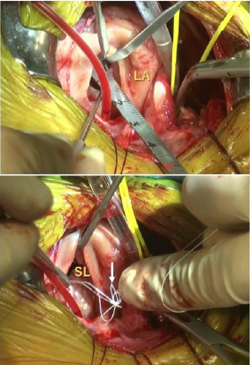 chordae
tendineae that would be encountered during the surgery. Three loops
serve as the replacement for each of the defective chords. (In the
photos at left, a ruler measures the length of the strut chordae. Then,
three loops [white arrow], each 80% of the length of the strut chordae,
were fixed to the papillary muscles and two of them are fixed to the
septal [front mitral] leaflet and one to the mural [rear mitral]
leaflet. Ao: Aorta; SL: Septal leaflet; ML: mural leaflet; LA: left
atrium.)
chordae
tendineae that would be encountered during the surgery. Three loops
serve as the replacement for each of the defective chords. (In the
photos at left, a ruler measures the length of the strut chordae. Then,
three loops [white arrow], each 80% of the length of the strut chordae,
were fixed to the papillary muscles and two of them are fixed to the
septal [front mitral] leaflet and one to the mural [rear mitral]
leaflet. Ao: Aorta; SL: Septal leaflet; ML: mural leaflet; LA: left
atrium.)
The De Vega annuloplasty technique involves sewing a continuous stitch of a single polypropylene thread suture in a purse-string fashion around half of the mitral valve so that when the thread is pulled at each end, the valve annulus can be tightened and reduced in size.The clinicians report that, after MODEL surgery, left atrial-to-aortic ratios (LA/Ao) significantly decreased from 2.20 ± 0.18 to 1.26 ± 0.22, and left ventricular end-diastolic internal diameter normalized to body weight (LVIDDN) significantly decreased from 2.03 ± 0.26 to 1.48 ± 0.20. In all cases, the clinical signs disappeared or improved significantly.
June 2022:
U.S. Food and Drug Administration conditionally approves
Vetmedin for MVD-affected dogs in Stage B2.
 The
U.S. Food and Drug Administration (FDA)
announced on June 16, 2022 that it has conditionally approved
Vetmedin (pimobendan) as treatment of dogs diagnosed with mitral valve
disease (MVD) and in Stage B2 ("moderate or loud mitral murmur due to a
leaking mitral heart valve and have an enlarged heart") prior to the
onset of heart failure (Stage C). This conditional approval is valid for
one year with the possibility of up to four annual renewals. During that
time, the drug's sponsor, Boehringer Ingelheim Animal Health USA, must
demonstrate active progress toward proving the effectiveness of the
drug, for full approval.
In 2007, the FDA granted full approval of
Vetmedin for dogs already in heart failure. Notwithstanding the lack of
even conditional approval by the FDA, veterinarians have been
prescribing pimobendan to MVD-affected dogs prior to heart failure since
2016.
The
U.S. Food and Drug Administration (FDA)
announced on June 16, 2022 that it has conditionally approved
Vetmedin (pimobendan) as treatment of dogs diagnosed with mitral valve
disease (MVD) and in Stage B2 ("moderate or loud mitral murmur due to a
leaking mitral heart valve and have an enlarged heart") prior to the
onset of heart failure (Stage C). This conditional approval is valid for
one year with the possibility of up to four annual renewals. During that
time, the drug's sponsor, Boehringer Ingelheim Animal Health USA, must
demonstrate active progress toward proving the effectiveness of the
drug, for full approval.
In 2007, the FDA granted full approval of
Vetmedin for dogs already in heart failure. Notwithstanding the lack of
even conditional approval by the FDA, veterinarians have been
prescribing pimobendan to MVD-affected dogs prior to heart failure since
2016.
EDITOR'S NOTE: Ironically, the FDA has based its "conditional approval" upon the bogus definition of heart enlargement in the EPIC Study and the 2019 ACVIM Consensus Statement, which has been royally panned as being "arbitrarily chosen", in a well-reasoned commentary by Dr. Mark Rishniw, published this month. See the article below this one. So, in essence, there exists no science to support the FDA's decision. It is as bogus as the species-wide definition of heart enlargement in the two articles.
June 2022: Japanese
surgeons use loop-to-loop sutures in successful mitral valve surgeries
of 50 MVD-affected dogs.
 In
a
June 2022 article, Dr. Katsuhiro Matsuura (right) and
others (T. Yoshida, S. Yamada, Yuki Aboshi, H. Yotsuida, Y. Yaginuma, M.
Hasegawa) reported on the results of open-heart mitral valve plasty
surgeries on 55 MVD-affected dogs, including 2 cavaliers, between July
2019 and November 2021. They describe their "loop-in-loop" technique to
adjust the height of each mitral leaflet. The procedure involves looping
sutures through anchors attached to the valve's papillary muscles, and
passing additional sutures through those loops, all at appropriate
lengths for the valve's leaflets. Fifty patients (90%) survived to
discharge following surgery, with survival significantly decreased in
Stage D dogs. Specifically:
In
a
June 2022 article, Dr. Katsuhiro Matsuura (right) and
others (T. Yoshida, S. Yamada, Yuki Aboshi, H. Yotsuida, Y. Yaginuma, M.
Hasegawa) reported on the results of open-heart mitral valve plasty
surgeries on 55 MVD-affected dogs, including 2 cavaliers, between July
2019 and November 2021. They describe their "loop-in-loop" technique to
adjust the height of each mitral leaflet. The procedure involves looping
sutures through anchors attached to the valve's papillary muscles, and
passing additional sutures through those loops, all at appropriate
lengths for the valve's leaflets. Fifty patients (90%) survived to
discharge following surgery, with survival significantly decreased in
Stage D dogs. Specifically:
• 14 of 14 of Stage B2 dogs (100%)
• 26 of 27 of Stage C dogs (96.2%)
• 10 of 14 of Stage D dogs (71.4%)
A month following surgeries, there were significant reductions of overall heart size (vertebral heart score: preoperative 11.4 vs. post 1 month 10.2), left atrium (left atrium to aortic root ratio: preoperative 2.3 vs. post 1 month 1.5) and left ventricle (left ventricular end-diastolic diameter [normalized for bodyweight]: preoperative 2.2 vs. post 1 month 1.5), showing successful management of mitral regurgitation. All medications for mitral valve disease were discontinued 3 months after surgery. Recurrence of mitral regurgitation was not evident during the two-year follow-up period. They concluded that: "Surgical mitral valve repair with the loop-in-loop technique is associated with significant decreases in indices of cardiac size at 1-month post-repair. Disease stage influences operative survival after surgical mitral valve repair. ... The present study described stage-specific success rates of mitral valve repair, which was 100% in Stage B2, 96.2% in Stage C, and 71.4 % in Stage D MMVD dogs. Surgical mortality was observed in no dogs with Stage B2 and only one dog with Stage C."
June 2022:
Dr. Rishniw rips to shreds the EPIC Study's and 2019 ACVIM Consensus
Statement's "arbitrary" enlarged left ventricle cut-off (LVIDdN = 1.7).
 In a
June 2022 article, Dr. Mark Rishniw
(right) and Dr. Donald J. Brown
studied the echocardiograms of 1,124 dogs with healthy, normal-sized
hearts, including 59 cavalier King Charles spaniels. Their goal was to
determine if the EPIC Study's and 2019 ACVIM Consensus Statement's
species-wide definition of enlarged left ventricles was accurate, and if
not, what other criteria should be applied. They concluded that the EPIC
and ACVIM definition (LVIDDN > 1.7) was "arbitrarily chosen" and that
over 10% of healthy dogs in the study, including the cavaliers, would be
mis-classified as having enlarged left ventricles (LV) when in fact they
had normal-sized LVs. They single out five specific breeds, including
the CKCS, as having larger LVs than average dogs of similar size. They
state:
In a
June 2022 article, Dr. Mark Rishniw
(right) and Dr. Donald J. Brown
studied the echocardiograms of 1,124 dogs with healthy, normal-sized
hearts, including 59 cavalier King Charles spaniels. Their goal was to
determine if the EPIC Study's and 2019 ACVIM Consensus Statement's
species-wide definition of enlarged left ventricles was accurate, and if
not, what other criteria should be applied. They concluded that the EPIC
and ACVIM definition (LVIDDN > 1.7) was "arbitrarily chosen" and that
over 10% of healthy dogs in the study, including the cavaliers, would be
mis-classified as having enlarged left ventricles (LV) when in fact they
had normal-sized LVs. They single out five specific breeds, including
the CKCS, as having larger LVs than average dogs of similar size. They
state:
"The EPIC study employed an essentially arbitrary value of LVIDDN to dogs subsequently randomized to treatment with pimobendan or placebo and showed that dogs with LVIDDN>1.7 (and LA:Ao>1.6 and a VHS>10.5V) generally do better with the drug than without. ... The criterion for left ventricular enlargement used by the EPIC investigators for study inclusion has never been critically evaluated as indicative of left ventricular enlargement. ...
"We should note, however, that the definition of LV enlargement proposed by both the EPIC trial and, subsequently, by the ACVIM Consensus panel, is not a reference value, but a somewhat arbitrarily chosen threshold for inclusion in the EPIC trial. Therefore, clinicians adhering to these guidelines should be cautious in ascribing LVIDDN that exceed the threshold value of 1.7 as being indicative of LV enlargement. Furthermore, clinicians should note that the ACVIM Stage B2 classification requires enlargement of both the left atrium (to a LA:Ao>1.6) and enlargement of the left ventricle. How many dogs with mild left atrial enlargement, but without LV enlargement, might consequently be misclassified as having cardiomegaly remains unknown."
Drs. Rishniw and Brown warn that such breeds as the CKCS "likely require breed-specific reference intervals for LVIDDN to correctly identify left ventricular enlargement." Specifically for the 59 cavaliers in the study, they determined that the upper limits for normal-sized LVs should have a scaling exponent of 0.33 (compared to the species-wide exponent of 0.294 in the EPIC Study and 2019 ACVIM Consensus Statement), and that the range of LVIDDNs derived using 0.33 would be from 1.62 to 1.71 with a mean of 1.69.
EDITOR'S NOTE: We've been warning about the total arbitrariness of the Stage B2 definition in the EPIC Study and its tag-along buddy, the 2019 ACVIM Consensus Statement, since their publication. Scroll through previous Editor's Notes on this page and our Blog webpage for our numerous warnings. Finally, two top-notch veterinary cardiologists have opened eyes to the obvious dangers being caused by the EPIC Study and the ACVIM. Drs. Rishniw and Brown warn that cavaliers are being placed at risk by cardiologists and other veterinarians who blindly adhere to the EPIC Study's nonsensical species-wide definition, and that, instead, cavaliers need, at the very least, "breed-specific reference intervals for LVIDDN to correctly identify left ventricular enlargement."
Even breed-specific "reference intervals" are no where near as accurate as would be comparing each dog's baseline measurement of the normal-sized LV with a later one when enlargement is suspected. This quote from the current study underscores the obvious value of comparing baseline and subsequent echo scans:
"For example, if a dog has a LVIDDN that consistently oscillates around 1.3 (within 0.1 units), an increase to 1.6 could indicate left ventricular enlargement for that dog, despite being within the population-based reference interval."But since few cavaliers undergo echo scans when a mitral valve murmur first is detected, this range of normal-sized LVs for 59 heart-healthy CKCSs is much more realistic than the bogus EPIC Study definition. It should not have taken nearly 6 years for this scientific evidence to be published. As we've urged for years, the EPIC Study and the 2019 ACVIM Consensus Statement should be retracted and certainly ignored.
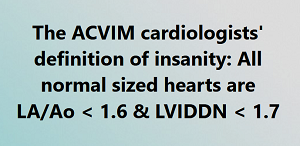
June 2022:
Author of the Mitral
Regurgitation Severity Index asks if it works.
 The "Mitral Regurgitation Severity Index" (MRSI) is a somewhat
complex index of data obtained from the MVD-affected dog, which includes
the dog's heart rate, its echocardiographic left atrium-to-aorta ratio
(LA/Ao), and its age. It has been devised by Dr. Claude E. Atkins, board
certified veterinary cardiologist at North Carolina State University
(right).
The announced purpose of the MRSI is to index the likelihood of
MVD-affected dogs in Stage B2 reaching heart failure. Its formula
includes three variables -- age, heart rate, and echocardiographic left
atrium-to-aorta ratio (LA/Ao) -- normalized based upon average values
derived from the VETPROOF* study dataset, to arrive at a specific
three-digit number within a range from less than 150 to above 249.
Specifically, the equation is:
The "Mitral Regurgitation Severity Index" (MRSI) is a somewhat
complex index of data obtained from the MVD-affected dog, which includes
the dog's heart rate, its echocardiographic left atrium-to-aorta ratio
(LA/Ao), and its age. It has been devised by Dr. Claude E. Atkins, board
certified veterinary cardiologist at North Carolina State University
(right).
The announced purpose of the MRSI is to index the likelihood of
MVD-affected dogs in Stage B2 reaching heart failure. Its formula
includes three variables -- age, heart rate, and echocardiographic left
atrium-to-aorta ratio (LA/Ao) -- normalized based upon average values
derived from the VETPROOF* study dataset, to arrive at a specific
three-digit number within a range from less than 150 to above 249.
Specifically, the equation is:
MRSI = (heart rate/120) x LA/Ao x (dog's age/10) x 100
Theoretically, the lower the MRSI for MVD-affected dogs in Stage B2, the less severe the MVD and the longer the number of days before the dog reaches Stage C, heart failure, if at all. In a June 2022 abstract, Dr. Atkins and others (Darcy Adin, Thomas Blondell, Emilie Guillot, Michelle Vereb, and Jessica Ward) reported on the application of the MRSI to 133 dogs diagnosed with Stage B2 of MVDThey form the title of their report as a question: "Mitral Regurgitation Severity Index: A Simple Calculation for Classification and Prognostication?". (Does this mean he is not sure?) The authors arrived at three "severity indices" of the MRSI, as follows:
• MRSI below 150: 981 median days to CHF (range: 444 days to NA)
• MRSI between 150 and 249: 587 median days to CHF (range: 369 to 907 days)
• MRSI above 249: 307 median days to CHF (range: 99 to 734 days).
* VETPROOF (Veterinary Enalapril Trial to Prove Reduction in Onset Of heart Failure) was a 139 MVD-affected dog study reported in 2002, which followed the dogs from the time in which they were diagnosed with severe MVD but without heart failure until the onset of heart failure. From these data, prognostic factors (historical, physical, radiographic, and echocardiographic variables) were determined.
EDITOR'S NOTE: The name of this index, "Mitral Regurgitation Severity Index" initially got our attention because we assumed (wrongly, but certainly logically) that it might have something to do with measuring and indexing mitral regurgitation (MR). MR is viewable on echocardiograph scans, and is measureable as a percentage, and indeed it occasionally is included in echo reports. MR probably is the most useful factor in measuring the severity of MVD, but it rarely is used. Unfortunately, Dr. Atkins' MRSI has nothing at all to do with mitral regurgitation. Keep in mind that the data being included in this complex equation are the dog's: (a) heart rate, (b) left atrium size, and (c) age. None of these come close to the severity of the mitral regurgitation.
A major problem we see with the MRSI is that it is not breed-specific. When it comes to MVD, cavaliers are unique, but the MRSI does not recognize that obvious fact. Why is the age of the dog more important than its breed?
Also, the "normalization" factors in the MRSI equation are based upon only 139 dogs, as near as we can determine, since only 139 dogs were included in the VETPROOF Study. Also, VETPROOF preceded the 2009 ACVIM Consensus Statement's categorization of stages of MVD (B1, B2, C, and D), and so all 139 VETPROOF dogs were lumped into the category of "severe MVD but without heart failure".
Furthermore, the three ranges for the MRSI (below 150, between 150 and 249, and above 249), overlap so much that there seems to be little value in the whole concept. For example, a dog with a MRSI above 249 could remain in Stage B2 for 734 days while a dog with a MRSI of below 150 could reach Stage C in only 444 days. It seems that the average number of days to reach heart failure (the mean value) would be a lot more useful than the median value.
And, finally, not only does this abstract mis-use the term, "Mitral Regurgitation Severity Index", but it essentially plagarizes that term since, in 2012, Dr. Luis Afonso and eight other American medical doctors originated the term "Mitral Regurgitation Severity Index", which they defined as a means of accurately differentiating severe MR from non-severe MR in humans. See, for example, their July 2017 article here.
So, to answer Dr. Atkins' question: "Does the MRSI work?" We don't think so, at least not yours.
May 2022:
Study of 25 cavaliers shows β-oxidation declines as mitral valve
disease progresses.
 In this
May 2022 report, the investigators (Jenny Wilshaw [right], A.
Boswood, Y. M. Chang, C. J. Sands, S. Camuzeaux, M. R. Lewis, D. Xia,
and D. J. Connolly) sought to determine, in dogs diagnosed with
mitral valve disease (MVD), whether beta oxidation (β-oxidation) is
reduced as the disease progresses. β-oxidation is a metabolic process by
which fatty acid molecules are broken down into adenosine triphosphate
(ATP) to produce energy. They studied blood serum samples of 30 dogs
diagnosed with mitral valve disease (MVD) and ten healthy control dogs.
Twenty (67%) of the MVD-affected dogs were cavalier King Charles
spaniels, and five (50%) of the control dogs were CKCSs. At the outset
of the study, all of the MVD-affected dogs were classified as in Stage
B1, which the investigators defined as "asymptomatic disease without
cardiomegaly", meaning having a MVD murmur but no enlargement of the
heart. A blood serum sample was taken from each dog at the outset of the
study, and then a second sample was taken once the dog was diagnosed as
being in heart failure (Stage C). Among the control group dogs, their
second serum sample was obtained at a comparable time period as in the
affected group.
In this
May 2022 report, the investigators (Jenny Wilshaw [right], A.
Boswood, Y. M. Chang, C. J. Sands, S. Camuzeaux, M. R. Lewis, D. Xia,
and D. J. Connolly) sought to determine, in dogs diagnosed with
mitral valve disease (MVD), whether beta oxidation (β-oxidation) is
reduced as the disease progresses. β-oxidation is a metabolic process by
which fatty acid molecules are broken down into adenosine triphosphate
(ATP) to produce energy. They studied blood serum samples of 30 dogs
diagnosed with mitral valve disease (MVD) and ten healthy control dogs.
Twenty (67%) of the MVD-affected dogs were cavalier King Charles
spaniels, and five (50%) of the control dogs were CKCSs. At the outset
of the study, all of the MVD-affected dogs were classified as in Stage
B1, which the investigators defined as "asymptomatic disease without
cardiomegaly", meaning having a MVD murmur but no enlargement of the
heart. A blood serum sample was taken from each dog at the outset of the
study, and then a second sample was taken once the dog was diagnosed as
being in heart failure (Stage C). Among the control group dogs, their
second serum sample was obtained at a comparable time period as in the
affected group.
Various lipids* from the blood serum samples were analyzed to determine their relevance to cardiac disease and due to changes in their concentrations in each serum sample. In the MVD group, they found 169 features in the lipids which changed significantly as the MVD progressed from Stage B1 to Stage C. Of those features, 10 differed between cavaliers and the ten dogs of the other affected breeds, indicating that among those features, the relationship differed between CKCSs and non-CKCSs. In the control group, they found no significant differences in the concentrations of lipids during the study period. Twelve of these changed lipid species were identified with specificity. Concentrations of certain acylcarnitines, phospholipids, and sphingomyelins increased after the dogs had developed heart failure, and some ceramides and lysophosphatidylcholines decreased. They concluded that "the canine metabolome appears to change as MMVD progresses. Findings from this study suggest that in HF myocardial metabolism may be characterised by reduced β-oxidation."
* Lipids are organic compounds in each cell of the body, composed of fats and oils, which provide high levels of energy are provide various functions. Lipids in blood serum include triglyceride, cholesterol, high-density lipoproteins (HDLs), and low-density lipoproteins (LDLs). Lipidomics is the study of the entire spectrum of lipids and their cellular physiology and pathology. Regulation of lipid metabolism has been found to be essential for maintenance of health, and dysregulation of this system is believed to play an important role in many diseases, including cardiovascular diseases. To study the lipids, their extracts are separated by liquid or gas chromatography and then delivered to mass spectrometer, ionized, vaporized and the resulting ions are sorted according to their mass to charge ratio in the mass analyzer.
EDITOR'S NOTE: Apart from the primary purpose of this study -- determining whether a reduction in β-oxidation of fatty acids occurs in MVD-affected dogs as the disease progresses -- there is some very significant data, particularly about cavaliers, which should be highlighted. This data pretty much confirms that the 2016 EPIC Study's definition of enlarged hearts is totally bogus, at least when applied to CKCSs.
In the EPIC Study (and, more importantly, in the 2019 ACVIM Consensus Statement on MVD), the left atrium (LA) of any heart of any MVD-affected dog is considered to be normal-sized if the echo measurement of the ratio of the LA to aorta (Ao) (LA:Ao) is less than 1.6 and is considered to be enlarged if the LA:Ao is 1.6 or higher. Similarly, in those studies, the left ventricle (LV) is defined as normal-sized if the left ventricular internal diameter in diastole normalised to bodyweight (LVIDDN) is less than 1.7 and enlarged if the LVIDDN is 1.7 or higher. The authors of the EPIC Study simply made up that species-wide definition without any scientific basis whatsoever, and the ACVIM blindly adopted it, so that now Stage B1 means that the dog has LA:Ao below 1.6 and LVIDDN below 1.7, regardless of whether that dog's heart really is enlarged or not, and Stage B2 means that the dog has LA:Ao of at least 1.6 and LVIDDN of at least 1.7, regardless of whether that dog's heart actually is normal-sized or not. The major significance of these definitions is that no MVD-affected dog is entitled to be treated with pimobendan unless their LA:Ao is at least 1.6 and their LVIDDN is at least 1.7. The result is that some dogs with normal-sized hearts are arbitrarily being prescribed pimobendan and other dogs with enlarged hearts are arbitrarily being denied pimobendan treatment.
This current study of 30 MVD-affected dogs includes 20 (67%) cavaliers. Even though the echo measurements of their LA:Ao and LVIDDN includes other breeds, the data conclusively shows that the EPIC Study definition is totally inapplicable to CKCSs and that applying the 2019 ACVIM definitions of Stages B1 and B2 is putting some MVD-affected cavaliers at serious risk by denying them treatment with pimobendan. In this study, the investigators did not apply the 2019 ACVIM Stage B1 definition, and instead defined Stage B1 as MVD-affected dogs without any enlargement (the 2009 ACVIM Consensus Statement's definition). They found that the range of LA:Ao for all 30 dogs while in Stage B1 was from 1.09 to 1.28, and that the LA:Ao range for those dogs once they reached heart failure (Stage C) was from 1.53 to 1.97. What this means is that some of the dogs had severe enlargement and also had reached heart failure with LA:Ao ratios significantly lower than even the minimum (1.6) of the EPIC and 2019 ACVIM definition of Stage B2.
Earlier echo studies of cavaliers' LA:Ao ratios -- both those with normal-sized hearts and others in heart failure -- are consistent with the LA:Ao data in this study. A 2014 study of 134 cavaliers with healthy hearts showed a LA/Ao range from 0.47 to 0.94 (instead of up to 1.6). One study of 166 cavaliers found that the upper limit of a normal-sized left atrium was 1.27 (instead of 1.6); and another study of 13 cavaliers found that MVD-affected cavaliers with LA/Ao as low as 1.43 had both enlarged LAs and had clinical signs of heart failure.
So, the bottom line is that the EPIC Study and 2019 ACVIM Consensus Statement definition of normal-sized and enlarged hearts is totally bogus when applied to cavalier King Charles spaniels.
May 2022:
Study of 200 cavaliers shows that their taurine levels were
unaffected by either their diets or their stage of mitral valve disease.
 In
a
June 2022 poster presented at the 2022 ACVIM Forum, Dr. Sonya R.
Wesselowski (right) described a study of 200 cavalier King
Charles spaniels in various stages of mitral valve disease (12 in Stage
A, 150 in Stage B1, and 38 in Stage B2) which ate various food diets,
some meeting the WSAVA guidelines and others not. The purpose of the
study was to determine whether taurine concentrations in whole blood and
plasma varied based upon the stage of MVD or the diet. Taurine levels
were measured and reference intervals were generated: WB taurine
(152-373 µM) and plasma taurine (51-217 µM). She reported finding that
cavaliers' taurine concentrations do not differ significantly based on
MVD stage or diet.
In
a
June 2022 poster presented at the 2022 ACVIM Forum, Dr. Sonya R.
Wesselowski (right) described a study of 200 cavalier King
Charles spaniels in various stages of mitral valve disease (12 in Stage
A, 150 in Stage B1, and 38 in Stage B2) which ate various food diets,
some meeting the WSAVA guidelines and others not. The purpose of the
study was to determine whether taurine concentrations in whole blood and
plasma varied based upon the stage of MVD or the diet. Taurine levels
were measured and reference intervals were generated: WB taurine
(152-373 µM) and plasma taurine (51-217 µM). She reported finding that
cavaliers' taurine concentrations do not differ significantly based on
MVD stage or diet.
May 2022:
Dr. Brendan Corcoran
summarizes the role of Transforming Growth Factor-β (TGF-β) in mitral
valve disease.
 In a
May 2022 article, Dr. Brendan Corcoran
(right) and others (Qiyu
Tang, Andrew J. McNair, Kanchan Phadwal, Vicky E. Macrae) review the
current knowledge about the role of Transforming Growth Factor-β (TGF-β)
signaling in the onset and progression of MVD. TGF-β has been found to
be associated with mitral valve leaflet thickening and deformity,
increased transformation of the quiescent valve interstitial cell
(qVICs) to an activated state (aVICs), also known as activated
myofibroblasts. He concludes:
In a
May 2022 article, Dr. Brendan Corcoran
(right) and others (Qiyu
Tang, Andrew J. McNair, Kanchan Phadwal, Vicky E. Macrae) review the
current knowledge about the role of Transforming Growth Factor-β (TGF-β)
signaling in the onset and progression of MVD. TGF-β has been found to
be associated with mitral valve leaflet thickening and deformity,
increased transformation of the quiescent valve interstitial cell
(qVICs) to an activated state (aVICs), also known as activated
myofibroblasts. He concludes:
"Phenotypic transition of qVICs to aVICs induced by dysregulated TGF-β signaling appears to be a key contributor to valve myxomatous degeneration though aberrant matrix remodeling, exerting control through complex canonical and non-canonical signaling pathways interactions and effects, which can conceivably affect the disease phenotype alone or in combinations. To what extent one of these might be a dominant pathway for the diseased is still unknown. Furthermore, what abnormal signaling contributes to the survival and persistence of aVICs in diseased valves remains unanswered. Understanding the mechanisms that control cell persistence in this disease likely will give clues to the pathogenesis and identify potential therapeutic targets in both the dog and human."
May 2022:
V-clamp device is inserted in cavalier's mitral valve to reduce
backflow of blood.
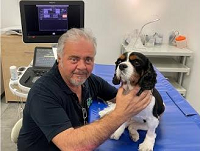 In
May 2022, Dr. Claudio Bussadori (right) of the Team Cardio Gran
Sasso clinic in Milan, Italy, announced the successful
In
May 2022, Dr. Claudio Bussadori (right) of the Team Cardio Gran
Sasso clinic in Milan, Italy, announced the successful
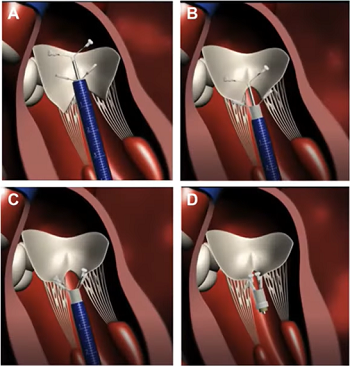 minimally-invasive
insertion of a "V-clamp" in the mitral valve of a 7-year old cavalier
King Charles spaniel, Trevor (right), to reduce the backflow of
blood through the dog's mitral valve. The device appears to be designed
remarkably like the
transcatheter Edge-to-Edge Repair (TEER) device and is inserted into
the dog's mitral valve in the same manner as the TEER, by means of a
thin tube through a vein and into the left ventricle of the heart.
(See images at left.) The procedure is monitored by transesophageal
echocardiography and fluoroscopy.
minimally-invasive
insertion of a "V-clamp" in the mitral valve of a 7-year old cavalier
King Charles spaniel, Trevor (right), to reduce the backflow of
blood through the dog's mitral valve. The device appears to be designed
remarkably like the
transcatheter Edge-to-Edge Repair (TEER) device and is inserted into
the dog's mitral valve in the same manner as the TEER, by means of a
thin tube through a vein and into the left ventricle of the heart.
(See images at left.) The procedure is monitored by transesophageal
echocardiography and fluoroscopy.
In a silent YouTube video, the entire procedure is viewable, from the pre-surgical echo examination of Trevor to the dog's post-surgery echo and reported results. Following the surgery, Trevor's mitral regurgitation was reportedly "markedly reduced", with the his LA/Ao ratio reduced from 2.57 prior to surgery down to 1.3 afterwards. The dog was discharged from the clinic less than 24 hours after the surgery, and a week later, he reportedly was "doing well".
April 2022:
Amlodipine reduced mitral regurgitation in 24 small-breed dogs
in 7 day study.
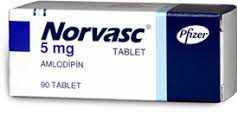 In
an
April 2022 article, Korean veterinary cardiology researchers (Sool
Yi Park, Won-Seok Oh, Seunggon Lee) added the calcium-channel blocker
amlodipine to the current medications of 24 small breed dogs (none being
cavalier King Charles spaniels) all diagnosed with Stage B2 or C of
mitral valve disease (MVD), for a period of 7 days. They found no
adverse effects, and that several measurements of MVD, including left
ventricular end-diastolic internal diameter (LVIDD), left ventricular
end-diastolic diameter normalized for bodyweight (LVIDdN), left atrial
diameter (LAD), and E wave reduced statistically after the week of
amlodipine treatment. The LVIDdN were decreased by 8% (2.2 mm); the
LA/Ao ratio, was decreased by 6.4% (1.57 mm); the E wave was decreased
by 14% (0.18 m/s). They concluded that: "These findings suggest that
low-dose amlodipine should be considered as treatment for dogs with
ACVIM stage B2-C MMVD."
In
an
April 2022 article, Korean veterinary cardiology researchers (Sool
Yi Park, Won-Seok Oh, Seunggon Lee) added the calcium-channel blocker
amlodipine to the current medications of 24 small breed dogs (none being
cavalier King Charles spaniels) all diagnosed with Stage B2 or C of
mitral valve disease (MVD), for a period of 7 days. They found no
adverse effects, and that several measurements of MVD, including left
ventricular end-diastolic internal diameter (LVIDD), left ventricular
end-diastolic diameter normalized for bodyweight (LVIDdN), left atrial
diameter (LAD), and E wave reduced statistically after the week of
amlodipine treatment. The LVIDdN were decreased by 8% (2.2 mm); the
LA/Ao ratio, was decreased by 6.4% (1.57 mm); the E wave was decreased
by 14% (0.18 m/s). They concluded that: "These findings suggest that
low-dose amlodipine should be considered as treatment for dogs with
ACVIM stage B2-C MMVD."
March 2022:
Italian study of 44 cavaliers shows that the microRNA miR-30b-5p was
significantly higher in MVD-affected dogs than in healthy CKCSs.
 In a
March 2022 article, Italian researchers Mara Bagardi, Sara Ghilardi,
Valentina Zamarian, Fabrizio Ceciliani, Paola G. Brambilla (right), and
Cristina Lecchi compared the levels of the microRNA miR-30b-5p in 44
cavalier King Charles spaniels, which were classified into four groups
of 11 dogs each: Stage A, Stage B1 under age 3 years, Stage b1 between
ages 3 and 7 years, and Stage B1 over age 7 years. MVD was diagnosed by
echocardiographic examinations, meaning that Stage A cavaliers had no
echocardiographic evidence of mitral regurgitation and Stage B1 dogs had
any evidence of thickening mitral valves and regurgitation. The
investigators report finding that in each group of Stage B1 dogs, the
expression levels of miR-30b-5p was significantly higher than in the
healthy Stage A cavaliers. They concluded:
In a
March 2022 article, Italian researchers Mara Bagardi, Sara Ghilardi,
Valentina Zamarian, Fabrizio Ceciliani, Paola G. Brambilla (right), and
Cristina Lecchi compared the levels of the microRNA miR-30b-5p in 44
cavalier King Charles spaniels, which were classified into four groups
of 11 dogs each: Stage A, Stage B1 under age 3 years, Stage b1 between
ages 3 and 7 years, and Stage B1 over age 7 years. MVD was diagnosed by
echocardiographic examinations, meaning that Stage A cavaliers had no
echocardiographic evidence of mitral regurgitation and Stage B1 dogs had
any evidence of thickening mitral valves and regurgitation. The
investigators report finding that in each group of Stage B1 dogs, the
expression levels of miR-30b-5p was significantly higher than in the
healthy Stage A cavaliers. They concluded:
"This study identified a biomarker that may have an impact in both implementing preventing programs through genetic selection and in clinical practice. These results confirm that in CKCSs, as already demonstrated in humans, there is a differential expression of miRNAs, suggesting that their expression profiles are distinct for dogs with MMVD compared to healthy dogs. We demonstrated that miR-30b-5p could discriminate among ACVIM stage A CKCSs and ACVIM stage B1 CKCSs younger than 3 years, without heart murmurs, without clinical signs, but with an echocardiographic diagnosis of MMVD. ... The present results lay the basis for a breeding program that will help the CKCS' breeders in their targeted selection to obtain healthier subjects with a reasonable life expectancy. At the same time, highlighting the risk of the development of the disease at an earlier stage will favour a preventive screening and a mitigating therapeutical approach."
 EDITOR'S NOTE:
The parameters of this study have some interesting
aspects. First, this study's cut-off definition between Stage A and
Stage B1 cavaliers is much
stricter than that of the ACVIM Consensus Statements. The ACVIM defines
Stage A dogs as not having a MVD murmur. In this study, Stage A is
defined as not having a murmur and not having any
echocardiographic evidence of MVD, which means no mitral regurgitation
at all.
EDITOR'S NOTE:
The parameters of this study have some interesting
aspects. First, this study's cut-off definition between Stage A and
Stage B1 cavaliers is much
stricter than that of the ACVIM Consensus Statements. The ACVIM defines
Stage A dogs as not having a MVD murmur. In this study, Stage A is
defined as not having a murmur and not having any
echocardiographic evidence of MVD, which means no mitral regurgitation
at all.
Second, even though the investigators followed the 2019 ACVIM Consensus Statement's bogus species-wide definitions of left atrium enlargement (LA/Ao <1.6) and left ventrical enlargement (LVIDdN <1.7), none of the 33 cavaliers in Stage B1 came close to those cut-off levels. The LA/Ao range for all of the Stage B1 dogs varied from 1.02 to 1.36, and the LVIDdN range was from 1.22 to 1.62. This data indicates that, contrary to the ACVIM's arbitrary species-wide cut-offs between normal sized hearts and enlarged ones, for cavaliers that cut-off may be substantially lower than LA/Ao = 1.6 and LVIDdN = 1.7.
In other words, cavaliers can have significantly enlarged hearts without their echo measurements being high enough to meet the minimums which the ACVIM's Stage B2 definition requires to be eligible for treatment with pimobendan. Any cardiologists ignorant enough (and, unfortunately, there are many such board certified creatures) to apply the LA/Ao > 1.6 and LVIDdN > 1.7 definition of enlargement to CKSCs would be committing malpractice by refusing to prescribe pimobendan to MVD-affected dogs desperately in need of it.
March 2022:
Cavalier with difficulty in breathing found to have a cancerous
tumor in the heart.
 In
a
March 2022 article, UK researchers (Alex Shirlow, Kieran Borgeat,
Nicolette Hayward, Emma Scurrell, Jessie Rose Payne [right]) a
cavalier King Charles spaniel displaying dyspnea (shortness of breath)
and tachypnea (rapid breathing) and a mild mitral valve murmur, was
suspected of the onset of congestive heart failure due to mitral valve
disease (MVD). However, they found that the dog's heart rhythm was
regular and that the size of the heart and the pulmonary vessels were
within normal limits. Echocardiography detected a mass which was
limiting the inflow of blood to the left side of the heart. Also, the
dog's right eye showed blood collected between the cornea and the iris,
and secondary glaucoma. A tumor was suspected within the heart, and the
dog was euthanized due to a grave prognosis. Post-mortem examination
revealed a metastatic osteosarcoma tumor in the left atrium and
pulmonary vein, metastatic osteosarcoma in the myocardium, lungs, the
uveal tract of the right eye, and both adrenal glands. Whitney grade II
myxomatous changes were noted on the mitral and tricuspid valve
leaflets. The investigators cautioned that although cavaliers with
dyspnea often raise suspicion of MVD, other more unusual causes of
dyspnea should also be considered in the absence of classic clinical MVD
findings.
In
a
March 2022 article, UK researchers (Alex Shirlow, Kieran Borgeat,
Nicolette Hayward, Emma Scurrell, Jessie Rose Payne [right]) a
cavalier King Charles spaniel displaying dyspnea (shortness of breath)
and tachypnea (rapid breathing) and a mild mitral valve murmur, was
suspected of the onset of congestive heart failure due to mitral valve
disease (MVD). However, they found that the dog's heart rhythm was
regular and that the size of the heart and the pulmonary vessels were
within normal limits. Echocardiography detected a mass which was
limiting the inflow of blood to the left side of the heart. Also, the
dog's right eye showed blood collected between the cornea and the iris,
and secondary glaucoma. A tumor was suspected within the heart, and the
dog was euthanized due to a grave prognosis. Post-mortem examination
revealed a metastatic osteosarcoma tumor in the left atrium and
pulmonary vein, metastatic osteosarcoma in the myocardium, lungs, the
uveal tract of the right eye, and both adrenal glands. Whitney grade II
myxomatous changes were noted on the mitral and tricuspid valve
leaflets. The investigators cautioned that although cavaliers with
dyspnea often raise suspicion of MVD, other more unusual causes of
dyspnea should also be considered in the absence of classic clinical MVD
findings.
March 2022:
Lengthy air travel to Japan for surgeries did
not harm 90+% of 80 severely MVD-affected dogs.
 In a
February 2022 article, Japanese veterinary cardiology surgeons
(Arane Takahashi, Sayaka Takeuchi, Ayaka Chen, Masami Uechi [right])
report that of 80 MVD-affected dogs traveling by air to Japan for mitral
valve surgeries, 78 survived their trips (97.5%), and two died enroute
of heart related causes. Ten of the 80 dogs (12.5%) were cavalier King
Charles spaniels, and one of the deceased dogs was a cavalier. The
severity of the dogs' MVD were: Stage B1: 2 (2.5%); Stage B2: 32
(40.0%); Stage C: 37 (46.25%); Stage D: 9 (11.25%). Fifty-seven of the
dogs flew from the Americas, 4 from Europe, and 19 from Asia. The
investigators concluded:
In a
February 2022 article, Japanese veterinary cardiology surgeons
(Arane Takahashi, Sayaka Takeuchi, Ayaka Chen, Masami Uechi [right])
report that of 80 MVD-affected dogs traveling by air to Japan for mitral
valve surgeries, 78 survived their trips (97.5%), and two died enroute
of heart related causes. Ten of the 80 dogs (12.5%) were cavalier King
Charles spaniels, and one of the deceased dogs was a cavalier. The
severity of the dogs' MVD were: Stage B1: 2 (2.5%); Stage B2: 32
(40.0%); Stage C: 37 (46.25%); Stage D: 9 (11.25%). Fifty-seven of the
dogs flew from the Americas, 4 from Europe, and 19 from Asia. The
investigators concluded:
"The proportion of dogs showing fatal events seems rather low, and this report indicates that dogs with MVD cannot be strongly prohibited from going onboard if MVR is included in the list of treatment options. At the same time, owners considering taking the chance to treat their dogs overseas should be aware of the in-flight symptoms and cardiac events behind them, as reported in some dogs in this study. It is strongly recommended that owners consult their local veterinarians in the short term before getting on board, adhering to the daily medication protocol while traveling, and have a medical check-up shortly after arrival in case their dogs experience any progressive symptoms."
February 2022:
Medical records of 6,102 MVD-affected dogs show confusing effect of EPIC
Study's species-wide definition of heart enlargement on cardiac medical
treatment.
 In a
February 2022 article, an international team of veterinary
cardiologists (Alessandra Franchini [right], Michele
Borgarelli, Jonathan A. Abbott, Giulio Menciotti, Serena Crosara, Jens
Haggstrom, Sunshine Lahmers, Steven Rosenthal, William Tyrrell) reviewed
the medical records of 6,102 dogs diagnosed with mitral valve dieaese
(MVD) during the years 2015 to 2018 at 13 cardiology clinics in the
United States. This data has been collected by the LOOK-mitral registry
("The Longitudinal Outcome of Canine (K9) myxomatous mitral valve
disease (MMVD) registry") established in 2015 by the Virginia- Maryland
College of Veterinary Medicine. The records included those of general
practitioners (GPs) who had referred dogs to the specialty clinics after
diagnosing them with MVD.
In a
February 2022 article, an international team of veterinary
cardiologists (Alessandra Franchini [right], Michele
Borgarelli, Jonathan A. Abbott, Giulio Menciotti, Serena Crosara, Jens
Haggstrom, Sunshine Lahmers, Steven Rosenthal, William Tyrrell) reviewed
the medical records of 6,102 dogs diagnosed with mitral valve dieaese
(MVD) during the years 2015 to 2018 at 13 cardiology clinics in the
United States. This data has been collected by the LOOK-mitral registry
("The Longitudinal Outcome of Canine (K9) myxomatous mitral valve
disease (MMVD) registry") established in 2015 by the Virginia- Maryland
College of Veterinary Medicine. The records included those of general
practitioners (GPs) who had referred dogs to the specialty clinics after
diagnosing them with MVD.
The 2015 to 2018 time period overlapped the November 2016 publication of the EPIC Study report which concluded that pimobendan may be an appropriate treatment for MVD-affected dogs with left-sided heart enlargement (Stage B2). However, the EPIC Study's definition of heart chamber enlargment was applied species-wide despite numerous well-known breed-specific differences in normal chamber sizes, and it was not based upon any published scientific research. Prior to publication of the EPIC Study, pimobendan was not recommended treatment for any dogs not yet in heart failure (Stage C).
Cavalier King Charles spaniels accounted for 8% of the dogs in the study, the highest percentage of any purebred breed. Mixed breeds accounted for 20%. The data provides interesting insight into when medications are prescribed. However, that data is not broken down by breed. The data shows:
• 3,891 of the 6,102 dogs (65%) were classified in Stage B1 (either no enlargement, or enlargement as defined in the EPIC Study in only one of the two left chambers)
• 1,180 dogs (19% of total and 30% of all Stage B1 dogs) were classifed in Stage B1 even though they had enlargement in one of their two left chambers. Of those, 217 dogs (18.4%) had only left atrial (LA) enlargement, and 963 dogs (81.6%) had only left ventricle (LV) enlargement.
• 889 dogs (15%) were classified in Stage B2 (enlargement as defined in the EPIC Study in both left chambers).
• 1,236 dogs (20%) were classified in Stage C (heart failure).
• 588 dogs in Stage B1 (15% of all Stage B1 dogs) had pulmonary hypertension (PH).
• 265 dogs in Stage B2 (30% of all Stage B2 dogs) had PH.
• 714 dogs in Stage C (58% of all Stage C dogs) had PH.
• Of 974 dogs which were prescribed medicine by the GP veterinarians, the cardiologists discontinued or modified those medicines for 88% of those dogs. For Stage B1 dogs, in 155 cases (4%), and for Stage B2 dogs in 36 cases (4%), GPs prescribed loop diuretics (such as furosemide). In all but one of those cases (99.9%) the cardiologists cancelled the diuretic treatment. For Stage C dogs -- those already in heart failure -- the GP vets prescribed a diuretic only 44% of the time, and the cardiologists did so 100% of the time.
 EDITOR'S
NOTE: Since the EPIC Study's species-wide definition of
enlarged left heart chambers is not based upon any published scientific
research, the data from this report exemplifies the resulting confusion,
including classifying dogs with either LA enlargement or LV enlargement,
but not both, to be in Stage B1 and therefore denied treatment with
pimobendan. It is interesting to note that among the 1,180 dogs with
enlargement of only one chamber, 81.6% of those dogs had only left
ventricle (LV) enlargement. Of course, the glaring fact remains that the EPIC
Study's species-wide definitions of an enlarged left atrium (having LA/Ao
ratio of at
least 1.6) and an enlarged LV (LVIDdN of at least 1.7) are meaningless
because some breeds have normal sized chambers with measurements much
higher than those numbers, and other breeds have significantly enlarged chambers with
measurements much lower than those numbers, and some of them already
being in heart failure. On balance, the EPIC Study
has completely dumbed-down the echocardiographic diagnosis of heart
enlargement.
EDITOR'S
NOTE: Since the EPIC Study's species-wide definition of
enlarged left heart chambers is not based upon any published scientific
research, the data from this report exemplifies the resulting confusion,
including classifying dogs with either LA enlargement or LV enlargement,
but not both, to be in Stage B1 and therefore denied treatment with
pimobendan. It is interesting to note that among the 1,180 dogs with
enlargement of only one chamber, 81.6% of those dogs had only left
ventricle (LV) enlargement. Of course, the glaring fact remains that the EPIC
Study's species-wide definitions of an enlarged left atrium (having LA/Ao
ratio of at
least 1.6) and an enlarged LV (LVIDdN of at least 1.7) are meaningless
because some breeds have normal sized chambers with measurements much
higher than those numbers, and other breeds have significantly enlarged chambers with
measurements much lower than those numbers, and some of them already
being in heart failure. On balance, the EPIC Study
has completely dumbed-down the echocardiographic diagnosis of heart
enlargement.
Another interesting factor is the very high percentage of cases -- 88% -- in which the cardiologists either discontinued medications prescribed by the GP vets or at least modified the GPs' treatments. The most troubling statistics include the 191 dogs not yet in heart failure, for which GP vets prescribed a diuretic, and in all but one of those cases, the cardiologists had to cancel those prescriptions. Further, in the cases of Stage C dogs -- those already in heart failure and in dire need of diuretics -- the GP vets prescribed them only 44% of the time, while the cardiologists rightly did so 100% of the time. This lends support for the argument that GP vets should consult with cardiologists before prescribing medicines to treat MVD-affected dogs. Otherwise, in many cases the GPs are putting these dogs at grave risk of either under- or over-medicating.
RETURN TO TOP
2021 News
December 2021:
Argentine researchers confirm that angiotensin-converting enzyme
(ACE) inhibitors most likely do not delay heart failure in MVD-dogs.
 In
a
December 2021 article, a team of Argentinian researchers (Pablo
Alejandro Donati [right], A. Tarducci, R. Zanatta, N. Verdier,
G. Belerenian, I. Cordero, C. Villalta, J. Franco, L. Tarragona)
reviewed previously published clinical trials assessing the
effectiveness and safety of angiotensin-converting enzyme (ACE)
inhibitors for the management of mitral valve disease (MVD) prior to
heart failure. They report that for MVD-affected dogs with enlarged
hearts (Stage B2), ACE-inhibitors are safe but are of "little to no
difference in the risk of development of congestive heart failure and may
result in little to no difference in cardiovascular-related and
all-cause mortality in dogs with MMVD and cardiomegaly." As for MVD-affected dogs with normal-sized hearts
(Stage B1), "the efficacy of ACE-inhibitors ... was low ... [and] might
also increase the risk of development of congestive heart failure." The study did
not touch on the usefulness of ACE-inhibitors once the MVD-affected dog
reached heart failure (Stage C).
In
a
December 2021 article, a team of Argentinian researchers (Pablo
Alejandro Donati [right], A. Tarducci, R. Zanatta, N. Verdier,
G. Belerenian, I. Cordero, C. Villalta, J. Franco, L. Tarragona)
reviewed previously published clinical trials assessing the
effectiveness and safety of angiotensin-converting enzyme (ACE)
inhibitors for the management of mitral valve disease (MVD) prior to
heart failure. They report that for MVD-affected dogs with enlarged
hearts (Stage B2), ACE-inhibitors are safe but are of "little to no
difference in the risk of development of congestive heart failure and may
result in little to no difference in cardiovascular-related and
all-cause mortality in dogs with MMVD and cardiomegaly." As for MVD-affected dogs with normal-sized hearts
(Stage B1), "the efficacy of ACE-inhibitors ... was low ... [and] might
also increase the risk of development of congestive heart failure." The study did
not touch on the usefulness of ACE-inhibitors once the MVD-affected dog
reached heart failure (Stage C).
November 2021:
Italian study of 30 cavaliers adds data to radiographic heart
size measurements of healthy CKCSs.
 In
a
November 2021 article, a team of Italian investigators (Mara
Bagardi, Chiara Locatelli, Martina Manfredi [right], Jessica
Bassi, Carlotta Spediacci, Sara Ghilardi, Davide D. Zani, Paola G.
Brambilla) examined the chest x-rays of 30 heart-healthy adult cavalier
King Charles spaniels with normal-sized hearts (22 females and 8 males)
to determine their range of heart-size measurements using the VHS
(vertebral heart score), VLAS (vertebral left atrial size), M-VLAS
(modified vertebral left atrial size), and RLAD (radiographic left
atrial dimension) scores. They report these ranges of findings:
In
a
November 2021 article, a team of Italian investigators (Mara
Bagardi, Chiara Locatelli, Martina Manfredi [right], Jessica
Bassi, Carlotta Spediacci, Sara Ghilardi, Davide D. Zani, Paola G.
Brambilla) examined the chest x-rays of 30 heart-healthy adult cavalier
King Charles spaniels with normal-sized hearts (22 females and 8 males)
to determine their range of heart-size measurements using the VHS
(vertebral heart score), VLAS (vertebral left atrial size), M-VLAS
(modified vertebral left atrial size), and RLAD (radiographic left
atrial dimension) scores. They report these ranges of findings:
• VHS: 10.08 ± 0.56
• VLAS: 1.79 ± 0.3
• M-VLAS: 2.23 ± 0.44
• RLAD: 1.2 ± 0.34
They also provided LA/Ao (left atrium-to-aortic valve ratio) ranges and LVIDDN (left ventricle) ranges, as follows:
• Overall population LA/Ao: 1.20 ± 0.17, females 1.22 ± 0.16, males 1.07 ± 0.11.
• Overall population LVIDDN: 1.30 ± 0.16, females 1.28 ± 0.16, males 1.33 ± 0.18.
 EDITOR'S NOTE: The
30 cavaliers in this study were 90 shy
of the
minimum of 120 recommended for establishing breed-wide reference
intervals. And, so, while this provides interesting and helpful data, it
must be added to the data from previous such studies, and not
substituted for them. For instance, in
one prior report, a heart-healthy
cavalier with a normal sized heart had a VHS value of 11.9. That finding
cannot be ignored, just because no cavaliers in this current study had a
VHS value above 10.64. Plus, since all of these CKCSs had normal-sized
hearts and none diagnosed with heart enlargement were included, who is
to say that the maximum values obtained from this cohort of dogs comes
close to the tipping point between normal and enlarged hearts? Granted,
the researchers acknowledge these facts in their list of the study's
limitations. But to even consider them as "cut-offs" or "reference
intervals" is misguided and potentially misleading to clinicians.
EDITOR'S NOTE: The
30 cavaliers in this study were 90 shy
of the
minimum of 120 recommended for establishing breed-wide reference
intervals. And, so, while this provides interesting and helpful data, it
must be added to the data from previous such studies, and not
substituted for them. For instance, in
one prior report, a heart-healthy
cavalier with a normal sized heart had a VHS value of 11.9. That finding
cannot be ignored, just because no cavaliers in this current study had a
VHS value above 10.64. Plus, since all of these CKCSs had normal-sized
hearts and none diagnosed with heart enlargement were included, who is
to say that the maximum values obtained from this cohort of dogs comes
close to the tipping point between normal and enlarged hearts? Granted,
the researchers acknowledge these facts in their list of the study's
limitations. But to even consider them as "cut-offs" or "reference
intervals" is misguided and potentially misleading to clinicians.
The results of this article confirm that the real value of VHS, VLAS,
M-VLAS, and RLAD is not to assume species-wide, or even breed-specific
cut-offs between normal and enlarged hearts. Their value is to be used
for comparisons between initial measurements -- baselines -- with
subsequent ones, to determine and/or confirm that the heart has or has
not actually enlarged between scans. As
Dr. James Buchanan
wrote in 2000:
"In addition to initial assessment of heart size, the VHS method also is useful in monitoring the progression of heart enlargement over time in individuals. Recording the heart size in vertebral scale encourages objectivity and is a convenient way of recording changes in heart size in response to treatment or progression of cardiomegaly."
Thus, it is most important that, as soon as a mild mitral valve murmur is detected in a cavalier, that very day a set of chest x-rays (thoracic radiographs) be obtained as a baseline set for comparison with future scans taken once MVD progression is detected or just suspected.
November 2021:
Chlormphenicol (Chloromycetin) is presumed cause of mitral valve
prolapse in a dog treated for bacteria infection.
 In
a
November 2021 article, Iowa State University veterinary researchers
(Sarah E. Hoff [right], Allison K. Masters, Melissa A. Tropf,
James O. Noxon, Darren J. Berger) report that a Staffordshire terrier
while being treated with chloramphenicol (Chloromycetin, Viceton) for a
staphylococcus infection had developed mitral valve prolapse and
disfunction of its left ventricle. After a month of treatment, the
owners observed trembing and weakness in the dog's hindlegs. The
examining clinican heard a mid-systolic click not heard previously.
Echocardiographic scan revealed mitral valve prolapse and dysfunction of
the left ventricle. The chloramphenicol was discontinued. Two months
later, the hindlimb weakness had improved, as had the left ventricle
dysfuntion, but the mid-systolic click remained and the LVIDdN
measurement of the left ventricle had increased from 1.23 to 1.29. The
investigators concluded that, since the left ventrticle dysfunction was
normalized after discontinuing chloramphenicol treatment, it had been
the cause of cardiotoxicity. They warn that "chloramphenicol may need to
be used with caution in dogs with underlying cardiac disease."
In
a
November 2021 article, Iowa State University veterinary researchers
(Sarah E. Hoff [right], Allison K. Masters, Melissa A. Tropf,
James O. Noxon, Darren J. Berger) report that a Staffordshire terrier
while being treated with chloramphenicol (Chloromycetin, Viceton) for a
staphylococcus infection had developed mitral valve prolapse and
disfunction of its left ventricle. After a month of treatment, the
owners observed trembing and weakness in the dog's hindlegs. The
examining clinican heard a mid-systolic click not heard previously.
Echocardiographic scan revealed mitral valve prolapse and dysfunction of
the left ventricle. The chloramphenicol was discontinued. Two months
later, the hindlimb weakness had improved, as had the left ventricle
dysfuntion, but the mid-systolic click remained and the LVIDdN
measurement of the left ventricle had increased from 1.23 to 1.29. The
investigators concluded that, since the left ventrticle dysfunction was
normalized after discontinuing chloramphenicol treatment, it had been
the cause of cardiotoxicity. They warn that "chloramphenicol may need to
be used with caution in dogs with underlying cardiac disease."
November 2021:
High doses of pimobendan given to cavaliers prevent blood
platelets from performing properly, international study finds.
 In an
abstract presented at the September 2021 congress of the European
College of Veterinary Internal Medicine - Companion Animals (ECVIM-CA),
an international team of cardiologists (M. J. Reimann, D. N. Faisst, M.
Knold, K. Meurs, S. E. Cremer, J. E. Møller, I. Ljungvall, J. Haggstrom,
L. H. Olsen [right]) studied the differences in reactions of
blood platelets of 41 privately-owned cavalier King Charles spaniels,
when given a "theraputic" dose of pimobendan (0.03μM) and a dose 333
times higher (10μM). A "μM" is a micromolar, one millionth of a molar,
which is a measurement of the concentration of a chemical in a solution.
The cavaliers were divided into groups according to the stages of mitral
valve disease (MVD) -- Stages A (9 CKCSs), B1 (22 CKCSs), and B2 (10
CKCSs). None of the dogs had been prescribed any cardiac medications
prior to the start of the study. The investigators report finding that
theraputic doses of pimobendan did not prevent the blood platelets from
responding properly, by aggregating (clumping). However, the higher dose of
pimobendan "significantly inhibited platelet aggregation response". They
also report that pimobendan had no association with the platelet counts
in the CKCSs in the study.
In an
abstract presented at the September 2021 congress of the European
College of Veterinary Internal Medicine - Companion Animals (ECVIM-CA),
an international team of cardiologists (M. J. Reimann, D. N. Faisst, M.
Knold, K. Meurs, S. E. Cremer, J. E. Møller, I. Ljungvall, J. Haggstrom,
L. H. Olsen [right]) studied the differences in reactions of
blood platelets of 41 privately-owned cavalier King Charles spaniels,
when given a "theraputic" dose of pimobendan (0.03μM) and a dose 333
times higher (10μM). A "μM" is a micromolar, one millionth of a molar,
which is a measurement of the concentration of a chemical in a solution.
The cavaliers were divided into groups according to the stages of mitral
valve disease (MVD) -- Stages A (9 CKCSs), B1 (22 CKCSs), and B2 (10
CKCSs). None of the dogs had been prescribed any cardiac medications
prior to the start of the study. The investigators report finding that
theraputic doses of pimobendan did not prevent the blood platelets from
responding properly, by aggregating (clumping). However, the higher dose of
pimobendan "significantly inhibited platelet aggregation response". They
also report that pimobendan had no association with the platelet counts
in the CKCSs in the study.
EDITOR'S NOTE: Of course, this is just a brief abstract of a study not yet officially published, so there probably is much, much more information to be obtained, if and when the full report is published. But ... there are few really big, over-riding questions that we think need to be answered:
• Why would anybody give a dose of pimobendan which is 333 times higher than the normal, recommended treatment dose, to any dog, ever? We know from prior published studies that pimobendan can have serious, heart-damaging side effects when given to some dogs, especially those not yet diagnosed with severe MVD.We look forward to finding answers to these questions, if and when the full research article is published.
• Why would anybody give a dose of pimobendan at all, be it 333 times higher than the normal, recommended treatment dose or even just the normal dose, to any dog with no MVD at all? We know from prior published studies that pimobendan can have serious, heart-damaging side effects when given to some dogs, especially those not even diagnosed with MVD. Ten of these cavaliers were in Stage A, which means that none of them had MVD at all, not even a murmur.
• Why did the investigators decide to give the dogs a dose of pimobendan 333 times stronger than the normal, recommended dose? Why not just ten times, or even a hundred times? What possibly could have been the scientific merit to choosing such an incredibly high dose of pimobendan?
• Just how well informed were the owners of these 41 cavaliers about what was about to be given to their dogs? What warnings did the investigators give to these owners? More importantly, what didn't the investigators tell the dogs' owners about the possible risks to dogs being given pimobendan in any dosage, especially when they had either healthy hearts or at least no heart enlargement?
• What health consequences did any of the 41 cavaliers experience following these treatments?
October 2021:
Danish researchers modify ACVIM's 2019 definitions of stages of
mitral valve disease in cavaliers and find heart enlargement dimensions
lower than ACVIM's minimum measurements.
 In an
October 2021 article, a team of Danish cardiology researchers
(Maria J. Reimann [right], Merete Fredholm, Signe E. Cremer, Liselotte
B. Christiansen, Jacob E. Møller, Jens Lykkesfeldt, Lisbeth H. Olsen)
and Sweden's Jens Haggstrom and North Carolina State University's
Kathryn M. Meurs examined 71 Danish cavalier King Charles spaniels, with the
initial intent of investigating if single nucleotide polymorphisms
(SNPs) of serotonin re-uptake transporter (SERT) polymorphisms
previously identified in Maltese dogs are present and associated with
serum 5-HT concentration, MMVD severity, or both. In short, they
reported finding no SERT SNPs in CKCSs and concluded that they are
"unlikely to be associated with MMVD pathophysiology or serum 5-HT
concentration in this breed."
In an
October 2021 article, a team of Danish cardiology researchers
(Maria J. Reimann [right], Merete Fredholm, Signe E. Cremer, Liselotte
B. Christiansen, Jacob E. Møller, Jens Lykkesfeldt, Lisbeth H. Olsen)
and Sweden's Jens Haggstrom and North Carolina State University's
Kathryn M. Meurs examined 71 Danish cavalier King Charles spaniels, with the
initial intent of investigating if single nucleotide polymorphisms
(SNPs) of serotonin re-uptake transporter (SERT) polymorphisms
previously identified in Maltese dogs are present and associated with
serum 5-HT concentration, MMVD severity, or both. In short, they
reported finding no SERT SNPs in CKCSs and concluded that they are
"unlikely to be associated with MMVD pathophysiology or serum 5-HT
concentration in this breed."
More importantly, however, in their process of selecting and categorizing the 71 cavaliers into the various 2019 ACVIM-defined stages of MVD (Stages A, B1, B2, and C), these investigators re-defined Stages A and B2. In doing so, they created a new "Stage A modified (Am)", which they defined as "CKCS with no auscultatory heart murmur and no or minimal [mitral regurgitation] MR (MR <20%)". They explained that:
"Thus, the MMVD stage Am included dogs with mild structural disorder of the heart (MR <20%) because such minimal MRs have been demonstrated not necessarily to have clinical or prognostic significance for MMVD in CKCS."
The researchers also report finding that three of the cavaliers had "cardiac enlargement despite having LA/Ao <1.6, LVIDDN <1.7 or both because it had been demonstrated at previous echocardiographic examinations before onset of cardiac therapy." In other words, even though these dogs otherwise would have been placed in Stage B1, because their left chamber dimensions were below the species-wide minimums for Stage B2 according to the 2019 ACVIM Consensus Statement definition, two of these cavaliers were placed in Stage B2 and one in Stage C, because despite that dog's left atrium and/or left ventricle small sizes, this dog already had reached the stage of heart failure. (See also this October 2020 article.)
EDITOR'S NOTE: Here are two more chinks in the ACVIM's Consensus Statement's arbitrary, species-wide 2019 definition of enlarged hearts in MVD-affected dogs! Cavaliers with left atrium measurements below 1.6 and left ventricle measurements below 1.7 can have enlarged hearts after all! And, they can even have reached heart failure with those low chamber sizes! Now, it is not clear from the text of the article whether or not the authors are contending that the pimobendan these three dogs had been given may have caused their hearts to decrease in size from being enlarged previously. If that was the case, the authors certainly have failed to state that with clarity.
Interestingly, one of the authors of this study also authored the 2019 ACVIM Consensus Statement. It would be interesting to hear him wiggle out of this dilemma. So, we find that cavaliers with left atrium and left ventricle chamber sizes can have enlarged ones even though the ACVIM pronounced in 2019 that such would not be possible. Again, it is time for the ACVIM to come clean, start applying scientific methods to its research on this topic, and retract its 2019 Consensus Statement.
Another potential issue regarding this study is that all of the cavaliers are from one country, in this case Denmark. Ancestors of CKCSs have been known to exist in several European states since at least the 1600s. So, unless it has been determined that there has been significant inter-state importation among these particular 71 dogs or their recent ancestors, the results of the study could be limited by insularity to just Danish cavaliers.
September 2021:
Cavaliers with shorter heads and shorter body shapes
are shown to have mitral valves relating to more severe MVD, in Italian
study.
 In
a
September 2021 study of 52 adult Italian cavaliers
reportedly diagnosed with mitral valve disease but no heart enlargement,
a team of Italian cardiology investigators (Mara Bagardi [right],
Sara Ghilardi, Chiara Locatelli, Arianna Bionda, Michele Polli, Claudio
M. Bussadori, Fabio M. Colombo, Laura Pazzagli, Paola G. Brambilla)
sought to compare head and body measurements with the characteristics of
the dogs' mitral valves and the severity of mitral valve disease (MVD).
They took a variety of head and body measurements, including head
length, nose length, head width, head stop angle, height at the withers,
body length, chest width, thorax dimensions (height, width, length,
circumference), and body indices (cephalic, craniofacial ratio, thoracic
index, volume index, and body size). The heart measurements they took
included mitral murmur intensity, mitral valve prolapse (MVP),
regurgitant jet size, mitral valve leaflet and annulus measurements
(length, width, area, and positioning). They report finding among the 52
Italian cavaliers in the study:
In
a
September 2021 study of 52 adult Italian cavaliers
reportedly diagnosed with mitral valve disease but no heart enlargement,
a team of Italian cardiology investigators (Mara Bagardi [right],
Sara Ghilardi, Chiara Locatelli, Arianna Bionda, Michele Polli, Claudio
M. Bussadori, Fabio M. Colombo, Laura Pazzagli, Paola G. Brambilla)
sought to compare head and body measurements with the characteristics of
the dogs' mitral valves and the severity of mitral valve disease (MVD).
They took a variety of head and body measurements, including head
length, nose length, head width, head stop angle, height at the withers,
body length, chest width, thorax dimensions (height, width, length,
circumference), and body indices (cephalic, craniofacial ratio, thoracic
index, volume index, and body size). The heart measurements they took
included mitral murmur intensity, mitral valve prolapse (MVP),
regurgitant jet size, mitral valve leaflet and annulus measurements
(length, width, area, and positioning). They report finding among the 52
Italian cavaliers in the study:
• No murmurs were heard in 26 (50%) dogs.
• 25 of those 26 dogs with undetectable murmurs had mild or moderate mitral valve prolapse (MVP).
• 19 of those 26 dogs with undetectable murmurs had trivial, trace or mild mitral regurgitation (MR).
• Soft murmurs (grades I or II) were heard in 20 (38.5%) dogs.
• Moderate/loud murmurs (grades III or IV) were heard in 6 (11.5%) dogs.
• 51 (98.1%) of the 52 dogs had mitral valve prolapse (MVP).
Morphometric measurements:
• 44 (84.6%) of the dogs had height at the withers lower than the breed standard.
• 6 (11.5%) dogs had nose length longer than the standard (3.8 cm).
• 36 (69.2%) dogs had nose length shorter than 3.8 cm.
• 17 (32.7%) dogs had nose length shorter than 3.0 cm.
• 1 (2%) dog had nose length equal to the 3.8 cm standard.
They further found that cavaliers that have a shorter nose and head, and a more barrel-shaped thorax, are likely to have shorter and thicker mitral valve leaflets, and a greater mitral valve annulus, which are prone to more severe forms of MVD than do CKCSs with longer and narrower skulls and bodies. Of course, the investigators acknowledge that further follow up of the dogs in this study, as well as collecting information about cavaliers with more advanced MVD, would allow researchers to gain better understandings of the morphological aspects associated with MVD in the breed. (See, also, this April 2021 article below.)
EDITOR'S NOTE: From the study's outset, its investigators concocted an arbitrary definition of left-side chamber enlargement of the hearts of the cavaliers in the study. They state:
"To be included in the study, dogs must have had no evidence of left atrial and left ventricle enlargement, defined as a left atrial-to-aortic root ratio (LA/Ao) > 1.6 on 2-dimensional echocardiography, and as left ventricular normalized dimensions in diastole (LVIDad) > 1.7, respectively."They have assumed (without any scientific basis to support the assumption) that if any cavalier has a LA/Ao ratio below 1.6, the dog's left atrium could not be enlarged, and that if any cavalier has a LVIDad (LVIDdN) below 1.7, the dog's left ventricle could not be enlarged. There is no published research to support such a definition, and they obviously did not take any other steps to assure that any of the dogs in the study really did or did not have left-side enlargement of their hearts. A 2014 study of 134 cavaliers with healthy hearts showed a LA/Ao range from 0.47 to 0.94 (instead of up to 1.6). One study of 166 cavaliers found that the upper limit of a normal-sized left atrium was 1.27 (instead of 1.6); another study of 101 heart-healthy CKCSs found their median LA/Ao ratio to be 0.74 and their reference interval for LA/Ao to be 0.47 to 0.94; and another study of 13 cavaliers found that MVD-affected cavaliers with LA/Ao as low as 1.43 had both enlarged LAs and had clinical signs of heart failure. So, these current investigators essentially have made up totally unsubstantiated definitions of MVD-affected cavaliers with normal-sized left atriums (below 1.6) and left ventricles (below 1.7).
Additionally, only 52 cavaliers were included in the study. The minmimum number of dogs necessary to make such an investigation reliably scientific would be 120. See this study on minimum number of dogs needed for establishing reference intervals. These authors acknowledge that "additional studies are needed to confirm the authors' findings." Finally, all of these cavaliers were from Italy. No mention is made of how many have been imported or the nationality of their recent ancestors. Ancestors of cavaliers have existed in Italy since the 1600s. So, the results of this study could be applicable only to CKCSs in one country.
September 2021:
Cavaliers have higher levels of deleterious genetic variations,
compared to seven other breeds, a study finds.
 In a
September 2021 article, an international team of researchers (Erik
Axelsson [right], Ingrid Ljungvall, Priyasma Bhoumik, Laura Bas
Conn, Eva Muren, Åsa Ohlsson, Lisbeth Høier Olsen, Karolina Engdahl,
Ragnvi Hagman, Jeanette Hanson, Dmytro Kryvokhyzha, Mats Pettersson,
Olivier Grenet, Jonathan Moggs, Alberto Del Rio-Espinola, Christian Epe,
Bruce Taillon, Nilesh Tawari, Shrinivas Mane, Troy Hawkins, Åke
Hedhammar, Philippe Gruet, Jens Haggstrom, Kerstin Lindblad-Toh)
generated whole genome sequencing (WGS) data from eight breeds,
including the cavalier King Charles spaniel to investigate if levels of
mutational load differ between breeds.
In a
September 2021 article, an international team of researchers (Erik
Axelsson [right], Ingrid Ljungvall, Priyasma Bhoumik, Laura Bas
Conn, Eva Muren, Åsa Ohlsson, Lisbeth Høier Olsen, Karolina Engdahl,
Ragnvi Hagman, Jeanette Hanson, Dmytro Kryvokhyzha, Mats Pettersson,
Olivier Grenet, Jonathan Moggs, Alberto Del Rio-Espinola, Christian Epe,
Bruce Taillon, Nilesh Tawari, Shrinivas Mane, Troy Hawkins, Åke
Hedhammar, Philippe Gruet, Jens Haggstrom, Kerstin Lindblad-Toh)
generated whole genome sequencing (WGS) data from eight breeds,
including the cavalier King Charles spaniel to investigate if levels of
mutational load differ between breeds.
They report finding that cavaliers carry 6% to 13% more derived, potentially deleterious alleles, than any of the other seven breeds. They admittedly speculate that the "intensity and duration of the bottleneck(s) leading to breed formation may have been extreme in cKCs relative to in most other breeds." The "bottlenecks" they refer to include (a) development of a brachycephalic variety of the King Charles spaniel, presumably in the late 1800s, followed by "the old, more long-nosed type was restored by a small breeding initiative starting in the 1920's"; and (b) "This rescued variety however suffered a serious decline in numbers during the second world war before becoming recognized as a breed of its own (cKCs) in 1945."
They also found a potential link between MVD and candidate variants near the heart-specific NEBL gene in 122 dachshunds, which they speculate may predispose cavaliers and other breeds to MVD due to loss of the integrity of the papillary muscles which control the chordae attached to the mitral valve's leaflets.
EDITOR'S NOTE: The title of this research article -- "The genetic consequences of dog breed formation -- Accumulation of deleterious genetic variation and fixation of mutations associated with myxomatous mitral valve disease in cavalier King Charles spaniels" -- to be factual, really ought to end with a question mark (?). As it is, it is dreadfully misleading, because it wrongfully implies that the researchers have produced empirical evidence that the way the CKCS was formed as a breed is the cause of the cavalier having 6% to 13% more derived, potentially deleterious alleles leading to MVD than seven other breeds. In fact, these researchers have done no such thing. The only empirical evidence they have produced is that, compared to 20 dogs each of the other seven breeds (beagle, German shepherd, golden retriever, Labrador retriever, standard poodle, Rottweiler, and West Highland terrier), these 20 cavaliers carry 6% to 13% more possibly harmful variants overall, and not specifically connected to MVD. Since the minimum recommended number of dogs of each breed in predicting accurate reference intervals is 120, the number chosen per breed here is only 17% of that minimum.
And, since the American Kennel Club (AKC) recognizes nearly 200 different purebred breeds, this study covered less than 5% of the total number of breeds necessary to make this approach anything empirically scientific. And, importantly, none of the other 19 breeds is of a small dog with a pre-disposition for MVD. So this is truly an apples-versus-oranges endeavor. Also, their discussion of "bottlenecks" is pure speculation (which they admit), and in particular their vague reference to a bottleneck in England during World War II (apparently in their minds unique only to cavaliers) is, frankly, an old wives' tale.
Not only are the numbers of dogs in the study miniscule, but they all are from only one country, Sweden, except for ten each of the German shepherds, golden retrievers, and Labrador retrievers. Cavaliers had been prominent in Sweden long before WWII, thus there is no reason to assume that all 20 of these CKCSs came from England after the war. So, the data used in this study is, essentially, insular, but the researchers' conclusions are not.
To be charitable, this could be fairly described as a "pilot study", although the researchers fail to do so themselves. Instead, they caution that:"... although cKCs have accumulated deleterious alleles that are likely to have large phenotypic effects, the total number of added mutations may be relatively low and it may hence be premature to use our results as an argument to discourage further breeding of cKCs."We would counter that it definitely is premature to use this study as an argument for anything at all.
August 2021:
English
setters' normal left atriums and left ventricles exceed EPIC Study's and
ACVIM's definitions of enlarged hearts, in 100 dog study.
 In an
August 2021 article, an international team of investigators (Liva
Vatne [right], David Dickson, Anna Tidholm, Domenico Caivano,
Mark Rishniw) performed and analyzed various echocardiographic
measurements of 100 English setter dogs living in Norway. Their aim was
to determine the effects of activity levels, body weight, sex, and age
on the echo measurement intervals of the breed, including the left
atrium-to-aorta ratio (LA:Ao) and the left ventricular diameter at
end-diastole indexed to body weight (LVIDdN). They found that, unlike the
species-wide minimum definitions of enlarged left atriums (LA:Ao = 1.6)
and left ventricles (LVIDdN = 1.7) used by both the 2016 EPIC Study and
the 2019 ACVIM Consensus Statement in determining when to begin
treatment for mitral valve disease (MVD) with pimobendan, heart-healthy
English setters with normal sized hearts had LA:Ao as high as 1.8 and
LVIDdN as high as 2.1. The authors stated that:
In an
August 2021 article, an international team of investigators (Liva
Vatne [right], David Dickson, Anna Tidholm, Domenico Caivano,
Mark Rishniw) performed and analyzed various echocardiographic
measurements of 100 English setter dogs living in Norway. Their aim was
to determine the effects of activity levels, body weight, sex, and age
on the echo measurement intervals of the breed, including the left
atrium-to-aorta ratio (LA:Ao) and the left ventricular diameter at
end-diastole indexed to body weight (LVIDdN). They found that, unlike the
species-wide minimum definitions of enlarged left atriums (LA:Ao = 1.6)
and left ventricles (LVIDdN = 1.7) used by both the 2016 EPIC Study and
the 2019 ACVIM Consensus Statement in determining when to begin
treatment for mitral valve disease (MVD) with pimobendan, heart-healthy
English setters with normal sized hearts had LA:Ao as high as 1.8 and
LVIDdN as high as 2.1. The authors stated that:
"Our study provides transthoracic echocardiographic values for English setter dogs, showing that they have larger hearts than many other breeds and fall outside of generic reference intervals for dogs. ... Breed specific reference intervals improve echocardiographic interpretation and thereby reduce misdiagnoses. ... The study provides breed specific transthoracic echocardiographic values for English setter dogs, thereby contributing to improve diagnostic assessment of cardiac health in this breed."
 EDITOR'S NOTE:
Ah, ha! More solid, empirical evidence that the
species-wide definition of enlarged hearts (LA:Ao = 1.6 and LVIDdN =
1.7) in both the 2016 EPIC Study and the 2019 ACVIM Consensus Statement, was
not only totally arbitrary, but also totally WRONG and leading to
mis-diagnoses of MVD (and life-time treatment with pimobendan) in healthy
dogs. The EPIC Study and the 2016 ACVIM Consensus Statement
should be retracted and rewritten!
EDITOR'S NOTE:
Ah, ha! More solid, empirical evidence that the
species-wide definition of enlarged hearts (LA:Ao = 1.6 and LVIDdN =
1.7) in both the 2016 EPIC Study and the 2019 ACVIM Consensus Statement, was
not only totally arbitrary, but also totally WRONG and leading to
mis-diagnoses of MVD (and life-time treatment with pimobendan) in healthy
dogs. The EPIC Study and the 2016 ACVIM Consensus Statement
should be retracted and rewritten!
And one other very important observation: These investigators classified as healthy dogs without MVD, those which had no mitral murmur but had mitral regurgitation not exceeding 15% of the atrial area. They called this "trace" mitral regurgitation. This means that dogs with no murmur and very little regurgitation, by definition do not have mitral valve disease.
August 2021:
Review of ACE-inhibitor dosages for 101 MVD-affected dogs raises
more questions than answers.
 In an
August 2021 article, a team of Iowa State University cardiology
researchers (Jessica L. Ward [right], Yen-Yu Chou, Lingnan Yuan, Karin S.
Dorman, Jonathan P. Mochel) reviewed the medical records of 144 dogs
which had been diagnosed with cardiac disorders -- 101 of which had
mitral valve disease (MVD) and 42 of which had reached heart failure
(CHF) -- over a period from 2005 to 2018 at the University's
veterinary hospital. Cavalier King Charles spaniels were the most common
breed -- 13 cavaliers (all presumably treated for MVD). They
hypothesized that higher total daily dose of ACE-inhibitors or
twice-daily dosing would be associated with longer time to all-cause
mortality compared to lower total daily dose or once daily dosing. Their
reported results were inconclusive. Specifically, they found an
"indication" of an association between ACE-inhibitor dose frequency and
long-term outcome, and that the results "suggest" that the clinical
benefit of ACE-inhibitors "might be" dose-dependent, with twice-a-day
dosing providing superior protection to the heart. But, they concede
that they could not differentiate the effects between amount of dosage
versus the frequency of dosage on long-term outcomes. They stated that
"It is therefore impossible to determine whether the survival benefit
found in our study was associated with higher ACEI dose, q12h [twice
daily] dose frequency, or both."
In an
August 2021 article, a team of Iowa State University cardiology
researchers (Jessica L. Ward [right], Yen-Yu Chou, Lingnan Yuan, Karin S.
Dorman, Jonathan P. Mochel) reviewed the medical records of 144 dogs
which had been diagnosed with cardiac disorders -- 101 of which had
mitral valve disease (MVD) and 42 of which had reached heart failure
(CHF) -- over a period from 2005 to 2018 at the University's
veterinary hospital. Cavalier King Charles spaniels were the most common
breed -- 13 cavaliers (all presumably treated for MVD). They
hypothesized that higher total daily dose of ACE-inhibitors or
twice-daily dosing would be associated with longer time to all-cause
mortality compared to lower total daily dose or once daily dosing. Their
reported results were inconclusive. Specifically, they found an
"indication" of an association between ACE-inhibitor dose frequency and
long-term outcome, and that the results "suggest" that the clinical
benefit of ACE-inhibitors "might be" dose-dependent, with twice-a-day
dosing providing superior protection to the heart. But, they concede
that they could not differentiate the effects between amount of dosage
versus the frequency of dosage on long-term outcomes. They stated that
"It is therefore impossible to determine whether the survival benefit
found in our study was associated with higher ACEI dose, q12h [twice
daily] dose frequency, or both."
They go on to suggest that their findings could:
"provide a potential explanation for the failure of clinical trials to identify a clinical benefit of ACEI in dogs with cardiovascular disease, because all such previous trials have utilized ACEI dosages <0.5 mg/kg q24h. Additional PK/PD and prospective clinical studies will be needed to determine the ideal dosage of ACEIs to optimize RAAS suppression and cardioprotective benefit in dogs."
 EDITOR'S NOTE: This is very thin gruel to have to digest. We refer to
terms like "These results suggest that the clinical benefit of ACEI
might be dose-dependent", and "our study could not differentiate the
effects of ACEI dose vs frequency", and "It is therefore impossible to
determine", and "These findings provide a potential explanation". Most
significantly, we think, is that the authors sought to discredit a
couple of prior studies -- the
2002 Scandinavian study (the
"Scandinavian Veterinary Enalapril Prevention [SVEP] Trial") of 229
cavalier King Charles spaniels, and the
2007 "VETPROOF Trial" study,
both of which concluded that treating Stage B2 cavaliers was a waste of
time and money. What the Iowa State researchers ended up saying about those studies is this:
EDITOR'S NOTE: This is very thin gruel to have to digest. We refer to
terms like "These results suggest that the clinical benefit of ACEI
might be dose-dependent", and "our study could not differentiate the
effects of ACEI dose vs frequency", and "It is therefore impossible to
determine", and "These findings provide a potential explanation". Most
significantly, we think, is that the authors sought to discredit a
couple of prior studies -- the
2002 Scandinavian study (the
"Scandinavian Veterinary Enalapril Prevention [SVEP] Trial") of 229
cavalier King Charles spaniels, and the
2007 "VETPROOF Trial" study,
both of which concluded that treating Stage B2 cavaliers was a waste of
time and money. What the Iowa State researchers ended up saying about those studies is this:
"These findings provide a potential explanation for the failure of clinical trials to identify a clinical benefit of ACEI in dogs with cardiovascular disease, because all such previous trials have utilized ACEI dosages <0.5 mg/kg q24h."
What the Iowa State investigators fail to point out is that they had medical records of only 13 cavaliers, a far cry from the 229 in the Scandinavian study alone. If they wanted to try to contradict the Scandinavian study by using higer doses, they also should have used comparable numbers of cavaliers. What we fail to understand is why this article was published in the Journal of Veterinary Internal Medicine, at all.
August 2021:
Heart size measurements from x-rays should be the first
diagnostic test of choice for MVD in large breeds, study finds.
 In an
August 2021 article, cardiology researchers from Texas A & M
University's veterinary school and elsewhere (S. Wesselowski [right],
S.G. Gordon, N. Meddaugh, A.B. Saunders, J. Haggstrom, K. Cusack, B.W.
Janacek, D.J. Matthews) reviewed the chest x-rays
(thoracic radiographs) and echocardiology scans of 455 dogs of 50 large
breeds (LBs), to determine if thoracic radiographs, along with physical
examinations and elctrocardiography, could predict dogs with enlarged
left heart chambers due either to mitral valve disease (MVD) or dilated
cardiomyopathy (DCM). They used the
vertebral heart size (VHS) and the
vertebral left atrial size (VLAS) measurement methods to compare with
the echo results. They found that "thoracic radiographs were useful for
predicting clinically important DCM or MMVD in LB dogs, with improved
discriminatory ability when physical examination abnormalities and
arrhythmias were accounted for." They concluded that "[T]horacic
radiographs should always be the first diagnostic test of choice."
In an
August 2021 article, cardiology researchers from Texas A & M
University's veterinary school and elsewhere (S. Wesselowski [right],
S.G. Gordon, N. Meddaugh, A.B. Saunders, J. Haggstrom, K. Cusack, B.W.
Janacek, D.J. Matthews) reviewed the chest x-rays
(thoracic radiographs) and echocardiology scans of 455 dogs of 50 large
breeds (LBs), to determine if thoracic radiographs, along with physical
examinations and elctrocardiography, could predict dogs with enlarged
left heart chambers due either to mitral valve disease (MVD) or dilated
cardiomyopathy (DCM). They used the
vertebral heart size (VHS) and the
vertebral left atrial size (VLAS) measurement methods to compare with
the echo results. They found that "thoracic radiographs were useful for
predicting clinically important DCM or MMVD in LB dogs, with improved
discriminatory ability when physical examination abnormalities and
arrhythmias were accounted for." They concluded that "[T]horacic
radiographs should always be the first diagnostic test of choice."
EDITOR'S NOTE: Once again, when cardiology investigators start with a ficitious definition, they are sure to end up with worthless results. Here, they arbitrarily defined normal-sized left atriums as LA:Ao ≤1.6 for all breeds except boxers (LA:Ao ≤1.73), and they arbitrarily defined normal-sized left ventricles as LVIDdN <1.85 for all breeds. They report finding that 67% of dogs with MVD showed mitral regurgitation (blood backflow) on echo scans but no heart enlargement, from which they concluded that "an early and clinically less important stage of this disease was most common."
Now that 67% finding may seem inoccuous and possibly accurate, but because they started out with baseless definitions, they end up with this 67% figure which could be right or could be totally wrong. For example, their definition of a normal-sized left atrium is as high as LA:Ao = 1.6 for all 49 breeds (excluding boxers). Now, how do they know that all 49 of these breeds have normal-sized left atriums at LA:Ao = 1.6 and none have any enlargement at lower ratios? They don't. They just made it up. So it is just as likely that many of these dogs with lower LA:Ao ratios nevertheless had enlarged left atriums, which would mean that their 67% could really be 33%, or even 10%. When will these researchers stop playing this shell game with diagnoses of heart enlargement in MVD-affected dogs? After all, heart enlargement is the point at which MVD-affected dogs should start to be medicated, which means that its detection is serious business for the dogs and their owners.
July 2021:
Hydrochlorothiazide added to torsemide improved the cardiac
condition of MVD-affected dogs in advanced heart failiure.
 In
a
July 2021 article, a team of Japanese cardiologists (Koji Iwanaga,
Ryuji Araki, Mitsuhiro Isaka [right]) studied the effects of
adding the thiazide diuretic hydrochlorothiazide (HTCZ) in treating 14
dogs in heart failure due to mitral valve disease (MVD) which no longer
were responding to treatment with high doses of the loop diuretic
torsemide. One of the 14 dogs was a cavalier King Charles spaniel (7%).
The others were 6 Chihuahuas, and one each of Boston terrier,
Pomeranian, Cockapoo, Shih Tzu, toy poodle, and miniature Schaauzer.
In
a
July 2021 article, a team of Japanese cardiologists (Koji Iwanaga,
Ryuji Araki, Mitsuhiro Isaka [right]) studied the effects of
adding the thiazide diuretic hydrochlorothiazide (HTCZ) in treating 14
dogs in heart failure due to mitral valve disease (MVD) which no longer
were responding to treatment with high doses of the loop diuretic
torsemide. One of the 14 dogs was a cavalier King Charles spaniel (7%).
The others were 6 Chihuahuas, and one each of Boston terrier,
Pomeranian, Cockapoo, Shih Tzu, toy poodle, and miniature Schaauzer.
After dual treatment with the two diuretics, the echocardiographic data showed significant improvement, including reductions in the measurements of the left atrium (LA/Ao mean from 3.18 to 2.97) and left ventricle (LVIDDN mean from 2.23 to 2.15), and in the E velocity (mean from 1.73 to 1.51). However, blood urea nitrogen and creatinine levels increased, and potassium levels decreased, indicating a decline in renal function following HTCZ administration. They acknowledged that only 14 dogs of various breeds was "a small sample size." They concluded that their study suggested that the administration of HTCZ in combination with loop diuretics may improve cardiac function during advanced heart failure in MVD-affected dogs. However, as the combination of HTCZ and loop diuretics can deteriorate renal function, they advised that caution should be exercised prior to making recommendations regarding its use, and renal function should be monitored.
July 2021:
Sacubitril/valsartan tops ACE-inhibitor ramipril in treating
MVD-dogs in heart failure, in a Thai study.
 In a
July 2021 article, Thai investigators (Nakkawee Saengklub
[right],
Prapawadee Pirintr, Thanida Nampimoon, Anusak Kijtawornrat, Narongsak
Chaiyabutr) compared the angiotensin receptor-neprilysin inhibitor
Sacubitril/valsartan (SV - Entresto) with the ACE-inhibitor ramipril in treating
dogs diagnosed with Stage C (heart failure) due to mitral valve disease
(MVD), along with both pimobendan and the diuretic furosemide.
Twenty-one dogs -- none being cavaliers -- were divided into the SV
group (11 dogs) and the ramipril group (10 dogs) for four weeks. The
investigators report that short-term administration of SV in dogs with
MVD stage C resulted in a greater extent of reverse myocardial
remodeling of both the left atrium and the left ventricle than in the
ramipril group, as indicated by several echocardiographic parameters.
They concluded:
In a
July 2021 article, Thai investigators (Nakkawee Saengklub
[right],
Prapawadee Pirintr, Thanida Nampimoon, Anusak Kijtawornrat, Narongsak
Chaiyabutr) compared the angiotensin receptor-neprilysin inhibitor
Sacubitril/valsartan (SV - Entresto) with the ACE-inhibitor ramipril in treating
dogs diagnosed with Stage C (heart failure) due to mitral valve disease
(MVD), along with both pimobendan and the diuretic furosemide.
Twenty-one dogs -- none being cavaliers -- were divided into the SV
group (11 dogs) and the ramipril group (10 dogs) for four weeks. The
investigators report that short-term administration of SV in dogs with
MVD stage C resulted in a greater extent of reverse myocardial
remodeling of both the left atrium and the left ventricle than in the
ramipril group, as indicated by several echocardiographic parameters.
They concluded:
"The current study suggested that the short-term effects of SV can reverse myocardial remodeling, as inferred from several echocardiographic indices (i.e., the reduction in LA/Ao, LVIDDN, EDVI and ESVI) in dogs with MMVD stage C. These findings would support the use of SV in clinically symptomatic heart failure in dogs."
However, they warn of a few limitations: (a) a very small sample size, with a much larger sample size needed to confirm the findings; (b) the study was for a very short term -- four weeks -- and a longer term study should be conducted; (c) the results thus far "do not suggest that ACEi should be replaced with SV in dogs with MMVD stage C."
July 2021:
Omega-3 supplementation reduced several indications of advancing
mitral valve disease, in a Brazil study.
 In a
July 2021 article, a team of Brazilian veterinary reseachers
(Priscilla Regina Nasciutti, Aline Tavares Moraes, Thaiz Krawczyk
Santos, Karine Kelly Gonçalves Queiroz, Ana Paula Araŭjo Costa, Andressa
Rodrigues Amara, Rodrigo Fernando Gomes Olivindo, Cristiana Ferreira
Fonseca Pontieri, Juliana Toloi Jeremias, Thiago Henrique Annibale
Vendramini, Marcio Antonio Brunetto [right], Rosângela de Oliveira Alves
Carvalho) studied the effects of omega-3 fatty acids (ω-3) upon the
progression of mitral valve disease (MVD) over 12 months in 29 dogs
(none being cavalier King Charles spaniels) diagnosed with Stages B2 or
C of MVD. The average dosages were 54.2mg/kg EPA and 40.65mg/kg DHA. The
supplement was added to the dogs' daily meals. They concluded that:
In a
July 2021 article, a team of Brazilian veterinary reseachers
(Priscilla Regina Nasciutti, Aline Tavares Moraes, Thaiz Krawczyk
Santos, Karine Kelly Gonçalves Queiroz, Ana Paula Araŭjo Costa, Andressa
Rodrigues Amara, Rodrigo Fernando Gomes Olivindo, Cristiana Ferreira
Fonseca Pontieri, Juliana Toloi Jeremias, Thiago Henrique Annibale
Vendramini, Marcio Antonio Brunetto [right], Rosângela de Oliveira Alves
Carvalho) studied the effects of omega-3 fatty acids (ω-3) upon the
progression of mitral valve disease (MVD) over 12 months in 29 dogs
(none being cavalier King Charles spaniels) diagnosed with Stages B2 or
C of MVD. The average dosages were 54.2mg/kg EPA and 40.65mg/kg DHA. The
supplement was added to the dogs' daily meals. They concluded that:
"Dietary supplementation with ω-3 fatty acids contributes to more favourably Doppler echocardiographic measurements, such as normalized LVD [left ventricular diameter], and reduces the VHS [vertebral heart size] measures. NTproBNP dosages, associated with normalized LVD averages suggest a lower volumetric overload in the ω-3 Group dogs. Thus, showing a contribution to the control of volumetric overload and, consequently, CHF [congestive heart failure]."
July 2021:
Study of 175 dogs finds that radiographic and echocardiographic
stages of mitral valve disease do not agree.
 In a
July 2021 article, verterinary radiologists and cardiologists from
eight USA clinics (Elodie E. Huguet, Federico Vilaplana Grosso
[right], Whitney
R. Lamb, Margaret M. Sleeper, John Mattoon, Nathan Nelson, James Brown,
Bennett Deddens, Hock Gan Heng, Stephanie Knapp, Maureen Levesque, Rudy
Rivas, James C. Colee, Clifford R. Berry) reviewed radiographic (x-ray)
and echocardiographic measurements of 175 dogs (including 17 [9.7%]
cavalier King Charles spaniels), to compare the subjective grading of
heart chamber enlargement on x-rays to the grades of chamber size taken
from echocardiographic measurements. They describe echocardiography as
"the gold standard" in assessing cardiac chamber enlargement. As a
result of their comparisions, they conclude that:
In a
July 2021 article, verterinary radiologists and cardiologists from
eight USA clinics (Elodie E. Huguet, Federico Vilaplana Grosso
[right], Whitney
R. Lamb, Margaret M. Sleeper, John Mattoon, Nathan Nelson, James Brown,
Bennett Deddens, Hock Gan Heng, Stephanie Knapp, Maureen Levesque, Rudy
Rivas, James C. Colee, Clifford R. Berry) reviewed radiographic (x-ray)
and echocardiographic measurements of 175 dogs (including 17 [9.7%]
cavalier King Charles spaniels), to compare the subjective grading of
heart chamber enlargement on x-rays to the grades of chamber size taken
from echocardiographic measurements. They describe echocardiography as
"the gold standard" in assessing cardiac chamber enlargement. As a
result of their comparisions, they conclude that:
"[T]he subjective grading of cardiac chamber size on thoracic radiographs underestimated and poorly agreed with echocardiographic grades, supporting the use of echocardiography over radiography for the characterization of cardiac chamber enlargement."
 EDITOR'S
NOTE: Boy, howdy! What a waste of time and effort this study
was! From the get-go, these investigators made false assumption after
false assumption. Their first one was to claim that 2-dimensional echocardiography is
"the gold standard" in assessing cardiac chamber enlargement.
Apparently
"the gold standard" now is anything that anybody wants it to be.
EDITOR'S
NOTE: Boy, howdy! What a waste of time and effort this study
was! From the get-go, these investigators made false assumption after
false assumption. Their first one was to claim that 2-dimensional echocardiography is
"the gold standard" in assessing cardiac chamber enlargement.
Apparently
"the gold standard" now is anything that anybody wants it to be.
 But the
long-standing and well-recognized gold standard in measuring heart
chamber dimensions remains either cardiac magnetic resonance imaging
(CMRI) or multi-slice computed tomography (MSCT). Even 3-dimensional
echo scanning trumps this study's 2-D measurements. So, that is their
first mistake. Secondly, based upon their glittering love-affair with
But the
long-standing and well-recognized gold standard in measuring heart
chamber dimensions remains either cardiac magnetic resonance imaging
(CMRI) or multi-slice computed tomography (MSCT). Even 3-dimensional
echo scanning trumps this study's 2-D measurements. So, that is their
first mistake. Secondly, based upon their glittering love-affair with
 echocardiography, they use as their control group the ACVIM's 2019
definitions of Stages B1 and B2 to define whether MVD-affected dogs'
hearts are enlarged or not. They report categorizing 5 MVD-affected dogs
in Stage B1 (meaning, no left-sided enlargement) and 54 dogs in Stage B2
(meaning, left-sided enlargement). Since the ACVIM's species-wide definition is
totally bogus and not based upon any reality, these investigators start
out with a worthless control group, and their results go downhill from
there. They find that the x-rays do not agree with the echo
measurements, and so they blame the x-rays without considering the
possibility -- indeed, the likelihood -- that the arbitrary, species-wide echocardiographic
definitions of left atrial and left ventricle enlargement could be the
culprits. They conclude that the x-rays "underestimated and poorly
agreed with echocardiographic grades", therefore "supporting the use of
echocardiography over radiography for the characterization of cardiac
chamber enlargement." Such nonsense!
echocardiography, they use as their control group the ACVIM's 2019
definitions of Stages B1 and B2 to define whether MVD-affected dogs'
hearts are enlarged or not. They report categorizing 5 MVD-affected dogs
in Stage B1 (meaning, no left-sided enlargement) and 54 dogs in Stage B2
(meaning, left-sided enlargement). Since the ACVIM's species-wide definition is
totally bogus and not based upon any reality, these investigators start
out with a worthless control group, and their results go downhill from
there. They find that the x-rays do not agree with the echo
measurements, and so they blame the x-rays without considering the
possibility -- indeed, the likelihood -- that the arbitrary, species-wide echocardiographic
definitions of left atrial and left ventricle enlargement could be the
culprits. They conclude that the x-rays "underestimated and poorly
agreed with echocardiographic grades", therefore "supporting the use of
echocardiography over radiography for the characterization of cardiac
chamber enlargement." Such nonsense!
July 2021:
American Staffordshire terrier echocardiographic reference
intervals contradict ACVIM Stage B2 definition of enlarged hearts.
 In an
April 2021 article, Italian veterinary cardiology researchers
(Tommaso Vezzosi [right], Roberto Ghinello, Paolo Ferrari,
Francesco Porciello) reviewed the echocardiograms of 57 healthy American
Staffordshire terriers (ASTs) to determine the range of high and low
measurements (reference intervals [RI]) of the left atrium (LA/Ao) and
left ventricle (LVIDDn) and compare them to previously published RIs for
the general canine population. In 2019, the ACVIM re-defined left-sided
heart enlargement of all dogs -- species-wide -- diagnosed with mitral
valve disease (MVD), as having at least LA:Ao = 1.6 and LVIDDn = 1.7.
The investigators of this study report these RIs for healthy ASTs with
normal-sized hearts:
In an
April 2021 article, Italian veterinary cardiology researchers
(Tommaso Vezzosi [right], Roberto Ghinello, Paolo Ferrari,
Francesco Porciello) reviewed the echocardiograms of 57 healthy American
Staffordshire terriers (ASTs) to determine the range of high and low
measurements (reference intervals [RI]) of the left atrium (LA/Ao) and
left ventricle (LVIDDn) and compare them to previously published RIs for
the general canine population. In 2019, the ACVIM re-defined left-sided
heart enlargement of all dogs -- species-wide -- diagnosed with mitral
valve disease (MVD), as having at least LA:Ao = 1.6 and LVIDDn = 1.7.
The investigators of this study report these RIs for healthy ASTs with
normal-sized hearts:
• LA/Ao: 1.00 to 1.75
• LVIDDn: 1.27 to 1.87
Thus, the high points of the range of normal-sized left atriums and of normal-sized left ventricles of ASTs are significantly above the ACVIM's definition of enlarged hearts -- Stage B2 of MVD. These AST investigators concluded that "These breed-specific echocardiographic features should be taken into consideration for an accurate echocardiographic interpretation and screening in the AST."
EDITOR'S NOTE: This study is a perfect example of why, at the very least, only breed-specific echocardiographic reference intervals should be utilized in determining whether a purebred dog does or does not have an enlarged heart. Ideally, the cardiologist should compare the patient's previous x-rays and echo measurements with current ones, to determine if the heart is larger than it had been. But if the examining veterinarian does not have prior measurements for comparision, nothing less than breed-specific reference intervals, and observation of the shape of the heart on x-rays, are the way to go. Of course, this study included only 57 dogs, and from a statistical standpoint, no less than 120 ASTs should be included to establish a reliable range of echocardiographic measurements of normal-sized hearts. Nevertheless, even with this low number of ASTs, the study shows that their normal-sized left atriums and left ventricles can be substantially larger than what the ACVIM would blindly declare to be substantially enlarged and recommend immediate twice-daily medication with pimobendan for the rest of the dogs' lives. Once again, the ACVIM's definition of Stage B2 of MVD is totally bogus and irresponsible and should be retracted.
July 2021:
Cavaliers have a mutation of the angiotensin-converting
enzyme (ACE) gene which makes ACE-inhibitors less effective, study shows.
 In
a
July 2021 article, five USA cardiologists (D. B. Adin [right],
C. E. Atkins, S. G. Friedenberg, J. A. Stern, K. M. Meurs) studied the
gene for the angiotensin-converting enzyme (ACE) -- canine chromosome
9:11507816:G > A -- in 497 dogs of 54 breeds, including 13 cavalier King
Charles spaniels, to determine the prevalance of a variant of that gene
which prevents ACE-inhibitors from suppressing the renin-angiotensin
aldosterone system (RAAS) and instead allows aldosterone breakthrough.
The progression of mitral valve disease (MVD) will prompt the kidneys to
initiate the RAAS. When the RAAS is activated, it causes the kidneys to
over-work by retaining more water and sodium and excreting more
potassium. As a result of this process, the overall volume of blood
increases, meaning that more blood is pumped through narrowed arteries,
which also increases the blood pressure. In addition, treatment of
congestive heart failure (CHF) due to MVD with loop diuretics, including
furosemide, can severely affect the kidneys by further activating the
RAAS. The ACE gene variant was found in 32 of the 54 breeds. The variant
was greatest five breeds, including the CKCS with a prevalence of 85%.
The other four breeds were the Irish wolfhound (95%), Dachshunds (90%),
great Danes (84%), and bull mastiffs (58%). The investigators recognized
that the number of dogs per breed was low, and that findings could be
different with a greater number of dogs. They also acknowleged that
there may be other reasons for ineffective RAAS suppression, apart from
this gene variant, including: "aldosterone breakthrough, non-ACE
mediated angiotensin II formation, genetic variants affecting RAAS
components, feedback mechanisms, and likely other unidentified factors."
In
a
July 2021 article, five USA cardiologists (D. B. Adin [right],
C. E. Atkins, S. G. Friedenberg, J. A. Stern, K. M. Meurs) studied the
gene for the angiotensin-converting enzyme (ACE) -- canine chromosome
9:11507816:G > A -- in 497 dogs of 54 breeds, including 13 cavalier King
Charles spaniels, to determine the prevalance of a variant of that gene
which prevents ACE-inhibitors from suppressing the renin-angiotensin
aldosterone system (RAAS) and instead allows aldosterone breakthrough.
The progression of mitral valve disease (MVD) will prompt the kidneys to
initiate the RAAS. When the RAAS is activated, it causes the kidneys to
over-work by retaining more water and sodium and excreting more
potassium. As a result of this process, the overall volume of blood
increases, meaning that more blood is pumped through narrowed arteries,
which also increases the blood pressure. In addition, treatment of
congestive heart failure (CHF) due to MVD with loop diuretics, including
furosemide, can severely affect the kidneys by further activating the
RAAS. The ACE gene variant was found in 32 of the 54 breeds. The variant
was greatest five breeds, including the CKCS with a prevalence of 85%.
The other four breeds were the Irish wolfhound (95%), Dachshunds (90%),
great Danes (84%), and bull mastiffs (58%). The investigators recognized
that the number of dogs per breed was low, and that findings could be
different with a greater number of dogs. They also acknowleged that
there may be other reasons for ineffective RAAS suppression, apart from
this gene variant, including: "aldosterone breakthrough, non-ACE
mediated angiotensin II formation, genetic variants affecting RAAS
components, feedback mechanisms, and likely other unidentified factors."
EDITOR'S NOTE: ACE-inbibitors have long been known to be ineffective in suppressing the RAAS in cavaliers. In a 2002 study of 229 CKCSs, all diagnosed with MVD but not yet in CHF, the ACE-inhibitor enalapril was found to have no significant affect in preventing the onset of CHF. A 2007 study of 124 dogs (including 10 cavaliers) reached the same conclusion for CKCSs. A 2008 study found that benazepril likewise had no beneficial effect on Stage B cavaliers. In a 2017 article, some of the same investigators that are authors of this current article reported studying 73 CKCSs and concluded:
"The CKCS appears to have a high prevalence of the ACE variant. Dogs with the ACE variant had lower levels of ACE activity even in more advanced mitral valve disease than dogs without the variant."This current study is very weak in terms of numbers of dogs per breed. The breed with the most participants was the golden retriever with only 42 dogs. Only 10 cavaliers were included. As a result, it is statistically meaningless, but it is consistent with the noted previous studies and serves to identify the location of the variant gene.
July 2021:
Regurgitant fraction
echocardiographic measurement method of MVD severity contradicts EPIC's
definition of left atrial enlargement.
 In
a June 2021 ACVIM Forum session, Dr. Lance C. Visser (right)
presented an
abstract of a study (by Lance C. Visser, Riley E. Ellis-Reis, Weihow
Hsue) comparing the regurgitant fraction (RF) measurement of dogs
diagnosed with mitral valve disease (MVD) to the EPIC Study's definition
of left atrial enlargement (the ratio of the left atrium over the aorta
-- LA/Ao) of 1.6. Of the 81 dogs in the study, 56 were shown on a chart
as having moderate (RF over 30%) to severe (RF over 50%) MVD based upon
their regurtitant fractions. Of those 56 dogs, 12 (21.4%) had LA/Ao
ratios below 1.6, which is the species-wide cut off definition of left atrial
enlargement in both the
2016 EPIC Study and the
2019 ACVIM definition of
Stage B2. Four of those 12 dogs with LA/Ao < 1.6 had RFs between 50% and
60%.
In
a June 2021 ACVIM Forum session, Dr. Lance C. Visser (right)
presented an
abstract of a study (by Lance C. Visser, Riley E. Ellis-Reis, Weihow
Hsue) comparing the regurgitant fraction (RF) measurement of dogs
diagnosed with mitral valve disease (MVD) to the EPIC Study's definition
of left atrial enlargement (the ratio of the left atrium over the aorta
-- LA/Ao) of 1.6. Of the 81 dogs in the study, 56 were shown on a chart
as having moderate (RF over 30%) to severe (RF over 50%) MVD based upon
their regurtitant fractions. Of those 56 dogs, 12 (21.4%) had LA/Ao
ratios below 1.6, which is the species-wide cut off definition of left atrial
enlargement in both the
2016 EPIC Study and the
2019 ACVIM definition of
Stage B2. Four of those 12 dogs with LA/Ao < 1.6 had RFs between 50% and
60%.
EDITOR'S NOTE: Here is another report proving that the EPIC Study's and 2019 ACVIM Consensus Statement's arbitrary definition of an enlarged left atrium for all dogs of all breeds (LA/Ao > 1.6) is completely bogus. The LA/Ao ratio of 1.6 or higher is supposed to both define an enlarged left atrium and also separate mild MVD from moderate or severe MVD. But, there is no published evidence to support those species-wide applications, and there is a lot of published breed-specific evidence contradicting it.
In this study, over 20% of the MVD-affected dogs had at least moderate MVD using the regurgitant fraction percentage method but also had LA/Ao ratios below 1.6. And over 7% had severe MVD according to the RF method, presumably on the verge of heart failure. Hopefully, if the full research article is published, the breeds of these 12 dogs will be identified. It is well past the time that the EPIC Study and its clone, the 2019 ACVIM Consensus Statement, should be retracted and revised.
July 2021:
Slovenia study finds certain inflammation-related blood
lymphocytes are tied to heart failure in MVD-affected dogs.
 In
a
July 2021 article, a team of Slovenian researchers (Natalia
Druzhaeva, Alenka Nemec Svete, Alojz Ihan, Katka Pohar, Aleksandra
Domanjko Petric [right]) examined variations in peripheral
blood lymphocytes (PBLs) as mitral valve disease progressed from Stage
B2 to congestive heart failure (CHF) -- Stages C and D -- in dogs
diagnosed with mitral valve disease (MVD). Previous studies have shown
that inflammation is present in dogs with CHF. Subtypes of PBLs,
including T lymphocytes (CD3+), and T helper (CD4+) and cytotoxic T
lymphocytes (CD8+) and B lymphocytes (CD21+) are known to promote
inflammation of the heart, cell death, fibrosis, and heart enlargement.
These researchers hypothesized that PBL subtypes in dogs with MVD stages
B2, C, D change as the disease progressed and would differ from PBL
subtypes of healthy dogs. Of the 65 dogs in the study which were
diagnosed with MVD, 19 (29%) were cavalier King Charles spaniels, the
highest percentage of all MVD-affected breeds. The researchers aim was
to investigate changes in the concentrations and percentages of PBL
subtypes by multicolor flow cytometry and to correlate PBL subtypes with
a biomarker of heart disease severity (N-terminal pro-B type natriuretic
peptide, [NT-proBNP]), a biomarker of myocardial damage (cardiac
troponin I [cTnI]), the acute phase protein, C-reactive protein (CRP),
and with neutrophils and monocytes as cells representing innate
immunity, and selected echocardiographic and clinical variables.
In
a
July 2021 article, a team of Slovenian researchers (Natalia
Druzhaeva, Alenka Nemec Svete, Alojz Ihan, Katka Pohar, Aleksandra
Domanjko Petric [right]) examined variations in peripheral
blood lymphocytes (PBLs) as mitral valve disease progressed from Stage
B2 to congestive heart failure (CHF) -- Stages C and D -- in dogs
diagnosed with mitral valve disease (MVD). Previous studies have shown
that inflammation is present in dogs with CHF. Subtypes of PBLs,
including T lymphocytes (CD3+), and T helper (CD4+) and cytotoxic T
lymphocytes (CD8+) and B lymphocytes (CD21+) are known to promote
inflammation of the heart, cell death, fibrosis, and heart enlargement.
These researchers hypothesized that PBL subtypes in dogs with MVD stages
B2, C, D change as the disease progressed and would differ from PBL
subtypes of healthy dogs. Of the 65 dogs in the study which were
diagnosed with MVD, 19 (29%) were cavalier King Charles spaniels, the
highest percentage of all MVD-affected breeds. The researchers aim was
to investigate changes in the concentrations and percentages of PBL
subtypes by multicolor flow cytometry and to correlate PBL subtypes with
a biomarker of heart disease severity (N-terminal pro-B type natriuretic
peptide, [NT-proBNP]), a biomarker of myocardial damage (cardiac
troponin I [cTnI]), the acute phase protein, C-reactive protein (CRP),
and with neutrophils and monocytes as cells representing innate
immunity, and selected echocardiographic and clinical variables.
They found that the percentage of CD3+CD4+ lymphocytes was significantly lower in MVD-affected dogs in congestive heart failure (CHF), both stable Stage C and unstable Stages C and D patients, and that the percentage of CD3+CD8+ lymphocytes was significantly higher in stable and unstable ACVIM C and D patients, and that CD3+CD8+ lymphocyte concentration was significantly higher in unstable Stages C and D patients, and that the CD3+CD4+/CD3+CD8+ ratio was significantly lower in stable and unstable ACVIM C and D patients compared with healthy control dogs. They concluded that percentages of CD3+CD4+ and CD3+CD8+ PBL and CD4+/CD8+ ratio were altered in MVD dogs with CHF, but not in Stage B2, which suggested involvement of these PBL subtypes in the progression of CHF in MVD-affected dogs.
June 2021:
No common genetic variants in cardiac valves are identified in a
study of 110 cavalier King Charles spaniels in a North Carolina State
Univ. study.
 In
a
June 2021 article, a team of North Carolina State Univeristy
veterinary researchers (Brian Williams, Steven G. Friedenberg, Bruce W.
Keene, Sandy P. Tou, Teresa C. DeFrancesco, Kathryn M. Meurs [right])
used DNA to search for a common genetic cause for mitral valve disease in 50 dogs
from five breeds (including 10 cavalier King Charles spaniels). While
the investigators report finding ten genetic variants in 37 of the 50
dogs (around and within the MED13L gene), they found that none of those
variants were associated with MVD when evaluated with a larger group of
dogs (including 100 additional cavaliers). Nineteen variants were found
in all ten of the first set cavaliers, but only one of those was
associated with cardiac valves. In addition, when evaluated in the
additional 100 CKCSs, the variant was identified in 84 of them.
Apparently disappointed that they did not find that gene variant in all
100 cavaliers, the
investigators went on to suggest that MVD, even in the cavalier was genetically
heterogeneous. However, they notd that:
In
a
June 2021 article, a team of North Carolina State Univeristy
veterinary researchers (Brian Williams, Steven G. Friedenberg, Bruce W.
Keene, Sandy P. Tou, Teresa C. DeFrancesco, Kathryn M. Meurs [right])
used DNA to search for a common genetic cause for mitral valve disease in 50 dogs
from five breeds (including 10 cavalier King Charles spaniels). While
the investigators report finding ten genetic variants in 37 of the 50
dogs (around and within the MED13L gene), they found that none of those
variants were associated with MVD when evaluated with a larger group of
dogs (including 100 additional cavaliers). Nineteen variants were found
in all ten of the first set cavaliers, but only one of those was
associated with cardiac valves. In addition, when evaluated in the
additional 100 CKCSs, the variant was identified in 84 of them.
Apparently disappointed that they did not find that gene variant in all
100 cavaliers, the
investigators went on to suggest that MVD, even in the cavalier was genetically
heterogeneous. However, they notd that:
"Although we did not find a specific shared variant in CKCS with MMVD, the transcriptomic profile of CKCS MMVD mitral valves has been shown to be different than non-CKCS MMVD valves demonstrating some breed specific differences."
 EDITOR'S NOTE:
This study proves one thing, for sure: You can throw a lot of money
($600,000.00, to be exact) at canine MVD gene research and still come up with
only unanswered questions. As a result, most of the article's discussion section
focuses on guesses and could-be's and possiblies. Most significantly for
our cavalier King Charles spaniels, the investigators discovered that one
variant gene -- Chr12:36801705, COL12A1; CKCS -- was found in all ten of
the cavaliers in the first set of 50 dogs. The researchers report that:
EDITOR'S NOTE:
This study proves one thing, for sure: You can throw a lot of money
($600,000.00, to be exact) at canine MVD gene research and still come up with
only unanswered questions. As a result, most of the article's discussion section
focuses on guesses and could-be's and possiblies. Most significantly for
our cavalier King Charles spaniels, the investigators discovered that one
variant gene -- Chr12:36801705, COL12A1; CKCS -- was found in all ten of
the cavaliers in the first set of 50 dogs. The researchers report that:
"... when [that variant was] evaluated in an additional 100 affected CKCS the variant was only identified in 84/100 affected dogs ...".
They appear to have been disappointed in this finding. Apparently, they expected that this variant would be found in all 100 cavaliers instead of "only" 84 of them, and not finding that to be the case, they went on to speculate that:
"... perhaps indicating genetic heterogeneity in this disease."
Then they go off on this totally unsubstantiated tangent (at least as far as the abstract informs us):
"Our findings indicate that development of MMVD in the dog may be related to a combination of genetic and environmental factors that impact specific molecular pathways rather than a single shared genetic variant across or within breeds."
"Environmental factors" indeed! The suggestion of environmental factors being indicated because the CKCS variant was found in only 84% of their second cavalier cohort and not found in 100% is otherwise unexplained in the article.
From our experience, there appears to be a uniqueness of MVD in the cavalier King Charles spaniel. That is that there really are four different forms of progression of MVD in the breed. They are (listed in order of the most common form to the least common form):
(1) Early onset (prior to the 5th birthday) and rapid progression (CHF soon thereafter and death within three years).
(2) Late onset and rapid progression.
(3) Early onset and slow progression.
(4) Late onset and slow progression.
If making guesses is considered a part of scientific research, then who is to say that with these four different types of MVD progression, that the CKCS gene variant found in this study -- Chr12:36801705, COL12A1; CKCS -- which was found in all ten of the first set of cavaliers and then in 84 of the second set of 100 cavaliers (a total of 85.5%), does not fit at least one of those four forms of progression listed above? Instead of going off speculating about the environment (at least they didn't blame it on global warming), they might have been wise to classify those 110 cavaliers according to the four forms of MVD listed above. Then, they would have been able either to show or discount the possibility that this single CKCS gene variant is in 100% of one or more of the four classes of MVD-affected cavaliers.
June 2021:
Echocardiographic measurements of 42 healthy French bulldogs
show dangers in applying species-wide cut-offs between normal and
enlarged left ventricles.
 In a
May 2021 article, a team of Turkish researchers (Murat Vurucu
[right], Gencay Ekinci, Vehbi Gunes) compared the echocardiographic
dimensions of the left ventricles of 42 healthy French bulldogs with a
control group of other healthy breeds, including 4 cavalier King Charles
spaniels. At the outset, they observed that:
In a
May 2021 article, a team of Turkish researchers (Murat Vurucu
[right], Gencay Ekinci, Vehbi Gunes) compared the echocardiographic
dimensions of the left ventricles of 42 healthy French bulldogs with a
control group of other healthy breeds, including 4 cavalier King Charles
spaniels. At the outset, they observed that:
"Reference values obtained from breed-specific echocardiographic studies have been reported to have a significant difference compared to the general population of healthy different dog breeds. Therefore, breed-specific echocardiographic reference ranges may be more helpful in avoiding the misinterpretation of echocardiographic findings. During an evaluation without considering the breed-specific echocardiographic reference values, a normal heart structure and/or measurement could end up being falsely interpreted as either large or small or increased or decreased when compared to the general non-breed-specific reference ranges. These misinterpretations could lead to a misdiagnosis or an underdiagnosis of an underlying cardiac problem resulting in unnecessary/wrong treatment and/or no treatment." (Emphasis added.)
Their stated objective was to provide breed-specific echocardiographic values for healthy French bulldogs. They report finding that French bulldogs have a different cardiac M-mode measurement than other breeds. They warn that:
"An echocardiographic evaluation of French Bulldogs based on general or different dog breed population reference ranges may result in misdiagnosis (such as an early phase of dilated cardiomyopathy or heart failure) because this breed has a different chest structure, cardiac silhouette, and left ventricular internal dimensions compared to other breeds. ... Normal heart sizes and shapes show substantial variation based on dog breed. Breed-specific reference ranges should be taken into consideration when evaluating the heart."
 EDITOR'S
NOTE: Well, well, well. Here is yet another breed that is
an exception to the species-wide definition of an enlarged left
ventricle,
a definition literally made up without any scientific basis, by the
authors of the EPIC Study's 2016
report and the ACVIM's 2019 Consensus Statement. And most importantly,
these Turkish researchers expressly warn of the danger of following that bogus
definition. See the two quotations above. When are the ACVIM saints
going to stop putting so many dog breeds at serious risk of either not
being treated with pimobendan when they have enlarged hearts or
administering pimobendan to dogs with normal-sized hearts, thereby
increasing the risk of accelerating those dogs' MVD to early heart
failure? The EPIC Study's 2016 report and the 2019 ACVIM Consensus
Statement should be withdrawn immediately!
EDITOR'S
NOTE: Well, well, well. Here is yet another breed that is
an exception to the species-wide definition of an enlarged left
ventricle,
a definition literally made up without any scientific basis, by the
authors of the EPIC Study's 2016
report and the ACVIM's 2019 Consensus Statement. And most importantly,
these Turkish researchers expressly warn of the danger of following that bogus
definition. See the two quotations above. When are the ACVIM saints
going to stop putting so many dog breeds at serious risk of either not
being treated with pimobendan when they have enlarged hearts or
administering pimobendan to dogs with normal-sized hearts, thereby
increasing the risk of accelerating those dogs' MVD to early heart
failure? The EPIC Study's 2016 report and the 2019 ACVIM Consensus
Statement should be withdrawn immediately!
June 2021:
Chronic kidney disease contributes to MVD progression in Korean
study of 63 dogs.
 In
a
June 2021 abstract, a team of Korean researchers (Jeong-Sook Oh,
Dohee Lee, Taesik Yun, Yoonhoi Koo, Yeon Chae, Dongwoo Chang,
Byeong-Teck Kang, Mhan-Pyo Yang, Hakhyun Kim [right]) sought to
evaluate chronic kidney disease (CKD) as a risk factor for the
progression of mitral valve disease (MVD). They reviewed the medical
records of 63 dogs diagnosed with MVD, 44 of which had only MVD and 19
of which had both MVD and CKD. They compared the change in mitral
intensity, vertebral heart scale (VHS), left atrium/aorta ration
(La/Ao), and left ventricle internal diameter (LVIDdN) at the time of
diagnosis with those after 6 months. They report finding that, in MVD
Stages B2 and C, change in the VHS was significantly greater in the
concurrent group than in the MVD group. In all stages of MVD, the
concurrent group showed a greater change in LVIDdN than the MVD group.
However, no significant differences were found in the progression of
murmur grade and left atrium/aorta ratio between the two groups. The
mortality of the concurrent group was significantly higher than that of
the MVD group. They concluded that the results suggest the potential
role of CKD as a risk factor for the progression of MVD.
In
a
June 2021 abstract, a team of Korean researchers (Jeong-Sook Oh,
Dohee Lee, Taesik Yun, Yoonhoi Koo, Yeon Chae, Dongwoo Chang,
Byeong-Teck Kang, Mhan-Pyo Yang, Hakhyun Kim [right]) sought to
evaluate chronic kidney disease (CKD) as a risk factor for the
progression of mitral valve disease (MVD). They reviewed the medical
records of 63 dogs diagnosed with MVD, 44 of which had only MVD and 19
of which had both MVD and CKD. They compared the change in mitral
intensity, vertebral heart scale (VHS), left atrium/aorta ration
(La/Ao), and left ventricle internal diameter (LVIDdN) at the time of
diagnosis with those after 6 months. They report finding that, in MVD
Stages B2 and C, change in the VHS was significantly greater in the
concurrent group than in the MVD group. In all stages of MVD, the
concurrent group showed a greater change in LVIDdN than the MVD group.
However, no significant differences were found in the progression of
murmur grade and left atrium/aorta ratio between the two groups. The
mortality of the concurrent group was significantly higher than that of
the MVD group. They concluded that the results suggest the potential
role of CKD as a risk factor for the progression of MVD.
June 2021:
Danish researchers find no overall association between mitral
valve disease and syringomyelia in 55 cavaliers.
 In
a
June 2021 report at the 2021 ACVIM Forum, a team of Danish
researchers (Maiken Bayer Thode Bach [right], C.L. Stougaard,
M.S. Thofner, M.J. Reimann, U. Westrup, J. Koch, M. Fredholm, T.
Martinussen, M.Berendt, L.H. Olsen) studied the occurrence and severity
of mitral valve disease (MVD) in 55 Danish cavalier King Charles
spaniels with and without syringomyelia (SM) and with and without
clinical signs of SM. They report finding no overall association between
MVD and SM, which they concluded indicated that the underlying genetic
components differed in the two diseases. However, they also found that
dogs with symptomatic SM had less severe MVD compared to dogs with
asymptomatic SM.
In
a
June 2021 report at the 2021 ACVIM Forum, a team of Danish
researchers (Maiken Bayer Thode Bach [right], C.L. Stougaard,
M.S. Thofner, M.J. Reimann, U. Westrup, J. Koch, M. Fredholm, T.
Martinussen, M.Berendt, L.H. Olsen) studied the occurrence and severity
of mitral valve disease (MVD) in 55 Danish cavalier King Charles
spaniels with and without syringomyelia (SM) and with and without
clinical signs of SM. They report finding no overall association between
MVD and SM, which they concluded indicated that the underlying genetic
components differed in the two diseases. However, they also found that
dogs with symptomatic SM had less severe MVD compared to dogs with
asymptomatic SM.
June 2021:
Normal left atrial and ventricular echo measurements should be
individually interpreted or at least breed-specific, Polish study
concludes.
 In an
April 2021 article, a team of Polish veterinary researchers (Oktawia
Szpinda, Marta Parzeniecka-Jaworska [right], Michał Jank,
Magdalena Garncarz, Michał Czopowicz) reviewed previously published
reports of the echocardiographic reference values of healthy dogs of 32
breeds, including one study of 134 cavalier King Charles spaniels. The
aim of this study was to determine the relationship between the
individual dog's characteristics -- body weight, chest structure, level
of physical activity -- and the published reference values for
echocardiographic parameters, e.g., left ventricular dimensions, left
atrial dimension (LA), and aortic root diameter (Ao). They found that
echo parameters are affected by the dog's weight and physical activity,
but that there was no significant relationship between heart size and
chest structure. They concluded:
In an
April 2021 article, a team of Polish veterinary researchers (Oktawia
Szpinda, Marta Parzeniecka-Jaworska [right], Michał Jank,
Magdalena Garncarz, Michał Czopowicz) reviewed previously published
reports of the echocardiographic reference values of healthy dogs of 32
breeds, including one study of 134 cavalier King Charles spaniels. The
aim of this study was to determine the relationship between the
individual dog's characteristics -- body weight, chest structure, level
of physical activity -- and the published reference values for
echocardiographic parameters, e.g., left ventricular dimensions, left
atrial dimension (LA), and aortic root diameter (Ao). They found that
echo parameters are affected by the dog's weight and physical activity,
but that there was no significant relationship between heart size and
chest structure. They concluded:
"It is important to establish echocardiographic values for individual dog breeds, not only for primary measurements such as left ventricular dimension or left atrial dimension, but also for secondary measurements. ...
"Due to the wide variety of dog breeds and inhomogeneous research groups, echocardiographic measurements should be established individually for each breed based on a population study. This will allow for a more accurate interpretation of the results obtained in the echocardiographic examination and lead to earlier diagnosis of heart disease. ...
"The great variety of dog breeds means that echocardiographic findings should be individually interpreted rather than establishing reference ranges for each breed in population studies. This will allow for a more accurate interpretation of the results obtained in the echocardiographic examination and consequently lead to earlier diagnosis of changes in myocardial morphology."
 EDITOR'S NOTE: These Polish veterinary researchers speak truth to
power. But surely they will be ignored by those ACVIM types who are paid
by the maker of Vetmedin to "consult". The Poles have concluded that if echo measurement ranges of normal-sized left
atriums and left ventricles are going to determine whether a dog's heart
chambers are enlarged, then those ranges should at least be
breed-specific and certainly not species-wide.
EDITOR'S NOTE: These Polish veterinary researchers speak truth to
power. But surely they will be ignored by those ACVIM types who are paid
by the maker of Vetmedin to "consult". The Poles have concluded that if echo measurement ranges of normal-sized left
atriums and left ventricles are going to determine whether a dog's heart
chambers are enlarged, then those ranges should at least be
breed-specific and certainly not species-wide.
You see, the lazy-headed ACVIM has climbed into bed with those who would have us believe the nonsense that any dog of any breed has an enlarged heart only if its left atrium-to-aorta ratio (LA/Ao) is at least 1.6 and if its left ventricle (LVIDDN) is at least 1.7. This article proves the ACVIM is flat wrong. For example, in the study of 134 cavaliers which these authors reviewed, the range of normal-sized LA/Ao was from 0.47 to 0.94, and yet the ACVIM insists that normal-sized LA/Ao ratios in all cavaliers are as high as 1.59. And, the ACVIM makes that bogus claim without any evidence whatsoever. So much for "evidence-based" medicine.
The dogs are put at risk, of course, but apparently that does not matter. MVD-affected dogs with enlarged hearts but below the minimum definition of Stage B2 will continue to be denied pimobendan when they need it, and those with normal hearts but above the minimum definition of Stage B2 will continue to be given the drug when it could do the most harm to them because they do not need it.
May 2021:
414-dog study shows spironolactone + benazepril tops benazepril
alone in delaying recurrence of heart failure in MVD-affected dogs.
 In a
May 2021 article, Dr. Clarke Atkins (right), leading a team of
employees of Ceva Sante Animale, the maker of spironolactone (Melissa
Coffman, Emilie Guillot, Thomas Blondel, Catherine Garelli-Paar, Shuo
Feng, Susanne Heartsill) reports the results of a study (the "BESST
Study") of 569 dogs (including 40 cavalier King Charles spaniels -- 9.66%
-- the highest number of a single breed) in a comparison of treating
MVD-affected dogs in Stage C (heart failure) with the ACE-inhibitor
benazepril (BNZ) alone or adding spironolactone (S+BNZ). In both groups
of dogs -- the BNZ group and the S+BNZ group -- the loop diuretic
furosemide also was administerered. Twenty cavaliers were in each of the
two groups. Of the 569 dogs, 155 were excluded for various reasons,
leaving only 414 to participate in the efficacy portion of the study.
Twenty-seven specialty clinics in the USA participated in the study.
Spironolactone is a mineralocorticoid receptor antagonist (MRA) intended
to inhibit the dogs' renin-angiotensin-aldosterone system (RAAS) from
activiating in response to furosemide's effects upon the kidneys.
ACE-inhibitors also are designed to inhibit activation of the RAAS
system. See
this section for details about ACE-inhibitors in general.
The authors reported these results:
In a
May 2021 article, Dr. Clarke Atkins (right), leading a team of
employees of Ceva Sante Animale, the maker of spironolactone (Melissa
Coffman, Emilie Guillot, Thomas Blondel, Catherine Garelli-Paar, Shuo
Feng, Susanne Heartsill) reports the results of a study (the "BESST
Study") of 569 dogs (including 40 cavalier King Charles spaniels -- 9.66%
-- the highest number of a single breed) in a comparison of treating
MVD-affected dogs in Stage C (heart failure) with the ACE-inhibitor
benazepril (BNZ) alone or adding spironolactone (S+BNZ). In both groups
of dogs -- the BNZ group and the S+BNZ group -- the loop diuretic
furosemide also was administerered. Twenty cavaliers were in each of the
two groups. Of the 569 dogs, 155 were excluded for various reasons,
leaving only 414 to participate in the efficacy portion of the study.
Twenty-seven specialty clinics in the USA participated in the study.
Spironolactone is a mineralocorticoid receptor antagonist (MRA) intended
to inhibit the dogs' renin-angiotensin-aldosterone system (RAAS) from
activiating in response to furosemide's effects upon the kidneys.
ACE-inhibitors also are designed to inhibit activation of the RAAS
system. See
this section for details about ACE-inhibitors in general.
The authors reported these results:
"The combination of spironolactone and benazepril fixed-dose tablet, given concurrently with furosemide, was safe, providing superior results to benazepril alone in several important ways, including time-to-cardiac endpoint and time to all-cause withdrawal. The percentage of dogs reaching cardiac endpoint before Day 360 was significantly lower in the S+BNZ group, with risk of dying or worsening from cardiac causes vs the BNZ group being reduced by 27%. ... The use of S+BNZ provided significant benefit within 50 days, which was sustained through the 1-year study. Additionally, S+BNZ group dogs exhibited a longer median time-to-cardiac endpoint vs the BNZ group (41.1% longer; 105 days vs 69 days, respectively). Time-to-cardiac death or euthanasia was also significantly prolonged in the S+BNZ group vs the control. Specifically, S+BNZ dogs,while experiencing a greater number of sudden deaths than BNZ dogs, had significantly fewer spontaneous and euthanasia deaths due to CHF-progression."
They concluded:
"A combination of the MRA, spironolactone, and the ACE-I, benazepril, in a fixed 8:1 ratio, is more effective than benazepril alone when included in the medical management of new-onset CHF, due to MMVD. The use of the combination of spironolactone and benazepril results in reduced or delayed recurrence of CHF and its associated clinical signs, while reducing death rate over the 12-month study. Furthermore, under clinical field conditions, the safety profile of the combination product is indistinguishable from that of benazepril alone."
May 2021:
DELAY Study data finds combining NT-proBNP plasma concentrations
and echo measurements can identify MVD-dogs at higher risk to develop
heart failure or death.
 In a
May 2021 article, the DELAY ("DELay of Appearance of sYmptoms of
canine degenerative mitral valve disease treated with spironolactone and
benazepril") investigators (M. Borgarelli [right], L. Ferasin, K. Lamb,
D. Chiavegato, C. Bussadori, G. D'Agnolo, F. Migliorini, M. Poggi, R.A.
Santilli, E. Guillot, C. Garelli-Paar, R. Toschi Corneliani, F. Farina,
A. Zani, M. Dirven, P. Smets, C. Guglielmini, P. Oliveira, M.
DiMarcello, F. Porciello, S. Crosara, P. Ciaramella, D. Piantedosi, S.
Smith, S. Vannini, E. Dall'Aglio, P. Savarino, C. Quintavalla, M.
Patteson, J. Silva, C. Locatelli, M. Baron Toaldo) used their DELAY data
to investigate the prognostic value of clinical, x-ray,
and echocardiographic variables, along with NT-proBNP and cardiac
troponin I concentrations, to identify the risk of developing heart
failure (HF) or cardiac death at various time periods among dogs
diagnosed with mitral valve disease (MVD) with enlarged hearts. They
defined an enlarged heart as having a left atrium with LA:Ao >1.6 and a
left ventricle with LVEDDn >1.7. They included 168 dogs of 18 breeds,
including 34 cavalier King Charles spaniels (20%), the purebred breed
with the highest number of patients.
In a
May 2021 article, the DELAY ("DELay of Appearance of sYmptoms of
canine degenerative mitral valve disease treated with spironolactone and
benazepril") investigators (M. Borgarelli [right], L. Ferasin, K. Lamb,
D. Chiavegato, C. Bussadori, G. D'Agnolo, F. Migliorini, M. Poggi, R.A.
Santilli, E. Guillot, C. Garelli-Paar, R. Toschi Corneliani, F. Farina,
A. Zani, M. Dirven, P. Smets, C. Guglielmini, P. Oliveira, M.
DiMarcello, F. Porciello, S. Crosara, P. Ciaramella, D. Piantedosi, S.
Smith, S. Vannini, E. Dall'Aglio, P. Savarino, C. Quintavalla, M.
Patteson, J. Silva, C. Locatelli, M. Baron Toaldo) used their DELAY data
to investigate the prognostic value of clinical, x-ray,
and echocardiographic variables, along with NT-proBNP and cardiac
troponin I concentrations, to identify the risk of developing heart
failure (HF) or cardiac death at various time periods among dogs
diagnosed with mitral valve disease (MVD) with enlarged hearts. They
defined an enlarged heart as having a left atrium with LA:Ao >1.6 and a
left ventricle with LVEDDn >1.7. They included 168 dogs of 18 breeds,
including 34 cavalier King Charles spaniels (20%), the purebred breed
with the highest number of patients.
They reported these cut off values for predicting dogs at increased risk for reaching HF or cardiac death:
• LA:Ao = 2.1
• LVEDDn = 1.9
• NT-proBNP plasma concentrations > 1.500 ρmol/L
They concluded that echocardiographic variables and NT-proBNP can be used to identify MVD-affected dogs prior to HF which are at higher risk to develop HF or cardiac death.
EDITOR'S NOTE: While the findings of this study may seem helpful to veterinarians when trying to predict if their MVD-affected patients are in the rapidly-progressing category or not, it should be noted that only 168 dogs were included in the study, out of 18 different breeds. Fortunately for our breed, it was the one with the most patients, 34 (20%) among the purebreds. Nevertheless, statistically, the rule-of-thumb for the minimum number of dogs in such a study is 120 by laboratory standards in order to generate meaningful reference intervals. While there were 168 dogs in this study, they were of 18 different breeds, and since breed differences in normal-sized heart chamber measurements have been scientifically established, there should have been at least 120 dogs of each breed in order to arrive at a minimally reliable set of reference intervals for any of those 18 breeds.
Here, the DELAY researchers' minimum cut-off findings (LA:Ao = 2.1; LVEDDn = 1.9; NT-proBNP > 1.500) likely -- and wrongfully -- will be applied by veterinarians looking for easy-answer shortcuts, even to the 280+ breeds not included in this study. So, while the data is interesting, it really should not be applied to any breed, even to those included in the study (CKCS, poodles, Dachshunds, Chihuahuas, Jack Russell terriers, Bichon Frise, and 12 unidentified other breeds), because it simply is too thinly researched.
Another point which we regard as a fatal flaw is that all of the dogs in this study were diagnosed as having enlarged hearts (in Stage B2) only if they had LA:Ao >1.6 and LVEDDn >1.7. Since there is no veterinary literature establishing that all dogs of all breeds necessarily had enlarged hearts with those minimum measurements, and since there are several published articles proving the contrary for specific breeds, we really do not know if these dogs had enlarged hearts or not. All we know for sure is that: (a) they had mitral valve murmurs and (b) the sizes of their left side chambers met or exceeded those two arbitrary dimensions.
May 2021:
Echocardiographic reference intervals for 50 healthy English
bulldogs contradict the ACVIM's 2019 definition of enlarged hearts.
 In a
May 2021 article, a team of Italian cardiology researchers
(Valentina Patata, Tommaso Vezzosi [right], Federica Marchesotti, Oriol
Domenech) examined 50 healthy adult English bulldogs (EBs) to calculate
preliminary echocardiographic reference intervals for normal-sized left
atriums and left ventricles. They noted that "Thus, the use of
breed-specific echocardiographic reference intervals is ideal for
appropriate structural and functional assessment" and that
"Additionally, breed-specific reference intervals offer the possibility
to develop better echocardiographic screening programs in the EB." They
also assessed if body weight, age, and sex had an influence on
echocardiographic variables. They acknowledged that 50 dogs was a
"relatively small" sample size, and that "Normally, a minimal sample
size of 120 to 140 subjects is recommended by laboratory standards in
order to generate reference intervals." They made these findings:
In a
May 2021 article, a team of Italian cardiology researchers
(Valentina Patata, Tommaso Vezzosi [right], Federica Marchesotti, Oriol
Domenech) examined 50 healthy adult English bulldogs (EBs) to calculate
preliminary echocardiographic reference intervals for normal-sized left
atriums and left ventricles. They noted that "Thus, the use of
breed-specific echocardiographic reference intervals is ideal for
appropriate structural and functional assessment" and that
"Additionally, breed-specific reference intervals offer the possibility
to develop better echocardiographic screening programs in the EB." They
also assessed if body weight, age, and sex had an influence on
echocardiographic variables. They acknowledged that 50 dogs was a
"relatively small" sample size, and that "Normally, a minimal sample
size of 120 to 140 subjects is recommended by laboratory standards in
order to generate reference intervals." They made these findings:
• Left atrium-to-aorta ratio (LA:Ao) ranged from 1.18 to 1.72
• 12% of the EBs had an LA:Ao of 1.6 or higher, the ACVIM's definition of an enlarged left atrium
• EBs have a more rounded heart compared to other breeds
They concluded that "Further studies are needed to evaluate the result of the present study in a larger cohort of dogs" and that "Further studies comparing indexed cardiac dimensions and geometry among canine breeds with different thoracic somatotype may be useful."
EDITOR'S NOTE: This breed-specific study of normal-sized left atriums (LAs) and left ventricles (LVs) is but another nail in the coffin of both the 2016 EPIC Study report's species-wide definition of an enlarged heart, and the 2019 ACVIM Consensus Statement's definition of Stages B1 and B2 of mitral valve disease (MVD). In both of those studies, they chose the same completely un-scientific echocardiographic cut-off of normal-sized LAs (LA:Ao = 1.6) as the definition of an enlarged LA in any MVD-affected dog of any breed. Prior to the knowledge this study of EBs provides, an MVD-affected EB with a normal-sized heart with an LA:Ao above 1.6 would be diagnosed as having an enlarged heart and would prematurely be prescribed pimobendan, long before any research findings would support such treatment. Previous studies have reported that administering pimobendan too early in the progression of MVD could cause that progression to accelerate and damage the heart. It therefore would appear that the goal of the EPIC Study and the 2019 ACVIM Consensus Statement is to sell Vetmedin, regardless of the financial cost to the dogs' owners and, of course, the dangerous health risks to their dogs.
May 2021:
"MINE" scoring of mitral insufficiency may aid in the
treatment management of MVD-affected dogs.
 In a
May 2021 article, a team of Italian researchers (Tommaso
Vezzosi, Giovanni Grosso, Rosalba Tognetti [right], Valentina Meucci, Valentina
Patata, Federica Marchesotti, Oriol Domenech) devised a scoring system
for classifying the severity of mitral valve disease (MVD or MMVD) in
dogs. Of the 560 dogs in the study, 69 were cavalier King
Charles spaniels, the breed with the highest number among purebreds. The
name MINE is an acronym for "Mitral INsufficiency Echocardiographic
score". MINE score consists of four echocardiographic measurements --
(1) the left atrium-to-aorta ratio (LA/Ao); (2) the left ventricular
end-diastolic diameter normalized for body weight (LVIDDn); (3) the left
ventricular fractional shortening (FS); and (4) the E-wave transmitral
peak velocity (E-vel) -- that have been associated with survival in
MVD-affected dogs. The authors "arbitrarily selected" minimum and
maximum species-wide cutoffs for each of those
In a
May 2021 article, a team of Italian researchers (Tommaso
Vezzosi, Giovanni Grosso, Rosalba Tognetti [right], Valentina Meucci, Valentina
Patata, Federica Marchesotti, Oriol Domenech) devised a scoring system
for classifying the severity of mitral valve disease (MVD or MMVD) in
dogs. Of the 560 dogs in the study, 69 were cavalier King
Charles spaniels, the breed with the highest number among purebreds. The
name MINE is an acronym for "Mitral INsufficiency Echocardiographic
score". MINE score consists of four echocardiographic measurements --
(1) the left atrium-to-aorta ratio (LA/Ao); (2) the left ventricular
end-diastolic diameter normalized for body weight (LVIDDn); (3) the left
ventricular fractional shortening (FS); and (4) the E-wave transmitral
peak velocity (E-vel) -- that have been associated with survival in
MVD-affected dogs. The authors "arbitrarily selected" minimum and
maximum species-wide cutoffs for each of those
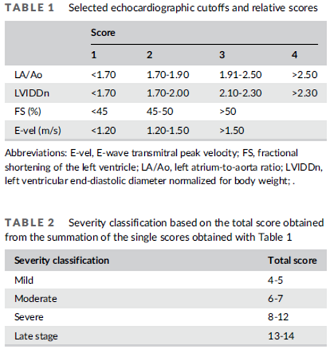 four echo measurements by the severity
of the class -- scores 1, 2, 3, and 4 -- based upon their own clinical
experiences. (See Table 1.) They then totaled each dog's scores for the
four echo measurements to arrive at a "severity classification" of mild
(total score 4-5), moderate (total score 6-7), severe (total score
8-12), and late stage (total score 13-14). (See Table 2.) The
researchers also categorized each dog according to the 2019 ACVIM
definitions of Stages B1, B2, C, and D. Based upon the dogs in the study, they calculated median survival
times for each of their proposed severity classes, as follows:
four echo measurements by the severity
of the class -- scores 1, 2, 3, and 4 -- based upon their own clinical
experiences. (See Table 1.) They then totaled each dog's scores for the
four echo measurements to arrive at a "severity classification" of mild
(total score 4-5), moderate (total score 6-7), severe (total score
8-12), and late stage (total score 13-14). (See Table 2.) The
researchers also categorized each dog according to the 2019 ACVIM
definitions of Stages B1, B2, C, and D. Based upon the dogs in the study, they calculated median survival
times for each of their proposed severity classes, as follows:
• mild: 2344 days (6.42 years)
• moderate: 1882 days (5.16 years)
• severe: 623 days (1.71 years)
• late stage: 157 days (o.43 years)
They found that a MINE score above 8 (the lowest total score for the "severe" classification) was predictive of MVD being the cause of the dog's death. They concluded:
"In conclusion, we have proposed the MINE score, which is an easy-to-use echocardiographic classification of severity of MMVD, proven to be clinically effective since it is associated with survival. This classification provides prognostic information and could be useful for an objective echocardiographic assessment of MMVD. The MINE score could also be useful in identifying asymptomatic dogs with higher risk of cardiac death."
 EDITOR'S NOTE: There is a wealth of commentary to be "MINED" from
this article.
EDITOR'S NOTE: There is a wealth of commentary to be "MINED" from
this article.
First, they point out a couple of the extremely dangerous fallacies surrounding use of the 2019 ACVIM Consensus Statement's re-definitions of Stages B1 and B2 of MVD. For example, the ACVIM's 2019 definition of Stage B2 requires that both the left atrium (LA) and the left ventricle (LV) exceed the ACVIM's minimum cutoffs of enlargement. In other words, according to the ACVIM's definition, an MVD-affected dog with a significantly enlarged LA but a normal-sized LV is a Stage B1 dog (and thereby not entitled to any pimobendan). The researchers of this study found that Stage B1 dogs they classified as having "moderate" degrees of mitral insufficiency (having a MINE score in the 6 to 7 range), with only LA enlargement and no LV enlargement, nevertheless showed a worse prognosis than their "mild" cases (in the 4-5 range).
To make matters worse, 12 of the dogs in this study, classified as Stage B1 because of no LV enlargement, were in the "severe" MINE class, thus crying out for daily doses of pimobendan, which the ACVIM nonetheless would coldly deny. These researchers thus inadvertently provide evidence that ACVIM's 2019 definitions can be life-threatening for some MVD-affected dogs. With classic researchers' understatement, they blandly suggest that, "Based on these considerations, further studies on the prognosis of B1 cases with different degrees of cardiac remodeling may be useful."
Also, they note another anomaly of the ACVIM's foolish 2019 definition of Stage B2:
"Dogs in stage B2 represent a heterogeneous group of animals, with some individuals presenting a slow progression of the disease and others rapidly developing CHF."
In other words: Some Stage B2 dogs would not need any pimobendan at all because, even though they may fall under the definition of Stage B2, their form of MVD is so slow to progress that they will never reach heart failure, even without medication.
Despite noting these failures of the 2019 ACVIM Consensus Statement, these researchers end up doing much the same thing when they devise their own arbitrary, species-wide echo cutoff scores. (See Table 1.) In fact, they even admit that the MINE system is arbitrary:
"Based on the authors' clinical experience, a scoring system was arbitrarily created, and 4 severity classes were defined."
These researchers seem to think that the major goal of cardiologists, when diagnosing MVD in dogs, is to avoid any procedures which either are "time-consuming" or "require multiple measurements". They also use the term "subjective assessment" as if it is vile. In the old days, before the 2016 EPIC Study dumbed down the definition of heart enlargement on a species-wide basis, "subjective assessment" of each patient on its own merits is what veterinary cardiologists were trained and, at a minimum, expected to do.
May 2021:
The Longitudinal Outcome Of Canine (K9) MVD registry (LOOK) baseline
results are in.
 In an
April 2021 article, a multi-specialty-center team of cardiologists
(Alessandra Franchini [right], Michele Borgarelli, Jonathan A. Abbott, Giulio
Menciotti, Serena Crosara, Jens Haggstrom, Sunshine Lahmers, Steven
Rosenthal, William Tyrrell) report the baseline results of their
three-year, 13 specialty center collection of veterinary examinations of
6,102 dogs of 190 breeds diagnosed with varying stages of myxomatous
mitral valve disease (MVD or MMVD). The cavalier King Charles spaniel
was the purebred breed with the largest number of patients -- 491 dogs
(8%).
In an
April 2021 article, a multi-specialty-center team of cardiologists
(Alessandra Franchini [right], Michele Borgarelli, Jonathan A. Abbott, Giulio
Menciotti, Serena Crosara, Jens Haggstrom, Sunshine Lahmers, Steven
Rosenthal, William Tyrrell) report the baseline results of their
three-year, 13 specialty center collection of veterinary examinations of
6,102 dogs of 190 breeds diagnosed with varying stages of myxomatous
mitral valve disease (MVD or MMVD). The cavalier King Charles spaniel
was the purebred breed with the largest number of patients -- 491 dogs
(8%).
They classified the degree of MVD in each dog using the 2019 ACVIM definitions of Stages B1 and B2, and the conventional definition of Stage C. Stage B2 was defined as evidence of both left atrial (LA) and left ventricular (LV) enlargement by a left atrium-to-aortic ratio (LA:Ao) > 1.6 and LV internal diameter normalized in diastole (LVIDd_N) > 1.7. Stage C was defined by clinical signs and/or radiographic evidence of congestive heart failure (CHF). Clinical signs of CHF included tachypnea (a resting respiratory rate greater than 36 breaths per minute), dyspnea (the appearance of difficult or labored breathing), and/or cough that resolved by normalization of the resting respiratory rate (RR) and respiratory efforts with normal medical treatment. They also compared x-rays and the vertebral heart scale (VHS) values of 1,666 of the dogs (28%) to the echo measurements to determine enlargement of the LA and/or LV. They made the following significant findings:
• Overall, CKCSs were younger than the other 19 most common breeds
• Among Stage C dogs, CKCSs were younger (median age: 9 years, range: 6-13 years)
• VHS values were positively associated with the stage of the disease
• 21% of dogs with LA:Ao > 1.6 and <2.0 and an LVIDd_N > 1.7 had a normal VHS value
• 14% of dogs with severe LA enlargement and an LVIDd_N > 1.7 had a normal VHS value
• Cardiomegaly was identified by VHS in 33% of the dogs with normal echo LA and LV dimensions
• 36% of all dogs had pulmonary hypertension (PH)
• 58% of dogs in Stage C had PH
• 9% of all dogs had arrhythmias
They concluded that:
"This study contributes to a better understanding of the clinical characteristics of dogs affected by MMVD and provides new findings that may be of clinical relevance."
 EDITOR'S NOTE: Unfortunately, this study proves the point that when
you start out with a bogus assumption, you end up with bogus results,
regardless of the accuracy of the underlying data. As we have pointed
out time and time again since the EPIC Study in 2016 and
the 2019 ACVIM
Consensus Statement, when you define left sided heart enlargement on a
species-wide basis by the arbitrary echo measurements of LA:Ao > 1.6 and
LVIDd_N > 1.7, you are going to get false findings, because some breeds
of dog can have enlargement with lower measurements and other breeds can
have normal-sized hearts with higher measurements.
EDITOR'S NOTE: Unfortunately, this study proves the point that when
you start out with a bogus assumption, you end up with bogus results,
regardless of the accuracy of the underlying data. As we have pointed
out time and time again since the EPIC Study in 2016 and
the 2019 ACVIM
Consensus Statement, when you define left sided heart enlargement on a
species-wide basis by the arbitrary echo measurements of LA:Ao > 1.6 and
LVIDd_N > 1.7, you are going to get false findings, because some breeds
of dog can have enlargement with lower measurements and other breeds can
have normal-sized hearts with higher measurements.
In this case, the researchers find that 33% to 35% of the time, VHS values taken off of x-rays did not coincide with the echo minimum measurements for LA and/or LV enlargement. As noted above, 35% (21% + 14%) of the dogs with LA and LV measurements above those bogus minimums had normal-sized VHS values. They also find that VHS identified enlargement in 33% of dogs which according to the echo definition, had normal-sized hearts. They go on to accuse the VHS values to be the culprits, when they conclude that:
"Our findings suggest that VHS might fail to identify the presence/absence of cardiomegaly, and additional data are needed to further evaluate specificity and sensitivity of the VHS in the detection of heart enlargement."
It apparently never occurred to them to question the obvious, glaring flaw, which is that there can be no accurate species-wide LA and LV cut-off measurements between normal and enlarged hearts. Several empirical studies already have shown that canine breeds are far too diverse for that possibility. In addition, they ignore the fact that the VHS method was designed to be used to compare different sets of x-rays of the same dog taken over time and not as a species-wide reference scale. As the VHS inventor, Dr. James Buchanan, carefully explained in his seminal article, "Vertebral scale system to measure canine heart size in radiographs":
"ln addition to initial assessment of heart size, the VHS method also is useful in monitoring the progression of heart enlargement over time in individuals. Recording the heart size in vertebral scale encourages objectivity and is a convenient way of recording changes in heart size in response to treatment or progression of cardiomegaly."
 A scary thing here is these researchers' conclusion -- "This study
contributes to a better understanding of the clinical characteristics of
dogs affected by MMVD and provides new findings that may be of clinical
relevance." Yikes! There should be absolutely NO clinical relevance to
findings based upon a bogus definition!
A scary thing here is these researchers' conclusion -- "This study
contributes to a better understanding of the clinical characteristics of
dogs affected by MMVD and provides new findings that may be of clinical
relevance." Yikes! There should be absolutely NO clinical relevance to
findings based upon a bogus definition!
April 2021: Japanese surgeons describe their "Japan Method" techniques of open-heart mitral valve surgeries in small dogs. In a March 2021 article, a team of Japanese heart surgeons (Isamu Kanemoto, Kippei Mihara, Keiichi Sato) describe their techniques for successful open-heart repairs to mitral valves in small dogs diagnosed with mitral valve disease. They describe their "Japan Method" as:
• low-flow cardiopulmonary bypass (CPB);
• deep surface-cooling hypothermia (sHT), subsequently replaced by blood-cooling hypothermia (bHT);
• a new, improved mitral valve plasty (MVP) applicable to severe mitral regurgitation (MR);
• artificial chordal reconstruction, semi-circular suture annuloplasty (AP);
• direct scallop-suture valvuloplasty.
They report that "these MVP techniques are simple, durable, and lead to good long-term quality of life in toy- and small-breed dogs." They have performed their techniques on 102 patients in their hospital between January and September 2020, with 98 dogs (96.1%) successfully discharged from the hosptial.
April 2021:
Cavaliers with shorter muzzles and barrel-shaped chests had more
severe forms of mitral valve disease, in Italian study.
 In an
April 2021 article, a team of Italian veterinary researchers (Mara
Bagardi [right], Sara Ghilardi, Chiara Locatelli, Arianna
Bionda, Michele Polli, Claudio M. Bussadori, Fabio M. Colombo, Laura
Pazzagli, Paola G. Brambilla) report examining 52 cavalier King Charles
spaniels, all diagnosed with asymptomatic mitral valve disease (MVD) but
no heart enlargement (Stage B1). In addition to performing
echocardiographic scans, they took morphometric measurements of each
dog's body, thorax (chest cavity), and head size to establish the
association with heart murmur intensity, valvular and annular
echocardiographic measurements, mitral valve prolapse (MVP) and mitral
valve regurgitant jet size. They found that the shorter the dog's head
length and muzzle length, the more severe was its mitral valve
regurgitant jet size. Also, they found that cavaliers with more a
pronounced head stop angle had a thicker anterior mitral valve leaflet.
They concluded that cavaliers with a brachycephalic morphotype are
associated with a more severe regurgitant jet size and with valvular
characteristics related to worse forms of MVD.
In an
April 2021 article, a team of Italian veterinary researchers (Mara
Bagardi [right], Sara Ghilardi, Chiara Locatelli, Arianna
Bionda, Michele Polli, Claudio M. Bussadori, Fabio M. Colombo, Laura
Pazzagli, Paola G. Brambilla) report examining 52 cavalier King Charles
spaniels, all diagnosed with asymptomatic mitral valve disease (MVD) but
no heart enlargement (Stage B1). In addition to performing
echocardiographic scans, they took morphometric measurements of each
dog's body, thorax (chest cavity), and head size to establish the
association with heart murmur intensity, valvular and annular
echocardiographic measurements, mitral valve prolapse (MVP) and mitral
valve regurgitant jet size. They found that the shorter the dog's head
length and muzzle length, the more severe was its mitral valve
regurgitant jet size. Also, they found that cavaliers with more a
pronounced head stop angle had a thicker anterior mitral valve leaflet.
They concluded that cavaliers with a brachycephalic morphotype are
associated with a more severe regurgitant jet size and with valvular
characteristics related to worse forms of MVD.
EDITOR'S NOTE: This could be a ground-breaking initial study into the relationship between the cavalier's body shape and the severity of its MVD. Obviously more thorough studies need to be conducted with more CKCSs of various types, but this study pinpoints the direction in which future such studies should be directed.
Unfortunately, the researchers fell for the flat lie that any cavaliers with left atrial-to-aortic ratios (LA/Ao) less than 1.6 by definition do not have any enlargement of their left atriums (LA). We know that is patently false because of two prior published studies. No published studies support that definition. A 2014 study of 134 cavaliers with healthy hearts showed a LA/Ao range from 0.47 to 0.94 (instead of up to 1.6). One study of 166 cavaliers found that the upper limit of a normal-sized left atrium was 1.27 (instead of 1.6); and another study of 79 cavaliers found that MVD-affected cavaliers with LA/Ao as low as 1.43 had both enlarged LAs and had clinical signs of heart failure. It is not clear what, if any, effect this mis-guided reliance upon the LA/Ao = 1.6 cutoff has on the results, but the fact these researchers used this totally fabricated and bogus definition is another example of how stupidly dangerous are the ACVIM's 2019 Consensus Statement's definitions of Stage B1 and Stage B2.
April 2021:
Study of 259 MVD-affected dogs in heart failure shows
that increase in LA/Ao ratio and severity of pulmonary hypertension are
risk factors of cardiac death.
 In a
March 2021 article, a team of Italian cardiology investigators
(Mara Bagardi [right], C. Locatelli, A. Zanaboni, A. Galizzi,
D. Malchiodi, P. G. Brambilla) reviewed the medical records of 259 dogs
diagnosed with mitral valve disease (MVD) and in heart failure over a
period from 2001 to 2018 at the University of Milan's veterinary
cardiology unit. Their aim was to evaluate the mean survival time (MST)
of MVD-affected dogs from the point they were diagnosed to be in heart
failure. The cavalier King Charles spaniel was the only breed excluded
from the study. Among the findings were that the range of LA/Ao ratio at
the time of diagnosis of heart failure was from a minimum of 1.30 to a
maximum of 4.40. They report finding that only LA/Ao led to a
significant difference in MST, and that the severity of pulmonary
hypertension was a risk factor for cardiac-related death.
In a
March 2021 article, a team of Italian cardiology investigators
(Mara Bagardi [right], C. Locatelli, A. Zanaboni, A. Galizzi,
D. Malchiodi, P. G. Brambilla) reviewed the medical records of 259 dogs
diagnosed with mitral valve disease (MVD) and in heart failure over a
period from 2001 to 2018 at the University of Milan's veterinary
cardiology unit. Their aim was to evaluate the mean survival time (MST)
of MVD-affected dogs from the point they were diagnosed to be in heart
failure. The cavalier King Charles spaniel was the only breed excluded
from the study. Among the findings were that the range of LA/Ao ratio at
the time of diagnosis of heart failure was from a minimum of 1.30 to a
maximum of 4.40. They report finding that only LA/Ao led to a
significant difference in MST, and that the severity of pulmonary
hypertension was a risk factor for cardiac-related death.
EDITOR'S NOTE: Here we have a study of 259 MVD-affected dogs in heart failure, and at least one of them had a LA/Ao ratio as low as 1.30. So this dog (or these dogs) not only had an enlarged left atrium, but already was in heart failure. And yet, the 2019 ACVIM Consensus Statement's species-wide definition of left atrium enlargement is that the dog's LA/Ao must be no lower than 1.6, and if it is lower, then any medical treatment of that dog's heart is forbidden! This is more evidence that the ACVIM's 2019 Consensus Statement is based upon total nonsense and should be withdrawn.
April 2021:
Computed tomography confirms that left atrial enlargement causes
coughing due to resulting bronchial narrowing.
 In an
April 2021 article, a team of French and US investigators (Matthieu
Lebastard, Kevin Le Boedec [right], Mark Howes, Stephen Joslyn, Jodi S.
Matheson, Robert T. O'Brien) used computed tomography (CT) to study the
association between left atrium enlargement causing bronchial narrowing
in 21 coughing dogs (2 cavaliers -- 9,5%) diagnosed with heart murmurs
due to mitral valve disease (MVD). They measured each dog using chest
x-rays, echocardiography, and chest CT scans. They calculated bronchial
narrowing using the bronchial-to-aorta ratio. They report finding
"significant narrowing" of the bronchi in the coughing dogs, compared to
10 control group non-coughing, healthy dogs. They noted that as the left
atrium size (LA/Ao) and vertebral heart size (VHS) increased, the
diameter of all left-sided and most right-sided bronchi decreased. The
LA/Ao range was from 1.5 to 3.5, and three dogs (14%) had a LA/Ao ratio
below 1.6. They were 2 chihuahuas and one basenji.
In an
April 2021 article, a team of French and US investigators (Matthieu
Lebastard, Kevin Le Boedec [right], Mark Howes, Stephen Joslyn, Jodi S.
Matheson, Robert T. O'Brien) used computed tomography (CT) to study the
association between left atrium enlargement causing bronchial narrowing
in 21 coughing dogs (2 cavaliers -- 9,5%) diagnosed with heart murmurs
due to mitral valve disease (MVD). They measured each dog using chest
x-rays, echocardiography, and chest CT scans. They calculated bronchial
narrowing using the bronchial-to-aorta ratio. They report finding
"significant narrowing" of the bronchi in the coughing dogs, compared to
10 control group non-coughing, healthy dogs. They noted that as the left
atrium size (LA/Ao) and vertebral heart size (VHS) increased, the
diameter of all left-sided and most right-sided bronchi decreased. The
LA/Ao range was from 1.5 to 3.5, and three dogs (14%) had a LA/Ao ratio
below 1.6. They were 2 chihuahuas and one basenji.
EDITOR'S NOTE: No surprise here, but using CT scans to observe that the enlarged left atrium (LA) is the cause of narrowed bronchi confirms that the coughing in MVD-affected dogs is due either to the LA pressing against the brochi as the LA enlarges, or to an independent cause, such as bronchomalacia and airway inflammation, or a combination of those two disorders. An important point here is that coughing does not indicate lung congestion due to heart failure. Instead, the coughing is due to LA enlargement squeezing the bronchi.
March 2021:
Radiographic left atrial dimension (RLAD) has low degree of
correlation with echocardiographic left atrial ratios.
 In
a
March 2021 article, Bulgarian veterinary cardiologist Atanas Pankov
(right) compared the relatively new x-ray method of measuring
the size of the left atrium -- radiographic left atrial dimension (RLAD)
-- and the echocardiographic measurements of left atrial size (LA/Ao
ratio) and ldft ventricle size (LVD-d/Ao ratio). He explains that the
RLAD measures the degree of "bulging" of the left atrium (LA) and
thereby provides information about the size of the LA in addition to the
VHS (vertebral heart score) measurement. Only 18 dogs, all of small
breeds and diagnosed with mitral valve disease (MVD) were included in
the study. Dr. Pankov reports finding that his analysis "showed a low
degree of correlation between the radiographic size RLAD and the two
echocardiograpic sizes. He acknowleges that "the lack of reliability"
for the results is due to the small number of dogs in the study. In his
conclusion he recommends that in MVD-affected dogs with pulmonary edema,
a more radiographically distinct dorsal border for the RLAD size.
In
a
March 2021 article, Bulgarian veterinary cardiologist Atanas Pankov
(right) compared the relatively new x-ray method of measuring
the size of the left atrium -- radiographic left atrial dimension (RLAD)
-- and the echocardiographic measurements of left atrial size (LA/Ao
ratio) and ldft ventricle size (LVD-d/Ao ratio). He explains that the
RLAD measures the degree of "bulging" of the left atrium (LA) and
thereby provides information about the size of the LA in addition to the
VHS (vertebral heart score) measurement. Only 18 dogs, all of small
breeds and diagnosed with mitral valve disease (MVD) were included in
the study. Dr. Pankov reports finding that his analysis "showed a low
degree of correlation between the radiographic size RLAD and the two
echocardiograpic sizes. He acknowleges that "the lack of reliability"
for the results is due to the small number of dogs in the study. In his
conclusion he recommends that in MVD-affected dogs with pulmonary edema,
a more radiographically distinct dorsal border for the RLAD size.
March 2021:
Coenzyme Q10 study of MVD-dogs in heart failure shows 200 mg
daily is sufficient to reach a 3-fold increase in plasma CoQ10.
 In
an
April 2021 article, a team of researchers from Slovenia (Natalia
Druzhaeva, Aleksandra Domanjko Petric, Gabrijela Tavcar-Kalcher, Janja
Babic, Alenka Nemec Svete [right]) tested 18 dogs in heart
failure due to mitral valve disease (MVD), including one cavalier
King Charles spaniel, and 12 healthy dogs in the placebo group, to
determine the dose of coenzyme Q10 needed to reach a 3-fold increase in
plasma CoQ10 concentration in the MVD-affected dogs. The dogs were given
daily doses of either 50 mg or 100 mg of ubiquinone twice a day for two
weeks and had their plasma CoQ10 concentrations measured at various
times. They found that the change in plasma CoQ10 concentration after
supplementation began was significantly higher than in the placebo group
at 4 hours and 1 and 2 weeks for dogs in the 200-mg group and at 1 and 2
weeks for dogs in the 100-mg group. They concluded that a daily CoQ10
dose of 200 mg was sufficient to achieve at least a 3-fold increase in
plasma CoQ10 concentration and may be used in CoQ10 supplementation
studies involving dogs with CHF due to MMVD.
In
an
April 2021 article, a team of researchers from Slovenia (Natalia
Druzhaeva, Aleksandra Domanjko Petric, Gabrijela Tavcar-Kalcher, Janja
Babic, Alenka Nemec Svete [right]) tested 18 dogs in heart
failure due to mitral valve disease (MVD), including one cavalier
King Charles spaniel, and 12 healthy dogs in the placebo group, to
determine the dose of coenzyme Q10 needed to reach a 3-fold increase in
plasma CoQ10 concentration in the MVD-affected dogs. The dogs were given
daily doses of either 50 mg or 100 mg of ubiquinone twice a day for two
weeks and had their plasma CoQ10 concentrations measured at various
times. They found that the change in plasma CoQ10 concentration after
supplementation began was significantly higher than in the placebo group
at 4 hours and 1 and 2 weeks for dogs in the 200-mg group and at 1 and 2
weeks for dogs in the 100-mg group. They concluded that a daily CoQ10
dose of 200 mg was sufficient to achieve at least a 3-fold increase in
plasma CoQ10 concentration and may be used in CoQ10 supplementation
studies involving dogs with CHF due to MMVD.
March 2021:
Nearly 45% of 126 MVD-affected UK cavaliers 8 years and over did
not have heart enlargement.
 In a
March 2021 article, a multi-national team of investigators (Jorge
Prieto Ramos, Andrea Corda, Simon Swift, Laura Sader, Gabriel De La
Fuente Oliver, Brendan Corcoran, Kim M. Summers, Anne T. French
[right])
examined 126 cavalier King Charles spaniels 8 years of age and older,
all of which were owned by UK breeders and pet owners. Their aim was to
estimate the prevalence and the degree of heart enlargement associated
with mitral valve disease (MVD or MMVD) and determine whether there is
an effect of age, gender, and body weight (BW) on echocardiographic
status. They defined an enlarged left atrium (LA) as LA/Ao > 1.6 and an
enlarged left ventricle (LV) as LVIDdN >1.73. Their findings:
In a
March 2021 article, a multi-national team of investigators (Jorge
Prieto Ramos, Andrea Corda, Simon Swift, Laura Sader, Gabriel De La
Fuente Oliver, Brendan Corcoran, Kim M. Summers, Anne T. French
[right])
examined 126 cavalier King Charles spaniels 8 years of age and older,
all of which were owned by UK breeders and pet owners. Their aim was to
estimate the prevalence and the degree of heart enlargement associated
with mitral valve disease (MVD or MMVD) and determine whether there is
an effect of age, gender, and body weight (BW) on echocardiographic
status. They defined an enlarged left atrium (LA) as LA/Ao > 1.6 and an
enlarged left ventricle (LV) as LVIDdN >1.73. Their findings:
• All 126 (100%) cavaliers had mitral regurgitation (MR)
• 112 (89%) had mitral valve murmurs
• 123 (98%) had both MR and tricuspid regurgitation (TR)
• 111 (88%) had mitral valve prolapse
• 70 (55.6%) had cardiac enlargement
• 56 (44.4%) had heart chamber sizes within normal limits (as "normal" was defined)
• 9 (16%) of those 56 dogs did not have a murmur
They concluded that, despite all of these cavaliers having mitral regurgitation (and thus had MVD), a large percentage (44.4%) lacked any heart enlargement. They speculated that:
"This could be because the form of MMVD affecting CKCS at a young age, for which strong heritability has been demonstrated, is more aggressive and leads to death in young subjects, while a sub-cohort of dogs are affected by milder disease, more similar to that affecting all elderly dogs regardless of breed, which allows them to live longer."
 EDITOR'S NOTE: Unfortunately, the conclusions of this article are not
credible, because the authors' definition of heart enlargement is not
based upon any scientific evidence and, amazingly, actually contradicts
the express scientific findings of three prior studies: A
2014 study of 134 cavaliers with
healthy hearts showed a LA/Ao range from 0.47 to 0.94 (instead of up to
1.6).
One study of 166 cavaliers, in which the upper limit of a
normal-sized left atrium was 1.27 (instead of 1.6); and
another prior study of 79 cavaliers in which MVD-affected cavaliers
with clinical signs of heart failure had LA/Ao as low as 1.43. Oddly enough,
the authors of this present study actually cited both of these prior
CKCS-only papers but completely ignored their findings which contradict
the present authors' arbitrary definition of cavaliers with enlarged
hearts. We say "arbitrary" because the only authority given to justify
this bogus definition is the
2019 ACVIM Consensus Statement in which
LA/Ao >1.6 is the arbitrary, species-wide definition of an enlarged left
atrium.
EDITOR'S NOTE: Unfortunately, the conclusions of this article are not
credible, because the authors' definition of heart enlargement is not
based upon any scientific evidence and, amazingly, actually contradicts
the express scientific findings of three prior studies: A
2014 study of 134 cavaliers with
healthy hearts showed a LA/Ao range from 0.47 to 0.94 (instead of up to
1.6).
One study of 166 cavaliers, in which the upper limit of a
normal-sized left atrium was 1.27 (instead of 1.6); and
another prior study of 79 cavaliers in which MVD-affected cavaliers
with clinical signs of heart failure had LA/Ao as low as 1.43. Oddly enough,
the authors of this present study actually cited both of these prior
CKCS-only papers but completely ignored their findings which contradict
the present authors' arbitrary definition of cavaliers with enlarged
hearts. We say "arbitrary" because the only authority given to justify
this bogus definition is the
2019 ACVIM Consensus Statement in which
LA/Ao >1.6 is the arbitrary, species-wide definition of an enlarged left
atrium.
So, what does this mean? It means that this study's main finding -- that 56 (44.4%) of the MVD-affected cavaliers had normal-sized hearts -- is baseless, because the authors did not select a realistic minimum dimension to define enlarged hearts. Also, they supply no patient-specific data from which we may determine how many of those 56 cavaliers actually did have heart enlargement but with LA/Ao ratios below 1.6, say like from the scientifically determined range of 1.28 to 1.59.
And one other inconsistency: The authors seem to believe that coughing is a "clinical sign" of MVD, meaning an indication that the coughing dog has not only an enlarged heart but also is in heart failure. They concede that 3 of the cavaliers with so-called normal-sized hearts also showed the clinical sign of coughing. So, here we have evidence in their own report that cavaliers allegedly with normal-sized hearts have clinical signs of heart failure. Go figure!
March 2021:
Echocardiographic estimates of pulmonary artery pressure in
MVD-affected dogs are found inaccurate in a USA study.
 In a
March 2021 article, a team of veterinary cardiologists at
Virginia-Maryland College of Veterinary Medicine (Giulio Menciotti
[right], Jonathan A. Abbott, Michael Aherne, Sunshine M. Lahmers,
Michele Borgarelli) compared measurements of pulmonary artery pressure
taken by Doppler echocardiography with the "reference standard" method
for evaluation of PAP, which is right heart catheterization (RHC) and
direct measurement of PAP. The RHC technique requires special equipment,
is invasive, it often necessitates sedation or general anesthesia, and
can be very time consuming. Therefore, diagnosis of PHT usually is
estimated from Doppler findings, mainly the velocities of tricuspid
regurgitation (TR) or pulmonary valve insufficiency. Twenty MVD-affected
dogs were examined, all of which had some degree of TR and were in
either Stage B2 or Stage C. The investigators concluded:
In a
March 2021 article, a team of veterinary cardiologists at
Virginia-Maryland College of Veterinary Medicine (Giulio Menciotti
[right], Jonathan A. Abbott, Michael Aherne, Sunshine M. Lahmers,
Michele Borgarelli) compared measurements of pulmonary artery pressure
taken by Doppler echocardiography with the "reference standard" method
for evaluation of PAP, which is right heart catheterization (RHC) and
direct measurement of PAP. The RHC technique requires special equipment,
is invasive, it often necessitates sedation or general anesthesia, and
can be very time consuming. Therefore, diagnosis of PHT usually is
estimated from Doppler findings, mainly the velocities of tricuspid
regurgitation (TR) or pulmonary valve insufficiency. Twenty MVD-affected
dogs were examined, all of which had some degree of TR and were in
either Stage B2 or Stage C. The investigators concluded:
"In conclusion, this study showed that Doppler echocardiographic estimates of PAP are inaccurate and limits of agreement are widely separated when compared to invasively measured PAP in dogs affected by MMVD ACVIM stage B2 and C stable in their treatment regimen. This study supports the recommendations provided in the most recent guidelines published in veterinary and human medicine, in which it is specified that a non-invasive diagnosis of PHT should not rely merely on TR velocities. Furthermore, a common sedation protocol used for patients with cardiac disease significantly reduces Doppler estimates of PAP, therefore the effect of sedation on this variable should be taken into account when performing clinical evaluations."
 EDITOR'S NOTE: This article emphasizes a "Catch 22" dilemma for
cardiologists attempting to accurately measure pulmonary hypertension in
MVD-affected dogs. Pulmonary hypertension is a very important piece of
information in dogs approaching or already in heart failure because it
has been found to be a predictor of the progression and severity of the
disease. The problem is two-fold. First, the "gold standard" (which in
this article is called the "reference standard") for measuring pulmonary
artery pressure (PAP) is an invasive procedure requiring at least
sedation if not anesthesia, because a catheter must be inserted into a
jugular vein and then extended to the main pulmonary artery. To avoid
this complicated procedure, cardiologists have been estimating the dog's
PAP by Doppler echocardiography measurements of the velocity of
tricuspid regurgitation (TR). In this study, the investigators not only found that the echo
measurements either significantly over-estimated or under-estimated the
PAP determined by catheterization, but also that echos of sedated dogs
"significantly reduce Doppler estimates of PAP".
EDITOR'S NOTE: This article emphasizes a "Catch 22" dilemma for
cardiologists attempting to accurately measure pulmonary hypertension in
MVD-affected dogs. Pulmonary hypertension is a very important piece of
information in dogs approaching or already in heart failure because it
has been found to be a predictor of the progression and severity of the
disease. The problem is two-fold. First, the "gold standard" (which in
this article is called the "reference standard") for measuring pulmonary
artery pressure (PAP) is an invasive procedure requiring at least
sedation if not anesthesia, because a catheter must be inserted into a
jugular vein and then extended to the main pulmonary artery. To avoid
this complicated procedure, cardiologists have been estimating the dog's
PAP by Doppler echocardiography measurements of the velocity of
tricuspid regurgitation (TR). In this study, the investigators not only found that the echo
measurements either significantly over-estimated or under-estimated the
PAP determined by catheterization, but also that echos of sedated dogs
"significantly reduce Doppler estimates of PAP".
Another very interesting piece of information garnered from this study is how the investigators defined Stage B2. They start out by stating, "Stage B2 was defined as echocardiographic evidence of left atrial and left ventricular enlargement in absence of clinical signs or pulmonary infiltrates compatible with congestive heart failure." That sounds promising because it would appear that they based their determination of "enlargement" upon some actual evidence, like the shape of the heart and a comparison of each dog's heart before any enlargement was known to occur and more currently. Unfortunately, that is not what they did. Instead of any evidence at all, for left atrial enlargement they arbitrarily chose a species-wide left atrial diameter to aortic root diameter of greater than 1.5 (LA/Ao >1.5). This varies from the arbitrary species-wide LA/Ao > 1.6 definition used in the 2016 EPIC Study and the 2019 ACVIM Consensus Statement. But nonetheless, it is just as arbitrary. They fail to cite any veterinary literature to support such a definition, and the fact is that they cannot, because none exists. One published article to the contrary is this one of Dachshunds, in which dogs with normal-sized left atriums had LA/Ao ratios as high as 1.65. Since a Dachshund was one of the 20 dogs in this present study, that dog alone should disqualify the value of the species-wide definition of left atrial enlargement of only 1.5.
Their definition of enlargement of the left ventricle is a bit more interesting but just as arbitrary. The EPIC Study and the 2019 ACVIM Consensus Statement use "left ventricular internal diameter in diastole, normalized for body weight (LVIDDN) >1.7" as their species-wide definition. The investigators in this current study ignored that measurement and instead defined left ventricular enlargement as "M-Mode derived left ventricular end-diastolic diameter exceeding the 97.5 percentile of the prediction interval based on allometric scaling of the measurement." Again, they provided no citations of authority for such a species-wide definition. So, we really do not know if any of the dogs they classified as being in Stage B2 really did have any enlargement of either their left atrium or left ventricle. All we know for sure about the "Stage B2" category of these dogs is that they all had some degree of mitral regurgitation.
March 2021:
USA cardiologists reduce left atrial pressure in MVD-affected
dogs by creating intentional atrial septal defects.
 In a
March 2021 article, a team of cardiologists at VCA West Los Angeles
Animal Hospital (Justin W. Allen [right], Kevin L. Phipps, Anthony A. Llamas,
Kirstie A. Barrett) report the successful "immediate and substantial
reduction in LAP" (left atrial pressure) in 17 dogs (including 3
[17.65%] cavalier King Charles spaniels) with advanced congestive heart
failure due to mitral valve disease (MVD), but creating an intentional
hole between the left atrium (LA) and the right atrium (RA), to allow
blood in the LA to flow directly into the RA to relieve pressure in the
LA. This procedure is called creating a "iatrogenic atrial septal
defect", meaning an intentional one, and also is generally described as
"left atrial decompression" (LAD). Atrial septal defects (ASDs) occur
naturally in some dogs and usually require surgery to correct. An ASD is
a hole directly between the left and right atriums, and naturally-formed
ASDs interfere with the proper flow of blood through the heart.
In a
March 2021 article, a team of cardiologists at VCA West Los Angeles
Animal Hospital (Justin W. Allen [right], Kevin L. Phipps, Anthony A. Llamas,
Kirstie A. Barrett) report the successful "immediate and substantial
reduction in LAP" (left atrial pressure) in 17 dogs (including 3
[17.65%] cavalier King Charles spaniels) with advanced congestive heart
failure due to mitral valve disease (MVD), but creating an intentional
hole between the left atrium (LA) and the right atrium (RA), to allow
blood in the LA to flow directly into the RA to relieve pressure in the
LA. This procedure is called creating a "iatrogenic atrial septal
defect", meaning an intentional one, and also is generally described as
"left atrial decompression" (LAD). Atrial septal defects (ASDs) occur
naturally in some dogs and usually require surgery to correct. An ASD is
a hole directly between the left and right atriums, and naturally-formed
ASDs interfere with the proper flow of blood through the heart.
Advanced MVD includes increased pressure in the LA, due to the backflow of blood through the mitral valve and causing the walls of the LA to enlarge. High left atrial pressure (LAP) is a precursor to congestive heart failure (CHF) and persists following the onset of CHF. The 17 dogs described in this article all were in late Stage C or in Stage D of MVD, as they were not responding satisfactorily to cardiac medications. The LAD procedure involved inserting a needle through the chest wall and into a vein to the wall between the RA and the LA, and then inserting the needle into that wall to make a small hole -- usually 3 or more mm. -- to allow the more highly pressurized blood in the LA to flow directly into the RA and thereby relieve the overall pressure in the LA. The investigators report that the "LAD resulted in a substantial and clinically relevant drop in LAP in all dogs that underwent the procedure." There were complications of the procedure, including deaths shortly afterwards in some cases, all of which were predictable due to the advanced MVD of the patients. Nevertheless, they concluded:
"In conclusion, LAD was a feasible procedure in patients of the present study with advanced MMVD and left-sided CHF and resulted in a substantial and clinically important reduction in LAP. In affected dogs, the LAD procedure may translate into improved patient quality of life and survival time, though this remains unknown. Complications were frequent but were manageable or preventable in most cases. Left atrial decompression can be performed in most catheterization laboratories with standard equipment, although a learning curve exists regarding location of the iASD and in minimizing complications. On the basis of findings of the present report, procedural success can be expected to improve with experience."
March 2021:
Chinese veterinary surgeons successfully implant an
edge-to-edge transcatheter device (ValveClamp) in the mitral valves of 8
MVD-affected dogs.
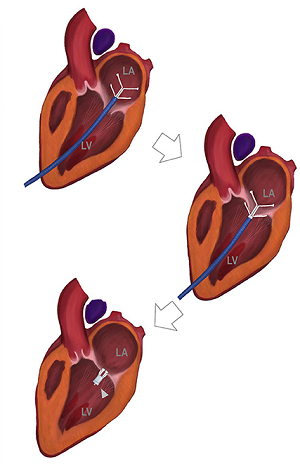 In a
December 2020 article, a team of Chinese veterinary surgeons
report the successful preliminary outcomes in the surgical implantation
of an edge-to-edge transcatheter device which they clamped on the mitral
valves of eight dogs to control regurgitation. [See diagram at
right.] All eight dogs had Stage
B1 mitral valve disease. The procedure required anesthesia but not
cardiopulmonary bypass. All reportedly survived without complications.
Echocardiography revealed a significant reduction in mitral
regurgitation severity in all dogs following the procedure based on both
a reduced mitral regurgitant maximum jet area and a reduced mitral
regurgitant maximum jet area to left atrial area. No major complications
had been reported in any of the dogs during the follow-up periods of a
range from 100 to 141 days. They concluded:
In a
December 2020 article, a team of Chinese veterinary surgeons
report the successful preliminary outcomes in the surgical implantation
of an edge-to-edge transcatheter device which they clamped on the mitral
valves of eight dogs to control regurgitation. [See diagram at
right.] All eight dogs had Stage
B1 mitral valve disease. The procedure required anesthesia but not
cardiopulmonary bypass. All reportedly survived without complications.
Echocardiography revealed a significant reduction in mitral
regurgitation severity in all dogs following the procedure based on both
a reduced mitral regurgitant maximum jet area and a reduced mitral
regurgitant maximum jet area to left atrial area. No major complications
had been reported in any of the dogs during the follow-up periods of a
range from 100 to 141 days. They concluded:
"[T]he dogs included in this study were limited to dogs with mitral regurgitation but no clinical signs and minimal, if any, chamber enlargement (stage B1 MMVD). The efficacy of this device still needs to be further tested on patients with varying stages of MMVD. ... In conclusion, the edge-to-edge valve closure using the ValveClamp mitral valve system is easy to perform and is highly effective at reducing the severity of mitral regurgitation. The system has good potential to be used in clinical practice on canine MMVD patients, although more data needs to be collected to prove its long-term safety and efficacy."
March 2021:
German cardiologists recommend species-wide reference intervals
for normal-sized left ventricle volumes using Simpson's method.
 In a
March 2021 article, a team of German cardiology investigators
(Gerhard Wess [right], Alexander Bauer, Antonia Kopp) applied
the Simpson's method
of discs (SMOD), a linear method of estimating the volume of the
left ventricle (LV) by dividing it's measurements into equally sized
ellipical discs, in measuring the LVs of 1,331 dogs of 128 breeds,
including 16 (0.01%) cavalier King Charles spaniels. They produced a
single set of reference intervals (the range from the lowest to the
highest measurements) for healthy LVs in non-sighthound breeds (see
Table 4, below). They conclude:
In a
March 2021 article, a team of German cardiology investigators
(Gerhard Wess [right], Alexander Bauer, Antonia Kopp) applied
the Simpson's method
of discs (SMOD), a linear method of estimating the volume of the
left ventricle (LV) by dividing it's measurements into equally sized
ellipical discs, in measuring the LVs of 1,331 dogs of 128 breeds,
including 16 (0.01%) cavalier King Charles spaniels. They produced a
single set of reference intervals (the range from the lowest to the
highest measurements) for healthy LVs in non-sighthound breeds (see
Table 4, below). They conclude:
"Our study provides echocardiographic RIs [reference intervals] for SMOD, independent of breed and size and might enable veterinary cardiologist to use this method for all dogs, using the PLAX [parasternal long axis] or A4C view {apical 4-chamber view] or both."
Notwithstanding their advice to use their reference intervals, they also state:
"Veterinary cardiologists face the problem of dealing with many different breeds and therefore a wide range of different body and BWs [body weights]. To diagnose cardiac enlargement or, less commonly, to evaluate if a heart is volume underloaded, it is necessary to compare the obtained measurements to RIs. The optimal situation would be to have breed-specific RIs, generated from a large healthy population."
and
"Breed-specific RIs still are important for selected breeds, but the numbers of individuals in our study were not high enough to establish such RIs."
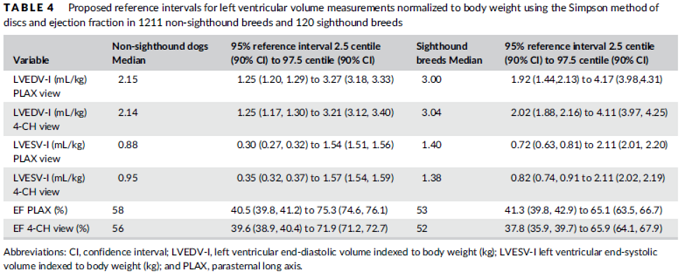
 EDITOR'S NOTE: Oh, boy! This is a two-fold shocker. The first shock
is that it slams the use of the current species-wide cut-point between
normal and enlarged left ventricles, as recommended by
the ACVIM's 2019
Consensus Statement and one-third of the
EPIC Study's bogus "definition" of an enlarged heart (which is: LVIDDN = 1.7). The other shock is that,
while it recommends using the reference intervals in its Table 4 for all
dog breeds, it confesses that breed-specific reference intervals are
"optimal" and "still are important".
EDITOR'S NOTE: Oh, boy! This is a two-fold shocker. The first shock
is that it slams the use of the current species-wide cut-point between
normal and enlarged left ventricles, as recommended by
the ACVIM's 2019
Consensus Statement and one-third of the
EPIC Study's bogus "definition" of an enlarged heart (which is: LVIDDN = 1.7). The other shock is that,
while it recommends using the reference intervals in its Table 4 for all
dog breeds, it confesses that breed-specific reference intervals are
"optimal" and "still are important".
So, what are we to expect now from our MVD-affected cavaliers' cardiologists? Are they going to switch from the species-wide LVIDDN = 1.7 cut-off to the new species-wide Simpson method? Or, are they going to behave like professional adults and accurately determine if our dogs' left ventricles are enlarged or not using the gold standard of comparing baseline and follow-up echo or x-ray measurements of the same dog's left ventricle, along with judging from the shape of the heart on the x-rays? Jumping from one species-wide set of measurements to an allegedly more accurate species-wide set of measurements is a sad, cruel joke being played upon our dogs. And this hand-wringing comment is the most pathetic one ever:
"Veterinary cardiologists face the problem of dealing with many different breeds and therefore a wide range of different body and BWs [body weights]. To diagnose cardiac enlargement or, less commonly, to evaluate if a heart is volume underloaded, it is necessary to compare the obtained measurements to RIs."
 Oh, boo-hoo!
Pull out the smelling salts! You cardiologists have absolutely
NO need whatsover "to
compare the obtained measurements to RIs." That is an irresponsible
cop-out from acting like professional clinicans you are supposed to be.
When you compare the cavalier on your table to a set of species-wide
reference intervals calculated using only 0.01% cavaliers out of 128
breeds, you are abrogating your professional obligation to focus on and
properly diagnose your patient.
Oh, boo-hoo!
Pull out the smelling salts! You cardiologists have absolutely
NO need whatsover "to
compare the obtained measurements to RIs." That is an irresponsible
cop-out from acting like professional clinicans you are supposed to be.
When you compare the cavalier on your table to a set of species-wide
reference intervals calculated using only 0.01% cavaliers out of 128
breeds, you are abrogating your professional obligation to focus on and
properly diagnose your patient.
March 2021:
Cavaliers are the most common breed in Boehringer
Ingelheim-funded attempt to create a cardiac biomarker concentration
model for diagnosing MVD-dogs in Stage B2.
 In a
March 2021 article, an international team of veterinary
cardiologists (Jenny Wilshaw [right], Steven L. Rosenthal,
Gerhard Wess, Dave Dickson, Luca Bevilacqua, Emily Dutton, Michael
Deinert, Rcardo Abrantes, Ingo Schneider, Mark A. Oyama, Sonya G.
Gordon, Jonathan Elliott, Dong Xia, Adrian Boswood) examined 1,887 dogs
diagnosed with mitral valve disease (MVD), including 478 (25.33%)
cavalier King Charles spaniels, the most common breed. The study, called
HAMLET, was funded by Boehringer Ingelheim Animal Health GmbH (maker of
Vetmedin) and also was supported by IDEXX (providing blood test results) and
the Royal Veterinary College.
In a
March 2021 article, an international team of veterinary
cardiologists (Jenny Wilshaw [right], Steven L. Rosenthal,
Gerhard Wess, Dave Dickson, Luca Bevilacqua, Emily Dutton, Michael
Deinert, Rcardo Abrantes, Ingo Schneider, Mark A. Oyama, Sonya G.
Gordon, Jonathan Elliott, Dong Xia, Adrian Boswood) examined 1,887 dogs
diagnosed with mitral valve disease (MVD), including 478 (25.33%)
cavalier King Charles spaniels, the most common breed. The study, called
HAMLET, was funded by Boehringer Ingelheim Animal Health GmbH (maker of
Vetmedin) and also was supported by IDEXX (providing blood test results) and
the Royal Veterinary College.
All of the dogs were in the "pre-clinical" phase of MVD, meaning that none of them had been in heart failure at the time of diagnosis. In addition to the normal physical examinations of the dogs, each was echocardio-graphically scanned for its left-atrial-aortic diameter ratio (LA/Ao) and its left ventricular internal diameter at end diastole normalized to bodyweight (LVIDDN), and a blood sample was taken to include creatinine and amino terminal pro-B-type natriuretic peptide (NT-proBNP) concentrations. The study's aim was to determine whether data from readily accessible tests (such as age, appetite, body condition, murmur intensity, and blood test results) could differentiate between MVD-dogs echocardiographically diagnosed to be in Stages B1 and B2. Stage B2 was defined as an LA:Ao >1.6 and LVIDDN >1.7. Dogs that did not meet both of these criteria were classified as stage B1. Thus, Stage B1 dogs included those with the mildest of mitral murmurs to those with the most severe enlargement of only one of the two left-side heart chambers -- either the left atrium or the left ventricle but not both -- meeting the minimum measurements for the study's definition of Stage B2. The article did not provide a breakdown of the degrees of severity of MVD among the Stage B1 dogs. Of the 1,887 MVD-affected dogs, all 361 (19.13%) of those which had been treated with pimobendan were excluded from the final results of the study. Of those 361 excluded dogs, 157 were in Stage B1 and 204 were in Stage B2. The article also did not provide a breakdown of the degrees of severity of Stage B1 dogs receiving pimobendan medication. Of the remaining 1,245 dogs, 292 (27.07%) were cavaliers.
The investigators report: "Our study found that clinical observations and cardiac biomarker concentrations can be used to differentiate between dogs in stages B1 and B2." They concluded:
"This study found that variables from different aspects of a dog's examination could be used in combination to assess the likelihood of being stage B2. A predictive model that analyses a dog's appetite, BCS [body condition score], creatinine concentration, murmur intensity, and NT-proBNP concentration could be presented as an app for use in primary-care practice. This has potential as a screening test and might provide an informed way to allocate client and practice resources. The correct application of this prediction model could improve outcomes for dogs with preclinical DMVD."
 EDITOR'S NOTE:
This study is a classic example of both burying and
cherry-picking data to achieve a desired result. Their ultimate goal was
to devise "a [patentable] predictive algorithm to identify dogs with stage B2 disease
among preclinical cases." Since they started out by using the ACVIM's
arbitrary, species-wide 2019 definitions of Stages B1 and B2, they were destined to
waste their time. But they added to their self-deception by playing
shell games with their data. First of all, their Stage B1
definition is so wide-ranging that it includes dogs with only the
mildest of mitral murmurs as well as other dogs on the verge of heart
failure but with either their LA/Ao ratio below 1.6 or their LVIDDN
value lower than 1.7. So, a Stage B1 dog, by definition, can have a
hugely enlarged left atrium or left ventricle, but as long as the other
chamber does not exceed the arbitrary minimum size of their species-wide
definition (LA:Ao >1.6 and LVIDDN >1.7), that dog remains in Stage B1.
EDITOR'S NOTE:
This study is a classic example of both burying and
cherry-picking data to achieve a desired result. Their ultimate goal was
to devise "a [patentable] predictive algorithm to identify dogs with stage B2 disease
among preclinical cases." Since they started out by using the ACVIM's
arbitrary, species-wide 2019 definitions of Stages B1 and B2, they were destined to
waste their time. But they added to their self-deception by playing
shell games with their data. First of all, their Stage B1
definition is so wide-ranging that it includes dogs with only the
mildest of mitral murmurs as well as other dogs on the verge of heart
failure but with either their LA/Ao ratio below 1.6 or their LVIDDN
value lower than 1.7. So, a Stage B1 dog, by definition, can have a
hugely enlarged left atrium or left ventricle, but as long as the other
chamber does not exceed the arbitrary minimum size of their species-wide
definition (LA:Ao >1.6 and LVIDDN >1.7), that dog remains in Stage B1.
Next, the study excluded all Stage B1 dogs receiving pimobendan, which meant that dogs with any significant enlargement of only one chamber -- the most likely candidates for pimobendan treatment in Stage B1 -- conveniently were left out of what the investigators call the "clean" Stage B1 category -- "clean" meaning no drugs have been started yet. (Their handy excuse: "Dogs receiving treatment with pimobendan were excluded from the 'clean' sample to eliminate the drug's influence on echocardiographic dimensions.") So, that left only dogs with very mild enlargement, or more likely none at all, in the "clean" Stage B1 category. This would have created the widest possible disparity between Stage B1 and Stage B2 dogs, a convenient data-manipulation step when trying to differentiate between dogs in the two stages.
An important side note observation about excluding pimobendan-treated dogs from the study was that, of the 361 dogs receiving treatment with pimobendan, only 56.51% (n = 204) met the criteria for stage B2 disease. The fact that these board certified veterinary cardiologists have been administering pimobendan to dogs classified as in Stage B1 (a major no-no according to the ACVIM's 2019 Consensus Statement) is a strong indication that even the ACVIM's specialists recognize the failure of the ACVIM's 2019 definition of Stage B2 to identify and medicate MVD-affected dogs with either an enlarged left atrium or left ventricle but not both.
February 2021:
Australians devise "Modified‐Vertebral Left Atrial Size
(M‐VLAS)" to measure left atrial size in MVD-affected dogs.
 In a
February 2021 article, a team of Australian cardiology investigators
(Christopher Lam [right], Brad J. Gavaghan, Fiona E. Meyers)
devised a modification of the
Vertebral Left Atrial Size (VLAS) method
of measuring the size of the left atrium from x-rays of dogs diagnosed
with mitral valve disease (MVD). As they explain it:
In a
February 2021 article, a team of Australian cardiology investigators
(Christopher Lam [right], Brad J. Gavaghan, Fiona E. Meyers)
devised a modification of the
Vertebral Left Atrial Size (VLAS) method
of measuring the size of the left atrium from x-rays of dogs diagnosed
with mitral valve disease (MVD). As they explain it:
"The original VLAS method aimed to quantify LA [left atrium] size radiographically based on a single‐dimensional measurement that roughly represented the transverse diameter of the LA body. Yet, LA functional anatomy and geometry is complex, with the left atrium described as a cylinder with an almost fixed head and distensible walls attached to a piston (ie, mitral annulus). The process of LA remodeling is equally complex and non‐uniform. Recognizing the limitations of only using a single 2D lateral radiograph to quantify the complex LA anatomy, the M‐VLAS method aimed to complement the existing VLAS method with an additional aspect of measurement, incorporating the dorsoventral dimension of the LA chamber. The goal was to capture dogs with LA remodeling secondary to MMVD that would have otherwise been missed by the VLAS method given its potential limitations as a single‐dimensional measurement."
They examined the x-rays of 64 MVD-diagnosed dogs, including 12 cavalier King Charles spaniels (18.75%). They categorized them according to the ACVIM's 2019 stages of MVD (Stages B1, B2, and C). They then measured their new M-VLAS method of calculating the size of the LA and compared it to the VLAS method as well as the Vertebral Heart Score (VHS) and Radiographic Left Atrial Dimension (RLAD) methods, to determine the most accurate in detecting enlargement of the LA. (See Figure 1.) They concluded that:
"A cut-off value of >3.4 vertebrae using M-VLAS provided 92.7% sensitivity and 93.1% specificity in predicting LA enlargement. ... M‐VLAS, which is superior to VHS, offers an accurate and repeatable way to radiographically identify LA enlargement in dogs with MMVD [myxomatous mitral valve disease]."
 EDITOR'S NOTE: There is so much wrong with this study that it is
mind-numbing.
EDITOR'S NOTE: There is so much wrong with this study that it is
mind-numbing.
(1) Their first mistake was to follow the ACVIM's arbitrary 2019 definitions of Stages B1 and B2. Prior to 2019, the ACVIM defined Stage B1 as an MVD-affected dog with only a mitral valve murmur but without any enlargement of either the left atrium (LA) or the left ventricle (LV). The pre-2019 definition of Stage B2 included dogs with either an enlarged LA or an enlarged LV or both an enlarged LA and an enlarged LV. Since 2019, the ACVIM has re-defined Stage B1 to also include MVD-affected dogs of any breed with either an LA having an echocardiographic LA/Ao ratio of 1.6 or higher or an LV having an echocardiographic LVIDDN value of 1.7 or higher, but not both of those minimum measurements. Note also that now Stage B1 dogs are determined by the echocardiographic sizes of their LA and LV and no longer by whether those heart chambers actually are enlarged or not. Similarly, the new Stage B2 definition no longer is concerned with any enlargement of these heart chambers but instead whether the echo measurements of both of them equal or exceed the arbitrary minimums of LA/Ao = 1.6 and LVIDDN = 1.7. Incidentally, there still exists no published veterinary research supporting either of these echo measurements as being the tipping point between a normal heart and an enlarged one, on a species-wide or even breed-specific basis.
The Australians state that they have adopted the ACVIM's 2019
species-wide definition of an enlarged left atrium -- LA/Ao ratio equal to or above (>) 1.6
-- and that they applied their M-VLAS
method to detect enlargement in MVD-affected dogs on that basis. But, while they sought to determine if a species-wide M-VLAS
measurement could confirm enlargement of the LA, all they really ended
up doing is finding a M-VLAS  measurement (>3.4 value) that may have
confirmed the size of the LA. In other words,
a M-VLAS value of >3.4 may equate to a LA/Ao ratio of >1.6, but that
does not mean that either of those measurements equate to an enlarged LA
in any and all dogs of any and all breeds. Once again, here we have the Garbage-In-Garbage-Out scenario
because of the investigators' reliance upon the ACVIM's truly stupid
2019 species-wide definition of an "enlarged" left atrium (LA/Ao
>1.6).
measurement (>3.4 value) that may have
confirmed the size of the LA. In other words,
a M-VLAS value of >3.4 may equate to a LA/Ao ratio of >1.6, but that
does not mean that either of those measurements equate to an enlarged LA
in any and all dogs of any and all breeds. Once again, here we have the Garbage-In-Garbage-Out scenario
because of the investigators' reliance upon the ACVIM's truly stupid
2019 species-wide definition of an "enlarged" left atrium (LA/Ao
>1.6).
(2) Their second mistake was to compare their new method with the older ones, especially the VHS valuation, using the false premise that a single x-ray is supposed to detect heart enlargement. The VHS measurement of a single x-ray was never designed to confirm heart enlargement. Instead, the VHS value of one x-ray was intended to be compared to the VHS value of one or more other x-rays taken at other times, either months or even years apart. It is a simple and obvious fact that in order to determine if a heart is larger than it once was, one must know what the size of that heart was before it became enlarged. That procedure requires at least two x-rays separated by time.
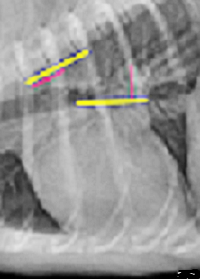 (3) Now, there is one means of determining from a single x-ray
whether the left atrium is enlarged or not. It is called the "Subjective
Method" and it calls for cardiologists (and even general practice
clinicians) to use their training and expertise regarding the normal
shape of a dog's heart and look at the LA and determine by its shape
whether it is normal or must be enlarged. For example, the x-ray in
this study's Figure 1(A) (right) shows an obviously bulbous LA
(see the vertical red line), signifying that it is enlarged.
No well-trained vet should have needed anything other than eyesight to
detect enlargement of that LA. (The same is true for visually detecting
enlargement of the left ventricle, which appears on that x-ray to have a much more rounded
appearance than a normal-sized LV.)
(3) Now, there is one means of determining from a single x-ray
whether the left atrium is enlarged or not. It is called the "Subjective
Method" and it calls for cardiologists (and even general practice
clinicians) to use their training and expertise regarding the normal
shape of a dog's heart and look at the LA and determine by its shape
whether it is normal or must be enlarged. For example, the x-ray in
this study's Figure 1(A) (right) shows an obviously bulbous LA
(see the vertical red line), signifying that it is enlarged.
No well-trained vet should have needed anything other than eyesight to
detect enlargement of that LA. (The same is true for visually detecting
enlargement of the left ventricle, which appears on that x-ray to have a much more rounded
appearance than a normal-sized LV.)
(4) Finally, the stated purpose of these investigators was to enable general practice clinicians "to identify dogs with stage B2 MMVD when echocardiography is unavailable to identify the cardiac enlargement by which stage B2 is defined." The obvious fallacy of that statement is that the ACVIM's 2019 definition of Stage B2 requires that both the LA and LV exceed minimum sizes, and that the Australians' new method of measuring the size of the LA has nothing whatsoever to do with the LV. So, their M-VLAS method alone is of no value in being able to classify a dog in Stage B2.
The ultimate irony here is that the method these researchers pan the most -- the VHS valuations (of two sets of x-rays) -- is far more useful in matching the ACVIM's 2019 version of Stage B2 than is the M-VLAS or any other measurement of just the left atrium in detecting enlargement of both left chambers, because the VHS measures the whole heart.
February 2021:
Stage C MVD-affected dogs with large left ventricles are
reported more likely to have a reocurrence of congestive heart failure.
 In a
February 2021 article, an international group of cardiology
investigators (Alessandra Franchini [right], Jonathan A. Abbott, William Tyrrel,
Steven Rosenthal, Sunshine Lahmers, Giulio Menciotti, Serena Crosara,
Jens Haggstrom, Michele Borgarelli) examined the medical records of 445
dogs (including 37 [8%] cavaliers) diagnosed with heart failure due to mitral valve disease and in
stable condition following diuretic treatment. They sought to identify
signs which could predict the likelihood that congestive signs of heart
failure would reoccur within the first 180 days (six months) following the
point when their heart failure was stabilized by diuretic treatment. Of
the 445 dogs, 106 of them (24%) had a reoccurrence of congestive signs
during the first 180 days. The investigators report that they could find
no accurate predictors of the reoccurrence of congestive signs, but that
dogs with larger left ventricles were more likely to have
a reoccurrence in the first 180 days.
In a
February 2021 article, an international group of cardiology
investigators (Alessandra Franchini [right], Jonathan A. Abbott, William Tyrrel,
Steven Rosenthal, Sunshine Lahmers, Giulio Menciotti, Serena Crosara,
Jens Haggstrom, Michele Borgarelli) examined the medical records of 445
dogs (including 37 [8%] cavaliers) diagnosed with heart failure due to mitral valve disease and in
stable condition following diuretic treatment. They sought to identify
signs which could predict the likelihood that congestive signs of heart
failure would reoccur within the first 180 days (six months) following the
point when their heart failure was stabilized by diuretic treatment. Of
the 445 dogs, 106 of them (24%) had a reoccurrence of congestive signs
during the first 180 days. The investigators report that they could find
no accurate predictors of the reoccurrence of congestive signs, but that
dogs with larger left ventricles were more likely to have
a reoccurrence in the first 180 days.
February 2021:
A cleft in a mitral valve leaflet causes mitral regurgitation in
a cavalier King Charles spaniel.
 In
a
January 2021 article, a team of Japanese veterinary clinicians
(Ryuji Araki, Koji Iwanaga, Kazunori Ueda, Mitsuhiro Isaka [right])
report discovering a congenital cleft (split) in one of the two leaflets
of the mitral valve of a 2-year-old male cavalier King Charles spaniel.
The dog had mild mitral valve regurgitation of blood through the cleft's
opening. The
In
a
January 2021 article, a team of Japanese veterinary clinicians
(Ryuji Araki, Koji Iwanaga, Kazunori Ueda, Mitsuhiro Isaka [right])
report discovering a congenital cleft (split) in one of the two leaflets
of the mitral valve of a 2-year-old male cavalier King Charles spaniel.
The dog had mild mitral valve regurgitation of blood through the cleft's
opening. The
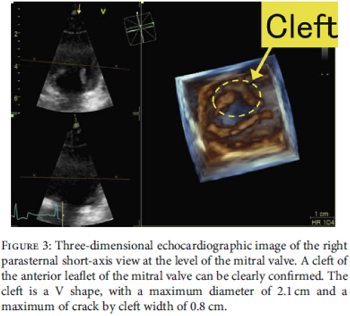 authors
used 3-D echocardiography to reveal the position, shape, diameter, and
width of the cleft's opening. (See Figure 3 at the left.) No
heart enlargement was observed, and the dog was classified as Stage B1
of mitral valve dysplasia. The disorder is extremely rare, and only one
other case has been reported in veterinary literature -- a
2012 report of a 7-month-old English toy spaniel (King Charles
spaniel). In this cavalier's case, the owners opted for continued
medication with oral temocapril hydrochloride (an ACE-inhibitor) and
pimobendan. The CKCS's condition did not worsen until he died of
lymphocytic leukemia. Ironically, the English toy spaniel in the 2012
report also died of lymphocytic leukemia, at the age of 8.5 years.
authors
used 3-D echocardiography to reveal the position, shape, diameter, and
width of the cleft's opening. (See Figure 3 at the left.) No
heart enlargement was observed, and the dog was classified as Stage B1
of mitral valve dysplasia. The disorder is extremely rare, and only one
other case has been reported in veterinary literature -- a
2012 report of a 7-month-old English toy spaniel (King Charles
spaniel). In this cavalier's case, the owners opted for continued
medication with oral temocapril hydrochloride (an ACE-inhibitor) and
pimobendan. The CKCS's condition did not worsen until he died of
lymphocytic leukemia. Ironically, the English toy spaniel in the 2012
report also died of lymphocytic leukemia, at the age of 8.5 years.
January 2021:
Italian study compares x-ray measurements to echo LA/Ao
ratio to determine left atrium enlargement in MVD-affected dogs.
 In a
January 2021 article, a team of University of Pisa veterinary
researchers (T. Vezzosi, C. Puccinelli, Simonetta Citi [right], R. Tognetti) reviewed
the echocardiograph and x-ray records of 111 MVD-affected dogs --
including 10 (9%) cavalier King Charles spaniels -- to determine the
feasibility, the diagnostic value, and the optimal cut-offs of
Vertebral
Left Atrial Size (VLAS) and
Radiographic Left Atrial Dimension (RLAD) in
the prediction of left atrial (LA) enlargement in dogs with mitral valve
disease (MVD). They followed the current ACVIM Consensus Statement's
echo definition of LA enlargement (LA/Ao > 1.6) and sought to find the
closest VLAS and RLAD and
VHS (vertebral heart score) measurements to
that echo definition. They report the following:
In a
January 2021 article, a team of University of Pisa veterinary
researchers (T. Vezzosi, C. Puccinelli, Simonetta Citi [right], R. Tognetti) reviewed
the echocardiograph and x-ray records of 111 MVD-affected dogs --
including 10 (9%) cavalier King Charles spaniels -- to determine the
feasibility, the diagnostic value, and the optimal cut-offs of
Vertebral
Left Atrial Size (VLAS) and
Radiographic Left Atrial Dimension (RLAD) in
the prediction of left atrial (LA) enlargement in dogs with mitral valve
disease (MVD). They followed the current ACVIM Consensus Statement's
echo definition of LA enlargement (LA/Ao > 1.6) and sought to find the
closest VLAS and RLAD and
VHS (vertebral heart score) measurements to
that echo definition. They report the following:
• "Regarding VLAS, our results showed that the best cutoff to detect LA enlargement ws 2.2 ... A VLAS > 2.4 was the best predictor of moderate-to-severe LA enlargement."
• "The best cutoff of RLAD to detect LA enlargement was 1.8 in our study ... and a RLAD > 2.0 was the best predictor of moderate-to-severe LA enlargement."
• "In our study, the RLAD showed a higher diagnostic accuracy in detecting LA enlargement than the VLAS."
• "In our study the best cutoff of VHS in predicting dogs fulfilling the echocardiographic criteria for stage B2 was 10.7."
• "VLAS and RLAD represent useful radiological tools for the detection of LA enlargement in dogs with MMVD."
• "In asymptomatic dogs, the RLAD performs better than VLAS and VHS in the prediction of those fulfilling the echocardiographic criteria for stage B2."
 EDITOR'S NOTE: This study is another GARBAGE-IN-GARBAGE-OUT scenario. The bottom line is that if you
wrongly
assume that an echocardiographic cutoff measurement of the
left atrium-to-aorta ratio (LA/Ao) -- in this case, LA/Ao = 1.6 --
defines an enlarged LA in any dog of any breed, then your end-results, comparing x-ray
measurements to that echo cutoff, will provide you with only useless
information. At best, these VLAS and RLAD cutoffs tell us only what
matches LA/Ao > 1.6, but not if the patient actually has an enlarged LA
or not.
EDITOR'S NOTE: This study is another GARBAGE-IN-GARBAGE-OUT scenario. The bottom line is that if you
wrongly
assume that an echocardiographic cutoff measurement of the
left atrium-to-aorta ratio (LA/Ao) -- in this case, LA/Ao = 1.6 --
defines an enlarged LA in any dog of any breed, then your end-results, comparing x-ray
measurements to that echo cutoff, will provide you with only useless
information. At best, these VLAS and RLAD cutoffs tell us only what
matches LA/Ao > 1.6, but not if the patient actually has an enlarged LA
or not.
The authors repeated three times the false "gold standard" mantra
that (1) "For the
assessment of left cardiac enlargement, echocardiography was considered
the gold standard method" and (2) "standard
 echocardiography remains the
gold standard to assess cardiac enlargement for the diagnostic and
therapeutical management of dogs with MMVD in clinical practice" and (3)
"First, the LA/Ao method was used as the gold standard to define LA
enlargement." This is utter nonsense. An echo measurement of LA/Ao
IS
NOT a gold standard of LA enlargement. All that a
single echo scan can determine is the current two-dimensional linear
SIZE of the LA, but NOT whether that size means that the dog's LA is
larger now than its previous normal size. It takes two such scans, made
over a period of months or even years, to verify that the LA is bigger
than it once was.
echocardiography remains the
gold standard to assess cardiac enlargement for the diagnostic and
therapeutical management of dogs with MMVD in clinical practice" and (3)
"First, the LA/Ao method was used as the gold standard to define LA
enlargement." This is utter nonsense. An echo measurement of LA/Ao
IS
NOT a gold standard of LA enlargement. All that a
single echo scan can determine is the current two-dimensional linear
SIZE of the LA, but NOT whether that size means that the dog's LA is
larger now than its previous normal size. It takes two such scans, made
over a period of months or even years, to verify that the LA is bigger
than it once was.
The authors also ignore the fact that neither the VLAS nor the RLAD
measurements have anything to do with the size (or enlargement) of the
left ventricle (LV). Note in both of them, the word "Atrial" is included
but not the word "Ventricle". And yet, the ACVIM's current definition of
Stage B2 requires that both the LA and LV  have measurements exceeding
the ACVIM's arbitrary cutoffs. In the case of the LV, that minimum
measurement is the LVIDDN (LV end diastolic diameter normalized for body
weight) >1.7. So, while the VLAS and/or the RLAD may be a substitute for
an echo measurement of the LA/Ao, neither can provide any information
about the size (or "enlargement") of the left ventricle. And
therefore, neither of them can identify dogs in Stage B2.
have measurements exceeding
the ACVIM's arbitrary cutoffs. In the case of the LV, that minimum
measurement is the LVIDDN (LV end diastolic diameter normalized for body
weight) >1.7. So, while the VLAS and/or the RLAD may be a substitute for
an echo measurement of the LA/Ao, neither can provide any information
about the size (or "enlargement") of the left ventricle. And
therefore, neither of them can identify dogs in Stage B2.
January 2021:
UC-Davis cardiologists find VLAS and VHS x-ray measurements may
substitute for echo measurements of left atrial size in MVD-affected
dogs.
 In a
January 2021 article, a team of University of California-Davis
veterinary cardiologists and radiologists (Laetitia Duler, Lance C.
Visser [right], Kristina N. Jackson, Kathryn L. Phillips, Rachel E. Pollard,
Mason W. Wanamaker) compared the echocardiographic and x-ray scans of
183 dogs of undisclosed breeds, 103 of which had mitral valve disease
(MVD), to compare the ability of vertebral heart size (VHS), vertebral
left atrial size (VLAS), and radiologists' assessment of left atrial
size (RadLAE) to predict echocardiographic left atrial size. They
defined echocardiographic left atrial (LA) enlargement (EchoLAE) as
LA/Ao >1.68 for all of the dogs in the study, basing that cut-off on
a
prior study of only healthy dogs which had LA/Ao ratios as high as 1.70.
They also compared the dogs' VLAS and VHS values to the ACVIM Stage B1
and B2 definition of LA/Ao >1.60. They report finding that the optimal
cut-off for VLAS to predict EchoLAE was >2.3 and for VHS >11.1, and that
VLAS was a more accurate predictor of EchoLAE than was VHS or RadLAE.
They also report that both VLAS >2.8 and VHS >12.0 were "useful
predictors" of ACVIM's Stage B2 definition. They conclude that, when
echo is unavailable, "VLAS represents a useful radiographic measurement
to aid clinical management of dogs with known or suspected" MVD.
In a
January 2021 article, a team of University of California-Davis
veterinary cardiologists and radiologists (Laetitia Duler, Lance C.
Visser [right], Kristina N. Jackson, Kathryn L. Phillips, Rachel E. Pollard,
Mason W. Wanamaker) compared the echocardiographic and x-ray scans of
183 dogs of undisclosed breeds, 103 of which had mitral valve disease
(MVD), to compare the ability of vertebral heart size (VHS), vertebral
left atrial size (VLAS), and radiologists' assessment of left atrial
size (RadLAE) to predict echocardiographic left atrial size. They
defined echocardiographic left atrial (LA) enlargement (EchoLAE) as
LA/Ao >1.68 for all of the dogs in the study, basing that cut-off on
a
prior study of only healthy dogs which had LA/Ao ratios as high as 1.70.
They also compared the dogs' VLAS and VHS values to the ACVIM Stage B1
and B2 definition of LA/Ao >1.60. They report finding that the optimal
cut-off for VLAS to predict EchoLAE was >2.3 and for VHS >11.1, and that
VLAS was a more accurate predictor of EchoLAE than was VHS or RadLAE.
They also report that both VLAS >2.8 and VHS >12.0 were "useful
predictors" of ACVIM's Stage B2 definition. They conclude that, when
echo is unavailable, "VLAS represents a useful radiographic measurement
to aid clinical management of dogs with known or suspected" MVD.
The authors also provide these interesting observations:
• "To be certain, however, an echocardiographic examination remains the clinical gold standard."
• "Lastly, our chosen criteria for EchoLAE is not a gold standard for assessment of LA size/volume."
• "In practice, radiologists might qualify LA enlargement with terms such as mild, moderate, or severe. We contend that these qualifiers are subjective and likely mean different things to different people thus presenting significant challenges."
 EDITOR'S
NOTE: This is truly a sad case. Digging down deep, there
really is no clinical value to this article when attempting to diagnose
heart enlargement in a particular dog of a particular breed. First of
all, among 183 dogs, we have no idea what breeds were included in the study.
Unlike 99% of such articles, this one lists no breed names at all.
EDITOR'S
NOTE: This is truly a sad case. Digging down deep, there
really is no clinical value to this article when attempting to diagnose
heart enlargement in a particular dog of a particular breed. First of
all, among 183 dogs, we have no idea what breeds were included in the study.
Unlike 99% of such articles, this one lists no breed names at all.
Second, the authors arbitrarily define any and all enlarged left atriums (LAs) as having a LA/Ao ratio of >1.68. Granted, this is a higher ratio than in the EPIC Study's and the 2019 ACVIM Consensus Statement's arbitrary species-wide definition of enlarged left atriums -- LA/Ao >1.60. But it is just as arbitrary. The only citation they give to support LA/Ao >1.68 as defining an enlarged left atrium is a 2019 prior study by Dr. Visser, the lead investigator of this article, in which only healthy dogs were examined and had LA/Ao ratios as high as 1.70.
There are scads of truly scientifically researched studies which conclude that breeds vary so widely that there can be no species-wide cut-off measurement between normal and enlarged heart chambers. Here is a list of 17 such articles. Even Dr. Visser himself, in that 2019 prior study linked above, stated:
"Unlike in human medicine, recommended standards for quantitation of cardiac chamber size and function by echocardiography in dogs do not currently exist."
"Currently, no accepted standard exists on how to determine RIs [reference intervals] (ie, clinical cutoffs to help distinguish normal from abnormal) for echocardiography data sets in healthy dogs."
"Thus, common approaches for indexing linear measurement to body size have included breed-specific reference values ...".
So, right off of the bat, they are wasting our time because when you start off with bogus assumptions, you end up with worthless data, findings, and conclusions.
They also completely overlook the real value of VHS and VLAS measurements, which is that when a baseline x-ray (taken before heart enlargement occurs) is compared with a later x-ray (taken after enlargement is suspected), that comparsion will confirm whether any enlargement has in fact occurred. When Dr. James Buchanan introduced the VHS concept in 1995, that was his point -- you need two or more sets of x-rays, taken over a period of months or even years, to confirm whether the dog's heart has enlarged in the interim. That is the REAL Gold Standard. This strategy can also apply to two sets of echo scans. But one echo examination is no gold standard at all for diagnosing heart enlargement. All one echo exam will tell you is how large the heart chambers are, but certainly not whether they are larger than they once were. So, all we learn from this article is that some arbitrary VLAS and VHS values of heart size might come close to predicting arbitrary LA/Ao ratios. But it has nothing to do with determining whether a given dog's left atrium is enlarged or not.
And finally, the authors ignore the fact that the VLAS has nothing to do with the size (or enlargement) of the left ventricle (LV). And yet, the ACVIM's current definition of Stage B2 requires that both the LA and LV have measurements exceeding the ACVIM's arbitrary cutoffs. In the case of the LV, that minimum measurement is the LVIDDN (LV end diastolic diameter normalized for body weight) >1.7. So, while the VLAS may be a substitute for an echo measurement of the LA/Ao, it cannot provide any information about the size (or "enlargement") of the left ventricle. And therefore, the VLAS cannot identify dogs in Stage B2.
January 2021:
VALVE Trial authors confirm that ACE-inhibitors are worthless in
treating Stage C of MVD.
 In a
January 2021 response to
this Atkins, et al. letter to the editor (see
our item below) regarding the
September 2020 VALVE Trial, its authors (Gerhard Wess, Tony Glaus
[right]) explain their study's goals and its conclusions,
including not recommending ACE-inhibitors to treat Stage C of mitral
valve disease (MVD). They state:
In a
January 2021 response to
this Atkins, et al. letter to the editor (see
our item below) regarding the
September 2020 VALVE Trial, its authors (Gerhard Wess, Tony Glaus
[right]) explain their study's goals and its conclusions,
including not recommending ACE-inhibitors to treat Stage C of mitral
valve disease (MVD). They state:
"The goal of the VALVE trial was to answer whether adding ACEI to furosemide plus pimobendan would improve outcome, and most VALVE coauthors had already been involved in the QUEST trial. To be consistent and credible, the authors largely adopted the QUEST trial's study protocol with some differences. In both the QUEST and the VALVE trials, the following features were identical: (a) dogs had to be in an advanced stage of MMVD with pulmonary edema objectively present on thoracic radiographs; (b) the study was not placebo-controlled, but the study authors were blinded to the treatment as the drugs were provided to the clients using a provider; (c) treatment failure was defined as decompensation despite the use of very high doses of furosemide. This dosage had been set at 12 mg/kg/d in the QUEST trial and at 15 mg/kg/d in the VALVE trial. Admittedly, these are very high dosages. Nevertheless, this was the definition of treatment failure in these respective studies. ...
"[T]he VALVE trial is a large, prospective, randomized, multicenter study with a very high event rate that did not show any survival benefit with respect to the use of an ACEI in dogs with advanced MMVD. Therefore, given the data available today, we cannot in good faith recommend adding an ACEI to the basic treatment consisting of furosemide and pimobendan in dogs with MMVD in ACVIM stage C." (Emphasis added.)
 EDITOR'S NOTE: This may be the last nail in the coffin(s) of
ACE-inhibitors as treatment for MVD in all of its stages, including the
final ones -- Stages C and D. While the VALVE Study used only ramipril
as its ACE-inhibitor, the authors feel comfortable in concluding that no
ACE-inhibitor shows any survival benefit when added to furosemide and
pimobendan in treating MVD-affected dogs in heart failure. (See
our September 2020 article below discussing the VALVE Study report.
See, also,
our January 2021 article regarding the Atkins et al. letter to the
editor.)
EDITOR'S NOTE: This may be the last nail in the coffin(s) of
ACE-inhibitors as treatment for MVD in all of its stages, including the
final ones -- Stages C and D. While the VALVE Study used only ramipril
as its ACE-inhibitor, the authors feel comfortable in concluding that no
ACE-inhibitor shows any survival benefit when added to furosemide and
pimobendan in treating MVD-affected dogs in heart failure. (See
our September 2020 article below discussing the VALVE Study report.
See, also,
our January 2021 article regarding the Atkins et al. letter to the
editor.)
January 2021:
Cardiologists' letter criticizes findings and conclusions of the
VALVE Study report regarding ACE-inhibitors.
 In
a
January 2021 letter to the editor, responding to the previously
published article, "Efficacy of adding ramipril (VAsotop) to the
combination of furosemide (Lasix) and pimobendan (VEtmedin) in dogs with
mitral valve degeneration:
The VALVE trial" (VALVE Trial), a group of 11 cardiologists (Clarke
Atkins [right], Bruce Keene, Teresa C. DeFrancesco, Sandra Tou,
Valerie Chetboul, etienne Côte, Stephen Ettinger, Robert L. Hamlin,
Jonathan P. Mochel, Jean‐Louis Pouchelon, Rebecca L. Stepien) objected
to the VALVE Trial's conclusion that ACE-inhibitors are not needed to
treat MVD-affected dogs in heart failure (Stage C). The letter's authors
question the VALVE Trial's data and findings, as well as its conclusion
regarding the ineffectiveness of ACE-inhibitors at Stage C. They also
hint that there are pending -- but not yet published -- two other
studies of the effectiveness of ACE-inhibitors in suppressing the
MVD-affected dogs' renin-angiotensin-aldosterone system (RAAS), namely
(a) "Rational dose selection for ACE inhibitors in canine heart disease"
by Drs. Ward and Mochel, and (b) "Clinical efficacy of a benazepril and
spironolactone combination in dogs with congestive heart failure due to
myxomatous mitral valve disease: The BESST Trial". (See
our September 2020 article below discussing the VALVE Study report,
and our
August 2021 article on the Ward and Mochel study, and our
May 2022 article on the BESST trial..)
In
a
January 2021 letter to the editor, responding to the previously
published article, "Efficacy of adding ramipril (VAsotop) to the
combination of furosemide (Lasix) and pimobendan (VEtmedin) in dogs with
mitral valve degeneration:
The VALVE trial" (VALVE Trial), a group of 11 cardiologists (Clarke
Atkins [right], Bruce Keene, Teresa C. DeFrancesco, Sandra Tou,
Valerie Chetboul, etienne Côte, Stephen Ettinger, Robert L. Hamlin,
Jonathan P. Mochel, Jean‐Louis Pouchelon, Rebecca L. Stepien) objected
to the VALVE Trial's conclusion that ACE-inhibitors are not needed to
treat MVD-affected dogs in heart failure (Stage C). The letter's authors
question the VALVE Trial's data and findings, as well as its conclusion
regarding the ineffectiveness of ACE-inhibitors at Stage C. They also
hint that there are pending -- but not yet published -- two other
studies of the effectiveness of ACE-inhibitors in suppressing the
MVD-affected dogs' renin-angiotensin-aldosterone system (RAAS), namely
(a) "Rational dose selection for ACE inhibitors in canine heart disease"
by Drs. Ward and Mochel, and (b) "Clinical efficacy of a benazepril and
spironolactone combination in dogs with congestive heart failure due to
myxomatous mitral valve disease: The BESST Trial". (See
our September 2020 article below discussing the VALVE Study report,
and our
August 2021 article on the Ward and Mochel study, and our
May 2022 article on the BESST trial..)
January 2021:
MVD-affected cavaliers in heart failure (Stage C) had reduced
CoQ10 concentrations, in Danish study.
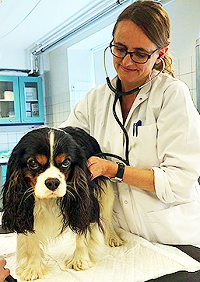 In a
January 2021 article, a team of University of Copenhagen veterinary
researchers (Liselotte B. Christiansen, Maria J. Reimann, Anne Marie V.
Schou-Pedersen, Steen Larsen, Jens Lykkesfeldt, Lisbeth H. Olsen
[right]) investigated the possible correlation between the
mycardial concentration of coenzyme Q10 (CoQ10) and the increased
severity of mitral valve disease (MVD) in 30 deceased cavalier King
Charles spaniels. The dogs were categorized by the 2019 ACVIM stages of
MVD -- Stages B1, B2, and C -- at the time of their euthanasia deaths.
Ten deceased non-CKCSs with healthy hearts served as a control group.
Myocardial CoQ10 concentration was analysed in the dogs' left
ventricular tissue samples. They report finding depleted concentrations
of myocardial CoQ10 in the cavaliers in heart failure (Stage C) compared
to the other groups. They state that the depletion of CoQ10 was not
associated with a reduction in the mitochondrial density marker citrate
synthase activity, and that there was no significant association between
MVD severity and oxidation ratio of CoQ10.
In a
January 2021 article, a team of University of Copenhagen veterinary
researchers (Liselotte B. Christiansen, Maria J. Reimann, Anne Marie V.
Schou-Pedersen, Steen Larsen, Jens Lykkesfeldt, Lisbeth H. Olsen
[right]) investigated the possible correlation between the
mycardial concentration of coenzyme Q10 (CoQ10) and the increased
severity of mitral valve disease (MVD) in 30 deceased cavalier King
Charles spaniels. The dogs were categorized by the 2019 ACVIM stages of
MVD -- Stages B1, B2, and C -- at the time of their euthanasia deaths.
Ten deceased non-CKCSs with healthy hearts served as a control group.
Myocardial CoQ10 concentration was analysed in the dogs' left
ventricular tissue samples. They report finding depleted concentrations
of myocardial CoQ10 in the cavaliers in heart failure (Stage C) compared
to the other groups. They state that the depletion of CoQ10 was not
associated with a reduction in the mitochondrial density marker citrate
synthase activity, and that there was no significant association between
MVD severity and oxidation ratio of CoQ10.
The researchers emphasize that the scope of their study did not include evidence for the use of CoQ10 supplementation in MVD-affected CKCSs. They stated:
"A long-term, prospective, placebo-controlled clinical study needs to be done in dogs with MMVD and at risk of developing CHF to determine ... if the depletion in myocardial [Co]Q10 is a relevant therapeutic target in dogs with MMVD and if it can be restored with supplementation of [Co]Q10."
January 2021:
Japanese study suggests that left ventricular-arterial
coupling changes can predict the onset of Stage C in MVD-affected dogs.
 In a
January 2021 article, a team of Hokkaido University, Japan,
veterinary researhers (Tatsuyuki Osuga, Tomoya Morita, Noboru Sasaki,
Keitaro Morishita, Hiroshi Ohta, Mitsuyoshi Takiguchi [right]) examined
echocardiographic measurements of the interaction between the left
ventricle and systemic arterial systems (called left ventricular
arterial coupling -- VAC) in 90 dogs diagnosed in varying stages of
mitral valve disease (MVD) and 61 healthy dogs. The number of cavalier
King Charles spaniels in this study, if any, is not identified. VAC is
an index of the interaction between LV and the systemic arterial systems
and is measured by the Effective Arterial Elastance (Ea) to left
ventricular (LV) End systolic Elastance (Ees) ratio (Ea/Ees). An
increase in echocardiographically estimated Ea/Ees is associated with
advanced disease severity in MVD-affected dogs and is termed
"Inappropriate VAC".
In a
January 2021 article, a team of Hokkaido University, Japan,
veterinary researhers (Tatsuyuki Osuga, Tomoya Morita, Noboru Sasaki,
Keitaro Morishita, Hiroshi Ohta, Mitsuyoshi Takiguchi [right]) examined
echocardiographic measurements of the interaction between the left
ventricle and systemic arterial systems (called left ventricular
arterial coupling -- VAC) in 90 dogs diagnosed in varying stages of
mitral valve disease (MVD) and 61 healthy dogs. The number of cavalier
King Charles spaniels in this study, if any, is not identified. VAC is
an index of the interaction between LV and the systemic arterial systems
and is measured by the Effective Arterial Elastance (Ea) to left
ventricular (LV) End systolic Elastance (Ees) ratio (Ea/Ees). An
increase in echocardiographically estimated Ea/Ees is associated with
advanced disease severity in MVD-affected dogs and is termed
"Inappropriate VAC".
The researchers report finding that an increase in Ea/Ees in Stage B2 MVD-dogs mainly was associated with the decrease in Ees, suggesting that left ventricular systolic dysfunction mainly contributed to inappropriate VAC in that stage, and that the increase in Ea/Ees in Stage C MVD-dogs was associated with both the decrease in Ees and increase in Ea, suggesting that both left ventricular systolic dysfunction and increase in the total arterial load of the left ventricle contributed to inappropriate VAC in Stage C. This suggest that the total arterial load of the LV increases in Stage C, leading to more inappropriate VAC in Stage C when compared with Stage B2. They concluded that:
"Multivariable logistic regression analysis showed that Ea/Ees was an independent predictor of stage C in dogs with MMVD among the various echocardiographic indices evaluated."
January 2021:
Univ. of Milan researchers warn against using species-wide reference intervals
for monitoring MVD-affected dogs' RAAS activation.
 In a
January 2021 article, a team of University of Milan veterinary
researchers (Alberto Galizzi, Mara Bagardi [right], Angelica Stranieri,
Anna Maria Zanaboni, Dario Malchiodi, Vitaliano Borromeo, Paola
Giuseppina Brambilla, Chiara Locatelli) studied 149 dogs (27 cavalier
King Charles spaniels - 18%), both healthy and diagnosed with mitral
valve disease (MVD) to determine the relationship between the urinary
aldosterone-to-creatinine ratio (UAldo:C) and the progression of MVD
from ACVIM Stages B1 to B2 to C. They report finding:
In a
January 2021 article, a team of University of Milan veterinary
researchers (Alberto Galizzi, Mara Bagardi [right], Angelica Stranieri,
Anna Maria Zanaboni, Dario Malchiodi, Vitaliano Borromeo, Paola
Giuseppina Brambilla, Chiara Locatelli) studied 149 dogs (27 cavalier
King Charles spaniels - 18%), both healthy and diagnosed with mitral
valve disease (MVD) to determine the relationship between the urinary
aldosterone-to-creatinine ratio (UAldo:C) and the progression of MVD
from ACVIM Stages B1 to B2 to C. They report finding:
• Cavaliers have significantly higher urinary aldosterone-to-creatinine ratios, both healthy and at all stages of MVD, than other breeds.
• Comparing UAldo:C of a single patient with a species-wide reference value can lead to wrong interpretations.
• UAldo:C should be monitored on an individual basis.
• Overall, UAldo:C was not significantly diferent among healthy and MVD-affected dogs in different ACVIM Stages.
• UAldo:C appeared to be increased by spironolactone and was positively associated with furosemide dose.
• Aldosterone breakthrough (ABT) appeared to occur in 36% of stage C dogs not receiving spironolactone.
• There was a significant positive association between UAldo:C and left atrium-to-aortic root ratio (LA/Ao), meaning that as the left atrium enlarged, the UAldo:C increased, in the total population.
RETURN TO TOP
2020 News
December 2020:
Angiotensin receptor blocker Telmisartan may be superior to
ACE-inhibitors in controlling the RAAS' role in heart failure in
MVD-affected dogs.
 In a
December 2020 article, a team of University of Pennsylvania
veterinary cardiology researchers (eva Larouche-Lebel, Kerry A.
Loughran, Terry Huh, Mark A. Oyama [right]) compared the effectiveness
of angiotensin converting enzyme inhibitors (ACE-I) -- enalapril and
benazepril -- with the angiotensin receptor blocker (ARB) telmisartan in
offsetting the activatation of the renin-angiotensin-aldosterone-system
(RAAS) in the kidneys of dogs in Stage B2 of mitral valve disease. Eight
MVD-affected dogs were included in the study, all diagnosed with Stage
B2 of MVD, including two cavalier King Charles spaniels (25%). They
report finding that telmisartan treatment resulted in higher activity of
favorable angiotensin peptide (AP) concentrations, as compared to ACE-I
treatment. They concluded that:
In a
December 2020 article, a team of University of Pennsylvania
veterinary cardiology researchers (eva Larouche-Lebel, Kerry A.
Loughran, Terry Huh, Mark A. Oyama [right]) compared the effectiveness
of angiotensin converting enzyme inhibitors (ACE-I) -- enalapril and
benazepril -- with the angiotensin receptor blocker (ARB) telmisartan in
offsetting the activatation of the renin-angiotensin-aldosterone-system
(RAAS) in the kidneys of dogs in Stage B2 of mitral valve disease. Eight
MVD-affected dogs were included in the study, all diagnosed with Stage
B2 of MVD, including two cavalier King Charles spaniels (25%). They
report finding that telmisartan treatment resulted in higher activity of
favorable angiotensin peptide (AP) concentrations, as compared to ACE-I
treatment. They concluded that:
"Treatment with ARBs, such as telmisartan, or combined ARB and ACE2 [angiotensin converting enzyme 2] treatment represents a potential treatment strategy for dogs with DMVD and warrants additional preclinical study."
November 2020:
Italian researchers find radiographic left atrial
dimension (RLAD) and vertebral left atrial size (VLAS) accurately detect
left atrial enlargement in MVD-affected dogs.
 In a
November 2020 article, a team of University of Milan
cardiologists and radiologists (Mara Bagardi, Martina Manfredi [right],
Davide D. Zani, Paola G. Brambilla, Chiara Locatelli) sought to compare
the accuracy of two radiographic methods of measuring heart size --
radiographic left atrial dimension (RLAD) and vertebral left atrial size
(VLAS) -- with the radiographic method of vertebral heart score (VHS)
and the echocardiographic method of the left atrium-to-aorta ratio
(LA/Ao). They reviewed the medical records of 74 dogs, including 15
cavalier King Charles spaniels (20.3%).
Eight dogs were healthy, and 66 had mitral valve disease (MVD). The
records they reviewed included thoracic radiographs (chest x-rays) and
echocardiogram scans both performed on the same day for each dog. Thirty
dogs showed echocardiographic left atrial enlargement (LAE) using the
2019 ACVIM Consensus Statement's species-wide definition of LA/Ao > 1.6.
They found:
In a
November 2020 article, a team of University of Milan
cardiologists and radiologists (Mara Bagardi, Martina Manfredi [right],
Davide D. Zani, Paola G. Brambilla, Chiara Locatelli) sought to compare
the accuracy of two radiographic methods of measuring heart size --
radiographic left atrial dimension (RLAD) and vertebral left atrial size
(VLAS) -- with the radiographic method of vertebral heart score (VHS)
and the echocardiographic method of the left atrium-to-aorta ratio
(LA/Ao). They reviewed the medical records of 74 dogs, including 15
cavalier King Charles spaniels (20.3%).
Eight dogs were healthy, and 66 had mitral valve disease (MVD). The
records they reviewed included thoracic radiographs (chest x-rays) and
echocardiogram scans both performed on the same day for each dog. Thirty
dogs showed echocardiographic left atrial enlargement (LAE) using the
2019 ACVIM Consensus Statement's species-wide definition of LA/Ao > 1.6.
They found:
"Our RLAD and VLAS cutoffs (1.9 and 2.43 v, respectively) were better related to qualitative radiographic than quantitative echocardiographic LAE evaluation. Radiographic LA dimension and VLAS showed an increase proportional to the worsening of the ACVIM class. ... The mean VHS value obtained in this study for normal dogs was 10.7 ± 0.65 v, which is slightly above the suggested upper limit for normal heart size in most breeds. ... The use of breed-specific VHS values is needed for the VHS method to have a higher specificity for normal heart size. ... In conclusion, results of the present study indicate that new radiographic measurements RLAD and VLAS demonstrated high sensitivity and specificity for detecting LAE with a moderate/strong correlation with LA/Ao ratio and especially with qualitative radiographic LAE evaluation in dogs affected by MMVD at different ACVIM stages. Thoracic radiographs and evaluation of LA dimension are a simple and cost-effective tool that can be used when echocardiography is not available, also by low experienced practitioners. Better performances are associated with increased clinical expertise and background."
 EDITOR'S NOTE: Once again we find that when researchers use the
ACVIM's arbitrary 2019 species-wide definition of LA/Ao > 1.6 as
their "gold standard" for diagnosing left atrial enlargement, their
initial hypotheses necessarily fail 1n the end. It is more
garbage-in-garbage-out research. Ironically, they start out by roundly
criticizing the journeyman clinician's traditional analysis of his
patient's chest x-rays to
determine LA size as being "primarily subjective and prone to error." What
they fail to realize is that the ACVIM's "gold standard" cut-point of
LA/Ao > 1.6 is erroneous from the outset. Not surprisingly in the least,
their ultimate finding and conclusion here is that the RLAD and VLAS methods of measuring the left
atrium had a much higher agreement with the qualitative x-ray method
than they did with their precious species-wide echocardiographic cut-points.
EDITOR'S NOTE: Once again we find that when researchers use the
ACVIM's arbitrary 2019 species-wide definition of LA/Ao > 1.6 as
their "gold standard" for diagnosing left atrial enlargement, their
initial hypotheses necessarily fail 1n the end. It is more
garbage-in-garbage-out research. Ironically, they start out by roundly
criticizing the journeyman clinician's traditional analysis of his
patient's chest x-rays to
determine LA size as being "primarily subjective and prone to error." What
they fail to realize is that the ACVIM's "gold standard" cut-point of
LA/Ao > 1.6 is erroneous from the outset. Not surprisingly in the least,
their ultimate finding and conclusion here is that the RLAD and VLAS methods of measuring the left
atrium had a much higher agreement with the qualitative x-ray method
than they did with their precious species-wide echocardiographic cut-points.
There also are some other interesting tidbits of data in this report. For instance, among the eight healthy dogs (unfortunately the breeds are not identified), their mean VHS value was 10.7 ± 0.65 (in other words, as high as 11.35), which is significantly higher than the ACVIM's 2019 species-wide cut-off VHS value of 10.5 for MVD-affected dogs with heart enlargement. They also state:
"The use of breed-specific VHS values is needed for the VHS method to have a higher specificity for normal heart size. In this study, due to breed variability of subjects, it was not possible to apply a breed-specific VHS value."
When you think about what they stated in these two
sentences, it is ludicrous.
In the first sentence, they point out that breed-specific values should
be used to determine normal heart size. Then in the second sentence they claim that in their study,
using breed-specific values is impossible. Of course it is not
impossible! They only had eight healthy dogs and
presumably they knew what their
breeds were. Why did  they not use the published breed-specific VHS
values? A major problem we have found when clinicians read
this sort of veterinary nonsense which pronounce species-wide cut-offs
is that the clinicians fall for it and end up applying those same cut-points to the
individual dogs in front of them on their examining tables, instead of
using their professional training and skills to make an individual
determination of whether their patients have enlarged hearts or not.
they not use the published breed-specific VHS
values? A major problem we have found when clinicians read
this sort of veterinary nonsense which pronounce species-wide cut-offs
is that the clinicians fall for it and end up applying those same cut-points to the
individual dogs in front of them on their examining tables, instead of
using their professional training and skills to make an individual
determination of whether their patients have enlarged hearts or not.
November 2020:
University of Florida resident Dr. Elodie Huguet wins the 2020
ACVR abstract award for comparing x-rays and echos of MVD-affected dogs.
 In a
November 2020 abstract, Dr. Elodie Huguet (right), a
resident in diagnostic imaging at the University of Florida veterinary
college, won the American College of Veterinary Radiology (ACVR) 2020
abstract award at its 2020 virtual meeting. In the abstract, Dr. Huguet
and Drs. Federico Grosso, Whitney Lamb, Meg Sleeper, James Colee,
Clifford Berry supervised the comparison of chest x-rays with
echocardiograms of 147 MVD-affected dogs with moderate to severe left-sided heart
enlargement, including 17 cavalier King Charles spaniels (11.6%) to
determine the accuracy of identifying whether there was any right-sided
enlargement seen on the x-rays. Two teams of five board-certified
radiologists with varied years of experience performed the analyses.
They found that:
In a
November 2020 abstract, Dr. Elodie Huguet (right), a
resident in diagnostic imaging at the University of Florida veterinary
college, won the American College of Veterinary Radiology (ACVR) 2020
abstract award at its 2020 virtual meeting. In the abstract, Dr. Huguet
and Drs. Federico Grosso, Whitney Lamb, Meg Sleeper, James Colee,
Clifford Berry supervised the comparison of chest x-rays with
echocardiograms of 147 MVD-affected dogs with moderate to severe left-sided heart
enlargement, including 17 cavalier King Charles spaniels (11.6%) to
determine the accuracy of identifying whether there was any right-sided
enlargement seen on the x-rays. Two teams of five board-certified
radiologists with varied years of experience performed the analyses.
They found that:
"When moderate to severe left-sided cardiomgegaly was identified on echocardiography, the sensitivity, specificity and accuracy of radiographs was low, identifying a small subset of dogs with radiographic evidence of right-sided cardiomegaly in the absence of corresponding right-sided cardiomegaly on echocardiography. Therefore, thoracic radiographs should be used with caution for the evaluation of cardiac chamber enlargement, particularly in the presence of severe left-sided cardiomegaly."
 EDITOR'S NOTE:
We congratulate Dr. Huguet for this study and receiving this major
award. Of course, this is a brief abstract, and we look forward to a full fledged
article being published soon, because we have some questions which the
full article should answer. Our main question is: How was moderate to
severe left-sided cardiomgegaly identified by echocardiography? We ask
because the conclusion is that when echo measurements finding moderate
to severe cardiomegaly (enlargement) were assumed to be accurate, the
accuracy of x-rays was low. But what if the echos were the culprits
instead of the x-rays? We shall wait to find out.
EDITOR'S NOTE:
We congratulate Dr. Huguet for this study and receiving this major
award. Of course, this is a brief abstract, and we look forward to a full fledged
article being published soon, because we have some questions which the
full article should answer. Our main question is: How was moderate to
severe left-sided cardiomgegaly identified by echocardiography? We ask
because the conclusion is that when echo measurements finding moderate
to severe cardiomegaly (enlargement) were assumed to be accurate, the
accuracy of x-rays was low. But what if the echos were the culprits
instead of the x-rays? We shall wait to find out.
October 2020:
Vertebral heart size
and vertebral left atrial size x-rays fail to correlate with the new
ACVIM Stages B1 and B2 definitions of MVD among 230 cavaliers.
 In a
September 2020 abstract presented at the 30th ECVIM-CA Congress,
cardiology researchers (S. Wesselowski [right], S. Gordon, A.
B. Saunders, R.C. Fries, K. T. Sykes, J.P. Vitt, B. G. Boutet, S.
Kadotani, K. Cusack, B. W. Janacek, J. P. Stack, S. Hubert, C. M.
Stoner) from three USA states sought to determine how the
2019 ACVIM species-wide echocardiographic cut-points between normal and
enlarged left atriums and left ventricles of 230 cavalier King Charles
spaniels would compare to the vertebral heart size (VHS) and vertebral
left atrial size (VLAS) values of the same dogs. The goal was to find
breed-specific VHS and VLAS cut-offs which would match the new ACVIM
species-wide parameters. All 230 cavaliers were asymptomatic of mitral
valve disease (MVD). Of those dogs, 14 (6%) had no murmurs and therefore were in
Stage A, 169 (73%) were in Stage B1 (22 [9.5%] of which had either a left atrial measurement of LA:Ao >1.6
or left ventricle measurement of LVIDDN >1.7 but not both and therefore
all of those
were in Stage B1), and 44 (19%) had both left atrial measurement of LA:Ao
>1.6 and left ventricle measurement of LVIDDN >1.7 and therefore were in Stage B2.
In a
September 2020 abstract presented at the 30th ECVIM-CA Congress,
cardiology researchers (S. Wesselowski [right], S. Gordon, A.
B. Saunders, R.C. Fries, K. T. Sykes, J.P. Vitt, B. G. Boutet, S.
Kadotani, K. Cusack, B. W. Janacek, J. P. Stack, S. Hubert, C. M.
Stoner) from three USA states sought to determine how the
2019 ACVIM species-wide echocardiographic cut-points between normal and
enlarged left atriums and left ventricles of 230 cavalier King Charles
spaniels would compare to the vertebral heart size (VHS) and vertebral
left atrial size (VLAS) values of the same dogs. The goal was to find
breed-specific VHS and VLAS cut-offs which would match the new ACVIM
species-wide parameters. All 230 cavaliers were asymptomatic of mitral
valve disease (MVD). Of those dogs, 14 (6%) had no murmurs and therefore were in
Stage A, 169 (73%) were in Stage B1 (22 [9.5%] of which had either a left atrial measurement of LA:Ao >1.6
or left ventricle measurement of LVIDDN >1.7 but not both and therefore
all of those
were in Stage B1), and 44 (19%) had both left atrial measurement of LA:Ao
>1.6 and left ventricle measurement of LVIDDN >1.7 and therefore were in Stage B2.
(EDITOR'S NOTE: In the 2019 ACVIM definitions of Stages B1 and B2, actual enlargement of either the heart's two left chambers no longer is determinative. Instead, the two arbitrary, species-wide minimum measurements -- LA:Ao = 1.6 and LVIDDN = 1.7 -- must be met or exceeded for MVD-affected cavaliers to be placed in Stage B2, regardless of whether or not either chamber actually is enlarged.)
The researchers report that neither the VHS nor the VLAS measurements
strongly correlated with the ACVIM's species-wide cut-points. They
concluded, therefore, that this lack of correlation may affect the use
of heart x-rays as an enlargement screening tool in the future for MVD-affected
CKCSs.
EDITOR'S NOTE: This whole study is laughable! Of course the VHS and VLAS values did not come close to the 2019 ACVIM cut-points for Stages B1 and B2. The reason is obvious, and it is not the failure of either the VHS or VLAS measurements, because those two radiographic formulas are specific to the dog being examined. The 2019 ACVIM definitions of Stages B1 and B2 are unrelated to any reality (that is, whether the dog's heart actually is enlarged or not), while the VHS and VLAS values are steeped in that reality. As long as these cardiologists insist upon squeezing the square-pegged cavalier (or any other breed) into the round hole of arbitrary, species-wide tipping points between normal and enlarged hearts, all of these academic efforts are likely to fail. The irony here is that the researchers seem to be blaming the radiographic formulas for the lack of correlation, when it is obvious that the nonsensical echo cut-points are at fault. These arbitrary tipping points are a classic example of self-deception and circular reasoning.
As a side comment, it is very interesting that even though the 2019 ACVIM Stage B2 definition requires that both the left atrium and the left ventricle cut-points be exceeded, the researchers went to the trouble of reporting the number of Stage B1 cavaliers which had only one of the two left chambers exceeding a cut-point. It indicates that they may be aware of this stupid situation in which they have placed our MVD-affected dogs, where even dogs with grossly enlarged left atriums but normal-sized left ventricles are not eligbible for pimobendan prescriptions.
October 2020:
No serum serotonin gene mutations were found in a study of 72
cavaliers with varying stages of MVD.
 In
a
September 2020 abstract presented at the 30th ECVIM-CA Congress,
cardiology researchers (M. J. Reimann [right], K. Meurs, M.
Fredholm, L. B. Christiansen, S. E. Cremer, J. E. Møller, J. Haggstrom,
J. Lykkesfeldt, L. H. Olsen) searched for three single nucleotide
polymorphisms (SNPs) in the serotonin transporter (SERT) gene in 72
cavaliers, 53 of which were in various stages of mitral valve disease
(MVD). They selected the three possible polymorphisms because previous
research had found them in MVD-affected Maltese dogs, suggesting an
association with MVD. They found no polymorphisms in any of the selected
locations of the SERT gene in the cavaliers. They also found that
neither ACVIM Stage nor age of dog influenced serum serotonin
concentrations, but males had higher serum serotonin concentrations than
did females. They concluded that the selected SERT SNPs associated with
MVD in Maltese dogs were not found in CKCSs and are therefore unlikely
to impact MVD pathophysiology or serum serotonin concentration in the
breed.
In
a
September 2020 abstract presented at the 30th ECVIM-CA Congress,
cardiology researchers (M. J. Reimann [right], K. Meurs, M.
Fredholm, L. B. Christiansen, S. E. Cremer, J. E. Møller, J. Haggstrom,
J. Lykkesfeldt, L. H. Olsen) searched for three single nucleotide
polymorphisms (SNPs) in the serotonin transporter (SERT) gene in 72
cavaliers, 53 of which were in various stages of mitral valve disease
(MVD). They selected the three possible polymorphisms because previous
research had found them in MVD-affected Maltese dogs, suggesting an
association with MVD. They found no polymorphisms in any of the selected
locations of the SERT gene in the cavaliers. They also found that
neither ACVIM Stage nor age of dog influenced serum serotonin
concentrations, but males had higher serum serotonin concentrations than
did females. They concluded that the selected SERT SNPs associated with
MVD in Maltese dogs were not found in CKCSs and are therefore unlikely
to impact MVD pathophysiology or serum serotonin concentration in the
breed.
October 2020:
Study of 117
cavaliers with no or low-grade mitral murmurs shows a high prevalence of
mitral regurgitation by echocardiogram.
 In a
September 2020 abstract presented at the 30th ECVIM-CA Congress,
US cardiology researchers G. Menciotti (right), A. Franchini,
H. Jeong, J. Abbott, S. Lahmers, and M. Borgarelli compared ausculation
grades with echocardiographic signs of mitral regurgitation in 117
cavalier King Charles spaniels with no mitral valve murmur above grade
2. Of the 117 CKCSs:
In a
September 2020 abstract presented at the 30th ECVIM-CA Congress,
US cardiology researchers G. Menciotti (right), A. Franchini,
H. Jeong, J. Abbott, S. Lahmers, and M. Borgarelli compared ausculation
grades with echocardiographic signs of mitral regurgitation in 117
cavalier King Charles spaniels with no mitral valve murmur above grade
2. Of the 117 CKCSs:
95 dogs (81.2%) had no murmur
5 (4%) had a grade 1
20 (17%) had grade 2
16 (13.7%) had grade 3
2 (1.7%) had grade 4 murmurs.
The researchers classified mitral regurgitation using color Doppler echocardiography as trivial, trace, mild, moderate, or severe. The echo exams showed the following results for those cavaliers having mitral regurgitation (MR):
40 dogs (34%) had no MR
4 (3.4%) had trivial
6 (5%) had trace
64 (54.7%) had mild
3 (2.6%) had moderate
0 had severe.
Overall, they found that the intensity of the murmur was directly associated with both the severity of the MR and the age of the dog. Of the older cavaliers, 37 of those over age 5 years (79% of 47 dogs) and 16 of those over age 7 years (94% of 17 dogs) had more than trivial MR despite no or low-grade murmurs. Fifty-five (59%) CKCSs with no murmur had more than trivial MR. They concluded that a high prevalence of MR was echocardiographically detected in CKCSs with no or low-grade murmurs.
EDITOR'S NOTE: It should come as no surprise that echocardiograms can detect mitral regurgitation (MR) in a cavalier's heart before a murmur can be heard by just using a stethoscope. But so what (at least clinically speaking, as opposed to research)? From a medication standpoint, MR or even an audible murmur does not call for treatment of the MVD. It surely confirms that the dog has MVD, but until significant enlargement of the heart is detected, all that the dog's owner and veterinarian need to do is keep monitoring the size of the heart. It is not necessary that every cavalier have an echo exam every six to twelve months thereafter. It is not even necessary to have that first echo exam at all. An ideal and much more economical way to monitor the progress of MVD is to obtain a set of chest x-rays as soon as the murmur is first heard (a baseline set), and then follow up each year with another auscultation examination. If and when the grade of murmur is found to increase to grade 3, then obtain another set of x-rays and have them compared with the first set. If and when a subsequent set of x-rays shows that the heart has gotten larger than it was in the baseline set, that is when the first echocardiogram is called for.
October 2020:
Dr. Lance Visser reports that vertebral left atrial
size (VLAS) can predict echo left atrial ratios in MVD-dogs.
 A team of University of California at Davis cardiologists (Lance C.
Visser [right], Laetitia Duler, Kristina Jackson) in a
June 2020 ACVIM Forum
research report sought to determine the accuracy of vertebral left
atrial size (VLAS), vertebral heart size (VHS), and radiologists'
assessment for predicting left atrial enlargement (radLAE) in 183 dogs
with and without echocardiographic left atrial enlargement. Of those
dogs, 103 were diagnosed with mitral valve disesase and classified as
being in Stages B1, B2, or C/D. They did not specify which ACVIM
definitions of Stages B1 and B2 they used (the 2009 versions or the
2019 versions). The identities of the dogs' breeds also were not included in
the report. They also did not define "radiologists' assessment" in this
brief abstract.
A team of University of California at Davis cardiologists (Lance C.
Visser [right], Laetitia Duler, Kristina Jackson) in a
June 2020 ACVIM Forum
research report sought to determine the accuracy of vertebral left
atrial size (VLAS), vertebral heart size (VHS), and radiologists'
assessment for predicting left atrial enlargement (radLAE) in 183 dogs
with and without echocardiographic left atrial enlargement. Of those
dogs, 103 were diagnosed with mitral valve disesase and classified as
being in Stages B1, B2, or C/D. They did not specify which ACVIM
definitions of Stages B1 and B2 they used (the 2009 versions or the
2019 versions). The identities of the dogs' breeds also were not included in
the report. They also did not define "radiologists' assessment" in this
brief abstract.
The authors decided that for all of the breeds, the echocardiographic definition of left atrial enlargement (echoLAE) would be a left atrium-to-aortic ratio (LA/Ao) >1.68. They also selected an "optimal cutoff" for LAE using VLAS as >2.3 vertebrae and an "optimal cutoff" for VHS as >11.1 vertebrae. The test for the radiologists' subjective assessments (radLAE) for predicting LAE was on a yes/no basis. The authors report finding that VLAS >2.3 was more accurate than VHS >11.1 and radLAE. They concluded that VLAS and radLAE were independently associated with the echo cutoff but that VHS >11.1 was not, and that VLAS "is a useful radiographic measurement for predicting echoLAE, particularly if echocardiography or a radiologist's assessment are unavailable."
EDITOR'S NOTE: In the 2016 EPIC Study and in the 2019 ACVIM Consensus Statement, those authors defined left atrial enlargement in MVD-affected dogs as having a left atrium-to-aortic ratio (LA/Ao) of >1.6 for all dogs of all breeds, ignoring scientifically-established breed differences, not to mention any possibility of individual dog differences. In this present study, instead of a LA/Ao cutoff of 1.6, these authors chose 1.68, but still on an arbitrary, species-wide basis for all 183 dogs of unidentified breeds. Since this is a brief report presented at the annual ACVIM forum, hopefully they will flesh-out the details of this study in a subsequently published, more thorough article.
But working with the limited data provided by Dr. Visser here, what do we find? We find garbage-in-garbage-out once again. All they are doing here is selecting an arbitrary echocardiographic cut-point of LA/Ao >1.68 and then trying to see how close a couple of arbitrary x-ray cut-points come to their echo cut-point. It ignores the reality that for some breeds (the cavalier King Charles spaniel being a prime example), an LA/Ao = 1.40 could signify enlargement, and that for other breeds (like the Dachshund), an LA/Ao =1.70 could mean the dog has a normal-sized heart.
Dr. Visser expressly concludes that "Vertebral left atrial size is a useful radiographic measurement for predicting echoLAE", which means that an arbitrary VLAS can match an arbitrary LA/Ao. So, at best, it is an academic exercise which ignores the fact that the objective Gold Standard for determining if an MVD-affected dog has an enlarged left atrium or not is determined by comparing baseline x-rays or echos with current ones to detect any increase in left atrium size during the interim.
October 2020:
Atrial fibrillation is most common in MVD-dogs with enlarged
left atriums, in heart failure, and are overweight, study shows.
 In
an
October 2020 article by a team of Italian and Brazilian cardiology
researchers (Carlo Guglielmini [right], Marlos Goncalves Sousa,
Marco Baron Toaldo, Carlotta Valente, Vinicius Bentivoglio, Chiara
Mazzoldi, Ilaria Bergamin, Michele Drigo, Helen Poser), they examined
the veterinary records of 2,194 dogs diagnosed with mitral valve disease
(MVD), including only 51 (2.3%) cavalier King Charles spaniels. Their
objective was to estimate the prevalence of atrial fibrillation (AF) in
MVD-affected dogs. Only 59 (2.7%) of all of these MVD-affected dogs were
diagnosed with AF. They concluded that AF is not commonly associated in
MVD-affected dogs, but that left atrial enlargement, increased body
weight, decreased fractional shortening (below 40%), and heart failure
are risk factors for MVD-affected dogs to develop AF.
In
an
October 2020 article by a team of Italian and Brazilian cardiology
researchers (Carlo Guglielmini [right], Marlos Goncalves Sousa,
Marco Baron Toaldo, Carlotta Valente, Vinicius Bentivoglio, Chiara
Mazzoldi, Ilaria Bergamin, Michele Drigo, Helen Poser), they examined
the veterinary records of 2,194 dogs diagnosed with mitral valve disease
(MVD), including only 51 (2.3%) cavalier King Charles spaniels. Their
objective was to estimate the prevalence of atrial fibrillation (AF) in
MVD-affected dogs. Only 59 (2.7%) of all of these MVD-affected dogs were
diagnosed with AF. They concluded that AF is not commonly associated in
MVD-affected dogs, but that left atrial enlargement, increased body
weight, decreased fractional shortening (below 40%), and heart failure
are risk factors for MVD-affected dogs to develop AF.
EDITOR'S NOTE: When a lot (2,194) of dogs of a lot of breeds, including a lot of large-sized dogs, are in a mix like this one, the results usually do not tell us much about atrial fibrillation (AF) in MVD-affectedcavaliers or even in small dogs in general. While only 59 of these 2,194 dogs had AF, it would be more helpful to know how many small dogs were in that group. We know, for example, that cavaliers are about 20 times more likely to reach heart failure than the average MVD-affected dog. So what value is it to our fragile breed to be lumped in with 2,100 other dogs of various sizes? That is why we at CavalierHealth.org prefer MVD studies which focus on our breed, and why our charitable trust, Cavalier Health Fund, contributes thousands of dollars each year to pay for studies which are cavalier-specific.
Nevertheless, this study confirms some obvious associations between MVD and AF. First, the more pressure built up in the left atrium (LA) and the larger it gets, the greater the risk of developing AF. Other factors are the dogs being over-weight, dogs reaching heart failure, and dogs with fractional shortening percentages below 40%. These are all pretty obvious factors for cavaliers.
One interesting point made in this study brightly highlights how truly stupid the 2019 ACVIM Consensus Statementis: The ten cardiologists who authored that Consensus Statement re-wrote ACVIM's Stages B1 and B2 definitions. Before 2019, Stage B1 included all MVD-affected dogs which did not yet have any heart enlargement, and Stage B2 applied to those which did have enlargement. Now, thanks to this 2019 Statement, Stage B2 applies only if both left chambers of the heart -- the left atrium and the left ventricle -- are "enlarged" (we put that in quotes because their arbitrary definition of enlargement is unrelated to reality, but that is another horror story). And now, Stage B1 includes dogs which have an enlarged left atrium but not an enlarged left ventricle (or vise versa) but not both. Only dogs in Stage B2 may be prescribed pimobendan (Vetmedin), even though Stage B1 dogs now even may have a heart so severely enlarged that AF also has developed.
In this current atrial fibrillation study, an enlarged left atrium puts the dog at greater risk for AF, regardless of whether its left ventricle is enlarged or not. But as far as the ACVIM is concerned, that is just too bad -- they shall remain untreated with life-saving pimobendan until their left ventricles also reach the arbitrary minimum measurement of LVDDN = 1.7. No Pimo For You!
October 2020:
German & Swedish study of 7,651 heart-healthy dogs seeks
species-wide reference intervals for normal-sized left ventricles.
 In an
October 2020 article, a team of German researchers (Lilith Carla
Esser, Martin Borkovec, Alexander Bauer, Gerhard Wess [right]) and
Swedish researcher Jens Haggstrom studied the M-mode echocardio-graphic
scans of 7,651 heart-healthy dogs of 117 breeds to determine measurement
ranges (they call them body-weight-dependent prediction intervals --
PIs) of the left venticle's linear dimensions. No mitral valve
diseased (MVD) dogs were included. The researchers grouped
the 117 breeds by either being sighthounds (1,554 dogs) or
non-sighthounds (6,097 dogs). Of the non-sighthound dogs, a substantial
majority of them were large-sized breeds, including 3,111 (51%) boxers,
900 (14.7%) great Danes, 427 (7%) Doberman pinschers, 184 (3%),
Hovawarts, 161 (2.6%) Newfoundland dogs, 159 (2.6%) Labrador retrievers,
and 121 (2%) Polski Owczarek Nizinny. Of small-sized breeds, the only
two breeds exceeding 1% were the French bulldog (203 dogs --3%) and
cavalier King Charles spaniels (94 dogs -- 1.5%). Less than 9% of the
dogs were of small breeds. This study's findings included the "left
ventricular diameter in diastole" (LVDdN) maximum measurement for
non-sighthounds to be LVDd = 1.63; this compares with the
2004 Cornell study results of LVDd = 1.85 (which included 57
cavaliers out of 494 dogs -- 11.5%). The researchers acknowledged that,
compared to the 2004 Cornell study, "the upper limits of PIs generated
in our study were almost exclusively below the upper limits of Cornell
et al."
In an
October 2020 article, a team of German researchers (Lilith Carla
Esser, Martin Borkovec, Alexander Bauer, Gerhard Wess [right]) and
Swedish researcher Jens Haggstrom studied the M-mode echocardio-graphic
scans of 7,651 heart-healthy dogs of 117 breeds to determine measurement
ranges (they call them body-weight-dependent prediction intervals --
PIs) of the left venticle's linear dimensions. No mitral valve
diseased (MVD) dogs were included. The researchers grouped
the 117 breeds by either being sighthounds (1,554 dogs) or
non-sighthounds (6,097 dogs). Of the non-sighthound dogs, a substantial
majority of them were large-sized breeds, including 3,111 (51%) boxers,
900 (14.7%) great Danes, 427 (7%) Doberman pinschers, 184 (3%),
Hovawarts, 161 (2.6%) Newfoundland dogs, 159 (2.6%) Labrador retrievers,
and 121 (2%) Polski Owczarek Nizinny. Of small-sized breeds, the only
two breeds exceeding 1% were the French bulldog (203 dogs --3%) and
cavalier King Charles spaniels (94 dogs -- 1.5%). Less than 9% of the
dogs were of small breeds. This study's findings included the "left
ventricular diameter in diastole" (LVDdN) maximum measurement for
non-sighthounds to be LVDd = 1.63; this compares with the
2004 Cornell study results of LVDd = 1.85 (which included 57
cavaliers out of 494 dogs -- 11.5%). The researchers acknowledged that,
compared to the 2004 Cornell study, "the upper limits of PIs generated
in our study were almost exclusively below the upper limits of Cornell
et al."
These authors concluded:
"It can therefore be concluded that, in principle, the generally applicable PIs can be used for these breeds, although breed specific MM values, if available, might be preferred."
They further acknowledged the significance of breed-specificity and other factors:
"Furthermore, not only BW [body weight], but also the somatotype (eg, breeds of different sizes but uniform athletic physiques, like sighthounds) and breed have to be considered when interpreting echocardiograms."
 EDITOR'S
NOTE: If this study proves anything, it is that numbers
can be misleading. One would think that a study of 7,651 dogs had to
produce majorly significant results; if so, one would be sadly wrong. Of
those 7,651 dogs, only 7% were of small breeds and only 1.2% were
cavaliers; 3,111 of them were boxers, 1,554 were sighthounds, and 900 were great Danes! Since MVD
primarily affects small breed dogs, and so few small dogs were studied,
this study is of little value, if any, in its applicability to most
MVD-affected dogs. It does include 94 cavaliers, and it does find that
for our breed, the interval range for the diameter of the left ventricle
(LVDd) for its healthy 94 CKCSs was within the overall LVDd interval
range of up to 1.63. Of course, those measurements flatly contradict the
2004 Cornell study LVDd range for 57 cavaliers of up to 1.85. So, go
figure. Scientifically speaking, 94 cavaliers is 26 fewer than the
minimum number
the current bible on reference intervals calls for.
EDITOR'S
NOTE: If this study proves anything, it is that numbers
can be misleading. One would think that a study of 7,651 dogs had to
produce majorly significant results; if so, one would be sadly wrong. Of
those 7,651 dogs, only 7% were of small breeds and only 1.2% were
cavaliers; 3,111 of them were boxers, 1,554 were sighthounds, and 900 were great Danes! Since MVD
primarily affects small breed dogs, and so few small dogs were studied,
this study is of little value, if any, in its applicability to most
MVD-affected dogs. It does include 94 cavaliers, and it does find that
for our breed, the interval range for the diameter of the left ventricle
(LVDd) for its healthy 94 CKCSs was within the overall LVDd interval
range of up to 1.63. Of course, those measurements flatly contradict the
2004 Cornell study LVDd range for 57 cavaliers of up to 1.85. So, go
figure. Scientifically speaking, 94 cavaliers is 26 fewer than the
minimum number
the current bible on reference intervals calls for.
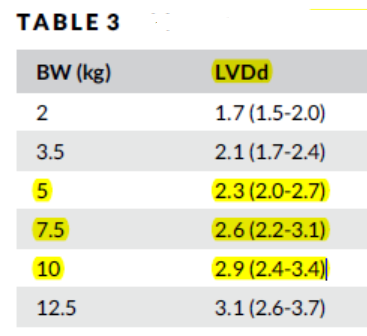 What
we find is that, for healthy cavaliers, the left ventricular diameter in
diastole (LVDd) measurement range in Table 3 of this article (at
left), for dogs weighing between 11 and 22 lbs. (5 and 10 kg.), is
quite accurate.
What
we find is that, for healthy cavaliers, the left ventricular diameter in
diastole (LVDd) measurement range in Table 3 of this article (at
left), for dogs weighing between 11 and 22 lbs. (5 and 10 kg.), is
quite accurate.
Also keep in mind that when a study limits its dogs to only those that have healthy hearts -- in other words, none have any enlargement -- the study cannot tell what the tipping point measurement is between the normal-sized heart and the MVD-affected enlarged one is. So, while from this study, the examining veterinarian may conclude that a dog with a LVIDdN = 1.63 has a healthy heart, he cannot fairly conclude that a dog with a LVIDdN > 1.63 has an enlarged one. This is a big mistake cardiologists make when applying the 2019 ACVIM Consensus Statement cut-point measurements. They assume, without any factual basis at all, that any dog with heart measurements which exceed the two echo cut-points in that study (LA:Ao < 1.6 and LVIDdN < 1.7) must necessarily have an enlarged heart. In human medicine, that leap of faith could be called malpractice.
At least, in this current study, the authors grudgingly acknowledge that:
"Studying a presumably healthy sample of a population is the most commonly utilized statistical approach to establishing reference intervals. ... However, this procedure has the disadvantage of misclassifying some healthy individuals as abnormal due to physiologic variations. If, for example, reference ranges were calculated using dogs considered to be normal applying Cornell's PIs, the reference range would be diminished by 2.5% at each end and a larger number of dogs would incorrectly be categorized as abnormal." (Emphais added.)
Interestingly, two of these authors also authored the EPIC Study report, in which only a single, arbitrary species-wide measurement (LVDdN = 1.70) was used to diagnose enlarged left ventricles in 354 MVD-affected dogs. So, their concern about incorrectly categorizing enlargement versus non-enlargement appears to be of only recent heritage. The bottom line remains: each patient should be examined as an individual and not by using species-wide standardized measurements which can result in mis-diagnosing MVD-affected dogs as either having or not having enlarged hearts. Ideally, baseline x-rays or echos should be compared with current ones to detect any increase in left ventricle diameters during the interim.
September 2020:
ACE-inhibitor ramipril has no beneficial effect in treating
MVD-dogs with congestive heart failure.
 In a
September 2020 article, a team of German and Swiss researchers
(Gerhard Wess [right], Jan-Gerd Kresken, Ralph Wendt, Juliane
Gaugele, Markus Killich, Lisa Keller, Julia Simak, Peter Holler,
Alexander Bauer, Helmut Küchenhof, Tony Glaus) compared treating
MVD-affected dogs in congestive heart failure (CHF - Stage C) with and
without the ACE-inhibitor ramipril. They divided 158 dogs (only 8
cavaliers - 5%) diagnosed with MVD and in CHF into two groups. Group DT
(double therapy) consisted of 77 dogs (including 4 cavaliers - 5%)
treated with furosemide (Lasix) and pimobendan (Vetmedin). Group TT
(triple therapy) included 79 dogs (4 CKCSs - 5%) treated also with
ramipril. They hypothesized that the addition of the ACE-inhibitor would
extend the survival time compared to the double therapy group. They
found the opposite and concluded:
In a
September 2020 article, a team of German and Swiss researchers
(Gerhard Wess [right], Jan-Gerd Kresken, Ralph Wendt, Juliane
Gaugele, Markus Killich, Lisa Keller, Julia Simak, Peter Holler,
Alexander Bauer, Helmut Küchenhof, Tony Glaus) compared treating
MVD-affected dogs in congestive heart failure (CHF - Stage C) with and
without the ACE-inhibitor ramipril. They divided 158 dogs (only 8
cavaliers - 5%) diagnosed with MVD and in CHF into two groups. Group DT
(double therapy) consisted of 77 dogs (including 4 cavaliers - 5%)
treated with furosemide (Lasix) and pimobendan (Vetmedin). Group TT
(triple therapy) included 79 dogs (4 CKCSs - 5%) treated also with
ramipril. They hypothesized that the addition of the ACE-inhibitor would
extend the survival time compared to the double therapy group. They
found the opposite and concluded:
"In conclusion, the addition of an ACEI [ACE-inhibitor] to pimobendan and a diuretic, as recommended in the ACVIM guidelines for the treatment of chronic stage C MMVD, did not have a significant effect on survival time in dogs with CHF caused by MMVD. Therefore, recommending TT as standard treatment for such dogs does not seem justified."
Indeed, the results of this study showed that not including ramipril extended the average survival time by 41 days longer than adding the ACE-inhibitor to the treatment cocktail. In effect, ramipril caused the MVD to progress more rapidly than just treating with a diuretic and pimobendan. (See also this June 2017 article below.) Also, their enlarged left atrium minimum reference interval was LA/Ao > 1.5. They explained:
"Our inclusion criteria followed those of the QUEST study, and therefore the LA/Ao ratio had to be >1.5. However, this cutoff would not likely prove a moderate or marked degree of mitral regurgitation typical of advanced MMVD. Likewise, the lower IQR of the LA/Ao ratio in our study was 2.0, consistent with advanced disease."
(See, also this January 2021 item above regarding an exchange of letters to the editor about this article.)
EDITOR'S NOTE: No surprise here, based upon the results of several other studies showing disappointment in the expectations of ACE-inhibtors, both before and after MVD-dogs reach heart failure. It is interesting that while the study was limited to ramipril, the investigators concluded that no ACE-inhibitors (others including enalapril and benazepril) would have any significant effect, and that there is no justification in adding any ACE-inhibitor to the treatment of dogs which have reached Stage C.
One other interesting point is their observation that their inclusion data, requiring a left atrium cut off measurement of LA/Ao > 1.5 as a species-wide definition of left atrial enlargement, was too low to prove even moderate mitral regurgitation. In doing so, they write that they were only mimicking the inclusion requirements of the 2008 QUEST Study (in which benazepril alone was shown to be relatively ineffective in treating CHF dogs when compared to pimobendan alone). They concluded that a much higher minimum LA/Ao ratio of 2.0 was consistent with advanced MVD. Recall that the EPIC Study and its pathetic tag-along-buddy, the 2019 ACVIM Consensus Statement, both insist that any MVD-affected dog with an LA/Ao ratio of at least 1.6 must have an enlarged left atrium. This current article rightly discounts any merit to such an arbitrary, species-wide definition of left atrial enlargement.
The primary usefulness of ACE-inhibitors remains as a placebo for the dogs' owners and even for some cardiologists who are so intellectually lazy as to not bother to read the applicable veterinary literature.
September 2020:
Three-week Danish study of CoQ10 in MVD-affected
cavaliers shows no significant improvement.
 In a
September 2020 article, a team of Danish investigators
(Liselotte B. Christiansen [right], Malene K. Morsing, Maria Josefine
Reimann, Torben Martinussen, Zita Birlie, Anne Marie V. Schou-Pedersen,
Jens Lykkesfeldt, Lisbeth H. Olsen) conducted a 3-week study of 18
cavalier King Charles spaniels (CKCS) diagnosed with mitral valve
disease (MVD) in either Stage B2 or Stage C, to determine the
pharmacokinetics* of repeated oral dosing of the ubiquinone form of
CoQ10, and to evaluate echocardiographic parameters, circulating cardiac
biomarkers, and quality of life (QoL) after treatment. The dose was 100
mg given orally twice a day in a placebo-controlled trial. They found
that a 3-week period of treatment with CoQ10 did not significantly
improve echocardiographic indices of MVD severity, circulating cardiac
biomarkers, or owner perceived QoL, compared to the placebo. The
concluded:
In a
September 2020 article, a team of Danish investigators
(Liselotte B. Christiansen [right], Malene K. Morsing, Maria Josefine
Reimann, Torben Martinussen, Zita Birlie, Anne Marie V. Schou-Pedersen,
Jens Lykkesfeldt, Lisbeth H. Olsen) conducted a 3-week study of 18
cavalier King Charles spaniels (CKCS) diagnosed with mitral valve
disease (MVD) in either Stage B2 or Stage C, to determine the
pharmacokinetics* of repeated oral dosing of the ubiquinone form of
CoQ10, and to evaluate echocardiographic parameters, circulating cardiac
biomarkers, and quality of life (QoL) after treatment. The dose was 100
mg given orally twice a day in a placebo-controlled trial. They found
that a 3-week period of treatment with CoQ10 did not significantly
improve echocardiographic indices of MVD severity, circulating cardiac
biomarkers, or owner perceived QoL, compared to the placebo. The
concluded:
"In conclusion, we show that a gelatin capsule formulation of solubilized Q10 is well tolerated in CKCS with MMVD and is absorbed into the circulation without adverse reactions. There were, however, inter-individual variations in the plasma concentrations with this formulation of Q10 similarly to findings in humans. A dosage of 200 mg/day for three weeks of Q10 does not appear to change the clinical severity of MMVD or QoL in CKCS. The estimated T1/2 of 2.95 days may suggest that every other day treatment in dogs may suffice to keep circulating concentrations of Q10 > 2.0 µg/mL in dogs. The variation in Q10 plasma concentrations observed among the CKCS suggests initiation of studies investigating the physiological factors determining intestinal absorption of Q10, including dosing and feeding regimens. ...Ultimately, investigation of long-term use of Q10 in dogs with MMVD and heart diseases of other etiologies are therefore relevant -- preferably with dosing tailored in accordance with laboratory testing of Q10 plasma concentrations."
* Pharmacokinetics is the study of the movement of drugs in the body, including the processes of absorption, distribution, localization in tissues, biotransformation, and excretion.
 EDITOR'S
NOTE: Unpacking this, despite the headline, the bottom
line is not discouraging. True, no success was observed in delaying or
reversing the progress of MVD. But, it was only a three-week trial, and
the main goals were to observe what goes on inside the dog's body as it
consumes the CoQ10. Also, we can learn from the dosage information: 100
mg. of a gelatin capsule formulation of solubilized ubiquinone, twice a
day. However, note that there is not yet a recommended dosage, and that
the investigators call for dosing to conform with testing of plasma
concentrations of the supplement.
EDITOR'S
NOTE: Unpacking this, despite the headline, the bottom
line is not discouraging. True, no success was observed in delaying or
reversing the progress of MVD. But, it was only a three-week trial, and
the main goals were to observe what goes on inside the dog's body as it
consumes the CoQ10. Also, we can learn from the dosage information: 100
mg. of a gelatin capsule formulation of solubilized ubiquinone, twice a
day. However, note that there is not yet a recommended dosage, and that
the investigators call for dosing to conform with testing of plasma
concentrations of the supplement.
August 2020:
Italian echocardiographic evaluation of mitral valves of 90 cavaliers shows disturbing statistics.
 In an
August 2020 article, a team of Univerisity of Milan researchers
(Mara Bagardi [right], Arianna Bionda, Chiara Locatelli, Matteo
Cortellari, Stefano Frattini, Alessio Negro1, Paola Crepaldi, Paola
Giuseppina Brambilla)
analyzed the echocardiographic features of cavalier King Charles
spaniels affected by mitral valve disease (MVD or MMVD). Sixty-two (69%)
of the 90 dogs were owned by breeders; the remaining 28 (31%) were pets.
The dogs were examined from December 2018 through September 2019. The
team made measurements of the mitral valves' anterior leaflets and
annulus of cavaliers at different stages of MVD. Due to the low numbers
of dogs in Stages B2 and C/D, they confined most of their statistically
significant results to Stage B1 dogs. For example, in Stage B1
cavaliers, they found that the diameter of the mitral valve annulus and
the thickness and area of the anterior mitral valve leaflet and the
sphericity of the left ventricle, are greater in older MVD-affected
dogs.
In an
August 2020 article, a team of Univerisity of Milan researchers
(Mara Bagardi [right], Arianna Bionda, Chiara Locatelli, Matteo
Cortellari, Stefano Frattini, Alessio Negro1, Paola Crepaldi, Paola
Giuseppina Brambilla)
analyzed the echocardiographic features of cavalier King Charles
spaniels affected by mitral valve disease (MVD or MMVD). Sixty-two (69%)
of the 90 dogs were owned by breeders; the remaining 28 (31%) were pets.
The dogs were examined from December 2018 through September 2019. The
team made measurements of the mitral valves' anterior leaflets and
annulus of cavaliers at different stages of MVD. Due to the low numbers
of dogs in Stages B2 and C/D, they confined most of their statistically
significant results to Stage B1 dogs. For example, in Stage B1
cavaliers, they found that the diameter of the mitral valve annulus and
the thickness and area of the anterior mitral valve leaflet and the
sphericity of the left ventricle, are greater in older MVD-affected
dogs.
Their report provides some interesting current statistics regarding MVD-affected cavaliers in Italy:
• 90 CKCSs were included in the study
• 62 dogs (69%) owned by breeders
• 81 dogs (90%) had MVD
• 9 dogs (10%) were in ACVIM Stage A
• 64 dogs (71%) were in ACVIM Stage B1
• 11 dogs (12%) were in ACVIM Stage B2
• 6 dogs (7%) were in ACVIM Stage C or D
• 53 dogs (59%) had audible murmurs
• 28 dogs in Stage B1 (44%) had no audible murmur
• 50% of dogs under age 2 years had MVD
 EDITOR'S
NOTE: These researchers used the
2019 version of the ACVIM
definitions of Stages B1 and B2, which means that if the MVD-affected
dog has an enlarged left atrium or an enlarged
left venticle but not both, then the dog is
classified in Stage B1, regardless of the fact that the dog really does
have an enlarged heart. It also means that the dog is placed in Stage B2
even if it has a normal-sized heart if the measurements of the two
left-side chambers meet a set of arbitrary dimensions (LA/Ao = 1.6 and
LVIDDN = 1.7).
EDITOR'S
NOTE: These researchers used the
2019 version of the ACVIM
definitions of Stages B1 and B2, which means that if the MVD-affected
dog has an enlarged left atrium or an enlarged
left venticle but not both, then the dog is
classified in Stage B1, regardless of the fact that the dog really does
have an enlarged heart. It also means that the dog is placed in Stage B2
even if it has a normal-sized heart if the measurements of the two
left-side chambers meet a set of arbitrary dimensions (LA/Ao = 1.6 and
LVIDDN = 1.7).
As nonsensical as these 2019 ACVIM definitions are, they are the rules of the echo-games being played by veterinary cardiologists these days. So, the bottom line of this data is that we don't know which of these Stage B1 dogs actually do not have enlarged hearts and which of these Stage B2 dogs really do have enlarged hearts. From a diagnostical standpoint, the information which these researchers have garnered is scientifically worthless.
August 2020:
Swedish researchers find a weak correlation between MVD severity
and catestatin peptide concentrations.
 In an
August 2020 article, a team of Swedish veterinary cardiologists and
geneticists (Katja Hoglund [right], Jens Haggstrom, Odd Viking Hoglund,
Mats Stridsberg, Anna Tidholm, Ingrid Ljungvall) investigated whether
plasma concentrations of the peptides catestatin and vasostatin were
associated with the severity of mitral valve disease (MVD) in 67 dogs of
undisclosed breeds, including 20 without MVD and the remaining 47 having
various degrees of MVD. Estimations of MVD severity were determined by
the LA/Ao ratio and mitral regurgitation percentage (MR%). They assumed
that any dog with an LA/Ao below 1.5 and minimal MR% had no enlargement
and was healthy, and
that a combination of a higher LA/Ao ratio and higher MR% determined the
severity of the dog's MVD and enlargement. The degree of MVD was classified by a
combination of the dog's LA/Ao ratio and its MR% as:
In an
August 2020 article, a team of Swedish veterinary cardiologists and
geneticists (Katja Hoglund [right], Jens Haggstrom, Odd Viking Hoglund,
Mats Stridsberg, Anna Tidholm, Ingrid Ljungvall) investigated whether
plasma concentrations of the peptides catestatin and vasostatin were
associated with the severity of mitral valve disease (MVD) in 67 dogs of
undisclosed breeds, including 20 without MVD and the remaining 47 having
various degrees of MVD. Estimations of MVD severity were determined by
the LA/Ao ratio and mitral regurgitation percentage (MR%). They assumed
that any dog with an LA/Ao below 1.5 and minimal MR% had no enlargement
and was healthy, and
that a combination of a higher LA/Ao ratio and higher MR% determined the
severity of the dog's MVD and enlargement. The degree of MVD was classified by a
combination of the dog's LA/Ao ratio and its MR% as:
Healthy (no MVD): LA/Ao <1.5 and no or minimal MR%;
Mild MVD: LA/Ao ≤1.5 and MR% <30%;
Moderate MVD: LA/Ao <1.8 and MR% ≤50%;
Severe MVD: LA/Ao >1.8 and MR% >50%.
They found that catestatin had only weak associations with left chamber sizes and blood pressure, and that vasostatin had no significant association with either.
EDITOR'S NOTE: Once again we find supposedly intelligent and diligent veterinary cardiologists trying to squeeze all dogs of all breeds into one formula for classifying whether each dog's left atrium is enlarged or not. This time the cut-point between normal-sized hearts of healthy dogs and enlarged hearts of the MVD-affected is a LA/Ao ratio of 1.5. In other recently published studies that cut-point has been 1.6 and 1.7. In none of these studies have any of the investigators furnished any data to support their cut-points. They just make them up and pretend they can divine whether a dog has an enlarged left atrium or not by applying this arbitrary, species-wide ratio parameter. And, they are flat wrong, of course. For example, we know of cavaliers with LA/Ao <1.4 (and even <1.32) which have enlarged left atriums, and in a recently published study, dogs with LA/Ao ratios above 1.7 had no enlargement. Surely these investigators know of such data, too.
And, once again, when they make this baseless assumption of enlargement, their study fails to produce the helpful results they had expected. The science of garbage-in-garbage-out prevails again. The only redeeming value to this study is that the investigators have added the percentage of mitral regurgitation (MR%) to their otherwise arbitrary definitions of the enlargement categories. MR% is a potentially legitimate species-wide means of measuring the severity of MVD.
August 2020:
Maker's CARPODIEM study of the diuretic torasemide finds it
superior to furosemide in treating heart failure in MVD-affected dogs.
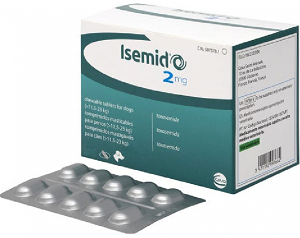 In
an
August 2020 article, a team of employees (Beatrice Besche, Thomas
Blondel, Emilie Guillot, Catherine Garelli‐Paar) of Ceva Sante Animale,
manufacturer of torasemide (brand name Isemid), along with PennVet
cardiologist Mark A. Oyama, compared the diuretic to furosemide in a
study of 319 MVD-affected dogs diagnosed with new onset congestive heart
failure (CHF), including 52 (16.3%) cavalier King Charles spaniels.
Their study is titled CARPODIEM, and their aim was to evaluate the
efficacy and safety of torasemide compared to furosemide in treating
CHF. They report finding that torasemide was superior to furosemide in
that it required only once-daily dosing, resulting in increased owner
compliance, and also that torasemide had less than half the risk of
cardiac death or euthanasia or worsening of CHF than did furosemide.
They emphasized that monitoring of the dogs' reactions, hydration
status, renal function, and serum electrolyte concentrations should be
performed when using any diuretic.
In
an
August 2020 article, a team of employees (Beatrice Besche, Thomas
Blondel, Emilie Guillot, Catherine Garelli‐Paar) of Ceva Sante Animale,
manufacturer of torasemide (brand name Isemid), along with PennVet
cardiologist Mark A. Oyama, compared the diuretic to furosemide in a
study of 319 MVD-affected dogs diagnosed with new onset congestive heart
failure (CHF), including 52 (16.3%) cavalier King Charles spaniels.
Their study is titled CARPODIEM, and their aim was to evaluate the
efficacy and safety of torasemide compared to furosemide in treating
CHF. They report finding that torasemide was superior to furosemide in
that it required only once-daily dosing, resulting in increased owner
compliance, and also that torasemide had less than half the risk of
cardiac death or euthanasia or worsening of CHF than did furosemide.
They emphasized that monitoring of the dogs' reactions, hydration
status, renal function, and serum electrolyte concentrations should be
performed when using any diuretic.
August 2020:
Dr. Uechi summarizes current successful mitral valve surgical
techniques.
 In
an
August 2020 article, Japanese veterinary surgeons Masashi Mizuno and
Masami Uechi (right) summarize their current techniques of
surgical repairs to dogs' mitral valves. They state that, "High survival
rates can be expected in dogs if the appropriate surgery is performed."
They have found that optimal timing of the surgery does not depend upon
the stage of the MVD.
In
an
August 2020 article, Japanese veterinary surgeons Masashi Mizuno and
Masami Uechi (right) summarize their current techniques of
surgical repairs to dogs' mitral valves. They state that, "High survival
rates can be expected in dogs if the appropriate surgery is performed."
They have found that optimal timing of the surgery does not depend upon
the stage of the MVD.
They describe each part of the mitral valve and how it is repaired. These parts include the septal (anterior) leaflet, the mural (posterior) leaflet, the chordae tendineae (chords), and the papillary muscle. The septal leaflet is repaired by inserting 4 to 8 pairs of artificial chords. If the septal leaflet needs additional work, suture techniques are used to lengthen and straighten it. The mural leaflet is repaired by adding 1 or 2 pairs of artificial chords and if necessary, sutures. Obtaining the normal shape of the mitral valve "is crucial", and that is done by mitral annuloplasty -- inserting a ring around the valve. Common complications include thrombus (blood clot) and hematoma (the collection of blood outside of a blood vessel). The authors suggest that dogs may be more susceptible than humans to thrombus formation upon exposure to prosthetics. A continuous suture method with ePTFE sutures is used, and exposure of blood to artifical surfaces is limited. They state that "Recently, however, the incidence of thrombosis in annuloplasty by mitral annuloplasty using continuous suture with ePTFE sutures has decreased to approximately 5%."
Hematoma of the left ventricular wall is a critical post-surgical complication. Hematoma may cause premature ventricular contraction, low blood pressure and, in some cases it can lead to death. Although the cause remains unknown, they say that it is reasonable to suspect that ventricular extrasystoles and the persistence of hypotension after the surgery are caused by left intraventricular hematoma. In left intraventricular hematoma with a significant decrease in blood pressure, left ventricular function can be recovered by reopening the heart and making an incision in the hematoma to reduce its size. Hematomas that do not affect blood pressure shrink in several days to several weeks. Other complications could include respiratory failure, anemia, and renal failure.
July 2020:
Dr. James Buchanan, MVD-in-cavaliers pioneer, has died.
 Dr. James Buchanan
(right), board
certified veterinary cardiologist at the University of Pennsylvania's
PennVet school, died on July 20, 2020 at the age of 85. He led a rich
and fulfulled life, both personally and professionally. He was the first
American veterinary cardiologist to focus attention and research upon
mitral valve disease in the cavalier King Charles spaniel. He started a
series of heart clinics at cavalier shows sponsored by the Cavalier King
Charles Spaniel Club, USA (CKCSC,USA) in the late 1980s and early 1990s to
stethoscopically listen to the dogs' hearts for murmurs over their
mitral valves. His first report on the results of that research,
"Chronic Mitral Valve Disease in Cavalier King Charles Spaniels: 95
Cases (1987-1991)", was published in 1993. In that article, he reported
this news, which was shocking at that time but now is common knowledge:
Dr. James Buchanan
(right), board
certified veterinary cardiologist at the University of Pennsylvania's
PennVet school, died on July 20, 2020 at the age of 85. He led a rich
and fulfulled life, both personally and professionally. He was the first
American veterinary cardiologist to focus attention and research upon
mitral valve disease in the cavalier King Charles spaniel. He started a
series of heart clinics at cavalier shows sponsored by the Cavalier King
Charles Spaniel Club, USA (CKCSC,USA) in the late 1980s and early 1990s to
stethoscopically listen to the dogs' hearts for murmurs over their
mitral valves. His first report on the results of that research,
"Chronic Mitral Valve Disease in Cavalier King Charles Spaniels: 95
Cases (1987-1991)", was published in 1993. In that article, he reported
this news, which was shocking at that time but now is common knowledge:
"The prevalence [of MVD murmurs] ranged from 9% in dogs < 1 year old to 100% in those > or = 10 years old; prevalence was 56% in dogs > or = 4 years old."
He devised the vertebral heart score (VHS) t0 measure the enlargement of MVD-affected dogs' hearts as MVD progressed. Ths VHS method remains the gold standard for objectively detecting left-sided heart enlargement due to MVD, by comparing a baseline VHS value with a later one. He introduced the MVD Breeding Protocol to the CKCSC,USA breeders at a symposium in May 1998. He continued his focus on MVD in our breed and others for the rest of his life. He was scheduled to conduct a heart clinic this coming October in Pennsylvania. His obituary is linked here.
July 2020:
PennVet cardiologists strike out in effort to line up VHS
and VLAS measurements to EPIC Study definition of MVD heart enlargement.
 In a July 2020 article, a team of University of Pennsylvania
cardiology researchers (Megan H. Poad, Timothy J. Manzi, Mark A. Oyama,
Anna R. Gelzer [right]) studied the x-rays and echocardiograms of 70
MVD-affected dogs of as many as 42 different breeds and mixed breeds*,
including 12 (17%) cavalier King Charles spaniels, to determine if
vertebral heart score (VHS) and vertebral left atrial size (VLAS) could
predict left heart enlargement as determined by echocardiograms
(their short-hand for that is "LHE[ECHO]"). They used the
EPIC Study's species-wide echocardiographic
definition of heart enlargement (meaning each dog must have both a left
atrium LA:Ao >1.6 and a left ventricle LVIDDN >1.7 for that dog to be
considered to have left-sided enlargement) to define LHE[ECHO]. They
acknowledged their failure by concluding:
In a July 2020 article, a team of University of Pennsylvania
cardiology researchers (Megan H. Poad, Timothy J. Manzi, Mark A. Oyama,
Anna R. Gelzer [right]) studied the x-rays and echocardiograms of 70
MVD-affected dogs of as many as 42 different breeds and mixed breeds*,
including 12 (17%) cavalier King Charles spaniels, to determine if
vertebral heart score (VHS) and vertebral left atrial size (VLAS) could
predict left heart enlargement as determined by echocardiograms
(their short-hand for that is "LHE[ECHO]"). They used the
EPIC Study's species-wide echocardiographic
definition of heart enlargement (meaning each dog must have both a left
atrium LA:Ao >1.6 and a left ventricle LVIDDN >1.7 for that dog to be
considered to have left-sided enlargement) to define LHE[ECHO]. They
acknowledged their failure by concluding:
"In summary, the radiographic VHS is clinically useful in identifying LHE[ECHO] in dogs with preclinical MMVD, but is limited by a substantial proportion of dogs with indeterminate VHS values. Radiographic measures of LA size such as VLAS possessed low correlation to echocardiographic LA size and did not significantly contribute to detection of LHE[ECHO] in comparison to use of VHS alone in dogs with preclinical MMVD."
*Based upon the sketchy data included in the article, it is not possible to determine how many breeds and mixed-breeds were included in the study. At most it could have been 42 different breeds and mixed-breeds out of a total of 70 dogs. Excluding the 12 cavaliers (17%), that would amount to 58 dogs of 41 breeds.
 EDITOR'S NOTE: The investigators appear to start out with sensible
intentions. They state that:
EDITOR'S NOTE: The investigators appear to start out with sensible
intentions. They state that:
"The primary objective of this study was to evaluate the ability of VHS and VLAS to predict echocardiographic criteria for left heart enlargement (LHE[ECHO]) in dogs with preclinical MMVD. We hypothesized that radiographic measurements would predict LHE[ECHO] and would help determine severity of disease in dogs with preclinical MMVD. We aimed to identify clinically relevant values of VHS, VLAS, and sum of VHS + VLAS that predicted presence and absence of LHE[ECHO]."
In other words, they wanted to compare the echocardiographic measurements of enlarged hearts with x-ray measurements, to see if the x-ray measurements would predict the echo measurements. But then they never bother to determine whether the dogs really do have enlarged hearts. Instead, they pretend that if the dogs' echo measurements of their left atriums and left ventricles exceed a certain pair of arbitrary, species-wide linear measurements, those dogs necessarily must have enlarged hearts. Here is how they describe their little fantasy:
"Dogs were divided into 2 groups based on whether or not echocardiographic criteria for left heart enlargement (LHE[ECHO]), namely LVIDDN >1.7 and LA:Ao >1.6, were met. Dogs in group 1 failed to meet either or both LHE[ECHO] criteria. Dogs in Group 2 met both LHE[ECHO] criteria."
They falsely assume that all normal-sized left atriums never have a LA:Ao ratio of 1.6 or higher and that all normal-sized left ventricles never have a LVIDDN of 1.7 or higher. Not only that, but they refuse to accept the obvious fact that a MVD-affected dog could have an enlarged left atrium and a normal-sized left ventricle (or vice versa). To them, if both left-side chambers are not enlarged (that is, exceed their two arbitrary cut points), then the dog's heart is not enlarged at all. In short, these investigators no longer are practicing veterinary cardiology; they are playing echo games on their computers.
Because of this game-playing, their findings were predictably disappointing. For instance:
• It was useless to try to establish a species-wide VHS minimum cut-off for LHE[ECHO]. They concluded that "further study is required to determine the utility of breed-specific cutpoints of VHS for identifying LHE[ECHO] in dogs with MMVD." Here, they blame the x-ray measurements for not being breed-specific when in fact they should be blaming their bogus, species-wide echo measurements.
• Using the VLAS method to measure left atrium size "did not significantly contribute to detection of LHE[ECHO]". Of course it didn't; when you start out with a completely bogus, species-wide definition of LHE[ECHO], you are creating a garbage-in-garbage-out scenario.
At some point, hopefully very soon, these echo-game wizards are going to have to acknowledge that breed-specificity applies equally to both x-ray and echo measurements of heart enlargement, and also that when a MVD-affected dog has an enlarged left atrium but not an enlarged left ventricle, it nevertheless has an enlarged heart.
July 2020:
Canadian cardiology researchers evaluate the effect of heart
failure upon two echo variables in 45 MVD-affected dogs.
 In
a
July 2020 article, a team of Ontario Veterinary College cardiology
researchers (K.R.S. Morgan, G. Monteith, S. Raheb, M. Colpitts, Sonya
Fonfara [right]) examined 45 MVD-affected dogs, including 8
cavaliers (the breed with the most dogs in the study) to evaluate the
influence of congestive heart failure (CHF) upon the dogs'
echocardiographic variables. Of the 45 dogs, 22 were in CHF (Stage C)
and the other 23 were in Stage B2 (heart enlargement) or had been in CHF
but no longer were, due to medical treatment. All dogs had either
moderate or severe mitral regurgitation (MR). A secondary objective of
the study was to investigate the use of left ventricular early
inflow-outflow index (LVEIO) and L-waves as indicators of CHF. "Left
ventricular early inflow-outflow index" (LVEIO) is a set of
echocardiographic measurements which can quantify the severity of mitral
regurgitation (MR). "L-wave" is a measure of the mid-diastolic flow
across the mitral valve, using M-mode or Doppler echocardiography. The
absence of L-waves indicates a reduced risk of CHF. They report that "An
LVEIO of >13.26 was predictive of CHF with a sensitivity of 66% and
specificity of 73%." They concluded that LVEIO may be useful as a
predictive value for CHF, and that the absence of L-waves indicated a
reduced risk for CHF.
In
a
July 2020 article, a team of Ontario Veterinary College cardiology
researchers (K.R.S. Morgan, G. Monteith, S. Raheb, M. Colpitts, Sonya
Fonfara [right]) examined 45 MVD-affected dogs, including 8
cavaliers (the breed with the most dogs in the study) to evaluate the
influence of congestive heart failure (CHF) upon the dogs'
echocardiographic variables. Of the 45 dogs, 22 were in CHF (Stage C)
and the other 23 were in Stage B2 (heart enlargement) or had been in CHF
but no longer were, due to medical treatment. All dogs had either
moderate or severe mitral regurgitation (MR). A secondary objective of
the study was to investigate the use of left ventricular early
inflow-outflow index (LVEIO) and L-waves as indicators of CHF. "Left
ventricular early inflow-outflow index" (LVEIO) is a set of
echocardiographic measurements which can quantify the severity of mitral
regurgitation (MR). "L-wave" is a measure of the mid-diastolic flow
across the mitral valve, using M-mode or Doppler echocardiography. The
absence of L-waves indicates a reduced risk of CHF. They report that "An
LVEIO of >13.26 was predictive of CHF with a sensitivity of 66% and
specificity of 73%." They concluded that LVEIO may be useful as a
predictive value for CHF, and that the absence of L-waves indicated a
reduced risk for CHF.
July 2020:
USA study shows that left atrium-to-aortic root ratio
(LA/Ao) is the least reliable linear echo measurement of heart
enlargement of MVD-affected dogs.
 In
a
July 2020 article, University of California-Davis investigators
Weihow Hsue and Lance C. Visser (right) performed several
repeat echocardiographic scans of the left atriums (LA) of nine MVD-affected
dogs (two cavalier King Charles spaniels) to test the reliability of
repeat examinations by two echo operators. They measured both
2-dimensional (linear) and 3-dimensional (volume) distances of the LAs a
total of 12 times within a week. They determined that the LA/Ao ratio
was the most variable and least reliable of all linear measurements of
LA size. They stated: "The LA/Ao index was the only index for which
operator was shown to be a significant source of variablity." They also
noted that in their study, "We evaluated precision (reproducibility) of
echocardiographic indices of LA size, not accuracy." They did not
suggest how they could have evaluated the accuracy of their
measurements.
In
a
July 2020 article, University of California-Davis investigators
Weihow Hsue and Lance C. Visser (right) performed several
repeat echocardiographic scans of the left atriums (LA) of nine MVD-affected
dogs (two cavalier King Charles spaniels) to test the reliability of
repeat examinations by two echo operators. They measured both
2-dimensional (linear) and 3-dimensional (volume) distances of the LAs a
total of 12 times within a week. They determined that the LA/Ao ratio
was the most variable and least reliable of all linear measurements of
LA size. They stated: "The LA/Ao index was the only index for which
operator was shown to be a significant source of variablity." They also
noted that in their study, "We evaluated precision (reproducibility) of
echocardiographic indices of LA size, not accuracy." They did not
suggest how they could have evaluated the accuracy of their
measurements.
EDITOR'S NOTE: This study confirms the left atrium-to-aortic root ratio (LA/Ao) is an unreliable (indeed, the most unreliable) linear measurement for determining if a dog's left atrium is enlarged or not. Keep in mind that a one-time measurement of the LA/Ao ratio was the only index used in both the 2016 EPIC Study and the 2019 ACVIM Consensus Study to determine whether a dog's left atrium was enlarged. The EPIC Study used an arbitrary, species-wide cut-off ratio of 1.6 to distinguish between dogs with and without atrial enlargement, and the 2019 ACVIM Consensus Statement copy-catted it, recommending that the same 1.6 ratio be used to determine whether any dog of any breed has an enlarged left atrium.
Furthermore, in the EPIC Study, there were 36 different cardiologists doing the LA/Ao measurements of 354 different dogs, using 36 different ultrasound devices in 36 different clinics throughout the world. If the two investigators in this present study could not get consistent LA/Ao indicies using the same single machine, the chances of the 36 EPIC investigators obtaining 354 accurate measurements were between slim and none.
Ironically, one of the three lead investigators of the EPIC Study, Dr. Adrian Boswood, even admitted that false LA/Ao readings were the norm. He stated shortly after its publication that:
"Everyone knows you can get an inaccurate single measurement of left atrial to aortic ratio -- over-estimated. The dog goes on to treatment it didn't need."So, this current study confirms Dr. Boswood's candid admission and proves that both prior studies -- EPIC and ACVIM -- have based their definition of LA enlargement upon a totally unreliable echo measurement. The bottom line is that the EPIC Study's assumption that its LA/Ao measurements of its 354 dogs' atriums were accurate is not only arbitrary but also scientifically baseless.
July 2020:
Italian study finds vertebral left atrial size (VLAS) reference
interval between 1.4 and 2.2 for 80 healthy dogs.
 In a
July 2020 article, a team of Italian veterinary investigators
(Tommaso Vezzosi, Caterina Puccinelli, Rosalba Tognetti [right], Tina
Pelligra, Simonetta Citi) compared measuring the vertebral heart score
(VHS) method with the vertebral left atrial size (VLAS) method on x-rays
of 80 healthy dogs (including only one cavalier King Charles spaniel and
23 Chihuahuas [29%]) and also to determine VLAS reference intervals for
healthy dogs. They used right lateral x-rays and reported finding a
positive correlation between VHS and VLAS values and no effect of body
weight, sex, or age on VLAS. For the dogs in the study, the
investigators found that the median value of VLAS was 1.9, with a
reference interval of between 1.4 and 2.2. They concluded that VLAS was a repeatable
(meaning, different examiners reached the same measurements) method to
quantify left atrial size. The main limitation they acknowledged was
that:
In a
July 2020 article, a team of Italian veterinary investigators
(Tommaso Vezzosi, Caterina Puccinelli, Rosalba Tognetti [right], Tina
Pelligra, Simonetta Citi) compared measuring the vertebral heart score
(VHS) method with the vertebral left atrial size (VLAS) method on x-rays
of 80 healthy dogs (including only one cavalier King Charles spaniel and
23 Chihuahuas [29%]) and also to determine VLAS reference intervals for
healthy dogs. They used right lateral x-rays and reported finding a
positive correlation between VHS and VLAS values and no effect of body
weight, sex, or age on VLAS. For the dogs in the study, the
investigators found that the median value of VLAS was 1.9, with a
reference interval of between 1.4 and 2.2. They concluded that VLAS was a repeatable
(meaning, different examiners reached the same measurements) method to
quantify left atrial size. The main limitation they acknowledged was
that:
"[N]o brachycephalic "screw-tailed" breeds (eg, English Bulldog, French Bulldog, Pug, Boston terrier) were included. These breeds present a typical barrel-shaped thoracic conformation in comparison to other dogs, and a greater occurrence of thoracic vertebral body anomalies that could alter the measurement of vertebral-based methods. The reference interval for VLAS determined in this study may thus not be applicable to brachycephalic dogs."
 EDITOR'S
NOTE: These investigators assumed that if each dog's
echocardiogram showed its left-atrial-to-aorta ratio (LA/Ao) was below
1.6, that dog necessarily did not have an enlarged left atrium. Since
there were 80
dogs of 25 breeds and 17 mixed breeds, including the single cavalier,
there is no way that the researchers could be assured that none of those
dogs had an enlarged left atrium using that single cut-off LA/Ao
measurement of 1.6. It is one thing to assume that if any dog has an LA/Ao
above 1.6, that the dog possibly has an enlarged LA, but it is totally
bogus to assume that if the LA/Ao is below 1.6, the dog definitely does
not have an enlarged LA. The CKCS breed is the best example. We know
from a prior study of 166 cavaliers' LA/Ao measurements (Hansson
2002) that healthy cavaliers with normal-sized LAs had LA/Ao ratios
no higher than 1.27. This could mean that cavaliers with LA/Ao ratios as
low as 1.28 could have enlarged LAs. That value is way below this
study's cut-off of 1.6.
EDITOR'S
NOTE: These investigators assumed that if each dog's
echocardiogram showed its left-atrial-to-aorta ratio (LA/Ao) was below
1.6, that dog necessarily did not have an enlarged left atrium. Since
there were 80
dogs of 25 breeds and 17 mixed breeds, including the single cavalier,
there is no way that the researchers could be assured that none of those
dogs had an enlarged left atrium using that single cut-off LA/Ao
measurement of 1.6. It is one thing to assume that if any dog has an LA/Ao
above 1.6, that the dog possibly has an enlarged LA, but it is totally
bogus to assume that if the LA/Ao is below 1.6, the dog definitely does
not have an enlarged LA. The CKCS breed is the best example. We know
from a prior study of 166 cavaliers' LA/Ao measurements (Hansson
2002) that healthy cavaliers with normal-sized LAs had LA/Ao ratios
no higher than 1.27. This could mean that cavaliers with LA/Ao ratios as
low as 1.28 could have enlarged LAs. That value is way below this
study's cut-off of 1.6.
Ironically, the Hansson 2002 study, which was limited to CKCSs, is the only piece of veterinary literature these Italian investigators cite to justify their choice of 1.6 being the cut-off between normal and enlarged LAs in all 42 breeds of dogs. Using totally inapplicable citations to justify arbitrary and unproven species-wide reference intervals is becoming quite common among MVD researchers. It is a device known in scientific circles as intellectual fudging. In the 2016 EPIC Study article, three totally inapplicable citations (including the same Hansson 2002 article) were the only ones used to justify that study's bogus definition of enlarged hearts. So, when the investigators here make the assumption that any dog with a LA/Ao ratio below 1.6 necessarily does not have an enlarged LA, they are proceeding with ignorance at best and using the inapplicable citation to cover their tracks. But unfortunately, that is nothing new these days for canine MVD research.
June 2020:
Japanese researchers find vertebral left atrial size
(VLAS) cannot match echocardiographic measurements of ACVIM's 2019 Stage
B1 and Stage B2 definitions of MVD-affected dogs.
 In a
June 2020 article, a team of Japanese investigators (Shoma Mikawa
[right], Masayoshi Nagakawa, Haruka Ogi, Ryota Akabane, Yukari
Koyama, Atsushi Sakatani, Mizuki Ogawa, Hirosumi Miyakawa, Jin
Shigemoto, Tsuyoshi Tokuriki, Noriko Toda, Yuichi Miyagawa, Naoyuki
Takemura), present their findings and conclusions of a study which was
intended to to evaluate whether the relatively new vertebral left atrial
size (VLAS) protocol could classify dogs with mitral valve
disease (MVD) between ACVIM Stages B1 and B2. VLAS is a radiographic
(x-ray) method of measuring left atrial enlargement in MVD-affected
dogs. It is similar to the vertebral heart score (VHS) method of
measuring the width and height of the entire heart and comparing those
dimensions to the dog's vertebrae. The VLAS measures the size of only the left atrium (LA), based upon
lengths between locations
visible on x-rays of the exterior of the LA. Of the 97 dogs of 16 breeds
plus mixed breeds in this study, 9 were cavalier King Charles spaniels.
The most common breed was the Chihuahua with 27 dogs.
In a
June 2020 article, a team of Japanese investigators (Shoma Mikawa
[right], Masayoshi Nagakawa, Haruka Ogi, Ryota Akabane, Yukari
Koyama, Atsushi Sakatani, Mizuki Ogawa, Hirosumi Miyakawa, Jin
Shigemoto, Tsuyoshi Tokuriki, Noriko Toda, Yuichi Miyagawa, Naoyuki
Takemura), present their findings and conclusions of a study which was
intended to to evaluate whether the relatively new vertebral left atrial
size (VLAS) protocol could classify dogs with mitral valve
disease (MVD) between ACVIM Stages B1 and B2. VLAS is a radiographic
(x-ray) method of measuring left atrial enlargement in MVD-affected
dogs. It is similar to the vertebral heart score (VHS) method of
measuring the width and height of the entire heart and comparing those
dimensions to the dog's vertebrae. The VLAS measures the size of only the left atrium (LA), based upon
lengths between locations
visible on x-rays of the exterior of the LA. Of the 97 dogs of 16 breeds
plus mixed breeds in this study, 9 were cavalier King Charles spaniels.
The most common breed was the Chihuahua with 27 dogs.
To begin, in 2019, the ACVIM re-defined Stages B1 and B2 of MVD. Previously, Stage B1 meant the dog had a mitral valve murmur but no enlargement of its heart, and Stage B2 meant that the dog had both a murmur and enlargement. According to the 2019 ACVIM Consensus Statement, Stage B1 no longer means that the dog does not have any enlargement, and Stage B2 no longer means that the dog does have any enlargement. Instead, an MVD-dog of any breed now would be in ACVIM's 2019 version of Stage B2, regardless of whether its heart actually is enlarged, as long as its murmur grade is at least 3, and the measurement of its left atrial-to-aortic ratio (LA:Ao) is at least 1.6, and its normalized left ventricular internal diameter in diastole (LVIDDN) is at least 1.7, and its vertebral heart size (VHS) is higher than 10.5. Since there does not yet exist any published veterinary literature establishing these cut-offs as distinguishing between normal sized hearts and enlarged ones on a species-wide basis, for at least some and possibly many breeds these cut-offs are unrelated to whether or not the dogs' hearts are in fact enlarged. An MVD-dog is in ACVIM's 2019 version of Stage B1 if any one of its three measurements do not meet the minimum for Stage B2 dogs. In other words, a Stage B1 dog can have either an enlarged left artium (LA) or an enlarged left ventricle (LV), or it can have a very high VHS value, and still not be considered to have an enlarged heart, because it does not satisfy all three of those minimum measurements.
Because of this dilemma of having to meet all three of these minimum values to be classified in Stage B2, the researchers found that the VLAS method could not substitute for echocardiographic scans in distinguishing between dogs in Stages B1 and B2. Instead, they concluded that:
"Therefore, we propose that a VLAS cutoff value of 2.5 should be used to recommend echocardiography in order to identify whether MMVD in Stage B1 dogs has progressed to ACVIM Stage B2. All dogs included in the present study had previously been diagnosed with MMVD. Consequently, dogs not yet diagnosed with MMVD should have echocardiography performed regardless of the VLAS value."
 EDITOR'S NOTE:
This study unintentionally emphasizes that what the 2019 ACVIM
Consensus Statement panel has done is complete nonsense. To prove that
point, in
this study, dogs with LA/Ao ratios as high as 2.61 (meaning, their left
atriums were so large they were about to burst) were classified as being
in Stage B1 (meaning, not eligible for treatment with pimobendan). And, dogs with LVIDDN
measurements as high as 1.92 (way above the minimum enlargement size of
1.7) were classified in Stage B1 (meaning, no pimobendan).
Furthermore, dogs with VHS values as high as 13.6 (grossly enlarged
hearts in almost any breed by any standard) were classified as being in Stage
B1 (no pimobendan). And to top them all off, one of the dogs in heart
failure (Stage C) had a LA:Ao ratio as low as 1.31 (far below the 1.6
cut point), which shows that the dog went from Stage B1 directly to
Stage C, skipping right past Stage B2, only because 2019 ACVIM Consensus
Statement panel members refuse to acknowldge that an MVD-affected dog
can have an enlarged LA and not an enlarged LV and yet still have an
enlarged heart.
EDITOR'S NOTE:
This study unintentionally emphasizes that what the 2019 ACVIM
Consensus Statement panel has done is complete nonsense. To prove that
point, in
this study, dogs with LA/Ao ratios as high as 2.61 (meaning, their left
atriums were so large they were about to burst) were classified as being
in Stage B1 (meaning, not eligible for treatment with pimobendan). And, dogs with LVIDDN
measurements as high as 1.92 (way above the minimum enlargement size of
1.7) were classified in Stage B1 (meaning, no pimobendan).
Furthermore, dogs with VHS values as high as 13.6 (grossly enlarged
hearts in almost any breed by any standard) were classified as being in Stage
B1 (no pimobendan). And to top them all off, one of the dogs in heart
failure (Stage C) had a LA:Ao ratio as low as 1.31 (far below the 1.6
cut point), which shows that the dog went from Stage B1 directly to
Stage C, skipping right past Stage B2, only because 2019 ACVIM Consensus
Statement panel members refuse to acknowldge that an MVD-affected dog
can have an enlarged LA and not an enlarged LV and yet still have an
enlarged heart.
What does this mean? It means that, thanks to the 2019 ACVIM re-definitions of Stages B1 and B2, MVD-affected dogs with severely enlarged hearts will not be prescribed pimobendan to delay the onset of heart failure.
June 2020:
UK study using whole genome sequencing has identified variations
of cardiac genes in MVD-affected cavaliers.
 In
a
June 2020 abstract presented at the 2020 ACVIM Forum, Dr. Melanie
Hezzell (right) described a study at the University of Bristol,
England using whole genome sequencing to identify new genetic risk
variants of MVD genes in two catagories of cavalier King Charles
spaniels -- 6 CKCSs with early-onset MVD that had died due to congestive
heart failure (group C) and 6 cavaliers with late-onset MV that died due
to non-cardiac causes (group NC). The researchers identified 43 genetic
variants which were exclusively in group C cavaliers. A total of 103
significant variants were identified in all CKCS, and 539 variants were
at a higher frequency in group C compared to group NC. A follow-up study
is in progress using a larger cohort of cavaliers.
In
a
June 2020 abstract presented at the 2020 ACVIM Forum, Dr. Melanie
Hezzell (right) described a study at the University of Bristol,
England using whole genome sequencing to identify new genetic risk
variants of MVD genes in two catagories of cavalier King Charles
spaniels -- 6 CKCSs with early-onset MVD that had died due to congestive
heart failure (group C) and 6 cavaliers with late-onset MV that died due
to non-cardiac causes (group NC). The researchers identified 43 genetic
variants which were exclusively in group C cavaliers. A total of 103
significant variants were identified in all CKCS, and 539 variants were
at a higher frequency in group C compared to group NC. A follow-up study
is in progress using a larger cohort of cavaliers.
EDITOR'S NOTE: What could this mean? It could mean that there are identifiable genetic differences between cavaliers which develop MVD early in their lives (early-onset MVD) and die from that disease earlier than do other MVD-affected CKCSs. It could mean that, once these genetic differences are identified, a new MVD Breeding Protocol could be based upon DNA testing, and potential breeding stock with early-onset MVD genes could be withdrawn from breeding. It could mean, that if all of these things happen, future generations of cavaliers will live longer lives and not die from MVD.
June 2020:
U. of California-Davis researchers use higher species-wide
definition of LA/Ao enlargement than does 2019 ACVIM Consensus Statement.
 In a
June 2020 article, University of California - Davis researchers
(Lance C. Visser [right], James E. Wood, Lynelle R. Johnson)
compared right-sided heart size and function in dogs diagnosed with
pulmonary hypertension (PH) either with or without left-sided heart
disease (hence, mitral valve disease). Five cavaliers were included in
this study of 82 dogs, all with tricuspid regurgitation. The dogs were
divided into two categories: (a) PH secondary to MVD, and (b) PH not
secondary to MVD. Their species-wide "unequivocal" definition of left-atrial
enlargement was (1) left atrial‐to‐aortic root dimension (LA/Ao) >1.7,
and (2) left atrial dimension (LAD) normalized to bodyweight >1.6. (In
both the 2016 EPIC Study and the 2019 ACVIM Consensus Statement,
enlargement of the left atrium in MVD-affected dogs was defined as
LA/Ao >1.6, species-wide.) They found that right heart enlargement was
common among dogs with PH, and that right-sided ventricular function was
significantly worse in dogs with PH but without MVD than dogs with both
PH and MVD. they concluded that data about right heart size and function
are important in assessing the risk of death in dogs with PH.
In a
June 2020 article, University of California - Davis researchers
(Lance C. Visser [right], James E. Wood, Lynelle R. Johnson)
compared right-sided heart size and function in dogs diagnosed with
pulmonary hypertension (PH) either with or without left-sided heart
disease (hence, mitral valve disease). Five cavaliers were included in
this study of 82 dogs, all with tricuspid regurgitation. The dogs were
divided into two categories: (a) PH secondary to MVD, and (b) PH not
secondary to MVD. Their species-wide "unequivocal" definition of left-atrial
enlargement was (1) left atrial‐to‐aortic root dimension (LA/Ao) >1.7,
and (2) left atrial dimension (LAD) normalized to bodyweight >1.6. (In
both the 2016 EPIC Study and the 2019 ACVIM Consensus Statement,
enlargement of the left atrium in MVD-affected dogs was defined as
LA/Ao >1.6, species-wide.) They found that right heart enlargement was
common among dogs with PH, and that right-sided ventricular function was
significantly worse in dogs with PH but without MVD than dogs with both
PH and MVD. they concluded that data about right heart size and function
are important in assessing the risk of death in dogs with PH.
EDITOR'S NOTE: This article is interesting in that these researchers have chosen to use a higher measurement of the left atrial-to-aortic root ratio (LA/Ao) to define species-wide minimum left atrial enlargement than did the 2016 EPIC Study and the 2019 ACVIM Consensus Statement. Instead of the EPIC Study's LA/Ao >1.6, these investigators chose LA/Ao >1.7. They describe 1.7 as "unequivocal echocardiographic left atrial enlargement", suggesting that any lower ratio arguably may not be any enlargement at all.
So, what does this mean? It means that these cardiologists are hung up on the same notion as the EPIC and ACVIM crews that all dogs' hearts are the same size when they reach enlargement, but that they just cannot agree on what that size is. MVD-affected dogs remain the losers. The lead author of this study, Dr. Visser, confessed just last year that "breed-specific RIs [reference intervals] might offer advantages compared to normalizing by body size alone", but nonetheless, he rejected using them because, as he put it, "breed-specific RIs are impractical for all breeds and not applicable to mixed breed dogs." What he was saying then was that "We echo-happy technicians don't have the time or patience to determine if the dog on our table really does have an enlarged heart, or even rely upon certain breeds' previously published reference intervals, so we will pick an arbitrary number for all dogs and just go with that number." Crassness does not begin to describe this attitude.
Too many cardiologlists are so addicted to the echocardiograph that they seem to believe it can do anything - that it is the 'gold standard' above all other gold standards - and that if a single echo exam cannot tell them all they need to know about the condition of the patient on their table, then they'll just pretend it does, anyway. To them, radiographs (x-rays) are so '20th Century' that they refuse to recognize that x-rays can do what echos cannot; x-rays show whether the dog's heart has a normal shape - indicating a normal-sized heart - or is misshapen - indicating enlargement.
Here is the problem with their species-wide definitions: We know for a scientific fact from published, peer-reviewed veterinary literature that some dogs' left atriums (LAs) could be enlarged when the LA/Ao ratio is as low as 1.3, and that other dogs' LAs can be normal when their LA/Ao ratio is as high as 1.69, and that at the very least these variances depend upon the breed of the dog if not the individual patient. So, when an arbitrary LA/Ao is applied to all dogs of all breeds, some and perhaps many dogs will be mis-diagnosed as either having enlarged hearts when they actually do not, or not having enlarged hearts when the really do have them. Since enlargement is the main factor in determining when to medicate MVD-affected dogs prior to heart failure, if some breeds (such as the cavalier) have enlarged LAs at the LA/Ao ratio of 1.3, they will not be treated until their enlarged hearts keep getting bigger to reach LA/Ao of 1.6 or even sbove 1.7 (in the case of the definition in this particular study). Dogs of other breeds with normal sized LAs in the 1.6 to 1.7 range nevertheless will be medicated because the EPIC Study and the 2019 ACVIM Consensus Study assume those dogs with normal-sized LAs have enlarged hearts. Either way, the dogs are the losers, and the echo-addicted cardiologists move on to their next victims.
June 2020:
UK cardiologists outline 10 things vets need to know about
diuretics and MVD-dogs in heart failure.
 In a
May 2020 article, UK cardiologists Alex Laver and Dave Dickson
(right) describe ten important things which veterinarians need to know
about the MVD patients in heart failure and needing diuretics. Among the
items are these which are important for MVD-affected dog owners to know,
as well:
In a
May 2020 article, UK cardiologists Alex Laver and Dave Dickson
(right) describe ten important things which veterinarians need to know
about the MVD patients in heart failure and needing diuretics. Among the
items are these which are important for MVD-affected dog owners to know,
as well:
• When listening to the dog's lungs with a stethoscope, fluid in the lungs sounds "like Velcro unpeeling".
• Always take at least two x-ray views to look for fluid in the lungs, vascular congestion, and cardiac enlargement.
• The aim of diuretics is to prevent recurrence of uncompensated heart failure, and to control the clinical signs and slow progression of the MVD.
• Diuretics affect renal function and electrolyte balance, so checking those before starting and periodically during treatment is important.
• It is a misuse of diuretics to use them to treat dogs not yet in CHF, "so avoiding this is the most important step."
• Re-visits of dogs on diuretics generally should be at least every six months if their condition is stable.
• X-rays just before the next diuretic dose may highlight active pulmonary edema, indicating that an increased dose is needed.
 EDITOR'S
NOTE: We think all of this information is important,
particularly because we find so few general practice (GP) veterinarians
even knowing several of these things. One of the most glaring errors
many GP vets are making these days is assuming MVD-affected dogs with
coughs are in heart failure, and prescribing diuretics, without first
confirming that the dogs are in fact in CHF by obtaining x-rays. All too
often, GP vets start diuretic regimes which are not in heart failure at
all. As these authors point out: avoiding treating dogs with diuretics
which are not in CHF "is the most important step."
EDITOR'S
NOTE: We think all of this information is important,
particularly because we find so few general practice (GP) veterinarians
even knowing several of these things. One of the most glaring errors
many GP vets are making these days is assuming MVD-affected dogs with
coughs are in heart failure, and prescribing diuretics, without first
confirming that the dogs are in fact in CHF by obtaining x-rays. All too
often, GP vets start diuretic regimes which are not in heart failure at
all. As these authors point out: avoiding treating dogs with diuretics
which are not in CHF "is the most important step."
As a current example of the extent of pre-CHF treatment with diuretics, in a June 2020 article surveying MVD-affected dogs in Japan (discused at some length, above), the authors noted that nearly 10% of those dogs which were not yet in heart failure were being administered loop diuretics.
In a book published this month, Clinical Small Animal Internal Medicine Volume I, USA cardiologist Dr. Michele Borgarelli states, in Chapter 25:
"It should be stressed that cough is a general clinical sign of respiratory disease and its presence in a dog with a murmur is not an indicator for starting treatment for CHF."
This is advice which should not have to be given at all, much less stressed, to any general practice veterinarian. The fact that it has been, twice in one month, is but one more reason why we recommend that only cardiologists and internal medicine specialists prescribe medications for MVD-affected dogs.
May 2020:
Study of 582 MVD-affected dogs finds intact males have the
highest risk of heart enlargement.
 In an
April 2020 abstract
presented at the 2020 BSAVA Congress,
researchers Ana Margarida Silva, Elizabeth Bode, Joanna Dukes-McEwan,
Jorge Prieto-Ramos, and Rodolfo Oliveira Leal (right) reported studying 582 dogs
diagnosed with mitral valve disease (MVD) to determine if neutering
affects heart enlargement in MVD-affected dogs. They divided the dogs
into four groups -- female intact and neutered and male intact and
neutered. They obtained four echocardiographic measurements for each
dog, and found that un-neutered males had higher echo measurements
compared to neutered males, and that there were no significant
differences among females.
In an
April 2020 abstract
presented at the 2020 BSAVA Congress,
researchers Ana Margarida Silva, Elizabeth Bode, Joanna Dukes-McEwan,
Jorge Prieto-Ramos, and Rodolfo Oliveira Leal (right) reported studying 582 dogs
diagnosed with mitral valve disease (MVD) to determine if neutering
affects heart enlargement in MVD-affected dogs. They divided the dogs
into four groups -- female intact and neutered and male intact and
neutered. They obtained four echocardiographic measurements for each
dog, and found that un-neutered males had higher echo measurements
compared to neutered males, and that there were no significant
differences among females.
EDITOR'S NOTE: This abstract hopefully will be followed by a much more detailed article. Without more information, we find very little value to the conclusions about the males because we are not told: (1) what cut-off echo measurements were used to verify whether the dogs actually had any heart enlargement at all; and (2) whether intact and neutered males of the same breeds were compared, since it is well known that there are breed differences in normal-sized heart chamber measurements. If the researchers used species-wide cut-off measurememts to determine chamber enlargement, such as the EPIC Study's bogus LA:Ao = 1.6 and LVIDDN = 1.7, instead of breed-specific cut-offs, then they have been wasting their time and ours.
May 2020:
Dr. Kittleson questions the EPIC Study's findings of when its
MVD-affected dogs reached heart failure.
 In a
May 2020 letter to the editor, board certified veterinary
cardiologist Dr. Mark D. Kittleson (right) of the University of
California-Davis observed inconsistencies between the
EPIC Study's data
and its findings regarding when its dogs reached heart failure (CHF).
The main purpose of the EPIC Study was to determine how long it took its
over 300 dogs diagnosed with mitral valve disease (MVD) to reach heart
failure (Stage C of MVD), and of those dogs, how many were being treated
with pimobendan compared to the number being given a placebo. In their
March 2020 report, the EPIC Study authors acknowledged that:
In a
May 2020 letter to the editor, board certified veterinary
cardiologist Dr. Mark D. Kittleson (right) of the University of
California-Davis observed inconsistencies between the
EPIC Study's data
and its findings regarding when its dogs reached heart failure (CHF).
The main purpose of the EPIC Study was to determine how long it took its
over 300 dogs diagnosed with mitral valve disease (MVD) to reach heart
failure (Stage C of MVD), and of those dogs, how many were being treated
with pimobendan compared to the number being given a placebo. In their
March 2020 report, the EPIC Study authors acknowledged that:
"Previous studies have shown that RRR [resting respiratory rate] >30 breaths per minute in home environment or RR [respiratory rate] >40 breaths per minute in clinic environment are strong indicators for the presence of active CHF in MMVD dogs without any other important comorbidity."
Nevertheless, they ignored those previous studies by waiting until the RRR measurements reached 41 breaths per minute (bpm) and RR counts reached 49 bpm before declaring that the dogs had reached CHF. They wrote: "These increased from baseline values of approximately 31 and 23 per minute, respectively, to 49 and 41 per minute at the onset of CHF." The apparent reason the EPIC Study authors ignored the previous studies' findings regarding when RRR measurements defined CHF was in their September 2016 EPIC Study initial report, where they chose a much more complicated definition of CHF:
"A dog was considered to have left-sided CHF when there was radiographic evidence of cardiogenic pulmonary edema as indicated by an interstitial or alveolar lung pattern. In addition to these radiographic findings, the dog must have been showing contemporaneous clinical signs consistent with left-sided CHF including increased respiratory effort and rate by comparison with previously noted values for this patient."
In their March 2020 article, in which they published previously
undisclosed data on when they deterimined
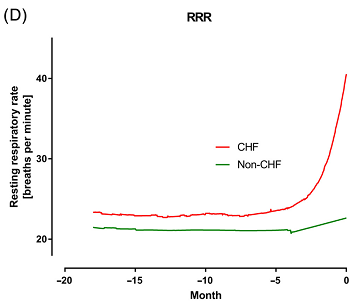 each dog reached CHF, the data
included a chart (Figure 3 D at left) showing that the CHF-dogs' resting
respiratory rates (RRR) began to increase as early as 5 months before
the EPIC investigators decided the dogs had reached CHF. Nevertheless,
the EPIC investigators relied upon the dogs' owners to become concerned
enough about their pets' deteriorating conditions to bring the dogs into
the clinics for examination before determining if they had reached CHF. The
EPIC investigators chose to define increases in RRR prior to those
clinic visits "as indicators of impending or incipient CHF", meaning not
yet in actual CHF. Dr. Kittleson takes issue with their conclusion that
increased RRR would be only "indicators of impending or incipient CHF"
and insists that the rise in RRR is, by itself, the most reliable
indicator that the dog already has reached CHF, because the rise in RRR is
caused by fluid presently in the lungs. He writes:
each dog reached CHF, the data
included a chart (Figure 3 D at left) showing that the CHF-dogs' resting
respiratory rates (RRR) began to increase as early as 5 months before
the EPIC investigators decided the dogs had reached CHF. Nevertheless,
the EPIC investigators relied upon the dogs' owners to become concerned
enough about their pets' deteriorating conditions to bring the dogs into
the clinics for examination before determining if they had reached CHF. The
EPIC investigators chose to define increases in RRR prior to those
clinic visits "as indicators of impending or incipient CHF", meaning not
yet in actual CHF. Dr. Kittleson takes issue with their conclusion that
increased RRR would be only "indicators of impending or incipient CHF"
and insists that the rise in RRR is, by itself, the most reliable
indicator that the dog already has reached CHF, because the rise in RRR is
caused by fluid presently in the lungs. He writes:
"In figure 3D, if one makes the logical assumption that the increase in RRR was caused by pulmonary edema, it seems clear to me that the dogs that were subsequently diagnosed with left heart failure had mild pulmonary edema for several weeks before their tachypnea and dyspnea becoming severe enough for the owner to notice a problem."
Dr. Kittleson concludes that:
"I believe these data clearly show that RRR/SRR is a more sensitive means of identifying pulmonary edema (left heart failure), presumably mild edema, in dogs with severe mitral regurgitation than are thoracic radiographs and clinical signs, such as tachypnea [abnormally rapid breathing] and dyspnea [shortness of breath], that are severe enough to be apparent to an owner. As such, in my opinion, an elevated RRR is not evidence of impending or incipient left heart failure but instead is the first clinical evidence that a dog is in left heart failure."
 EDITOR'S
NOTE: This is a blockbuster observation by Dr. Kittleson,
which effectively blows the EPIC Study's ultimate conclusion -- that
pimobendan can delay the onset of CHF "by approximately 15 months" --
completely out of the water!
EDITOR'S
NOTE: This is a blockbuster observation by Dr. Kittleson,
which effectively blows the EPIC Study's ultimate conclusion -- that
pimobendan can delay the onset of CHF "by approximately 15 months" --
completely out of the water!
Dr. K's comments suggest that the EPIC Study's findings and conclusions about the date when each dog "officially" reached heart failure (Stage C) are exaggerated by as much as 5 months (150+ days), according to the graph in Figure 3 D, which shows when the RRR began their ascent from a relatively horizontal line at an average of about 24 bpm to a roughly 5-month rise reaching above 41 bpm, all before the EPIC investigators even dared to actually declare the dogs in CHF.
This glaring contradiction between the EPIC Study's own data and
their investigators' methodology, findings, and conclusions is but one more reason why
their three published reports should be retracted and re-written to make
the findings match the data. The RRR data needs to be reviewed to
categorize into the two separate groups (pimobendan and placebo) the
dogs reaching CHF, so that an accurate determination of whether any days
at all, and if so, how many actual days, the dogs in the pimobendan
group outlasted the placebo dogs before reaching
 CHF. Of course, the
most glaring flaw has been that at the outset the EPIC Study authors
concocted a totally sham definition of heart enlargement for all of the
dogs, thereby inhibiting even the possibility of ever determining which
dogs, if any, really were in Stage B2 of MVD at the start of the study.
CHF. Of course, the
most glaring flaw has been that at the outset the EPIC Study authors
concocted a totally sham definition of heart enlargement for all of the
dogs, thereby inhibiting even the possibility of ever determining which
dogs, if any, really were in Stage B2 of MVD at the start of the study.
It is clear that the EPIC Study authors invented a completely baseless, species-wide definition of enlarged hearts, and then they compounded their unscientific approach to this study by inventing a completely baseless definition of heart failure. This entire "study" was a nonsensical setup from its beginning to its end. And yet, gullible veterinarians, including board certified cardiologists, have gobbled this nonsense up and are applying these bogus definitions and bogus conclusions to MVD-affected cavaliers all over the world.
May 2020:
Korean study finds that chest x-rays taken at full inhale and
full exhale can affect heart enlargement diagnoses.
 In a
May 2020 article, a team of Korean veterinary investigators (Saran
Chhoey, Sang-Kwon Lee, Hyejin Je, Jin-Woo Jung, Youjung Jang, Jihye Choi
[right]) compared
chest (thoracic) x-rays of MVD-affected dogs both at full inspiration
(inhalation) and full expiration (exhalation) when measuring the
apparent sizes of the dogs' hearts. The study included 20 beagles with
normal-sized hearts and 100 MVD-affected dogs of unidentified breeds. They measured the
vertebral heart score (VHS), vertebral left atrial size (VLAS), position
of the trachea, and bulging of the left atrium (LA), and appearance of
the left ventricle (LV). They compared this data to each dog's left
atrium to aorta echocardiographic ratio (LA/Ao). They concluded:
In a
May 2020 article, a team of Korean veterinary investigators (Saran
Chhoey, Sang-Kwon Lee, Hyejin Je, Jin-Woo Jung, Youjung Jang, Jihye Choi
[right]) compared
chest (thoracic) x-rays of MVD-affected dogs both at full inspiration
(inhalation) and full expiration (exhalation) when measuring the
apparent sizes of the dogs' hearts. The study included 20 beagles with
normal-sized hearts and 100 MVD-affected dogs of unidentified breeds. They measured the
vertebral heart score (VHS), vertebral left atrial size (VLAS), position
of the trachea, and bulging of the left atrium (LA), and appearance of
the left ventricle (LV). They compared this data to each dog's left
atrium to aorta echocardiographic ratio (LA/Ao). They concluded:
"In dogs with MR [mitral regurgitation], LA enlargement was subjectively more apparent when thoracic radiography was taken during the expiratory phase compared to the inspiratory phase. These findings supported the use of both inspiratory and expiratory radiographs for assessment of left heart enlargement in dogs with MR, although measures of LA enlargement in dogs with MR can be overestimated in expiratory radiographs."
 EDITOR'S
NOTE: This study reinforces the belief that the best time
to x-ray the dog's heart is when it has completed exhaling and before
starting to inhale. That is a reason that when humans are having chest
x-rays, the operator says, "Exhale and hold it." For dogs, however,
capturing the peak moment of full exhalation is not that easy,
especially for dogs not being restrained or sedated during the x-ray
procedure. Prior to digital x-rays, the instant the operator pressed the
button usually was also the instant the photo was taken. With some
digital x-rays, however, there may be a momentary pause between pushing
the button and capturing the photo. Thus, the operator's timing is
essential if full exhalation is to be captured. These investigators also
recommend capturing two full sets of x-rays, at full exhalation and also
at full inhalation, because one set could exaggerate the size of the
left atrium.
EDITOR'S
NOTE: This study reinforces the belief that the best time
to x-ray the dog's heart is when it has completed exhaling and before
starting to inhale. That is a reason that when humans are having chest
x-rays, the operator says, "Exhale and hold it." For dogs, however,
capturing the peak moment of full exhalation is not that easy,
especially for dogs not being restrained or sedated during the x-ray
procedure. Prior to digital x-rays, the instant the operator pressed the
button usually was also the instant the photo was taken. With some
digital x-rays, however, there may be a momentary pause between pushing
the button and capturing the photo. Thus, the operator's timing is
essential if full exhalation is to be captured. These investigators also
recommend capturing two full sets of x-rays, at full exhalation and also
at full inhalation, because one set could exaggerate the size of the
left atrium.
And, unfortunately, there is one other point, a glaring and totally unsubstatiated one, which we feel must be noted. The investigators assumed that the echocardiographic left-atrium-aorta ratio (LA/Ao) cutpoint between any normal-sized left atrium and any enlarged one for all 120 dogs of various (and unidentitied) breeds was LA/Ao > 1.5, based upon a single echo for each dog. This of course, is total nonsense on any scientific basis. There is absolutely no published veterinary literature to support any species-wide cutoff between normal and enlarged left artiums, much less at the low 1.5 figure. Even worse, these investigators dare to claim that this cutpoint is "the gold standard for LA enlargement." It reminds us of the humorous but also honest quip once made by noted theoretical physicist Richard Feynman: "Science is the belief in the ignorance of experts."
May 2020:
University of Wisconsin study finds that VLAS (vertebral left
atrial size) is the most accurate x-ray measurement of Stage B2 dogs.
 In
a
May 2020 article, a team of cardiology investigators at the
University of Wisconsin (Rebecca L. Stepien [right], Mariola B.
Rak, Lauren M. Blume) studied echocardiograms and x-rays of 56 dogs
diagnosed with mitral valve disease (MVD) to determine the usefulness of
x-ray measurements of the left atrium (LA) and left ventricle (LV) to
identify dogs in Stage B2 of MVD. In this study, the definition of
"Stage B2" applied only to dogs which had both an echocardiographic LA
measurement of LA:Ao > 1.6 and a LV measurement of LVIDDN > 1.7. As a
result, 15 of the 26 (58%) of the dogs in the "control group" (meaning
in Stage B1 and not in Stage B2) actually had either an enlarged LA
(using the study's definition of LA enlargement) or had an enlarged LV
(using the study's definition of LV enlargement) but did not have both
an enlarged LA and enlarged LV. The investigators compared echo exam
results with x-ray measurements of vertebral heart size (VHS) and
vertebral left atrial size (VLAS), which are two standard radiographic
means of measuring the size of a dog's heart. They report finding that
VLAS measurements of left atrial aize "most accurately distinguished
control dogs from case dogs, and the VLAS was the simplest and fastest
to perform in a clinical setting." They determined that the "optimal
cutoff" for VLAS between a normal and enlarged left atrium using VLAS
was 2.5 VBUs (vertebral body units) and the "maximum specificity cutoff"
was 3.0 VBUs.
In
a
May 2020 article, a team of cardiology investigators at the
University of Wisconsin (Rebecca L. Stepien [right], Mariola B.
Rak, Lauren M. Blume) studied echocardiograms and x-rays of 56 dogs
diagnosed with mitral valve disease (MVD) to determine the usefulness of
x-ray measurements of the left atrium (LA) and left ventricle (LV) to
identify dogs in Stage B2 of MVD. In this study, the definition of
"Stage B2" applied only to dogs which had both an echocardiographic LA
measurement of LA:Ao > 1.6 and a LV measurement of LVIDDN > 1.7. As a
result, 15 of the 26 (58%) of the dogs in the "control group" (meaning
in Stage B1 and not in Stage B2) actually had either an enlarged LA
(using the study's definition of LA enlargement) or had an enlarged LV
(using the study's definition of LV enlargement) but did not have both
an enlarged LA and enlarged LV. The investigators compared echo exam
results with x-ray measurements of vertebral heart size (VHS) and
vertebral left atrial size (VLAS), which are two standard radiographic
means of measuring the size of a dog's heart. They report finding that
VLAS measurements of left atrial aize "most accurately distinguished
control dogs from case dogs, and the VLAS was the simplest and fastest
to perform in a clinical setting." They determined that the "optimal
cutoff" for VLAS between a normal and enlarged left atrium using VLAS
was 2.5 VBUs (vertebral body units) and the "maximum specificity cutoff"
was 3.0 VBUs.
EDITOR'S NOTE: This report is solid proof that (at least several) ACVIM board certified veterinary cardiologists no longer are concerned about determining if a dog diagnosed with a mitral valve murmur has or does not have an enlarged heart. To them, Stage B2 no longer means the MVD-affected dog has an enlarged heart, and Stage B1 no longer means the dog does not have an enlarged heart. Beginning with the EPIC Study report published in September 2016, and followed by the ACVIM's 2019 Consensus Statement and a half dozen other publications, and topped off (thus far) by this travesty of a report from the University of Wisconsin, the authors insist upon remaining Stuck On Stupid when it comes to diagnosing heart enlargement in MVD-affected dogs.
For example, in this unfortunate report, the authors boldly make these nonsensical statements:
(a) "For inclusion in the study, dogs had to have had a heart murmur grade > 3/6, hemodynamically substantial but preclinical MMVD with cardiac remodeling ... ."
• Note that the researchers claim to require that only dogs with "cardiac remodeling" -- enlarged hearts -- be included in their study. They at least claim to be interested in determining if their subject dogs have enlarged hearts. But, as proven below, they made absolutely no effort to determine if any of the dogs in this study actually had any heart enlargement. They merely pay lip service to cardiac remodeling, and nothing more.(b) "Although radiographic examination (particularly including VHS to measure the extent of cardiac silhouette enlargement) is recommended for detecting and monitoring cardiac enlargement related to MMVD, echocardiographic criteria (ie, LA:Ao [obtained from the right-sided short-axis view in early diastole] > 1.6 and LVIDDN > 1.7) have been used as the gold standard for identifying dogs with stage B2 MMVD."
• Instead, it will be seen that all they were interested in was finding dogs with heart chamber dimensions of specific minimum lengths, regardless of whether those chambers were enlarged or not.
• Consider the significance of the above quote: They are claiming that if any MVD-affected dog of any breed has a left atrial to aorta ratio (LA:Ao) of 1.6 or higher, then that dog's left atrium is assumed to be enlarged. And, they are claiming that if, regardless of breed, the dog's left ventricle measurement (LVIDDN) is 1.7 or above, then that dog's left ventricle is deemed to be enlarged.(c) "Fifteen of 56 (27%) dogs overall had discordant echocardiographic results (one or the other echocardiographic criterion was not met) and were therefore included in the control group."
• The fact is that there are absolutely NO veterinary journal publications which lend ANY support whatsoever to those cutpoint measurements between normal and enlarged canine hearts on a species-wide basis. Check this link out to find a list of 14 veterinary journal articles which flatly contradict the notion that left atrium and left ventricle cutoffs between normal and enlarged hearts can be applied species-wide rather than being only, at most, breed-specific (if not only patient-specific). We know of no veterinary journal articles to the contrary. Notice that the authors do not identify the breeds of any of the dogs involved. They essentially are hiding the evidence -- the names of the breeds of their patients -- which could prove the falsity of their findings and conclusions.
• Further, the University of Wisconsin investigators are calling these two echo cutoff measurements "the gold standard for identifying dogs with stage B2 MMVD." The FACT IS that the ONLY way an echo measurement of a heart chamber can determine if that chamber is enlarged is to compare that measurement with a previous echo measurement (a baseline) of the same heart. If the second echo measurement is greater than the baseline, then the heart has enlarged since the baseline echo was performed. If the second measurement is not greater, then the heart has not enlarged. IT TAKES TWO ECHOS TO BE A "GOLD STANDARD" for diagnosing heart enlargement. A single echo only tells us what the dimensions of the heart chambers are, but not whether they have become enlarged. A single echo is only the Fool's Gold Standard of detecting heart enlargement.
• Because of reports like this one, it has become clear that since publication of the EPIC Study report in 2016, actual enlargement of an MVD-affected dog's heart no longer has anything to do with medicating that dog with pimobendan. It is as if veterinary cardiologists have chosen to convert themselves into mind-numbed mathematicians.
• There were two "groups" in this study, as there are in many such studies -- the "case group" of dogs supposedly having enlarged hearts and the "control group" of dogs supposedly not having enlarged hearts. In this study, the control group consisted of 26 dogs. This quote means that 15 (58%) of the 26 dogs in the control group had either an enlarged LA or LV (using the study's own defined cutoff dimensions). Since when are dogs with enlarged hearts supposed to be in both the case group and the control group? Well, apparently now, because as of 2019 in the ACVIM's revision of its Consensus Statement, a Stage B1 dog can have an enlarged heart and a Stage B2 dog can have a normal sized heart. So, in this study, the investigators appear to be going mindlessly with the flow, even though that flow is laced with insanity.(d) "Further studies are required to determine whether dogs with solitary enlargement of either their LV or their LA would benefit from pimobendan treatment."
• This is a very telling statement. What the investigators are saying here is that, since the dogs in the EPIC Study had to have both LA and LV measurements above a certain minimum score,then any dogs meeting only one of those two cutpoints would not qualify for treatment with pimobendan. They are not the least bit concerned with whether the dogs have enlarged hearts. All they care about is whether the dimensions of dogs' LAs and LVs both exceed the arbitrary species-wide cutoff measurements of the EPIC Study. They are confining themselves to meaningless, fictitious, arbitrary rules based upon no empirical science whatsoever, and they boldly admit it. These rules, and the EPIC Study, and the 2019 ACVIM Consensus Statement, and this University of Wisconsin article have nothing to do with veterinary empirical scientific research and have everything to do with being Stuck On Stupid.
May 2020:
Danish study of stress tests and intermittent mitral
regurgitation in cavaliers has unexpected results.
 In
an
April 2020 article, a team of Danish and Swedish investigators (M.
J. Reimann [right], J. E. Møller, J. Haggstrom, L. L. B.
Åkerstrom, T. Martinussen, L. H. Olsen) performed stress tests on groups
of a total of 52 cavalier King Charles spaniels to determine (1) the
effect of stress testing upon both intermittent mitral regurgitation
(iMR) and (2) the short-term (1 to 2 years) progression of mitral
regurgitation (MR) in cavaliers with and without iMR. "iMR" is defined
as moderate to severe MR in a small proportion of heartbeats. The
investigators' results were not exactly what they had expected. They
found that during stress testing, iMR disappeared in 50% of the
cavaliers, and that no iMR was recorded at mean heart rates >150
beats/min. This heart rate response did not differ between CKCSs with or
without iMR. Also, cavaliers with iMR did not have a higher odds of MR
progression compared to controls over the short-term. They also observed
that:
In
an
April 2020 article, a team of Danish and Swedish investigators (M.
J. Reimann [right], J. E. Møller, J. Haggstrom, L. L. B.
Åkerstrom, T. Martinussen, L. H. Olsen) performed stress tests on groups
of a total of 52 cavalier King Charles spaniels to determine (1) the
effect of stress testing upon both intermittent mitral regurgitation
(iMR) and (2) the short-term (1 to 2 years) progression of mitral
regurgitation (MR) in cavaliers with and without iMR. "iMR" is defined
as moderate to severe MR in a small proportion of heartbeats. The
investigators' results were not exactly what they had expected. They
found that during stress testing, iMR disappeared in 50% of the
cavaliers, and that no iMR was recorded at mean heart rates >150
beats/min. This heart rate response did not differ between CKCSs with or
without iMR. Also, cavaliers with iMR did not have a higher odds of MR
progression compared to controls over the short-term. They also observed
that:
"Change of MR direction may be another explanation for reduction of iMR in response to an increased heart rate. ... When performing an echocardiographic examination, it is important to bear in mind the possible effect of an increased heart rate. In CKCS with increased heart rates (especially if they are above 150 bpm), it may be of value, to assess the MR more thoroughly and wait for a normal heart rate (preferably below 150bpm, if possible). Likewise, these findings should be kept in mind when auscultating dogs with increased heart rates. Intermittent heart murmurs are possible to auscultate, but may not be possible to identify in dogs with increased heart rates. In essence, iMR may easily be overlooked in stressed CKCS, which may be especially important in relation to breeding scheme examinations when screening young CKCS for breeding purposes."
April 2020:
Brendan Corcoran team compares gene profiles of
cavaliers' MVD-heart valves with normal and healthy non-CKCSs.
 In an
April 2020 article, Dr. Brendan Corcoran and his research team
(Greg Markby, Vicky Macrae, Kim Summers) compared the gene expression
patterns of the MVD-diseased heart valves of six cavalier King Charles
spaniels with six normal hearts of non-CKCSs and five MVD-dieased hearts
of non-cavaliers. They found that the diseased heart valve samples of
non-CKCSs were more similar to the normal dogs' valves than they were to
the cavaliers' diseased valves. They constructed a "gene co-expression
network" (GCN) to identify any distinctions between diseased CKSC heart
valves and non-CKCS valves, both diseased and normal. They found no
association of cell division markers with either disease status or breed
status. They also found that mitochondial genes showed no relationship
to breed or disease status, suggesting that mitochondrial dysfunction
also is not a feature of MVD. They further found no co-ordinated immune
gene expression in the diseased valves. They observed reduced expression
of genes involved in cardiac development and function in the CKCS
valves. Among the genes that had lower expression in CKCS valves than
non-CKCS diseased valves or normal dog valves were a range of
cardiomyocyte-related genes including CASQ2 (calsequestrin), TNNI3
(troponin I type3) and RYR2 (ryanodine receptor 2), and various myosin
genes. A striking feature of the gene ontology (GO) term analysis was
the reduced expression of genes involved in cardiac development and
function in the CKCS valves. There may be a more general effect on the
cardiovascular system of the CKCS. The myocardial gene MEF2C
(myocyte-specific factor 2c) was the top upstream regulator when CKCS
were compared to non-CKCS diseased valves. They concluded:
In an
April 2020 article, Dr. Brendan Corcoran and his research team
(Greg Markby, Vicky Macrae, Kim Summers) compared the gene expression
patterns of the MVD-diseased heart valves of six cavalier King Charles
spaniels with six normal hearts of non-CKCSs and five MVD-dieased hearts
of non-cavaliers. They found that the diseased heart valve samples of
non-CKCSs were more similar to the normal dogs' valves than they were to
the cavaliers' diseased valves. They constructed a "gene co-expression
network" (GCN) to identify any distinctions between diseased CKSC heart
valves and non-CKCS valves, both diseased and normal. They found no
association of cell division markers with either disease status or breed
status. They also found that mitochondial genes showed no relationship
to breed or disease status, suggesting that mitochondrial dysfunction
also is not a feature of MVD. They further found no co-ordinated immune
gene expression in the diseased valves. They observed reduced expression
of genes involved in cardiac development and function in the CKCS
valves. Among the genes that had lower expression in CKCS valves than
non-CKCS diseased valves or normal dog valves were a range of
cardiomyocyte-related genes including CASQ2 (calsequestrin), TNNI3
(troponin I type3) and RYR2 (ryanodine receptor 2), and various myosin
genes. A striking feature of the gene ontology (GO) term analysis was
the reduced expression of genes involved in cardiac development and
function in the CKCS valves. There may be a more general effect on the
cardiovascular system of the CKCS. The myocardial gene MEF2C
(myocyte-specific factor 2c) was the top upstream regulator when CKCS
were compared to non-CKCS diseased valves. They concluded:
"This study has identified interesting differences in the transcriptomic profile of CKCS mitral valves compared with non-CKCS valves, all with severe MMVD. In particular we have identified differences in expression for genes associated with cardiomyocytes including CASQ2, TNNI3 and RYR2. Studies are needed to determine if these gene expression changes simply reflect differences in valve cardiomyocyte density, which might then affect valve mechanics, valve coaptation and pathology development. Alternatively, the gene expression changes may impact in a CKCS-specific manner on valve cell function and ECM synthesis and remodelling. These results provide the basis for further studies to examine the specific gene and signaling pathway changes and their contribution to disease pathogenesis, and any breed-specific susceptibility."
April 2020:
Fluoroscope scans show that the heart's size can vary during the
cardiac cycle, affecting VHS and cardiothoracic ratio.
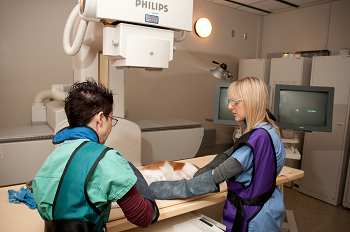 In
a
June 2020 article, University of California at Davis veterinary
researchers (C.S. Brown, L.R. Johnson, L.C. Visser, J.C. Chan, R.E.
Pollard) performed fluoroscopic scans of the hearts of 49 dogs during
their cardiac cycles to determine what impact the heart's pumping action
may have upon x-ray image measurements to determine the dogs'
vertebral heart score (VHS),
cardiothoracic ratio (CTR),
vertebral left atrial size (VLAS), and caudal vena cava diameter
ratio (CVCDR). Fluoroscopy is a series of low dose x-ray images that
show internal organs in motion. (See Univ. of Cal-Davis' fluoroscope
at right.) Fluoroscopy produces poorer quality images than x-rays
and therefore is not as accurate for diagnostic purposes. However, since
fluoroscopic images can show a series of images of the heart during its
cycling, they were useful in this study in assessing changes in the
quantitative measurements of the heart during its cycle. In this study,
the investigators measured VHS, CTR, VLAS, and CVCDR at the point of
end-diastolic volume (the maximum amount of blood in the left ventricle
just before the heart contracts) and end-systolic volume (the minimum
volume of blood in the ventricle at the end of contraction). They also
evaluated the impact of body condition score (BCS), weight, thoracic
conformation, sex, and age of each of the 49 dogs upon the heart size
measurements.
In
a
June 2020 article, University of California at Davis veterinary
researchers (C.S. Brown, L.R. Johnson, L.C. Visser, J.C. Chan, R.E.
Pollard) performed fluoroscopic scans of the hearts of 49 dogs during
their cardiac cycles to determine what impact the heart's pumping action
may have upon x-ray image measurements to determine the dogs'
vertebral heart score (VHS),
cardiothoracic ratio (CTR),
vertebral left atrial size (VLAS), and caudal vena cava diameter
ratio (CVCDR). Fluoroscopy is a series of low dose x-ray images that
show internal organs in motion. (See Univ. of Cal-Davis' fluoroscope
at right.) Fluoroscopy produces poorer quality images than x-rays
and therefore is not as accurate for diagnostic purposes. However, since
fluoroscopic images can show a series of images of the heart during its
cycling, they were useful in this study in assessing changes in the
quantitative measurements of the heart during its cycle. In this study,
the investigators measured VHS, CTR, VLAS, and CVCDR at the point of
end-diastolic volume (the maximum amount of blood in the left ventricle
just before the heart contracts) and end-systolic volume (the minimum
volume of blood in the ventricle at the end of contraction). They also
evaluated the impact of body condition score (BCS), weight, thoracic
conformation, sex, and age of each of the 49 dogs upon the heart size
measurements.
They report finding that the cardiac cycle had a significant impact on VHS (mean difference: 0.36 ± 0.14 vertebral units between systole and diastole) and CTR (mean difference: 2.2 ± 1.2% between systole and diastole), but that the cardiac cycle had no significant impact on VLAS or CVCDR. They also observed that obesity significantly increased variation between systole and diastole in CTR measurements. They concluded that "The cardiac cycle has a significant effect on VHS and CTR but does not impact VLAS or CVCDR. These findings should be taken into consideration during clinical use of these measurements, especially if a patient is being monitored for cardiac changes over time via serial radiographs."
April 2020:
Brendan Corcoran identifies TGFβ as the gene with the strongest
association with MVD in cavaliers.
 In an
April 2020 article, a
University of Edinburgh team of veterinary researchers led by Dr.
Brendan Corcoran (Greg R. Markby [right], Vicky E. Macrae, Kim M. Summers)
examined the mitral valves of 30 euthanized MVD-affected dogs, including
8 cavalier King Charles spaniels (27%) to classify the valves according
to MVD severity (Grade 0 - normal -- to Grade 4 - severely affected) and
to identify all differentially expressed genes (DEGs) in all four such
grades. By transcriptomic profiling they identified a total of 1,002
DEGs associated with a large number of gene families. Depending upon the
grade of MVD, they found significant changes in gene expression
intensity in especially ACTA2, HTR2B, MMP12, and CDKN2A. The
TGFβ1, TNF,
IFGN genes were identified as the top up-stream regulators in the
diseased valve samples. Of those, they found that TGFβ1 appears to have
the strongest associations with the disease. They concluded:
In an
April 2020 article, a
University of Edinburgh team of veterinary researchers led by Dr.
Brendan Corcoran (Greg R. Markby [right], Vicky E. Macrae, Kim M. Summers)
examined the mitral valves of 30 euthanized MVD-affected dogs, including
8 cavalier King Charles spaniels (27%) to classify the valves according
to MVD severity (Grade 0 - normal -- to Grade 4 - severely affected) and
to identify all differentially expressed genes (DEGs) in all four such
grades. By transcriptomic profiling they identified a total of 1,002
DEGs associated with a large number of gene families. Depending upon the
grade of MVD, they found significant changes in gene expression
intensity in especially ACTA2, HTR2B, MMP12, and CDKN2A. The
TGFβ1, TNF,
IFGN genes were identified as the top up-stream regulators in the
diseased valve samples. Of those, they found that TGFβ1 appears to have
the strongest associations with the disease. They concluded:
"In conclusion, despite differences in the total number of DEGs identified as canine MMVD pathology progresses over a lifetime, disease initiation, and progression appears to be primarily dependent on changes in TGFβ signaling. This is the first description of the temporal and spatial expression of gene changes associated with naturally occurring myxomatous degeneration in any species. Other signaling pathways likely contribute to disease pathogenesis over time, with some becoming involved only at the stage of advanced disease. The factors that trigger the development of valve myxomatous degeneration are still unknown, but aberrant TGFβ signaling appears to initiate and perpetuate the valve pathology characteristic of this disease in the dog."
April 2020:
University of Florida researchers find manubrium heart
scores are useful in assessing MVD-affected dogs.
 In an
April 2020 article, a team of University of Florida veterinary
school investigators (Katharine E. Peper, Clifford R. Berry) and Egyptian veterinary specialist Dr. Ayman A. Mostafa (right) report on their study
of 184 dogs to evaluate the usefulness of the manubrium heart score
(MHS) in distinguishing between dogs with and with cardiac disease. The
manubrium is the handle-shaped, broad upper part of the sternum, from
which the clavicles and first ribs extend. The manubrium is said to be a
relatively prominent, regularly elongated, bullet-shaped or rectangular
bone segment that is easily identified and can be readily measured on
lateral thoracic radiographic views. This is a variation of the
vertebral heart score (VHS) which has been a common means of measuring
heart size and detecting heart enlargement since the 1990s when first
introduced by Dr. James Buchanan at the Univeristy of Pennsylvania
veterinary school in his studies of mitral valve disease (MVD) in
cavalier King Charles spaniels. Five cavaliers were included in this
present MHs study, including one in the healthy control group of small
dogs and four in the affected group of small dogs. Their findings
included an indication that MHS and VHS were greater in dogs with
left-sided cardiac disease, compared to the control group dogs. They
concluded that:
In an
April 2020 article, a team of University of Florida veterinary
school investigators (Katharine E. Peper, Clifford R. Berry) and Egyptian veterinary specialist Dr. Ayman A. Mostafa (right) report on their study
of 184 dogs to evaluate the usefulness of the manubrium heart score
(MHS) in distinguishing between dogs with and with cardiac disease. The
manubrium is the handle-shaped, broad upper part of the sternum, from
which the clavicles and first ribs extend. The manubrium is said to be a
relatively prominent, regularly elongated, bullet-shaped or rectangular
bone segment that is easily identified and can be readily measured on
lateral thoracic radiographic views. This is a variation of the
vertebral heart score (VHS) which has been a common means of measuring
heart size and detecting heart enlargement since the 1990s when first
introduced by Dr. James Buchanan at the Univeristy of Pennsylvania
veterinary school in his studies of mitral valve disease (MVD) in
cavalier King Charles spaniels. Five cavaliers were included in this
present MHs study, including one in the healthy control group of small
dogs and four in the affected group of small dogs. Their findings
included an indication that MHS and VHS were greater in dogs with
left-sided cardiac disease, compared to the control group dogs. They
concluded that:
"Results indicated that MHSs could be useful, objective radiographic values to help assess dogs for potential heart disease, and we recommend that MHSs be added to the diagnostic tools used by veterinarians when screening for heart disease in dogs."
 EDITOR'S NOTE: Oddly, the last sentence of this April 2020 article
gratuitously states:
EDITOR'S NOTE: Oddly, the last sentence of this April 2020 article
gratuitously states:
"Nonetheless, echocardiography remains the noninvasive gold standard for assessment of cardiomegaly in dogs."
Using the term "gold standard" is common among veterinary researchers when describing a method or procedure which stands head-and-shoulders above any other in diagnosing (or treating) a particular disorder or abnormality. To include a single echocardiogram in that category for assessing cardiomegaly (heart enlargment) is rather absurd. It is true that if two echocardiograms of the same dog are performed, the first one (a baseline echo) taken several months or years prior to the second one, then we would agree that if in comparing those two echos the latter shows a larger heart chamber than the former, that could be a "gold standard" as long as both echos were performed satisfactorily (and preferably by the same examiner). But a single echo does not provide any evidence of heart enlargement at all. All that a lone echo tells the examiner is what the dimensions of the heart chambers are, but not whether any of them have become enlarged.
March 2020:
EPIC Study data confirms that as MVD-affected dogs reached heart
failure, their heart rate, breathing rate, and heart size increased.
 In a
March 2020 article, the EPIC Study researchers, led by Dr, Adrian
Boswood (right), report the changes in
measurements of clinical variables of 135 MVD-affected dogs which
reached heart failure (CHF) during the course of the trial. The
variables included (a) heart rate (HR), (b) respiratory rate measured
during clinic visits (RR), (c) home-measured resting respiratory rate
(RRR), (d) rectal temperature (RT), (e) body weight (BW), and (f)
vertebral heart sum (VHS). All categories of variables reportedly
changed as the dogs approached and entered CHF. Their data confirmed the
findings of previous studies, the main difference being the sizeable
number of dogs in the study (135 dogs) of which 45.9% (62 dogs) were
cavalier King Charles spaniels. The article provides no breed-specific
information, despite the fact that nearly half of all dogs in the study
were cavavliers. The investigators' findings for each variable were:
In a
March 2020 article, the EPIC Study researchers, led by Dr, Adrian
Boswood (right), report the changes in
measurements of clinical variables of 135 MVD-affected dogs which
reached heart failure (CHF) during the course of the trial. The
variables included (a) heart rate (HR), (b) respiratory rate measured
during clinic visits (RR), (c) home-measured resting respiratory rate
(RRR), (d) rectal temperature (RT), (e) body weight (BW), and (f)
vertebral heart sum (VHS). All categories of variables reportedly
changed as the dogs approached and entered CHF. Their data confirmed the
findings of previous studies, the main difference being the sizeable
number of dogs in the study (135 dogs) of which 45.9% (62 dogs) were
cavalier King Charles spaniels. The article provides no breed-specific
information, despite the fact that nearly half of all dogs in the study
were cavavliers. The investigators' findings for each variable were:
(a) Heart rate (HR): "In our study, small increases in HR could be seen from 10 months before confirmed CHF, but no such change could be observed in dogs not progressing to CHF within 4 months of the last examination. Mean heart rate increased from approximately 125 to 150 beats per minute, representing a change of 20% from the baseline value."
(b) Respiratory rate measured during clinic visits (RR) and (c) home-measured resting respiratory rate (RRR): "The most striking changes in any of the variables were found in RR and RRR. These increased from baseline values of approximately 31 and 23 per minute, respectively, to 49 and 41 per minute at the onset of CHF. ... Both RR and RRR only appeared to change within the 4 months immediately before the onset of CHF and showed little variation before that time."
(d) Rectal temperature (RT): "RT ... decreased over time as dogs progressed into CHF. The decrease in RT is likely to be a consequence of impaired peripheral perfusion."
(e) Body weight (BW): "Body weight ... decreased over time as dogs progressed into CHF. ... The decrease in BW may be a consequence of the loss of skeletal muscle mass, but we did not record body condition or muscle condition scores at each visit and therefore cannot be sure of this conclusion."
(f) Vertebral heart sum (VHS): "A nonlinear increase in VHS previously has been described in dogs and the findings of the present study agree with these studies (ie, the changes were characterized by a gradual increase over time until 6-12 months before confirmed CHF when average VHS changed rapidly ..., representing an approximate increase of 15%)."
The study concludes:
"Dogs with MMVD in ACVIM stage B2 experience increases in HR, RR, RRR, and VHS, and decreases in BW and RT as they progress into CHF. The change in VHS is characterized by a gradual increase over time, whereas the other variables change within the last few months before CHF. The variables with highest absolute change and rate of change were RR and RRR. This finding reinforces the value of RR and RRR as indicators of impending or incipient CHF. If RR and RRR are routinely and frequently measured in dogs with stage B2 MMVD, it may be possible for the onset of CHF to be detected earlier and therefore for it to be managed sooner and more effectively."
 EDITOR'S NOTE: It is professionally
irresponsible of these cardiologists to not have provided breed-specific
data for cavaliers, since nearly half of all dogs in the study were
CKCSs (62 cavaliers out of 135 dogs) and no single other breed had more
than 8 dogs. We asked the lead researcher, Dr. Boswood, to provide
breed-specific data or findings about cavaliers, and his response was,
in short, "No". He wrote:
EDITOR'S NOTE: It is professionally
irresponsible of these cardiologists to not have provided breed-specific
data for cavaliers, since nearly half of all dogs in the study were
CKCSs (62 cavaliers out of 135 dogs) and no single other breed had more
than 8 dogs. We asked the lead researcher, Dr. Boswood, to provide
breed-specific data or findings about cavaliers, and his response was,
in short, "No". He wrote:
"You have asked for data specifically about the outcome in the study for cavalier King Charles spaniels and suggested that we should perform a sub-analysis looking at outcome for this group. ... [W]e will not release the exact figures you have requested."
Other studies have shown that MVD progresses in cavaliers in manners unique from other breeds, including age of onset, rapidity of progression, sizes of normal hearts, response to certain pre-CHF medications, and even the unique shape of the cavaliers' mitral valve leaflets. Most recently, Dr. Michele Borgarelli and his team reported in a September 2018 article that "morphologic features could confer a mechanical disadvantage and play a role in the predisposition of CKCSs to the early development of MMVD." For Dr. Boswood and his cohorts to refuse to disclose this extremely important CKCS-specific data, which he admits he possesses, is reprehensibly inexcusable!
March 2020:
Dr. Uechi reports a high incidence of diaphragm paralysis
in small dogs after mitral valve repair surgery.
 In a
March 2020 article, Japanese heart surgeon Dr. Masami Uechi
(right) and
his team (Kazuya Mamada, Ayaka Chen, Kazuki Takamura, Masaru Murakami)
report finding that unilateral diaphragmatic paralysis (UDP) due to
phrenic nerve injury during open-heart mitral valve repair surgeries
occurred in 30% of 284 patients -- 86 dogs. However, 99% of the 86 dogs
diagnosed with post-surgery UDP recovered within three months following
surgery. Of the 294 dogs in the study, 26 were
cavalier King Charles spaniels. The highest number per breed was 133
Chihuahuas. Two phrenic nerves originate in the neck and passe between
the lungs and heart to the diaphragm. They provide the primary motor
input to the diaphragm, which is the major muscle which regulates
breathing. Injury to
the phrenic nerve can cause diaphragmatic dysfunction, including
unilateral and bilateral diaphragmatic paralysis. UDP decreases arterial
oxygen concentration and necessarily prolongs the patient's duration on
mechanical ventilation and length of stay in the intensive care unit
(ICU) and hospital.
In a
March 2020 article, Japanese heart surgeon Dr. Masami Uechi
(right) and
his team (Kazuya Mamada, Ayaka Chen, Kazuki Takamura, Masaru Murakami)
report finding that unilateral diaphragmatic paralysis (UDP) due to
phrenic nerve injury during open-heart mitral valve repair surgeries
occurred in 30% of 284 patients -- 86 dogs. However, 99% of the 86 dogs
diagnosed with post-surgery UDP recovered within three months following
surgery. Of the 294 dogs in the study, 26 were
cavalier King Charles spaniels. The highest number per breed was 133
Chihuahuas. Two phrenic nerves originate in the neck and passe between
the lungs and heart to the diaphragm. They provide the primary motor
input to the diaphragm, which is the major muscle which regulates
breathing. Injury to
the phrenic nerve can cause diaphragmatic dysfunction, including
unilateral and bilateral diaphragmatic paralysis. UDP decreases arterial
oxygen concentration and necessarily prolongs the patient's duration on
mechanical ventilation and length of stay in the intensive care unit
(ICU) and hospital.
In-hospital mortality was 10.5% including 10 dogs that did not survive surgery and an additional 21 dogs that died before discharge from the hospital (31/294 dogs). An additional six dogs (2.3%) discharged from the hospital died before 3 months after surgery. Total mortality at 3 months after surgery was 12.6% (37/294 dogs). Of the 21 dogs which died before leaving the hospital, 9 died of respiratory failure. None of those 9 dogs were cavaliers; 4 of those 9 dogs were Chihuahuas. In 3 of the 4 Chihuahuas, upper airway obstructions were noted on admission or in their clinical histories. While pharyngeal airway obstruction has been most commonly observed in brachycephalic dogs, especially the English bulldog, pug, and Boston terrier, the Chihuahua and the Shih Tzu are also reportedly predisposed to upper airway disease. These dogs skulls tend to be shortened, causing excessive soft tissue in the pharynx. Two of the Chihuahuas also were diagnosed with tracheal collapse. In dogs in this study which did not have pre-existing respiratory disease/failure, the researchers report that UDP was not a major complicating factor. The reseachers concluded that:
"This study observed that paralysis of the left crus of the diaphragm induced by phrenic nerve injury is relatively common (30%) among small dogs after MVR [mitral valve repair]. ... In most dogs, phrenic nerve function recovers within 3 months; however, in those with pre-existing respiratory insufficiency, UDP can be a significant complicating factor that may contribute to postoperative morbidity and death."
The article provides this interesting statistical information regarding surgeries at Dr. Uechi's Jasmine cardiovascular center:
• 294 dogs underwent mitral valve repair surgery
• 284 dogs survived until the day after surgery
• 10 of 294 dogs (3.4%) died during or on the day of surgery
• 21 more dogs (7.1%) died before discharge from the hospital (10 had UDP)
• 6 more dogs (2.3%) died within 3 months after surgery (5 sudden deaths and 1 CHF)
• 37 total dogs (12.6%) died within 3 months after surgery
• 86 of the 284 dogs (30%) developed UDP as a result of surgery
• 22 of the 86 dogs (25.6%) recovered from UDP by discharge from the hospital
• 41 more dogs (47.7%) recovered from UDP within a month after surgery
• 22 more dogs (25.6%) recovered from UDP within 3 months after surgery
• 85 total dogs (99.0%) recovered from UDP within 3 months after surgery
March 2020:
CSU's Dr. Chris Orton is testing minimally-invasive insertion of
a clamp to mitral valves of dogs with severe regurgitation.
Dr. Christopher Orton of Colorado State University is leading a team of
veterinary cardio-surgeons (Brianna
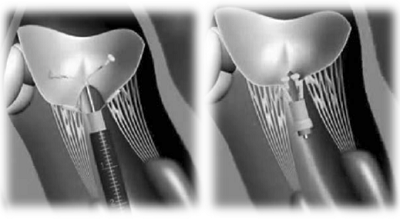 Potter,
Bernard Chi) in a very preliminary study of treating Stage C
MVD-affected dogs by inserting a clamp partially connecting the two
mitral valve leaflets together. The device is to be inserted by a
transcatheter through a vein into the beating heart and then attached to
both mitral valve leaflets. (See diagram at right.) It is based
upon the "edge-to-edge" surgical technique MitraClip implant in humans.
The procedure is performed on small dogs in Stage C (heart failure) with
severe mitral regurgitation under general anesthesia. He intends to
present an abstract of this study at the ACVIM Forum in June 2020.
See also CSU's February 28 article.
Potter,
Bernard Chi) in a very preliminary study of treating Stage C
MVD-affected dogs by inserting a clamp partially connecting the two
mitral valve leaflets together. The device is to be inserted by a
transcatheter through a vein into the beating heart and then attached to
both mitral valve leaflets. (See diagram at right.) It is based
upon the "edge-to-edge" surgical technique MitraClip implant in humans.
The procedure is performed on small dogs in Stage C (heart failure) with
severe mitral regurgitation under general anesthesia. He intends to
present an abstract of this study at the ACVIM Forum in June 2020.
See also CSU's February 28 article.
February 2020:
Dr. Corcoran's team find widespread presence of activated
myofibroblasts (valve interstitial cells (aVICs) in diseased mitral
valves.
 In
a
February 2020 article, a team of UK researchers led by Dr. Brendan
Corcoran (right) (Rachel R. Blake, Greg R. Markby, Geoff J.
Culshaw, Yolanda Martinez-Pereira, Chi-Chien Lu) furthered their study
of deteriorating cells in MVD-affected cavalier King Charles spaniels.
They hypothesised that there is survival of activated myofibroblasts in
MVD-affected valves and that this, in part, can be explained by a defect
in the activation and progression of apoptotic pathways. They examined
the distribution of activated myofibroblasts (valve interstitial cells
-- aVICs) to confirm their survival, and then they examined the
expression of apoptotic genes by qVICs and aVICs in cell culture, before
and after stimulation with doxorubicin, a chemotherapy drug which works
by slowing or stopping the growth of certain types of cells. Their data
indicated that the ability of aVICs to survive in mitral valves may be
due to a heighthened resistence to apoptosis (the programmed death of
most cells after a specified life-span).
In
a
February 2020 article, a team of UK researchers led by Dr. Brendan
Corcoran (right) (Rachel R. Blake, Greg R. Markby, Geoff J.
Culshaw, Yolanda Martinez-Pereira, Chi-Chien Lu) furthered their study
of deteriorating cells in MVD-affected cavalier King Charles spaniels.
They hypothesised that there is survival of activated myofibroblasts in
MVD-affected valves and that this, in part, can be explained by a defect
in the activation and progression of apoptotic pathways. They examined
the distribution of activated myofibroblasts (valve interstitial cells
-- aVICs) to confirm their survival, and then they examined the
expression of apoptotic genes by qVICs and aVICs in cell culture, before
and after stimulation with doxorubicin, a chemotherapy drug which works
by slowing or stopping the growth of certain types of cells. Their data
indicated that the ability of aVICs to survive in mitral valves may be
due to a heighthened resistence to apoptosis (the programmed death of
most cells after a specified life-span).
February 2020:
ACVIM issues a Consensus Statement on pulmonary hypertension in
dogs.
 In
a
February 2020 article, a team of veterinary specialists, including
five cardiologists (Carol Reinero [right], Lance C. Visser,
Heidi B. Kellihan, Isabelle Masseau, Elizabeth Rozanski, Cecile Clercx,
Kurt Williams, Jonathan Abbott, Michele Borgarelli, Brian A. Scansen)
have issued an ACVIM Consensus Statement of guidelines for the
diagnosis, classification, treatment, and monitoring of pulmonary
hypertension (PH) in dogs. They state that:
In
a
February 2020 article, a team of veterinary specialists, including
five cardiologists (Carol Reinero [right], Lance C. Visser,
Heidi B. Kellihan, Isabelle Masseau, Elizabeth Rozanski, Cecile Clercx,
Kurt Williams, Jonathan Abbott, Michele Borgarelli, Brian A. Scansen)
have issued an ACVIM Consensus Statement of guidelines for the
diagnosis, classification, treatment, and monitoring of pulmonary
hypertension (PH) in dogs. They state that:
"Exertional syncope, labored respiration or overt respiratory distress, and exercise intolerance are noteworthy clinical signs frequently directly attributable to PH."
They group the PH into six categories, of which Group 2 is PH secondary to left-sided heart disesase, meaning MVD. At the outset for Group 2 PH-affected dogs, they warn that "a PDE5i [e.g. sildenafil, Viagra] should be administered only to dogs free of acute or decompensated [left heart failure] LHF (cardiogenic pulmonary edema)." In other words, if the MVD-affected dog is in Stage C (heart failure) and still has fluid in its lungs, treating with Viagra is not appropriate. They add that PDE5i drugs may be considered if the dog has exertional syncope due to its MVD, and it has failed to respond to other treatments, specifically pimobendan.
February 2020:
Dr. Mark Rishniw finds ACE-inhibitors fail to delay the onset of
heart failure or onset of death in MVD-affected dogs.
 In a
February 2020 article, board certified veterinary cardiologist
Dr. Mark Rishniw (right) carefully dissects all five drug-company-funded
studies of the ACE-inhibitor enalapril to determine whether the drug
would delay the onset of cardiac death in MVD-affected dogs in heart
failure (CHF) or would delay the onset of CHF in pre-clinical
MVD-affected dogs (i.e., in Stages B1 or B2). These studies are known by
their acronyms
IMPROVE,
COVE,
LIVE,
SVEP, and
VETPROOF. While the conclusions of some
of the studies were muddled by drug-company interference, Dr. Rishniw's
analysis of the underlying data shows that ACE-inhibitors have not been
scientifically shown to delay the onset of either CHF or cardiac death
due to MVD. He goes on to determine that:
In a
February 2020 article, board certified veterinary cardiologist
Dr. Mark Rishniw (right) carefully dissects all five drug-company-funded
studies of the ACE-inhibitor enalapril to determine whether the drug
would delay the onset of cardiac death in MVD-affected dogs in heart
failure (CHF) or would delay the onset of CHF in pre-clinical
MVD-affected dogs (i.e., in Stages B1 or B2). These studies are known by
their acronyms
IMPROVE,
COVE,
LIVE,
SVEP, and
VETPROOF. While the conclusions of some
of the studies were muddled by drug-company interference, Dr. Rishniw's
analysis of the underlying data shows that ACE-inhibitors have not been
scientifically shown to delay the onset of either CHF or cardiac death
due to MVD. He goes on to determine that:
"In retrospect, it became clear that the veterinary community was hoodwinked into believing that ACE-I were the medical cure for CHF dogs because of corporate marketing decisions."
He concludes:
"So, what does all this mean? My interpretation of all this literature suggests that ACE-I have no place in managing mitral valve disease, whether in dogs with CHF or dogs with subclinical disease."
 EDITOR'S NOTE: Like we've been saying, for
the past 18 years since the 2002
SVEP study. The next time
your cavalier's cardiologist prescribes an ACE-inhibitor to treat
MVD, show him/her
Dr. Rishniw's article and ask, "WHY? Show me your proof that you
know more than Dr. Rishniw does!"
EDITOR'S NOTE: Like we've been saying, for
the past 18 years since the 2002
SVEP study. The next time
your cavalier's cardiologist prescribes an ACE-inhibitor to treat
MVD, show him/her
Dr. Rishniw's article and ask, "WHY? Show me your proof that you
know more than Dr. Rishniw does!"
Remember what Dr. Mikaela Mueller wrote about the worthlessness of ACE-inhibitors:
"I think many of us have prescribed ACE-inhibitors in the preclinical stage just in case it does help. It makes us, and our clients, feel like we are doing something that may possibly help, while we are, in all honesty, in a position where our hands are tied."
In other words, ACE-inhibitors are just a placebo for the dogs' owners (and maybe even for some cardiologists, too).
January 2020: Japanese study of 316 MVD-affected dogs (41 cavaliers) finds atrial natriuretic peptide and cardiac troponin I concentrations can detect dogs in heart failure (Stage C). In a February 2020 article, a team of Japanese researchers (Yasutomo Hori, Masayuki Iguchi, Atsushi Hirakawa, Zenta Kamiya, Shigeki Yamano, Toshiki Ibaragi, Noriko Isayama, Yohei Yamashita, Naoki Iwasa, Haruki Inaba, Yasuhiro Heishima, Masashi Yuki) studied 316 MVD-affected dogs, including 41 cavaliers (13%) to determine if atrial natriuretic peptide (ANP) and/or cardiac troponin I (cTnI) concentrations could diagnose MVD in dogs and also determine the stage of MVD (B1, B2, or C) of the dogs. They concluded that ANP concentrations appeared to be useful for detecting dogs in Stage B1 and Stage B2, and that both ANP and cTnI were useful in assessing whether the dogs were in heart failure (Stage C), but that neither test should be used independently of echocardiography to diagnose MVD.
EDITOR'S NOTE: Once again, mitral valve disease researchers waste their (and our) time by choosing to assign MVD-affected dogs to either Stage B1 (murmur but no enlargement) or Stage B2 (murmur plus enlargement) based not upon whether the dogs' hearts were actually enlarged or not but instead upon whether the size of the heart is smaller or larger than an arbitrary set of species-wide reference intervals. In this case, if the dog's left atrium LA:Ao ratio was less than 1.7, it was classified as not enlarged and put in the Stage B1 category. Otherwise it was assumed to be enlarged and assigned to Stage B2. Similarly, the left ventricle of each dog's heart was measured, and if its LVIDDn dimension was less than 1.7, it was placed in the Stage B1 class, and if larger, then in Stage B2. Thus, these so-called cardiologists have essentially made themselves mathematicians. How they can safely and accurately assume that 316 dogs of 21 breeds plus 17 mixed-breeds have identical sized hearts is beyond scientific comprehension. There is not even a single (much less many) peer-reviewed published veterinary journal article which finds that the hearts of all dogs of all breeds are enlarged or not based upon a species-wide reference interval for the left atrium (LA) and/or left ventricle (LV). However, there are several such articles finding that normal-sized LAs and LVs vary in size among different breeds, and in some cases, even among different dogs of the same breed.
It is difficult to proceed beyond this measurement irrationality in order to seriously consider the rest of the findings in this article, but nevertheless, there may be some value to their findings, because to a certain extent, it matters not if the MVD-affected dog has an enlarged heart or not, as long as it clearly has, at least, a mitral valve murmur or, on the other hand, has been in heart failure. So, the rest of this effort concludes that plasma ANP and cTnI concentrations cannot be relied upon to diagnose MVD, but they can be used to assess whether the dogs are in heart failure.
January 2020:
Pimobendan fails to improve left atrial size and
function in a UK study of 15 cavaliers and 12 other MVD-affected dogs.
 In
a
December 2019 article reporting on the review of 27 MVD-affected
dogs allegedly in Stage B2 (mitral valve murmur plus heart enlargement),
including 15 cavaliers (55.6%), a team of UK researchers (Fabio Sarcinella [right], Joao Neves,
Thomas W. Maddox, Hannah M. Hodgkiss-Geere, Elizabeth F. Bode, Joanna
Dukes-McEwan) found that after six months of treatment with pimobendan,
"there was no demonstrable improvement in LA [left atrial] size and
function". The authors speculated upon several possible reasons for this
lack of a successful result. They concluded:
In
a
December 2019 article reporting on the review of 27 MVD-affected
dogs allegedly in Stage B2 (mitral valve murmur plus heart enlargement),
including 15 cavaliers (55.6%), a team of UK researchers (Fabio Sarcinella [right], Joao Neves,
Thomas W. Maddox, Hannah M. Hodgkiss-Geere, Elizabeth F. Bode, Joanna
Dukes-McEwan) found that after six months of treatment with pimobendan,
"there was no demonstrable improvement in LA [left atrial] size and
function". The authors speculated upon several possible reasons for this
lack of a successful result. They concluded:
"Echocardiographic estimates of LA function by 2D diameters and volumes and TDI A' [atrial contraction] in dogs with MMVD do not change after treatment with pimobendan."
 EDITOR'S
NOTE: This study unfortunately started out on the wrong
foot when its authors chose to apply the EPIC Study's bogus definition
of left atrium and left ventricle enlargement in determining whether the
dogs actually had enlarged hearts and therefore actually were in Stage
B2. As they stated:
EDITOR'S
NOTE: This study unfortunately started out on the wrong
foot when its authors chose to apply the EPIC Study's bogus definition
of left atrium and left ventricle enlargement in determining whether the
dogs actually had enlarged hearts and therefore actually were in Stage
B2. As they stated:
"Dogs that had undergone echo and were coded as stage B2 ... based on the echocardiographic criteria proposed by the EPIC study (short-axis early diastolic left atrial-to-aortic diameter ratio (LA/Ao)> 1.6 and M-mode left ventricular internal diameter normalized for body weight (LVIDDN) > 1.7)." (Emphasis added.)
Surely these six veterinary specialists cannot be so ignorant of the peer-reviewed proven fact that several breeds of dogs, particularly the cavalier King Charles spaniel, have normal-sized left ventricles measuring LVIDDN > 1.7 (or even as high as 1.85). And surely they also must know that for some breeds, LA/Ao of 1.6 means a normal-sized left atrium. So, why do they pretend that the EPIC Study's parameters are accurate cut-offs between a normal-sized heart and an enlarged one for all breeds of dogs?
 As a result of this foolishness on their part, we really do not learn
much from this study. They claim disappointment that pimobendan did not
reduce LA size or improve its function. But if as is likely, that some or all of these dogs
had normal-sized hearts to begin with, how could the researchers expect
any drug to reduce the sizes or improve the hearts' functioning? They raise
literally ten
different possible reasons for their lack of success, but none of those
speculations include the obvious underlying flaw. As with any study of
MVD-affected dogs which starts from the premise that the EPIC Study's
definition of heart enlargement is accurate, this one was destined to
fail and waste everyone's time.
As a result of this foolishness on their part, we really do not learn
much from this study. They claim disappointment that pimobendan did not
reduce LA size or improve its function. But if as is likely, that some or all of these dogs
had normal-sized hearts to begin with, how could the researchers expect
any drug to reduce the sizes or improve the hearts' functioning? They raise
literally ten
different possible reasons for their lack of success, but none of those
speculations include the obvious underlying flaw. As with any study of
MVD-affected dogs which starts from the premise that the EPIC Study's
definition of heart enlargement is accurate, this one was destined to
fail and waste everyone's time.
January 2020:
The DELAY Study shows a spironolactone-and-benazepril
cocktail does not delay the onset of heart failure in MVD-affected dogs.
 In a
January 2020 article, a world-wide team of cardiologists led by
Dr. Michele Borgarelli (right) finally have reported the results of the DELAY
Study, a nearly ten-year effort to determine if a combination of
spironolactone and the ACE-inhibitor benazepril would delay the onset of
heart failure in MVD-affected dogs in Stage B2 (heart murmur and
enlargement). A total of 183 dogs participated, including 34 cavaliers
(19%), the highest number of purebreds. Mixed breeds totaled 72 (40%).
The dogs were divided into a treatment group (87 dogs) and control group
(92 dogs) which received a placebo and no medication. At the end of the
study, 42 dogs in the treatment group and 33 in the control group
remained (most of the drop-outs opting to switch treatment to
pimobendan). Of those, the median time to reaching heart failiure in the
treatment group was 902 days, and the median time in the placebo group
was 1,139 days, a difference of 237 days, roughly 8 months. However, the
treatment group's heart measurements showed that treatment could reduce
-- and in some cases even reverse -- heart enlargement and reduce
NT-proBNP. They concluded:
In a
January 2020 article, a world-wide team of cardiologists led by
Dr. Michele Borgarelli (right) finally have reported the results of the DELAY
Study, a nearly ten-year effort to determine if a combination of
spironolactone and the ACE-inhibitor benazepril would delay the onset of
heart failure in MVD-affected dogs in Stage B2 (heart murmur and
enlargement). A total of 183 dogs participated, including 34 cavaliers
(19%), the highest number of purebreds. Mixed breeds totaled 72 (40%).
The dogs were divided into a treatment group (87 dogs) and control group
(92 dogs) which received a placebo and no medication. At the end of the
study, 42 dogs in the treatment group and 33 in the control group
remained (most of the drop-outs opting to switch treatment to
pimobendan). Of those, the median time to reaching heart failiure in the
treatment group was 902 days, and the median time in the placebo group
was 1,139 days, a difference of 237 days, roughly 8 months. However, the
treatment group's heart measurements showed that treatment could reduce
-- and in some cases even reverse -- heart enlargement and reduce
NT-proBNP. They concluded:
"This study failed to demonstrate a prolongation of the asymptomatic phase of the disease in this population of dogs. Nevertheless, the treatment appears effective in reducing or even reverse cardiac remodeling as indicated by various cardiac imaging parameters and NT-proBNP concentrations. Chronic administration of combined spironolactone and benazepril treatment in dogs with pre-clinical MMVD and cardiac enlargement is safe and well tolerated. The significant effect of this treatment on secondary end-points could be of clinical relevance and merits further study."
 EDITOR'S NOTE: This is a surprising and
disappointing result for these researchers. They hypothesized that a
cocktail of spironolactone and benazepril in Stage B2 dogs would
significantly delay the onset of heart failure or sudden cardiac death.
The result was the opposite. Dogs receiving no medication at all avoided
heart failure significantly longer -- a median period of 8 months --
than those receiving the medications. This result also confirms the
findings of this
July 2017 article that spironolactone's "efficacy in
preclinical MMVD is unknown." Currently there are no peer-reviewed
veterinary studies recommending beginning spironolactone in Stage B2.
EDITOR'S NOTE: This is a surprising and
disappointing result for these researchers. They hypothesized that a
cocktail of spironolactone and benazepril in Stage B2 dogs would
significantly delay the onset of heart failure or sudden cardiac death.
The result was the opposite. Dogs receiving no medication at all avoided
heart failure significantly longer -- a median period of 8 months --
than those receiving the medications. This result also confirms the
findings of this
July 2017 article that spironolactone's "efficacy in
preclinical MMVD is unknown." Currently there are no peer-reviewed
veterinary studies recommending beginning spironolactone in Stage B2.
January 2020:
Mark Oyama summarizes similarities of serotonin
and transforming growth factor beta in MVD-affected cavaliers and
MVD-affected humans.
 In a
January 2020 article, board certified veterinary cardiologist
Dr. Mark Oyama (right) and others (W. Chad Elliott, Kerry A. Loughran,
Alexander P. Kossar, Estibaliz Castillero, Robert J. Levy, Giovanni
Ferrari) review the aspects of cardiovascular pathology shared by humans
and cavalier King Charles spaniels affected with mitral valve disease
(MVD). He focuses upon the neurotransmitter serotonin (5HT) and
transforming growth factor beta (TGF-β), which he describes as sharing a
common ability to activate mitral valve interstitial cells in both dogs
-- particularly cavaliers -- and humans. He states: "The dog, and in
particular the CKCS breed, represents a model to further study 5HT and
TGF-β mechanisms and to test novel therapies." His list includes:
In a
January 2020 article, board certified veterinary cardiologist
Dr. Mark Oyama (right) and others (W. Chad Elliott, Kerry A. Loughran,
Alexander P. Kossar, Estibaliz Castillero, Robert J. Levy, Giovanni
Ferrari) review the aspects of cardiovascular pathology shared by humans
and cavalier King Charles spaniels affected with mitral valve disease
(MVD). He focuses upon the neurotransmitter serotonin (5HT) and
transforming growth factor beta (TGF-β), which he describes as sharing a
common ability to activate mitral valve interstitial cells in both dogs
-- particularly cavaliers -- and humans. He states: "The dog, and in
particular the CKCS breed, represents a model to further study 5HT and
TGF-β mechanisms and to test novel therapies." His list includes:
• "One example is the Cavalier King Charles Spaniel (CKCS) breed, in which death due to heart disease comprises over 30% of all causes of death."
• "Beginning at the age of 3 years, the yearly incidence of MMVD in the CKCS is approximately 7% and rises to as high as 15% in subsequent years, such that virtually all dogs exhibit disease by the age of 10 years."
• "CKCS, a breed with extremely high prevalence of MMVD, are reported to have particularly increased serum 5HT levels."
• "5HT in platelet rich plasma was higher in healthy CKCS, as well as both CKCS and mixed breed dogs with MMVD vs. healthy mixed breed controls."
• "Of interest, the CKCS breed is also associated with an inherited thrombocytopenia and giant platelet disorder affecting approximately half of all CKCS dogs."
• "In addition to having macrothrombocytes, the platelet population in CKCS dogs with MMVD also contains at least one flow cytometry scatterplot subpopulation with a higher percentage of surface-bound 5HT-positive expression and activation, but the exact relationship of platelet morphology, ultrastructure, and function to MMVD requires further study."
RETURN TO TOP
2019 News
December 2019:
Left atrial volume measurements of 132 MVD-affected cavaliers
finds the LA:Ao ratio measurement may not be accurate.
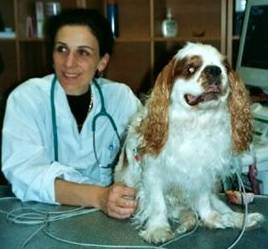 In a
September 2019 abstract at the 29th European College of Veterinary
Internal Medicine - Companion Animals (ECVIM-CA) Congress, a team of
French researchers (C. Poissonnier, P. Foulex, M.P. Alvarado, E.
Trehiou-Sechi, V. Saponaro, P. Passavin, S. Ghazal, S. Lefort, L.
Desquilbet, V. Chetboul [right]) compared different echocardiographic methods to
evaluate left atrium (LA) volume of 160 cavalier King Charles spaniels
classified according to the ACVIM mitral valve disease stages as
follows: 28 in Stage A (meaning no MVD murmur); and 132 with MVD:
86 in Stage B1 (murmur but no enlargement); 22 in Stage B2 (enlargement);
23 in Stage C (treatable heart failure); and 1 in Stage
D (untreatable heart failure). The median mitral regurgitation (MR) fraction for all 160 dogs was
38%. They compared LA volumes using three methods. The found that LA
volume was significantly lower in Stage B1 CKCSs with a mild MR fraction
(<30%) than in those with higher MR (>30%). They also reported that LA
volume measurements among Stage B1 dogs with MR >30% showed LA
enlargement even though the LA:Ao ratio did not. They concluded that
relying upon a standard LA:Ao calculation could lead to a misdiagnosis
between Stages B1 and B2 in cavaliers.
In a
September 2019 abstract at the 29th European College of Veterinary
Internal Medicine - Companion Animals (ECVIM-CA) Congress, a team of
French researchers (C. Poissonnier, P. Foulex, M.P. Alvarado, E.
Trehiou-Sechi, V. Saponaro, P. Passavin, S. Ghazal, S. Lefort, L.
Desquilbet, V. Chetboul [right]) compared different echocardiographic methods to
evaluate left atrium (LA) volume of 160 cavalier King Charles spaniels
classified according to the ACVIM mitral valve disease stages as
follows: 28 in Stage A (meaning no MVD murmur); and 132 with MVD:
86 in Stage B1 (murmur but no enlargement); 22 in Stage B2 (enlargement);
23 in Stage C (treatable heart failure); and 1 in Stage
D (untreatable heart failure). The median mitral regurgitation (MR) fraction for all 160 dogs was
38%. They compared LA volumes using three methods. The found that LA
volume was significantly lower in Stage B1 CKCSs with a mild MR fraction
(<30%) than in those with higher MR (>30%). They also reported that LA
volume measurements among Stage B1 dogs with MR >30% showed LA
enlargement even though the LA:Ao ratio did not. They concluded that
relying upon a standard LA:Ao calculation could lead to a misdiagnosis
between Stages B1 and B2 in cavaliers.
EDITOR'S NOTE: This is a rather bare-bones abstract, because there are major conclusions reached without including sufficient data to justify them. So, we must wait for publication of the full article to connect the data to the findings. Nevertheless, the findings and conclusions are enlightening. First, we find that the standard method of measuring the width of the left atrium (LA) (the right parasternal transaortic short-axis view) may result in missing evidence of enlargement at another location (medio-lateral, cranio-caudal, or ventro-dorsal directions). In other words, since the LA is 3-dimensional, it could begin to enlarge almost anywhere, whereas the standard linear measurement location is in only one place.
Second, and we think most importantly, the echo measure of mitral regurgitation (MR) consistently indicates the severity of the MVD. It should be obvious that the more blood that backflows through the mitral valve from the ventricle to the atrium, the more likely that the atrium will be caused to expand. So why not rely upon the MR percentage as a predictor of MVD severity instead of a haphazard 2-dimensional measurement of the LA?
Finally, their stated conclusion (lacking supporting data but I'm sure they have it) is that the LA:Ao ratio, based upon a 2-dimensional measurement at only one set of points, can be inaccurate and that some Stage B1 cavaliers (meaning without any LA enlargement) really do have some LA enlargement and therefore should be classified as in Stage B2. The bottom-line burning questions remain: So what? So what if some Stage B1 cavaliers really are in Stage B2? Should that change anything other than diagnosis? Stage B2 is a big area to deal with (mild, moderate, severe), and we have found that the more thoughtful cardiologists reject the knee-jerk rationale of others that the tiniest bit of enlargement necessitates starting pimobendan medication.
December 2019:
Mark Rishniw dissects UK study of pulmonary hypertension in
cavaliers.
 In a
December 2019 article, USA board certified veterinary cardiologist
Dr. Mark Rishniw (right) reviewed the
June 2019 article by UK researchers,
titled "The prevalence of pulmonary hypertension in Cavalier King
Charles spaniels compared with other breeds with myxomatous mitral valve
disease". He listed several discrepancies between the authors'
hypothesis and the data they produced. He writes:
In a
December 2019 article, USA board certified veterinary cardiologist
Dr. Mark Rishniw (right) reviewed the
June 2019 article by UK researchers,
titled "The prevalence of pulmonary hypertension in Cavalier King
Charles spaniels compared with other breeds with myxomatous mitral valve
disease". He listed several discrepancies between the authors'
hypothesis and the data they produced. He writes:
"Although the authors struggled to state that their hypothesis was wrong, the data clearly show that the only thing predictive of PH [pulmonary hypertension] in dogs with MMVD is the severity of the valve disease, and that being a CKCS does not increase your risk of having PH. In other words, the more severe the valve disease, regardless of breed, the higher chance the dog has PH because of the valve disease.
"The authors initially present the data suggesting that a higher proportion of CKCS had PH than non-CKCS dogs. However, this simply reflects the fact that the CKCS in their study simply were "worse off" at presentation than the non- CKCS dogs. The logistic regression analysis demonstrated this to be the case -- once the authors accounted for disease severity, breed was no longer relevant.
"The authors also report an overall percentage of dogs presenting with PH secondary to mitral valve disease. They suggest that some 65 to 70% of dogs with MMVD disease in their study had PH. However, clinicians should not believe this number as reflective of the real-world situation. First, the authors selected dogs in which a tricuspid regurgitation jet could be measured. It is possible that this biased the population towards selecting dogs with elevated pulmonary artery pressures. Second, the authors used a very low threshold tricuspid regurgitation value (2.8 m/s) to identify PHn. This would necessarily increase the number of false-positive cases (dogs that are identified as having PH but are actually normotensive). Finally, the authors did not differentiate between degrees of PH. Clinicians know and expect some PH with more severe MMVD. If this hypertension is "appropriate" and mild, it is clinically inconsequential and can be ignored. Only "inappropriate" and more severe hypertension concerns us and might warrant intervention.
"Therefore, clinicians should recognize that PH can occur in dogs with MMVD, and that CKCS are no more "prone" to developing this type of PH than other breeds. With more severe MMVD, clinicians should always consider assessing whether PH exists and whether it warrants therapeutic intervention." (Emphasis added.)
 EDITOR'S NOTE:
Dr. Rishniw is very good at dissecting cardiology research
articles such as this one and finding inconsistencies between the reports'
hypotheses, their data, their findings, their conclusions, and their
applications. It is unfortunate but true that there are fallacies hidden
away in some purportedly scientific research reports, which the authors do
not want to admit or for us to find, because they interfere with the
underlying narrative -- their indelible hypothesis. (We are not claiming
that this study is one of those, but certainly the disgraced
EPIC Study is a classic -- if
heavy-handed -- example of an attempt to hide the pea and please the
sponsor, but I digress.)
EDITOR'S NOTE:
Dr. Rishniw is very good at dissecting cardiology research
articles such as this one and finding inconsistencies between the reports'
hypotheses, their data, their findings, their conclusions, and their
applications. It is unfortunate but true that there are fallacies hidden
away in some purportedly scientific research reports, which the authors do
not want to admit or for us to find, because they interfere with the
underlying narrative -- their indelible hypothesis. (We are not claiming
that this study is one of those, but certainly the disgraced
EPIC Study is a classic -- if
heavy-handed -- example of an attempt to hide the pea and please the
sponsor, but I digress.)
In this instance, Dr. Rishniw finds significant inconsistencies between the data and the findings. Most importantly, he notes that the threshold value for tricuspid regurgitation was so low that the population probably included dogs which did not have PH at all. (This is the main problem with the EPIC Study in which dogs without enlarged hearts likely were included even though the study claimed to be limited to dogs with enlargement.) Dr. Rishniw described this as causing "false positives". He also chides the authors for failing to distinguish between mild PH (which probably does not warrant any treatment) and more severe PH. (The EPIC Study authors failed to do that, as well, with regard to the degree of enlargement.) Too bad Dr. Rishniw was not the peer reviewer of this article -- and the EPIC Study report.
November 2019:
Heart supplements reduced left atrial size and mitral
regurtitation in MVD-affected dogs over 6 months.
 In a
November 2019 article, a team of Purina researchers (Qinghong Li,
Allison Heaney [right], Natalie Langenfeld-McCoy, Brittany Vester Boler, Dorothy
P. Laflamme) compared the effects of adding heart supplements to placebo
in a 6-month long study of dogs in Stages B1 and B2 of mitral valve
disease (MVD). Nineteen MVD-dogs participated -- 17 Beagles and 2
minature Schnauzers -- and were divided into two groups -- 10 in the
treatment group and 9 in the placebo group. Two dogs in the treatment
group also were treated with MVD medications, and three dogs in the
placebo group received MVD drugs. The supplements added to the diet of
the treatment group dogs consisted of:
In a
November 2019 article, a team of Purina researchers (Qinghong Li,
Allison Heaney [right], Natalie Langenfeld-McCoy, Brittany Vester Boler, Dorothy
P. Laflamme) compared the effects of adding heart supplements to placebo
in a 6-month long study of dogs in Stages B1 and B2 of mitral valve
disease (MVD). Nineteen MVD-dogs participated -- 17 Beagles and 2
minature Schnauzers -- and were divided into two groups -- 10 in the
treatment group and 9 in the placebo group. Two dogs in the treatment
group also were treated with MVD medications, and three dogs in the
placebo group received MVD drugs. The supplements added to the diet of
the treatment group dogs consisted of:
• medium-chain triglycerides
• longchain omega-3 fatty acids
• lysine and methionine (carnitine precursors)
• vitamin E (an antioxidant)
• magnesium
• taurine
At the conclusion of the six months, the average left-atrial-to-aorta ratio (LA/Ao) of the treated group dogs decreased slightly, while the LA/Ao of the placebo dogs increased. (Increases in the LA/Ao ratio in MVD-affected dogs indicate an enlarging left atrium due to MVD.) The average left atrial diameter (LAD) of the treated dogs reduced slightly, while the LAD of the placebo dogs increased. They noticed no significant changes in the sizes of the left ventricles of any of the MVD-affected dogs. Mitral regurgitation reduced slightly in three of the ten dogs in the treatment group. The researchers concluded:
"Our study demonstrated that dietary intervention with a blend of nutrients designed to address metabolic changes associated with MMVD in dogs was able to slow or reverse cardiac changes in dogs with early, preclinical MMVD. This study did not provide the opportunity to extrapolate effects from any single nutrient within the CPB. Rather, we believe the key nutrients acted synergistically to achieve the documented efficacy."
 EDITOR'S NOTE:
This study indicates that supplementing MVD-affected dogs with certain
vitamins and minerals may slow the progression of the MVD and even
reverse heart enlargement. Instead of feeding dogs a dog food with
supplements included in its ingredients, we recommend that the dog's
owner add specific supplements to the food fed to MVD-affected cavaliers. See
our list of heart-healthy supplements here.
EDITOR'S NOTE:
This study indicates that supplementing MVD-affected dogs with certain
vitamins and minerals may slow the progression of the MVD and even
reverse heart enlargement. Instead of feeding dogs a dog food with
supplements included in its ingredients, we recommend that the dog's
owner add specific supplements to the food fed to MVD-affected cavaliers. See
our list of heart-healthy supplements here.
November 2019:
Comparision of the diuretics torsemide and furosemide
in healthy dogs shows no significant differences in their effect upon
activating the
kidney RAAS system.
 In a
November 2019 article, Colorado State Univ.
researchers (Brianna M. Potter, Marisa K. Ames [right], Ann Hess, Marko
Poglitsch) tested 6 healthy Beagles to compare the effects of the
diuretics torsemide and furosemide upon activation of the kidney
renin-angiotensin-aldosterone system (RAAS). Chronic RAAS activation is
known to promote sodium and water retention, vasoconstriction, heart
enlargement, and renal remodeling. The goal of the study was to compare
the magnitude of RAAS activation between these two loop diuretics,
administered at approximately equipotent dosages. Since torsemide has
been found to be 20 times more potent than furosemide, the equipotent
dosage of torsemide was 1/20th that of furosemide. The researchers
report finding that, over a 10-day period, the diuretics behaved
similarly, including the extent of increase in RAAS activity. There also
was no significant difference in the extent of potassium excretion,
although furosemide caused less than did torsemide. They also confirmed
that torsemide given twice daily had a potency factor close to 20 times
that of furosemide. They concluded:
In a
November 2019 article, Colorado State Univ.
researchers (Brianna M. Potter, Marisa K. Ames [right], Ann Hess, Marko
Poglitsch) tested 6 healthy Beagles to compare the effects of the
diuretics torsemide and furosemide upon activation of the kidney
renin-angiotensin-aldosterone system (RAAS). Chronic RAAS activation is
known to promote sodium and water retention, vasoconstriction, heart
enlargement, and renal remodeling. The goal of the study was to compare
the magnitude of RAAS activation between these two loop diuretics,
administered at approximately equipotent dosages. Since torsemide has
been found to be 20 times more potent than furosemide, the equipotent
dosage of torsemide was 1/20th that of furosemide. The researchers
report finding that, over a 10-day period, the diuretics behaved
similarly, including the extent of increase in RAAS activity. There also
was no significant difference in the extent of potassium excretion,
although furosemide caused less than did torsemide. They also confirmed
that torsemide given twice daily had a potency factor close to 20 times
that of furosemide. They concluded:
"This study more comprehensively demonstrates the previously known diuretic-induced activation of RAAS using a novel method of RAAS quantification. A similar diuresis was obtained when torsemide was administered to healthy dogs at 1/20th the dosage of furosemide. At the dosages studied here, the degree of RAAS activation did not differ significantly between furosemide and torsemide. Also, the potassium excretion profile after furosemide and torsemide administration supports increased aldosterone production and MR activation and these data do not support an MR [mineralocorticoid-receptor] antagonizing effect of torsemide in the kidney at this dosage and during subacute administration to healthy dogs."
November 2019:
Michigan State Univ. clinicians report the safe use of
intravenous nitroglycerin in treating three Stage C MVD-affected dogs.
 In
a
November 2019 article, a team of Michigan State University
veterinarians, led by cardiologist Robert A. Sanders (right)
(Ron Achiel, Andy Carver), report the safe use of intravenous
nitroglycerin (IV-NTG) in treating three MVD-affected chihuahuas in
heart failure (CHF) -- Stage C -- to reduce preload pressure on the left
ventricle and improve blood flow. They elected to use IV-NTG due to the
severity of the dogs' CHF conditions and lower cost of IV-NTG compared
to nitroprusside, an extremely expensive drug. They report that these
are the first reported cases of using IV-NTC on veterinary patients with
naturally occurring MVD, and that no significant adverse effects were
observed. All three dogs' CHF were resolved following treatment,
although the success cannot be attributed to the IV-NTG because of the
small number of cases and the other medications used to treat the dogs'
conditions.
In
a
November 2019 article, a team of Michigan State University
veterinarians, led by cardiologist Robert A. Sanders (right)
(Ron Achiel, Andy Carver), report the safe use of intravenous
nitroglycerin (IV-NTG) in treating three MVD-affected chihuahuas in
heart failure (CHF) -- Stage C -- to reduce preload pressure on the left
ventricle and improve blood flow. They elected to use IV-NTG due to the
severity of the dogs' CHF conditions and lower cost of IV-NTG compared
to nitroprusside, an extremely expensive drug. They report that these
are the first reported cases of using IV-NTC on veterinary patients with
naturally occurring MVD, and that no significant adverse effects were
observed. All three dogs' CHF were resolved following treatment,
although the success cannot be attributed to the IV-NTG because of the
small number of cases and the other medications used to treat the dogs'
conditions.
November 2019:
Echocardiographic
study of left-atrial-to-aortic ratio (LA:Ao) of 238 heart-healthy dogs
shows normal-size upper limit of 1.76.
 In a
November 2019 article by an international team of cardiologists
(Mark Rishniw [right], Domenico Caivano, David Dickson, Liva
Vatne, Jo Harris, Jose Novo Matos), they examined the
left-atrial-to-aortic ratio (LA:Ao) of 238 healthy dogs with
normal-sized hearts to determine the accuracy of the EPIC Study's LA:Ao
> 1.6 reference interval defining MVD-affected dogs with enlargement of
the left atrium. Of the 238 dogs in this current study, only 5 (2%) were
cavalier King Charles spaniels among 190 dogs of 29 different breeds and 48
mixed breed dogs. They found that 10% of these 238 dogs had normal-sized
LA:Ao ratios above 1.6 and were as high as 1.76. At least one mixed
breed dog's ratio was 1.8. They stated:
In a
November 2019 article by an international team of cardiologists
(Mark Rishniw [right], Domenico Caivano, David Dickson, Liva
Vatne, Jo Harris, Jose Novo Matos), they examined the
left-atrial-to-aortic ratio (LA:Ao) of 238 healthy dogs with
normal-sized hearts to determine the accuracy of the EPIC Study's LA:Ao
> 1.6 reference interval defining MVD-affected dogs with enlargement of
the left atrium. Of the 238 dogs in this current study, only 5 (2%) were
cavalier King Charles spaniels among 190 dogs of 29 different breeds and 48
mixed breed dogs. They found that 10% of these 238 dogs had normal-sized
LA:Ao ratios above 1.6 and were as high as 1.76. At least one mixed
breed dog's ratio was 1.8. They stated:
"Our finding that LA:AoMAX, obtained from the right parasternal short-axis view, might exceed 1.6 in approximately 10% of dogs has clinical implications. Several studies have used reference limits of 1.5 or 1.6 when determining left atrial enlargement [footnote citing the EPIC Study]. This would tend to increase the number of dogs falsely identified as having mild left atrial enlargement." (Emphasis added)
 EDITOR'S NOTE: The most important point to draw from this article
is that the EPIC Study's arbitrary
cut-off of LA:Ao of 1.6 (between normal atriums and enlarged ones)
"would tend to increase the number of dogs falsely identified as having
mild left atrial enlargement." In other words, the EPIC Study's
parameter is not only bogus, but dangerously so. We have been saying as
much for the past three years.
EDITOR'S NOTE: The most important point to draw from this article
is that the EPIC Study's arbitrary
cut-off of LA:Ao of 1.6 (between normal atriums and enlarged ones)
"would tend to increase the number of dogs falsely identified as having
mild left atrial enlargement." In other words, the EPIC Study's
parameter is not only bogus, but dangerously so. We have been saying as
much for the past three years.
But there is one other important point which this article does not discuss but which its data make very clear. On one chart, 20 of these 29 breeds (69%), consisting of 81 dogs out of 150 (54%), had upper LA:Ao ratios significantly below 1.6. This included the 5 CKCSs. This means that when applying the EPIC Study's 1.6 ratio to these dogs as the definition of an enlarged left atrium, over half will be assumed to not have any enlargement at all, when they may very well have even severe enlargement. For example, the healthy cavaliers' highest ratio was 1.4, implicitly meaning that any ratio above 1.4 signifies enlargement, and yet the EPIC Study would define 1.4 (or even 1.5) as being well within the range of a normal-sized heart for a cavalier. No matter how you examine the EPIC Study, it is a farce!
So, the bottom line of this article, even though the authors dare not mention it, is that there are major breed-specific differences in defining an enlarged left atrium, and these species-wide "reference intervals", be they 1.6 or 1.7 or even 1.76, are un-scientific, false, and putting our MVD-affected dogs at risk. It is time that research-minded cardiologists stop this nonsense of trying to squeeze these square pegs into their round holes!
November 2019: Master's thesis finds that un-neutered MVD-affected male dogs may have greater risk of heart enlargement. In an October 2019 veterinary master's thesis at the University of Lisbon, Ana Margarida Ribeiro da Silva studied 582 small dogs diagnosed with mitral valve disease at the University of Liverpool in the UK, of which 176 (30.4%) were cavalier King Charles spaniels, by far the largest breed group. The dogs were divided into four groups: (1) Females intact (FE), (2) Females neutered (FN), (3) Males intact (ME), and (4) Males neutered (MN). The student measured and compared the sizes of the dogs' left atriums (LA) and left ventricles (LV) by echocardiography. She reports finding that the LAs and LVs of intact males (ME) were statistically significantly larger than those of neutered males (MN), indicating that MEs may have a higher risk of developing heart enlargement than MNs. However, she also states that "the echocardiographic changes found between male entire and male neutered dogs were rather small, hence it is hard to know whether these changes are clinically relevant." She found no statistically significant differences in the heart sizes of intact and neutered females. She concluded:
"Overall this study contributes for a better knowledge of the pathophysiology beneath MMVD in dogs, as it demonstrates that neutering status may indeed influence cardiac remodelling in MMVD patients and that male entire dogs may be more prone to developing cardiac changes secondary to MMVD."
Specifically regarding cavaliers, she states:
"Cavalier King Charles spaniels did not present higher odds of having cardiac remodelling, which implies that although Cavalier King Charles spaniels are more predisposed to MMVD, the course of their disease progression is not much different from that of other dog breeds."
October 2019:
DELAY Study's results show combined spironolactone and
benazepril do not delay the onset of heart failure in MVD-dogs.
 At the
September 2019 30th annual congress meeting of the European College of
Veterinary Internal Medicine for Companion Animals (ECVIM-CA) lead
investigaor Dr. Michele Borgarelli (right) presented the results of the
"DELAY Study" (DELay of Appearance of sYmptoms of canine degenerative
mitral valve disease treated with Spironolactone and Benazepril). The
DELAY Study, started in 2010, included 240 MVD-affected dogs in ACVIM
Stage B2 (murmur with enlargement). The primary aims for this study were
to evaluate the efficacy of spironolactone in combination with
benazepril on delaying time of onset of heart failure (CHF) and to
evaluate if NT-proBNP and Tnl are clinically relevant biomarkers to
predict time of onset of heart failure. The final report has not yet
been published, but the results of the study are:
At the
September 2019 30th annual congress meeting of the European College of
Veterinary Internal Medicine for Companion Animals (ECVIM-CA) lead
investigaor Dr. Michele Borgarelli (right) presented the results of the
"DELAY Study" (DELay of Appearance of sYmptoms of canine degenerative
mitral valve disease treated with Spironolactone and Benazepril). The
DELAY Study, started in 2010, included 240 MVD-affected dogs in ACVIM
Stage B2 (murmur with enlargement). The primary aims for this study were
to evaluate the efficacy of spironolactone in combination with
benazepril on delaying time of onset of heart failure (CHF) and to
evaluate if NT-proBNP and Tnl are clinically relevant biomarkers to
predict time of onset of heart failure. The final report has not yet
been published, but the results of the study are:
•The DELAY study had neutral results in demonstrating that combined administration of spironolactone and benazepril delays onset of HF in dogs with preclinical MMVD.
•There is a positive effect of treatment on cardiac remodeling and NTproBNP (LA/AO, LVEDDN decrease over time, NT-proBNP is stable in the treatment group and raise significantly in the placebo group).
•There is evidence of pharmalogical action of the treatment as demonstrated by the urinary aldosterone concentration.
•The combined spironolactone and benazepril treatment has a significant effect over time to reduce or even reverse cardiac remodeling and to reduce NT-proBNP.
 EDITOR'S
NOTE: This is a very preliminary report on the contents of
the long-awaited DELAY Study which began nine years ago. The main goal
was to determine if a combination dose of spironolactone and benazepril
given to MVD-affected dogs prior to heart failure (CHF) would
significantly delay the onset of that heart failure. The answer to that
question is "No". So, that alone is not good news. But the other
reported results sound more encouraging. While this prescription
cocktail will not delay reaching CHF, apparently it will reduce or even
reverse heart enlargement "over time".
EDITOR'S
NOTE: This is a very preliminary report on the contents of
the long-awaited DELAY Study which began nine years ago. The main goal
was to determine if a combination dose of spironolactone and benazepril
given to MVD-affected dogs prior to heart failure (CHF) would
significantly delay the onset of that heart failure. The answer to that
question is "No". So, that alone is not good news. But the other
reported results sound more encouraging. While this prescription
cocktail will not delay reaching CHF, apparently it will reduce or even
reverse heart enlargement "over time".
October 2019:
Italian researchers compare LA/Ao ratio to left atrial
anteroposterior diameter (LAD) to diagnose atrial enlargement in
MVD-affected dogs.
 In an
October 2019 article, a team of Italian
veterinary cardiology researchers (Federica Marchesotti, Tommaso
Vezzosi, Rosalba Tognetti [right], Francesca Marchetti,
Valentina Patata, Barbara Contiero, Eric Zini, Oriol Domenech) studied the echocardiograms of 420
dogs, including 13 cavaliers, in an attempt to estabish a reference
range using measurements of the dogs' left atrial anteroposterior
diameter (LAD) normalized to body weight (LADn). The started with a
group of 330 healthy dogs of 64 different breeds plus mixed breeds,
including 6 cavaliers. They found that LAD strongly correlates with body
weight in healthy dogs, but not with age or sex. They grouped 90
MVD-affected dogs of 23 breeds, including 7 cavaliers in ACVIM Stages
B1, B2, and C. They assumed that any MVD-affected dog with a LA/Ao equal
to or above 1.6 had an enlarged left atrium (LAE). They failed to
explain any justification for that definition. The found that:
In an
October 2019 article, a team of Italian
veterinary cardiology researchers (Federica Marchesotti, Tommaso
Vezzosi, Rosalba Tognetti [right], Francesca Marchetti,
Valentina Patata, Barbara Contiero, Eric Zini, Oriol Domenech) studied the echocardiograms of 420
dogs, including 13 cavaliers, in an attempt to estabish a reference
range using measurements of the dogs' left atrial anteroposterior
diameter (LAD) normalized to body weight (LADn). The started with a
group of 330 healthy dogs of 64 different breeds plus mixed breeds,
including 6 cavaliers. They found that LAD strongly correlates with body
weight in healthy dogs, but not with age or sex. They grouped 90
MVD-affected dogs of 23 breeds, including 7 cavaliers in ACVIM Stages
B1, B2, and C. They assumed that any MVD-affected dog with a LA/Ao equal
to or above 1.6 had an enlarged left atrium (LAE). They failed to
explain any justification for that definition. The found that:
"The reference range for the LADn in healthy dogs was between 10.49 and 15.72. LADn was significantly greater in dogs with MMVD compared to healthy dogs, and a significant difference in LADn was noted between different ACVIM stages. The most accurate cut-off value of LADn to differentiate between dogs in groups B2 and C was 20.3."
 EDITOR'S NOTE: This is another example of supposedly
scientifically-minded researchers assuming (without any factual data to
support that assumption) that the cut off between a normal and an
enlarged left atrium of any dog of any breed is defined as left atrium ÷
aorta ratio (LA/Ao) = 1.6. If determining whether the MVD-affected
dogs' hearts were enlarged or not was an important factor in this study,
they essentially wasted their time, since no published studies have
established that 1.6 is a species-wide cut-off measurement between
MVD-affected dogs with and without enlarged left atriums. In fact, in
an
April 2016 study of the LA/Ao ratios of healthy Dachshunds, normal
sized LAs ranged as high as 1.66. In a
November 2019 report in which the LA:Ao ratios of 238 healthy dogs
with normal-sized hearts were examined, those researchers found that 10%
of those dogs had normal-sized LA:Ao ratios above 1.6 and were as high
as 1.76. At least one mixed breed dog's ratio was 1.8. They stated:
EDITOR'S NOTE: This is another example of supposedly
scientifically-minded researchers assuming (without any factual data to
support that assumption) that the cut off between a normal and an
enlarged left atrium of any dog of any breed is defined as left atrium ÷
aorta ratio (LA/Ao) = 1.6. If determining whether the MVD-affected
dogs' hearts were enlarged or not was an important factor in this study,
they essentially wasted their time, since no published studies have
established that 1.6 is a species-wide cut-off measurement between
MVD-affected dogs with and without enlarged left atriums. In fact, in
an
April 2016 study of the LA/Ao ratios of healthy Dachshunds, normal
sized LAs ranged as high as 1.66. In a
November 2019 report in which the LA:Ao ratios of 238 healthy dogs
with normal-sized hearts were examined, those researchers found that 10%
of those dogs had normal-sized LA:Ao ratios above 1.6 and were as high
as 1.76. At least one mixed breed dog's ratio was 1.8. They stated:
"Our finding that LA:AoMAX, obtained from the right parasternal short-axis view, might exceed 1.6 in approximately 10% of dogs has clinical implications. Several studies have used reference limits of 1.5 or 1.6 when determining left atrial enlargement. This would tend to increase the number of dogs falsely identified as having mild left atrial enlargement." (Emphasis added)
In this instant case, they compound their error because the only authority they cite for determining if a dog is in Stage B1 or B2 is the 2019 ACVIM Consensus Statement. Since that Consensus Statement defines Stage B2 as the dog having both an enlarged left atrium and an enlarged left ventricle, and since these investigators made no measurements of the dogs' left ventricles at all, they did not even follow the definition of Stage B2 in the Consensus Statement.
October 2019:
German cardiologists test 20 MVD-affected dogs they
claim had no heart enlargement for treatment with pimobendan.
 In
an October
2019 article, a team of veterinary cardiology researchers at
the University of Veterinary Medicine Hannover in Germany (Nayeli
Iwanuk, Leona Wall, Ingo Nolte, Jonathan Raue, Katja Rumstedt, Anna
Pilgram, Maximiliane Sehn, Karl Rohn, Jan-Peter Bach [right]) studied 20
MVD-affected dogs (seven of which were mixed breeds and the remaining
thirteen were purebreds of ten different breeds, including one cavalier
King Charles spaniel) which they assumed were in Stage B1 (murmur but no
heart enlargement), 10 of which were treated with pimobendan and 10
given a placebo. We say "assumed" because the only method the
investigators used to determine whether their hearts were enlarged or
not was if their left-atrium-to-aortic-root (LA/Ao) ratio was ≤1.6 and
their diastolic diameter of left ventricle (LVIDDn) was ≤1.7. The
researchers did not cite any published authorities which would explain
how those cut-off parameters would be accurate on a species-wide basis.
Four of the dogs in the study had LVIDDN measurements exceeding the
cut-off of 1.7, two in each group. The researchers therefore appear to
have assumed that for the heart to be enlarged, both of the left
chambers must be enlarged, and that if only one of them is enlarged,
then for definitional purposes of this study, the heart was not enlarged
at all.
In
an October
2019 article, a team of veterinary cardiology researchers at
the University of Veterinary Medicine Hannover in Germany (Nayeli
Iwanuk, Leona Wall, Ingo Nolte, Jonathan Raue, Katja Rumstedt, Anna
Pilgram, Maximiliane Sehn, Karl Rohn, Jan-Peter Bach [right]) studied 20
MVD-affected dogs (seven of which were mixed breeds and the remaining
thirteen were purebreds of ten different breeds, including one cavalier
King Charles spaniel) which they assumed were in Stage B1 (murmur but no
heart enlargement), 10 of which were treated with pimobendan and 10
given a placebo. We say "assumed" because the only method the
investigators used to determine whether their hearts were enlarged or
not was if their left-atrium-to-aortic-root (LA/Ao) ratio was ≤1.6 and
their diastolic diameter of left ventricle (LVIDDn) was ≤1.7. The
researchers did not cite any published authorities which would explain
how those cut-off parameters would be accurate on a species-wide basis.
Four of the dogs in the study had LVIDDN measurements exceeding the
cut-off of 1.7, two in each group. The researchers therefore appear to
have assumed that for the heart to be enlarged, both of the left
chambers must be enlarged, and that if only one of them is enlarged,
then for definitional purposes of this study, the heart was not enlarged
at all.
On day 90 and day 180, they compared the dogs' heart rates during a treadmill exercise test, and they also tested the dogs' lactate levels both before and after the treadmill exercise. They report finding no difference in heart rates between the two groups. On day 180, they found that the increase in blood lactate levels after exercise was significantly lower in the pimobendan group. In answers to a questionaire, most of the owners of the pimobendan dogs declared their dogs more active on days 90 and 180, compared to no changes in activity levels among the placebo dogs. The investigators concluded that "the results of this study indicate that some dogs with mitral valve disease ACVIM B1 might benefit from a therapy with pimobendan."
EDITOR'S NOTE: Elements of this same study have been reported here twice before, at this March 2019 item and this July 2019 item. As we noted in the March item, "not much was learned in this present effort except that none of the dogs' hearts got worse while taking pimobendan for six months."
But the study is fatally flawed because no clinical effort was made to determine if any of these dogs did or did not have enlarged hearts. Instead, the researchers simply assumed (without any peer-reviewed, published data to back them up) that if the dogs' LA/Ao was ≤1.6 and their LVIDDn was ≤1.7, then necessarily the dogs' hearts were not enlarged. With 13 different breeds and 7 mixed breed dogs, these cut-off measurements have no meaning whatsoever in determining enlargement. Tocompound their absurdity, four of the dogs actually did have left ventricle measurements larger than the cut-off, but the researchers chose to declare these dogs' hearts as not being enlarged because they required both the atrium and the ventricle to be enlarged.* Why would they engage in such an absurdity? Well, as they explain, because the 2019 revision of the ACVIM Stage B2 definition requires that both chambers be enlarged to qualify as Stage B2. In other words, they pretended that dogs with enlarged ventricles (using their cut-off parameter) did not have any enlargement at all.** The bottom line: this experiment was a total waste.
* The authors state elsewhere, "Dogs with raised LA/Ao ratio and raised LVIDDN were excluded from the study. If only one parameter was above the reference range, dogs were eligible to participate in the study. ... Two dogs in the Pimobendan-group and two dogs in the control-group showed slightly increased LVIDDN-values at the initial examination."
** This is but one more example of how corrupt previous studies -- in this case
both the EPIC Study and the 2019 ACVIM Consensus Statement -- act like a
spreading cancer to cause subsequent studies to be corrupted, because the follow-up studies'
researchers feel the need to be consistent with the prior studies by using the same nonsensical definition of heart enlargement.
Even worse is when the same bogus definition is applied in clinical
diagnoses of MVD-affected dogs. This already is happening world-wide,
unfortunately.
October 2019:
Dr. Melanie Hezzell recommends serial remeasurements of heart
size to determine enlargement.
 Dr. Melanie Hezzell (right), cardiologist at the UK's Univ.
of Bristol Veterinary School, in
a September 2019 commentary article, compared taking periodic
remeasurements of heart size of MVD-affected dogs as having "greater
prognostic value than measurment at a single time point." She also
singled out cavaliers as the breed experiencing the the most rapid
disease progression, and stated that there are "significant
breed-related differences in measurements in healthy individuals" which
need to be taken into account.
Dr. Melanie Hezzell (right), cardiologist at the UK's Univ.
of Bristol Veterinary School, in
a September 2019 commentary article, compared taking periodic
remeasurements of heart size of MVD-affected dogs as having "greater
prognostic value than measurment at a single time point." She also
singled out cavaliers as the breed experiencing the the most rapid
disease progression, and stated that there are "significant
breed-related differences in measurements in healthy individuals" which
need to be taken into account.
EDITOR'S NOTE: Dr. Hezzell recognizes the obvious value of periodic remeasurements of the MVD-affected dog's heart, and that different breeds have differences in those measurements. Thus, her viewpoint is a refreshing change from the EPIC Study investigators and the 2019 ACVIM Consensus Statementpanelists, all of whom advocate diagnosing heart enlargement and prescribing a lifetime of pimobendan (Vetmedin) based upon a single hospital visit at which a single species-wide x-ray measurement of the vertebral heart score (VHS) and single one-size-fits-all echo measurements of the left atrium and left ventricle are taken to determine if the MVD patient has the slightest bit of heart enlargement. Dr. Hezzell does not come right out and condemn the bogus definition of heart enlargement used in the EPIC Study and ACVIM Consensus Statement (VHS > 10.5, and LA/Ao = 1.6, and LVIDdn = 1.7). But what she recommends directly contradicts any such single, species-wide diagnosis. Here is what she writes:
"Increases in heart size over time are important in the progression of MMVD. Therefore, it seems logical to imagine that tracking the rate of change of measurements in a patient may have greater prognostic value than measurement at a single time point. This is especially true for markers ... for which there are significant breed-related differences in measurements in healthy individuals."It certainly does seem logical to perform serial checks of MVD-patients' hearts, even if only by x-ray, than a one-time echocardiogram followed immediately by a life-time of daily doses of the extraordinarily expensive Vetmedin. Since other studies have shown that well over half of all MVD-affected dogs with some heart enlargement will never reach the point of congestive heart failure (CHF), even without any medication at all, it makes both medical and economic sense to periodically monitor the rate of enlargement before leaping to an initial conclusion that any MVD-affected dog with any degree of heart enlargement needs daily doses of pimobendan to delay the onset of CHF. And, these days for any cardiologist to acknowledge the obvious -- that "there are significant breed-related differences in measurements in healthy individuals" -- is daring and gutsy. We suspect that Vetmedin's manufacturer has no plans to invite her to speak at any of its upcoming Vetmedin seminars.
October 2019:
Norwich terrier study proves that vertebral heart scale
values are both breed-specific and body condition-specific.
 In an
October 2019 article, Texas A&M and Michigan State Univ. researchers
(Colin J. Taylor, Bradley T. Simon, Bryden J. Stanley, Grace P. Lai,
Kelley M. Thieman Mankin [right]) studied x-rays of 61 Norwich terriers
with no evidence of heart disease to establish a range of values for the
Vertebral Heart Scale (VHS) for heart-healthy dogs of that breed. They
report finding that the range of VHS values was 10.0 to 11.2 with a
median value of 10.6, and also that dogs with a Body Condition Score
(BCS) of 6 (out of 9) or above had significantly higher VHS values than
those with lower BCS scores. They concluded that "Breed-specific ranges
and body condition scores need to be considered when interpreting
vertebral heart scale values for Norwich terriers."
In an
October 2019 article, Texas A&M and Michigan State Univ. researchers
(Colin J. Taylor, Bradley T. Simon, Bryden J. Stanley, Grace P. Lai,
Kelley M. Thieman Mankin [right]) studied x-rays of 61 Norwich terriers
with no evidence of heart disease to establish a range of values for the
Vertebral Heart Scale (VHS) for heart-healthy dogs of that breed. They
report finding that the range of VHS values was 10.0 to 11.2 with a
median value of 10.6, and also that dogs with a Body Condition Score
(BCS) of 6 (out of 9) or above had significantly higher VHS values than
those with lower BCS scores. They concluded that "Breed-specific ranges
and body condition scores need to be considered when interpreting
vertebral heart scale values for Norwich terriers."
EDITOR'S NOTE: This breed-specific study of VHS values of dogs with normal-sized hearts as high as 11.2 proves, once again, the point we have been trying to hammer home since the 2016 EPIC Study report authors stupidly defined heart enlargement as any dog of any breed having a VHS score above 10.5. If the EPIC Study's VHS definition is applied to this breed (along with two similarly fictitious echocardiographic values), over half of all healthy Norwich terriers would be diagnosed as having enlarged hearts and wrongfully prescribed the inordinately expensive and risky drug, pimobendan (Vetmedin), for the rest of their lives. Since the EPIC Study's definition now is being universally applied by veterinary clinicians throughout the world, this result likely has been happening to healthy Norwich terriers for the past three years.
And, of course, the Norwich terrier is just one of several breeds which have been scientifically shown in peer-reviewed veterinary journal literature tohave normal-sized, healthy hearts with VHS values over 10.5, including Australian cattle dogs (10.8), Beagles (11.2), Boston terriers (13.1), boxers (12.6), bulldogs (14.4), Dachshunds (11.55), Dobermans (10.8),German shepherd dogs (11.2), greyhounds (10.6), Labrador retrievers (11.7), Pomeranians (11.4), pugs (11.6), and whippets (12.3). Cavaliers have been reported to have normal-sized hearts with VHS values as high as 11.9 (March 2018 article). It is long past the time for the EPIC Study authors to admit their stupidity* and withdraw their erroneous 2016 article and re-do their research by making realistic determinations of whether the dogs in their study actually have enlarged hearts.
* We suggest "stupidity" because the alternatives are either "ignorance" (for which they have no excuse because of the previously published veterinary literature finding several breed-specific VHS values of normal-sized hearts higher than 10.5), or "wilfull intent with knowledge" (which suggests that their financial sponsor, the manufacturer of Vetmedin, had more control over their study than they have publicly acknowledged). Whichever reason they may have, it has totally discredited any research value of the EPIC Study, in that dogs with no heart enlargement at all would have been included without determining how many of them were in the pimobendan group and how many were in the placebo group.
September 2019:
Danish researchers find that CoQ10 dissolved in oil is more
effective than other CoQ10 formulations in MVD-affected cavaliers.
 In a
June 2019 abstract presented at the 2019 ACVIM Forum, Danish cardiology
researchers (Liselotte B. Christiansen [right], Anne Marie Schou-Pedersen, Maria
Josefine Reimann, Malene Morsing, Zita Eriksen, Jens Lykkesfeldt,
Lisbeth Olsen) reported the results of a study of the effectiveness and
tolerability of Coenzyme Q10 (CoQ10)(generic name: ubiquinone) in 19
cavalier King Charles spaniels diagnosed with mitral valve disease (MVD)
in either Stage B2 (10 dogs) or Stage C (9 dogs). The CKCSs received 100
mg of CoQ10 twice a day for three weeks, followed two weeks of no
treatment and then three weeks of a placebo. They reported:
In a
June 2019 abstract presented at the 2019 ACVIM Forum, Danish cardiology
researchers (Liselotte B. Christiansen [right], Anne Marie Schou-Pedersen, Maria
Josefine Reimann, Malene Morsing, Zita Eriksen, Jens Lykkesfeldt,
Lisbeth Olsen) reported the results of a study of the effectiveness and
tolerability of Coenzyme Q10 (CoQ10)(generic name: ubiquinone) in 19
cavalier King Charles spaniels diagnosed with mitral valve disease (MVD)
in either Stage B2 (10 dogs) or Stage C (9 dogs). The CKCSs received 100
mg of CoQ10 twice a day for three weeks, followed two weeks of no
treatment and then three weeks of a placebo. They reported:
"The average (SD) plasma concentration of Q10 at baseline was 1.01 ( 0.36) μg/mL. After supplementation, the average (SD) plasma concentration increased significantly to 4.42 (2.76) μg/mL. The terminal elimination half-life was estimated to 3 days after the last dose. No dogs experienced adverse reactions or abnormalities on complete blood count and serum biochemistry following Q10 supplementation. In conclusion, Q10 dissolved in vegetable oil is well-tolerated and well-absorbed in dogs with heart disease and treated dogs reached higher plasma concentrations than previously reported in dogs administered with other Q10 formulations."
September 2019:
Taiwan researchers find that cardiac troponin I measurements of
MVD-affected dogs in CHF may be distorted by medications.
 In an
August 2019 article, a team of Taiwan cardiology researchers (I-Ping
Chan [right], San-Yu Wu, Chao-Chin Chang, Wen-Ying Chen)
performed repeated (serial) measurements of cardiac troponin I (cTnI1)
in 27 MVD-affected dogs allegedly in stages B1 (heart murmur but no
enlargement), B2 (enlarged heart), and C (heart failure). A majority
were Maltese terriers; none of the dogs were cavalier King Charles
spaniels. In general, they found that as the MVD progressed to Stage C, a
decrease in the cTnI1 levels indicated a higher risk of
cardiac death than did those without such changes. They also noted that
serial changes in cTnI1 levels could be affected by medical treatment
with the diuretic furosemide. They caution that future studies should determine
the effects of medication upon the cTnI1 levels in MVD-affected dogs in
heart failure.
In an
August 2019 article, a team of Taiwan cardiology researchers (I-Ping
Chan [right], San-Yu Wu, Chao-Chin Chang, Wen-Ying Chen)
performed repeated (serial) measurements of cardiac troponin I (cTnI1)
in 27 MVD-affected dogs allegedly in stages B1 (heart murmur but no
enlargement), B2 (enlarged heart), and C (heart failure). A majority
were Maltese terriers; none of the dogs were cavalier King Charles
spaniels. In general, they found that as the MVD progressed to Stage C, a
decrease in the cTnI1 levels indicated a higher risk of
cardiac death than did those without such changes. They also noted that
serial changes in cTnI1 levels could be affected by medical treatment
with the diuretic furosemide. They caution that future studies should determine
the effects of medication upon the cTnI1 levels in MVD-affected dogs in
heart failure.
EDITOR'S NOTE: The main points of this study are useful in determining whether repeated cardiac troponin measurements in MVD-affected dogs are worth the expense. However, the most disturbing thing about this study is its lack of scientific integrity in determining whether MVD-affected dogs' hearts are enlarged or not. In this case, the authors falsify the existing scientific evidence when they write that:
"If dogs with MMVD had at least two of the following criteria: vertebral heart score (VHS) above 10.5, normalised left ventricular internal dimension at end-diastole (LVIDdn) at least 1.7 cm, or the ratio of left atrium and aorta dimensions (LA/Ao) at least 1.6 on thoracic radiography and echocardiography, they were considered to have evidence of cardiac remodelling. Dogs with MMVD but without evidence of cardiac remodelling were classified as stage B1, and dogs with MMVD and with evidence of cardiac remodelling were classified as stage B2."These heart enlargement definitions -- VHS > 10.5, and LA/Ao = 1.6, and LVIDdn = 1.7 -- are totally bogus. They applied these parameters to 76 dogs of 11 breeds plus mixed breeds in their overall study, and as a result, they had no way of knowing whether any of those dogs actually had enlarged hearts. There is no published veterinary literature which justifies classifying any dog of any breed as having an enlarged heart just because its VHS score is above 10.5 or its LA/Ao ratio is 1.6 or its LVIDdn is 1.7. In fact, all of the published literature flatly contradicts such arbitrary cut-off reference intervals between normal-sized hearts and enlarged ones. Specifically, veterinary journal articles have reported that dogs without any MVD at all have been found to have a LA/Ao as high as 1.76 and a LVIDdn as high as 1.85. As for VHS scores, cavaliers have had normal sized hearts as large as 11.9, and other breeds even higher.
Note that the authors also offer a sort of "pick-any-two-out-of-three" plan. They write: "If dogs with MMVD had at least two of the following criteria ..., they were considered to have evidence of cardiac remodelling." What nonsense! Since when is a diagnosis of heart enlargement determined by picking any two out of three measurements? Either the left atrium (LA) is enlarged or it is not. LA enlargement should not have to be based upon the dimension of the left ventricle. This is a clear indication that these investigators really are unsure as to whether any one of these cut-off parameters is accurate or not.
What this means is that these researchers probably mis-classified dogs as having enlarged hearts and being in Stage B2, when they really had no enlargement at all, or vice versa. If so, the whole project is defective.
This sort of intellectual dishonesty among veterinary cardiology researchers to use fictitious reference intervals and not even attempt to make accurate determinations of whether dogs have enlarged hearts or not has spread to the clinical examinations as well. The result is that dogs with no heart enlargement at all are going to be prescribed pimobendan for the rest of their lives, with all of the negative consequences and downsides of such unnecessary, unproven, and potentially dangerous treatment, not to mention also being extraordinarily expensive.
August 2019:
Dr. Corcoran reverses mitral valve cells from diseased
back to normal in laboratory conditions.
 In an
August 2019 article, Dr.
Brendan Corcoran (right) and associates (Karen Tan,
Greg Markby, Rhona Muirhead, Rachel Blake, Lisa Bergeron, Greg Fici, Kim
Summers, Vicky Macrae) have found that, using mitral valve cells from
healthy and MVD-affected dogs, they were able to model heart cell
transitions due to MVD by using TGFβ1 (transforming growth factor beta
1) to transform normal mitral valve interstitial cells (qVICs) into
MVD-diseased activated myofibroblasts (aVICs) and then reverse that
transformation by using pan-anti-TGFβ antibodies and the kinase
inhibitor SB431542. They also were able to perform that reverse
transformation when starting with diseased cells. TGF-β1 is one of a set
of multifunctional peptides that controls proliferation,
differentiation, and other functions in cells. The researchers noted
that:
In an
August 2019 article, Dr.
Brendan Corcoran (right) and associates (Karen Tan,
Greg Markby, Rhona Muirhead, Rachel Blake, Lisa Bergeron, Greg Fici, Kim
Summers, Vicky Macrae) have found that, using mitral valve cells from
healthy and MVD-affected dogs, they were able to model heart cell
transitions due to MVD by using TGFβ1 (transforming growth factor beta
1) to transform normal mitral valve interstitial cells (qVICs) into
MVD-diseased activated myofibroblasts (aVICs) and then reverse that
transformation by using pan-anti-TGFβ antibodies and the kinase
inhibitor SB431542. They also were able to perform that reverse
transformation when starting with diseased cells. TGF-β1 is one of a set
of multifunctional peptides that controls proliferation,
differentiation, and other functions in cells. The researchers noted
that:
"This is the first time that an effective reversal of induced- and naturally-occurring disease phenotype has been achieved for MMVD, albeit under cell culture conditions, and has implications for understanding pathogenesis and discovery of novel therapeutic options applicable to MMVD."
July 2019: UK researchers find red blood cell counts vary with stages of MVD, age, and breed in dogs. In an April 2019 presentation at the 2019 British Small Animal Veterinary Assn. (BSAVA) congress, a team of UK investigators (Madeleine Stein, Jenny Wilshaw, Nicola Lotter, Adrian Boswood) examined the red blood cell counts of 426 dogs in varying ACVIM stages of mitral valve disease. They report finding that red blood cell counts decreased from Stage A (no MVD) to Stage B1 (MVD heart murmur) to Stage B2 (heart enlargement) and then increased in Stage C (heart failure). They also report that the breed and age of the dog had significant and independent effects upon the red blood cell counts.
July 2019:
Dr. Sonya Gordon limits administering pimobendan to only
MVD-dogs with "heart enlargement ... sufficient in magnitude."
 In an
April 2019 presentation at the 2019 British Small Animal
Veterinary Assn. (BSAVA) congress, board certified veterinary
cardiologist Dr. Sonya Gordon (right), one of the three lead investigators of
the
2016 EPIC Study in which they recommended treating heart-enlarged
MVD-affected dogs with pimobendan, told the audience:
In an
April 2019 presentation at the 2019 British Small Animal
Veterinary Assn. (BSAVA) congress, board certified veterinary
cardiologist Dr. Sonya Gordon (right), one of the three lead investigators of
the
2016 EPIC Study in which they recommended treating heart-enlarged
MVD-affected dogs with pimobendan, told the audience:
"Stage B2 is characterized by heart enlargement and based on the results of the EPIC study, pimobendan is recommended if the degree of heart enlargement is sufficient in magnitude." (Emphasis added.)
In her summary to the BSAVA, she does not define "sufficient in magnitude".
EDITOR'S NOTE: So, Dr. Gordon is publicly back-peddling on the broad conclusion of the EPIC Study that any degree of enlargement of the heart of any MVD-affected dog calls for treating with pimobendan. The EPIC Study report's conclusion was unconditional:
"Chronic oral administration of pimobendan to dogs with echocardiographic and radiographic evidence of cardiomegaly secondary to MMVD, in the absence of concurrent cardiovascular medication, results in the prolongation of the preclinical period, and is safe and well tolerated."No where in the EPIC Study's report is there any suggestion of measuring the magnitude of enlargement. In fact, no where in the entire EPIC Study was any actual effort made to diagnose heart enlargement. Instead, all that these investigators did was apply three species-wide minimum measurements to all 354 dogs. The result was that they knew how big each heart was, but they were clueless as to whether those heart sizes were either normal or enlarged. Their above-quoted conclusion is not based upon any actual data or findings from their study.
But, at least we now know that one of the lead investigators harbors some thus far undisclosed knowledge that there is a distinction between "enlargement" and "enlargement ... sufficient in magnitude." Hopefully, she will share that secret with everyone sometime soon.
July 2019:
Tufts/Cummings researchers find MVD-dogs with muscle loss
(cachexia) have shorter survival times.
 In
a
July 2019 article, a team of researchers (Deanna L. Ineson, Lisa M.
Freeman [right], John E. Rush) at Tufts University's Cummings
veterinary school examined 218 MVD-affected dogs in heart failure (CHF),
including 20 cavalier King Charles spaniels, to determine the role of
muscle loss -- called cardiac cachexia -- in life expectance of the
dogs. Cardiac cachexia is defined as the loss of muscle mass associated
with CHF. A second definition is the rapid loss of overall weight (5% or
more)
within 12 months. They found that dogs with cachexia had a significantly
shorter survival time compared with dogs without cachexia. They also
report that cachexia is common in dogs with CHF. While they emphasize
"the importance of preventing, diagnosing, and treating muscle loss in
dogs with CHF", they do not include in their article any advice as to
how to do any of those things.
In
a
July 2019 article, a team of researchers (Deanna L. Ineson, Lisa M.
Freeman [right], John E. Rush) at Tufts University's Cummings
veterinary school examined 218 MVD-affected dogs in heart failure (CHF),
including 20 cavalier King Charles spaniels, to determine the role of
muscle loss -- called cardiac cachexia -- in life expectance of the
dogs. Cardiac cachexia is defined as the loss of muscle mass associated
with CHF. A second definition is the rapid loss of overall weight (5% or
more)
within 12 months. They found that dogs with cachexia had a significantly
shorter survival time compared with dogs without cachexia. They also
report that cachexia is common in dogs with CHF. While they emphasize
"the importance of preventing, diagnosing, and treating muscle loss in
dogs with CHF", they do not include in their article any advice as to
how to do any of those things.
July 2019:
UC Davis researchers find LA/Ao echo measurements as high as 1.7
to be normal in a study of 122 dogs.
 In
a
July 2019 article, a team of UC Davis researchers (Marisa M.
Ciccozzi, Daniel J. Sintov, Ashley N. Sharpe) led by cardiologist Lance
C. Visser (right) conducted echocardiographic measurements of
the left heart chambers of 122 dogs (30 breeds, 62 mixed breeds, none
were CKCSs) to report proposed reference intervals (RIs). All statistics were
normalized to body weight, but none were breed-specific. Among the
significant data they report, the left atrium ratio measurements (LA/Ao)
ranged from 0.92 up to 1.70 (95% confidence interval), and the left ventricle
measurements (LVIDD) ranged from 1.17 up to 1.67 (95% confidence interval). No
MVD-affected dogs were included in the study, and therefore there would
be no scientific rationale to assume that these maximum measurements
equate to a cutoff between normal sized hearts and enlarged ones. They concluded:
In
a
July 2019 article, a team of UC Davis researchers (Marisa M.
Ciccozzi, Daniel J. Sintov, Ashley N. Sharpe) led by cardiologist Lance
C. Visser (right) conducted echocardiographic measurements of
the left heart chambers of 122 dogs (30 breeds, 62 mixed breeds, none
were CKCSs) to report proposed reference intervals (RIs). All statistics were
normalized to body weight, but none were breed-specific. Among the
significant data they report, the left atrium ratio measurements (LA/Ao)
ranged from 0.92 up to 1.70 (95% confidence interval), and the left ventricle
measurements (LVIDD) ranged from 1.17 up to 1.67 (95% confidence interval). No
MVD-affected dogs were included in the study, and therefore there would
be no scientific rationale to assume that these maximum measurements
equate to a cutoff between normal sized hearts and enlarged ones. They concluded:
"In conclusion, body size-independent RIs for a variety of linear, area, and volume measurements of LA size and LV size and function (mostly acquired using 2DE) are now available for clinical use. Because these RIs were acquired prospectively in a consistent manner with adequate statistical power, they likely represent reliable and broadly applicable cutoffs to help differentiate normal dogs from dogs with cardiac disease."
 EDITOR'S NOTE:
This article includes some very interesting
observations which belie the strategy employed by
the EPIC Study
authors and the
2019 ACVIM Consensus
Statement panelists who, without citation,
insist that a fixed cutoff measurement (LA/Ao =1.6) between normal and enlarged
hearts can be applied to any dog of any breed. The UC Davis researchers
state:
EDITOR'S NOTE:
This article includes some very interesting
observations which belie the strategy employed by
the EPIC Study
authors and the
2019 ACVIM Consensus
Statement panelists who, without citation,
insist that a fixed cutoff measurement (LA/Ao =1.6) between normal and enlarged
hearts can be applied to any dog of any breed. The UC Davis researchers
state:
"Unlike in human medicine, recommended standards for quantitation of cardiac chamber size and function by echocardiography in dogs do not currently exist."
"Currently, no accepted standard exists on how to determine RIs [reference intervals] (ie, clinical cutoffs to help distinguish normal from abnormal) for echocardiography data sets in healthy dogs."
"Thus, common approaches for indexing linear measurement to body size have included breed-specific reference values ...".
So, now we have a peer-reviewed study which flatly contradicts the EPIC Study and the 2019 ACVIM Consensus guidelines, both of which claim that an LA/Ao measurement of 1.6 defines an enlarged left atrium, species-wide. Certainly at least the ACVIM Consensus panelists knew in advance of their guidelines' publication that this UC Davis report was working its way through the peer-review process, since it was submitted to the publisher in January 2019. Once again, these people have a lot of explaining to do.
Even in this current study, the authors inexplicably conclude that their reported ranges of measurements can be utilized as "reliable and broadly applicable cutoffs to help differentiate normal dogs from dogs with cardiac disease." They say this despite the fact that of the 122 dogs in their study, the most dogs of any of the 30 purebred breeds were 11 Labrador retrievers (in second place were 6 "American pit bull terriers" -- a breed unrecognized by the American Kennel Club), and the average number of dogs per breed was 2. And, importantly for us, none were cavaliers. The remaining 61 dogs were of mixed breeds not otherwise defined. Considering that there currently are 192 purebred breeds registered with the AKC, and that 163 of those breeds were not represented by even a single dog in this study, the applicability of the results of this study to any breed, much less all of them, is scientifically nil.
Instead, the authors try to explain away the need for breed-specific studies. They state:
"Although breed-specific RIs might offer advantages compared to normalizing by body size alone, breed-specific RIs are impractical for all breeds and not applicable to mixed breed dogs."
They know darn well that breed-specific reference ranges are more accurate than measuring any given 120 dogs of diverse body sizes. And that should be particularly true of the cavalier, because of its unique susceptibility to early-onset MVD. With a normal LA/Ao range from 0.92 to 1.70, and an LVIDD range from 1.17 to 1.67 for these 122 dogs, there obviously is too much variation for either measurement to be of valid diagnostic use in individual dogs.
In essence, what these authors are saying is that, yes, breed-specific reference intervals are more accurate than species-wide RIs,but since not all breeds' RIs have been determined, we choose to ignore the breed-specific RIs which have been researched and instead proceed as if no breed-specific RIs ever existed. But, instead of taking the obvious step of trying to fulfill the need for more breed-specific studies, or even better, examining each dog qualitatively, including viewing heart shape images on x-rays, to determine if that dog's heart is enlarged or not, these researchers argue, without citation, that breed uniqueness can be ignored.
To them, apparently, any 120 healthy dogs of diverse sizes will do, and the more mixed breeds in the group, the better. It reminds us of throwing a deck of cards down a flight of stairs and expecting some rational message to emerge. Their research may tell us what the dimensions of some normal-sized hearts may be, but as long as the researchers do not also include MVD-affected dogs in their studies, with certifiably enlarged hearts, these statistics will not tell us what the maximum size of a healthy heart is, or what the smallest size of an enlarged heart is. In short, studies such as this one will not educate us on the threshold of enlargement, and that is what these statistical compliations are supposed to be all about.
The bottom line here is that if echo-happy research cardiologists want to play math and statistics games with other breeds or mixed breeds, so be it. Just don't fail to continue breed-specific research for our breed, the CKCS. And every owner of any other breed should feel the same way and expect the same degree of diagnostic accuracy from their dogs' clinical veterinarians.
July 2019:
German researchers find pimobendan lowers NT-proBNP in
Stage B1 MVD-affected dogs.
 In a
December 2019 article, a team of German researchers (Nayeli
Iwanuk, Ingo Nolte [right], Leona Wall, Maximiliane Sehn, Jonathan Raue, Anna
Pilgram, Katja Rumstedt, Jan-Peter Bach) conducted a 180 day study of 20
MVD-affected dogs, all of which they contend were without any heart
enlargement. Seven of the dogs were mixed breeds and the remaining
thirteen
were purebreds of ten different breeds, of which one was a cavalier King Charles spaniel.
According to the researchers' parameters determining enlargement of the
left atrium (LA) and left ventricle (LV), enlargement required that both
the LA/Ao not exceed 1.6 and the LVIDDN not exceed 1.7. The researchers
did not cite any published authorities for choosing those parameters or
explain how they would be accurate on a species-wide basis. Four of the
dogs in the study had LVIDDN measurements exceeding the cut-off of 1.7,
two in each group. The researchers therefore appear to have assumed that
for the heart to be enlarged, both of the left chambers be enlarged, and
that if only one of them is enlarged, then for definitional purposes of
this study, the heart was not enlarged.
In a
December 2019 article, a team of German researchers (Nayeli
Iwanuk, Ingo Nolte [right], Leona Wall, Maximiliane Sehn, Jonathan Raue, Anna
Pilgram, Katja Rumstedt, Jan-Peter Bach) conducted a 180 day study of 20
MVD-affected dogs, all of which they contend were without any heart
enlargement. Seven of the dogs were mixed breeds and the remaining
thirteen
were purebreds of ten different breeds, of which one was a cavalier King Charles spaniel.
According to the researchers' parameters determining enlargement of the
left atrium (LA) and left ventricle (LV), enlargement required that both
the LA/Ao not exceed 1.6 and the LVIDDN not exceed 1.7. The researchers
did not cite any published authorities for choosing those parameters or
explain how they would be accurate on a species-wide basis. Four of the
dogs in the study had LVIDDN measurements exceeding the cut-off of 1.7,
two in each group. The researchers therefore appear to have assumed that
for the heart to be enlarged, both of the left chambers be enlarged, and
that if only one of them is enlarged, then for definitional purposes of
this study, the heart was not enlarged.
The dogs were evenly divided into two groups, Group A being treated with pimobendan and Group B with placebo. the CKCS was in Group A. On day 1, day 90, and day 180, the dogs were thoroughly examined and then were tested on a motorized treadmill, called a standardized, submaximal exercise test (SSET) at various inclines for a total of 18 minutes with breaks inbetween. Their heart rates were monitored, and their respiratory rates, body temperature, and blood samples for cardiac biomarkers NT-proBNP and c troponin I were examined both before and after the exercise. LA/Ao and LVIDDN were measured before and after the exercise, as well. They found that dogs in the pimobendan group showed a lower increase in NT-proBNP than those in the placebo-group. They interpreted that finding to mean that pimobendan may have provided a supportive effect on a reduction in cardiac wall stress.
EDITOR'S NOTE: There are what appear to be significant inconsistencies in the parameters followed to select the dogs for this study, but in the end, they may not have any significance after all. For example, instead of examining each dog to determine if it's heart was actually enlarged, the researchers took the intellectually lazy path by arbitrarily deciding to define cardiomegaly (heart enlargement) by LA/Ao > 1.6 for the left atrium AND LVIDDN > 1.7 for the left ventricle, for all dogs in the study, notwithstanding the fact that there were ten different purebred breeds and seven mixed breeds and the fact that there is no scientific basis for selecting those cut-off parameters to define heart enlargement, species-wide. Also, they decided that BOTH left chambers had to exceed those parameters, and that if only one did and the other did not, the dog's heart (by their definition) was not enlarged. This means, to the authors at least, thaf it a dog has a normal-sized left atrium and an enlarged left ventricle, the dog's heart is not enlarged. This is clear nonsense, but it allowed them to include four dogs with enlarged left ventricles in this study which was supposed to be confined to dogs without any heart enlargement at all.
We say that all of this hypocrisy may not be significant because it is beginning to appear that most any MVD-affected dog (with some documented, peer-reviewed, very disturbing exceptions), whether its heart is enlarged or not, may receive some degree of benefit from the administration of pimobendan. The question then becomes: Is pimobendan (an extremely expensive drug) worth prescribing at a very early stage in the progression of MVD, if as many as 70+% of MVD-affected dogs will not reach heart failure regardless of whether they are treated or not?
June 2019:
Danish and Swedish researchers find no connection between
urinary serotonin concentration and MVD severity in cavaliers.
 In
a
June 2019 article, Danish and Swedish cardiology researchers
(L.B.Christiansen, S.E.Cremer, A. Helander, Tine Madsen, M.J. Reimann,
J.E. Møller, K. Hoglund, I. Ljungvall, J. Haggstrom, L. Høier Olsen
[right]) examined urinary excretions of serotonin
(5-hydroxyindoleacetic acid [5-HIAA]) in 40 cavalier King Charles
spaniels, 11 without mitral valve disease (MVD) and 29 with MVD prior to
heart failure (Stage C) to determine if urine concentrations of 5-HIAA
were associated with MVD severity or blood platelet count or circulating
serotonin. They concluded that while female cavaliers had higher urine
5-HIAA concentrations than males, 5-HIAA concentrations in CKCSs were
not associated with MVD severity or blood platelet count or circulating
serotonin.
In
a
June 2019 article, Danish and Swedish cardiology researchers
(L.B.Christiansen, S.E.Cremer, A. Helander, Tine Madsen, M.J. Reimann,
J.E. Møller, K. Hoglund, I. Ljungvall, J. Haggstrom, L. Høier Olsen
[right]) examined urinary excretions of serotonin
(5-hydroxyindoleacetic acid [5-HIAA]) in 40 cavalier King Charles
spaniels, 11 without mitral valve disease (MVD) and 29 with MVD prior to
heart failure (Stage C) to determine if urine concentrations of 5-HIAA
were associated with MVD severity or blood platelet count or circulating
serotonin. They concluded that while female cavaliers had higher urine
5-HIAA concentrations than males, 5-HIAA concentrations in CKCSs were
not associated with MVD severity or blood platelet count or circulating
serotonin.
In measuring mitral regurgitation (MR) severity, the authors calculated the area of blood backflowing from the left ventricle through the mitral valve to the left atrium as a percentage of the area of blood in the left atrium. They then graded the percentage of MR as:
• None or Mild MR: <20%
• Moderate MR: 20% to 50%
• Severe MR: >50%
If the dog had an MR less than 20% and no MVD murmur, the dog was classified as ACVIM Stage A, meaning it did not have MVD. Dogs with a murmur and/or MR above 20% but no enlargement were classified as Stage B1. Dogs with enlargement, which they defined as LA:Ao >1.6 and LVIDDN >1.7 were in the Stage B2 group.
EDITOR'S NOTE: Unfortunately, the cavaliers in this study were classified as either not having enlarged hearts (Stage B1) or having enlarged hearts (Stage B2) by applying the same arbitrary cut-off of left atrial (LA) and left ventricle (LV) dimensions that were used in the notortiously corrupted 2016 EPIC Study. As these authors stated:
"CKCS were classified into clinical disease severity groups according to the American College of Veterinary Internal Medicine (ACVIM) guidelines. In brief, CKCS with no auscultatory murmur and/or normal echocardiogram (MR < 20%) were classified as ACVIM group A, while CKCS with a characteristic left apical systolic mitral regurgitation murmur and/or a MR > 20% were classified as ACVIM group B1 if no remodelling of the heart was evident, or ACVIM group B2 if remodelling of LA (LA/Ao > 1.6) and left ventricle (LVIDDN > 1.7) were detected."Since these two bogus parameters have been shown elsewhere to lack any scientific basis, there is no justification for the authors to even suggest with any degree of certainty that any of these cavaliers either did or did not have enlarged hearts. All we can determine with any assurance is that they all had MVD murmurs and therefore were in Stage B, but not necessarily in Stage B1 or B2.
Another interesting and peculiar aspect of this study is that the authors classified cavaliers which had MR less than 20% and no murmur as not having MVD and instead being in ACVIM Stage A, rather than Stage B1. Tbe 2009 ACVIM Consensus Statement defines Stage A as "Stage A identifies patients at high risk for developing heart disease but that currently have no identifiable structural disorder of the heart (e.g., every Cavalier King Charles Spaniel without a heart murmur)." This team apparently classifies a cavalier with mild MR but no audible murmur as having "no identifiable structural disorder of the heart".
May 2019:
Gene therapy group seeks Stage B2 cavaliers for gene-injection
study later in 2019.
 "Rejuvenate Bio" is a small group of gene-therapy scientists and
promotion people who claim to be developing "a novel cardio-protective
gene therapy to stop the progression of heart failure in dogs." They
have announced plans to launch a research study of MVD-affected cavalier
King Charles spaniels with enlarged hearts (Stage B2) "in the fall of
2019." They explain
on
their website that their gene therapy:
"Rejuvenate Bio" is a small group of gene-therapy scientists and
promotion people who claim to be developing "a novel cardio-protective
gene therapy to stop the progression of heart failure in dogs." They
have announced plans to launch a research study of MVD-affected cavalier
King Charles spaniels with enlarged hearts (Stage B2) "in the fall of
2019." They explain
on
their website that their gene therapy:
"introduces a new piece of DNA into the dog's cells, which then produces a beneficial protein with the potential to stop the progression of MVD. This is done by halting the build-up of scar tissue in the heart, which is connected with the progression of heart failure. This newly introduced piece of DNA is not passed on to the next generation and is not transmissible between dogs."
"We are not editing the genome, nor are we using CRISPR. We are using an older and more proven technology that leaves the animals' genetic material untouched and intact. The therapeutic effects of our approach are achieved by supplying extra pieces of DNA that remain separate from the animals' original genome and produces a beneficial protein for combating heart failure."
Thus far, according to their website, they claim that their:
"approach has demonstrated the ability to stop the progression of heart failure in mice. After receiving our treatment, mice with heart failure had cardiac measurements that are similar to those of normal mice and exhibited up to 85% less scar tissue in their hearts, compared with mice that received a mock therapy (unpublished data). We launched a safety study in dogs and have seen that the therapy produces no adverse side effects."
None of the data of these alleged studies have been published. They are seeking volunteer cavaliers in the northeast USA for this gene-injection study which they plan to start later in 2019. For more information, see their website.
EDITOR'S NOTE: We've discussed Rejuvenate Bio before. In our June 2017 blog article, "American Cavalier King Charles Spaniel Club's Charitable Trust falls for the impossible promised dream", we reviewed some outlandishly irresponsible claims by this group, none of which have found their way into the current version of their website. Maybe there is some merit to this whole venture. Dr. George Church of Wyss Institute has a reputation to protect, and he
is listed as a co-founder. He has written to us assuring that the group is legitimate and their plans are to eventually conduct the CKCS pilot study. But their refusal to publish any information about their claimed previous studies - of mice and of a safety study of dogs - remains troubling and suspicious. In view of that, we cannot recommend that any cavaliers participate in this upcoming study unless and until the researchers publish peer-reviewed reports on their mice study and their dog safety study.
April 2019:
Financially-conflicted ACVIM Consensus Statement panel endorses
administering pimobendan to MVD-affected dogs using the EPIC Study
species-wide definition of enlarged hearts. 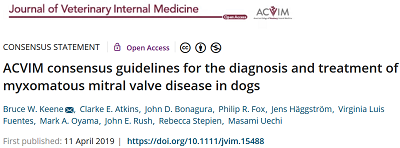 In an
April 2019 article, the ACVIM Consensus Statement panel (Bruce W.
Keene, Clarke E. Atkins, John D. Bonagura, Philip R. Fox, Jens
Haggstrom, Virginia Luis Fuentes, Mark A. Oyama, John E. Rush, Rebecca
Stepien, Masami Uechi) have revised the
2009 ACVIM Consensus
Statement on MVD-affected dogs by changing the definitions of Stage
B1 and B2. In the 2009 statement, Stage B1 dogs were those with mitral
murmurs but had no heart enlargement, and Stage B2 dogs were those which
also did have enlarged hearts. This 2019 statement makes the following
changes to the definitions of Stages B1 and B2:
In an
April 2019 article, the ACVIM Consensus Statement panel (Bruce W.
Keene, Clarke E. Atkins, John D. Bonagura, Philip R. Fox, Jens
Haggstrom, Virginia Luis Fuentes, Mark A. Oyama, John E. Rush, Rebecca
Stepien, Masami Uechi) have revised the
2009 ACVIM Consensus
Statement on MVD-affected dogs by changing the definitions of Stage
B1 and B2. In the 2009 statement, Stage B1 dogs were those with mitral
murmurs but had no heart enlargement, and Stage B2 dogs were those which
also did have enlarged hearts. This 2019 statement makes the following
changes to the definitions of Stages B1 and B2:
Stage B1: MVD-affected dogs with either no heart enlargement
or with echocardiographic or radiographic (x-ray) evidence of
enlargement below the enlargement criteria of Stage B2.
Stage B2:
Any MVD-affected dog with these minimum measurements:
• murmur intensity >3/6;
• echocardiographic LA:Ao ratio in the right-sided short axis view in early diastole >1.6;
• left ventricular internal diameter in diastole, normalized for body weight (LVIDDN) >1.7;
• breed-adjusted radiographic vertebral heart score (VHS) >10.5.
• Ideally, all these criteria should be met before initiating treatment, because treatment represents a lifelong commitment. Of these criteria, echocardiographic evidence of left atrial and ventricular enlargement meeting or exceeding these criteria is considered to be the most reliable way to identify dogs expected to benefit from treatment.
This new definition of Stage B2 is the same as that used in the 2016 EPIC Study (which was fully financed by Boehringer Ingelheim, the exclusive patent holder for Vetmedin/pimobendan), with the exception that the VHS>10.5 was not "breed-adjusted" in the EPIC Study. The 2019 Consensus panel unanimously recommends that any Stage B2 dog be treated with pimobendan at a dosage of 0.25-0.3 mg/kg twice a day. No other medication is recommended for Stage B2 by more than half the panel. In the article's Conflict of Interest Declaration, all ten of the panelists admit that they have been consultants for Vetmedin's manufacturer, Boehringer Ingelheim, and presumably have been financially rewarded for their services to that company.
 EDITOR'S NOTE: This is the most unfortunate
and risky cardiology advice for
EDITOR'S NOTE: This is the most unfortunate
and risky cardiology advice for
 treating cavaliers which has ever been
published. This is an example of what can happen when a veterinary
organization which accepts sponsorship funds from a pharmaceutical
company (see screen-shot image at left taken from ACVIM's website), throws its ethics to the wind and
assigns people who previously have been paid by that same pharmaceutical
company, to write a paper which advocates prescribing that company's
pharmaceutical, and only that company's
pharmaceutical, to dogs which may very well not have any heart enlargement
at all. At the very least, none of the authors should have had
any consulting relationship with Boehringer Ingelheim, the manfacturer
of pimobendan (Vetmedin). In this case, all ten of them have had such a
relationship with it.
treating cavaliers which has ever been
published. This is an example of what can happen when a veterinary
organization which accepts sponsorship funds from a pharmaceutical
company (see screen-shot image at left taken from ACVIM's website), throws its ethics to the wind and
assigns people who previously have been paid by that same pharmaceutical
company, to write a paper which advocates prescribing that company's
pharmaceutical, and only that company's
pharmaceutical, to dogs which may very well not have any heart enlargement
at all. At the very least, none of the authors should have had
any consulting relationship with Boehringer Ingelheim, the manfacturer
of pimobendan (Vetmedin). In this case, all ten of them have had such a
relationship with it.
"Turning a Blind Eye" should be the sub-title for this Consensus Statement, because its authors either ignore or mis-state so many previously established facts about MVD and heart enlargement and even about pimobendan itself, that there can be no better explanation for what they have written.
For starters, previously published studies have shown that if pimobendan is administered prematurely, it can cause MVD to progress more rapidly in some dogs, and otherwise damage the dogs' hearts. This 2019 Consensus Statement ignores those reported risks to prescribing the drug prior to congestive heart failure.
Next, the parameters for determining if a dog's heart is enlarged should not be species-wide. No such species-wide studies have been published which justify applying a single measurement as being the dividing line between a normal-sized left atrium or left ventricle and an enlarged left atrium or left ventricle. Nevertheless, these authors apply three species-wide dividing lines and conclude that if any dog's heart exceeds them, the dog necessarily has an enlarged heart and should be administered pimobendan for the rest of its life.
At the very least, the definition of enlargement should be based upon breed-specific parameters, assuming any scientifically reliable breed-specific research can be cited. (Needless to say, the Consensus Statement authors have cited none.) But ideally, they should be dog-specific. Cardiologists have been taught and trained to make a determination as to whether the patient on their table either has or does not have an enlarged heart. They do it by examining and comparing sets of x-rays to observe whether the heart has both gotten larger and has changed shape, indicating that the left atrium and/or left ventricle has enlarged. Indeed, the 2009 Consensus Statement's definition of Stage B2 left to the examining cardiologist the determination of heart enlargement using just this sort of dog-specific method of diagnosis.
This new ACVIM Consensus Statement is designed to by-pass these tried-and-true dog-specific methods and instead simply compare the dogs' measurements to the species-wide parameters and leave it at that. This is not the practice of veterinary cardiology. It is the marketing of an expensive drug which may not be necessary and has a history of damaging the hearts of some dogs which do not need it.

This revision of the ACVIM's 2009 Consensus Statement on MVD essentially means that, regardless of obvious, known breed differences in normal-sized hearts, any MVD-affected dog of any breed should be prescribed pimobendan if their x-ray and echocardiographic measurements meet this new minimum species-wide definition of heart enlargement. Consensus panelist Dr. Haggstrom ironically debunked this new dumbed-down concept when he stated in another recently published article:
"Many common echocardiographic variables are presumed to be influenced by breed, and breed-specific reference ranges are likely to be more accurate than ranges generated from dogs of all-breeds."
Unlike in the 2009 Consensus Statement's definition of Stage B2, no longer are veterinarians expected to use their professional training and judgment to examine x-rays of each dog's heart and determine from both the size and shape of that particular heart whether it is enlarged or not. From now on, this minimum definition of heart enlargement is to apply to any and all dogs of all breeds, regardless of the shape of the dogs' hearts. From now on, the B in Stage B might as well stand for Bogus, because from now on, when a cardiologist tells you that your cavalier is in Stage B2, that really will not tell you anything accurate about your dog's heart.
These authors must know that their definition is bogus, and that dogs -- especially cavaliers -- with normal-sized hearts necessarily will be mis-diagnosed as having enlarged hearts and will be given pimobendan for the rest of their lives. How is it bogus? Well, an excellent example is their left ventricle minimum measurement LVIDDN = 1.7. This measurement came directly from the EPIC Study. In that study, authors Boswood, Haggstrom, and Gordon chose that minimum measurement before the trial began. Then, the EPIC authors concluded their report by recommending that the LVIDDN >1.7 remain in their definition, despite the facte that the lead EPIC Study investigator, Dr. Boswood, admitted shortly after the EPIC Study report was published:
"Now interestingly, if you look in the literature, the normalized left ventricular diameter of 1.7 is in the normal range. The abnormal is above about 1.85, [1.]9, 1.9 depending upon how you read it, so that's nudging the top of the normal range but still normal."
As for the other minimum species-wide echo measurement of LA:Ao = 1.6, for an enlarged left atrium, the jury is still out, with an upcoming article expected to dispute reliance upon that measurement as being an accurate minimum for all dogs.
Notwithstanding this undisputed evidence, in the 2019 Consensus Statement the ten authors make this totally un-supportable statement:
"Of these criteria, echocardiographic evidence of left atrial and ventricular enlargement meeting or exceeding these criteria is considered to be the most reliable way to identify dogs expected to benefit from treatment."
The Consensus Statement authors hedge a bit on their definition of the EPIC Study's minimum x-ray measurement of VHS >10.5, which shows that they know it is totally fictitious on a species-wide basis. They ambiguously define the minimum VHS as "breed-adjusted radiographic vertebral heart score (VHS) >10.5." But, nevertheless, they include VHS >10.5 in their criteria for prescribing pimobendan to any dog. They ignore the scientifically reliable evidence in published studies that cavaliers have had normal-sized hearts with VHS values as high as 11.9, and other breeds have them above 12.0v.
And finally, by recommending that all MVD-affected dogs be treated with pimobendan if their heart measurements meet these arbitrary, untested, and unproven low-ball, species-wide minimums, the Consensus panel also ignores published studies which show that as many as 70% to 80% of MVD-affected dogs with some enlargement will never progress to congestive heart failure (CHF) whether they are medicated or not. Since the purpose of starting pimobendan before CHF is to delay the onset of CHF, as many as 80% of these dogs will never need to be treated with this extremely expensive drug at all, much less for the rest of their lives.
Why would they do this? Why do they advocate prescribing
pimobendan/Vetmedin to dogs which they must realize may well not have
enlarged hearts at all? Well, all but one of the ten 2019 Consensus Statement
authors
also were among the EPIC Study investigators (which was fully and
generously funded by Vetmedin's
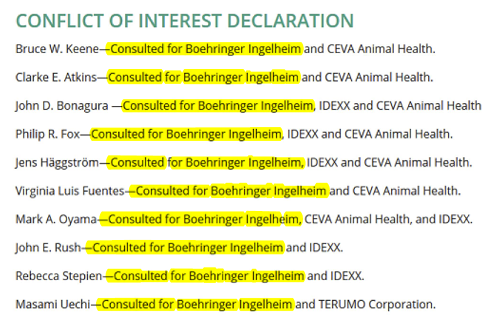 manufacturer, Boehringer Ingelheim).
And, all ten of them have admitted in the Consensus Statement itself of
having "consulted for Boehringer Ingelheim", in their "Conflict of
Interest Declaration" (at right). So, they have been financially conflicted by the
maker and patent-holder of pimobendan. In view of these conflicts, none
of them should have been selected for this consensus panel, and all of
them should have declined their selection.
manufacturer, Boehringer Ingelheim).
And, all ten of them have admitted in the Consensus Statement itself of
having "consulted for Boehringer Ingelheim", in their "Conflict of
Interest Declaration" (at right). So, they have been financially conflicted by the
maker and patent-holder of pimobendan. In view of these conflicts, none
of them should have been selected for this consensus panel, and all of
them should have declined their selection.
March 2019:
Pilot study of pimobendan treatment of ACVIM Stage B1
MVD-affected dogs shows a decrease in lactate values after exercise. In
a 2018 veterinary medicine doctorate dissertation, a student
(Nayeli Iwanuk) at the Hannover Veterinary College in Germany has
submitted for publication still pending at publisher PloS ONE, a study
of the effect of pimobendan on 21 ACVIM Stage B1 (heart murmur but no
heart enlargement) dogs affected with mitral valve disease (MVD),
including one cavalier King Charles spaniel. The purpose of the study
was to invesigate the influence of pimobendan regarding exercise
tolerance, fitness, and quality of life in MVD-affected dogs prior to
heart enlargement. The study compared 11 dogs treated with pimobendan at
a standard treatment dose of 0.4
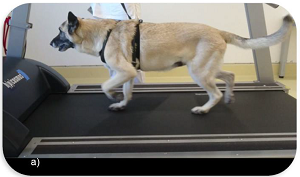 milligram per kilogram per day to 10
dogs given a placebo for a period of 180 days. On the first, 90th, and
180th day, each dog was given a motorized treadmill test during which
the dog's distance traveled, heart rate, and lactate levels (before and
after exercise) were monitored, and echocardiograph parameters also were
measured. (Photo at right shows a dog on the treadmill with a heart rate
monitor belt.) The dogs' owners also completed a questionnaire regarding
any changes observed in the dogs. Distance covered in treadmill tests is
an indicator of exercise tolerance and fitness level in MVD-affected
dogs. While exercising, blood lactate reportedly increases earlier in
dogs in heart failure than in dogs without any cardiac disease, and
lactate values tend to be higher in MVD-affected dogs. The higher the
lactate level in dogs in heart failure, the lower the oxygen
concentration is in the tissues.
milligram per kilogram per day to 10
dogs given a placebo for a period of 180 days. On the first, 90th, and
180th day, each dog was given a motorized treadmill test during which
the dog's distance traveled, heart rate, and lactate levels (before and
after exercise) were monitored, and echocardiograph parameters also were
measured. (Photo at right shows a dog on the treadmill with a heart rate
monitor belt.) The dogs' owners also completed a questionnaire regarding
any changes observed in the dogs. Distance covered in treadmill tests is
an indicator of exercise tolerance and fitness level in MVD-affected
dogs. While exercising, blood lactate reportedly increases earlier in
dogs in heart failure than in dogs without any cardiac disease, and
lactate values tend to be higher in MVD-affected dogs. The higher the
lactate level in dogs in heart failure, the lower the oxygen
concentration is in the tissues.
The student reported that:
• Treadmill: No significant difference in covered distance on the treadmill or in heart rate, and no improvement was observed in either of the two groups. Thus, pimobendan had no effect upon treadmill distance, heart rate, or improvement over time.
• Lactate: Treadmill exercise is expected to result in an increase in lactate-values in dogs. In this study, the pimobendan dogs showed a decrease, and the placebo dogs showed an increase, in lactate values after the exercise.
• Questionnaire: Owners reported that dogs in the pimobendan group were significantly more active than those in the placebo group, on days 90 and 180 of the study.
• Ultrasound: There was no reduction in heart size or increase in fractional shortening due to the pimobendan treatment. Pimobendan had no positive or negative effects on any echocardiographic parameters in the dogs in the study.
• Progression of MVD: Two dogs in the placebo group, and none of the dogs in the pimobendan group, advanced from Stage B1 to Stage B2 (heart enlargement) by the end of the study.
The author acknowledges that the study is a very preliminary pilot study with several significant limitations, and that, "there is no consensus regarding effects of pimobendan on cardiac morphology changes" to be drawn from the study.
EDITOR'S NOTE: This is an interesting effort to test the effects of pimobendan on MVD-affected dogs without any heart enlargement -- Stage B1 dogs. It is not the first one, however. Of course, the terribly-flawed EPIC Study of MVD-affected dogs with alleged heart enlargement probably included several, if not a majority, of its 354 dogs, without any enlargement at all. You see, the EPIC Study's lead investigators have admitted that they only assumed that the dogs had enlarged hearts, since they made up a species-wide "definition" of heart enlargement which they had to know would likely include dogs with normal sized hearts. Especially cavaliers, which made up almost half of all the dogs in the study. The EPIC Study investigators intentionally failed to confirm if any of their study's dogs really had enlarged hearts by conducting any dog-specific (or even breed-specific) analyses of the dogs' hearts.
Anyway, not much was learned in this present effort except that none of the dogs' hearts got worse while taking pimobendan for six months. That is promising information, even if only 11 dogs participated in the pimobendan group, since prior studies showed that pimobendan could worsen the MVD in dogs not yet in heart failure, and even in the EPIC Study, 8.4% of the dogs in the pimobendan group died suddenly of cardiac arrest. None of the pimobendan-group dogs died in this current study, or even advanced to Stage B2, so that is good news.
March 2019:
NC State researchers strike out in genetically linking serotonin
to mitral valve prolapse in MVD-affected dogs.
 In
a
March 2019 abstract, North Carolina State veterinary researchers
(Brian Williams, Steven G. Friedenberg, Kathryn M. Meurs [right])
report testing the involvement of serotonin in the development of mitral
valve prolapse (MVP) in dogs. They obtained DNA samples from 51 dogs
with MVP and performed whole genome sequencing. They searched for shared
genes and/or gene families in the serotonin receptor signaling (SRS)
pathway. They report that no single high impact variant or gene or gene
family accounted for all of the dogs. They concluded that, although
serotonin may play a role in the development of MVP, it may not be the
primary genetic cause of the disorder.
In
a
March 2019 abstract, North Carolina State veterinary researchers
(Brian Williams, Steven G. Friedenberg, Kathryn M. Meurs [right])
report testing the involvement of serotonin in the development of mitral
valve prolapse (MVP) in dogs. They obtained DNA samples from 51 dogs
with MVP and performed whole genome sequencing. They searched for shared
genes and/or gene families in the serotonin receptor signaling (SRS)
pathway. They report that no single high impact variant or gene or gene
family accounted for all of the dogs. They concluded that, although
serotonin may play a role in the development of MVP, it may not be the
primary genetic cause of the disorder.
February 2019:
UK study compares pulmonary hypertension prevalance between MVD-affected
cavaliers and other breeds.
 In a
June 2019 article, a team of UK's Univ. of Liverpool cardiology
researchers (Siddharth Sudunagunta [right], D.Green, R.Christley, J.Dukes-McEwan) sought to determine if MVD-affected cavalier King Charles
spaniels (CKCS) are more likely to develop pulmonary hypertension (PH)
than MVD-affected dogs of other breeds. Ninety-four CKCSs were compared
with 93 other dogs (= 187 dogs) in a variety of stages of MVD, some with
PH and some without. They compared several different measurements of
MVD, including the ACVIM stages (Stage B2, C, and D), and echo
variables of left-atrium-to-aortic ratio (LA/Ao), E wave velocity (E
vel) and isovolumic relaxation time (E/IVRT) and found that all of them
were significant in the development of PH. However, instead of finding
that cavaliers were uniquely disposed to PH, they concluded that for all
breeds, the worsening of MVD, from ACVIM stage B2 to C to D, was the
predominant determinant of PH development. However, 59.4% of the Stage
B2 CKCSs and 38.3% of the Stage B2 non-CKCSs had PH, indicating that the
onset of PH can precede the onset of congestive heart failure (CHF). As additional findings,
they confirmed that CKCSs are more likely to experience cardiac death
than the other breeds, and that PH is associated with greater likelihood
of reaching CHF and cardiac death.
("Associated with" means that they cannot confirm
that PH is the cause of CHF or death.) They stated that, "Further
studies are needed to determine the causative mechanism for PH
development in CKCS with MMVD."
In a
June 2019 article, a team of UK's Univ. of Liverpool cardiology
researchers (Siddharth Sudunagunta [right], D.Green, R.Christley, J.Dukes-McEwan) sought to determine if MVD-affected cavalier King Charles
spaniels (CKCS) are more likely to develop pulmonary hypertension (PH)
than MVD-affected dogs of other breeds. Ninety-four CKCSs were compared
with 93 other dogs (= 187 dogs) in a variety of stages of MVD, some with
PH and some without. They compared several different measurements of
MVD, including the ACVIM stages (Stage B2, C, and D), and echo
variables of left-atrium-to-aortic ratio (LA/Ao), E wave velocity (E
vel) and isovolumic relaxation time (E/IVRT) and found that all of them
were significant in the development of PH. However, instead of finding
that cavaliers were uniquely disposed to PH, they concluded that for all
breeds, the worsening of MVD, from ACVIM stage B2 to C to D, was the
predominant determinant of PH development. However, 59.4% of the Stage
B2 CKCSs and 38.3% of the Stage B2 non-CKCSs had PH, indicating that the
onset of PH can precede the onset of congestive heart failure (CHF). As additional findings,
they confirmed that CKCSs are more likely to experience cardiac death
than the other breeds, and that PH is associated with greater likelihood
of reaching CHF and cardiac death.
("Associated with" means that they cannot confirm
that PH is the cause of CHF or death.) They stated that, "Further
studies are needed to determine the causative mechanism for PH
development in CKCS with MMVD."
EDITOR'S NOTE: No surprises here, except that the study finds that cavaliers are not unique in developing pulmonary hypertension. Instead, the severity of the MVD for all dogs, as it progresses through the stages from B2 to C to D, determines if and when PH commences. It confirms that CKCSs are more likely to die from MVD than are other breeds.
In a December 2019 review of this UK study report, board certified veterinary cardiologist Dr. Mark Rishniw, an editor of Advances in Small Animal Medicine and Surgery, harshly critiques the study for:
(a) "[T]he CKCS in their study simply were 'worse off' at presentation than the non- CKCS dogs."
(b) "First, the authors selected dogs in which a tricuspid regurgitation jet could be measured. It is possible that this biased the population towards selecting dogs with elevated pulmonary artery pressures."
(c) "Second, the authors used a very low threshold tricuspid regurgitation value (2.8 m/s) to identify PHn. This would necessarily increase the number of false-positive cases (dogs that are identified as having PH but are actually normotensive)."
(d) "Finally, the authors did not differentiate between degrees of PH. Clinicians know and expect some PH with more severe MMVD. If this hypertension is 'appropriate' and mild, it is clinically inconsequential and can be ignored. Only 'inappropriate' and more severe hypertension concerns us and might warrant intervention."
(e) "Therefore, clinicians should recognize that PH can occur in dogs with MMVD, and that CKCS are no more 'prone' to developing this type of PH than other breeds. With more severe MMVD, clinicians should always consider assessing whether PH exists and whether it warrants therapeutic intervention."
February 2019:
PennVet cardiologists find regurgitant fraction and other echo
measurements of volume more accurately predict severity of MVD.
 In a
February 2019 article, a team of PennVet cardiology researchers (eva
Larouche-Lebel, Kerry A. Loughran, Mark A. Oyama [right]) compared
multidimensional echocardiographic indices of volume -- mitral
regurgitant fraction (RF), effective regurgitant orifice area (EROA),
and ratio of mitral regurgitation to aortic flow rate (Qmr:Qao) -- with
1-dimensional measurements of left heart size -- left atrium to aortic
root diameter ratio (LA:Ao) and normalized left ventricular internal
diameter at end‐diastole (LVIDdN). The purpose of the study was to
determine how best to determine the severity of the backflow of blood
through the mitral valve, called mitral regurgitation (MR), in
MVD-affected dogs both before any observed heart enlargement and before
heart failure. They found that the multidimensional indices of MR volume
far better measured the severity of MR than did the 1-dimensional
measurements. They concluded:
In a
February 2019 article, a team of PennVet cardiology researchers (eva
Larouche-Lebel, Kerry A. Loughran, Mark A. Oyama [right]) compared
multidimensional echocardiographic indices of volume -- mitral
regurgitant fraction (RF), effective regurgitant orifice area (EROA),
and ratio of mitral regurgitation to aortic flow rate (Qmr:Qao) -- with
1-dimensional measurements of left heart size -- left atrium to aortic
root diameter ratio (LA:Ao) and normalized left ventricular internal
diameter at end‐diastole (LVIDdN). The purpose of the study was to
determine how best to determine the severity of the backflow of blood
through the mitral valve, called mitral regurgitation (MR), in
MVD-affected dogs both before any observed heart enlargement and before
heart failure. They found that the multidimensional indices of MR volume
far better measured the severity of MR than did the 1-dimensional
measurements. They concluded:
"The strengths of volumetric methods are their relative ease of use, lack of reliance on color flow Doppler, and applicability in cases of multiple or eccentric MR jets, which are common in dogs with DMVD. Despite the simplicity of the current method, RF showed good discrimination of the study cohort. ... Regurgitant fraction, EROA, and Qmr:Qao quantify MR severity in dogs with preclinical DMVD in a manner that 1-dimensional measurements do not. ... The study was observational in nature and longitudinal studies are needed to relate RF with the timeline of disease progression."
 EDITOR'S NOTE: This is not
totally new news, of course, since at least two
prior studies, in
January 2003 and
August 2007, reached a similar comclusion -- that the regurgitation
fraction correlated well with MVD severity. What we are being told here
is that these volumetric measurements are (a) relatively easy to use,
and (b) far more accurate than linear measurements of atrium and
ventricle size, in predicting MVD severity. These measurements are
useful before any enlargement of the heart is observed.
EDITOR'S NOTE: This is not
totally new news, of course, since at least two
prior studies, in
January 2003 and
August 2007, reached a similar comclusion -- that the regurgitation
fraction correlated well with MVD severity. What we are being told here
is that these volumetric measurements are (a) relatively easy to use,
and (b) far more accurate than linear measurements of atrium and
ventricle size, in predicting MVD severity. These measurements are
useful before any enlargement of the heart is observed.
On another note, a part of this research was the authors' reliance of the EPIC Study's bogus species-wide definition of left atrium enlargement as LA:Ao = 1.6 and left ventricle enlargement as LVIDdN = 1.7. The LA:Ao ratio is open for debate, but the LVIDdN = 1.7 is so fictitious that even the EPIC Study's lead investigator, Dr. Adrian Boswood, has acknowledged that 1.7 falls well within the range of normal sized hearts for several breeds. He said:
"Now interestingly, if you look in the literature, the normalized left ventricular diameter of 1.7 is in the normal range. The abnormal is above about 1.85, [1.]9, 1.9 depending upon how you read it, so that's nudging the top of the normal range but still normal."
Since in this current study, oddly, no breeds are identified (except one bull terrier), it is impossible to ascertain how use of the bogus left ventricle enlargement definition of LVIDdN = 1.7 has skewed the significance of this study's findings and conclusions.
February 2019:
Brazilian researchers compare x-rays and echocardiographic
measurements to measure mean left atrial pressure in MVD-affected dogs.
 In
a
February 2019 article, a team of Brazilian veterinary heart
specialists (Flavio Shigueru Jojima [right], Stephany Buba
Lucina, Alexandre Leseur Santos, Marlos Gonçalves Sousa, Tilde Rodrigues
Froes) compared x-rays and echocardiograph scans of 93 MVD-affected dogs
(none being cavaliers) to
diagnose high mean left atrial pressure (MLAP). Their goal was to devise
an equation to diagnose high MLAP by x-rays alone, without the need for
echo scanning. High MLAP in MVD-affected dogs is typically associated
with either present or impending congestive heart failure. Being able to
measure MLAP in a dog being medicated for MVD also enables the clinician
to monitor the dog's response to treatment. The prospect of general
practice veterinarians being able to measure MLAP using only x-rays
would result in less expensive care and more GPs performing those
services since echocardiograph exams would not be necessary.
In
a
February 2019 article, a team of Brazilian veterinary heart
specialists (Flavio Shigueru Jojima [right], Stephany Buba
Lucina, Alexandre Leseur Santos, Marlos Gonçalves Sousa, Tilde Rodrigues
Froes) compared x-rays and echocardiograph scans of 93 MVD-affected dogs
(none being cavaliers) to
diagnose high mean left atrial pressure (MLAP). Their goal was to devise
an equation to diagnose high MLAP by x-rays alone, without the need for
echo scanning. High MLAP in MVD-affected dogs is typically associated
with either present or impending congestive heart failure. Being able to
measure MLAP in a dog being medicated for MVD also enables the clinician
to monitor the dog's response to treatment. The prospect of general
practice veterinarians being able to measure MLAP using only x-rays
would result in less expensive care and more GPs performing those
services since echocardiograph exams would not be necessary.
In this study, the researchers were able to devise a set of somewhat complicated formulas involving several calculations from radiographic measurements. They found that the most accurate x-ray measurements were taken from the right lateral radiograph of each set of x-rays, rather than from the left lateral. Their formulas can estimate the LA:Ao ratio, the echocardiographic E wave, the E wave to isovolumetric relation time ratio (E:IVRT), and the E wave to E' wave ratio (E:E'). As an example, the found that, among the 93 dogs in their study, "if a patient with MMVD has a VHS above 12.2v, high MLAP is present, as well as cardiomegaly." They confirmed that, "VHS values may vary in relation to the breed of the dogs", as have several other recently published articles, all contradicting the EPIC Study's species-wide "definition" of any dog with a VHS > 10.5v necessarily having an enlarged heart. Nevertheless, for variety of the dogs in the current study, they found that, "a cut value of 12.2v is a useful tool in the specific analysis of these patients, mainly in the detection of cardiac volume overload."
February 2019:
Brazilian cardiologists emphasize the importance of
breed-specific VHS reference ranges to detect heart enlargement.
 In a
February 2019 article, a team of Brazilian researchers (Marilia
Gabriela Luciani [right], Jessica Aline Withoeft, Helena Mondardo Cardoso
Pissetti, Livia Pasini de Souza, Marina Silvestre Sombrio, Eloisa Carla
Bach, Wilfried Mai, Thiago Rinaldi Müller) compared the x-rays of 20
healthy Australian cattle dogs to determine the range of VHS (vertebral
heart scores) of the breed's normal-sized hearts. They found that the
mean VHS for the healthy Australian cattle dogs with normal-sized hearts
was 10.5 ± 0.4 vertebrae). They also noted that:
In a
February 2019 article, a team of Brazilian researchers (Marilia
Gabriela Luciani [right], Jessica Aline Withoeft, Helena Mondardo Cardoso
Pissetti, Livia Pasini de Souza, Marina Silvestre Sombrio, Eloisa Carla
Bach, Wilfried Mai, Thiago Rinaldi Müller) compared the x-rays of 20
healthy Australian cattle dogs to determine the range of VHS (vertebral
heart scores) of the breed's normal-sized hearts. They found that the
mean VHS for the healthy Australian cattle dogs with normal-sized hearts
was 10.5 ± 0.4 vertebrae). They also noted that:
• "Numerous studies have shown that there is significant breed-related variability of the VHS".
• "Reference ranges for different breeds (or for different thoracic conformations) need to be established."
• "The importance of interbreed differences has already led to the development of breed-specific ranges for echocardiography."
• "Several authors have recommended the use of breed-specific ranges when the VHS is used to evaluate cardiac size on radiographs".
• "This study ... emphasizes the importance of breed-specific VHS when assessing radiographs for cardiac disease."
 EDITOR'S NOTE:
This is one more research article demonstrating the
fallaciousness of the EPIC Study's species-wide "definition" of enlarged
hearts warranting prescribing pimobendan to MVD-affected dogs. In the
EPIC Study, its authors claim that any MVD-affected dog of any breed
with a VHS value above 10.5 had an enlarged heart. This current study
establishes that healthy cattle dogs with VHS values as high as 10.9 had
normal-sized hearts.
EDITOR'S NOTE:
This is one more research article demonstrating the
fallaciousness of the EPIC Study's species-wide "definition" of enlarged
hearts warranting prescribing pimobendan to MVD-affected dogs. In the
EPIC Study, its authors claim that any MVD-affected dog of any breed
with a VHS value above 10.5 had an enlarged heart. This current study
establishes that healthy cattle dogs with VHS values as high as 10.9 had
normal-sized hearts.
Whatever motivations prompted the EPIC Study authors to devise this
bogus "definition" of heart enlargement in their study fully funded by
the manufacturer of Vetmedin (pimobendan), clearly the EPIC Study report
needs to be withdrawn and its definition of heart enlargement needs to
be re-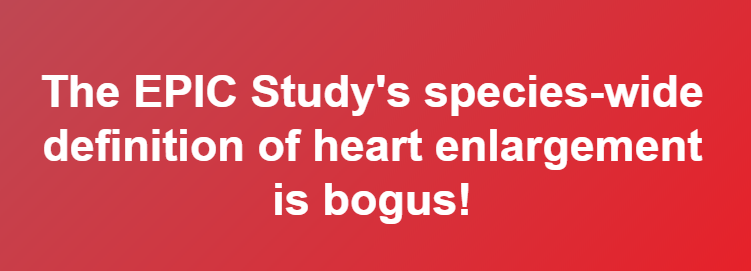 written before re-publication. Otherwise, the consequences of
prescribing pimobendan to dogs with normal-sized hearts could put those
dogs at serious risk of heart failure, and could deprive the drug to
other dogs which may need it but with enlarged hearts below the defined
minimum measurements.
written before re-publication. Otherwise, the consequences of
prescribing pimobendan to dogs with normal-sized hearts could put those
dogs at serious risk of heart failure, and could deprive the drug to
other dogs which may need it but with enlarged hearts below the defined
minimum measurements.
February 2019:
Computed tomography (CT) study of 226 dogs shows smaller dogs
have relatively larger hearts, and breed significantly influenced
results.
 In an
April 2019 article, a team of Japanese veterinary researchers
(T.Uehara, K.Orito, Yoko Fujii [right]) studied computed tomography (CT) scans of 226 dogs of various breeds and
sizes, all without heart or lung disorders, including two cavalier King
Charles spaniels. Their purpose was to determine if and how hearts and
airways differ by body size. They report finding that:
In an
April 2019 article, a team of Japanese veterinary researchers
(T.Uehara, K.Orito, Yoko Fujii [right]) studied computed tomography (CT) scans of 226 dogs of various breeds and
sizes, all without heart or lung disorders, including two cavalier King
Charles spaniels. Their purpose was to determine if and how hearts and
airways differ by body size. They report finding that:
• Anatomical features of the heart and large airways are influenced by body size.
• Small dogs had a larger heart volume than large dogs.
• The distance from the mainstem bronchi to the vertebra was short in small dogs.
• Small dogs had oval-shaped trachea compared to large dogs.
• Dog breed significantly influenced the results.
They speculated from these results that "these anatomical characteristics in small dogs ... might compress mainstem bronchi when the left atrium is enlarged, thus triggering coughing, a common clinical sign of this disease."
EDITOR'S NOTE: The authors' finding that "dog breed significantly influenced the results" -- meaning that different breeds have different sized hearts -- is but one more reason why the EPIC Study's species-wide definition of enlarged hearts is totally bogus. How many reasons do the EPIC Study authors need to be convinced that they should withdraw their article to re-define heart enlargement to be, at the very least, breed-specific and ideally patient-specific instead of making up an impossible definition of heart enlargement to include every MVD-affected dog of every breed? The EPIC Study's irresponsible
definition is being used worldwide as a shortcut to (a) prescribing pimobendan to dogs with normal-sized hearts -- thus putting those dogs at serious risk of heart failure -- and (b) not prescribing it to dogs which may need it but with enlarged hearts below the defined minimum measurements.
February 2019:
Dr. Mark Kittleson summarizes what congestive heart
failure is, what it is not, how to detect it, and how to treat it.
 Dr. Mark Kittleson
(right), veterinary cardiologist at the University of
California, Davis School of Veterinary Medicine, was interviewed for the
February 2019 issue of Veterinary Practice News by Marissa Heflin. Dr.
Kittleson summarized what congestive heart failure is, and what it is
not, and how to detect it and diagnose it, and how to treat it. Ms.
Heflin quotes Dr. Kittleson, as follows:
Dr. Mark Kittleson
(right), veterinary cardiologist at the University of
California, Davis School of Veterinary Medicine, was interviewed for the
February 2019 issue of Veterinary Practice News by Marissa Heflin. Dr.
Kittleson summarized what congestive heart failure is, and what it is
not, and how to detect it and diagnose it, and how to treat it. Ms.
Heflin quotes Dr. Kittleson, as follows:
"Heart failure is caused by severe, overwhelming structural heart disease (e.g., valvular leak or myocardial failure)," Dr. Kittleson says. "That's important. Many veterinarians think mild to moderate heart disease can result in heart failure. It cannot." ...
"We commonly see dogs with chronic bronchitis misdiagnosed as being in heart failure," Kittleson says. "Small, older dogs are prone to both mitral regurgitation due to myxomatuous mitral valve disease and to chronic bronchitis. Both pulmonary edema and chronic bronchitis can produce a cough -- actually chronic bronchitis always produces a cough. It's common for a little old coughing dog to have a murmur and the veterinarian then assume the cough is due to pulmonary edema (left-sided heart failure)."
While chronic bronchitis and pulmonary edema both cause a dog to cough, only pulmonary edema results in an increase in respiratory rate, according to Kittleson. It can also cause dyspnea [shortness of breath, labored breathing].
"It takes severe, overwhelming heart disease to result in heart failure and pulmonary edema causes tachypnea [abnormally rapid breathing]," Kittleson says. "Severe overwhelming mitral regurgitation creates a severely enlarged left atrium, which can be seen on chest films."
Kittleson sets up the next steps; First, take chest films to see if the left atrium is severely enlarged or not. If it is, have the owner count the dog's respiratory rate when it is asleep. If the left atrium is severely enlarged and the sleeping respiratory rate is elevated, conduct a Lasix trial. If the sleeping respiratory rate comes down on Lasix, the dog is in left-sided heart failure. If not, the dog most likely has chronic bronchitis. ...
Dogs with mitral regurgitation can be given pimobendan prior to the onset of CHF with the aim of delaying the progression, according to Kittleson. Pimobendan slows the progression of left-sided heart failure (pulmonary edema) in many, but not all, dogs with mitral regurgitation, he adds.
"I think the important thing to relay is [pimobendan] is indicated in dogs with moderate to severe mitral regurgitation, which means the left atrium needs to be moderately to severely enlarged before it should be started in a dog with subclinical [meaning, not in CHF] mitral regurgitation," he says.
February 2019:
High doses of ACE-inhibitor alacepril reduced the left
atrial pressure in laboratory Beagles with induced mitral regurgitation.
 In a
January 2019 article, Japanese veterinary cardiology researchers
(Seijirow Goya, Tomoki Wada, Kazumi Shimada, Daiki Hirao, Ryou Tanaka,
[right]) tested six laboratory Beagle dogs to determine the effect of high-doses
of the ACE-inhibitor alacepril on left atrial pressure in Stage B2
(enlarged hearts) MVD-affected dogs. Mitral regurgitation in the dogs
was surgically created by intentionally rupturing chordae tendineae by
tearing the chords with forceps. As a result, the left atriums and
ventricles of all six dogs' hearts became enlarged. After treatment with
high doses (6.0mg/kg/day) of alacepril, the dogs' left atrial pressure
(LAP) and central aortic pressure decreased within seven days. They
concluded that:
In a
January 2019 article, Japanese veterinary cardiology researchers
(Seijirow Goya, Tomoki Wada, Kazumi Shimada, Daiki Hirao, Ryou Tanaka,
[right]) tested six laboratory Beagle dogs to determine the effect of high-doses
of the ACE-inhibitor alacepril on left atrial pressure in Stage B2
(enlarged hearts) MVD-affected dogs. Mitral regurgitation in the dogs
was surgically created by intentionally rupturing chordae tendineae by
tearing the chords with forceps. As a result, the left atriums and
ventricles of all six dogs' hearts became enlarged. After treatment with
high doses (6.0mg/kg/day) of alacepril, the dogs' left atrial pressure
(LAP) and central aortic pressure decreased within seven days. They
concluded that:
"This magnitude of reduction in LAP (17.2 to 14.8 mmHg) resulted from decreasing central aortic pressure might be clinically important in dogs with naturally occurred MR [mitral regurgitation]; although it is necessary to investigate this further."
January 2019:
Swedish cardiologists compare 2-dimensional and
3-dimensional measurements of left atrial size in MVD-affected dogs.
 In a
January 2019 article, Swedish cardiology researchers (Anna
Tidholm [right], Anna Bodegård‐Westling, Katja Hoglund, Jens Haggstrom,
Ingrid Ljungvall) compared the results of various two-dimensional and
three-dimensional echocardiographic measurements of the sizes of the
left atriums (LA) of 124 dogs of 43 breeds (inlcuding 24 cavalier King
Charles spaniels) to determine which two-dimensional means was most
accurate. All measurements for each dog were made during the same
echocardiographic examination. They acknowledged that magnetic resonance
imaging (MRI) and computed tomography (CT) were "gold standard
techniques", and they assumed that the real‐time 3‐dimensional (RT3DE)
method was most accurate among echocardiograms, since when atiums
enlarge, they do so in a three-dimensional and asymmetrical manner.
However, they noted that RT3DE scanning is more time-consuming and may
require more specialized equipment for analysis. Therefore, they sought
to determine the most accurate two-dimensional method when compared to
RT3DE measurements. The two-dimensional methods they used were Simpson's
modified method of discs (SMOD) and the area‐length method (ALM) indexed
to body weight (BW). They concluded:
In a
January 2019 article, Swedish cardiology researchers (Anna
Tidholm [right], Anna Bodegård‐Westling, Katja Hoglund, Jens Haggstrom,
Ingrid Ljungvall) compared the results of various two-dimensional and
three-dimensional echocardiographic measurements of the sizes of the
left atriums (LA) of 124 dogs of 43 breeds (inlcuding 24 cavalier King
Charles spaniels) to determine which two-dimensional means was most
accurate. All measurements for each dog were made during the same
echocardiographic examination. They acknowledged that magnetic resonance
imaging (MRI) and computed tomography (CT) were "gold standard
techniques", and they assumed that the real‐time 3‐dimensional (RT3DE)
method was most accurate among echocardiograms, since when atiums
enlarge, they do so in a three-dimensional and asymmetrical manner.
However, they noted that RT3DE scanning is more time-consuming and may
require more specialized equipment for analysis. Therefore, they sought
to determine the most accurate two-dimensional method when compared to
RT3DE measurements. The two-dimensional methods they used were Simpson's
modified method of discs (SMOD) and the area‐length method (ALM) indexed
to body weight (BW). They concluded:
"In conclusion, neither of the 2 biplane estimations of LA volumes corrected for BW using SMOD or ALM showed good agreement with RT3DE-generated LA volumes obtained from the same acquisition. The absolute differences between methods increased with increasing size of LA, but the percentage differences were reasonably constant over the range of LA sizes of dogs included in the study. The systematic difference of 7% between RT3DE and SMOD probably is of little consequence in the clinical setting, whereas the 24% difference between RT3DE and ALM and the 30% difference between SMOD and ALM presumably are of more clinical importance. The 2 2DE-based methods should not be used interchangeably because good agreement between methods was not found."
 EDITOR'S NOTE: The main premise in this
article, that left atrial size is "1 of the strongest predictors of
outcome of dogs with myxomatous mitral valve disease (MMVD)", is an
example of how severely limited prior research can be turned into a
totally misleading but arguably absolute and unerring gold standard. The
two prior articles (Borgarelli 2008, and
Borgarelli 2012) cited by these
researchers to justify that statement do not support it in the least,
when those two articles' stated limitations are taken into account.
EDITOR'S NOTE: The main premise in this
article, that left atrial size is "1 of the strongest predictors of
outcome of dogs with myxomatous mitral valve disease (MMVD)", is an
example of how severely limited prior research can be turned into a
totally misleading but arguably absolute and unerring gold standard. The
two prior articles (Borgarelli 2008, and
Borgarelli 2012) cited by these
researchers to justify that statement do not support it in the least,
when those two articles' stated limitations are taken into account.
To try to determine heart enlargement in a particular clinical patient based upon the one-time measurement of the sizes of the left atriums of many dogs of many different breeds is a non-starter. The fact is that "left atrial size" is not even a predictor whether the dog has MVD at all. The predictor is not the LA's size -- it is whether the LA is enlarged -- and that requires knowledge of the size of the LA at a previous time, so that the two measurements may be compared. If the earlier measurement -- the baseline -- is smaller than the current one, then indeed the LA is enlarged and the dog therefore may be destined to reach heart failure or a cardiac death. But if the baseline and the current measurements are the same, even if relatively large when compared to some other dogs of other breeds, then there has been no enlargement of the LA at all, and the size of that dog's LA is irrelevant.
January 2019:
Thai researchers report that polypeptide humanin (HN) levels
decrease as MVD progresses.
 In a
December 2018 article, a team of researchers at Chiang Mai
University in Thailand (K. Mangkhang, V. Punyapornwithaya, P. Tankaew,
W. Pongkan, N. Chattipakorn, Chavalit Boonyapakorn [right]) report finding that in a study of 31 dogs (none
were cavaliers) grouped in four classes (no MVD, Stage B, Stage C, and
Stage D), the levels of humanin (HN), a polypeptide in blood plasma, was
lower in dogs diagnosed with mitral valve disease (MVD), and that plasma
HN were significantly lower in ACVIM Stages C and D than in healthy
dogs. Also, they report finding that plasma NT-proBNP changed
significantly only in MVD-affected dogs in Stage D. They concluded:
In a
December 2018 article, a team of researchers at Chiang Mai
University in Thailand (K. Mangkhang, V. Punyapornwithaya, P. Tankaew,
W. Pongkan, N. Chattipakorn, Chavalit Boonyapakorn [right]) report finding that in a study of 31 dogs (none
were cavaliers) grouped in four classes (no MVD, Stage B, Stage C, and
Stage D), the levels of humanin (HN), a polypeptide in blood plasma, was
lower in dogs diagnosed with mitral valve disease (MVD), and that plasma
HN were significantly lower in ACVIM Stages C and D than in healthy
dogs. Also, they report finding that plasma NT-proBNP changed
significantly only in MVD-affected dogs in Stage D. They concluded:
"Previous studies have demonstrated that NT-proBNP has the ability to determine the severity of heart failure in dogs. In this study, we compared the efficacy of HN and NT-proBNP for the detection of MMVD-induced HF. Our results showed that plasma NT-proBNP levels tend to increase commensurate with the severity of the heart disease. However, we also observed that only dogs with class D MMVD had levels of plasma NT-proBNP significantly higher than in healthy dogs. This contrasts with the finding that plasma HN levels in dogs with class D MMVD as well as dogs with class C MMVD were significantly lower when compared with healthy dogs. These findings suggest that a decreased plasma HN level may be used as a detection biomarker for dogs with MMVD-induced HF. However, future studies with larger populations are needed to warrant its use."
January 2019:
Bulgarian cardiologist finds gender differences in progression of mitral
valve disease.
 In a
November 2018 article, Bulgarian veterinary cardiologist Dr. Atanas
Pankov (right) studied differences in the progression of mitral valve disease in
20 male and female small breed dogs. The dogs also were subdivided by
whether they had or did not have pulmonary edema (i.e., whether they
were in Stage C or not). One of the eight male dogs with both MVD and
pulmonary edema was a cavalier King Charles spaniel. He reports that, in males, the remodeling of
the left ventricle was directed towards thickening of the heart walls
and the development of increased contractility as the MVD progressed. He
found the opposite in the females -- as MVD progressed, the ventricle
walls thinned and contractility decreased. He concluded that:
In a
November 2018 article, Bulgarian veterinary cardiologist Dr. Atanas
Pankov (right) studied differences in the progression of mitral valve disease in
20 male and female small breed dogs. The dogs also were subdivided by
whether they had or did not have pulmonary edema (i.e., whether they
were in Stage C or not). One of the eight male dogs with both MVD and
pulmonary edema was a cavalier King Charles spaniel. He reports that, in males, the remodeling of
the left ventricle was directed towards thickening of the heart walls
and the development of increased contractility as the MVD progressed. He
found the opposite in the females -- as MVD progressed, the ventricle
walls thinned and contractility decreased. He concluded that:
"These differences between males and females in the left ventricular remodeling with the progression of MVD may require different treatment regimens."
RETURN TO TOP
2018 News
December 2018:
European
cardiologists devise an x-ray means to measure left atrial size based
upon the vertebral heart size method. In a
December 2018 article, a team
of cardiology researchers from Ireland, Spain, the UK, and Italy (Xavier
Sánchez Salguero, David Prandi, Francisco Llabres-Díaz, Edgar Garcia
Manzanilla, Claudio Bussadori) report having devised an addendum to the
verterbral heart size (VHS) method of measuring heart size using x-rays
in order to measure just the size of the left atrium. The method, called
Radiographic Left Atrial Dimension (RLAD),
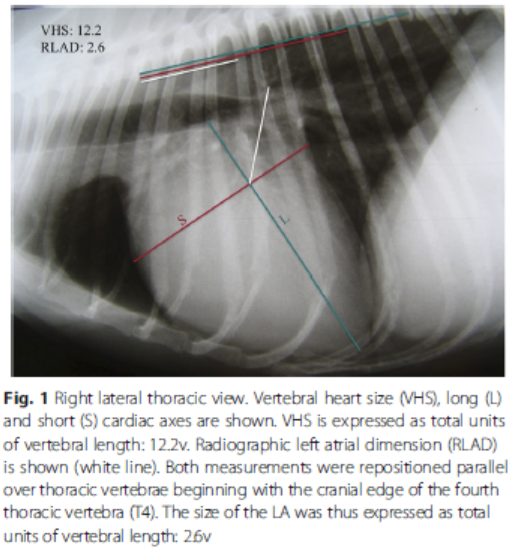 extends a diagonal line from
the from the intersection of the long and short VHS axes to the tip of
the left atrium. See Figure 1, left. They performed these measurements on the
x-rays of 77 dogs, 31 in group 1 of which had no left atrial enlargement
(and included one cavalier King Charles spaniel), and 46 mixed breed
dogs in group 2, all of which reportedly did have enlargement of the
left atrium. They compared the resulting RLAD measurements with
echocardiographic calculations of left atrium size using the ratio of
the left atrium width measurement over the aorta width measurement
(LA/Ao) and found a "strong correlation" between the two resulting
values. They arbitrarily defined an enlarged left atrium as any LA/Ao
ration above 1.6. They concluded:
extends a diagonal line from
the from the intersection of the long and short VHS axes to the tip of
the left atrium. See Figure 1, left. They performed these measurements on the
x-rays of 77 dogs, 31 in group 1 of which had no left atrial enlargement
(and included one cavalier King Charles spaniel), and 46 mixed breed
dogs in group 2, all of which reportedly did have enlargement of the
left atrium. They compared the resulting RLAD measurements with
echocardiographic calculations of left atrium size using the ratio of
the left atrium width measurement over the aorta width measurement
(LA/Ao) and found a "strong correlation" between the two resulting
values. They arbitrarily defined an enlarged left atrium as any LA/Ao
ration above 1.6. They concluded:
"The new radiographic measurement named RLAD demonstrated high sensitivity and specificity for detecting LAE [left atrial enlargement] with a strong correlation with LA/Ao ratio. The proposed optimal cut-off value for RLAD to detect LAE is 1.8v. RLAD would provide clinicians with a simple and cost-effective tool for the detection and monitoring of LAE in dogs with MVD and possibly dogs with other cardiac diseases presenting with LAE."
 EDITOR'S NOTE: This new, uniform RLAD method of using x-rays to
measure the size of the left atrium could be a major breakthrough in
determining if the atrium has enlarged. As Figure 1 demonstrates, by
starting at the intersection of the two VHS lines and extending
diagonally to the outward tip of the atrium, most any veterinarian adept
in examining radiographs (x-rays) should be able to calculate that
distance in a current x-ray and compare it with previous x-rays of the
same dog to find if the later distance is greater than the previous one.
If it does, then there would be evidence that the dog's left atrium has
enlarged. This RLAD method could negate the need for expensive
echocardiograms to reach the same determination.
EDITOR'S NOTE: This new, uniform RLAD method of using x-rays to
measure the size of the left atrium could be a major breakthrough in
determining if the atrium has enlarged. As Figure 1 demonstrates, by
starting at the intersection of the two VHS lines and extending
diagonally to the outward tip of the atrium, most any veterinarian adept
in examining radiographs (x-rays) should be able to calculate that
distance in a current x-ray and compare it with previous x-rays of the
same dog to find if the later distance is greater than the previous one.
If it does, then there would be evidence that the dog's left atrium has
enlarged. This RLAD method could negate the need for expensive
echocardiograms to reach the same determination.
Oddly, these investigators have missed an essential point about VHS calculations. The VHS system was never intended to establish a species-wide dividing line between normal heart size and an enlarged heart. In fact, such an effort to establish any universal VHS value as defining either a normal sized heart or an enlarged one is impossible, since it has been scientifically established that some breeds have substantially larger normal-sized hearts than other breeds. So, if the size of the heart as a whole cannot be definitively defined species-wide as being either normal or enlarged, why should the left atrium of every dog of every breed be so defined?
The intent of the creators of the VHS method, Drs. James Buchanan and Jorg Bücheler, was to compare the VHS value between a current x-ray and a previous one, called a "baseline". In their 1995 article introducing the VHS method, they stated:
"The major uses of the VHS method are in helping determine whether cardiomegaly exists in dogs with minimal radiographic changes and quantification of the progression of cardiomegaly over time in a glven dog."
Dr. Buchanan expounded on this comparison in a presentation to the CKCSC,USA in 1998, when he stated:
"We use this system to monitor progressive enlargement. An example is a cavalier that came in at 6 years of age with a grade 3 systolic murmur and a 10.5v heart. When it came back six months later, his heart had increased to 11.7v, and the left atrium was prominent. Six months later the heart measured 13.3v, and both the atrium and ventricle were quite large. Two months after that he had a huge 13.6v heart. At this point the dog was only 7 years old. Our radiologists now routinely write the VHS in their reports. ...
"I would get a chest x-ray when the murmur is first heard. Then I would get a yearly x-ray to monitor the development of cardiac enlargement and use heart size as a guide. If the heart in a baseline x-ray measures 9.5v, and subsequently 10.5v, that indicates cardiac enlargement and the effects of mitral regurgitation."
And, of course, these researchers arbitrarily assumed that any dog with an LA/Ao ratio over 1.6 had an enlarged atrium. This was totally non-scientific if they were the least bit serious about determining whether or not a particular dog had an enlarged atrium or not. There is no such thing as a species-wide minimum LA/Ao ratio defining enlargement.
In short, cardiologists need to stop trying to devise bogus short cuts to define heart enlargement -- left atrial or ventricle -- and get back to reality. No one measurement, be it VHS or left atrial ratio or whatever, can possibly be used to define the maximum normal sized heart or the minimum enlarged heart across all breeds of dogs. To do so is irresponsible and is putting many dogs at serious risk, either by starting medications too soon or too late.
December 2018:
French
cardiologists find that MVD-affected dogs with grades V and VI murmurs
have more severe forms of MVD.
 In
an abstract of a presentation by French veterinary cardiology
researchers C. Poissonnier, M. Klam, E. Trehiou-Sechi, V.
Arqued-Soubeyran, J.L. Pouchelon, R. Tissier, L. Desquilbet, and Valerie
Chetboul (right) at the September 2018 European College of Veterinary Internal
Medicine - Companion Animals (ECVIM-CA) Congress, they reviewed clinical
records of 374 MVD-affected dogs from 2006 to 2017 to characterize the
epidemiological, clinical, and echocardiographic features of dogs with
thrilling murmurs (TM) -- which are mitral valve murmurs of grades V and
VI -- related to MVD, and to identify parameters associated with
survival. The cavalier King Charles spaniel was "the most represented
breed". They found that:
In
an abstract of a presentation by French veterinary cardiology
researchers C. Poissonnier, M. Klam, E. Trehiou-Sechi, V.
Arqued-Soubeyran, J.L. Pouchelon, R. Tissier, L. Desquilbet, and Valerie
Chetboul (right) at the September 2018 European College of Veterinary Internal
Medicine - Companion Animals (ECVIM-CA) Congress, they reviewed clinical
records of 374 MVD-affected dogs from 2006 to 2017 to characterize the
epidemiological, clinical, and echocardiographic features of dogs with
thrilling murmurs (TM) -- which are mitral valve murmurs of grades V and
VI -- related to MVD, and to identify parameters associated with
survival. The cavalier King Charles spaniel was "the most represented
breed". They found that:
• 24% were in ACVIM Stage B2; 61% were in Stage C, and 7% were in Stage D
• 75% had ruptured chordae tendineae
• 27% had severe pulmonary hypertension (systolic pulmonary arterial pressure >75 mmHg)
• 46% had tachyarrhythmias
• 100% had mitral regurgitation fractions (RF) above 30% (moderate to severe regurgitation) with a median RF of 70%
• 68% suffered cardiac-related deaths, with median time to death of 25.1 months after first diagnosing TM
• Stage B2 dogs' median time to Stage C was 15.9 months
• Stage B dogs' median time to cardiac deaths was 42.9 months
• Stages C & D dogs' median time to cardiac deaths was 17.8 months
They stated:
"In conclusion, this study confirms that dogs with TM related to DMVD, including dogs from ACVIM stage B, usually have a severe form of the disease, with a majority of dogs presenting with chordae tendineae rupture, pulmonary hypertension, and severe MV regurgitation."
December 2018:
Japanese heart surgeons recommend earlier repairs to
MVD-affected cavaliers' hearts.
![]() At the
September 2018 European College of Veterinary Internal Medicine -
Companion Animals (ECVIM-CA) Congress, Japanese veterinary heart
surgeons H. Takano, K. Takamura, K. Mamada, and M. Uechi reviewed the
breed characteristics of 102 MVD-affected dogs which were surgically
treated at their Jasmine Veterinary Medical Center between November 2016 and July
2017. They report:
At the
September 2018 European College of Veterinary Internal Medicine -
Companion Animals (ECVIM-CA) Congress, Japanese veterinary heart
surgeons H. Takano, K. Takamura, K. Mamada, and M. Uechi reviewed the
breed characteristics of 102 MVD-affected dogs which were surgically
treated at their Jasmine Veterinary Medical Center between November 2016 and July
2017. They report:
• 1 dog died before the 1-month post-operative review
• 2 dogs underwent second surgeries
• 1-month survival rate was 91.5%
They distinguished cavalier King Charles spaniels (CKCS) from the other breeds because they found that, compared to the other breeds, cavaliers (a) were significantly younger, (b) had higher body weight, (c) had higher pre-operative vertebral heart score (VHS), (d) had higher post-operative left ventricular diameters (meaning stronger post-operative irreversible heart enlargement despite similar reduction of mitral regurgitation), and (e) had lower post-operative fractional shortening percentages (FS). They conclude that the progression of mitral regurgitation is considered to have occurred at an earlier age in the CKCSs, which suggests that mitral valve repair should be recommended earlier for cavaliers compared with other breeds, to minimize left ventricle dysfunction and enlargement after surgery.
EDITOR'S NOTE: These findings about MVD attacking cavaliers earlier and more severely than other breeds is totally consistent with many previous reports. MVD hits CKCSs earlier and progresses more rapidly than any other breed. In the 1990s, Dr. James Buchanan found that MVD is 20 times more prevalent and starts earlier in the cavalier. Obviously, nothing much has changed in the ensuing 20+ years. In 1998, he strongly recommended that CKCS breeders follow the MVD Breeding Protocol to eliminate early onset of MVD. Despite the successful track record of that protocol when faithfully followed, only a handful of breeders -- less than 4% -- have paid any attention to it. The two USA national cavalier breed clubs contemptuously refuse to even recommend following the protocol. The selfish breeders' need for immediate gratification appears to still trump the hereditary health and lifespans of the litters of cavalier puppies they produce.
December 2018:
UK clinical cases
review of 684 MVD-affected dogs shows a grade III mitral valve murmur
means a higher risk of MVD progression.
 In
a
December 2018 review of the clinical records of 684 dogs which
attended 73 UK primary care practices and were diagnosed with Stage B mitral
valve disease (MVD), Royal Veterinary College researchers Madeleine J.
Mattin, David C. Brodbelt (right), David B. Church, and Adrian Boswood had these
interesting findings about the progression of MVD:
In
a
December 2018 review of the clinical records of 684 dogs which
attended 73 UK primary care practices and were diagnosed with Stage B mitral
valve disease (MVD), Royal Veterinary College researchers Madeleine J.
Mattin, David C. Brodbelt (right), David B. Church, and Adrian Boswood had these
interesting findings about the progression of MVD:
• 231 of the 684 dogs were cavalier King Charles spaniels -- 33.9%.
• Having a higher heart rate was associated with an increased hazard of presumed stage B dogs progressing to initiation of potent diuretic treatment (Stage C) or cardiac-related death. Although having an increased heart rate is associated with more advanced MVD, this finding is not specific for cardiac disease and can be influenced by a number of factors including emotional state and noncardiac disease.
• Dogs with heart murmur intensities at grade III or above had a higher hazard of clinical progression (Stage C) than those with softer murmurs.
• The presence of cough also was associated with increased hazard of clinical progression (Stage C).
• Cavaliers had a higher hazard of starting diuretic treatment (Stage C) or experiencing cardiac-related death compared with all other breeds.
They concluded:
"In conclusion, data obtained from taking a history and performing a physical examination could be used in combination with NT-proBNP concentrations to risk stratify dogs with presumed stage B DMVD managed by primary care practitioners. Dogs identified as having a high risk of disease progression might benefit from more frequent monitoring, further diagnostic evaluation, or referral to a veterinary cardiologist."
December 2018:
Iowa State cardiologists find MVD-affected dogs with atrial
fibrillation are more likely to develop right-side heart failure.
 In
a
February 2019 article, Iowa State University cardiologists Jessica
Ward (right) and Wendy Ware (and pathologist Austin Viall)
examined 155 dogs in congestive heart failure (CHF) due to mitral valve
disease (including 19 cavalier King Charles spaniels) to determine if
MVD-affected dogs with atrial fibrilation (AF) are more likely to
develop right-sided (tricuspid valve) heart failure than dogs without
AF. They report finding that 17 of the 155 dogs (11%) had AF at the time
they were diagnosed with CHF. Of those 17 dogs with AF, 13 (76.5%) also
had right-sided CHF while only 7.2% of MVD-affected dogs without AF
developed right-sided CHF. They concluded that MVD-affected dogs with AF
were more likely to also develop right-sided CHF than dogs without AF,
and that AF was the strongest predictor of right-sided CHF. They also
concluded that "cavitary effusions" (fluid in the abdomen) are an
expected finding in approximately three-quarters of MVD-affected dogs
with AF and right-sided CHF.
In
a
February 2019 article, Iowa State University cardiologists Jessica
Ward (right) and Wendy Ware (and pathologist Austin Viall)
examined 155 dogs in congestive heart failure (CHF) due to mitral valve
disease (including 19 cavalier King Charles spaniels) to determine if
MVD-affected dogs with atrial fibrilation (AF) are more likely to
develop right-sided (tricuspid valve) heart failure than dogs without
AF. They report finding that 17 of the 155 dogs (11%) had AF at the time
they were diagnosed with CHF. Of those 17 dogs with AF, 13 (76.5%) also
had right-sided CHF while only 7.2% of MVD-affected dogs without AF
developed right-sided CHF. They concluded that MVD-affected dogs with AF
were more likely to also develop right-sided CHF than dogs without AF,
and that AF was the strongest predictor of right-sided CHF. They also
concluded that "cavitary effusions" (fluid in the abdomen) are an
expected finding in approximately three-quarters of MVD-affected dogs
with AF and right-sided CHF.
December 2018:
University of Bristol cardiologists slam the EPIC Study for not
investigating arrhythmias in its pimobendan group.
 In a
December 2018 article in the Veterinary Record, University of Bristol
veterinary cardiology researchers Sara Hillyer (right), Melanie Hezzell,
and Emma Place sharply criticized the
EPIC Study for its failure to investigate the incidence of
arrhythmias among the 80 dogs (45%) which suffered adverse events in the EPIC
Study's 178-dog pimobendan group. EPIC Study lists 196 adverse events
experienced by those 80 dogs, of which only 72 events are specifically
categorized (e.g., diarrhea, vomiting, anorexia, lethargy, tachycardia). None of the categories include "arrhythmia". The remaining
124 adverse events are lumped together and identified only as "other".
The Bristol authors note:
In a
December 2018 article in the Veterinary Record, University of Bristol
veterinary cardiology researchers Sara Hillyer (right), Melanie Hezzell,
and Emma Place sharply criticized the
EPIC Study for its failure to investigate the incidence of
arrhythmias among the 80 dogs (45%) which suffered adverse events in the EPIC
Study's 178-dog pimobendan group. EPIC Study lists 196 adverse events
experienced by those 80 dogs, of which only 72 events are specifically
categorized (e.g., diarrhea, vomiting, anorexia, lethargy, tachycardia). None of the categories include "arrhythmia". The remaining
124 adverse events are lumped together and identified only as "other".
The Bristol authors note:
"Additionally, the summary of adverse events reported does not specifically list 'arrhythmia' and instead lists 'tachycardia' and further, a large proportion of the adverse events are categorised as 'other' (124/196)."
They further note that:
"However, auscultation performed throughout the study might have detected the occurrence of arrhythmias, and adverse events related to arrhythmias are not reported."
 EDITOR'S
NOTE: It is refreshing and encouraging to notice that more
and more cardiology researchers are publicly finding fault with the EPIC
Study's sloppy (at best) data reporting. Either the EPIC's 36
cardiologists did not fully examine their patients during the course of
this pimobendan trial (which is doubtful), or the lead investigators
decided to not report all of the relevant data acquired from those
exams (which appears to be very likely). Why have they been so intent upon hiding important data? We have
asked lead investigator Dr. Adrian Boswood to publish the results as
applied to the 161 cavalier King Charles spaniels in the EPIC trial,
since that breed comprised over 45% of all dogs, and his response was a
flat "No!".
EDITOR'S
NOTE: It is refreshing and encouraging to notice that more
and more cardiology researchers are publicly finding fault with the EPIC
Study's sloppy (at best) data reporting. Either the EPIC's 36
cardiologists did not fully examine their patients during the course of
this pimobendan trial (which is doubtful), or the lead investigators
decided to not report all of the relevant data acquired from those
exams (which appears to be very likely). Why have they been so intent upon hiding important data? We have
asked lead investigator Dr. Adrian Boswood to publish the results as
applied to the 161 cavalier King Charles spaniels in the EPIC trial,
since that breed comprised over 45% of all dogs, and his response was a
flat "No!".
November 2018:
Cardiology researcher Dr. Anna Beber disproves EPIC Study's
definition of enlarged hearts for cavaliers.
 In
an
October 2018 article, Dr. Anna Elisabeth Beber (right) reported that
of seven cavalier King Charles spaniels affected with mitral valve
disease but with no heart enlargement, their x-rays' vertebral heart
score (VHS) values ranged from a low of 11.0v to a high of 11.9v. She
noted that:
In
an
October 2018 article, Dr. Anna Elisabeth Beber (right) reported that
of seven cavalier King Charles spaniels affected with mitral valve
disease but with no heart enlargement, their x-rays' vertebral heart
score (VHS) values ranged from a low of 11.0v to a high of 11.9v. She
noted that:
"Using the vertebral heart score cut off of 10.5v in the EPIC study, all of the 'normal' Cavalier King Charles Spaniels in this study (defined by subjective impression consensus opinion) would have been considered to have cardiomegaly and therefore potentially received treatment unnecessarily."
She warned that:
"The consequences of both a false positive detection of cardiomegaly and false negative are undesirable. A false positive could result in a patient receiving pimobendan too soon, which research has suggested could worsen the mitral regurgitation, cause myocardial hypertrophy or acute focal haemorrhages, endothelial papillary hyperplasia, and infiltration of chordae tendineae with glycosaminoglycans in the mitral valves of dogs (Tissier et al., 2005; Chetboul et al., 2007). A false negative could mean that the patient would not receive the full benefits of pimobendan."
Dr. Beber concluded that:
"Therefore, to ensure that a VHS is of value, the author suggests that large numbers of breed 'normals' need to be used to establish a more reliable reference range."
 EDITOR'S
NOTE: Once again we find that the definition of heart
enlargement used in the EPIC Study (100+% financed by the manufacturer
of Vetmedin) has been shown to be a fraud. In the EPIC Study, its three
lead investigators defined an enlarged heart as having a VHS value of
10.5. As Dr. Beber notes in the quote above, all of the MVD-affected
cavaliers in her study having normal sized hearts would have been
diagnosed under the EPIC Study definition as having enlarged hearts and
needing to be treated with Vetmedin.
EDITOR'S
NOTE: Once again we find that the definition of heart
enlargement used in the EPIC Study (100+% financed by the manufacturer
of Vetmedin) has been shown to be a fraud. In the EPIC Study, its three
lead investigators defined an enlarged heart as having a VHS value of
10.5. As Dr. Beber notes in the quote above, all of the MVD-affected
cavaliers in her study having normal sized hearts would have been
diagnosed under the EPIC Study definition as having enlarged hearts and
needing to be treated with Vetmedin.
Unlike in the EPIC Study report, she points out the well-known fact that giving pimobendan to dogs which do not have enlarged hearts could worsen the mitral regurgitation, cause myocardial hypertrophy or acute focal haemorrhages, endothelial papillary hyperplasia, and infiltration of chordae tendineae with glycosaminoglycans in the dogs' mitral valves.
How long will other veterinary cardiologists continue to rely upon the EPIC Study's bogus definition of heart enlargement to prescribe pimobendan, which clearly has been shown to constitute a serious threat to the health of MVD-affected dogs which in fact have no heart enlargement at all?
October 2018:
RVC researchers confirm the obvious in determining which factors
predict the likelihood of MVD-affected dogs dying of MVD.
 In an
October
2018 article, Royal Veterinary College (RVC) investigators (M. J. Mattin, Adrian Boswood
[right], D. B. Church,
D. C. Brodbelt) examined 893 dogs diagnosed with mitral valve disease
(MVD) including 316 (35.9%) cavaliers. Their stated objective was to
evaluate whether cardiac biomarkers and data obtained from routine
history-taking and physical examinations were predictive of the
likelihood of dying from MVD. Such routine data included obvious
ones as:
In an
October
2018 article, Royal Veterinary College (RVC) investigators (M. J. Mattin, Adrian Boswood
[right], D. B. Church,
D. C. Brodbelt) examined 893 dogs diagnosed with mitral valve disease
(MVD) including 316 (35.9%) cavaliers. Their stated objective was to
evaluate whether cardiac biomarkers and data obtained from routine
history-taking and physical examinations were predictive of the
likelihood of dying from MVD. Such routine data included obvious
ones as:
• Increased heart rates,
• Louder mitral valve murmurs
• Exercise intolerance
• Dyspnea (shortness of breath)
• Higher respiratory rates
• Advancing age.
Unsurprisingly, they found that all of these did, indeed, serve as predictors of a higher hazard of cardiac death. One surprise predictor of the likelihood of cardiac death was "Receiving a potent diuretic". They surmise that:
"It is likely that these treatments are a proxy for dogs with a history of CHF, which have more advanced disease and thus an increased hazard of death. However, the rationale behind prescribing potent diuretics was not explored and some dogs without CHF might have inappropriately received diuretics."
 EDITOR'S NOTE: Sometimes it is frustrating
to try to objectively summarize studies by RVC cardiology researchers because they tend to either overlook or
intentionally hide the obvious and refuse to provide breed-specific data
about cavalier King Charles spaniels. Dr. Adrian Boswood's 2016 EPIC
Study was a classic example. This is another one of those times.
EDITOR'S NOTE: Sometimes it is frustrating
to try to objectively summarize studies by RVC cardiology researchers because they tend to either overlook or
intentionally hide the obvious and refuse to provide breed-specific data
about cavalier King Charles spaniels. Dr. Adrian Boswood's 2016 EPIC
Study was a classic example. This is another one of those times.
If you will pardon the digression, the EPIC Study, led by RVC cardiologist Dr. Boswood, studied the effect of pre-heart failure administration of pimobendan on 354 dogs, 161 (45.5%) of which were CKCSs. However, no where in the EPIC Study did Dr. Boswood bother to provide any breed-specific data or findings about cavaliers. When we asked him to do so, his response was, in short, "No". He wrote:
"You have asked for data specifically about the outcome in the study for cavalier King Charles spaniels and suggested that we should perform a sub-analysis looking at outcome for this group. ... [W]e will not release the exact figures you have requested."
So you see, he had those "exact figures" from the EPIC Study, but he would not release them. Once again, here Dr. Boswood fails to provide data singling out the cavalier -- data he surely has -- even though there were six times more cavaliers in this study than any other breed. Not only that, but three of the seven organizations which assisted RVC in recruiting dogs were cavalier groups, the Cavalier Campaign, Cavalier Matters, and the Companion Cavalier club. Surely their members expected some helpful information about their breed in the reported results. When you combine CKCSs with all other breeds in a study of this nature, you end up with a mess of unhelpful information for cavalier owners.
October 2018:
Italian researchers find serum iron decreases in MVD-affected
dogs in heart failure stages.
 In an
October 2018 article, a team of Italian veterinarians (Alice
Savarese [right], M. Probo, C. Locatelli, A.L. Gazzonis, S.A.
Zanzani, G. Traini, T. Vitiello, P.G. Brambilla) studied the case
records of 54 dogs, measuring their serum iron concentration (SIC) and
iron-capacity factors. They found that SIC was 18% overall, but that in
MVD-dogs in Stage C (congestive heart failure) the SIC was 33%, and in
dogs in Stage D (acute decompensated heart failure), the SIC was 100%.
They did not find any significant differences in iron values between
Stage B and Stage C dogs. They concluded:
In an
October 2018 article, a team of Italian veterinarians (Alice
Savarese [right], M. Probo, C. Locatelli, A.L. Gazzonis, S.A.
Zanzani, G. Traini, T. Vitiello, P.G. Brambilla) studied the case
records of 54 dogs, measuring their serum iron concentration (SIC) and
iron-capacity factors. They found that SIC was 18% overall, but that in
MVD-dogs in Stage C (congestive heart failure) the SIC was 33%, and in
dogs in Stage D (acute decompensated heart failure), the SIC was 100%.
They did not find any significant differences in iron values between
Stage B and Stage C dogs. They concluded:
"Oral supplementation of iron could be an effective and safe way to restore iron levels in these dogs, although its efficacy could be affected by lack of intestinal absorption. Further studies are needed in a larger population with evaluation of iron storage (i.e., ferritin levels, hepcidin) as well as the feasibility of IV iron supplementation, especially in acute decompensated CHF."
October 2018:
Thai study shows
that moderate regular exercise can improve physical capacity in
MVD-affected dogs in Stage B1.
 In an
October 2018 article, a team of Thai veterinary researchers
(Saikaew Sutayatram [right], Chollada Buranakarl, Anusak
Kijtawornrat, Kumpanart Soontornvipart, Pakit Boonpala, Prapawadee
Pirintr)
tested six Beagles with Stage B1 mitral valve disease (mitral
regurgitation but no heart enlargement), to determine the effects of
"submaximal endurance training" by treadmill running and 6-minute walks,
over a period of eight weeks. The study was limited to fairly sedentary
MVD-affected dogs in Stage B1. It did not test dogs in Stage B2 (heart
enlarged) or in Stage C (in heart failure). The investigators report finding that the exercise:
In an
October 2018 article, a team of Thai veterinary researchers
(Saikaew Sutayatram [right], Chollada Buranakarl, Anusak
Kijtawornrat, Kumpanart Soontornvipart, Pakit Boonpala, Prapawadee
Pirintr)
tested six Beagles with Stage B1 mitral valve disease (mitral
regurgitation but no heart enlargement), to determine the effects of
"submaximal endurance training" by treadmill running and 6-minute walks,
over a period of eight weeks. The study was limited to fairly sedentary
MVD-affected dogs in Stage B1. It did not test dogs in Stage B2 (heart
enlarged) or in Stage C (in heart failure). The investigators report finding that the exercise:
• significantly improved the physical capacity of the dogs,
• did not affect cardiac function, and
• significantly reduced serum creatine.
They concluded that, "supervised or moderate regular exercise that is within the individual physical capacity should be performed in subclinical MMVD dogs and dogs with low routine physical activity, in order to preserve or improve physical capacity and quality of life."
October 2018:
Dr. Visser devises
new landmark x-ray measurement to diagnose enlargement of the left
atrium in MVD-affected dogs.
 In an
October 2018 article, Univ. of California - Davis veterinary
cardiologist Lance Visser (right) and his research team (Elizabeth L.
Malcolm, Kathryn L. Phillips, Lynelle R. Johnson) have introduced a new,
highly accurate x-ray measurement of the left atrium (LA) to determine
if MVD-affected dogs have LA enlargement. They call their measurement
"vertebral left atrial size (VLAS)". The lower broken line of the x-ray
in Figure 1 (left below), labeled #, shows the location of the measurement of
the LA, and the upper broken line, labeled *, shows how that length is
compared to the dog's vertebrae, begining at vertebra T4. Technically,
they describe the measurement as:
In an
October 2018 article, Univ. of California - Davis veterinary
cardiologist Lance Visser (right) and his research team (Elizabeth L.
Malcolm, Kathryn L. Phillips, Lynelle R. Johnson) have introduced a new,
highly accurate x-ray measurement of the left atrium (LA) to determine
if MVD-affected dogs have LA enlargement. They call their measurement
"vertebral left atrial size (VLAS)". The lower broken line of the x-ray
in Figure 1 (left below), labeled #, shows the location of the measurement of
the LA, and the upper broken line, labeled *, shows how that length is
compared to the dog's vertebrae, begining at vertebra T4. Technically,
they describe the measurement as:
"First, a line was drawn and measured (in arbitrary units) from the center of the most ventral aspect of the carina to the most caudal aspect of the left atrium where it intersected with the dorsal border of the caudal vena cava. For the purpose of this study, the carina was defined as the radiolucent circular or ovoid structure within the trachea that represented the bifurcation of the left and right mainstem bronchi. Similar to the vertebral heart size method, a second line that was equal in length to the first was drawn beginning at the cranial edge of T4 and extending caudally just ventral and parallel to the vertebral canal (Figure 1, below). The VLAS was defined as the length of the second line expressed in vertebral-body units to the nearest 0.1 vertebra."
They compared these x-ray dimensions in 103 dogs divided into four
categories determined by
echo-cardiographic scans: (1) control group of
15 heart-healthy dogs; (2) 40 dogs, including 2 cavalier King
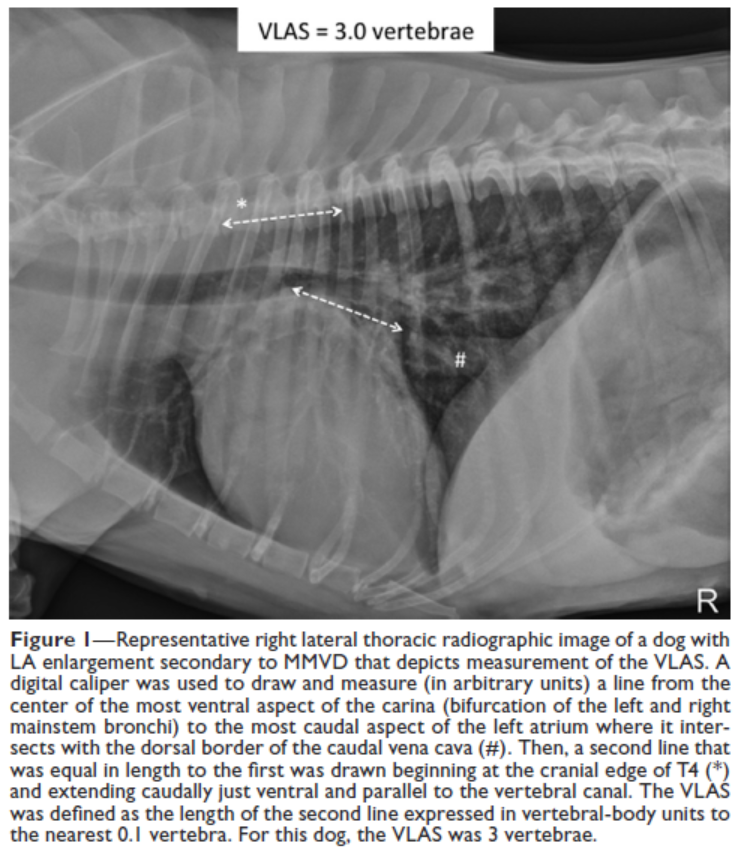 Charles
spaniels, in Stage B1 (MVD-affected but without enlargement); (3) 26
dogs (2 CKCSs) in Stage B2 (MVD with enlargement); and (4) 22 dogs (4
CKCSs) in Stages C or D (in congestive heart failure). The investigators compared these x-ray measurements with
echocardiographic measurements of the left atrium of each dog, using two
standard echo images of the LA: (a) left atrium-to-aortic root ratio
acquired from short-axis (LA:AoSx) and (b) long-axis (LA:AoLx). They
conclude:
Charles
spaniels, in Stage B1 (MVD-affected but without enlargement); (3) 26
dogs (2 CKCSs) in Stage B2 (MVD with enlargement); and (4) 22 dogs (4
CKCSs) in Stages C or D (in congestive heart failure). The investigators compared these x-ray measurements with
echocardiographic measurements of the left atrium of each dog, using two
standard echo images of the LA: (a) left atrium-to-aortic root ratio
acquired from short-axis (LA:AoSx) and (b) long-axis (LA:AoLx). They
conclude:
"Results of the present study indicated that there was a significant positive correlation between VLAS and both LA:AoSx and LA:AoLx, and VLAS cutoffs of 2.3 to 2.5 vertebrae were associated with an LA:AoSx > 1.6 and LA:AoLx > 2.6 (or both). Thus, a VLAS > 2.3 vertebrae can be used as a radiographic indicator of LA enlargement, and dogs with a VLAS > 2.3 vertebrae likely have hemodynamically important MMVD. ... Results of the present study indicated that VLAS was an accurate predictor of LA enlargement in a large and diverse population of dogs with MMVD of varying severity. There was a moderate positive correlation between VLAS and echocardiographic estimates of LA size by linear measurement methods in both the long (LA:AoLx) and short (LA:AoSx) axes. Results also indicated that VLAS was a readily repeatable measurement, with a high level of agreement among measurements obtained by the same individual on multiple occasions as well as by multiple individuals."
EDITOR'S NOTE: This appears to be a
monumental invention for diagnosing MVD-affected dogs in Stage B2
 (heart
enlargement). Typically the left atrium (LA) is the first chamber of the
heart to expand due to MVD, thereby moving the Stage B1 dog into Stage
B2. Now that enlargement is the point at which the EPIC Study recommends
commencing treatment with pimobendan, the detection of enlargement of
the LA is an important landmark in the progression and medication of
MVD.
(heart
enlargement). Typically the left atrium (LA) is the first chamber of the
heart to expand due to MVD, thereby moving the Stage B1 dog into Stage
B2. Now that enlargement is the point at which the EPIC Study recommends
commencing treatment with pimobendan, the detection of enlargement of
the LA is an important landmark in the progression and medication of
MVD.
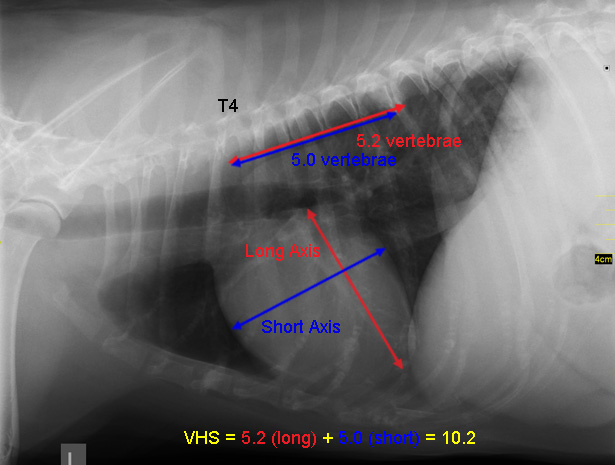 Using
x-rays to measure the size of the heart and then compare that dimension
to the same dog's vertebrae is nothing new. Dr. James Buchanan
introduced this device in 1995, calling it the Vertebral Heart Score (or
Scale or Sum) (VHS). His system called for two measurements of the
entire heart -- one of the width (short axis) and the other of the
length (long axis) (see image at right) -- then combining those
two measurements and comparing them to the dog's vertebrae to arrive at
a total number. Dr. Buchanan's initial intention was to use the VHS
system for comparison purposes, starting with a "baseline" x-ray taken
before any enlargement has been suspected, and then comparing that
baseline to later x-rays to determine if the heart has begun to enlarge.
Using
x-rays to measure the size of the heart and then compare that dimension
to the same dog's vertebrae is nothing new. Dr. James Buchanan
introduced this device in 1995, calling it the Vertebral Heart Score (or
Scale or Sum) (VHS). His system called for two measurements of the
entire heart -- one of the width (short axis) and the other of the
length (long axis) (see image at right) -- then combining those
two measurements and comparing them to the dog's vertebrae to arrive at
a total number. Dr. Buchanan's initial intention was to use the VHS
system for comparison purposes, starting with a "baseline" x-ray taken
before any enlargement has been suspected, and then comparing that
baseline to later x-rays to determine if the heart has begun to enlarge.
A problem with the VHS system is that neither the the short nor long
axis measurement always took into
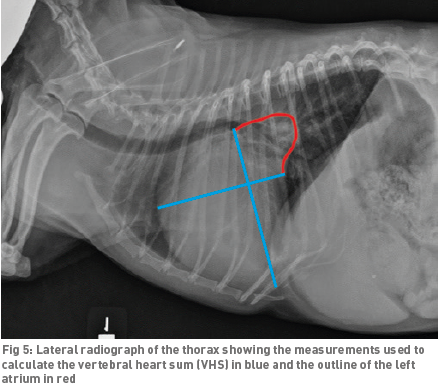 account
the fact that the LA, in the upper right corner of the x-rays, may be
enlarging but not being included in those two measurements. For example,
see the image at left here, showing that the LA, outlined in red,
is mostly excluded from the two standard VHS dimensions. So, Dr. Visser
has figured out how to not only include the LA in the VHS system, but to
focus solely upon it. We expect that his VLAS acronym will be replacing
VHS in short order.
account
the fact that the LA, in the upper right corner of the x-rays, may be
enlarging but not being included in those two measurements. For example,
see the image at left here, showing that the LA, outlined in red,
is mostly excluded from the two standard VHS dimensions. So, Dr. Visser
has figured out how to not only include the LA in the VHS system, but to
focus solely upon it. We expect that his VLAS acronym will be replacing
VHS in short order.
Now, all of that praise aside, Dr. Visser has fallen into the same trap that several other recent cardiology researchers have, which is to blindly rely upon baseless, arbitrary minimum echocardiographic measurements to define LA enlargement. He assumes that the LA measurement of LA:AoSx > 1.6 defines enlargement of the left atrium, species-wide. This is known as the "quantitative measurement method", an intellectually-lazy, dumbed-down technique which relies upon dangerously false assumptions. Until published research shows that numerous dogs of every breed meet that criterion, that definition is nonsense. Maybe he does this just to simplify things for argument purposes, but it is irresponsible to suggest that any dog of any breed with a left atrium-to-aortic root ratio of 1.6 necessarily has an enlarged LA. The big problem with even suggesting this falsehood is that clinical vets feed off of it, rely upon it, and assume it is the gold standard for diagnosing enlargement. So, then they start administering pimobendan to the dog without ever actually making a professional, subjective effort to determine if, in fact, the dog's heart is even the least bit enlarged. This form of malpractice has been happening worldwide, unfortunately, since the publication of the EPIC Study, truly the most irresponsibly-designed and carried-out research of pimobendan ever conducted. Fortunately, however, Dr. Visser's use of this phony definition of LA enlargement does not affect the quality of his research. None of the dogs actually involved in his study had a LA:AoSx less than 1.8. The median for his study's Stage B2 dogs was 2.0 and for Stage C and D dogs was 2.6.
Oddly, he also fails to point out that the most effective and beneficial use of his new VLAS method is to compare the measurements of the dog's baseline VLAS with its more recent one. Baseline comparisons are the true gold standard, and every cavalier owner should be encouraged to obtain a set of the adult dog's chest x-rays before any MVD-murmur is detected. Only by comparing a baseline x-ray with a current x-ray can an accurate determination be made of LA enlargement.
September 2018:
Ivabradine reportedly improves heart rate variability in
MVD-affected dogs with enlargement.
 In a September 2018 article, Thai veterinary researchers (Prapawadee
Pirintr, Nakkawee Saengklub,
Vudhiporn
Limprasutr, Anusak Kijtawornrat [right]) conducted a long term
(3 months) study of oral doses of ivabradine in four MVD-affected
Beagles with heart enlargement (Stage B2). They evaluated the dogs'heart
rate (HR), blood pressure (BP), myocardial oxygen consumption (MVO2),
and heart rate variability (HRV). They report finding that "the results
revealed that chronic administration of ivabradine significantly
decreased HR, BP, and RPP without adverse effects. All indices of time-
and frequency- domain of HRV at M3 were significantly increased when
compared with baseline values)." They conclude that "The findings of
this study imply that long-term treatment with ivabradine at a dose of
1.0 mg/kg twice daily in dogs with asymptomatic DMVD stage B2 decreased
the HR, BP, MVO2 and improves HRV. This makes ivabradine potentially
promising for management of elevated HR and impaired HRV in asymptomatic
dogs with DMVD stage B2." This study is associated with
this May 2018 article authored by the same researchers.
In a September 2018 article, Thai veterinary researchers (Prapawadee
Pirintr, Nakkawee Saengklub,
Vudhiporn
Limprasutr, Anusak Kijtawornrat [right]) conducted a long term
(3 months) study of oral doses of ivabradine in four MVD-affected
Beagles with heart enlargement (Stage B2). They evaluated the dogs'heart
rate (HR), blood pressure (BP), myocardial oxygen consumption (MVO2),
and heart rate variability (HRV). They report finding that "the results
revealed that chronic administration of ivabradine significantly
decreased HR, BP, and RPP without adverse effects. All indices of time-
and frequency- domain of HRV at M3 were significantly increased when
compared with baseline values)." They conclude that "The findings of
this study imply that long-term treatment with ivabradine at a dose of
1.0 mg/kg twice daily in dogs with asymptomatic DMVD stage B2 decreased
the HR, BP, MVO2 and improves HRV. This makes ivabradine potentially
promising for management of elevated HR and impaired HRV in asymptomatic
dogs with DMVD stage B2." This study is associated with
this May 2018 article authored by the same researchers.
September 2018:
CoQ10 improves cardiac function in MVD-affected dogs in first
canine study.
 In a
September 2018 article, Thai veterinary cardiologists (Kittipong
Tachampa [right], Tuchakorn Lertwanakarn, Panupong Atchariyasakchai, Vichayanee
Pumpitakkul, Supapatt Kireewan, Chollada Buranakarl) tested 13 dogs in
congestive heart failure (CHF) due to mitral valve disease (MVD) with
coenzyme Q10 (CoQ10) over a four-week period. The dose was 100/mg twice
a day for both small (Group I) and large dogs (Group II). They report
finding that:
In a
September 2018 article, Thai veterinary cardiologists (Kittipong
Tachampa [right], Tuchakorn Lertwanakarn, Panupong Atchariyasakchai, Vichayanee
Pumpitakkul, Supapatt Kireewan, Chollada Buranakarl) tested 13 dogs in
congestive heart failure (CHF) due to mitral valve disease (MVD) with
coenzyme Q10 (CoQ10) over a four-week period. The dose was 100/mg twice
a day for both small (Group I) and large dogs (Group II). They report
finding that:
• CoQ10 caused a reduction of cardiac troponin I (cTnI) level in 71% of the dogs.
• Systolic function -- fractional shortening (FS) and ejection fraction (EF) -- increased significantly in small dogs after CoQ10 supplementation.
• Other echocardiographic parameters were not altered in either group.
• CoQ10 did not alter sympathovagal balance in MMVD dogs.
• Supplementation dose of CoQ10 should be based on the body weight.
September 2018:
Cardiologists find that healthy cavaliers' mitral valves differ
in shape from other breeds.  In a
September 2018 article, an international team of veterinary
cardiologists led by Dr. Michele Borgarelli (right) (Giulio Menciotti, Michael
Aherne, Paula Camacho, Jens Haggstrom, Ingrid Ljungvall, Sunshine M.
Lahmers, Jonathan A. Abbott) compared the shapes of the mitral valves of
35 young healthy cavalier King Charles spaniels with those of 41 healthy
dogs of other breeds (mixed, Beagle, and border collie), using
three-dimensional echocardiography (RT-3DTTE). They note that:
In a
September 2018 article, an international team of veterinary
cardiologists led by Dr. Michele Borgarelli (right) (Giulio Menciotti, Michael
Aherne, Paula Camacho, Jens Haggstrom, Ingrid Ljungvall, Sunshine M.
Lahmers, Jonathan A. Abbott) compared the shapes of the mitral valves of
35 young healthy cavalier King Charles spaniels with those of 41 healthy
dogs of other breeds (mixed, Beagle, and border collie), using
three-dimensional echocardiography (RT-3DTTE). They note that:
"A breed-specific difference in MV apparatus morphology might alter mechanical stresses on valve leaflets that can activate signaling pathways that contribute to myxomatous degeneration and its progression. Data from our laboratory show that the analysis of canine MV using RT-3DTTE is feasible and repeatable, and that healthy dogs have an elliptical, saddle-shaped MV, with parameters defining this shape similar to those described in healthy humans. In contrast, dogs affected by MMVD have a more circular and flatter MV, therefore lacking some of the aforementioned favorable geometric characteristics. Based on the results of these studies, we analyzed the MV morphology of healthy CKCSs and compared it to the MV morphology of healthy dogs of other breeds. We hypothesized that the MV of CKCSs would have morphologic differences compared to dogs of other breeds."
They report finding (See Figure 2 below):
• The mitral valve morphology of young healthy CKCSs differs from that of healthy dogs of other breeds.
• The mitral valve of CKCSs was shorter and flatter than in dogs of other breeds, and had a smaller posterior leaflet.
• An abnormal valvular shape and annular configuration could alter the forces applied on the MV during each cardiac cycle.

They speculated that the shape of the CKCS's mitral valve leaflets would result in abnormal stresses that play a role in the pathogenesis and progression of MVD in dogs, and that morphologic alterations of the valve could represent factors that predispose to the development of the disease. They conclude by stating that a longitudinal study is needed to test their hypothesis.
EDITOR'S NOTE: Dr. Borgarelli's research team is proceeding with that longitudinal study. Our Cavalier Health Fund already has contributed thousands of dollars to this project and is raising additional funds for it. We deem this research to be one of the most important ones for defeating MVD in our breed. The ultimate significance of this project would be to be able to predict the future severity of MVD in young CKCS breeding stock by examinging their mitral valves using this 3-D echo technology.
If you want to contribute to this valuable research, you may do so by donating to the Cavalier Health Fund, which will earmark such contributions to this study, upon your request.
September 2018:
UK cardiologists find MVD-affected cavaliers are more likely to
develop pulmonary hypertension than other breeds. In an
April 2018 abstract, UK cardiologists Siddharth Sudunagunta and Jo
Dukes-McEwan (right) report their
 study of 94 MVD-affected cavalier King Charles
spaniels and 93 MVD-affected non-CKCSs to determine if cavaliers are
more likely to develop pulmonary hypertension (PH) due to mitral valve
disease, and also determine whether there is any association between
CKCSs' oversized blood platelets (macroplatelets) and PH. All dogs had
enlarged hearts due to their MVD. 57 of the 94 cavaliers were in
congestive heart failure (CHF) compared to 45 of the non-CKCSs. 71 of
the cavaliers had PH, compared to 52 of the non-CKCSs. They found:
study of 94 MVD-affected cavalier King Charles
spaniels and 93 MVD-affected non-CKCSs to determine if cavaliers are
more likely to develop pulmonary hypertension (PH) due to mitral valve
disease, and also determine whether there is any association between
CKCSs' oversized blood platelets (macroplatelets) and PH. All dogs had
enlarged hearts due to their MVD. 57 of the 94 cavaliers were in
congestive heart failure (CHF) compared to 45 of the non-CKCSs. 71 of
the cavaliers had PH, compared to 52 of the non-CKCSs. They found:
• PH was associated with a greater likelihood of CHF and death (cardiac-related and all-cause mortality).
• CKCSs were more likely to experience cardiac death than non-CKCSs.
• Macroplatelets were not associated with PH development.
• CKCS were more likely than non-CKCS to develop PH due to MVD.
September 2018:
Researchers devise a treatment plan for MVD-affected dogs in
heart failure, based upon natriuretic peptide levels.
 In a
September 2018 article, a team of USA and UK veterinary
cardiologists (Melanie J. Hezzell [right], Chloë L. Block,
Danielle S. Laughlin, Mark A. Oyama) tested a treatment schedule for MVD-affected dogs in heart
failure (CHF) based upon the levels of the N-terminal pro-B-type
natriuretic peptide (NT-proBNP) concentration in each dog's bloodstream.
The goal of their study was to reduce NT-proBNP because of prior studies
showing that such reductions improves outcomes in human CHF patients.
Twenty-six dogs were in the study, which included five cavalier King
Charles spaniels -- the largest number of any breed -- with four
examinations over a 21 day period. The dogs were divided into three
groups, all three of which were in stable condition based upon routine
treatments for CHF (e.g., furosemide, hydrochlorothiazide,
spironolactone). Groups were:
In a
September 2018 article, a team of USA and UK veterinary
cardiologists (Melanie J. Hezzell [right], Chloë L. Block,
Danielle S. Laughlin, Mark A. Oyama) tested a treatment schedule for MVD-affected dogs in heart
failure (CHF) based upon the levels of the N-terminal pro-B-type
natriuretic peptide (NT-proBNP) concentration in each dog's bloodstream.
The goal of their study was to reduce NT-proBNP because of prior studies
showing that such reductions improves outcomes in human CHF patients.
Twenty-six dogs were in the study, which included five cavalier King
Charles spaniels -- the largest number of any breed -- with four
examinations over a 21 day period. The dogs were divided into three
groups, all three of which were in stable condition based upon routine
treatments for CHF (e.g., furosemide, hydrochlorothiazide,
spironolactone). Groups were:
Group 1: Baseline NT-proBNP was <1500 pmol/L. No dose adjustments were made to the current treatment.
Group 2: Baseline NT-proBNP was >1500 pmol/L. Dogs were eligible for prespecified medical treatment escalation on visit 0 or visit 1 if the serum creatinine concentration was <3.0 mg/dL. If creatinine was >3.0 mg/dL, data from the dog would be included in the analysis, but the dog would be ineligible for further treatment escalation."Treatment was escalated according to a prespecified plan as follows: if the current furosemide dose was <6 mg/kg/day, this dose was increased by 50%; if the current furosemide dose was >6 mg/kg/day, a combination of hydrochlorothiazide (1 mg/kg q24h) and spironolactone (1 mg/kg q24h; Aldactazide, Pfizer, New York) was added; if the current dose of furosemide was >6 mg/kg/day and the dog was already receiving hydrochlorothiazide and spironolactone the daily pimobendan dose was increased by 50%-100%."Group 3: Control Group. Baseline NT-proBNP was >1500 pmol/L but received no adjustment in treatment over the 21 day period.
The researchers found that NT-proBNP decreased significantly in group 2, but not in groups 1 or 3. They concluded that the "application of a prespecified treatment escalation algorithm in dogs with recent history and treatment of 1st time CHF secondary to MMVD results in a decrease in plasma NTproBNP concentrations", and that "Use of this treatment escalation algorithm allows effective targeting of treatment for CHF in dogs against an objective criterion."
EDITOR'S NOTE: In sum, this study finds that weekly blood checks for levels of NT-proBNP can allow fine-tuning of the medications which manage MVD-dogs in heart failure. The study is interesting for a couple of reasons, but also seemingly impractical because of the frequency of blood tests required to measure the NT-proBNP levels. It is interesting because it is another example of human studies being applied to dogs. There is much talk these days about "One Health", especially at PennVet school, which customarily means that what is learned by veterinarians in dogs and cats can be applied to humans. Here is but another example of where the human medicine came first and then is applied to dogs. It also interesting because it assumes that efforts to lower NT-proBNP necessarily means longer survival times for MVD-affected dogs in CHF. A couple of previous veterinary studies have pointed in that direction -- this May 2009 abstract and this September 2012 article.
The impracticality of this frequency of periodic testing is obvious. These dogs' blood was drawn four times in three weeks, just to fine-tune the prescription amounts. Considering that some MVD-afffected dogs in Stage C (CHF) have been known to survive for a matter of years, this could amount to a very time-consuming and expensive protocol.
September 2018: ACE-inhibitor alacepril reduced MVD-related coughing in 55.6% of dogs in Stage B2 in a Japanese study. In an August 2018 article, a team of Japanese researchers (Hori Y, Nakamura K, Kanno N, Hitomi M, Yamashita Y, Hosaka S, Isayama N, Mimura T) tested the angiotensin-converting enzyme inhibitor (ACE-inhibitor) alacepril on 36 dogs, including four cavalier King Charles spaniels, which were in Stage B2 of mitral valve disease (having an MVD-murmur and an enlarged heart but prior to heart failure) and all displaying an MVD-related cough. They primarily were testing the cough-suppression efficacy of alacepril over a period of four weeks. They report finding that alacepril resolved or lessened the cough in 20 (55.6%) of the dogs and had no cough-suppressant effect upon the remaining 16 (44.4%). They also found that alacepril reduced LVIDDN (a linear dimension of the left ventricle (LV)) in the effective group in the present study, noting that LVIDDN is known as an indicator of LV enlargement in dogs. They concluded that:
"This is the first study to investigate the efficacy of alacepril in terms of cough suppression in dogs with spontaneous MVD. The drug was safe and well tolerated. Alacepril treatment resolved or improved cough in 20 dogs (55.6%). Alacepril may be ineffective in dogs with MVD who have high pre-treatment levels of ANP and NT-proBNP. Different conditions of cardiac loading may influence the effectiveness of alacepril. Long-term clinical trials should be performed to determine the benefits of alacepril based on the onset of CHF, duration until treatment failure, and survival time."
They observe that alacepril is among a sub-group of ACE-inhibitors (including captopril and zofenopril) which contain sulfhydryl, and that sulfhydryl may confer properties additional to ACE inhibition, which may explain the cough-suppressant qualities.
September 2018:
Oregon State Univ. researchers assess left atrial size using
subjective x-ray methods compared to objective echo measurements.
 In an
August 2018 article, a team of Oregon State University researchers
(L.Duler, N.L.LeBlanc [right], S.Cooley, S.Nemanic, K.F.Scollan), they tested
cardiologists, radiologists, and interns, to evaluate the accuracy of
subjective x-ray determinations of left atrial enlargement (LAE)
compared to echographic left atrium (LA) size assessments. The
subjective x-ray criteria included what are called "Roentgen signs"
(named after the discoverer of the x-ray). These signs are: (1)
elevation of left mainstem bronchus, (2) loss of curvature of the caudal
heart, (3) straightening of the caudodorsal margin of the cardiac
silhouette, (4) increased height of cardiac silhouette, (5) divergence
of mainstem bronchi, (6) double opacity LA, and (7) enlarged left
auricle. The two objective echo measurements were the left
atrial-to-aortic root ratio (LA:Ao) and left atrial volume (LAV). Left
atrial enlargement (LAE) was classified as none (LA:Ao <1.5; LAV <1.3),
mild (LA:Ao ≤1.5-<1.7; LAV ≤1.3-<2.35), moderate (LA:Ao ≤1.7-<2; LAV
≤2.35-<3.4), or severe (LA:Ao >2; LAV >3.4) based upon LA:Ao and indexed
LAV for each dog by body weight (LAV:BW). They state that their LA:Ao scale of enlargement
was adapted species-wide from two previous studies (this 2002 article
and
this 2014 article).
In an
August 2018 article, a team of Oregon State University researchers
(L.Duler, N.L.LeBlanc [right], S.Cooley, S.Nemanic, K.F.Scollan), they tested
cardiologists, radiologists, and interns, to evaluate the accuracy of
subjective x-ray determinations of left atrial enlargement (LAE)
compared to echographic left atrium (LA) size assessments. The
subjective x-ray criteria included what are called "Roentgen signs"
(named after the discoverer of the x-ray). These signs are: (1)
elevation of left mainstem bronchus, (2) loss of curvature of the caudal
heart, (3) straightening of the caudodorsal margin of the cardiac
silhouette, (4) increased height of cardiac silhouette, (5) divergence
of mainstem bronchi, (6) double opacity LA, and (7) enlarged left
auricle. The two objective echo measurements were the left
atrial-to-aortic root ratio (LA:Ao) and left atrial volume (LAV). Left
atrial enlargement (LAE) was classified as none (LA:Ao <1.5; LAV <1.3),
mild (LA:Ao ≤1.5-<1.7; LAV ≤1.3-<2.35), moderate (LA:Ao ≤1.7-<2; LAV
≤2.35-<3.4), or severe (LA:Ao >2; LAV >3.4) based upon LA:Ao and indexed
LAV for each dog by body weight (LAV:BW). They state that their LA:Ao scale of enlargement
was adapted species-wide from two previous studies (this 2002 article
and
this 2014 article).
They report finding:
"The results of this study support the hypothesis that interreader agreement for the radiographic presence of LAE is substantial among specialists and moderate among interns."
"The agreement between subjective radiographic LAE interpretation and echocardiographic LAE was only moderate."
"A global interpretation of radiographic LAE by observers had better agreement with echocardiographic LAE than any single Roentgen sign."
"Nonetheless, our data support thoracic radiographs as a good screening tool clinically for risk stratification as substantial LAE is more accurately identified radiographically and the underdiagnosis of mild LAE has less clinical significance."
Finally, they discourage the continued reliance upon LA:Ao measurements to determine enlargement. They state:
"Our results also suggest that there are limitations to using a single linear dimension (LA:Ao) to assess LA size. The LA is a complex cardiac structure that can enlarge in multiple planes, so single measurement may not accurately reflect actual LAE. This is supported by the stronger agreement of radiographic LAE with LAV, rather than LA:Ao. Owing to the eccentric manner in which atrial enlargement occurs, large differences in overall LA size may be misrepresented by a small range of LA:Ao values. Enlargement of the LA primarily in the dorsal-ventral orientation may not be apparent in the single plane LA:Ao measurement, while enlargement in multiple directions is incorporated into the LAV value by tracing the LA border. In addition, dividing by the aortic dimension is an attempt to index LA size to a cardiac structure that theoretically does not change much in disease states. However, the size of the aorta may vary throughout the cardiac cycle. While LA:Ao is less time consuming than volumetric measurements, this study and other recent veterinary studies emphasize the limitations of the LA:Ao measurement. Furthermore, the American Society of Echocardiography guidelines recommend that LA size be measured by biplane LAV using the MOD in people. Consequently, we used LAV in addition to conventional LA:Ao measurements to categorize echocardiographic LAE. As there is no established veterinary consensus among cardiologists to delineate degrees of LAE to the authors' knowledge, our results may have differed with the use of different LA:Ao and LAV classification schemes."
 EDITOR'S
NOTE: This article likely will become an important
landmark in the recognition that reliance upon the "left
atrial-to-aortic ratio" (LA:Ao or LA/Ao) to determine enlargement of the
left atrium is not a reliable predictor of enlargement. The authors state that the single linear
measurement of the width of the atrium can misrepresent whether the
atrium is enlarged at all, and that the aorta -- the denominator of the
LA:Ao ratio -- is not stable throughout the cardiac cycle. Thus, this
study joins
a March 2018 article reaching the same conclusion about the lack of
relative value of the LA:Ao measurement. There, the conclusion was,
"Considering all the LA variables, LAVmax appears the strongest
predictor of cardiac death, being superior to LA/Ao and STE-derived
variables." See, also,
this July 2014 article stating: "Significant diagnostic disagreement
in identification of LAE exists between LA Vol/BW and the traditionally
used LA : Ao. LA Vol/ BW may be superior to LA : Ao in identification of
mild LAE."
EDITOR'S
NOTE: This article likely will become an important
landmark in the recognition that reliance upon the "left
atrial-to-aortic ratio" (LA:Ao or LA/Ao) to determine enlargement of the
left atrium is not a reliable predictor of enlargement. The authors state that the single linear
measurement of the width of the atrium can misrepresent whether the
atrium is enlarged at all, and that the aorta -- the denominator of the
LA:Ao ratio -- is not stable throughout the cardiac cycle. Thus, this
study joins
a March 2018 article reaching the same conclusion about the lack of
relative value of the LA:Ao measurement. There, the conclusion was,
"Considering all the LA variables, LAVmax appears the strongest
predictor of cardiac death, being superior to LA/Ao and STE-derived
variables." See, also,
this July 2014 article stating: "Significant diagnostic disagreement
in identification of LAE exists between LA Vol/BW and the traditionally
used LA : Ao. LA Vol/ BW may be superior to LA : Ao in identification of
mild LAE."
Nevertheless, even these investigators default to reliance upon the LA:Ao values to define enlargement of the left atrium. They conveniently defer to the mistakes of the past by stating: "The LA:Ao scale was adapted from other veterinary studies." And, they do this for every dog in the study, despite the fact that their group of subjects consisted of 191 dogs of 40 breeds plus mixed breeds. Their LA:Ao scale is <1.5 for no enlargement, which, on a species-wide basis, essentially makes that portion of this study a waste of time. Consider, that in the seminal January 2008 study of 401 MVD-affected dogs (with too few CKCSs to even mention), Borgarelli et al found the LA:Ao cut-off to be >1.7; and in the March 2015 report of 70 dogs, the cut-off was >1.6.
When researchers use a species-wide, arbitrary, low-ball cut off point to define left side heart enlargement in MVD-affected dogs, then their group of Stage B2 dogs necessarily includes Stage B1 dogs as well, and from that moment on, their Stage B2 study becomes worthless. At best, it may tell the researchers that Stage B1 dogs can tolerate the drug, but it does nothing to support a finding that the drug is meaningful for dogs with enlarged hearts.
But, they redeem themselves near the end when they condemn the use of LA:Ao measurements at all. This is one more reason why the EPIC Study is so defective and, most importantly, no clinician should ever rely upon EPIC's definition of enlargement when examining any MVD-affected dog on the table.
Once again, the true gold standard of accurately determining if the LA is enlarged or not is to have a baseline set of x-rays on hand to compare to a current set. Of course, both sets need to have been taken by top notch operators, placing the dog in standard positions and timing the views at the proper point in the cardiac cycle. A second option is a baseline echo scan.
August 2018:
Ohio State Univ. cardiologists devise long-axis echo
ratio to measure left-sided heart enlargement.
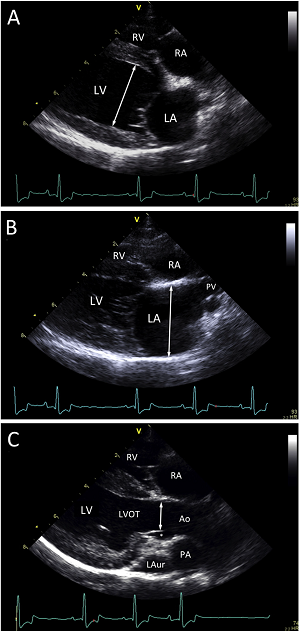 In an
August 2018 article, a team of cardiologists and other
researchers (L.E. Strohm, L.C. Visser, E.H. Chapel, W.T. Drost, J.D.
Bonagura) at Ohio State University have devised an echocardiographic
method of measuring left atrium (LA) and left ventricle (LV) dimensions
to determine enlargement due to mitral valve disease. Their method
involves taking "long-axis image plane" measurements of the LA and LV,
which differs from the conventional short-axis methods frequently used
to determine LA and LV and aorta (Ao) dimensions. Their stated goal was
to determine the utility of using long-axis ratios of LA/A0, LV/Ao, and
LA/LV when applied to MVD-affected dogs. The healthy control group of
180 dogs, including two cavalier King Charles spaniels. The MVD-affected
group was 25 dogs, including three CKCSs. (Representative
measurements are viewed at right.)
In an
August 2018 article, a team of cardiologists and other
researchers (L.E. Strohm, L.C. Visser, E.H. Chapel, W.T. Drost, J.D.
Bonagura) at Ohio State University have devised an echocardiographic
method of measuring left atrium (LA) and left ventricle (LV) dimensions
to determine enlargement due to mitral valve disease. Their method
involves taking "long-axis image plane" measurements of the LA and LV,
which differs from the conventional short-axis methods frequently used
to determine LA and LV and aorta (Ao) dimensions. Their stated goal was
to determine the utility of using long-axis ratios of LA/A0, LV/Ao, and
LA/LV when applied to MVD-affected dogs. The healthy control group of
180 dogs, including two cavalier King Charles spaniels. The MVD-affected
group was 25 dogs, including three CKCSs. (Representative
measurements are viewed at right.)
The normal dogs' ratios using this long-axis method were:
LA/Ao: median:2.09; min-max:1.82-2.48; 95% CI: 2.03-2.13
LV/Ao: median:2.10; min-max:1.74-2.60; 95% CI:2.08-2.15
LA/LV: median 0.99; min-max:0.97-1.01; 95% CI: 0.90-1.12.
The mean ratios of the MVD-affected dogs were: LA/Ao:3.0 (0.5); LV/Ao:2.7 (0.5); and LA/LV:1.1 (0.09).
The researchers explained that the normal LA/Ao ratio using the long-axis method is larger than for both M-mode and the short-axis 2-dimensional echo methods because the LA diameter is measured at its maximum and then is divided by a smaller aortic diameter. They state that, "No attempt was made to determine a specific long-axis ratio that would define the various stages of MMVD." Also, they concede that the study did not explore breed-related differences, such as those with relatively smaller or larger aortas. They recommend breed-specific ratios as being optimal.
EDITOR'S NOTE: There are pearls of wisdom in this article, acknowledging the imperfection of relying upon minimum measurement values to assume that a particular MVD-affected dog has an enlarged heart or not. For example, these researchers admit "the lack of a gold standard for left heart size".
They recognized "the potential for breed-related differences", such as breeds with relatively smaller or larger aortic size, which could lead to ratios that under- or over-estimate LA or LV size. But then, no ultrasound manufacturer or pharmaceutical company paid for this research. Unfortunately, in the manufacturer-fully-financed EPIC Study (starting pimobendan/Vetmedin before heart failure), these obvious and important limitations were totally ignored, with the conclusion that LA and LV measurements known to be those of dogs without any heart enlargement at all nevertheless are used to "define" enlargement in all dogs of all breeds! (Read the details about the EPIC Study's inexcusable definition of enlargement here.)
The unstated but obvious reason for the contortions which these present researchers go through, by comparing the sizes of the heart chambers of healthy dogs with those of MVD-affected dogs, is the lack of any baseline measurements of the MVD-affected dogs before their hearts were suspected of enlarging. Baseline measurements remain the key to confirming whether a particular MVD-affected dog has an enlarged heart chamber or not.
So, there really is a "gold standard for left heart size" -- having a baseline set of x-rays in the dog's file tobegin with. And that gold standard has nothing to do with echocardiograms. Two sets of much less expensive chest x-rays are much more precise than trying to figure out which length of measurement of LA or LV dimension to make, and whether it should be using 2-dimensional or M-mode echo imaging. For example, there is no mystery as to whether the dog at right above had an enlarged heart in 2004.
August 2018:
Auburn cardiologists test aldosterone receptor blocker
sacubitril/valsartan for lowering aldosterone concentrations in
MVD-affected dogs.
 In an
August 2018 article, a team of Auburn University researchers led by
veterinary cardiologist SeungWoo Jung (Daniel K. Newhard, Randolph
Winter, Sue H. Duran) examined the effectiveness of an
aldosterone receptor blocker, sacubitril/valsartan (S/V), in 7 dogs
diagnosed with mitral valve disease (MVD), compared to 6 MVD-affected
dogs in the placebo group. They report finding that S/V is effective at
lowering the urine concentration of aldosterone and that it was safe,
with no deleterious effects on BUN, creatinine, and electrolyte
concentrations, or systolic arterial pressure. The brand name for S/V is
Entresto.
In an
August 2018 article, a team of Auburn University researchers led by
veterinary cardiologist SeungWoo Jung (Daniel K. Newhard, Randolph
Winter, Sue H. Duran) examined the effectiveness of an
aldosterone receptor blocker, sacubitril/valsartan (S/V), in 7 dogs
diagnosed with mitral valve disease (MVD), compared to 6 MVD-affected
dogs in the placebo group. They report finding that S/V is effective at
lowering the urine concentration of aldosterone and that it was safe,
with no deleterious effects on BUN, creatinine, and electrolyte
concentrations, or systolic arterial pressure. The brand name for S/V is
Entresto.
EDITOR'S NOTE: The researchers claim that all dogs in the study had heart enlargement due to MVD. However, the criteria they used to determine enlargement were so faulty that all they could state with accuracy is that the dogs had MVD.
The criteria they used to determine enlargement were to calculate (1) each dog's vertebral heart score (VHS) and (2) the size of the dog's left atrium using the left-atrial-to-aortic-root ratio (LA:Ao) and (3) the size of the dogs's left ventricle using the internal-diameter-in-diastole indexed to body weight (iLVIDd). If the VHS was >10.5, and the LA:Ao was >1.6, and the iLVIDd was >1.7, then they assumed that the dog's heart was enlarged.
These three measurements have been shown in previous research studies to be completely unreliable in determining whether the dogs' hearts really were enlarged. They tell us size, but not enlargement. A dog can have a large, healthy heart without it being enlarged. See, this review of the same fictitious criteria used in the 2016 EPIC Study of pimobendan: "Why are cardiology researchers inventing bogus definitions of species-wide heart enlargement to test risky drugs?"
Lead investigator of this Entresto study, Dr. Seungwoo Jung, wrote to us: "The inclusion criteria that was used in my study is the same as what the EPIC study employed." Therefore, there is no scientific justification for these Auburn researchers to assert that all of the dogs in their study in fact had enlarged hearts. Why they chose to not actually verify if the dogs had enlarged hearts is beyond comprehension. They only used 13 dogs. How difficult and time-consuming could it have been for them to confirm enlargement? As a result of their laziness, the most that can be said about this study is that S/V performed well in MVD-affected dogs, regardless of having heart enlargement or not.
This mindless adoption of the EPIC Study's "definition" of Stage B2 heart enlargement is a major concern we have, not just for research studies such as this one, but especially for cardiology clinicians in determining if their patients' hearts are enlarged so that they can be prescribed pimobendan. We know they already are doing it throughout the world.
And, we are not alone in our concern. In an October 2018 article, Dr. Anna Elisabeth Beber reported that of seven cavalier King Charles spaniels affected with mitral valve disease but with no heart enlargement, their x-rays' vertebral heart score (VHS) values ranged from a low of 11.0v to a high of 11.9v. She noted that:"Using the vertebral heart score cut off of 10.5v in the EPIC study, all of the 'normal' Cavalier King Charles Spaniels in this study (defined by subjective impression consensus opinion) would have been considered to have cardiomegaly and therefore potentially received treatment unnecessarily."
July 2018:
Dr. Lance Visser seeks MVD-affected dogs with murmurs for study
measuring heart chamber sizes.
 Dr.
Lance Visser (right), veterinary cardiologist at University of
California-Davis, is leading a study of MVD-affected dogs to evaluate
different methods of measuring the size of the left atrium (LA) of the
dogs' hearts, to compare disease severity, treatment decisions, and
results of treatments. To be eligible, the dogs must be at least age 6
years, have a mitral valve murmur, and not be taking any heart
medications. Enrollment details are available at
this webpage.
Dr.
Lance Visser (right), veterinary cardiologist at University of
California-Davis, is leading a study of MVD-affected dogs to evaluate
different methods of measuring the size of the left atrium (LA) of the
dogs' hearts, to compare disease severity, treatment decisions, and
results of treatments. To be eligible, the dogs must be at least age 6
years, have a mitral valve murmur, and not be taking any heart
medications. Enrollment details are available at
this webpage.
Contact: Weihow Hsue at whsue@ucdavis.edu for questions related to enrollment or for scheduling an appointment. The examinations will be conducted at the school's cardiology clinic in Davis, California.
July 2018:
Cal-Davis cardiologists need Stage B MVD-affected dogs for study
of pimobendan's effect upon kidneys.
 Cardiologists
at the University of California-Davis, led by Dr. Lance Visser, are
conducting a study of the effect of pimobendan upon renal function of
MVD-affected dogs with either a moderately loud murmur (Stage B1) or
moderate cardiac enlargement (Stage B2). Specific enrollment criteria
are involved, and two visits to the cardiology service clinic in Davis,
California are required. Enrollment details are available at
this webpage.
Cardiologists
at the University of California-Davis, led by Dr. Lance Visser, are
conducting a study of the effect of pimobendan upon renal function of
MVD-affected dogs with either a moderately loud murmur (Stage B1) or
moderate cardiac enlargement (Stage B2). Specific enrollment criteria
are involved, and two visits to the cardiology service clinic in Davis,
California are required. Enrollment details are available at
this webpage.
Contact: sterngenetics@ucdavis.edu for questions related to enrollment or Pam McInnis at pjmcinnis@ucdavis.edu for scheduling an appointment.
July 2018:
New York cardiologist Dennis Trafny seeks dogs in heart failure
for treatment with isosorbide dinitrate.
 In
a
press release by the Animal Medical Center in New York City, board
certified veterinary cardiologist Dr. Dennis Trafny (right) has
announced he is seeking MVD-affected dogs in congestive heart failure
(CHF) for a study of treatment with isosorbide dinitrate (ISDN). This
drug is a cavernous artery vasodilator which leads to a reduction in
preload and cardiac oxygen consumption. ISDN causes a decrease in
arterial pressure and reduction in afterload. In a
September 2013
article involving experimentally induced MVD in six lab Beagles,
Japanese investigators reported that ISDN significantly reduced left
atrial pressure (LAP).
In
a
press release by the Animal Medical Center in New York City, board
certified veterinary cardiologist Dr. Dennis Trafny (right) has
announced he is seeking MVD-affected dogs in congestive heart failure
(CHF) for a study of treatment with isosorbide dinitrate (ISDN). This
drug is a cavernous artery vasodilator which leads to a reduction in
preload and cardiac oxygen consumption. ISDN causes a decrease in
arterial pressure and reduction in afterload. In a
September 2013
article involving experimentally induced MVD in six lab Beagles,
Japanese investigators reported that ISDN significantly reduced left
atrial pressure (LAP).
ISDN has been used safely in treating humans in CHF due to MVD. Now that it also has been shown safe for dogs, Dr. Trafny seeks to prove the efficacy of the drug in dogs. To be eligible for this study, the dog must have been diagnosed with CHF due to MVD and must not be receiving any nitrate drug thus far. For more information, contact Dr. Trafny at dennis.trafny@amcny.org or 212-838-7053.
May 2018:
Dr. Borgarelli needs MVD-affected dogs for mitral valve repair
study.
 Dr. Michele Borgarelli
(right) of the Virginia-Maryland College of Veterinary
Medicine needs two MVD-affected dogs for their new study of a
minimally-invasive surgical approach to repairing the canine mitral
valve. A
pilot study
report of this device, using six research dogs, was
published last year in J Vet Cardiology. See our
June 2017 item below.
Dr. Michele Borgarelli
(right) of the Virginia-Maryland College of Veterinary
Medicine needs two MVD-affected dogs for their new study of a
minimally-invasive surgical approach to repairing the canine mitral
valve. A
pilot study
report of this device, using six research dogs, was
published last year in J Vet Cardiology. See our
June 2017 item below.
Enrolled dogs will receive the repair procedure, post procedure hospitalization, and study-related rechecks at no cost. The surgeries and follow-up will take place at the veterinary school in Blacksburg, Virginia.
They are seeking dogs with mitral valve disease that have:
• Diagnosis of chronic mitral valve disease and at least one
re-occurrence of congestive heart failure despite medical management.
• Significant cardiomegaly
• Body weight > 5kg (11 pounds)
Dogs with rupture of mitral chordae tendinae are not eligible. These criteria are strict and dogs must meet all conditions of eligibility in order to be considered.
Dr. Borgarelli advises:
"This device has recently been modified to be used in canine patients. We have no long-term safety or efficacy data for these modifications. Based on human and preclinical animal studies, we believe this approach can be successful in canine patients. However, owners should be aware that this procedure, because it is new, may be associated with risks of worsening of their dog's condition and possibly even death.
"In order to evaluate a dog's suitability for the procedure, we need the dog's medical records, list of current medications and dosages, recent x-rays (last six months), and recent echocardiographic imaging and video loops (last six months).
"These assessments do not need to be performed at our hospital. The cost of these assessments is not covered by the study."
Please contact Mrs. Mindy Quigley (mindyq@vt.edu) or Dr. Borgarelli (micheb1@vt.edu) to discuss the study or your dog's potential enrollment.
May 2018:
USA researchers find that elamipretide normalizes decreased mRNA
and protein levels in dogs in heart failure.
 In a
May 2018 abstract, a team of researchers (RC Gupta, V Singh-Gupta,
HN Hani Sabbah) at the Henry Ford Hospital in Detroit reports that mRNA
and protein (S100A1, a calcium-binding protein predominantly expressed
in cardiac and skeletal muscles) levels are decreased in the left
ventricle (LV) of dogs and are normalized after chronic therapy with
elamipretide, a mitochondrially-targeted tetrapeptide, resulting in
observations of improved LV function and rate of ATP synthesis.
Elamipretide is a proprietary product of Stealth BioTherapeutics, Inc.,
which funded this research.
In a
May 2018 abstract, a team of researchers (RC Gupta, V Singh-Gupta,
HN Hani Sabbah) at the Henry Ford Hospital in Detroit reports that mRNA
and protein (S100A1, a calcium-binding protein predominantly expressed
in cardiac and skeletal muscles) levels are decreased in the left
ventricle (LV) of dogs and are normalized after chronic therapy with
elamipretide, a mitochondrially-targeted tetrapeptide, resulting in
observations of improved LV function and rate of ATP synthesis.
Elamipretide is a proprietary product of Stealth BioTherapeutics, Inc.,
which funded this research.
May 2018: PennVet researchers find that cardiovascular diseases in USA dogs are dependent upon the month they were born. In a May 2018 article in Nature magazine, PennVet cardiologists and a statistician reviewed heart testing reports submitted to the Orthopedic Foundation for Animals (OFA) on 129,778 dogs of 253 breeds. Of those, 128,997 (99.4%) were listed as having normal hearts, and only 781 (0.6%) were listed as having affected hearts. They concluded:
"Among canines that were not predisposed to cardiovascular disease, a clear birth season relationship is observed with peak risk occurring in June-August. Our findings indicate that acquired cardiovascular disease among canines, especially those that are not predisposed to cardiovascular disease, appears birth season dependent."
EDITOR'S NOTE: If this article had been published on April 1, it would have made
more sense. The fact that
 it was published at all is a testament to the
corruption of some so-called "scientific" publications in general.
Since it is in the popular science magazine, Nature,
apparently no veterinary journal (and maybe not even the Farmer's
Almanac) chose to have anything to do with it.
it was published at all is a testament to the
corruption of some so-called "scientific" publications in general.
Since it is in the popular science magazine, Nature,
apparently no veterinary journal (and maybe not even the Farmer's
Almanac) chose to have anything to do with it.
The list of "limitations" to this work is as long as a mobster's rap sheet. To wit:
● OFA's canine health data is self-reported;
● Only those breeders who chose to provide their dogs' data were included;
● Breeders who receive information that their dogs have cardiovascular issues may elect to not provide this data (only 0.6% reporting any cardiac disease is evidence enough of that);
● Pet dogs are under-represented;
● Other factors that influence cardiovascular disease are obesity, diet, exercise regime, and region of birth[!]
Nevertheless, the authors have the nerve to state this nonsense in their conclusion:
"Our analysis shows a clear birth season relationship among dogs belonging to breeds that are not predisposed to cardiovascular disease. This suggests that acquired cardiovascular disease may be birth season dependent among all dog breeds. ... Our findings indicate that acquired cardiovascular disease among dogs, especially those that are not predisposed to cardiovascular disease, is birth season dependent." (Emphasis added.)
Of course, their findings suggest nothing of the sort. Their "limitations" are so overwhelming that they completely nullify any value of the study's data. The fact that of over 129,000 dogs with cardiac tests reported to OFA, less than 800 had affected hearts, should have been proof enough to these cardiologists that they were wasting their time trying to make something of those skewed statistics. After all, most recent studies of the major causes of death of dogs rank cardiac conditions second after cancer, at about 11%, which means the PennVet authors should have expected to find around 14,000 dogs having affected hearts, if their study was to be worth publishing at all.
May 2018:
Thai researchers find ivabradine may reduce elevated heart rates
in asymptomatic MVD-affected dogs.
 In
a
May 2018 study of seven laboratory Beagles with naturally-occuring
asymptomatic MVD (ACVIM Stage B), the researchers (Pirintr P, Limprasutr
V, Saengklub N, Pavinadol P, Yapao N, Limvanicharat N, Kuecharoen H,
Kijtawornrat A [right]) noted that
a prior study has shown that dogs with asymptomatic MVD had a
significantly higher heart rates (HR) and systemic blood pressure (BP)
than healthy control dogs. They opined that higher HR will eventually
contribute to increased oxygen consumption by the heart muscle (MVO2).
Their study aimed to determine the effects of a single oral dose of
ivabradine on the HR, MVO2, and BP in dogs with asymptomatic MVD. They
report finding that a single oral dose of ivabradine for dogs with
asymptomatic MVD reduced both the dogs' HR and the hearts' MVO2 without
significantly affecting BP. They concluded that ivabradine may be
promising for management of an elevated HR in asymptomatic MVD-affected
dogs.
In
a
May 2018 study of seven laboratory Beagles with naturally-occuring
asymptomatic MVD (ACVIM Stage B), the researchers (Pirintr P, Limprasutr
V, Saengklub N, Pavinadol P, Yapao N, Limvanicharat N, Kuecharoen H,
Kijtawornrat A [right]) noted that
a prior study has shown that dogs with asymptomatic MVD had a
significantly higher heart rates (HR) and systemic blood pressure (BP)
than healthy control dogs. They opined that higher HR will eventually
contribute to increased oxygen consumption by the heart muscle (MVO2).
Their study aimed to determine the effects of a single oral dose of
ivabradine on the HR, MVO2, and BP in dogs with asymptomatic MVD. They
report finding that a single oral dose of ivabradine for dogs with
asymptomatic MVD reduced both the dogs' HR and the hearts' MVO2 without
significantly affecting BP. They concluded that ivabradine may be
promising for management of an elevated HR in asymptomatic MVD-affected
dogs.
May 2018:
Australian researcher reports results of grading 89 cavaliers
for MVD.
 In a
2017
master's thesis, Australian veterinary internal medicine specialist
Linda Tong (right) reports on her study of blood platelets in
89 cavalier King Charles spaniels, to investigate associations between
markers of Stage B1 and B2 mitral valve disease (MVD) and platelet
function or activation. The dogs were recruited from September 2011
through June 2013 by contacting known cavalier breeders and pet owners
in Western Australia. As a part of her study, she examined the 89 CKCSs
to determine the frequency of MVD in the dogs. She found at least
minimal mitral regurgitation via echocardiography in 86 of the 89 dogs
(97%), and an MVD murmur using auscultation in 47% of the cavaliers at
age 6 years or less.
See charts below.
In a
2017
master's thesis, Australian veterinary internal medicine specialist
Linda Tong (right) reports on her study of blood platelets in
89 cavalier King Charles spaniels, to investigate associations between
markers of Stage B1 and B2 mitral valve disease (MVD) and platelet
function or activation. The dogs were recruited from September 2011
through June 2013 by contacting known cavalier breeders and pet owners
in Western Australia. As a part of her study, she examined the 89 CKCSs
to determine the frequency of MVD in the dogs. She found at least
minimal mitral regurgitation via echocardiography in 86 of the 89 dogs
(97%), and an MVD murmur using auscultation in 47% of the cavaliers at
age 6 years or less.
See charts below.
April 2018:
Tufts researchers find higher furosemide doses point to longer
survival times for MVD-dogs in advanced heart failure.
 In
an
April 2018 article, a team of researchers at Tufts University's
Cummings vet school (Amelie Beaumier, John E. Rush [right],
Vicky K. Yang, Lisa M. Freeman) examined the records of 54 MVD-affected
dogs (including 9 cavalier King Charles spaniels) in advanced heart
failure (AHF). Their definition of AHF was the recurrence of heart
failure signs despite treatment with initial doses of pimobendan,
ACE-inhibitor, and furosemide. At the diagnosis of AHF, they found that
for most of the 54 dogs, doses of pimobendan, furosemide, ACE-inhibitor,
and spironolactone were increased, with new medications added in most
dogs. They found that the median survival time after diagnosis of AHF
was 281 days (range, 3-885 days), and that dogs receiving a furosemide
dose >6.70 mg/kg/day had significantly longer median survival times (402
days [range, 3-885 days] versus 129 days [range 9-853 days]). They
concluded that dogs with AHF can have relatively long survival times,
and that "a higher furosemide dose was significantly associated with
longer survival time."
In
an
April 2018 article, a team of researchers at Tufts University's
Cummings vet school (Amelie Beaumier, John E. Rush [right],
Vicky K. Yang, Lisa M. Freeman) examined the records of 54 MVD-affected
dogs (including 9 cavalier King Charles spaniels) in advanced heart
failure (AHF). Their definition of AHF was the recurrence of heart
failure signs despite treatment with initial doses of pimobendan,
ACE-inhibitor, and furosemide. At the diagnosis of AHF, they found that
for most of the 54 dogs, doses of pimobendan, furosemide, ACE-inhibitor,
and spironolactone were increased, with new medications added in most
dogs. They found that the median survival time after diagnosis of AHF
was 281 days (range, 3-885 days), and that dogs receiving a furosemide
dose >6.70 mg/kg/day had significantly longer median survival times (402
days [range, 3-885 days] versus 129 days [range 9-853 days]). They
concluded that dogs with AHF can have relatively long survival times,
and that "a higher furosemide dose was significantly associated with
longer survival time."
EDITOR'S NOTE: This is interesting information about the effectiveness of increasing doses of furosemide to keep the lungs of a Stage C dog from filling up again. But since it is a retrospective study of dogs treated from 2010 to 2016, one wonders whether this already has become old news. After all, torsemide, a loop diuretic ten times stronger than furosemide and now typically substituted for furosemide when it begins to lose its effectiveness, was utilized in only a small minority of the 54 dogs in this study. Torsemide now likely is far more popular since an October 2017 article on the TEST Study was published. (See our October 2017 article on the TEST Study.)
April 2018:
Japanese cardiologists report that ACE-inhibitor
alacepril reduces MVD regurgitation and CHF symptoms better than other
ACE-inhibitors.
 In a
March 2018 article, a team of cardiologists
(Akiko Uemura, Lina Hamabe, Kazumi Shimada, Miki Shimizu, Ryou Tanaka
[right]) at the
Tokyo University of Agriculture and Technology switched 73 MVD-affected
dogs in heart failure (CHF), including 6 cavalier King Charles spaniels,
from other ACE-inhibitors (either benazepril, enalapril, ramipril, or
temocapril), to the ACE-inhibitor alacepril. All dogs had been treated
with the other ACE-inhibitors for at least one month prior to the
switch. They compared the degrees of mitral valve regurgitation (HR),
activeness, appetite, responsiveness, body weight, and cough freqduency
and found "significant improvement" following two weeks of treatment
with alacepril. After four weeks of alacepril treatment, they report
observing an overall reduction of murmur intensity. They conclude:
In a
March 2018 article, a team of cardiologists
(Akiko Uemura, Lina Hamabe, Kazumi Shimada, Miki Shimizu, Ryou Tanaka
[right]) at the
Tokyo University of Agriculture and Technology switched 73 MVD-affected
dogs in heart failure (CHF), including 6 cavalier King Charles spaniels,
from other ACE-inhibitors (either benazepril, enalapril, ramipril, or
temocapril), to the ACE-inhibitor alacepril. All dogs had been treated
with the other ACE-inhibitors for at least one month prior to the
switch. They compared the degrees of mitral valve regurgitation (HR),
activeness, appetite, responsiveness, body weight, and cough freqduency
and found "significant improvement" following two weeks of treatment
with alacepril. After four weeks of alacepril treatment, they report
observing an overall reduction of murmur intensity. They conclude:
"In this study, switching to alacepril from other ACE-Is has shown to reduce HR, and improve the clinical symptoms of CHF, in particular the frequency of cough. The improvement of the clinical symptoms was related to the improvement in the class of heart failure. In addition to the influence on the renin-angiotensin-aldosterone system (RAAS), alacepril is known to have a wide range of actions, including inhibitory effects on the sympathetic nervous system and negative chronotropic effects. Although with the results of this study one cannot be certain, however, it is most likely that multiple factors are involved in the chough suppressive effect of alacepril."
March 2018:
UK cardiologist Melanie Hezzell outlines the progression of MVD
in small breed dogs.
 In a
March 2018 article, UK board certified veterinary cardiologist Dr.
Melanie Hezzell (right) examines current research into the pathology and
progression of mitral valve disease in cavalier King Charles spaniels
and other small breed dogs. In so doing, she makes several interesting
points:
In a
March 2018 article, UK board certified veterinary cardiologist Dr.
Melanie Hezzell (right) examines current research into the pathology and
progression of mitral valve disease in cavalier King Charles spaniels
and other small breed dogs. In so doing, she makes several interesting
points:
● "MMVD is frequently detected at a younger age in the CKCS compared with other breeds. Over half of CKCS are affected by five years of age and almost all CKCS are affected by the time they are 10 years old."
● "Despite being so common, the cause of MMVD remains unclear, although it does appear to be inherited. In CKCS, MMVD is believed to be a polygenic threshold trait, with threshold levels being influenced by sex. However, although two genetic loci associated with MMVD in CKCS have been identified, the precise genes involved and their function have yet to be determined."
● "Importantly, not all cases of MMVD are progressive and less than 50 per cent of dogs with MMVD will die as a result of their disease."
● "VHS [vertebral heart sum] is a measure of global heart size, and increases are not specific for left-sided cardiomegaly. The VHS is also not a sensitive way to detect increases in left atrial size; the left atrium contributes little to the VHS measurements due to its caudodorsal position on a lateral radiograph, although this does not preclude a radiographic assessment of left atrial enlargement in these cases (Fig 5, right)."
● "Furthermore, in certain breeds, dogs with echocardiographically normal hearts can have a VHS that exceeds the upper limit of the standard reference interval, resulting in the stage B1 dogs being misclassified as stage B2. Such breeds include the CKCS, dachshund, pug, Pomeranian, English bulldog, Boston terrier, boxer and Labrador retriever. Given that CKCS and dachshunds are particularly over-represented, this has clear clinical importance in MMVD."
● "Standard echocardiographic measurements of left atrial and ventricular dimensions are fraught with the potential for inaccuracy, as they involve measurements of a nongeometric three-dimensional structure on a two-dimensional image. If the incorrect image plane is chosen (for example, too apical in the ventricle or an oblique rather than a truly transverse plane) these dimensions can be significantly under- or over-estimated, resulting in possible misclassification."
 EDITOR'S
NOTE: There is so much here to unpack! It is as if we have
tapped into the cardiology truth squad's social media. Now, of course,
there is no surprise in the statement, "Over half of CKCS are affected
by five years of age and almost all CKCS are affected by the time they
are 10 years old." But, this statement -- "Importantly, not all cases of
MMVD are progressive and less than 50 per cent of dogs with MMVD will
die as a result of their disease." -- is a rare admission against
the interest of those many cardiologists who prescribe Vetmedin at the
slightest whisper of heart enlargement. It essentially means, over half of all
MVD-affected dogs will not need medication. Even more importantly, this
confession -- "Standard echocardiographic measurements of left atrial
and ventricular dimensions are fraught with the potential for
inaccuracy." -- confirms to us that following the EPIC Study parameters
is no
way to determine if a dog's heart is enlarged.
EDITOR'S
NOTE: There is so much here to unpack! It is as if we have
tapped into the cardiology truth squad's social media. Now, of course,
there is no surprise in the statement, "Over half of CKCS are affected
by five years of age and almost all CKCS are affected by the time they
are 10 years old." But, this statement -- "Importantly, not all cases of
MMVD are progressive and less than 50 per cent of dogs with MMVD will
die as a result of their disease." -- is a rare admission against
the interest of those many cardiologists who prescribe Vetmedin at the
slightest whisper of heart enlargement. It essentially means, over half of all
MVD-affected dogs will not need medication. Even more importantly, this
confession -- "Standard echocardiographic measurements of left atrial
and ventricular dimensions are fraught with the potential for
inaccuracy." -- confirms to us that following the EPIC Study parameters
is no
way to determine if a dog's heart is enlarged.
Thank you, Dr. Hezzell, for your refreshing honesty. Your education seems to have evolved since your November 2017 article in which you are quoted as attacking "some websites expressing negative opinions [which] could put owners off treatment with pimobendan and dogs could miss out of receiving high quality care as a result." Those "negative opinons" appear to have sunk in since November.
March 2018:
Dr. Adrian Boswood insists that all breeds of MVD-affected dogs which match
the minimum EPIC Study echo parameters should be prescribed pimobendan.
 In a
March 2018 article sponsored by the manufacturer of Vetmedin, Dr.
Adrian Boswood (right), a lead investigator in the EPIC Study,
"routinely" recommends that any MVD-affected dog (meaning of any breed) with a left
atrium measurement (LA:Ao) and a left ventricle measurement (LVIDDN)
which match the minimum echo measurements of the EPIC Study -- LA:Ao >
1.6 and LVIDDN > 1.7 -- should be administered pimobendan. However, he
states that the EPIC Study's minimum x-ray parameter of VHS > 10.5 "is
probably not, as a single measurement, sufficient evidence to warrant
therapy; however, it is likely that a dog with a VHS considerably
greater than this (for example, more than 11.5) will also have
echocardiographic evidence of enlargement.."
In a
March 2018 article sponsored by the manufacturer of Vetmedin, Dr.
Adrian Boswood (right), a lead investigator in the EPIC Study,
"routinely" recommends that any MVD-affected dog (meaning of any breed) with a left
atrium measurement (LA:Ao) and a left ventricle measurement (LVIDDN)
which match the minimum echo measurements of the EPIC Study -- LA:Ao >
1.6 and LVIDDN > 1.7 -- should be administered pimobendan. However, he
states that the EPIC Study's minimum x-ray parameter of VHS > 10.5 "is
probably not, as a single measurement, sufficient evidence to warrant
therapy; however, it is likely that a dog with a VHS considerably
greater than this (for example, more than 11.5) will also have
echocardiographic evidence of enlargement.."
He states:
"On the basis of the results of the EPIC study I now routinely recommend the use of pimobendan in dogs with preclinical MMVD and evidence of cardiac enlargement (sufficient to meet the EPIC inclusion criteria) at a dose of approximately 0.5 mg/kg/day divided into two doses (0.25 mg/kg twice a day)."
Dr. Boswood does not recommend treating MVD-affected dogs in Stage B2 with any other drugs. He states:
"I have never believed that the evidence for [ACE inhibitor] treatment was sufficiently compelling to warrant treatment and have not recommended the use of ACE inhibitors in dogs with stage B2 disease. There is currently no clear evidence to support the use of other drugs in dogs with stage B2 disease, although there are other ongoing studies that may provide evidence for the benefit of other medications in future.."
As for Stage C dogs (in heart failure), he concedes the lack of any veterinary research warranting treatment with an ACE inhibitor and spironolactone when combined with pimobendan and a diuretic, but nevertheless, he writes that:
"Despite this, most cardiologists (including me [sic]) now recommend the administration of four medications for the treatment of stage C MMVD: furosemide, pimobendan, an ACE inhibitor and spironolactone."
 EDITOR'S NOTE: So, Dr. Boswood is sticking to his guns on prescribing
pimobendan to all MVD-affected dogs, regardless of breed, based solely
upon the discredited echo measurements equaling the minimum left atrium and left
ventricle parameters of his EPIC Study. It is very curious that he would
do so, in view of the lack of any published veterinary research
justifying equating those minimum parameters (LA:Ao > 1.6 and LVIDDN >
1.7) and his own previous comments admitting that those parameters
include breeds of dogs (including cavaliers) without any heart
enlargement at all.
EDITOR'S NOTE: So, Dr. Boswood is sticking to his guns on prescribing
pimobendan to all MVD-affected dogs, regardless of breed, based solely
upon the discredited echo measurements equaling the minimum left atrium and left
ventricle parameters of his EPIC Study. It is very curious that he would
do so, in view of the lack of any published veterinary research
justifying equating those minimum parameters (LA:Ao > 1.6 and LVIDDN >
1.7) and his own previous comments admitting that those parameters
include breeds of dogs (including cavaliers) without any heart
enlargement at all.
As for LA/Ao > 1.6, the only veterinary article he and the other EPIC Study lead investigators cited was a November 2002 article reporting on the study, ironically, of 166 cavaliers and no dogs of any other breed. It divided the CKCSs into two groups - 56 dogs with no MVD and 110 dogs with mitral regurgitation (MR). The study did not distinguish between MVD-affected CKCSs with and without heart enlargement. In fact, enlargement was not even a topic of this study. The cavaliers in the MR group had a mean LA/Ao ratio of 1.61 ± 0.57. That range of measurements included cavaliers which had no heart enlargement at all. The authors of that 2002 study warned against applying these measurements for cavaliers to any other breeds, much less species-wide. They stated:
"The 2-D method can be used for any breed, but direct extrapolation of our normal values should not be made to other breeds, because the heart has a slightly different appearance in various breeds reflecting variability in size, shape, and position within the thorax."
The 2002 study's authors also were careful to exclude any findings comparing LA/Ao ratios of dogs with and without enlarged hearts. Since the 2002 article made no distinction between MVD-affected dogs with and without enlargement, that LA/Ao ratio data was irrelevant to the EPIC Study. The 2002 article authors stated:
"In this study, we have deliberately refrained from introducing index ranges for mild, moderate, and severe enlargement, because the grading would be arbitrary and was not included in the study design."
In addition, in a 2016 audio interview not sponsored by the manufacturer of Vetmedin, Dr. Boswood raised the prospect of clinicians frequently mis-calculating the LA/Ao ratio. He said (at 30:40):
"Everyone knows you can get an inaccurate single measurement of left atrium to aortic ratio -- over-estimated. The dog goes on to treatment it didn't need."
As for LVIDDN > 1.7, in that same audio interview (at time 31:06), Dr. Boswood admitted that the LVIDDN of 1.7 also is below the range for enlargement. He said:
"Now interestingly, if you look in the literature, the normalized left ventricular diameter of 1.7 is in the normal range. The abnormal is above about 1.85, [1.]9, 1.9 depending upon how you read it, so that's nudging the top of the normal range but still normal."
So much for the "validity" of the LVIDDN measurement. Dr. Boswood has
demonstrated by his own words that
 these inclusion parameters were never
intended to bear any relationship to dogs which actually had enlarged
hearts.
these inclusion parameters were never
intended to bear any relationship to dogs which actually had enlarged
hearts.
There is a decided lack of intellectual consistency between Dr. Boswood's previous comments about the unreliability of the EPIC Study's echo parameters and his adherence to those same flawed parameters in his current article, which, as noted above, is sponsored by the manufacturer of Vetmedin, a brand of pimobendan, which also underwrote 100% of the EPIC Study.
March 2018:
UK cardiologist recommends applying EPIC Study's species-wide
echo measurements to determine heart enlargement.
 In a
March
2018 article, UK board certified veterinary cardiologist Nuala
Summerfield (right) outlines the procedures -- auscultation,
x-rays, and echocardiographic exam -- to diagnose MVD and determine when
to start medicating with pimobendan. She accepts the EPIC Study's echo
parameter definitions of heart enlargement, without question. She writes:
In a
March
2018 article, UK board certified veterinary cardiologist Nuala
Summerfield (right) outlines the procedures -- auscultation,
x-rays, and echocardiographic exam -- to diagnose MVD and determine when
to start medicating with pimobendan. She accepts the EPIC Study's echo
parameter definitions of heart enlargement, without question. She writes:
"However, with some focused, practical training, the ultrasound images necessary to diagnose and stage MMVD in dogs (as per the EPIC criteria) can be reliably obtained and interpreted in a general practice setting. ...
"In the EPIC study, echocardiographic evidence of advanced MMVD was defined as: ... Echocardiographic evidence of left atrial and left ventricular dilatation defined as: Left atrial-to-aortic root ratio (LA:Ao) greater than or equal to 1.6; Bodyweight normalised left ventricular internal diameter in diastole (LVIDDN) greater than or equal to 1.7. ... The normal LA:Ao ratio is less than 1.6 when measured using the short-axis view. So, if your LA:Ao ratio is more than 1.6 this suggests that your patient does indeed have left atrial enlargement. ...
"Therefore, diagnosing heart enlargement not only allows you to provide the owner with a prognosis for their dog but also enables you to design an appropriate treatment plan if the dog meets the EPIC study criteria. ... With some focused, practical training, the ultrasound images necessary to diagnose and stage MMVD in dogs (as per the EPIC criteria) can be reliably obtained and interpreted in a general practice setting." (Emphasis added.)
 EDITOR'S NOTE: Here we go! As we predicted,
even board certified cardiologists are mindlessly accepting the EPIC
Study's bogus, species-wide echo definitions of heart enlargement despite the well-documented fact
that these parameters define no enlargement at all in the cavalier King
Charles spaniel and some other breeds. See the highlighted portions of
the quote above. In this instance, the author is advising non-specialists to accept these bogus echo measurements as
defining enlargement, and therefore starting treatment with pimobendan
far too prematurely.
EDITOR'S NOTE: Here we go! As we predicted,
even board certified cardiologists are mindlessly accepting the EPIC
Study's bogus, species-wide echo definitions of heart enlargement despite the well-documented fact
that these parameters define no enlargement at all in the cavalier King
Charles spaniel and some other breeds. See the highlighted portions of
the quote above. In this instance, the author is advising non-specialists to accept these bogus echo measurements as
defining enlargement, and therefore starting treatment with pimobendan
far too prematurely.
The only way to assure an accurate diagnosis of heart enlargement is to treat each dog as an individual and not simply compare x-ray and echo measurements with numbers on a wall chart. In other words, the clinician needs to apply his subjective skills in not just measuring the size of the heart, but also comparing the silhouette of the heart with recognized normal and enlarged shapes. This would include determining from x-rays whether the left atrium is bulging and/or if the left ventricle is rounded -- both being classic indications of abnormal shape connoting enlargement. Ideally, a set of "baseline" x-rays should have been made when a murmur was first detected, to compare to the later set of x-rays when enlargement is suspected.
March 2018:
Dr. Janet Olson lists the dos and don'ts of prescribing
diuretics to MVD-affected dogs.
 In a
December 2016 article (we concede
we are late in reporting it), board certified veterinary cardiologist
Dr. Janet Olson (right) provides a detailed explanation of when and when not to
prescribe loop diuretics (e.g., lasix) to dogs diagnosed with mitral
valve disease. In brief, she provides this list:
In a
December 2016 article (we concede
we are late in reporting it), board certified veterinary cardiologist
Dr. Janet Olson (right) provides a detailed explanation of when and when not to
prescribe loop diuretics (e.g., lasix) to dogs diagnosed with mitral
valve disease. In brief, she provides this list:
DOs:
1) Prior to prescribing lasix, a renal panel with electrolytes and a urine specific gravity should always be performed.
2) Any time the lasix dose is increased, a renal panel with electrolytes should be performed.
3) When performing a lasix trial, a dose of 2 mg/kg of lasix PO BID is recommended.
DONʼTs:
1) Donʼt start a dog on lasix just because the NTproBNP level is elevated, even if they are coughing or having respiratory distress.
2) Donʼt start a dog on lasix just because it has a heart murmur and respiratory signs such as coughing or labored breathing.
3) Donʼt base your lasix trial on improvement of clinical signs alone.
4) Donʼt taper down and then discontinue the use of lasix once your patient starts breathing comfortably.
5) Donʼt prescribe lasix and then tell the owner to give a particular dose two to three times daily as needed.
6) Donʼt keep increasing the dose of lasix in a patient that is not responding.
 EDITOR'S NOTE: Dr. Olson also states in her article:
EDITOR'S NOTE: Dr. Olson also states in her article:
"Therefore, it is necessary to take thoracic radiographs to confirm the presence of pulmonary edema prior to starting lasix."
We used to think it would go without saying that diuretics are intended to treat fluid buildup in the lungs, which is what pulmonary edema is -- a classic symptom of left-sided congestive heart failure (CHF). We know of no published veterinary research supporting administering diuretics to MVD-affected dogs before CHF. Nevertheless, some cardiologists (certainly not Dr. Olson) actually are prescribing diuretics to MVD-affected dogs in Stage B, before heart failure. It is refreshing and reassuring to find that Dr. Olson adheres to the old fashioned philosophy of not prescribing drugs when there is no research or other published evidence to support such prescriptions.
February 2018:
Australian company applies for US government patent of liquid
pimobendan. In a
February 2018 US patent application, the Australian company Luoda
Pharma has applied for a US patent for a liquid form of pimobendan
either alone or combined with an ACE-inhibitor and/or diuretic. In a
study of 6 healthy dogs, reported in the patent application, the
applicant's researchers (Nicholas Bova, Stephen Page, Giuseppe Pippia)
compared the effectiveness of the solid form of pimobendan -- Vetmedin
-- with the liquid form. They found:
In a
February 2018 US patent application, the Australian company Luoda
Pharma has applied for a US patent for a liquid form of pimobendan
either alone or combined with an ACE-inhibitor and/or diuretic. In a
study of 6 healthy dogs, reported in the patent application, the
applicant's researchers (Nicholas Bova, Stephen Page, Giuseppe Pippia)
compared the effectiveness of the solid form of pimobendan -- Vetmedin
-- with the liquid form. They found:
"Analysis of the data generated indicates that oral administration of the IVP [Investigational Veterinary Product -- oral solution of pimobendan] can produce plasma concentrations of pimobendan in the treated dogs that are likely to be therapeutic. The rapid uptake of pimobendan is evident following administration of the oral solution. The data generated suggest that in the elimination phase, the systemic concentration of pimobendan from the oral solution is slightly higher, and is retained slightly longer than the RVP [Reference Veterinary Product -- Vetmedin]."
January 2018:
Belgian questionnaire study of 114 CKCS owners shows they are
most concerned about MVD and CM/SM in selecting dogs.
 In
a
January 2018 study by Belgian investigators (Katrien Wijnrocx,
Liesbeth François, Peter Goos, Nadine Buys, Steven Janssens [right]),
they conducted a on-line Internet questionnaire study about the
attitudes of breeders and owners of cavalier King Charles spaniels in
the importance they attach to health (syringomyelia and mitral valve
disease) and conformation traits in the selection of a CKCS. The study
originated as a response to a recently invoked law that will oblige
Flemish CKCS breeders to screen their dogs prior to breeding. Residents
of Belgium, Denmark, the UK and the USA participated, the total number
being 114, of which 90% were female. The study results showed no
difference in preference between breeders or owners, and that they both
attached most importance to the health traits such as SM and MVD,
followed by eye shape and level of inbreeding. The 17-section
questionnaire topics included: shape of the eyes (choices: walleyed,
small, prominent), coat colour, muzzle length, level of inbreeding,
purchase price of the dog, syringomyelia status (choices: not tested,
tested and clinical symptoms present, and tested and free), eye disease
status (choices: not tested, tested and clinical symptoms present, and
tested and free), and mitral valve disease status (choices: not tested,
tested and clinical symptoms present, and tested and free).
In
a
January 2018 study by Belgian investigators (Katrien Wijnrocx,
Liesbeth François, Peter Goos, Nadine Buys, Steven Janssens [right]),
they conducted a on-line Internet questionnaire study about the
attitudes of breeders and owners of cavalier King Charles spaniels in
the importance they attach to health (syringomyelia and mitral valve
disease) and conformation traits in the selection of a CKCS. The study
originated as a response to a recently invoked law that will oblige
Flemish CKCS breeders to screen their dogs prior to breeding. Residents
of Belgium, Denmark, the UK and the USA participated, the total number
being 114, of which 90% were female. The study results showed no
difference in preference between breeders or owners, and that they both
attached most importance to the health traits such as SM and MVD,
followed by eye shape and level of inbreeding. The 17-section
questionnaire topics included: shape of the eyes (choices: walleyed,
small, prominent), coat colour, muzzle length, level of inbreeding,
purchase price of the dog, syringomyelia status (choices: not tested,
tested and clinical symptoms present, and tested and free), eye disease
status (choices: not tested, tested and clinical symptoms present, and
tested and free), and mitral valve disease status (choices: not tested,
tested and clinical symptoms present, and tested and free).
January 2018:
UK cardiologists find increases in certain white blood cells are tied to
MVD-dogs in heart failure.
 In a
January 2018 article, a team of UK's University of Liverpool
cardiologists (Julie Hamilton-Elliott [right], E. Ambrose, J. Dukes-McEwan) compared the white blood cells of 72 MVD-affected dogs
in congestive heart failure (CHF), including 17 cavalier King Charles
spaniels, with a control group of 143 dogs (4 CKCSs) without heart
disease. They report finding that, while the white cell counts remained
within normal limits, there was a noticeable increase in neutrophils,
band neutrophils, and monocytes* in the CHF
dogs in comparison with those without heart disease. They stated that
they could not conclude that their results indicate an inflammatory
response, but they speculated, "it is possible that relative
neutrophilia could be due to physiological stress in CHF patients."
In a
January 2018 article, a team of UK's University of Liverpool
cardiologists (Julie Hamilton-Elliott [right], E. Ambrose, J. Dukes-McEwan) compared the white blood cells of 72 MVD-affected dogs
in congestive heart failure (CHF), including 17 cavalier King Charles
spaniels, with a control group of 143 dogs (4 CKCSs) without heart
disease. They report finding that, while the white cell counts remained
within normal limits, there was a noticeable increase in neutrophils,
band neutrophils, and monocytes* in the CHF
dogs in comparison with those without heart disease. They stated that
they could not conclude that their results indicate an inflammatory
response, but they speculated, "it is possible that relative
neutrophilia could be due to physiological stress in CHF patients."
*Neutrophils are a type of white blood immune cell that is one of the first cell types to travel to the site of an infection. Neutrophils help fight infection by ingesting microorganisms and releasing enzymes that kill the microorganisms, including proteolytic enzymes, which facilitate tissue destruction. Band neutrophils are immature cells leading to a mature ones. Monocytes are white blood cells which influence the process of adaptive immunity.
January 2018:
Dr. Brian Scansen explains the vital importance of home respiratory
rate monitoring of MVD-affected dogs.
 In a
December 2017 article, USA veterinary cardiologist Dr. Brian A.
Scansen (right) recaps both the importance and the procedure for owners of
MVD-affected dogs to monitor the dogs' resting respiratory rate (RRR)
and its sleeping respiratory rate (SRR). He reviews the published
clinical research on respiratory rates of MVD-affected dogs approaching
heart failure (CHF) and reports that the upper limit of normal dogs for
SRR is approximately 25 breaths/minute, with RRR upper limits are
slightly higher, at 30 breaths/minute. He states that:
In a
December 2017 article, USA veterinary cardiologist Dr. Brian A.
Scansen (right) recaps both the importance and the procedure for owners of
MVD-affected dogs to monitor the dogs' resting respiratory rate (RRR)
and its sleeping respiratory rate (SRR). He reviews the published
clinical research on respiratory rates of MVD-affected dogs approaching
heart failure (CHF) and reports that the upper limit of normal dogs for
SRR is approximately 25 breaths/minute, with RRR upper limits are
slightly higher, at 30 breaths/minute. He states that:
"The most accurate rates are obtained in the patient's home environment. Respiratory rates measured at the veterinary practice are also of value but are more likely to be increased because of stress or recent activity, complicating interpretation."
He advises that:
"RRR and SRR should be recorded on a daily basis or at least once or twice per week to identify any trends in rate; measurement should be obtained at the same time each day. Typically, measurements obtained during the first week are used to define a baseline as long as the animal is not showing clinical signs. ... Consistent recordings greater than 30 breaths/min in a dog ... require prompt [veterinary] evaluation to rule out CHF or cavitary effusion.
The Takeaway: "The most accurate rates are obtained in the patient's home environment."
RETURN TO TOP
2017 News
December 2017:
Purina patent application claims coconut oil ingredient reverses
MVD echo measurements. In a
November 2017 patent application publication, Purina dog food
inventors (Qinghong Li, Dorothy P. Laflamme, Brittany Vester Boler, Hui
Xu, Sandeep Bhatnagar) claim that two studies have shown
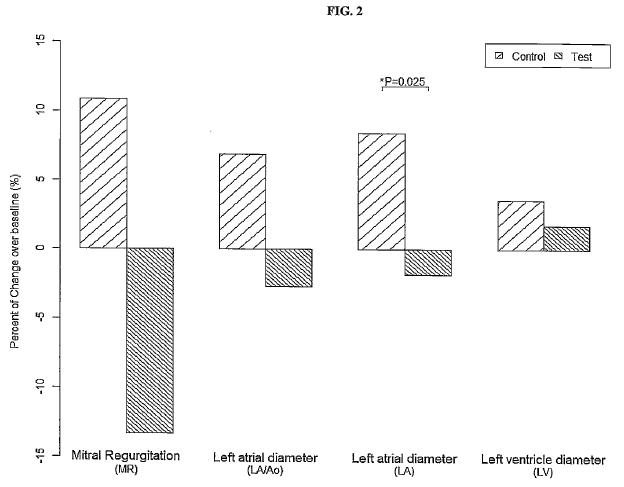 that
adding medium chain triglycerides (MCT), a main ingredient of coconut
oil, to a regular Purina diet showed "declines in key echocardiographic
parameters" in MVD-affected dogs (all Beagles), including the dimensions
of the left atrium, the left ventricle, the LA/Ao ratio, mitral
regurgitation grade and velocity, and murmur grade. See
Figure 1 (comparing the
baseline and 3 months), Figure 2 (at
right),(comparing the baseline and 6 months), and Tables 2 & 3.
The inventors also claim that they conducted a gene expression and
metabolomics study of the MVD-affected dogs, and that the study
indicated that long chain fatty acid beta-oxidation, branch chain fatty
acid alpha oxidation, and ketolysis were compromised in the dogs, while
glycolysis and glucose metabolism increased in dogs with MVD compared
with healthy control dogs. They also report that several proteins and
enzymes were compromised which are involved in transport of long chain
fatty acids from outside the cell to the mitochondria inner matrix and
activation of the long chain fatty acid in the cytoplasm.
that
adding medium chain triglycerides (MCT), a main ingredient of coconut
oil, to a regular Purina diet showed "declines in key echocardiographic
parameters" in MVD-affected dogs (all Beagles), including the dimensions
of the left atrium, the left ventricle, the LA/Ao ratio, mitral
regurgitation grade and velocity, and murmur grade. See
Figure 1 (comparing the
baseline and 3 months), Figure 2 (at
right),(comparing the baseline and 6 months), and Tables 2 & 3.
The inventors also claim that they conducted a gene expression and
metabolomics study of the MVD-affected dogs, and that the study
indicated that long chain fatty acid beta-oxidation, branch chain fatty
acid alpha oxidation, and ketolysis were compromised in the dogs, while
glycolysis and glucose metabolism increased in dogs with MVD compared
with healthy control dogs. They also report that several proteins and
enzymes were compromised which are involved in transport of long chain
fatty acids from outside the cell to the mitochondria inner matrix and
activation of the long chain fatty acid in the cytoplasm.
EDITOR'S NOTE: To say the least, we are very skeptical. For example, coconut oil is known to be very difficult for canines to metabolize. But the most shocking information in this patent application are the claims that heart size, murmur grades, mitral regurgitation, and other markers of MVD have reversed, with the heart chambers getting smaller, the regurgitation lessening, and the murmur grades declining, all within three months. None of the researchers listed are veterinary cardiologists, although the application claims that a board certified veterinary cardiologist participated by conducting the echocardiograph examinations.
We find it very unlikely that any research project could find so many Beagles with naturually-occurring MVD. And, Beagles are known as the lab rats of canine research. So, did the researchers intentionally cause damage to the dogs' mitral valves to induce some laboratory version of MVD? The patent application does not include enough information to determine that. Induced MVD is known to have different reactions to some treatments than does natural MVD. So, we need more information about these two case studies of Beagles.
This could be an example of in-house researchers producing just enough information to skate past the patent examiners. (It is not unlike a certain drug manufacturer covering 100+% of the expenses of three dozen veterinary cardiologists -- including matching jackets -- to produce the fundamentally flawed, superficially designed EPIC Study report claiming pimobendan safely delays the onset of heart failure in MVD-affected dogs. There is a patent application involved in that travesty, too. But we digress...)
December 2017:
Human and cavalier study finds serotonin 5HT receptors contribute
to MVD progression, and the drug LY 272015 may offset the progression.
 In
a
December 2017 article, a team of human and veterinary researchers
(Kathryn H. Driesbaugh, Emanuela Branchetti, Juan B. Grau, Samuel J.
Keeney, Kimberly Glass, Mark A. Oyama [right], Nancy Rioux,
Salma Ayoub, Michael S. Sacks, John Quackenbush, Robert J. Levy,
Giovanni Ferrari) studied the relationship between serotonin receptors
and mitral valve interstitial cells (MVICs) and leaflet remodeling in
humans and cavalier King Charles spaniels. Mitral valve specimens from
four deceased cavaliers with severe mitral valve prolapse (MVP) and
mitral regurgitation and four normal controls showed that serotonin 5HT
receptors (5HTRs) signaling contributes to MVP deterioration, in
particular, 5HTR2B upregulation. While this was primarily a study of
human MVP, it indicates a possible relationship between the upregulation
of 5HTR2B in cavaliers and the progression of mitral valve
deterioration. It also shows that a 5HTR2B antagonist -- a drug called
LY 272015 hydrochloride -- reduces MVICs activation in humans and mice.
Since the cavaliers in this study all were deceased, the application of
LY 272015 to dogs was not part of this study. LY 272015 is a
beta-carboline derivative drug developed by the Eli Lilly company which
is known to act as a potent and selective antagonist at the serotonin
5-HT receptor.
In
a
December 2017 article, a team of human and veterinary researchers
(Kathryn H. Driesbaugh, Emanuela Branchetti, Juan B. Grau, Samuel J.
Keeney, Kimberly Glass, Mark A. Oyama [right], Nancy Rioux,
Salma Ayoub, Michael S. Sacks, John Quackenbush, Robert J. Levy,
Giovanni Ferrari) studied the relationship between serotonin receptors
and mitral valve interstitial cells (MVICs) and leaflet remodeling in
humans and cavalier King Charles spaniels. Mitral valve specimens from
four deceased cavaliers with severe mitral valve prolapse (MVP) and
mitral regurgitation and four normal controls showed that serotonin 5HT
receptors (5HTRs) signaling contributes to MVP deterioration, in
particular, 5HTR2B upregulation. While this was primarily a study of
human MVP, it indicates a possible relationship between the upregulation
of 5HTR2B in cavaliers and the progression of mitral valve
deterioration. It also shows that a 5HTR2B antagonist -- a drug called
LY 272015 hydrochloride -- reduces MVICs activation in humans and mice.
Since the cavaliers in this study all were deceased, the application of
LY 272015 to dogs was not part of this study. LY 272015 is a
beta-carboline derivative drug developed by the Eli Lilly company which
is known to act as a potent and selective antagonist at the serotonin
5-HT receptor.
December 2017:
Brazilian researchers find relationship between inflammatory
cell secretions and MVD progression.
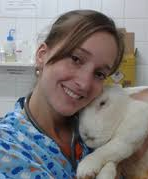 In
a
December 2017 article, Brazilian researchers (Rafael Rodrigues
Camacho, Elizabeth Regina Carvalho [right], Evandro Zacche
Pereira, Fabio Nelson Gava, Aparecido Antonio Camacho, Marlos Gonçalves
Sousa) investigated the concentration of certain inflammatory
substances, i.e., interleukins (IL-1β, 4, 6, 10), tumor necrosis factor
alpha (TNF-α), and C-reactive protein (CRP) in MVD-affected dogs of
ACVIM Stages B1, B2, and C, along with a control group of healthy dogs.
CRP is released from hepatic cells after stimulation by cytokines early
in the course of the inflammatory process. Increased serum values of CRP
have been observed in dogs with MVD in some circumstances. Cytokines are
a category of proteins which are secreted by cells and have a specific
effects upon their own cell and interactions with other cells as they
circulate through the blood system. There are inflammatory cytokines and
anti-inflammatory cytokines. Interleukins are inflammatory cytokines.
In
a
December 2017 article, Brazilian researchers (Rafael Rodrigues
Camacho, Elizabeth Regina Carvalho [right], Evandro Zacche
Pereira, Fabio Nelson Gava, Aparecido Antonio Camacho, Marlos Gonçalves
Sousa) investigated the concentration of certain inflammatory
substances, i.e., interleukins (IL-1β, 4, 6, 10), tumor necrosis factor
alpha (TNF-α), and C-reactive protein (CRP) in MVD-affected dogs of
ACVIM Stages B1, B2, and C, along with a control group of healthy dogs.
CRP is released from hepatic cells after stimulation by cytokines early
in the course of the inflammatory process. Increased serum values of CRP
have been observed in dogs with MVD in some circumstances. Cytokines are
a category of proteins which are secreted by cells and have a specific
effects upon their own cell and interactions with other cells as they
circulate through the blood system. There are inflammatory cytokines and
anti-inflammatory cytokines. Interleukins are inflammatory cytokines.
The researchers report finding: (1) the serum levels of interleukin 1β increases in MVD-affected dogs, and even higher levels are observed in dogs with MVD symptoms; (2) there is a significant correlation between heart enlargement and congestive heart failure and the circulating levels of IL-1β and IL-4; and (3) the serum levels of IL-6 and the left-ventricular shortening fraction are negatively correlated.
December 2017:
Romanian researchers find single-sets of x-ray measurements of heart
size alone are unreliable in diagnosing enlargement.
 In a
November 2017
article, a team of Romanian researchers (R. Andrei Baisan
[left], M. Ciocan, Oana
Bîrsan, V. Vulpe) reviewed the two "objective" means of assessing heart
size, which means using methods of measurement. In this case, x-ray measurement formulas
were examined. The two formulas discussed are
the vertebral heart score (VHS) and the cardiothoracic ratio (CTR). They
review numerous publications on these objective scoring devices. They
reach some very important conclusions:
In a
November 2017
article, a team of Romanian researchers (R. Andrei Baisan
[left], M. Ciocan, Oana
Bîrsan, V. Vulpe) reviewed the two "objective" means of assessing heart
size, which means using methods of measurement. In this case, x-ray measurement formulas
were examined. The two formulas discussed are
the vertebral heart score (VHS) and the cardiothoracic ratio (CTR). They
review numerous publications on these objective scoring devices. They
reach some very important conclusions:
● These techniques have many limitations and should only be used in combination with a good understanding of the normal sources of variation in the cardiac silhouette.
● A good general principle is that the heart should be considered radiographically normal unless there is an obvious change in size or shape.
● It is important to consider the breed and the size when performing measurements on thoracic radiographs to avoid any error of interpretation for cardiac enlargement.
● Cardiac measurement is helpful for general overview of the cardiac silhouette and for the dynamic progression of the disease.
● Thoracic radiography is a complementary exam and it must be used along the echocardiographic exam for a certain diagnostic.
EDITOR'S NOTE:
This is the peer-reviewed
article we have been waiting for!
 It
neatly summarizes everything that is wrong
with the irresponsible advice being given by several USA veterinary
cardiologists who prescribe pimobendan to MVD-affected dogs before heart
failure based solely upon the species-wide vertebral heart score (VHS)
on a single set of x-rays.*
It
neatly summarizes everything that is wrong
with the irresponsible advice being given by several USA veterinary
cardiologists who prescribe pimobendan to MVD-affected dogs before heart
failure based solely upon the species-wide vertebral heart score (VHS)
on a single set of x-rays.*
These pill-pushing cardiologists urge practitioners who may not have ultrasound devices or echocardiograph experience to simply take one set of x-rays, measure the VHS value, and if that value is 11.5 or higher, to assume the dog (any dog of any breed) has an enlarged heart and to start the pimobendan.**
This current review article from Romania points out how foolish that advice is. The most disturbing thing about all of this is that surely all of these USA cardiologsists already know what a load of irresponsible advice they are shoveling out, thereby putting MVD-dogs without enlarged hearts at great risk, especially cavaliers.
* See our Blog article on this topic:
"Why are
cardiology researchers inventing bogus definitions of species-wide heart
enlargement to test risky drugs?"
**
E.g.,
"Recommendations: The EPIC Trial: Pimobendan in Preclinical Myxomatous
Mitral Valve Disease." Cardiac Education Group. December 2016. Sonya
G. Gordon, Ashley B. Saunders, Sonya R. Wesselowski.
"Asymptomatic Canine Degenerative Valve Disease: Current and Future
Therapies". Vet. Clinics of No. Amer. Sm. Anim. Pract. September
2017;47(5):955-975.
December 2017:
USA cardiologist Dr. Jason Arndt rejects EPIC Study
recommendation to treat mild enlargement with pimobendan.
 In a
December 2017 continuing education presentation, Idaho cardiologist
Dr. Jason W. Arndt (right) reviewed the current status of MVD research, including
the November 2016 EPIC Study (sponsored by the manufacturer of
Vetmedin), which concluded that all MVD-affected dogs with certain
minimum heart size measurements, or any left sided enlargement at all,
should be treated with pimobendan. Dr. Arndt declined to follow all of the EPIC
Study recommendations. Instead, he proposed a more cautious approach. He
stated:
In a
December 2017 continuing education presentation, Idaho cardiologist
Dr. Jason W. Arndt (right) reviewed the current status of MVD research, including
the November 2016 EPIC Study (sponsored by the manufacturer of
Vetmedin), which concluded that all MVD-affected dogs with certain
minimum heart size measurements, or any left sided enlargement at all,
should be treated with pimobendan. Dr. Arndt declined to follow all of the EPIC
Study recommendations. Instead, he proposed a more cautious approach. He
stated:
"I will use with significant heart enlargement as long as it is tolerated. I do not use with normal heart size or mild cardiomegaly."
December
2017:
Ohio State cardiologists find systolic function of right
ventricle in MVD-affected dogs is affected by the stage of MVD.
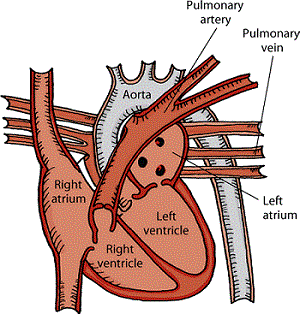 In a
December 2017 article, a team of Ohio State University cardiologists
(E.H. Chapel, B.A. Scansen, K.E. Schober, J.D. Bonagura [photo
below]) studied 36
MVD-affected dogs divided into three groups -- Stages B1, B2, and C --
to determine whether the heart's right ventricle (RV) systolic function
varies as MVD progresses from Stage B1 to Stage C. The breeds were not
identified. None of the dogs were being treated with MVD medications.
The researchers did not use conventional procedures for determining
which dogs were in Stage B2 -- actually had enlarged hearts -- and so
the accuracy of those determinations is questionable. (See Editor's
Note below for detailed analysis of this issue.)
In a
December 2017 article, a team of Ohio State University cardiologists
(E.H. Chapel, B.A. Scansen, K.E. Schober, J.D. Bonagura [photo
below]) studied 36
MVD-affected dogs divided into three groups -- Stages B1, B2, and C --
to determine whether the heart's right ventricle (RV) systolic function
varies as MVD progresses from Stage B1 to Stage C. The breeds were not
identified. None of the dogs were being treated with MVD medications.
The researchers did not use conventional procedures for determining
which dogs were in Stage B2 -- actually had enlarged hearts -- and so
the accuracy of those determinations is questionable. (See Editor's
Note below for detailed analysis of this issue.)
They report finding that right ventricular systolic function differed between stages of MVD, increasing in Stage B2, and declining in Stage C. These conclusions differ from previous reports, where no difference in RV systolic function was measured between the stages of MVD. They stated that the reason might be because of the administration of MVD medications in some dogs in the previous studies.
EDITOR'S NOTE: In this study, the dogs allegedly were separated into three categories: Stage B1 (those with MVD butno heart enlargement); Stage B2 (those with heart enlargement); and Stage C (those in heart failure). In other recent studies of this nature, the investigators have opted to forego carefully determining whether the MVD-affected dogs had enlarged hearts or not. In those studies, the investigators concocted totally unsubstantiated, arbitrary measurements of the vertebral heart score (VHS) value, the left atrium dimension (LA/Ao), and the left ventricle dimension (LVIDDN) and applied them to every dog of numerous breeds. We discuss these bogus measurements at some length in our Blog article, "Why are cardiology researchers inventing bogus definitions of species-wide heart enlargement to test risky drugs?"
That said, we initially were optimistic that, maybe at least in this study, these investigators would determine for each dog whether it really did have an enlargement of its heart, rather than "defining" enlargement by picking a set of arbitrary numbers and plugging in the dogs' results. After all, they were only dealing with 36 dogs. How time-consuming would it be to determine the ACVIM stage of each dog in an accurate manner? Well, no such luck! Apparently, these investigators, like the others, lacked the patience to accurately analyze the dogs' MVD stages.
They have picked out three arbitrary sets of measurements which they inexplicably somehow divined from the backsides of their minds (since they give no justification for any of these numbers), and they have applied them to all dogs in their study, regardless of breed. Here is what they wrote about that:
"Dogs were divided into 3 groups based on the ACVIM classification of valvular heart disease. The ACVIM staging does not specify a specific method for determining remodeling, and both radiographic and echocardiographic criteria were used in this study. Specifically, asymptomatic dogs with a VHS ≤ 10.5, LVIDDN ≤ 1.6, and absence of left atrial dilatation (long-axis LA:Ao ≤ 2.4)c were classified as stage/group B1 (MR without remodeling); asymptomatic dogs with a VHS > 10.5, LVIDDN > 1.6, and LA:Ao > 2.4 were classified as stage/group B2; and dogs with VHS > 10.5, LVIDDN > 1.6, and LA:Ao > 2.4 and with radiographic and clinical evidence of left-sided CHF were classified as stage/group C." (Emphasis added.)Here is a comparison of this study's species-wide, arbitrary definition of Stage B2 (MVD with enlargement) to the November 2016 EPIC Study's species-wide, arbitrary definition and other recently published definitions discussed in our above-referenced Blog article:
● VHS value: this study: > 10.5; EPIC Study: > 10.5; CEG Recommendation: > 11.5; October 2017 ACE-inhibitor study: > 11.o; September 2017 VHS study: > 11.7.
● LA/Ao ratio: this study: > 2.4; EPIC Study: > 1.6; July 2017 Spironolactone study: > 1.5. This study's higher measurement used a different type of echo from the others.
● LVIDDN: this study: > 1.6; EPIC Study: > 1.7; July 2017 Spironolactone study: > 1.6; Dr. Boswood's estimate: > 1.9.So, which ones are the correct ones? Let's face it. These "definitions" are all over the board and make no sense. They do not measure how much the heart has enlarged over time; they just measure the current dimensions of segments of the heart. There are no published, peer-reviewed veterinary studies which justify any such measurements defining heart enlargement for every dog of every breed in their studies. If any such documented support existed, surely the investigators would have cited it in their articles. By arbitrarily picking numbers like these and declaring that they define whether the dogs have enlarged hearts or not necessarily results in a failed study. They have made this research a complete waste of their time and somebody else's money.
Amazingly, these investigators blame the 2009 ACVIM Consensus Statement for their self-imposed dilemma. They write:
"The ACVIM staging does not specify a specific method for determining remodeling, ... ."Not true! Here is what the ACVIM Consensus Statement tells them about how to professionally determine whether a given dog has an enlarged heart or not:
"Thoracic radiography is recommended in all patients to assess the hemodynamic significance of the murmur and also to obtain baseline thoracic radiographs at a time when the patient is asymptomatic for CVHD.
"Stage B2: Hemodynamically significant MR with cardiac remodeling (defined as clearly enlarged LA, LV, or both); normotensive."Somehow they missed that paragraph, which is under the obvious and uncomplicated heading: "Diagnosis for Stage B." There is nothing unspecific about "baseline thoracic [chest] radiographs" (x-rays) to calculate VHS values to compare with current x-rays. Admittedly, "cardiac remodeling" and "clearly enlarged" may seem a little unspecific if you have just arrived here from Mars. But for a score of years, cardiologists have been determining whether dogs' hearts are "clearly enlarged" by carefully examining the shapes of their hearts on x-rays, as well as the overall sizes of the hearts.
So, this study's investigators have no business blaming the 2009 AVCIM Consensus Statement. But even if they had to dream up from scratch their own way to measure enlargement, the worst way is the one they chose -- to pick a bunch of arbitrary numbers and pretend that these numbers define Stage B2 for all breeds of dogs.
December 2017:
Cardiologists strike out in search for the genetic cause of MVD
in cavaliers.
 In
a
December 2017 article, a team of veterinary cardiologists (K.M.
Meurs (right) S.G. Friedenberg, B. Williams, B.W. Keene, C.E.
Atkins, D. Adin, B. Aona, T. DeFrancesco, S. Tou, T. Mackay) examined
the DNA in ten cavalier King Charles spaniels and ten Dachshunds
affected with mitral valve disease (MVD), searching for varients of
genes known to be analogous to genetic mutations associated with MVD in
humans. They report finding no such variants in any of the canine genes
evaluated, and that they did not identify any genetic cause responsible
for human MVD in the dogs studied. They concluded that MVD in the CKCS
and Dachshund may not share an identical genetic cause with the human
MVD.
In
a
December 2017 article, a team of veterinary cardiologists (K.M.
Meurs (right) S.G. Friedenberg, B. Williams, B.W. Keene, C.E.
Atkins, D. Adin, B. Aona, T. DeFrancesco, S. Tou, T. Mackay) examined
the DNA in ten cavalier King Charles spaniels and ten Dachshunds
affected with mitral valve disease (MVD), searching for varients of
genes known to be analogous to genetic mutations associated with MVD in
humans. They report finding no such variants in any of the canine genes
evaluated, and that they did not identify any genetic cause responsible
for human MVD in the dogs studied. They concluded that MVD in the CKCS
and Dachshund may not share an identical genetic cause with the human
MVD.
December 2017:
EPIC Study's longitudinal analysis has significant surprises for
the investigators.
 In a
December 2017 article by the team of cardiologists who conducted
the EPIC Study (published in September 2016), they reported the
following results:
In a
December 2017 article by the team of cardiologists who conducted
the EPIC Study (published in September 2016), they reported the
following results:
● Of the 354 dogs in the study, only 135 (38%) reached heart failure (CHF).
● At day 35, heart size (LA/Ao) had reduced in both the pimobendan group and the placebo group.
● Quality of life was perceived by owners to be improved after 1 month of treatment for both the placebo and pimobendan groups.
● At the onset of CHF, dogs receiving pimobendan were indistinguishable from those receiving placebo, and both groups had larger hearts and worse quality of life compared to baseline.
● A greater number of dogs in the pimobendan group experienced deterioration in exercise tolerance at the onset of CHF.
They found that there were no consistent differences observed between treatment groups in quality of life scores, change in heart murmur intensity, change in heart disease stage, and change in body condition scoring when examined over the first two years. They concluded that "Pimobendan treatment reduces heart size."
EDITOR'S NOTE: Fascinating! They concluded that "Pimobendan treatment reduces heart size." But their evidence shows that placebo treatment reduced heart size, too. This finding apparently was so disappointing to the authors (and especially to the study's 100+% financial sponsor, the manufacturer of Vetmedin) that they spent a very lengthy paragraph of their article wildly speculating on how it could have been possible for the hearts of the placebo group to significantly reduce in size, using such terms as "One possible explanation for this would be ...".
And, when were these reduced heart size measurements taken? Even though the report states that examinations were conducted on Day 35 and every four months thereafter and then on the day the dog was diagnosed as being in heart failure (CHF), the report provides data for only two dates: Day 35 and the day of CHF. So, on Day 35, both the pimobendan and placebo groups showed a reduction in the LA/Ao ratio, meaning a reduction in the size of the left atrium. But on the date of CHF, the dogs' left atriums had increased in size, with the placebo group hearts having increased less than the pimobendan group dogs.
What about the results of all of the four-month exams? Radio-silence from the EPIC Study authors. So, essentially, this longetudinal study report is all about spin and hype. In reaching their conclusion, the EPIC Study authors pick out the favorable data and ignore the rest. That is totally consistent with being goal-oriented, the goal being to enable the manufacturer of Vetmedin to get another exclusive patent on its drug.
In addition, keep in mind that, despite their claim that all dogs in the study had enlarged hearts at thestart of the trial, we already know (by lead investigator Dr. Adrian Boswood's own admissions in an on-line interview) that the inclusion criteria were for many dogs with normal-sized hearts and not enlarged ones. Also, all that the inclusion criteria did was make a one-time measurement of heart size and not determine whether the hearts actually were enlarged. Since no determination was made to identify which of the 354 dogs really had enlarged hearts at the start, they did not have adequate information in order to assign an equal number of dogs with enlarged hearts to the two groups -- the pimo group and the placebo group. Therefore, all comparisons of results are totally unreliable.
When you consider that nearly half of all of the dogs in this study were cavalier King Charles spaniels, the investigators' use of inclusion criteria which did not come close to defining cardiomegaly (enlargement) in the CKCS, is nothing less than professionally irresponsible, thereby intentionally putting our breed at high risk by administering pimobendan for several years to cavaliers with no heart enlargement at all.
Nevertheless, these results suggest that as many as 62% of the dogs in the study did not need pimobendan because they never reached CHF. This is consistent with a previous estimate that as many as 70% of all MVD-affected dogs with mild heart enlargement will never reach CHF and therefore do not need any medication to delay the onset of heart failure. After all, delaying the onset of CHF was what the EPIC Study was supposed to be all about. The authors ignore that issue, which obviously should make their 100+% financial underwriter, the manufacturer of Vetmedin, happy. But what this statistic tells us is that pimobendan, a very expensive drug, may well be totally un-needed for 60+% of MVD-affected dogs, even with some enlargement.
They admit that more of the pimodendan group dogs experienced deterioration in exercise tolerance at the onset of CHF than the placebo group dogs. And, finally, there was no significant difference in the quality-of-life measurements for dogs in either group as of the 35th day.
But, as with these investigators' first EPIC Study article, it is what they do not report or explain which is most disappointing, albeit totally expected. Here are a couple of the most obvious oversights:
● As the investigators (reluctantly) noted, a greater number of dogs in the pimobendan group experienced deterioration in exercise tolerance at the onset of CHF. This result is recorded without comment, but it could indicate that pimobendan prior to heart failure could accelerate the reduced mitochondria mass in the skeletal muscles, an acknowledged cause of such exercise intolerance. That process is known to commence in MVD-dogs only once CHF has been reached. Now, with the earlier administration ofpimobendan, the deterioration of the mitochondria (a bad thing) starts prematurely. How convenient to ignore such a startling relevation.
● They fail (indeed, refuse, because we asked them, and they turned us down) to break out any of the results on a breed basis. Since cavalier King Charles spaniels comprised nearly half of all dogs in this study, and since prior research has established that aspects of MVD in the CKCS are highly unique, the researchers refusal to provide breed-specific data for cavaliers is irresponsible. They have the CKCS data; they just won't publish them. When you average in the cavalier data with that of all other breeds, you end up with much less helpful information. All in all, this has been an EPIC FAIL!
December 2017:
An ACE gene polymorphism may explain why
ACE-inhibitors are less effective in MVD-affected cavaliers.
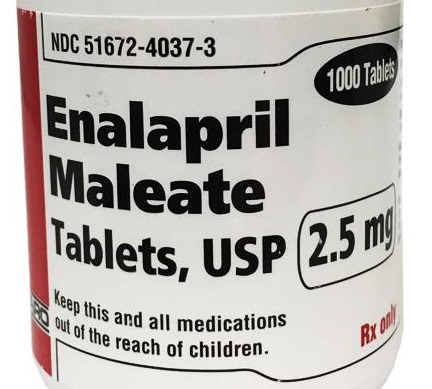 In a
December 2017 article, a team of veterinary cardiologists (Meurs KM,
Olsen LH, Reimann MJ, Keene BW, Atkins CE, Adin D, Aona B, Condit J,
DeFrancesco T, Reina-Doreste Y, Stern JA, Tou S, Ward J, Woodruff K)
studied 73 cavalier King Charles spaniels and report finding that:
In a
December 2017 article, a team of veterinary cardiologists (Meurs KM,
Olsen LH, Reimann MJ, Keene BW, Atkins CE, Adin D, Aona B, Condit J,
DeFrancesco T, Reina-Doreste Y, Stern JA, Tou S, Ward J, Woodruff K)
studied 73 cavalier King Charles spaniels and report finding that:
"The CKCS appears to have a high prevalence of the ACE variant. Dogs with the ACE variant had lower levels of ACE activity even in more advanced mitral valve disease than dogs without the variant."
They conclude with the hedge comment that the impact of their finding "on the need for ACE-I in dogs with the polymorphism and heart disease deserves further study."
EDITOR'S NOTE: This is one of four reports by members of this team of researchers regarding the reasons for ACE-inhibitors not being necessary to reduce angiotensin converting enzyme (ACE) activity in treating cavaliers with MVD. We report on two of the others here: this November 2017 article and this June 2016 article. In 2002, the SVEP Study of 229 cavaliers concluded that ACE-inhibitors were ineffective in delaying the onset of heart failure in MVD-affected CKCSs which were in either Stage B1 or B2. These more recent studies help to explain the reasoning behind the SVEP Study findings, which is that ACE-inhibitors do not benefit cavaliers because the breed has reduced ACE activity to begin with.
At some point we would hope that the estimated 70% of veterinary cardiologists who have been ignoring the SVEP Study for the past 15 years and still insist upon prescribing unnecessary ACE-inhibitors to cavaliers might bother to read this body of research and stop treating cavaliers as if they are no different from other breeds with MVD. What is there about the SVEP Study -- the largest veterinary cardiology trial of CKCSs in history -- that these cardiologists cannot understand? When it comes to MVD, the cavalier is a very unique breed, and it is time for all cardiologists to realize that fact and start treating cavaliers accordingly.
December 2017: Japanese surgeons report successful, complicated mitral valve repair of a mixed-breed Chihuahua using Gore-Tex e-PTFE sutures. In a November 2017 article by a team led by Japanese heart surgeons (Satoko Yokoyama, Isamu Kanemoto, Kippei Mihara, Takanori Ando, Koudai Kawase, Yasuaki Sahashi, Kazuhito Iguchi), they report the successful complicated repair of the deformed mitral valve of a Chihuahua mixed breed using Gore-Tex e-PTFE sutures. The valve's two leaflets had multiple lesions causing deep gaps and several elongated or ruptured chordae. The surgeons used three mitral valve plasty techniques: artificial chordal reconstruction for the ruptured or elongated chordae tendineae, semicircular suture annuloplasty for a dilated mitral annulus, and valvuloplasty for the deformed valve leaflets. Gore-Tex e-PTFE sutures were used to make the repairs. (The diagram shows where suture repairs were made to the valve leaflets.) The dog lived nearly five years following the heart surgery and endured two major non-heart surgeries in the interim. This report was first presented to a veterinary cardiology conference in 2010.
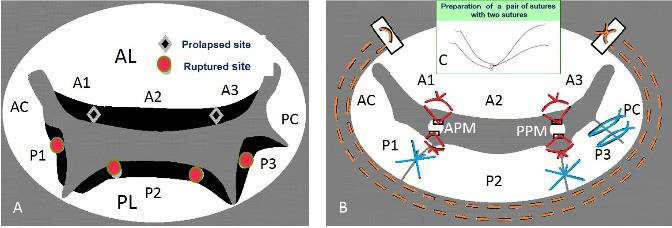
December 2017:
Bulgarian cardiologist finds echo marker of LA/Ao ratio and
x-ray VHS values cannot be used to initiate MVD therapy.
 In
an
October 2017 article, Bulgarian cardiologist Atanas Pankov
(right)
studied the usefulness of the echocardiographic ratio of the left atrium
to the aorta (LA/Ao) in MVD-affected dogs as a marker for Stage B2 heart
enlargement and the timing to initiate medical treatment. He used two
groups of multi-breed MVD-affected dogs, one group with pulmonary edema
(including a cavalier King Charles spaniel) and the other group without
edema. He found that:
In
an
October 2017 article, Bulgarian cardiologist Atanas Pankov
(right)
studied the usefulness of the echocardiographic ratio of the left atrium
to the aorta (LA/Ao) in MVD-affected dogs as a marker for Stage B2 heart
enlargement and the timing to initiate medical treatment. He used two
groups of multi-breed MVD-affected dogs, one group with pulmonary edema
(including a cavalier King Charles spaniel) and the other group without
edema. He found that:
"LA/AO can be used as an important indicator in the interpretation of data in group studies, but it cannot conclusively demonstrate the need for a medical intervention in the individual."
He also found that VHS values were not useful as a marker for starting treatment. He concluded:
"The ratios LA/AO; LC/AO and the values of VHS, despite the statistically significant differences between the two treatment groups, cannot be used as a marker to initiate therapy in patients with MVD, due to the overlapping values obtained in this study."
 EDITOR'S NOTE: This study
completely discredits the EPIC Study's inclusion criteria and final
recommendations. The EPIC Study "defined" Stage B2 heart enlargement as
any dog having at least a certain LA/Ao ratio, a certain VHS value, and
one other specified echo measurement, for all 360 of its dogs, regardless
of breed. Considering the EPIC Study investigators' abject failure to perform any
independent
EDITOR'S NOTE: This study
completely discredits the EPIC Study's inclusion criteria and final
recommendations. The EPIC Study "defined" Stage B2 heart enlargement as
any dog having at least a certain LA/Ao ratio, a certain VHS value, and
one other specified echo measurement, for all 360 of its dogs, regardless
of breed. Considering the EPIC Study investigators' abject failure to perform any
independent
 analysis to determine whether any of its 360 dogs actually had any heart
enlargement at the start of their testing (and how the
non-heart-enlarged dogs were assigned among the two study groups), this Bulgarian study demonstrates the
total lack of usefulness of both the EPIC Study's inclusion criteria
and its clinical recommendations for starting pimobendan therapy. This study
finds that no such minimum markers can be used to start treatment,
because they do not accurately indicate heart enlargement on a
species-wide basis.
analysis to determine whether any of its 360 dogs actually had any heart
enlargement at the start of their testing (and how the
non-heart-enlarged dogs were assigned among the two study groups), this Bulgarian study demonstrates the
total lack of usefulness of both the EPIC Study's inclusion criteria
and its clinical recommendations for starting pimobendan therapy. This study
finds that no such minimum markers can be used to start treatment,
because they do not accurately indicate heart enlargement on a
species-wide basis.
November 2017:
UK cardiologist Melanie Hezzell warns of cardiologist shortage
and "websites expressing negative opinions" delaying implementation of
EPIC Study results.
 In the
November 4, 2017 issue of the Veterinary Record, UK board certified
veterinary cardiologist Dr. Melanie Hezzell (right) issued warnings
about prescribing pimobendan to MVD-affected dogs prior to heart
failure.
In the
November 4, 2017 issue of the Veterinary Record, UK board certified
veterinary cardiologist Dr. Melanie Hezzell (right) issued warnings
about prescribing pimobendan to MVD-affected dogs prior to heart
failure.
She advises that heart enlargement should be diagnosed by echocardiography before prescribing the drug. Further, she said that the costs involved and lack of enough cardiologists to perform echos on all dogs with murmurs could delay treatment. She also predicted a two-edged sword of (1) owners asking that their dogs be treated with pimobendan before needing it, and (2) "websites expressing negative opinions" about the EPIC Study putting owners off treatment with pimobendan.
In the article, Dr. Hezzell is quoted as saying:
"Ideally dogs should undergo echocardiography before treatment with pimobendan. Unfortunately, even if cost was not an issue, there are not enough cardiologists in the UK to perform echos on all dogs with a murmur. Can we train more people to do basic echo accurately, repeatably and reproducibly enough? Four or five years down the line I think we can. But we're not there yet. There's a need for us to do that.
"Can we train more people to do basic echo accurately, repeatably and reproducibly enough? Four or five years down the line I think we can. But we're not there yet. There's a need for us to do that. Hopefully this will result in everybody becoming more skilled."
Then she is quoted as attacking "some websites expressing negative opinions [which] could put owners off treatment with pimobendan and dogs could miss out of receiving high quality care as a result."
EDITOR'S NOTE: Dr. Hezzell's observations about the ethically-challenged EPIC Study come down on both sides. Of course, here, she does not concede the fact that the study is the least bit flawed. But, unlike a few outspoken USA cardiologists who recommend relying only upon one x-ray measurement value of VHS=11.5 before prescribing pimobendan to any dog of any breed, Dr. Hezzell emphasizes the importance of performing echocardiograph examinations of the dogs to determine if their hearts are enlarged. (However, what she does not say in this article but does later on -- in March 2018 in another article -- is that echo measurements of heart dimensions "are fraught with the potential for inaccuracy".) And, she acknowledges that there are not enough cardiologists in the UK to perform echos on all dogs with murmurs.
Interestingly, she criticizes "some websites expressing negative opinions" about the EPIC Study (another thing she does herself in her March 2018 article). We know of only one such website -- ours -- but if there are others, then more power to them, because the EPIC Study is a poster child for why pharma-sponsored research of their exclusively licensed drugs cannot be trusted.
At some point, Dr. Hezzell needs to come to terms with herself about the value of echocardiography in detecting heart enlargement. Is it "ideal"? Or is it "fraught with the potential for inaccuracy"? Perhaps her awareness of the inadequacies of the EPIC Study has evolved between the inerrancy she expressed in November 2017 and the reality check she wrote about in March 2018. Could "some websites expressing negative opinions" possibly have enlightened her in the four month interim?
November 2017: USA cardiologists study 247 records of MVD-affected dogs to determine what VHS values also equated to EPIC Study echo criteria. In a September 2017 abstract presentation to the European Society of Veterinary Internal Medicine's 27th ECVIM-CA Congress in Malta, a group of USA cardiologists (J.P. Vitt, S. Gordon, R.C. Fries, J.D. Rhinehart, S.E. Achen, I. Sosa, A.H. Estrada, J.A. Carlson, R.L. Winter, S. Kadotani, K.E. Lamb) examined the radiographic and echocardiographic records of 247 MVD-affected dogs at 8 locations to attempt to identify a minimum vertebral heart score (VHS) value that would also predict EPIC's echocardiography inclusion criteria without having to perform echocardiographic examinations. They report that of the 247 dogs which met EPIC's minimum VHS value of 10.5, only 126 (51%) met EPIC's two minimum echo parameters (LVIDDN >1.7 and LA:Ao >1.6). They found that MVD-affected dogs with a VHS > 11.7 had an 85% likelihood of also meeting the echo parameters, and that roughly 34% of dogs with VHS values between 10.6 and 11.7 may meet those two echo measurements. They conclude:
"These results may help veterinarians apply the results of the EPIC Trial to dogs with preclinical MMVD when an echocardiogram is not readily available."
 EDITOR'S NOTE:
This study unintentionally highlights the fact that the EPIC Study's
inclusion criteria -- vertebral heart size (VHS) >10.5,
echocardiographically derived normalized left ventricular internal
dimension in diastole (LVIDDN) >1.7, and left atrial to aortic ratio
(LA:Ao) >1.6 -- do not in reality define enlargement and necessarily
include dogs with normal-sized hearts. This fact alone proves that the
EPIC Study is fatally flawed and puts some MVD-affected dogs,
particularly cavaliers, at greater risk of suffering the harmful effects
which pimobendan has been shown to cause in some instances of its
premature administration.
EDITOR'S NOTE:
This study unintentionally highlights the fact that the EPIC Study's
inclusion criteria -- vertebral heart size (VHS) >10.5,
echocardiographically derived normalized left ventricular internal
dimension in diastole (LVIDDN) >1.7, and left atrial to aortic ratio
(LA:Ao) >1.6 -- do not in reality define enlargement and necessarily
include dogs with normal-sized hearts. This fact alone proves that the
EPIC Study is fatally flawed and puts some MVD-affected dogs,
particularly cavaliers, at greater risk of suffering the harmful effects
which pimobendan has been shown to cause in some instances of its
premature administration.
If we assume (an assumption which already has been disproven) that EPIC's two echo parameters will always predict heart enlargement regardless of breed, then this study tells us that if the clinician relies only upon an x-ray showing a VHS value of >11.7, then 15% of the dogs still will not have enlarged hearts. It also proves that there can be no such thing as a species-wide minimum measurement for heart enlargement, without forcing dogs with normally smaller hearts to have to reach enlargement measurements so big that they would guarantee that the dogs reach heart failure before being treated.
We already know that even the EPIC Study's chief lead investigator, Dr. Adrian Boswood, began ridiculing the VHS >10.5 and LVIDDN >1.7 and LA/Ao >1.6 criteria within a month of the EPIC Study report's publication last year when he stated in an audio-recorded interview:
"A vertebral heart score of 10.5 is in the normal range for some dogs, particularly cavaliers actually."
"Now interestingly, if you look in the literature, the normalized left ventricular diameter [LVIDDN] of 1.7 is in the normal range. The abnormal is above about 1.85, [1.]9, 1.9 depending upon how you read it, so that's nudging the top of the normal range but still normal."
"Everyone knows you can get an inaccurate single measurement of left atrium to aortic ratio -- over-estimated. The dog goes on to treatment it didn't need."
So, now we have another of the EPIC Study three lead investigators -- Dr. Sonya Gordon -- and a few other cardiologists trying to salvage the study's parameters from the trash heap. What they are telling us is that MVD-affected dogs with an VHS value above 11.7 have a better than average chance of also having echo measurements within the range of the EPIC Study's echo parameters. And, they report that dogs with VHS values from 10.6 to 11.7 have a much worse than average likelihood of meeting those echo minimums.
Interestingly, the same Dr. Gordon published an article in June 2017 in which she confidently advised clinicians:
"Use of a VHS of >11.5 will improve the specificity (positive predictive value) of significant heart enlargement and guard against overtreatment of possible stage B1 dogs."
Yet now we find that she reports that an even higher minimum VHS threshold value of >11.7 will unconfidently give clinicians maybe an 85% chance of predicting enlargement. But what she still does not admit is the fact that EPIC's two echo parameters are no more accurate guides to species-wide heart enlargement than is EPIC's VHS parameter. So just because a VHS value above 11.7 might coincide with the two echo parameters, that dog still may have no heart enlargement at all.
What is certain is that the EPIC Study parameters do not equate to heart enlargement and were never intended to. Furthermore no effort was made in the EPIC Study trial, and no effort has been made in this reported retrospective file review, to determine if any of the 360 dogs in the EPIC Study and/or any of the 247 dogs in this file review actually had enlarged hearts. All that these cardiologists are doing is measuring distances within the dogs' hearts. Those measurements do not mean the dogs' hearts are enlarged. Enlargement means that the size of the heart has gotten bigger over time. One set of measurements on a single day does not tell the clinician that the dog's heart is enlarged, because the clinician does not know whether or not the heart ever was smaller than it is on the single day it was measured.
There are -- as there have been, for decades in the field of
veterinary cardiology -- professional ways to accurately determine if an
MVD-affected dog's heart is enlarged or not. Examples include (a)
careful examination of x-rays showing the shape of the dog's heart, with
emphasis upon the left atrium and left ventricle, looking for bulges and
roundness; (b) comparison of
current x-rays with earlier baseline x-rays. That
 professionalism is one
of the reasons board certified veterinary cardiologists are board
certified and earn the big bucks. For some inexplicable reason, the EPIC
Study investigators and the authors of this report do not want have to
bother to perform that professional veterinary service. They prefer to
urge primary care veterinarians to rely upon arbitrary measurements
which this report proves are not reliable, and end up putting our
cavaliers at risk by prematurely prescribing pimobendan, a drug which as
been shown to rapidly accelerate the progression of MVD in dogs which do
not yet need it.
professionalism is one
of the reasons board certified veterinary cardiologists are board
certified and earn the big bucks. For some inexplicable reason, the EPIC
Study investigators and the authors of this report do not want have to
bother to perform that professional veterinary service. They prefer to
urge primary care veterinarians to rely upon arbitrary measurements
which this report proves are not reliable, and end up putting our
cavaliers at risk by prematurely prescribing pimobendan, a drug which as
been shown to rapidly accelerate the progression of MVD in dogs which do
not yet need it.
We can only imagine how much pressure some hidden force must be putting upon these cardiologists for them to contort their brains and come up with a way to enable more primary care veterinarians to prescribe more Vetmedin pills to dogs which may, but more likely would not, need those pills.
October 2017:
USA cardiologists find cavaliers with variant of the
angiotensin-converting enzyme (ACE) gene have lower ACE activity
reaction to mitral valve disease.
 In an
October 2017 article, a team of
mostly USA cardiologists (Kathryn M. Meurs [right], Joshua A. Stern, Clarke E.
Atkins, Darcy Adin, Brent Aona, Julia Condit, Teresa DeFrancesco, Yamir
Reina-Doreste, Bruce W. Keene, Sandy Tou, Jessica Ward, Kathleen
Woodruff) report the results of a study of angiotensin-converting enzyme
(ACE) activity in dogs with mitral valve disease. Of 31 MVD-affected
dogs, including 10 cavalier King Charles spaniels, 11 dogs (6 CKCSs)
were found to have a variant (single nucleotide polymorphism) of the
intron 16 gene, which is associated with ACE activity in MVD-affected
dogs. The ACE polymorphism was most common in the cavalier. They
found that, before any ACE-inhibitor treatment, median ACE activity was
significantly lower for ACE polymorphism dogs than in the control group.
However, following treatment with enalapril, ACE activity was
significantly reduced in both groups. They conclude:
In an
October 2017 article, a team of
mostly USA cardiologists (Kathryn M. Meurs [right], Joshua A. Stern, Clarke E.
Atkins, Darcy Adin, Brent Aona, Julia Condit, Teresa DeFrancesco, Yamir
Reina-Doreste, Bruce W. Keene, Sandy Tou, Jessica Ward, Kathleen
Woodruff) report the results of a study of angiotensin-converting enzyme
(ACE) activity in dogs with mitral valve disease. Of 31 MVD-affected
dogs, including 10 cavalier King Charles spaniels, 11 dogs (6 CKCSs)
were found to have a variant (single nucleotide polymorphism) of the
intron 16 gene, which is associated with ACE activity in MVD-affected
dogs. The ACE polymorphism was most common in the cavalier. They
found that, before any ACE-inhibitor treatment, median ACE activity was
significantly lower for ACE polymorphism dogs than in the control group.
However, following treatment with enalapril, ACE activity was
significantly reduced in both groups. They conclude:
"An ACE polymorphism is associated with lower levels of ACE activity. Dogs with the polymorphism still experience suppression of ACE activity in response to an ACE inhibitor. It is possible that the genetic status and ACE activity of dogs may impact the response of dogs with this variant to an ACE inhibitor."
 EDITOR'S NOTE: We already know from the
SVEP study of 229 CKCSs and
the
VETPROOF trial that ACE-inhibitors are ineffective in treating
MVD-affected cavaliers prior to heart failure. This study suggests a
reason for those previous findings. Perhaps cavaliers tend to have a
lower level of ACE activity in reaction to their mitral valve disease,
and so treating with ACE-inhibitors is not as necessary to keep the
angiotensin-converting enzyme activity under control.
EDITOR'S NOTE: We already know from the
SVEP study of 229 CKCSs and
the
VETPROOF trial that ACE-inhibitors are ineffective in treating
MVD-affected cavaliers prior to heart failure. This study suggests a
reason for those previous findings. Perhaps cavaliers tend to have a
lower level of ACE activity in reaction to their mitral valve disease,
and so treating with ACE-inhibitors is not as necessary to keep the
angiotensin-converting enzyme activity under control.
Now, we also notice that the researchers state that:
"All dogs were required to have a grade 4/6 left apical systolic murmur and radiographically evident cardiac enlargement (defined as a vertebral heart scale (VHS) >11)."
While they cite two footnoted publications at the end of that sentence, presumably to justify their selection of a minimum VHS parameter of 11.0 for heart enlargement, neither of those cited articles support the selection of that VHS value. In fact, the cited articles do not support the selection of any vertebral heart scale values, at all.
Interestingly, the first of the two cited articles, which is the SVEP Study report, stated that the study's means of determining if the dogs had enlarged hearts was to carefully examine x-rays of the dogs' hearts. The authors stated:
"Thoracic radiographs in left lateral and ventrodorsal projections were made for all dogs. All radiographs were evaluated for signs of cardiomegaly [heart enlargement]... . The radiographic examinations were reviewed at annual evaluation meetings to ensure uniform film readings."
The second of the two articles cited in this October 2017 report as justification for the VHS value of > 11 is the ACVIM's 2007 Consensus Statement on hypertension in dogs and cats, "Guidelines for the identification, evaluation and management of systemic hypertension in dogs and cats". That article likewise does not support the VHS value of > 11 or, indeed, any other VHS value as a parameter for heart enlargement. It does not even discuss that topic.
So, in this October 2017 article, we have several board certified veterinary cardiologists intentionally failing to determine if the dogs' hearts actually are enlarged and instead artificially defining heart enlargement by an arbitrary minimum VHS value. If they had peer-reviewed, published evidence that a VHS value of 11.0 is conclusive proof that all dogs of all species with at least that VHS value had enlarged hearts, surely they would have cited those publications.* They have cited nothing of the sort. As a result, the researchers in this article were flying blind when it came to whether the dogs' hearts were enlarged or not. They ended up studying the VHS measurement instead of heart enlargement. So, to the extent that heart enlargment was an important factor in this study, the researchers failed to make that determination.
* We know of
peer-reviewed publications which expressly contradict the notion that
all cavaliers with a VHS value of 11.0 must have heart enlargement. Here
are two of them, below. In the first one, the researchers found cavaliers with
normal sized (meaning, unenlarged) hearts having a VHS value as high as
11.7. In the second article, the VHS range for cavaliers was as high as
11.4. Other breeds reportedly have normal sizes as high as >14.0.
(1) Lamb CR, Wikeley H, Boswood A, Pfeiffer DU.
Use of
breed-specific ranges for the vertebral heart scale as an aid to the
radiographic diagnosis of cardiac disease in dogs. Vet Rec. June 2001;148(23):707-11. ("There were significant differences between the mean
values of the scale for the different breeds; the normal boxer dogs had
a significantly higher mean value than the normal dogs of all the other
breeds, and the labrador retrievers had a significantly higher mean
value than all the other breeds except the boxer and the cavalier King
Charles spaniel. ... Cavalier King Charles spaniel: Normal: 10-6 (0-5);
Cardiac: 10-6 (0-7) 12.4 (1-5); Normal ranges: 9.9-11-7.")
(2)
Hansson K, Haggstrom J, Kvart C, Lord P.
Interobserver Variability of
Vertebral Heart Size Measurements in Dogs with Normal and Enlarged
Hearts. Vet. Rad. & Ultrasound. March 2005;46(2):122. ("The mean
VHS for normal cavalier King Charles spaniels was 10.8 ± 0.49 v
(10.0-11.4) ... The use of breed-specific
VHS values is needed for the VHS method to have a high specificity for
normal heart size. ... Individual variations in actual heart size and
vertebral length between dogs need to be considered as well as narrowed
disc spaces.")
 October 2017:
Cardiologist Jeremy Orr advocates prescribing
pimobendan to MVD-affected dogs even without heart enlargement. In a
September 2017 presentation to the Colorado Veterinary Medical
Association, board certified veterinary cardiologist Dr. Jeremy Orr
(right)
advocated prescribing pimobendan to MVD-affected dogs based upon a
minimum vertebral heart score (VHS) value alone, without regard to whether the
dogs' hearts are actually enlarged. He purportedly was explaining the
findings and conclusions of the EPIC Study to the attendees, but
contrary to Dr. Orr's comments, the
EPIC Study requires that the left side of the dog's heart be
enlarged, based upon two echocardiographic measurements as well as a VHS
value. To the contrary, Dr. Orr stated on slide #4
of his presentation (at right below):
October 2017:
Cardiologist Jeremy Orr advocates prescribing
pimobendan to MVD-affected dogs even without heart enlargement. In a
September 2017 presentation to the Colorado Veterinary Medical
Association, board certified veterinary cardiologist Dr. Jeremy Orr
(right)
advocated prescribing pimobendan to MVD-affected dogs based upon a
minimum vertebral heart score (VHS) value alone, without regard to whether the
dogs' hearts are actually enlarged. He purportedly was explaining the
findings and conclusions of the EPIC Study to the attendees, but
contrary to Dr. Orr's comments, the
EPIC Study requires that the left side of the dog's heart be
enlarged, based upon two echocardiographic measurements as well as a VHS
value. To the contrary, Dr. Orr stated on slide #4
of his presentation (at right below):
"HOW TO APPLY THESE [EPIC STUDY] RESULTS?
"Not all dogs with murmurs should be treated with pimobendan.
"Considerations to the following patients: ...
"If echo is not possible, initiate therapy when VHS exceeds 11.5" ...
The reference to "VHS exceeds 11.5" means that if the dog's x-ray shows that the size of its heart is larger than an x-ray VHS value of 11.5, pimobendan should be started. This appears to be Dr. Orr's recommendation of a species-wide minimum heart size for administering pimobendan to MVD-affected dogs.
EDITOR'S NOTE: Apparently, Dr. Orr is assuming that any MVD-affected dog of any breed with a VHS value over 11.5 must have an enlarged left side of its heart. By making this assumption, he advocated to the attendees at the veterinary conference to not bother to perform a full clinical examination (known as a "subjective" exam, which would call for the clinician to use his professional judgment) of the dog todetermine whether or not the left side of the dog's heart is, in fact, enlarged. He cannot cite any evidentiary basis for assuming that all dogs of all breeds with that VHS value must have enlarged hearts and for prescribing pimobendan, because there is no such evidence.
Published research studies have shown that dogs of some breeds, including the cavalier King Charles spaniel, may have hearts larger than 11.5 without any enlargement at all. Dr. Orr therefore is advocating prescribing pimobendan to dogs regardless of whether their hearts are enlarged or not. In at least one study, a CKCS had a normal, unenlarged heart with a VHS value of 11.7. In that same study, a boxer had a normal sized heart with a VHS value of 12.6, and a Labrador retriever had a normal sized heart with a value of 11.7. In another study, a pug had a normal sized heart with a VHS value of 14.1, a bulldog with a normal sized heart had 14.4, and a Boston terrier with a normal sized heart had 13.1. All of these normal heart sizes were substantially higher than Dr. Orr's species-wide recommendation of >11.5 for starting pimobendan.
The "results" Dr. Orr refers to on his slide #4 are not actually in the EPIC Study report at all, or in any other published research. He is just making that up. The EPIC Study conclusion requires that the left side of the patient's heart actually be enlarged. There is absolutely nothing in the EPIC Study report which supports using only an x-ray VHS value of >11.5 for prescribing pimobendan. To the contrary, the EPIC Study article expressly concludes:"Chronic oral administration of pimobendan to dogs with echocardiographic and radiographic evidence of cardiomegaly secondary to MMVD, in the absence of concurrent cardiovascular medication, results in the prolongation of the preclinical period, and is safe and well tolerated." (Emphasis addded.)In effect, Dr. Orr is recommending treating a mathematical measurement instead of treating the disease. How many Colorado veterinarians went away misinformed but prepared to start prescribing this expensive drug, pimobendan, to dogs without enlarged hearts, remains to be determined.
October 2017:
Korean study of echo measurements and biomarkers lists the most reliable parameters for
detecting MVD and heart failure.
 In a
September 2017 article, a team of Korean
researchers (Hyun-Seok Kim, Sang-Il Suh, Changbaig Hyun [right]) compared the
current echocardiographic parameters and cardiac biomarkers for
detecting mitral valve disease and heart failure in a study of 51 small
breed MVD-affected dogs (none were cavalier King Charles spaniels) and
18 healthy control dogs.
In a
September 2017 article, a team of Korean
researchers (Hyun-Seok Kim, Sang-Il Suh, Changbaig Hyun [right]) compared the
current echocardiographic parameters and cardiac biomarkers for
detecting mitral valve disease and heart failure in a study of 51 small
breed MVD-affected dogs (none were cavalier King Charles spaniels) and
18 healthy control dogs.
They report that, among the markers, the most reliable markers for detecting heart disease were:
● Indexed left atrial diameter (iLA)
● Left atrial to aorta ratio (LA/Ao)
● Transmitral E-peak (E-peak)
● N-terminal probrain natriuretic peptide (NT-proBNP)
The most reliable markers for detecting heart failure were:
● Left atrial to aorta ratio (LA/Ao)
● Transmitral E-peak (E-peak)
● Septal E/Ea ratio (sE/Ea)
● N-terminal probrain natriuretic peptide (NT-proBNP)
They state that their study "is the first canine study to comprehensively evaluate known echocardiographic markers and cardiac biomarkers in a single study population."
EDITOR'S NOTE: The old fashioned way to determine if a dog has mitral valve disease is to hear a murmur over the valve, using a stethoscope. It certainly is a much cheaper -- and less invasive -- procedure than either echocardiography or biomarkers. Granted, an echo can detect regurgitation backflowing through the mitral valve even before the sound of a murmur can be detected. But since soundless regurgitation is meaningless in terms of treatment -- and even in terms of whether the dog should be bred, under the MVD Breeding Protocol -- we wonder what the point is for a dog to undergo an expensive procedure such as an echo or biomarker to diagnose the onset of heart disease.
In addition, if these echo measurements -- indexed left atrial diameter (iLA), left atrial to aorta ratio (LA/Ao), and transmitral E-peak (E-peak) -- are "the most reliable markers for detecting heart disease", then what about observing regurgitation using color Doppler? These markers measure a deteriorating heart, whereas MVD starts out as totally symptomless backflowing of blood through the valve.
We have understood that the most accurate way of detecting the approach of heart failure is an increasing respiratory rate, while the dog is asleep, which approaches or exceeds 30 breaths per minute. The dog's owner can calculate this rate in her home using a timeclock or watch with a second hand, at no cost whatsoever. Also, x-rays which include an interstitial pattern in the lungs would indicate pulmonary edema, which is a hallmark of heart failure. So, the echo markers and biomarkers discussed here are in addition to those two more direct, conventional, and cheaper parameters. The fact remains that neither echo markers nor any biomarkers can provide a definitive diagnosis of heart failure. They cannot visualize lung congestion. Echocardiography and cardiac biomarkers are discussed at length on our main MVD page.
We wonder if, had cavaliers been included in this study, the findings and conclusions would have been any different. The researchers state that they intentionally focused on breeds whch are more popular in Korea and other Asian countries: Maltese, Shih Tzu, Yorkshire terrier, toy Poodle, Pekingese, miniature Schnauzer, Pomeranian, Chihuahua, and mixed breeds. We are not fans of relying upon dog-group-wide or breed-wide heart-size parameters for determining whether a particular patient has MVD or is approaching heart failure. Average or median heart size and pressure measurements for a species or even a single breed alone do not accurately confirm heart failure for the dog on the examining table.
So, while using these echocardiograph markers and biomarkers as a crib sheet may give comfort that the uncertain or inexperienced clinician's stethoscopic and x-ray diagnoses are on the right track, they should not be used as substitutes for the tried-and-true methods of detecting MVD and heart failure, performed by knowledgeable and confident veterinary specialists.
October 2017:
The TEST Study finds torsemide is more effective than
furosemide in treating MVD-affected dogs in heart failure over a short
term.
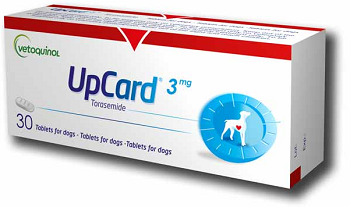 In an
October 2017 article, a team of French researchers (V. Chetboul,
J.-L. Pouchelon, J. Menard, J. Blanc, L. Desquilbet, A. Petit, S.
Rougier, L. Lucats, F. Woehrle) compared the effectiveness and safety of
torsemide (torasemide) with furosemide. Both are loop diuretics, but torsemide is
significantly more potent than furosemide and is usually prescribed to
dogs diagnosed with heart failure (CHF) due to mitral valve disease
beginning at
only one tenth of the dosage of furosemide.
In an
October 2017 article, a team of French researchers (V. Chetboul,
J.-L. Pouchelon, J. Menard, J. Blanc, L. Desquilbet, A. Petit, S.
Rougier, L. Lucats, F. Woehrle) compared the effectiveness and safety of
torsemide (torasemide) with furosemide. Both are loop diuretics, but torsemide is
significantly more potent than furosemide and is usually prescribed to
dogs diagnosed with heart failure (CHF) due to mitral valve disease
beginning at
only one tenth of the dosage of furosemide.
The study (called the TEST Study, which was sponsored by Vetoquinol, the manufacturer of UpCard, a torsemide brand name, and included Vetoquinol employees among the researchers) involved 366 dogs in CHF, of which 46 (12.6%) were cavalier King Charles spaniels. They found that over a short-term of 84 to 91 days, torsemide resulted in a two-fold reduction over furosemide in the risk of reaching the cardiac endpoint (either a cardiac-associated death or worsening of the degree of CHF). They concluded by warning:
"However, given its potent diuretic effects, the lowest effective dosage should always be determined and, as recommended by the ACVIM consensus guidelines, dogs under such diuretic treatment should be closely monitored for renal and electrolyte abnormalities. Further studies are now required to explore the potential beneficial antifibrotic effect of torasemide on dogs with CHF, and its potential benefit over furosemide on long-term survival."
September 2017:
US and Dutch cardiologists measure mitral valve regurgitation
using real-time three-dimensional transthoracic echocardiography (RT3DE).
 In
a
September 2017 article, Virginia-Maryland Veterinary School
cardiologists (Giulio Menciotti, Michele Borgarelli) and Utrecht
University cardiologist (Sandra Müller [right]), utilized
measurements of the size of the regurgitant gap in the mitral valve --
called the "anatomic regurgitant orifice area" (AROA) -- to determine if
that measurement compares to the severity of mitral regurgitation (MR)
assessed by an echocardiographic scoring system (MRSS). They devised
four classes of the MRSS -- normal, mild, moderate, and severe. They
used "real-time three-dimensional transthoracic echocardiography"
(RT3DE) to arrive at the AROA dimensions. Eleven cavalier King Charles
spaniels were included in the 60 dog, 25 breed, study.
In
a
September 2017 article, Virginia-Maryland Veterinary School
cardiologists (Giulio Menciotti, Michele Borgarelli) and Utrecht
University cardiologist (Sandra Müller [right]), utilized
measurements of the size of the regurgitant gap in the mitral valve --
called the "anatomic regurgitant orifice area" (AROA) -- to determine if
that measurement compares to the severity of mitral regurgitation (MR)
assessed by an echocardiographic scoring system (MRSS). They devised
four classes of the MRSS -- normal, mild, moderate, and severe. They
used "real-time three-dimensional transthoracic echocardiography"
(RT3DE) to arrive at the AROA dimensions. Eleven cavalier King Charles
spaniels were included in the 60 dog, 25 breed, study.
They found that The AROA was significantly greater in dogs with a severe MRSS compared with dogs with mild MRSS, and that there was no difference between the AROA of dogs in different ACVIM clinical stages (i.e., Stages B1, B2, C). They concluded that it is feasible to obtain the AROA in dogs with MVD using RT3DE, and that the AROA of dogs with severe MR is greater than the AROA of dogs with mild MR.
September 2017:
Cardiologists Borgarelli and Menciotti caution
against generalizing the narrow EPIC Study results.
 In a
September 2017
article, Virginia-Maryland College of Veteriinary Medicine cardiologists
Giulio Menciotti (right) and Michele Borgarelli reviewed the
current diagnostic and treatment options for dogs with mitral valve
disease.
In a
September 2017
article, Virginia-Maryland College of Veteriinary Medicine cardiologists
Giulio Menciotti (right) and Michele Borgarelli reviewed the
current diagnostic and treatment options for dogs with mitral valve
disease.
Regarding the EPIC Study trial, which included 360 MVD-affected dogs in ACVIM Stage B2, they noted that Stage B2 includes various degrees of heart enlargement -- e.g., slight, moderate, and severe. However, the specific echocardiograph and x-ray parameters for selecting those dogs in the EPIC Study were narrower than the full range of Stage B2 and required that the minimum extent of their heart enlargement be "significant". The authors warn that the benefit observed in the EPIC Study -- delaying the onset of heart failure by approximately 15 months, compared to the placebo group -- must be limited to the narrow inclusion criteria of the study. Specifically, they state:
"It is very important to remark, however, that ACVIM Stage B2 dogs represent a heterogeneous group of patients. Therefore, the benefit observed in the EPIC study can be inferred only for dogs that respect inclusion criteria of this study. In fact, for being enrolled in the aforementioned trial, dogs had to have evidence of significant left cardiac enlargement both at echocardiographic examination (LA/Ao > 1.6, LVIDd divided by allometric scaled BW > 1.7) and on thoracic radiographs (Vertebral Heart Score > 10.5)." (Emphasis added.)
EDITOR'S NOTE: What Drs. Menciotti and Borgarelli state here -- about
cautiously interpreting the results of
 the EPIC Study -- is completely
consistent with a statement in the EPIC report itself. There, the
investigators warned:
the EPIC Study -- is completely
consistent with a statement in the EPIC report itself. There, the
investigators warned:
"... it should be borne in mind when interpreting these results that all dogs included in the analyses also met the echocardiographic inclusion criteria and these results therefore might not be generalizable to all dogs with a VHS > 10.5 in the absence of concurrent echocardiographic measurements and a confirmed diagnosis of MMVD." (Emphasis added.)
In other words, pimobendan is not for ALL Stage B2 dogs. Essentially, EPIC's conclusion should be confined to its inclusion criteria, as should all scientific research. Unfortunately, these words of caution have been lost in the irresponsible efforts by Vetmedin's manufacturer and some cardiologists (including one of the EPIC Study's lead authors) to market pimobendan to any and all MVD-affected dogs with only the slightest degree of heart enlargement. Even worse, some cardiologists (including another of the EPIC Study's lead authors) are hyping pimobendan treatment for dogs without any enlargement at all (as long as their VHS score is 11.5 or higher). See our July 2017 article, below.
September 2017:
Polish cardiologists suggest that
echocardiography should be used to detect MVD regurgitation which does not
produce murmurs.
 In a
September 2017 study of 107 Dachshunds, a team of Polish
researchers (Magdalena Garncarz [right], Marta Parzeniecka-Jaworska, Magdalena
Hulanicka, Michał Jank, Olga Szaluś-Jordanow, Anna Kurek) observed
mitral valve regurgitation in 68 of the dogs (63.7%) which could not be
detected by murmurs heard with stethoscopes (auscultation). In most of
the dogs, they found that mitral valve prolapse and leaflet thickening
were "mild" and that the regurgitant area was "inextensive".
Nonetheless, they conclude that "the prevalence of mitral valve
regurgitation is underestimated when looking solely at dogs with heart
murmurs." They recommend that:
In a
September 2017 study of 107 Dachshunds, a team of Polish
researchers (Magdalena Garncarz [right], Marta Parzeniecka-Jaworska, Magdalena
Hulanicka, Michał Jank, Olga Szaluś-Jordanow, Anna Kurek) observed
mitral valve regurgitation in 68 of the dogs (63.7%) which could not be
detected by murmurs heard with stethoscopes (auscultation). In most of
the dogs, they found that mitral valve prolapse and leaflet thickening
were "mild" and that the regurgitant area was "inextensive".
Nonetheless, they conclude that "the prevalence of mitral valve
regurgitation is underestimated when looking solely at dogs with heart
murmurs." They recommend that:
"Although most dogs with CMVD do not progress to more advanced stages of congestive heart failure, it is beneficial to know that the disease is present, especially for scientific studies. ... Echocardiographic studies in dog breeds predisposed to chronic mitral valve disease without heart murmurs are warranted first of all as a preventative diagnostic method for heart disease if we are to eliminate suspicion of subclinical chronic mitral valve disease, and secondly to enable a better global picture of the prevalence of the disease since studies of dogs with heart murmurs underestimate the number of affected animals." (Emphasis added.)
 EDITOR'S NOTE:
Sigh... Here is but another example of the march
towards over-diagnosis -- detecting an insignificant imperfection which
does not cause the dog any health issues at all -- certainly not any
needing to be treated. Whether it be to help pay for an expensive ultrasound device
or to provide practice for inexperienced clinicians, echocardiograph
examinations to find mitral valve regurgitation in dogs without heart murmurs, are a waste of the dogs' time
and of the owners' money.
EDITOR'S NOTE:
Sigh... Here is but another example of the march
towards over-diagnosis -- detecting an insignificant imperfection which
does not cause the dog any health issues at all -- certainly not any
needing to be treated. Whether it be to help pay for an expensive ultrasound device
or to provide practice for inexperienced clinicians, echocardiograph
examinations to find mitral valve regurgitation in dogs without heart murmurs, are a waste of the dogs' time
and of the owners' money.
Of course, we have no problem with researchers wanting to test murmurless dogs to determine if they have regurgitation through their mitral valves, for research purposes. But the dogs' owners should not be expected to pay for such research under the guise of "eliminating suspicion of subclinical chronic mitral valve disease."
 August
2017:
Texas A&M's veterinary cardiology dept. needs young CKCSs for
free echo study of healthy mitral valves. The cardiology
department at the Texas A&M University's veterinary school is seeking
cavalier King Charles spaniels between the ages of 10 and 24 months,
with no history of heart murmurs or other illnesses for a free
echocardiograph examination and a blood sample at its teaching hospital.
If interested, please contact Dr. Sonya Wesselowski
(swesselowski@cvm.tamu.edu) (right) or TAMU Cardiology
(tamucardiology@cvm.tamu.edu) to find out about availability and
scheduling. See also
this link.
August
2017:
Texas A&M's veterinary cardiology dept. needs young CKCSs for
free echo study of healthy mitral valves. The cardiology
department at the Texas A&M University's veterinary school is seeking
cavalier King Charles spaniels between the ages of 10 and 24 months,
with no history of heart murmurs or other illnesses for a free
echocardiograph examination and a blood sample at its teaching hospital.
If interested, please contact Dr. Sonya Wesselowski
(swesselowski@cvm.tamu.edu) (right) or TAMU Cardiology
(tamucardiology@cvm.tamu.edu) to find out about availability and
scheduling. See also
this link.
July 2017:
Spironlactone study of MVD-affected dogs in Stage B2 proves
nothing new.
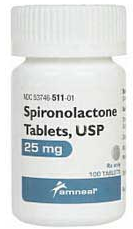 In a
July 2017 article by a team of UK investigators (M.J. Hezzell, A.
Boswood, J. López-Alvarez, N. Lotter, J. Elliott), they report the
inconclusive results of a pilot study of 25 dogs (13 treated with
spironolactone and 12 with placebo). All of the dogs were MVD-affected
and in ACVIM Stage B2 (with heart enlargement). None of them were being
treated with any other drugs. Just about the only thing the study
results confirm is their statement that the drug's "efficacy in
preclinical MMVD is unknown." They call for another study of at least 76
dogs, but now that the EPIC Study calls for treating dogs in Stage B2
with pimobendan, it appears doubtful they will find enough untreated
Stage B2 dogs for such a larger study.
In a
July 2017 article by a team of UK investigators (M.J. Hezzell, A.
Boswood, J. López-Alvarez, N. Lotter, J. Elliott), they report the
inconclusive results of a pilot study of 25 dogs (13 treated with
spironolactone and 12 with placebo). All of the dogs were MVD-affected
and in ACVIM Stage B2 (with heart enlargement). None of them were being
treated with any other drugs. Just about the only thing the study
results confirm is their statement that the drug's "efficacy in
preclinical MMVD is unknown." They call for another study of at least 76
dogs, but now that the EPIC Study calls for treating dogs in Stage B2
with pimobendan, it appears doubtful they will find enough untreated
Stage B2 dogs for such a larger study.
EDITOR'S NOTE: While this study breaks no new ground, it does remind everyone that there still is no peer-reviewed evidence warranting the administration of spironolactone to cavaliers not yet in heart failure. Why so many cardiologists nonetheless insist upon prescribing this drug to symptomless MVD-affected cavaliers remains a mystery. See our Blog posts, "All that cavalier owners need to know about spironolactone" and "Why do any veterinarians prescribe useless drugs to MVD-affected cavaliers before heart failure?".
July 2017:
Sildenafil (Viagra) beats out
enalapril in improving heart rate variability in Stage B MVD-affected
dogs.
 In a
July 2017 article, Thai researchers (Prapawadee Pirintr,
Nakkawee Saengklub, Vudhiporn Limprasutr, Suwanakiet Sawangkoon, Anusak
Kijtawornrat) compared sildenafil (Viagra) to enalapril (an
ACE-inhibitor) in their effectiveness in increasing heart rate
variability (HRV) in MVD-affected dogs in ACVIM Stage B (pre-heart
failure). Thirty-four MVD-affected dogs and thirteen healthy dogs
participated, divided into groups of control, sildenafil, and enalapril.
At the outset, they noted that MVD degeneration causes an imbalance of
"sympathovagal" activity (see Editor's Note below), which results in
poor cardiac outcomes. The results showed that MVD-affected dogs had
significant higher heart rates (HR), systemic blood pressures, and
significant decreased HRV than the healthy control dogs. After treatment with sildenafil for 90 days,
both time- and frequency-domain parameters were significantly increased
when compared with control and enalapril groups. This study demonstrated
that sildenafil improves HRV in Stage B dogs, and that enalapril did
not. They concluded that this result suggests that sildenafil should be
used in MVD-affected dogs to restore the sympathovagal balance.
In a
July 2017 article, Thai researchers (Prapawadee Pirintr,
Nakkawee Saengklub, Vudhiporn Limprasutr, Suwanakiet Sawangkoon, Anusak
Kijtawornrat) compared sildenafil (Viagra) to enalapril (an
ACE-inhibitor) in their effectiveness in increasing heart rate
variability (HRV) in MVD-affected dogs in ACVIM Stage B (pre-heart
failure). Thirty-four MVD-affected dogs and thirteen healthy dogs
participated, divided into groups of control, sildenafil, and enalapril.
At the outset, they noted that MVD degeneration causes an imbalance of
"sympathovagal" activity (see Editor's Note below), which results in
poor cardiac outcomes. The results showed that MVD-affected dogs had
significant higher heart rates (HR), systemic blood pressures, and
significant decreased HRV than the healthy control dogs. After treatment with sildenafil for 90 days,
both time- and frequency-domain parameters were significantly increased
when compared with control and enalapril groups. This study demonstrated
that sildenafil improves HRV in Stage B dogs, and that enalapril did
not. They concluded that this result suggests that sildenafil should be
used in MVD-affected dogs to restore the sympathovagal balance.
EDITOR'S NOTE: Changes in the dog's heart rate are tied to changes in cardiac output. Heart rate variability (HRV) reflects variations in the time periods between heart beats. Generally, a low HRV indicates that the dog is under stress, which may be due to exercise, psychological events, or other internal or external events. A higher HRV usually means that the dog has a strong ability to tolerate stress or is strongly recovering from prior accumulated stress. A reduction in HRV in MVD-affected dogs reflects a "sympathovagal imbalance", which has been identified as a risk factor for sudden cardiac death. "Sympathovagal" refers to an interaction between the dog's sympathetic nervous system and its vagus nerve. HRVs reflect the output of the heart as regulated by the sympathetic nervous system. This study also demonstrates that there is no peer-reviewed reason why Stage B cavaliers should be prescribed enalpril or any other ACE-inhibitor.
July 2017:
 Tufts researchers
locate microRNA associated with heart failure in MVD-affected dogs,
including cavaliers. In a
July 2017 article, a team of Tufts University
investigators (Vicky K. Yang [right], Kerry A. Loughran, Dawn M. Meola,
Christine M. Juhr, Kristen E. Thane, Airiel M. Davis, Andrew M. Hoffman)
report they have located microRNA*
(cfa-miR-9, cfa-miR-181c, cfa-miR-495 and cfa-miR-599) expressions which
change with the progression of mitral valve disease and development of
heart failure. The study consisted of 47 dogs, including 17 cavalier
King Charles spaniels, which were divided into three groups based upon
their heart conditions. All of the cavaliers in the study were
MVD-affected and were in either the ACVIM Stage B (asymptomatic) or Stage C
(heart failure) categories. The found:
Tufts researchers
locate microRNA associated with heart failure in MVD-affected dogs,
including cavaliers. In a
July 2017 article, a team of Tufts University
investigators (Vicky K. Yang [right], Kerry A. Loughran, Dawn M. Meola,
Christine M. Juhr, Kristen E. Thane, Airiel M. Davis, Andrew M. Hoffman)
report they have located microRNA*
(cfa-miR-9, cfa-miR-181c, cfa-miR-495 and cfa-miR-599) expressions which
change with the progression of mitral valve disease and development of
heart failure. The study consisted of 47 dogs, including 17 cavalier
King Charles spaniels, which were divided into three groups based upon
their heart conditions. All of the cavaliers in the study were
MVD-affected and were in either the ACVIM Stage B (asymptomatic) or Stage C
(heart failure) categories. The found:
"The present observations suggest that dysregulation of miR-9 and miR-599 chronologically precedes CHF, suggesting that these miRNA warrant further investigation as putative initiating factors for CHF, while others were found only at the time of CHF (miR-181c and miR-495), which denotes a role in initiation, progression or consequence of CHF. ... The data analysis shows that relative to young normal dogs, dogs with MMVD or dogs with MMVD-CHF, the expression level of cfa-miR-9 is low in older normal dogs. MiR-9 has been shown to have anti-fibrotic effects, and overexpression of miR-9 in neonatal rats inhibits the proliferation of cardiac fibroblasts and collagen production. ... Both of these effects would suggest that miR-9 has protective effects for cardiac remodelling."
"In contrast, cfa-miR-9 expression once again increases with the development of MMVD, which would suggest that MR [mitral regurgitation], volume-overload, cardiac remodelling or haemodynamic effects on other organs (lungs and kidneys) may initiate or propagate higher expression of circulating cfa-miR-9. However, it is not known if the anti-fibrotic effects of miR-9 are sufficient to counter pro-fibrotic stimuli exerted by volume overload and chronic heart failure."
"The data showed that there is high expression of exosomal cfa-miR-181c in dogs with CHF. MiR-181c is encoded in the nucleus and assembled in the cytoplasm of the cardiomyocytes and is then translocated into mitochondria to regulate mitochondrial gene expression. ... [G]iven the significant increase in cfa-miR-181c expression in MMVD-CHF, miR-181c may serve as an important biomarker or therapeutic target in patients at risk for developing CHF."
"Plasma exosomal miR-495, which is repressed with age, increases with MMVD-CHF. This ex-miRNA was upregulated with heart disease, particularly in advanced disease with CHF in defiance of its age-related trend downward. ... Although speculative, cfa-miR-495 may also serve as a potential biomarker to help monitor progression to active CHF in addition to cfa-miR-181c."
"Exosomal miR-599 declines in MMVD compared to age-matched controls. ... An increase in cfa-miR-599 associated with ageing was observed. Studies have shown that this miRNA can inhibit vascular smooth-muscle cell proliferation and production of collagen I, collagen V and proteoglycan by direct targeting of TGFβ2. Interestingly, there is a downregulation of cfa-miR-599 in dogs with MMVD when compared to normal older dogs."
"Based on the present disease model, two miRNA were found, specifically miR-495 and miR-181c, whose rise in expression level coincides with the observation of CHF. The authors acknowledge that dysregulation of these ex-miRNA may not be unique to CHF secondary to MMVD, but rather may be a signature of canine heart failure which is a consequence of other aetiologies."
*MicroRNA (miRNA) is a non-coding RNA molecule that functions in RNA silencing and regulation of gene expression. Some miRNAs, commonly known as extracellular miRNAs (ex-miRNA), have also been found in circulating exsomes (a small structure excreted from a cell).
July 2017:
Fortekor Plus (benazepril and pimobendan) passes its marketer's
sponsored efficacy test in Stage C MVD-affected dogs.
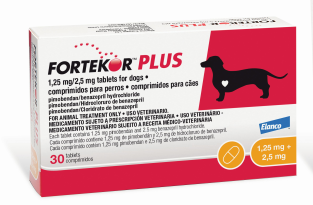 In a
July 2017 article, a team of investigators employed by Elanco Animal
Health, which markets Fortekor (benazepril) and Fortekor Plus
(benazepril + pimobendan), conducted a study of 67 dogs (including 9
cavalier King Charles spaniels) at a clinic in Japan. All of the dogs
were in congestive heart failure (Stage C) due to mitral valve disease
(MVD). The dogs were divided into three groups. The test group received
the Fortekor Plus, while two control groups received separate doses of
benazepril and pimobendan. The researchers found no significant
differences between groups. They reported that the frequency of vomiting
(emesis) was significantly lower in the Fortekor Plus group. They
concluded that:
In a
July 2017 article, a team of investigators employed by Elanco Animal
Health, which markets Fortekor (benazepril) and Fortekor Plus
(benazepril + pimobendan), conducted a study of 67 dogs (including 9
cavalier King Charles spaniels) at a clinic in Japan. All of the dogs
were in congestive heart failure (Stage C) due to mitral valve disease
(MVD). The dogs were divided into three groups. The test group received
the Fortekor Plus, while two control groups received separate doses of
benazepril and pimobendan. The researchers found no significant
differences between groups. They reported that the frequency of vomiting
(emesis) was significantly lower in the Fortekor Plus group. They
concluded that:
"Fortekor Plus had non-inferior efficacy and was associated with significantly less emesis compared to administration of Fortekor and Vetmedin in dogs with CHF caused by MMVD."
EDITOR'S NOTE: In this July 2015 entry, we reported that Fortekor Plus was approved in Europe for use on MVD-affected dogs in congestive heart failure. See also this January 2018 version of the same study as this July 2017 one.
July 2017:
Dr. Sonya Gordon recommends pimobendan for Stage B dogs even
without echocardiograms.
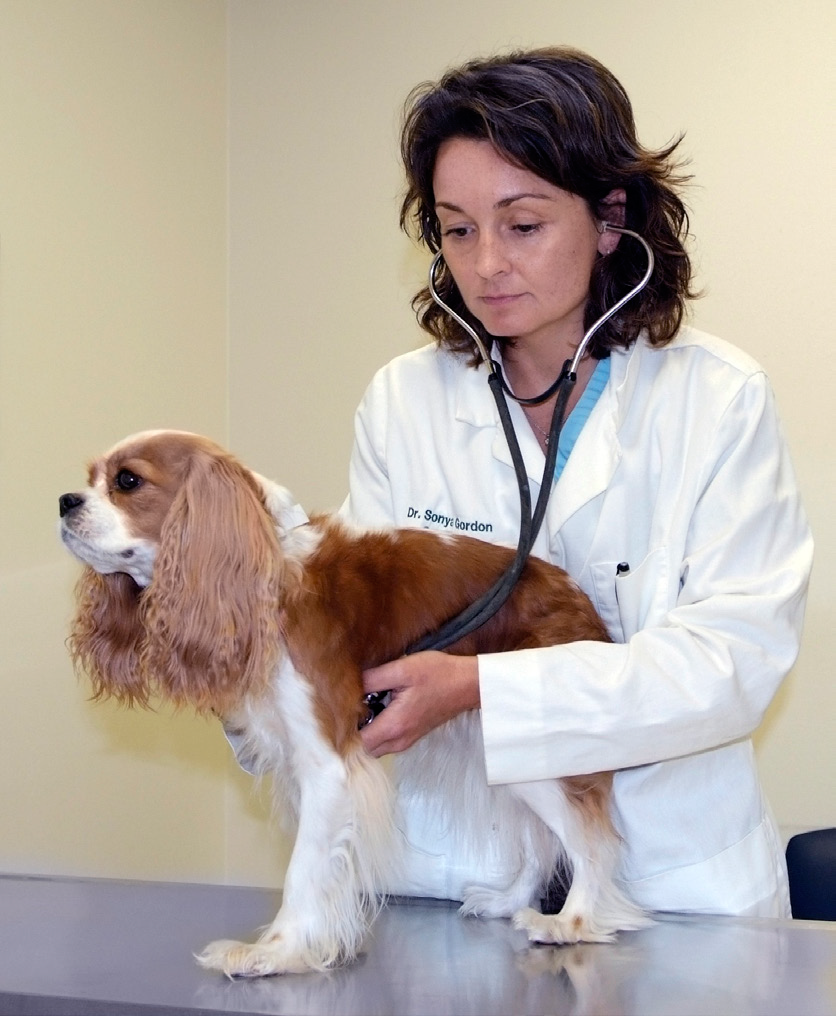 In a
June 2017 article, EPIC Study report lead investigator Dr. Sonya G.
Gordon (right), along with Drs. Ashley B. Saunders and Sonya R.
Wesselowski, makes a variety of recommendations for treatment of
MVD-affected dogs, some of which have not appeared in print elsewhere as yet.
In a
June 2017 article, EPIC Study report lead investigator Dr. Sonya G.
Gordon (right), along with Drs. Ashley B. Saunders and Sonya R.
Wesselowski, makes a variety of recommendations for treatment of
MVD-affected dogs, some of which have not appeared in print elsewhere as yet.
Specifically regarding dogs in ACVIM Stage B2 of mitral valve disease (MVD), they provide parameters for prescribing pimobendan even when no echocardiograms have been performed to determine if the dogs' hearts are enlarged. (The EPIC Study report did not recommend starting pimobendan unless two minimum echo measurements were present, in addition to a Vertebral Heart Score [VHS] greater than [>] 10.5.) They state:
"The EPIC inclusion criteria required both radiographic and echocardiographic evidence of cardiomegaly. The requirement for an echocardiogram may in some cases exclude the recommendation for initiation of pimobendan. However, given the potential low accuracy of depending solely on a radiographic VHS greater than 10.5, ... and that there are known breed-related differences in normal VHS reference ranges with much higher normal VHS ranges reported in some breeds, including the CKCS, it is prudent to use a higher VHS size if recommendations for treatment are based solely on history, physical examination, and thoracic radiographs. Selection of a VHS for this indication is warranted based on the results of previous studies that have demonstrated that dogs with asymptomatic DVD and a VHS of 11.5 to 12.50 have a significant increase in risk of developing left-sided CHF in the near (6-12 months) future. In addition, the median VHS of dogs in the EPIC study was approximately 11.5 ... . An additional factor to consider is rate of progression of heart enlargement. Relatively large increases in heart size, even if the VHS is <11.5, are known to be associated with an increased risk of CHF in dogs with DVD [degenerative valve disease]. Therefore, another criterion to consider is an increase in VHS from one recheck to the next. The Cardiac Education Group (CEG) recommends that, in the absence of an echocardiogram, asymptomatic dogs with an MR murmur (>3/6) and a VHS >11.5 or an increase in VHS of >0.5 or more in 6 months can be used to recommend pimobendan treatment. Use of a VHS of >11.5 will improve the specificity (positive predictive value) of significant heart enlargement and guard against overtreatment of possible stage B1 dogs." (Emphasis added.)
The authors are not keen on starting an ACE-inhibitor along with the pimobendan for Stage B2 dogs. They state:
"The CEG also addressed the use of concurrent ACE inhibitors in this population in light of the EPIC study results. Their recommendation is to continue ACE inhibitors in dogs already receiving them when the indication for pimobendan is met, but that initiation of an ACE inhibitor in stage B2 DVD should be reserved until the onset of clinical signs or symptoms [meaning, once heart failure is detected and the dog reaches Stage C]. Additionally, the addition of an ACE inhibitor also can be considered if or when reevaluation demonstrates an increase in VHS of 0.5 or more in 6 months in dogs with stage B2 DVD already receiving pimobendan."
The article does not reference the SVEP study of 229 cavaliers, which found that ACE-inhibitors do not delay the onset of heart failure in CKCSs in Stage B of MVD.
 EDITOR'S NOTE:
Well, this is interesting. The EPIC Study specifically recommends
not using only x-rays
to determine enlargement of the heart. It states:
EDITOR'S NOTE:
Well, this is interesting. The EPIC Study specifically recommends
not using only x-rays
to determine enlargement of the heart. It states:
"The conclusions of this study are only relevant to dogs with cardiac enlargement secondary to preclinical MMVD (stage B2) as all dogs entering the study met or exceeded 3 different heart size criteria (LA/Ao > 1.6, LVIDDN > 1.7, and VHS > 10.5) ... ." (Note that LA/Ao and LVIDDN parameters can only measured by echocardiogram.)
Why would Dr. Sonya Gordon, one of the three lead investigators/authors of the EPIC Study report, want to encourage veterinarians to cut corners and not perform echocardiograph examinations in order to determine if an MVD-affected dog's heart is enlarged? We can think of two possible reasons:
● One is that primary care, general practice (GP) veterinarians, either not having ultrasound devices or not being sufficiently trained to use them for echocardiography, might have complained that the EPIC Study's requirement of having echocardiograms was discriminatory against them and in favor of the cardiologists. Since GP vets have been prescribing pimobendan to dogs in heart failure (Stage C) for the past ten years without even having an ultrasound device in their clinics, it should come as no surprise that they would be inclined to ignore the EPIC Study report's admonition that minimum echocardiograph measurements are necessary, and issue scripts for this very expensive drug (and sell it from their own inventories) for Stage B2 dogs, based only upon x-rays.
● The other is that Boehringer Ingelheim, the manufacturer of Vetmedin, which fully funded the EPIC Study, might have complained that by requiring that echo exams be conducted before pimobendan can be prescribed prior to heart failure, fewer, rather than more, prescriptions for Vetmedin will be issued, resulting in less profit to that benevolent sponsor. Two of the authors admit a conflict of interest. They state in the article:
"Disclosure Statement: Drs S.G. Gordon and A.B. Saunders have received funding from Boehringer Ingelheim Animal Health GmbH within the past 5 years for some or all of the following activities: research, travel, speaking fees, consultancy fees, and preparation of educational materials. Drs S.G. Gordon and A.B. Saunders are authors of the EPIC Study; Dr S.G. Gordon is a member of the Cardiac Education Group."You see, Boehringer Ingelheim's tenacles are insidious. Frankly, this entire article reeks of an excuse to tout prescribing Vetmedin to many dogs which very likely will never need it.
Whatever the reason (they both focus on making more money for somebody), such corner-cutting certainly is of no net benefit to the MVD-affected dogs, particularly cavalier King Charles spaniels. Instead of warning veterinarians to not prescribe pimobendan to Stage B2 dogs without first performing any echocardiograms, Dr. Gordon is ditching the mandatory echo parameters altogether and is recommending a new, dumbed-down, all-breed x-ray-only parameter for them to follow.
Dr. Gordon points out some interesting information about the EPIC Study patients, such as that "the median VHS of dogs in the EPIC study was approximately 11.5". Of course, that would include all 360 dogs of several breeds. From that figure, she sets a minimum species-wide VHS parameter of >11.5 for starting pimobendan if no echos are performed. She also gives her okay to starting the drug if the size of the heart increases by a VHS value of >0.5 within a six month period.
So, based upon Dr. Gordon's advice, any GP veterinarian with only an x-ray machine will be able to calculate VHS values and, once the minimum value of 11.5 is met in any dog of any breed, then go ahead and prescribe the pimobendan. But since there is no research* to back up this deletion of echos as part of the diagnostic process, any veterinarian who chooses to follow her advice and opt out of using echocardiography is essentially "flying blind" in determining if the dog's heart really is enlarged.
* In a December 2016 publication, the Cardiac Education Group (CEG), of which Dr. Gordon is a member, first proposed this x-ray-only parameter for prescribing pimobendan to Stage B2 dogs. In that publication, the CEG openly admitted that "The EPIC trial did not investigate a cutoff for cardiac enlargement by VHS alone at which to start pimobendan therapy." (Emphasis added.) And, the CEG also admitted therein that its x-ray-only parameters are "not based on evidence." (Emphasis added.) See our December 2016 comments about this item. The CEG publication states that it, too, is sponsored by the manufacturer of Vetmedin, so commonality of conflict-of-interest reigns here. Plus, the current article has a strong whiff of a citation-stacking effort.
Clearly, Dr. Gordon's co-lead investigator in the EPIC Study, Dr. Adrian Boswood, does not agree with her skewed interpretation of the EPIC Study findings. In his May 2017 article on how the EPIC Study trial was designed, he wrote:
"... [I]n order to ensure that the patients recruited to the EPIC study definitely had primary mitral valve disease and enlargement of their heart they underwent both echocardiography and radiography before study entry. If I am now asked by a practitioner - 'should I treat this dog, which I believe has preclinical mitral valve disease, with pimobendan?' - my response will typically be 'to be certain that therapy is indicated the dog will need to undergo echocardiography and ideally also radiography.'" (Emphasis added.)
So, while Dr. Gordon is willing to forego measuring the two echo exam parameters, Dr. Boswood grudgingly would do the opposite - that is, skip the x-ray measurement, but that would not be "ideal".
What Dr. Gordon ignores is that, for some breeds,
especially the cavalier, a VHS value of 11.5 may mean
 that the heart is
not
enlarged at all. While she describes using the species-wide
11.5 VHS value for prescribing pimobendan as "prudent" and to "guard
against overtreatment of possible stage B1 dogs", we disagree. We
regard it as arbitrary, risky, and unsupported by any
research. In fact, the published research contradicts her
selection. In at least
one study, a VHS value of 11.7 was found normal for one of the
CKCSs. So, why does she insist upon using a "one size fits all" set of
parameters, which means that the cavalier is put at greater risk?
At the very least, she should pay attention to the advice given in
the article
she cites in her footnote 15, which expressly states:
that the heart is
not
enlarged at all. While she describes using the species-wide
11.5 VHS value for prescribing pimobendan as "prudent" and to "guard
against overtreatment of possible stage B1 dogs", we disagree. We
regard it as arbitrary, risky, and unsupported by any
research. In fact, the published research contradicts her
selection. In at least
one study, a VHS value of 11.7 was found normal for one of the
CKCSs. So, why does she insist upon using a "one size fits all" set of
parameters, which means that the cavalier is put at greater risk?
At the very least, she should pay attention to the advice given in
the article
she cites in her footnote 15, which expressly states:
"The use of breed-specific VHS values is needed for the VHS method to have a high specificity for normal heart size." (Emphasis added.)
We would prefer using a patient-specific VHS value, rather than just breed-specific, but either one is better than a reckless, species-wide "median" VHS value. In this era of more "individualized medicine", there is no justification whatsoever for creating a species-wide parameter, especially when it flatly (and admittedly) contradicts the only peer-reviewed research on the topic. She and her cohorts violate the ethical tenet of veterinary medicine to treat the disease and not the arbitrary measurement.
What is even more disturbing is that Dr. Gordon does not acknowledge the dirty little secret about GP vets: many of them cannot determine whether a dog's heart is enlarged or not, simply by looking at one set of x-rays.*As a result, they often tend to find enlargement when there really is none at all. When that leads to prematurely prescribing pimobendan, severe heart damage can occur, based upon prior peer-reviewed studies. To remedy this hazard, all she had to do was also recommend that the GP vets make baseline x-rays of their MVD patients before any enlargement takes place, so that the GP vet will be able to compare the normal size of the patient's heart in the baseline x-ray to the later x-ray which may (or may not) show enlargement. This is what we mean by using a patient-specific VHS value.
* Even experienced board certified cardiologists will argue over whether a single set of x-rays (they call them "chest rads") shows left atrium enlargement or not, and if so, its degree. This usually is due to poor positioning of the dog during the x-rays, which is not uncommon. See e.g., Why Is Cardiac Radiology So Difficult? Christopher R. Lamb. WSAVA Congress 2004. ("In a recent study two experienced observers examined the radiographs of 57 dogs with common congenital cardiac anomalies without access to any clinical information in order to avoid biasing their interpretations. Under these conditions, the observers reached the correct diagnosis in less than 40% cases. This poor result reflects the difficulty observers had identifying shape changes that can occur in radiographs of dogs with enlarged cardiac chambers. Radiographic signs of specific cardiac chamber enlargement (or pulmonary vascular abnormalities) were recognised by both observers in only 20% instances in which they might be expected.") (Emphasis added.)
Why Dr. Gordon ignored this advice is perplexing. Surely she is aware that the 2009 ACVIM Consensus Statement, of which she was one of the authors, specifically emphasized the importance of obtaining baseline x-rays. Here is what they (she) wrote back in 2009:
"Diagnosis for Stage B: Consensus recommendations: Thoracic radiography is recommended in all patients to assess the hemodynamic significance of the murmur and also to obtain baseline thoracic radiographs at a time when the patient is asymptomatic for CVHD [chronic valvular heart disease]." (Emphasis added.)
 Now, Dr. Gordon and her cohorts may reply by saying that, in
many instances, no baseline x-rays have been taken, and it is too late
now. Apart from the fact that they never mention the baseline option at
all, our response to that situation is for the authors to recommend not
relying solely upon a current x-ray, and to require that the dog
undergo an echocardiographic examination. To advise vets to
waive echo exams for cavaliers, when there is no baseline x-ray for confirming if
any enlargement has occurred, is, frankly, encouraging malpractice.
Now, Dr. Gordon and her cohorts may reply by saying that, in
many instances, no baseline x-rays have been taken, and it is too late
now. Apart from the fact that they never mention the baseline option at
all, our response to that situation is for the authors to recommend not
relying solely upon a current x-ray, and to require that the dog
undergo an echocardiographic examination. To advise vets to
waive echo exams for cavaliers, when there is no baseline x-ray for confirming if
any enlargement has occurred, is, frankly, encouraging malpractice.
Even with baseline x-rays for comparison purposes, relying upon the x-rays alone and their VHS values only tell the clinician that the heart as a whole is enlarged, and not whether the left atrium (LA) and/or the left ventricle (LV) are enlarged. Maybe a board certified cardiologist can tell from x-rays (rads) alone that the LA or LV is enlarged, but as we noted above, even they will disagree from time to time, and especially if the positioning of the dog (even flexing the neck can cause misleading shadowing) and quality of the films are less than perfect, or the dog was inhaling in one view and exhaling in another or sedated in one and not in the other. This list could go on and on.
The EPIC trial report emphasizes the importance that both the left atrium and left ventricle be enlarged by specified minimum dimensions, which is important information that the echocardiogram can provide and even an expertly produced x-ray can not.
Clearly, one of the other two lead investigators/authors of the EPIC Study report flatly disagrees with Dr. Gordon's short-cut diagnostic trick. Dr. Adrian Boswood, in a Q&A article published in The Veterinary Record in February 2017 was asked how primary care vets can reliably identify MVD-affected dogs which would benefit from pimobendan treatment at Stage B2. He answered:
"At the moment we can only be confident that a dog will benefit from therapy if it undergoes diagnostic imaging; ideally echocardiography. It is probably unrealistic to expect that every dog in primary care practice with a moderately loud heart murmur will undergo echocardiography - so is there another way we can find these dogs? The answer to that question is currently - we don't know.
"What I would like to develop is a simple tool or algorithm that may combine factors from a dog's history, clinical examination and perhaps biomarker concentrations to generate a patient risk score. It is possible that such a score could be used to either select those patients in which diagnostic imaging is strongly recommended or, even better, a high score could be used as a basis on which to initiate therapy. We are a long way from having such a validated clinical scoring system, but 10 years ago we were a long way from knowing that pimobendan was effective in the treatment of dogs with preclinical mitral valve disease - and now we do! Difficult questions sometimes take a long time to answer." (Emphasis added.)
At least Dr. Boswood recognizes that the condition of the individual dog needs to be taken into account, instead of using an arbitrary, species-wide x-ray measurement which has been proven in previous peer-reviewed studies to erroneously indicate actual heart enlargement in several breeds of dogs, including the CKCS.
This is but one more example of why we repeatedly warn cavalier
owners two essential things: (1) they should  NEVER
allow any veterinarian to prescribe their dogs any MVD medications except
for a board certified cardiologist (if at all possible) who follows
peer-reviewed research; and (2)
they need to be their dogs' advocates, because
they cannot always count on veterinarians (even some cardiologists) to put the dogs' best
interests first. It never hurts to ask the veterinarians treating your
dog:
NEVER
allow any veterinarian to prescribe their dogs any MVD medications except
for a board certified cardiologist (if at all possible) who follows
peer-reviewed research; and (2)
they need to be their dogs' advocates, because
they cannot always count on veterinarians (even some cardiologists) to put the dogs' best
interests first. It never hurts to ask the veterinarians treating your
dog:
"What, exactly, is
the clinical evidence supporting the drugs you want me to buy and
give to my dog?"
June 2017:
ReGena-Vet
Laboratories plans stem cell experiments on MVD-affected dogs.
 Dr.
Philip Richard Vulliet (left), veterinary medical director at ReGena-Vet
Laboratories and professor at UC Davis, is investigating the potential
of injecting adult bone marrow stem cells in MVD-affected dogs with the
goal of slowing the progression of MVD. The lab currently is
experimenting with Doberman Pinschers affected with dilated
cardiomyopathy. His contact information is: ReGena-Vet Laboratories,
LLC, 2079 Anderson Rd., Suite B, Davis, CA, 95616, Tel: 530-902-9006,
Fax: 530-756-0459, email info@regenavetlabs.com or
regenavetlabs@gmail.com, website regenavet.com
Dr.
Philip Richard Vulliet (left), veterinary medical director at ReGena-Vet
Laboratories and professor at UC Davis, is investigating the potential
of injecting adult bone marrow stem cells in MVD-affected dogs with the
goal of slowing the progression of MVD. The lab currently is
experimenting with Doberman Pinschers affected with dilated
cardiomyopathy. His contact information is: ReGena-Vet Laboratories,
LLC, 2079 Anderson Rd., Suite B, Davis, CA, 95616, Tel: 530-902-9006,
Fax: 530-756-0459, email info@regenavetlabs.com or
regenavetlabs@gmail.com, website regenavet.com
June 2017:
ACE-inhibitor ramipril fails to extend survival times of
MVD-affected dogs when combined with pimobendan and diuretic.
 In a June
2017 poster presented by German veterinary cardiologist Gerhard Wess
(right) to
the 2017 ACVIM forum, he reported on the results of a study (the
VALVE Study) of 156 MVD-affected dogs in congestive heart failure (CHF).
The dogs were divided into two groups: 77 being treated only with
pimobendan and furosemide ("dual therapy"), and 79 also treated with the
ACE-inhibitor ramipril (Vasotop) ("triple therapy").
In a June
2017 poster presented by German veterinary cardiologist Gerhard Wess
(right) to
the 2017 ACVIM forum, he reported on the results of a study (the
VALVE Study) of 156 MVD-affected dogs in congestive heart failure (CHF).
The dogs were divided into two groups: 77 being treated only with
pimobendan and furosemide ("dual therapy"), and 79 also treated with the
ACE-inhibitor ramipril (Vasotop) ("triple therapy").
Dr. Wess noted:
"The ACVIM guidelines [the ACVIM's 2009 Consensus Statement] currently recommend the use of triple therapy including Pimobendan, ACEi and furosemide for the treatment of dogs in congestive heart failure, as there might be an additional beneficial effect of adding ACEI to Pimobendan. However, there is currently no solid proof besides expert opinion that the triple therapy is superior compared to Pimobendan plus furosimide alone. ... The ACVIM guideline is a data item that belongs to the experts' consensus (Level C scientific evidence*). It has not been scientifically proven that ACEi has a substantially better clinical improvement in combination with pimobendan / furosemide. Recalling that pimobendan was not included in clinical trials of ACEi in the past, the VALVE study is a study where the results of triple therapy applying pimobendan, furosemide, and ACEi can be prepared."
* Actually, "expert opinion" is graded as Level D, defined as "Very Low Quality of Evidence". See, "Grading of Recommendations Assessment, Development and Evaluation (GRADE)", below.
The results were troubling: The non-ramipril, dual therapy dogs survived a median time of 223 days, and the ramipril, triple therapy dogs survived only 179 days, a 40% difference between the groups. (See also this September 2020 article.)
EDITOR'S NOTE: This result, of course, must have been disappointing to the VALVE Study's chief sponsor, the producer of Vasotop (ramipril). It is one thing for a study to show that the drug had no benefit, but it is much more of an unwelcome surprise to find that the drug was a hindrance and actually reduced the survival times for the dogs.
Ramipril has not had a good scientific track record in treating MVD-affected dogs. In a 2013 study by Thai graduate students, of twenty dogs (none CKCS) in Stage B2, they found that ramipril had no beneficial effect upon cardiac chamber size, mitral regurgitation severity and systolic function assessed by echocardiography in 91-day period of treatment.
In a January 2007 article, UK cardiologists compared the affect of pimobendan versus ramipril on the vertebral heart score of 42 MVD-dogs in congestive heart failure, including 24 cavaliers. They found that for the first few months of the 21 dogs treated with pimobendan, their VHS heart size decreased, meaning a reduction in the heart enlargement, while during the same period, the 21 dogs treated with ramipril experienced a continued increase in their VHS heart size.
However, until fairly recently, there appeared to be another reason for adding ACE-inhibitors to the treatment cocktail -- to offset the damage that diuretics do by encouraging activation of the kidneys' renin-angiotensin aldosterone system (RAAS), a cause of renal dysfunction. When the RAAS is activated, it causes the kidneys to over-work by retaining more water and sodium and excreting more potassium. As a result of this process, the overall volume of blood increases, meaning that more blood is pumped through narrowed arteries, which also increases the blood pressure.
Other studies have suggested that diuretics such as furosemide should be used only combined with ACE-inhibitors -- which also prevent fluid retention -- so that the diuretic dosage may be sharply reduced to avoid the worst of its negative side effects, such as activation of the renin-angiotensin aldosterone system (RAAS), a cause of renal dysfunction.
In a 2009 study report which did not include CKCSs, veterinary cardiologists observed a three-fold increase in RAAS activity using furosemide. Their conclusion was that "furosemide is not recommended for chronic use in the absence of concurrent therapy to blunt RAAS activity, such as ACE-I, aldosterone receptor blockers, or angiotensin II type I receptor blockers." A subsequent similar study in 2011 concluded:
"These results in clinically normal dogs suggested that furosemide, administered with or without pimobendan, should be accompanied by RAAS-suppressive treatment."However, in a September 2014 study of ten healthy hounds, researchers found that benazepril (another ACE-inhibitor) did not prevent the activation of the RAAS. This is called "aldosterone break-through" (ABT). In a similar study in September 2015, researchers found that enalapril (still another ACE-I) also did not prevent activation the RAAS. In a November 2015 study, researchers found that high doses of benazepril or enalapril were not any more effective than standard doses of those drugs in suppressing the RAAS.
These studies demonstrate that, despite what Dr. Wess describes as "expert opinion" (literally: hunches and anecdotes) -- that ACE-inhibitors play such an important role in treating MVD-affected dogs that the drug should be included in all treatment levels (ACVIM Stages B2, C, and D) -- there is no clinical evidence to support such "expert opinion" but there is a lot of clinical evidence cautioning against using the drug.
The scientific value of "expert opinion" is so insignificant that the Centre for Evidence-Based Medicine, at Oxford University, ranks it at Level 5 (the lowest rank out of five levels); the University of Michigan Practice Guideline gives it a "D" (the lowest grade out of four levels); and as noted in the footnote above the Grading of Recommendations Assessment, Development and Evaluation (GRADE) gives "expert opinion" the quality grade of Level D, defined as "Very Low Quality of Evidence". And keep in mind, that unlike most instances of uncontested "expert opinion", in the case of the value of ACE-inhibitors to MVD-affected dogs, this "expert opinion" is directly contradicted by published, peer-reviewed clinical evidence showing how worthless the ACE-I therapy actually has been.
This whole story demonstrates that, even among board certified veterinary cardiologists, hunches and anecdotes can be converted into counter-factual "expert opinion" that ends up in treatment protocols for our MVD-affected cavaliers. So, it never hurts to ask the veterinarians treating your dog:
"What, exactly, is the clinical evidence supporting the drugs you want me to buy and give to my dog?"
You need to be your dog's advocate!
June 2017: Dr. Borgarelli reports successful replacement of mitral valve chords using the Harpoon TSD-5 device. In a May 2017 article, a team of Virginia-Maryland veterinary college surgeons, led by Dr. Michele Borgarelli (M. Borgarelli, O. Lanz, N. Pavlisko, J.A. Abbott, G. Menciotti, M. Aherne, S.M. Lahmers, K.K. Lahmers, J.S. Gammie), report the successful implantation of synthetic expanded polytetra-fluoroethylene (ePTFE) replacement mitral valve chords in four of six healthy Beagles, using minimally-invasive surgical techniques in beating hearts (without cardio-pulmonary bypass or cardiac arrest). The investigators used a biomedical device called the Harpoon Medical TSD-5. The body cavity was opened to reveal the beating heart. Then a "valved introducer" was inserted into the left ventricle, and the thin metal shaft of the Harpoon TSD-5 was inserted through the introducer, leading to the mitral valve. When the shaft was in proper position, the trigger of the Harpoon TSD-5 (see image below) was pressed, and its needle pierced the mitral valve leaflet, forming a bulky knot of the ePTFE chord through the leaflet. The other end of the chord ultimately is extended and attached to the heart muscle through the intial insertion location. This video shows how the procedure is designed to operate. The study authors concluded:
"This pilot study has demonstrated feasibility of using the Harpoon TSD-5 device to place and anchor ePTFE artificial chords to the MV of small dogs and that endothelialization of the synthetic cord and knots can start within 30 days."
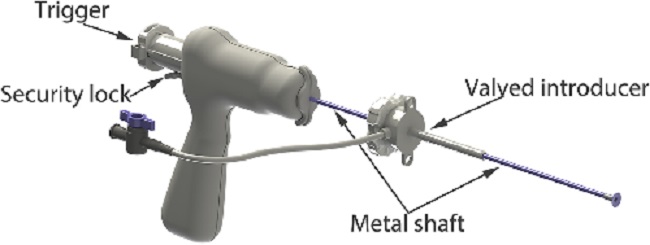
June 2017: EPIC Study authors plan to announce "longitudinal analysis" of the participating dogs' data. At a September 15, 2017 meeting of the ECVIM-CA (European College of Veterinary Internal Medicine - Companion Animals) in Malta, the EPIC Study's three lead invesigators (Jens Haggstrom, Adrian Boswood, Sonya Gordon) are scheduled to report on a "Longitudinal analysis of data from dogs with pre-clinical mitral valve disease receiving pimobendan or placebo: the EPIC study". This is expected to be a review of the long term results of the treatment of the nearly 360 dogs in the EPIC trial after they reached heart failure (Stage C). The focus likely will be on a comparison of the lifespans of the two sets of dogs while in Stages C and D.
EDITOR'S NOTE: Previously, some observant veterinary cardiologists have suggested that the EPIC trial's longitudinal data showed that once dogs in the pimobendan group reached Stage C, they did not survive as long in the heart failure stage as did the dogs from the placebo group. Whether this anomaly was due to toxicity of the pimobendan or to the dogs having developed a tolerance to the drug -- making it less effective as time went on -- remains to be seen. Hopefully, this upcoming longitudinal study will provide these details which were inexplicably excluded from the original EPIC Study publication.
June 2017:
Virginia-Maryland veterinary college creates a database of
MVD-affected dogs.
 Dr. Michele Borgarelli of the Virginia-Maryland
Regional College of
Veterinary Medicine is spearheading a longitudinal outcome database to
serve as a reference library about dogs with mitral valve disease. He
said:
Dr. Michele Borgarelli of the Virginia-Maryland
Regional College of
Veterinary Medicine is spearheading a longitudinal outcome database to
serve as a reference library about dogs with mitral valve disease. He
said:
"Despite being the most common cardiovascular disease in dogs, we don't have much data to better understand the natural history of mitral valve disease or assess what happens to the dogs once a veterinarian makes a diagnosis," he explained. "Through this database, we are collecting a large amount of data from as many patients as possible and then following them for the next five years."
The database will allow researchers to pose questions about which metrics predict outcomes and which interventions affect prognosis. No such database currently exists for mitral valve disease, but according to Dr. Borgarelli, disease registries have proven effective in other veterinary and human diseases. He added, "The preliminary phase of the study started in October, and we are already tracking data on more than 500 dogs in just a few months."
Patients with a new diagnosis at the Veterinary Teaching Hospital in Blacksburg are entered into the database. The cardiology clinicans also are partnering with cardiologists at Chesapeake Veterinary Cardiology Associates, a group of cardiac specialty practices in northern Virginia and Maryland, and the Swedish University of Agricultural Sciences in Uppsala, Sweden, to expand the database. At the 2017 ACVIM Forum in June 2017, Dr. Borgarelli reported that, to date, the database contains clinical information from 2,053 dogs of 104 breeds. He said that follow-up examination data is available for about 30% of the dogs. This study is scheduled to terminate in October 2020.
At a September 14, 2017 meeting of the ECVIM-CA (European College of Veterinary Internal Medicine - Companion Animals) in Malta, Dr. Borgarelli will present another report on findings from this database, titled "The LOOK Mitral study: is there any standard treatment for dogs with mitral valve disease?"
May 2017: Dr. Borgarelli's ongoing mitral valve shape comparison study adds more data. In a May 2017 article, the international team of veterinary cardiologists (G. Menciotti, M. Borgarelli, M. Aherne, P. Camacho, J. Haggstrom, I. Ljungvall, S. M. Lahmers, J. A. Abbott) which have been investigating the shape (morphology) of dogs' mitral valves over the past two years (see our March 2017 and December 2016 and May 2015 news items), reports finding that healthy cavalier King Charles spaniels have smaller mitral leaflets and less "tenting" height (flatter) than do healthy dogs of other breeds. (See Figure 2, below.) They conclude:
"The MV of CKCSs is flatter and has reduced tenting compared to the MV of other breeds. These morphologic features could confer a mechanical disadvantage, and play a role in the predisposition of this breed to the early development of myxomatous mitral valve disease."

May 2017:
Cardiologist
Mark Rishniw says "Not so fast!" in prescribing pimobendan to all
heart-enlarged MVD dogs.
 In an
April 2017 article, USA
board certified veterinary cardiologist Dr. Mark Rishniw (right) takes a very critical look at
the
EPIC Study
report. First he warns that determining whether a dog's heart
actually is enlarged is not so easy using x-rays alone. He writes:
In an
April 2017 article, USA
board certified veterinary cardiologist Dr. Mark Rishniw (right) takes a very critical look at
the
EPIC Study
report. First he warns that determining whether a dog's heart
actually is enlarged is not so easy using x-rays alone. He writes:
"Given that many clinicians struggle to correctly identify cardiomegaly in small-breed dogs from radiographs and tend to over-interpret cardiac enlargement, the investigators stressed that the diagnosis should be made with the benefit of echocardiography. Obviously, many clients will not be able to afford echocardiography, and clinicians will be faced with the decision based on radiographic evidence alone." (Emphasis added.)
He questions the basis for the EPIC Study authors' optimism about starting all heart-enlarged MVD-affected dogs on pimobendan, regardless of the extent and/or rapidity of the enlargement. From the EPIC Study authors' viewpoint, he writes:
"Essentially, the risk of developing CHF or dying was almost halved, regardless of how bad the dog's disease was going into the study. On the face of it, this sounds great. Based on this information alone, every dog with MMVD and left atrial enlargement (correctly identified!) would benefit from pimobendan treatment. Not so fast! The decision to treat a dog requires additional information to be considered. First, the baseline risk of developing CHF needs to be determined, i.e., what is the chance that this dog will actually develop CHF at some point in the future?" (Emphasis added.)
He then takes into account the statistics from the study and asks this ultimate question:
"Is 'earlier' treatment better than 'later' treatment? The survival curves provide clues to this answer. ... Now, if there was a clear benefit of 'earlier' rather than 'later,' we might expect the survival curves to diverge, ie., continue to move further and further apart. But they don't. For the majority of the study, they remain parallel. So, the benefit with more severely affected dogs is about 300 days, and the benefit with the least severely affected dogs is about 300 days. This suggests that taking the more measured approach of waiting until a dog exhibits evidence of disease progression before instituting therapy is not compromising that dog nor reducing the benefit of the drug. And, dogs that were never going to progress to more severe disease and never develop CHF would not be subjected to needless drug administration (and needless expenses)." (Emphasis added.)
 EDITOR'S NOTE:
Dr. Rishniw's objective approach to the EPIC Study report is in stark
contrast to the broadbrush of Dr. Philip Fox,
below here. First, Dr. Rishniw points out that determining whether a
small dog's heart is enlarged from an x-ray is not so easy, and that
"many clinicians ... tend to over-interpret cardiac enlargement". This
alone is a scary factoid, considering that the EPIC Study's minimum
x-ray parameter for determining enlargement in all dogs, regardless of
breed, is a VHS value of 10.5+, a measurement so low that most all
cavaliers with no MVD whatsoever would be candidates for treatment with
pimobendan, if only x-rays were relied upon.
EDITOR'S NOTE:
Dr. Rishniw's objective approach to the EPIC Study report is in stark
contrast to the broadbrush of Dr. Philip Fox,
below here. First, Dr. Rishniw points out that determining whether a
small dog's heart is enlarged from an x-ray is not so easy, and that
"many clinicians ... tend to over-interpret cardiac enlargement". This
alone is a scary factoid, considering that the EPIC Study's minimum
x-ray parameter for determining enlargement in all dogs, regardless of
breed, is a VHS value of 10.5+, a measurement so low that most all
cavaliers with no MVD whatsoever would be candidates for treatment with
pimobendan, if only x-rays were relied upon.
He acknowledges that dog owners may "not be able to afford echocardiography, and clinicians will be faced with the decision based on radiographic evidence alone." (This is consistent with our own concerns, expressed in our March 2017 blog article, "Will general practice vets cut corners to prematurely prescribe pimobendan to MVD-affected cavaliers?") A simple answer to that circumstance would be: If for whatever reason you don't perform the echocardiogram, then don't prescribe the drug.
Then Dr. Rishniw analyzes the EPIC Study's own statistics to observe the falsehood of the EPIC Study authors' simplistic notion that any and all MVD-affected dogs with enlarged hearts, regardless of the degree or rapidity of enlargement, would benefit from pimobendan. As Dr. Rishniw says, "Not so fast!" and that "a more measured approach", looking into the details of each dog's MVD progression, is called for before determining if and when pimobendan may be warrranted.
Finally, Dr. Rishniw focuses on the economics of starting pimobendan too early. He writes that dogs which would likely never progress to congestive heart failure (CHF) ought "not be subjected to needless drug administration (and needless expenses)." He raises the heretofore unspeakable suggestion that the EPIC Study's unwarranted conclusion (that all MVD-affected dogs with any heart enlargement need pimobendan before CHF) would be a tremendously unnecessary expense (which may be explained by the drug manufacturer's 100% financial underwriting of the EPIC Study -- including hotels, meals, and travel for participating cardiologists -- and its hoped for additional sales of its very expensive drug).
By mentioning that starting pimobendan too early may result in "reducing the benefit of the drug", Dr. Rishniw may be suggesting another possible downside of starting pimobendan before it is truly needed -- that the patients may develop a tolerance to the pimobendan, thereby decreasing its effectiveness. Drug tolerance is a pharmacological concept describing the patient's reduced affinity to a drug after sustained exposure to that drug. This means that starting the drug earlier than necessary can result in having to increase the dosage later on to achieve the same beneficial effect. Even worse, at some point the drug may become totally ineffective.
In a January 2017
article, veterinary cardiologist Mikaela Mueller (right) impliedly concurs
with Dr. Rishniw's
 viewpoints on the EPIC Study. She wrote:
viewpoints on the EPIC Study. She wrote:
"One of the major concerns with the EPIC study is that many dogs with only mild enlargement never experience clinical signs of congestive heart failure in the first place, so treating them long-term with pimobendan does not change their clinical outcome. Luckily, it appears to be a very safe medication for the majority of patients, but it is not a cheap medication to give for years when it does not change the outcome. Since we do not have a good way of predicting which dogs with mild disease will progress to clinical signs, it becomes difficult to decide whether or not to recommend pimobendan for some patients. This is where the art of clinical practice comes into play. Each patient is an individual who deserves personalized thought and attention. If a patient has mild cardiomegaly and is already 16 years old, it is far less likely that the patient will progress to congestive heart failure during his or her lifetime than a different patient with similar disease who is only 5 years old."
 Like the white-coated sanitation guys cleaning up behind the elephant
parade, Drs. Rishniw and Mueller are critically analyzing the EPIC Study's own
statistics, which the study's authors neglected to do themselves. The
bottom line is that no cavalier owner should jump at the prospect of
giving pimobendan to their dogs unless and until a very careful,
thorough study -- "a more measured approach" -- is conducted for each
patient, to determine the likelihood that the drug
will do any good at the current stage of the dog's MVD.
Like the white-coated sanitation guys cleaning up behind the elephant
parade, Drs. Rishniw and Mueller are critically analyzing the EPIC Study's own
statistics, which the study's authors neglected to do themselves. The
bottom line is that no cavalier owner should jump at the prospect of
giving pimobendan to their dogs unless and until a very careful,
thorough study -- "a more measured approach" -- is conducted for each
patient, to determine the likelihood that the drug
will do any good at the current stage of the dog's MVD.
It is very unfortunate that these observations, drawn directly from the EPIC Study's own data, were not discussed by the EPIC Study authors themselves. The EPIC Study report needs to be retracted and re-written, so that no clinicians are misled by its lack of critical analysis of its own statistics. The authors had 18 months following the end of the study (March 2015 to September 2016) in which to draft a thorough, objective review in accordance with the veterinary motto: Do no harm. But, unfortunately, they instead published a conclusion that could have been written by the drug manufacturer's press agent.
(See our Blog article, The EPIC study's bluster about pimobendan unravels as critical analysis finally takes hold, for a more detailed commentary on this issue.)
May 2017: Cardiologist Kristin Jacob narrowly interprets the EPIC Study results. In a May 2017 article, Maryland board certified veterinary cardiologist Kristin A. Jacob gives a narrow interpretation of the EPIC Study report, confining pimobendan treatment to MVD-affected dogs with "advanced" or "significant" Stage B2 heart enlargement, as distinguished from "mildly enlarged". She also requires that the diagnosis be made "based on chest radiographs + echocardiogram with cardiologist".
May 2017:
Cardiologist Philip Fox claims EPIC Study makes
echocardiography optional in prescribing pimobendan before heart
failure.
 In a
Fall 2016 newsletter column, USA veterinary cardiologist
Dr. Philip Fox (right) asserts that in determining when to start administering
pimobendan to MVD-affected dogs under the EPIC Study, either
x-rays or
echocardiography may be used. Specifically, he writes:
In a
Fall 2016 newsletter column, USA veterinary cardiologist
Dr. Philip Fox (right) asserts that in determining when to start administering
pimobendan to MVD-affected dogs under the EPIC Study, either
x-rays or
echocardiography may be used. Specifically, he writes:
"In light of these findings, clinicians should change how they diagnose and manage MVD. Dogs with heart murmurs should be screened early, rather than wait for clinical signs of coughing or respiratory distress to develop. Assessment can be effectively made using history and physical examination along with the added benefit of chest radiography and/or echocardiography." (Emphasis added.)
EDITOR'S NOTE: There you have it. Our greatest fear about the terribly flawed EPIC Study report is that it would encourage veterinarians to skip echos entirely and diagnose heart enlargement solely based upon x-rays. (See our March 2017 blog article, "Will general practice vets cut corners to prematurely prescribe pimobendan to MVD-affected cavaliers?", for more details.)
 Why
the fear? What is wrong with using only the dog's x-ray to determine if
its heart is enlarged to prescribe pimobendan, you may ask? Well, in the EPIC Study, x-rays are
used to calculate the dog's
Vertebral Heart Score (VHS). The EPIC Study's species-wide
VHS parameter for deterimining heart enlargement and starting pimobendan
is any VHS value above 10.5. EPIC provides absolutely no breed-specific
parameters, much less any case-by-case recommended parameters. It is VHS
> 10.5 for every dog!
Why
the fear? What is wrong with using only the dog's x-ray to determine if
its heart is enlarged to prescribe pimobendan, you may ask? Well, in the EPIC Study, x-rays are
used to calculate the dog's
Vertebral Heart Score (VHS). The EPIC Study's species-wide
VHS parameter for deterimining heart enlargement and starting pimobendan
is any VHS value above 10.5. EPIC provides absolutely no breed-specific
parameters, much less any case-by-case recommended parameters. It is VHS
> 10.5 for every dog!
With the EPIC Study's x-ray parameter of VHS > 10.5, a whole lot is terribly wrong for our cavalier King Charles spaniels. You see, the average heart-healthy cavalier, with no enlargement whatsoever, has a VHS value significantly above 10.5. It is troubling that the EPIC Study report ignores the fact that normal, heart-healthy cavaliers may have VHS measurements as high as 11.7, which is notably higher than EPIC's 10.5+ criterion for beginning pimobendan treatment. Considering that nearly half of the dogs in the EPIC Study were CKCSs, this oversight is rather inexplicable and potentially life-threatening for our breed.
The only saving grace the EPIC Study lead authors must have had is that, hopefully, no veterinarian would rely solely upon an x-ray before prescribing the drug. Hopefully, all vets would also perform the M-mode echocardiography necessary to arrive at the other two parameters for determining if the dog's heart is sufficiently enlarged. (Which is laughable, of course, because how many general practice vets have M-mode echocardiograph ultrasound devices at their clinics, much less know how to use them?)
So now we even have a board certified veterinary cardiologist (who participated in the EPIC Study, by the way -- his name is on it) irresponsibly suggest that heart enlargement may be diagnosed by x-rays alone before starting pimobendan. And, he wrote this in an advice column directed to general practice veterinarians!
The bottom line is that the thoughtlessly-worded EPIC Study report needs to be retracted and re-written, if cavaliers' lives are to be saved by pimobendan, instead of being destroyed by that drug. If a cardiologist who actually participated in the EPIC Study does not understand how to follow it, how can we expect our general practice vets to do so?
May 2017:
Columbian researchers find a variation of gene COL1A2 may play a
role in causing MVD in canines.
 In a
December 2016 report, a team of Columbian veterinary researchers
(Orlando A. Torres-García [right], Rey-Buitrago, M.,
Acosta-Virgüez, E., Bernal-Rosas, Y., Infante-González, J.,
Gómez-Duarte, L.) investigated variations of the COL1A2 gene (within the
CFA14 region) in 50 MVD-affected and 80 control Poodles. (The CFA14
region was identified in the
September 2011 study of 241 cavalier King Charles spaniels, as being
associated the CKCS's hereditary mitral valve disease.) The Columbian
veterinarians found that "the allele T of the rs22372411 variant was
over-represented in MMVD patients compared with healthy controls." They
concluded:
In a
December 2016 report, a team of Columbian veterinary researchers
(Orlando A. Torres-García [right], Rey-Buitrago, M.,
Acosta-Virgüez, E., Bernal-Rosas, Y., Infante-González, J.,
Gómez-Duarte, L.) investigated variations of the COL1A2 gene (within the
CFA14 region) in 50 MVD-affected and 80 control Poodles. (The CFA14
region was identified in the
September 2011 study of 241 cavalier King Charles spaniels, as being
associated the CKCS's hereditary mitral valve disease.) The Columbian
veterinarians found that "the allele T of the rs22372411 variant was
over-represented in MMVD patients compared with healthy controls." They
concluded:
"Our results show for the first time an association of the rs22372411 COL1A2 gene variant with susceptibility to canine myxomatous mitral valve disease."
May 2017:
Detroit hospital physicians find Neladenoson may reverse hind
leg weakness in dogs in heart failure.
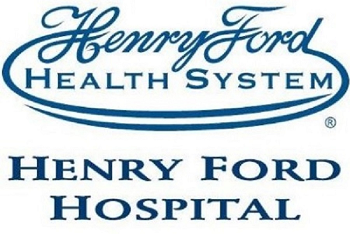 In
a
May 2017 abstract, a team of researchers at Henry Ford Hospital in
Detroit (HN Hani Sabbah, RC Gupta, V Singh-Gupta, K Zhang, J Xu) report
on the success of Neladenoson (a partial adenosine A1-receptor agonist)
in improving the function of mitochondria in the skeletal muscles of
dogs in heart failure.
In
a
May 2017 abstract, a team of researchers at Henry Ford Hospital in
Detroit (HN Hani Sabbah, RC Gupta, V Singh-Gupta, K Zhang, J Xu) report
on the success of Neladenoson (a partial adenosine A1-receptor agonist)
in improving the function of mitochondria in the skeletal muscles of
dogs in heart failure.
Mitochondria are organelles in the muscle cells, which take in nutrients, break them down, and create energy rich molecules for the cell. As heart failure progresses in MVD-affected dogs, the mitochondria reduce in size, resulting in reduced capacity to create energy.
The researchers opine that treating dogs in heart failure with Neladenoson can potentially reduce or reverse exercise intolerance and skeletal muscle weakness. In a November 2016 abstract, the same researchers concluded that Neladenoson has beneficial effects on mitochondria function in dogs in heart failure. They report improvement in mitochondria function after treatment with Neladenoson within one hour after initiation of therapy.
May 2017:
Mayo Clinic researchers engineer a designer natriuretic peptide to mediate
kidney impairment by furosemide.
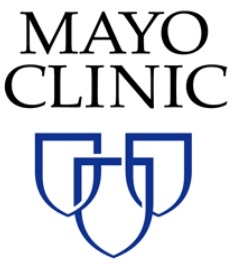 In a
May 2017 abstract, Mayo Clinic researchers (LMG Meems, Y Chen, GJ
Harty, GE Harders, BK Huntley, SR Iyer, DM Heublein, JC Burnett Jr.)
report on the success of their engineered designer natriuretic peptide
"NPA7" as co-therapy with diuretics (specifically here, furosemide) in treating ten dogs in
acute decompensated heart failure (ADHF). They noted that furosemide
(FURO) alone lacks vasodilatory actions, impairs kidney function, and
activates the renin-angiotensin-aldosterone system (RAAS). They found
NPA7 to decrease vascular resistance, reduce pulmonary capillary
pressure, increase renal blood flow, increase urinary flow and sodium
excretion. They conclude:
In a
May 2017 abstract, Mayo Clinic researchers (LMG Meems, Y Chen, GJ
Harty, GE Harders, BK Huntley, SR Iyer, DM Heublein, JC Burnett Jr.)
report on the success of their engineered designer natriuretic peptide
"NPA7" as co-therapy with diuretics (specifically here, furosemide) in treating ten dogs in
acute decompensated heart failure (ADHF). They noted that furosemide
(FURO) alone lacks vasodilatory actions, impairs kidney function, and
activates the renin-angiotensin-aldosterone system (RAAS). They found
NPA7 to decrease vascular resistance, reduce pulmonary capillary
pressure, increase renal blood flow, increase urinary flow and sodium
excretion. They conclude:
"In conclusion, in experimental ADHF, NPA7 is a vasodilatory therapeutic with cardiac unloading, diuretic and natriuretic actions. FURO is more diuretic, but is associated with significant renal impairment, vasoconstriction and RAAS-activation. In addition, pre-treatment with NPA7 enhances natriuresis and diuresis while preserving kidney function. Priming with NPA7 may therefore represent a novel renoprotective strategy for treatment of ADHF. Importantly, this study underscores the need for future studies assessing the impact of timing of diuretics on treatment effects of novel therapies in patients with ADHF."
May 2017:
Synthetic BNP injections potentially can offset RAAS activation
in dogs in CHF. B-type natriuretic peptide (BNP) is a
natriuretic, diuretic, vasodilatory, and anti-remodeling hormone
produced by myocardial cells in response to heart failure due to MVD
(and other causes of heart failure). ("Natriuretic" means: causing the
excretion of an excessively large amount of sodium in the urine.)
 BNP
is activated during heart failure to counteract the effects of
activation of the renin angiotensin aldosterone system (RAAS) in the
heart, kidneys, and blood vessels. However, as the MVD progresses, the
dog's ability to produce active BNP declines, lessening its ability to
counter the effects of RAAS activation.
BNP
is activated during heart failure to counteract the effects of
activation of the renin angiotensin aldosterone system (RAAS) in the
heart, kidneys, and blood vessels. However, as the MVD progresses, the
dog's ability to produce active BNP declines, lessening its ability to
counter the effects of RAAS activation.
In a May 2017 article, US investigators (M.A. Oyama [right], P.F. Solter, C.L. Thorn, J.A. Stern) discuss the feasibility, safety, and tolerance of injecting synthetic canine B-type natriuretic peptide (syncBNP) in four healthy dogs and two dogs with stage B1 mitral valve disease, including a cavalier. They also gathered data regarding the effect of syncBNP on plasma cGMP, kidney function, and RAAS. The found that syncBNP was feasible, well tolerated at all doses, and safe, and that it significantly increased median plasma cGMP. They recommended further studies using syncBNP for treatment of MVD.
EDITOR'S NOTE: We were a bit confused by this article, because two years earlier, two of the same researchers -- Drs. Chloe Thorn and Mark Oyama -- opined in a July 2015 abstract that "targeted reductions in NT-proBNP result in improved outcomes in dogs with CHF secondary to MMVD."
In response to our query, lead investigator Dr. Oyama explained:"BNP is a hormone made by the heart that is actually beneficial to heart function and helps reduce congestion and disease severity.
"The NT-proBNP form of BNP has been previously studied as a marker of heart disease and measure of disease severity. NT-proBNP is an inactive by-product of activation of the parent BNP molecule. The presence of high NT-proBNP in dogs with heart disease and failure indicates that they are attempting to make large amount of BNP (and hence lots of NT-proBNP appears in the circulation) in order to stay out of heart failure, but the increased amount is insufficient to prevent heart failure in the later stages of disease.
"Thus, despite high levels in heart failure, dogs might be considered to still have a BNP 'deficiency'. Giving additional BNP in the active form might help improve signs of congestion. In humans, supplemental short term BNP in the hospital helps improve clinical signs."
April 2017:
Texas A&M cardiologists fine tune cardiac troponin I
measurements of MVD progression.
 In an
April 2017 article, a team of
Texas A&M veterinary school investigators (Randolph L. Winter
[right], Ashley B.
Saunders, Sonya G. Gordon, Matthew W. Miller, Jan S. Suchodolski, Jorg
M. Steiner) applied the concept of biologic variability (BV) testing to
concentrations of cardiac troponin I (cTnI) in periodic blood samples of
10 healthy and 28 MVD-affected dogs (including 14 [50%] cavalier King
Charles spaniels). They noted that the use of a standard sensitivity
cTnI assay was insufficiently sensitive to quantify and study changes in
cTnI concentration in both healthy dogs and MVD-affected dogs in their
study. They argue that long-term serial measurements of cTnI changes
helped predict the MVD end-points of onset of heart failure and death.
They suggest that such periodic testing may provide more information for
predicting survival time than a single measurement.
In an
April 2017 article, a team of
Texas A&M veterinary school investigators (Randolph L. Winter
[right], Ashley B.
Saunders, Sonya G. Gordon, Matthew W. Miller, Jan S. Suchodolski, Jorg
M. Steiner) applied the concept of biologic variability (BV) testing to
concentrations of cardiac troponin I (cTnI) in periodic blood samples of
10 healthy and 28 MVD-affected dogs (including 14 [50%] cavalier King
Charles spaniels). They noted that the use of a standard sensitivity
cTnI assay was insufficiently sensitive to quantify and study changes in
cTnI concentration in both healthy dogs and MVD-affected dogs in their
study. They argue that long-term serial measurements of cTnI changes
helped predict the MVD end-points of onset of heart failure and death.
They suggest that such periodic testing may provide more information for
predicting survival time than a single measurement.
A companion article, published in January 2017 by a sub-set of the same Texas A&M team, used biologic variability to examine N-terminal pro-brain natriuretic peptide (NTproBNP) samples in the same group of dogs. See this link to our review of that article.
EDITOR'S NOTE: This report appears to be a postive step towards making biomarker blood testing of the progression of MVD much more accurate in predicting the onset of heart failure and death. However, what is the point of these cardiac biomarker tests? Is it to predict when heart failure may be imminent? If so, so what? Before the EPIC Study report, heart failure was the bright line for the start of medicating dogs with MVD. But now that the EPIC Study report tells us the bright line no longer is heart failure but now is heart enlargement, we see less need to focus upon the threshold of heart failure at all.
And, of course, "Biologic Variability" is vet-speak for periodic repeat testing. So, how much more is this all going to cost the dog's owner, over and above a one-shot cTnI or NTproBNP test? Try multiplying whatever one test costs by five or ten times.
April 2017:
UK Kennel Club spokesman trashes the MVD Breeding Protocol.
 In
a statement included in a
DogWorld.co.uk article published in April, 2017, UK Kennel Club
secretary Caroline Kisko (right) announced that the Kennel Club
rejects the MVD Breeding Protocol because it requires "breeding from
older bitches." The protocol, which was introduced in the UK in 1996 and
has been endorsed by the UK Cavalier Club, calls for not breeding any
cavalier until they reach the age of 2.5 years. The protocol has been
proven effective in reducing the early onset of mitral valve disease in
offspring. Ms. Kisko in effect ridiculed the protocol by declaring that
2.5 year old CKCS dams are "older bitches".
In
a statement included in a
DogWorld.co.uk article published in April, 2017, UK Kennel Club
secretary Caroline Kisko (right) announced that the Kennel Club
rejects the MVD Breeding Protocol because it requires "breeding from
older bitches." The protocol, which was introduced in the UK in 1996 and
has been endorsed by the UK Cavalier Club, calls for not breeding any
cavalier until they reach the age of 2.5 years. The protocol has been
proven effective in reducing the early onset of mitral valve disease in
offspring. Ms. Kisko in effect ridiculed the protocol by declaring that
2.5 year old CKCS dams are "older bitches".
April 2017: Brazilian researchers find a quality of life questionnaire can accurately predict approaching cardiac deaths of dogs. In a March 2017 article, a team of Brazilian investigators (Celia M. C. Strunz, Mário Marcondes-Santos, Julio Yoshio Takada, Fernanda S. Fragata, Antônio de Pádua Mansur) compared usual mitral valve disease (MVD) measurement devices (e.g., clinical, laboratory, and echocardiographic evaluations) with the results reported by the owners of 36 dogs suffering from MVD, by answering a series of 17 questions in the "Functional Evaluation of Cardiac Health Questionnaire" (see below). The questions are mainly related to respiratory signs, difficulties with mobility (such as walking and climbing stairs), physical activity, irritability, appetite, sleepiness, and frequency of urination and vomiting. They found that NT-proBNP levels and high quality life score were independently associated with impending death. They concluded that the score is easy to apply and does not require any technology, only a veterinarian and an observant owner.
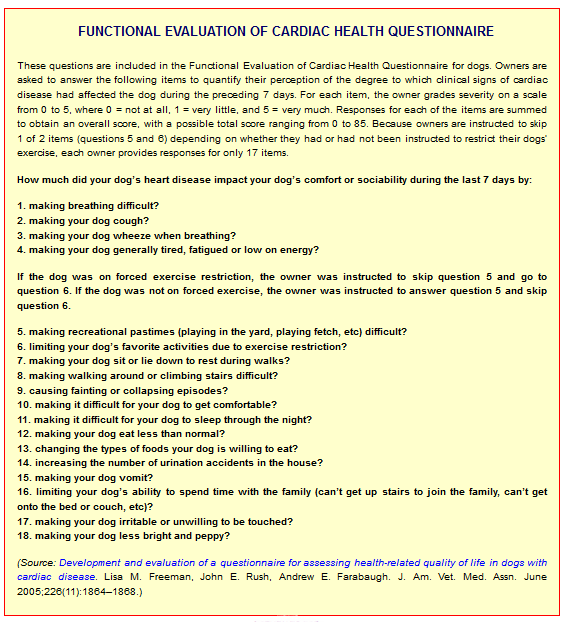
March 2017:
Lung ultrasound exams can accurately diagnose early signs of
pulmonary edema and may predict onset of congestive heart failure.
 In a
March 2017 article, a team of Italian researchers (Tommaso Vezzosi
[right], T.
Mannucci, A. Pistoresi, F. Toma, R. Tognetti, E. Zini, O. Domenech, E.
Auriemma, S. Citi) used lung ultrasound (LUS) to examine the conditions
of dogs in different stages of mitral valve disease (MVD), to
distinguish lung patterns leading to congestive heart failure (CHF).
They report detecting "B-lines" (also called ultrasound lung rockets)
representing interstitial edema. The number and distribution of these
B-lines correspond to the presence of extravascular fluid in the lungs
and indicate the severity of pulmonary edema (PE) and stage of its progression. Dogs in
Stage B1 of MVD had absent or rare B-lines in 14 of 15 cases (93.3%);
dogs in Stage B2 had absent or rare B-lines in 16 of 18 cases (88.9%);
all dogs in Stage C without radiographic signs of PE, had absent or rare
B-lines; dogs in Stage C with radiographic signs of PE, had numerous or
confluent B-lines in 18 of 20 cases (90%). They concluded:
In a
March 2017 article, a team of Italian researchers (Tommaso Vezzosi
[right], T.
Mannucci, A. Pistoresi, F. Toma, R. Tognetti, E. Zini, O. Domenech, E.
Auriemma, S. Citi) used lung ultrasound (LUS) to examine the conditions
of dogs in different stages of mitral valve disease (MVD), to
distinguish lung patterns leading to congestive heart failure (CHF).
They report detecting "B-lines" (also called ultrasound lung rockets)
representing interstitial edema. The number and distribution of these
B-lines correspond to the presence of extravascular fluid in the lungs
and indicate the severity of pulmonary edema (PE) and stage of its progression. Dogs in
Stage B1 of MVD had absent or rare B-lines in 14 of 15 cases (93.3%);
dogs in Stage B2 had absent or rare B-lines in 16 of 18 cases (88.9%);
all dogs in Stage C without radiographic signs of PE, had absent or rare
B-lines; dogs in Stage C with radiographic signs of PE, had numerous or
confluent B-lines in 18 of 20 cases (90%). They concluded:
"Our findings indicate that LUS has good diagnostic accuracy in identifying cardiogenic PE and might be useful in the staging of dogs with CVHD [chronic valvular heart disease]. Lung ultrasound examination is a new, quick, and noninvasive diagnostic tool for the cardiologist, radiologist, or intensive care specialist. It should be considered as complementary to thoracic radiography, and particularly useful when radiographic findings are unclear or in severely dyspneic dogs. In the future, it would be interesting to evaluate the utility of LUS in the chronic management and serial monitoring of dogs with CVHD under treatment."
March 2017:
Slovenian researchers report correlations between NT-proBNP and
CoQ10 concentrations in dogs receiving cardiac treatment.
 In an
April 2017 article, Slovenian investigators (Alenka Nemec Svete,
Barbara Verk, Alenka Seliskar, Katerina Tomsic, Petra Jazbec Krizman,
Aleksandra Domanjko Petric [right]) compared NT-proBNP, antioxidant, and CoQ10
concentrations in dogs with various cardiovascular diseases and the
effect of cardiac treatment on those concentrations. The report finding:
In an
April 2017 article, Slovenian investigators (Alenka Nemec Svete,
Barbara Verk, Alenka Seliskar, Katerina Tomsic, Petra Jazbec Krizman,
Aleksandra Domanjko Petric [right]) compared NT-proBNP, antioxidant, and CoQ10
concentrations in dogs with various cardiovascular diseases and the
effect of cardiac treatment on those concentrations. The report finding:
• Total antioxidant capacity (TAC): Antioxidant variables were not altered in the dogs with cardiac disease, regardless of the stage of cardiac disease or treatment. Plasma TAC values were higher in those receiving treatment than in those not receiving treatment; however, the difference was not significant.
• NT-proBNP: Serum concentration of the cardiac biomarker NT-proBNP increased significantly with the stage of heart failure, although there was no significant difference between affected dogs that were or were not receiving treatment. A significant negative correlation between serum NT-proBNP concentration and plasma CoQ10 concentration was identified in the dogs that were receiving cardiac treatment.
• CoQ10: Lower plasma CoQ10 concentrations were likely associated with greater severity of CHF. Plasma CoQ10 concentration was significantly higher in affected dogs that were receiving treatment, compared with affected dogs that were not receiving treatment. Plasma CoQ10 concentration in dogs that were not receiving cardiac treatment was lower than that in healthy dogs and significantly lower than that in dogs that were receiving cardiac treatment, which may be evidence of CoQ10 deficiency in dogs with cardiac disease in the absence of treatment.
In summary, NT-proBNP increases with the severity of heart failure (CHF), and treatment did not reverse that trend. CoQ10 levels decreased with greater severity of CHF. CoQ10 concentrations were significantly higher in affected dogs receiving treatment, indicating a CoQ10 deficiency in affected dogs without treatment.
March 2017:
Korean researchers find that serum homocysteine concentrations
increase as MVD progresses in dogs.
 In
an
April 2017 article, Korean cardiologists (Chang-Min Lee, Da-Min
Jeong) led a team (Min-Hee Kang, Seung-Gon Kim, Jae-Ik Han, Hee-Myung
Park) in examining serum homocysteine in 63 dogs to determine if there
is any correlation between homocysteine concentrations and the worsening
of mitral valve disease. Homocysteine is an essential amino acid
metabolite of methionine that is recycled into methionine or converted
into cysteine by vitamin B. They found significant correlations between
serum homocysteine concentrations and each stage of MVD (Stages B1, B2,
C, D). They concluded that the measurement of serum homocysteine
concentration may be useful in predicting the severity of MVD in dogs.
In
an
April 2017 article, Korean cardiologists (Chang-Min Lee, Da-Min
Jeong) led a team (Min-Hee Kang, Seung-Gon Kim, Jae-Ik Han, Hee-Myung
Park) in examining serum homocysteine in 63 dogs to determine if there
is any correlation between homocysteine concentrations and the worsening
of mitral valve disease. Homocysteine is an essential amino acid
metabolite of methionine that is recycled into methionine or converted
into cysteine by vitamin B. They found significant correlations between
serum homocysteine concentrations and each stage of MVD (Stages B1, B2,
C, D). They concluded that the measurement of serum homocysteine
concentration may be useful in predicting the severity of MVD in dogs.
March 2017:
Thai researchers find long-term treatment of Stage B dogs with
sildenafil (Viagra) prevented progression of MVD.
 In a
March 2017 report of a 180-day study of 30 MVD-affected dogs (none
were cavalier King Charles spaniels) in Stage B1 or Stage B2
(non-symptomatic), a team of Thailand investigators (Anusak Kijtawornrat
[right], Siripen Komolvanich, Nakkawee Saengklub, Prapawadee
Pirintr, Pakit Boonpala, Chollada Buranakar) treated half of the
group with sildenafil (Viagra, Revatio) (a/k/a sildenifil) versus a control group. Sildenafil is a
selective phosphodiesterase-5 inhibitor that has been demonstrated to
delay ventricular enlargement in humans and experimental animals. They
found:
In a
March 2017 report of a 180-day study of 30 MVD-affected dogs (none
were cavalier King Charles spaniels) in Stage B1 or Stage B2
(non-symptomatic), a team of Thailand investigators (Anusak Kijtawornrat
[right], Siripen Komolvanich, Nakkawee Saengklub, Prapawadee
Pirintr, Pakit Boonpala, Chollada Buranakar) treated half of the
group with sildenafil (Viagra, Revatio) (a/k/a sildenifil) versus a control group. Sildenafil is a
selective phosphodiesterase-5 inhibitor that has been demonstrated to
delay ventricular enlargement in humans and experimental animals. They
found:
• The stroke volume (the volume of blood pumped from the left ventricle per beat) at day 30 was significantly higher in the sildenafil group.
• The LA/Ao (left atrial-to-aortic ratio) and the MR jet area were significantly lower beginning at day 30, day 90, and day 180.
• The 2D-LA (2-dimentional left atrium size) was significantly lower at day 90 when compared with control group.
• The differences of NTproBNP (a natriuretic peptides test biomarker in cardiac disease) from baseline were significantly lower when compared with control group at the same timepoint, day 90 and day 180. (Click here for details about natriuretic peptides tests.)
They concluded:
"In conclusion, this study suggested that long-term treatment with sildenafil prevented aggravation of disease progression as suggested by several echocardiographic indices (i.e. SV, LA/Ao, MR jet area, 2D-LA) and reduced NTproBNP level at the indicated timepoints in dogs with asymptomatic mitral valve degeneration."
 EDITOR'S NOTE:
Previously, sildenafil has been prescribed for MVD-affected dogs already
in heart failure if pulmonary hypertension is also detected. Pulmonary
arterial hypertension, as a complication of mitral valve disease, is
higher diastolic or systolic pulmonary arterial pressure than normal
pressure. This high pressure may lead to increased right ventricular
pressure and right atrial chamber enlargement, leading to possible right
side heart failure. In this new study, the authors state that sildenafil
already has been demonstrated to delay left ventricular enlargement in humans
and experimental animals.
EDITOR'S NOTE:
Previously, sildenafil has been prescribed for MVD-affected dogs already
in heart failure if pulmonary hypertension is also detected. Pulmonary
arterial hypertension, as a complication of mitral valve disease, is
higher diastolic or systolic pulmonary arterial pressure than normal
pressure. This high pressure may lead to increased right ventricular
pressure and right atrial chamber enlargement, leading to possible right
side heart failure. In this new study, the authors state that sildenafil
already has been demonstrated to delay left ventricular enlargement in humans
and experimental animals.
March 2017:
Japan's Masami Uechi reports 92% success rate in 600+
open heart surgeries for MVD.
 In an
October 2016 abstract, Japanese
veterinary surgeon Masami Uechi (right) reported on the results of his team's
cardiopulmonary (CPB) -- also known as open heart -- surgical mitral
valve repair of over 600 toy breed dogs. Chordae tendineae were replaced
with expanded polytetrafluoroethylene, and a mitral annulus plasty was
performed. (For more information about CPB and mitral annulus plasty,
click here.) The results:
In an
October 2016 abstract, Japanese
veterinary surgeon Masami Uechi (right) reported on the results of his team's
cardiopulmonary (CPB) -- also known as open heart -- surgical mitral
valve repair of over 600 toy breed dogs. Chordae tendineae were replaced
with expanded polytetrafluoroethylene, and a mitral annulus plasty was
performed. (For more information about CPB and mitral annulus plasty,
click here.) The results:
• The grade of cardiac murmur was significantly reduced to 0/6-3/6 three months postoperatively.
• The heart shadow was reduced in the chest X-rays.
• Echocardiography confirmed the marked reduction in mitral regurgitant ratio and the left atrial dimensions.
• Mitral valve repair reduced enlarged cardiac size by reduction of regurgitant rate.
• Currently perioperative survival rate is 98% and discharge rate is 92%.
• With the improvement in general condition, body weight increased.
• By 3 months after the operation, many dogs were not on medication.
He concluded that:
"Open heart surgery using CPB can be performed safely in small breed dogs. Mitral valve repair is an effective therapy for DMVD with severe MR. Postoperative complications include pancreatitis and thrombosis, which may be reduced by future advanced techniques."
Dr. Uechi subsequently reported, in January 2017, that he has performed MVD repair surgery on nearly 700 dogs over the previous 12 years, with an 85% survival rate.
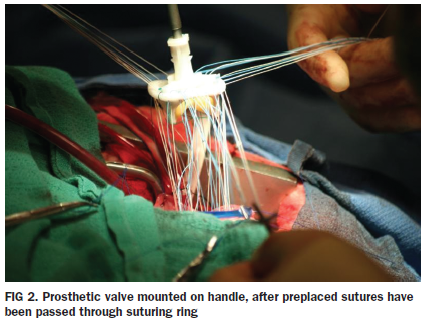 March 2017:
Tricuspid valve replacement with cow or pig valves has
significant complications. In a
March 2017 article by a team of UK researchers (P. Bristow, J.
Sargent, V. Luis Fuentes, D. Brockman), they reported on tricuspid valve
replacements in nine dogs with severe valve regurgitation and signs of
heart failure. All of the dogs were suffering from tricuspid valve
dysplasia, a congenital malformation more common in larger breeds than
the cavalier King Charles spaniel. None of the nine dogs were cavaliers.
The surgical procedures included cardiopulmonary bypasses. Four of the
dogs died due to complications during hospitalization. Of the five dogs
discharged from the hospital, one died due to an unrelated injury seven
days later. Of the four remaining dogs, they survived a median of 533
days after receiving the cow (bovine) valve. The researchers acknowledge
that some of the complications may have been due in part to their
relative inexpericence when compared to the successes of the surgical
group at Colorado State University.
March 2017:
Tricuspid valve replacement with cow or pig valves has
significant complications. In a
March 2017 article by a team of UK researchers (P. Bristow, J.
Sargent, V. Luis Fuentes, D. Brockman), they reported on tricuspid valve
replacements in nine dogs with severe valve regurgitation and signs of
heart failure. All of the dogs were suffering from tricuspid valve
dysplasia, a congenital malformation more common in larger breeds than
the cavalier King Charles spaniel. None of the nine dogs were cavaliers.
The surgical procedures included cardiopulmonary bypasses. Four of the
dogs died due to complications during hospitalization. Of the five dogs
discharged from the hospital, one died due to an unrelated injury seven
days later. Of the four remaining dogs, they survived a median of 533
days after receiving the cow (bovine) valve. The researchers acknowledge
that some of the complications may have been due in part to their
relative inexpericence when compared to the successes of the surgical
group at Colorado State University.
March 2017: 3-D echocardiograms show differences in shapes of mitral valves of MVD-affected dogs versus healthy dogs. In a March 2017 article, an international team of cardiologists (G. Menciotti, M. Borgarelli, M. Aherne, S. Wesselowski, J. Haggstrom, I. Ljungvall, S.M. Lahmers) used real-time transthoracic three-dimensional echocardiography analysis (RT3DE) on 113 dogs, including 13 cavalier King Charles spaniels affected in varying stages of mitral valve disease. The 3-D echos enabled the investigators to compare the morphology of the mitral valves (MVs) of healthy dogs (none were CKCSs) and MVD-affected dogs. They report that the study demonstrated that the MVs of MVD-affected dogs differed from those of healthy dogs in several morphological aspects. In particular, the affected dogs had an increased sphericity and a decreased saddle shape of the MV annulus, as well as a decreased tenting height, area and volume. See Figure 1. The study also reportedly demonstrated significant differences in multiple 3-D echo MV measurements between dogs in varying stages (B1, B2, C) of MVD.
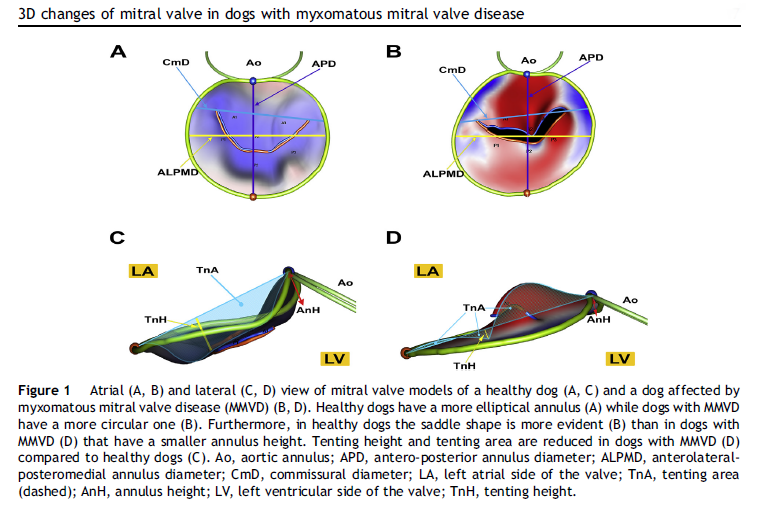
February 2017:
Austrian heart clinic offers mitral valve repair surgery on
MVD-affected dogs in heart failure.
 Dr.
Peter Modler (right) has announced that he is performing
surgical mitral valve repair on a routine basis to dogs with advanced
degenerative mitral valve disease. Thus far, he has concentrated on
treating cavalier King Charles spaniels in congestive heart failure. His
open-heart surgical procedure includes installing a Gore-Tex
annuloplasty ring around the valve, and also replacing diseased valve
chords with Gore-Tex, while the dog is on cardiopulmonary bypass.
Dr.
Peter Modler (right) has announced that he is performing
surgical mitral valve repair on a routine basis to dogs with advanced
degenerative mitral valve disease. Thus far, he has concentrated on
treating cavalier King Charles spaniels in congestive heart failure. His
open-heart surgical procedure includes installing a Gore-Tex
annuloplasty ring around the valve, and also replacing diseased valve
chords with Gore-Tex, while the dog is on cardiopulmonary bypass.
Dr. Modler's clinic is located in Sattledt, Austria. His contact information is: email: office@tierklinik-sattledt.at; telephone: +43 7244 8924; website: www.tierklinik-sattledt.at; address: Traunkreis Vet Clinic - Tierklinik Sattledt, Kirchdorfer Strasse 7, A-4642 Sattledt, Austria. He advises that he is able to provide travel and accommodation assistance, as well.
His exclusion criteria for surgery are:
• Severe pulmonary
hypertension (more than 60 mm Hg)
• Clinical symptoms of
syringomyelia
• Severe concomitant diseases (e.g. kidney
failure, liver failure, malignant neoplasia)
For more information about Dr. Modler's surgeries, on our website, see this October 2015 item.
February 2017: Serum proteins are found to be differentially expressed in cavaliers with MVD. In a February 2017 article on a study of twelve cavaliers, an Italian team reported finding eight serum proteins which were differentially expressed between groups of moderately (M) and severely (S) affected CKCSs with MVD and a control group of healthy cavaliers. These proteins were found to be significantly related to the progression of the disease. In the M group versus healthy dogs complement factor H isoform 2, inhibitor of carbonic anhydrase, hemopexin, dystrobrevin beta isoform X7 and CD5 molecule-like resulted to be down-regulated, whereas fibronectin type-III domain-containing protein 3A isoform X4 was up-regulated. In the S dogs versus healthy group complement factor H isoform 2, calpain-3 isoform X2, dystrobrevin beta isoform X7, CD5 molecule-like and l-2-hydroxyglutarate dehydrogenase resulted to be down-regulated. Complement factor H isoform 2, calpain-3 isoform X2, dystrobrevin beta isoform X7, CD5 molecule-like and hydroxyglutarate dehydrogenase were found to be down-regulated in mild affected group versus healthy dogs. All of these proteins except complement factor H followed a decreasing trend according to the progression of the pathology. They concluded that the differential expression of serum proteins demonstrates the possibility these might be valuable for the detection and monitoring of the disease.
February 2017:
Japanese researchers find left atrium strain can predict heart
failure in MVD-affected dogs.
 In a
February 2017 article, a team of veterinary researchers
at Hokkaido University in Japan (K. Nakamura, S. Kawamoto, T. Osuga, T. Morita, N. Sasaki, K. Morishita,
H. Ohta, M. Takiguchi) examined 52 dogs in various stages (Stages B1,
B2, C, and D) of mitral valve disease (MVD), including two cavalier King
Charles spaniels (CKCS) in Stage B2, to determine the variations in the
extent of strain in the left atrium in the differing MVD stages.
"Strain" is "the longitudinal shortening and lengthening of the LA wall,
allowing the quantification of all 3 LA functions: as reservoir,
conduit, and booster pump." They used speckle-tracking echocardiography,
a novel, angle-independent imaging method that allows assessment of
strain and strain rate, using the tracking of acoustic speckle patterns.
They found that there were no significant differences in parameters of
LA strain between the Stages B1 and B2 groups. However, LA longitudinal
strain during atrial contraction and during ventricular systole were
significantly lower in Stages C and D than in Stages B1 and B2. They
concluded:
In a
February 2017 article, a team of veterinary researchers
at Hokkaido University in Japan (K. Nakamura, S. Kawamoto, T. Osuga, T. Morita, N. Sasaki, K. Morishita,
H. Ohta, M. Takiguchi) examined 52 dogs in various stages (Stages B1,
B2, C, and D) of mitral valve disease (MVD), including two cavalier King
Charles spaniels (CKCS) in Stage B2, to determine the variations in the
extent of strain in the left atrium in the differing MVD stages.
"Strain" is "the longitudinal shortening and lengthening of the LA wall,
allowing the quantification of all 3 LA functions: as reservoir,
conduit, and booster pump." They used speckle-tracking echocardiography,
a novel, angle-independent imaging method that allows assessment of
strain and strain rate, using the tracking of acoustic speckle patterns.
They found that there were no significant differences in parameters of
LA strain between the Stages B1 and B2 groups. However, LA longitudinal
strain during atrial contraction and during ventricular systole were
significantly lower in Stages C and D than in Stages B1 and B2. They
concluded:
"In conclusion, the results of the present study indicate that LA longitudinal strain was significantly lower in dogs in the advanced stages [Stages C and D] of MMVD. LA longitudinal strain during atrial contraction was the best predictor of the presence or history of CHF. LA strain assessed on conventional echocardiography and radiography could add meaningful information to confirm the presence of CHF in the clinical setting. Further studies are needed to determine the clinical implications of these findings for treatment decisions and/or prognosis determination."
January 2017:
Nutri-Plus Gel stimulates the appetite of a cavalier in
Stage C MVD suffering severe weight loss. In a
November 2016 article
by a team of French cardiologists and specialists (J. Bouvard, C.
Misbach, V. Gouni, C. Damoiseaux, A.M.P. Petit, V. Arqued-Soubeyran, E.
Trehiou-Sechi, J.L. Pouchelon, G. Chaix, V. Chetboul),
 they
reported on the use of a palatable complementary feed
composed of high-energy ingredients (glucose syrup, soybean oil and cod
liver oil), hydrolyzed animal proteins, vitamins and oligo-elements,
called
Nutri-Plus Gel, in five case studies.
they
reported on the use of a palatable complementary feed
composed of high-energy ingredients (glucose syrup, soybean oil and cod
liver oil), hydrolyzed animal proteins, vitamins and oligo-elements,
called
Nutri-Plus Gel, in five case studies.
Case Report 4 was of a female 13-year-old cavalier King Charles spaniel (right) in Stage C2 (advanced heart failure) of mitral valve disease, which had lost 1.5 lbs. in the previous month and now weighed 11.5 lbs. She exhibited signs of fatigue, lack of appetite, and diarrhea. Her MVD treatment had been the standard six medicines for cavaliers in heart failure. They reported:
"Nutri-Plus Gel was also prescribed to stimulate appetite, limit the already considerable loss in body weight (10% of the initial weight in one month), and facilitate treatment compliance (six drugs in all, requiring eleven oral doses). During the follow-up visit one week later, the owner reported that the digestive and cardiac symptoms had disappeared (stage C1). One month later, a gain in weight was noted (200 g [0.44 lb.]). Two years after this episode, the dog was in good general condition and no change in the medical treatment was proposed, as the symptoms had not returned. As the animal's weight is now stable, Nutri-Plus Gel is recommended solely on demand, during phases of hyporexia (infrequent to date, according to the owner)."
Nutri-Plus Gel is available here.
 January
2017:
Dr. Borgarelli seeks cavaliers in heart failure for minimally
invasive mitral valve repair.
Dr. Michele
Borgarelli at Virginia Tech veterinary school is testing the feasibility of
minimally invasive repair of the mitral valve using the
Harpoon TSD-5
device developed by Harpoon Medical Inc. of Baltimore, Maryland. The
device is designed to anchor artificial cords on the flaps of the valve,
to replace the vavle's natural chordae tendieae. The replacement cords
are made of expanded polytetrafluoroethylene (ePTFE).
January
2017:
Dr. Borgarelli seeks cavaliers in heart failure for minimally
invasive mitral valve repair.
Dr. Michele
Borgarelli at Virginia Tech veterinary school is testing the feasibility of
minimally invasive repair of the mitral valve using the
Harpoon TSD-5
device developed by Harpoon Medical Inc. of Baltimore, Maryland. The
device is designed to anchor artificial cords on the flaps of the valve,
to replace the vavle's natural chordae tendieae. The replacement cords
are made of expanded polytetrafluoroethylene (ePTFE).
Dr. Borgarelli is seeking candidate dogs for a study to assess the efficacy and long-term effects of using the Harpoon Medical TSD-5 device. Dogs in Stage C, heart failure with significant enlargement, and weighing over 11 pounds. Details of the study are available here. To apply, or for more information, contact Mindy Quigley, Clinical Trials Coordinator, telephone 540-231-1363, email vettrials@vt.edu.
January 2017: N-terminal BNP predictions of MVD status get more complicated. In a January 2017 article by a team of Texas A&M University researchers (Randolph L. Winter, Ashley B. Saunders, Sonya G. Gordon, Jesse S. Buch, Matthew W. Miller), they focused upon the inherent variability of the cardiac biomarker N-terminal pro-brain natriuretic peptide (NTproBNP) in all dogs -- both healthy and MVD-affected -- and how those random variations, called biologic variability, affects the accuracy of population-based reference ranges of NTproBNP readings. They measured NTproBNP in healthy dogs and dogs in stages B1, B2, and C of mitral valve disease, to estimate biologic variability and calculate an Index of Individuality (IoI) for each dog. Of the 28 MVD-affected dogs in the study, 14 -- 50% -- were cavalier King Charles spaniels, along with 10 healthy control dogs. They found that MVD-affected dogs had a lower inherent variability of NTproBNP compared to healthy dogs, and that, as a group, MVD-dogs required a change of 58.2% for NTproBNP to be outside the range of inherent biologic variability and indicate a change in disease. They determined that population-based reference ranges for NTproBNP may have limitations. They stated that:
"It is important for veterinarians to have an understanding of how much a biomarker value could change over time due to randomness vs. disease progression in an individual dog. ... Monitoring serial individual changes in NTproBNP values may be clinically relevant in addition to using population-based reference ranges to determine changes in disease status."
 EDITOR'S NOTE: This study highlights the fallibity of cardiac
biomarker natriuretic peptide tests to predict the stage of MVD and the
onset of heart failure in MVD-affected cavaliers. We have found that
such blood tests have been used as a crutch for veterinarians who are
insecure in their own judgment based upon traditional tools such as
auscultation and signs such as breaths-per-minute. This study suggests
that a one-time test may not provide an accurate
result, and that many repeats of that test are required over an extended
period of time.
EDITOR'S NOTE: This study highlights the fallibity of cardiac
biomarker natriuretic peptide tests to predict the stage of MVD and the
onset of heart failure in MVD-affected cavaliers. We have found that
such blood tests have been used as a crutch for veterinarians who are
insecure in their own judgment based upon traditional tools such as
auscultation and signs such as breaths-per-minute. This study suggests
that a one-time test may not provide an accurate
result, and that many repeats of that test are required over an extended
period of time.
RETURN TO TOP
2016 News
December 2016:
Cardiac Education Group recommends treating Stage B2
MVD-affected dogs with pimobendan based only upon x-rays.
 In a
December 2016 newsletter, the Cardiac Education Group (CEG), a team
of veterinary cardiologists including Drs. John D. Bonagura, Barret
Bulmer, Whit M. Church, Sonya G. Gordon, Brian A. Scansen, Alan W.
Spier, and Rebecca L. Stepien, has proposed a short-cut version of the
parameters recommended in the EPIC Study report, which is based solely
upon the Vertebral Heart Score values determined from x-rays, skipping
entirely any measurements taken from echocardiograms. It bases its
x-ray-only parameters on situations in which "an echocardiogram is not
available" or "the client declines echocardiography". The CEG states:
In a
December 2016 newsletter, the Cardiac Education Group (CEG), a team
of veterinary cardiologists including Drs. John D. Bonagura, Barret
Bulmer, Whit M. Church, Sonya G. Gordon, Brian A. Scansen, Alan W.
Spier, and Rebecca L. Stepien, has proposed a short-cut version of the
parameters recommended in the EPIC Study report, which is based solely
upon the Vertebral Heart Score values determined from x-rays, skipping
entirely any measurements taken from echocardiograms. It bases its
x-ray-only parameters on situations in which "an echocardiogram is not
available" or "the client declines echocardiography". The CEG states:
"If an echocardiogram is not available and only thoracic radiographs are performed, the CEG recommends starting pimobendan in dogs with heart murmurs of grade 3/6 or louder only when the VHS exceeds 11.5 vertebral bodies or an incremental increase of greater than 0.5 vertebral bodies per 6 months is accurately documented. ... In situations where the client declines echocardiography, the thoracic radiograph path can be followed in the primary care practice."
The CEG goes on to acknowledge that:
"ACVIM guidelines recommend both imaging methods for optimal evaluation of a dog with suspected MMVD. The EPIC trial did not investigate a cutoff for cardiac enlargement by VHS alone at which to start pimobendan therapy. This algorithm represents the consensus of the CEG to initiate therapy when echocardiography is not available, but is not based on evidence."
 EDITOR'S NOTE: This is a stunning -- even jaw-dropping -- effort to
water-down the recommendations of the EPIC Study report. The only saving
grace of the EPIC Study report is that it requires that two precise
minimum echocardiographic measurements be met, in addition to the
arbitrary, species-wide VHS value of >10.5, before prescribing pimobendan to
MVD-affected dogs before heart failure. The CEG openly admits that "The
EPIC trial did not investigate a cutoff for cardiac enlargement by VHS
alone at which to start pimobendan therapy." And, the CEG also admits
that its x-ray-only parameters are "not based on evidence."
EDITOR'S NOTE: This is a stunning -- even jaw-dropping -- effort to
water-down the recommendations of the EPIC Study report. The only saving
grace of the EPIC Study report is that it requires that two precise
minimum echocardiographic measurements be met, in addition to the
arbitrary, species-wide VHS value of >10.5, before prescribing pimobendan to
MVD-affected dogs before heart failure. The CEG openly admits that "The
EPIC trial did not investigate a cutoff for cardiac enlargement by VHS
alone at which to start pimobendan therapy." And, the CEG also admits
that its x-ray-only parameters are "not based on evidence."
In essence, by these admissions, the only professional course of action for the CEG to take would have been to not make any such x-ray-only recommendation at all. One must wonder why the CEG is doing this. Could it be that it was pressured by the manufacturer of Vetmedin -- which fully funded the EPIC Study -- to go out on such an irresponsible limb? We ask because, as the CEG's newsletter also states, "The CEG is sponsored by an educational grant from Boehringer Ingelheim Vetmedica, Inc."
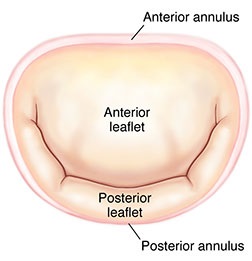 December
2016:
Study shows healthy cavaliers' mitral valve structure differs
markedly from other breeds. In a
September 2016 abstract, an international panel of cardiologists (G.
Menciotti, J. Haggstrom, I. Ljungvall, M. Aherne, S.Wesselowski, J. A.
Abbott, M. Borgarelli) used 3-D echocardiography to compare the mitral
valves of 22 cavalier King Charles spaniels with 41 other dogs of 18
different breeds. They measured the dimensions of the mitral valve's
annulus (see diagram at right), tenting (see diagram at
left below), leaftet areas, and several other categories.
December
2016:
Study shows healthy cavaliers' mitral valve structure differs
markedly from other breeds. In a
September 2016 abstract, an international panel of cardiologists (G.
Menciotti, J. Haggstrom, I. Ljungvall, M. Aherne, S.Wesselowski, J. A.
Abbott, M. Borgarelli) used 3-D echocardiography to compare the mitral
valves of 22 cavalier King Charles spaniels with 41 other dogs of 18
different breeds. They measured the dimensions of the mitral valve's
annulus (see diagram at right), tenting (see diagram at
left below), leaftet areas, and several other categories.
They found that cavaliers had significantly smaller annulus diameter,
annulus height, tenting height, tenting area, normalized tenting volume,
posterior leaflet length, normalized posterior leaflet area, and a
greater annulus sphericity index. They concluded that the mitral valve
of healthy CKCSs was more circular and had less tenting, compared to
other
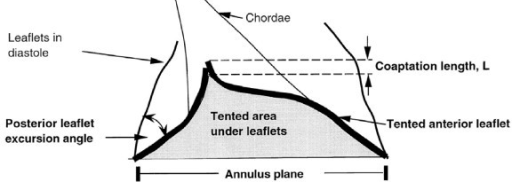 breeds.
breeds.
The investigators intend to pursue further research into these differences and determine whether they explain the cavalier's predispostion to an earlier onset of MVD and to a faster progression to heart failure.
December 2016:
Tufts' researchers test mesenchymal stem cell (MSC) treatments
to improve MVD-affected dogs in heart failure.
 Beginning
in 2016, a research team at Tufts' University's Cummings veterinary
school's Regenerative Medicine Laboratory, led by Dr. Andrew Hoffman
(right), is conducting a study of ten MVD-affected dogs in
congestive heart failure (determined by fluid in the lungs), which are
being injected with mesenchymal stem cell (MSC) treatments
to determine, first, if the therapy is safe for the dogs, and, second,
will result in improved cardiac function, as determined by
echocardiography, cardiac biomarkers, and quality of life. The
study is titled, "Allogeneic Umbilical Cord Tissue (Wharton Jelly)
Derived Mesenchymal Stem Cell Therapy for Chronic Valvular Disease and
Associated Congestive Heart Failure".
Beginning
in 2016, a research team at Tufts' University's Cummings veterinary
school's Regenerative Medicine Laboratory, led by Dr. Andrew Hoffman
(right), is conducting a study of ten MVD-affected dogs in
congestive heart failure (determined by fluid in the lungs), which are
being injected with mesenchymal stem cell (MSC) treatments
to determine, first, if the therapy is safe for the dogs, and, second,
will result in improved cardiac function, as determined by
echocardiography, cardiac biomarkers, and quality of life. The
study is titled, "Allogeneic Umbilical Cord Tissue (Wharton Jelly)
Derived Mesenchymal Stem Cell Therapy for Chronic Valvular Disease and
Associated Congestive Heart Failure".
December 2016:
Polish researchers find four cell markers signal left atrium
enlargement in MVD-dogs. In a
December 2016 study by a team of Polish researchers (Izabela Janus
(right), Małgorzata Kandefer-Gola, , Rafał Ciaputa, Agnieszka
Noszczyk-Nowak, Urszula Pasławska, Massimiliano Tursi, Marcin Nowak), they examined
the cell markers: (a) desmin, a standard cardiomyocyte marker; (b)
vimentin, a typical cell marker expressed in mesenchymal cells; (c)
periostin, a novel marker for myocardial remodelling; and (d) caspase-3,
a marker of cell apoptosis. They compared them in dogs with end-stage
dilated cardiomyopathy (DCM) and dogs with MVD and a control group of
unaffected dogs. Their research focused upon the enlargement of the left
atrium in the diseased dogs. They reported that changes included: (a)
irregularity of desmin cross-striation and desmosomes; (b) a higher
amount of vimentin-positive cells; (c) a change in the periostin
expression pattern from cytoplasmic to extracellular; and (d) a lower
expression of caspase-3. The alterations reportedly were more pronounced
in the DCM group than in the MVD group. They concluded that, during
heart failure, the pattern of desmin, vimentin, periostin and caspase-3
expression alters in the left atrium, regardless of the cause; that the
changes are more pronounced in dogs with DCM than in dogs with MVD and
similar left atrial enlargement. See also this research team's
January 2016 report, below.
In a
December 2016 study by a team of Polish researchers (Izabela Janus
(right), Małgorzata Kandefer-Gola, , Rafał Ciaputa, Agnieszka
Noszczyk-Nowak, Urszula Pasławska, Massimiliano Tursi, Marcin Nowak), they examined
the cell markers: (a) desmin, a standard cardiomyocyte marker; (b)
vimentin, a typical cell marker expressed in mesenchymal cells; (c)
periostin, a novel marker for myocardial remodelling; and (d) caspase-3,
a marker of cell apoptosis. They compared them in dogs with end-stage
dilated cardiomyopathy (DCM) and dogs with MVD and a control group of
unaffected dogs. Their research focused upon the enlargement of the left
atrium in the diseased dogs. They reported that changes included: (a)
irregularity of desmin cross-striation and desmosomes; (b) a higher
amount of vimentin-positive cells; (c) a change in the periostin
expression pattern from cytoplasmic to extracellular; and (d) a lower
expression of caspase-3. The alterations reportedly were more pronounced
in the DCM group than in the MVD group. They concluded that, during
heart failure, the pattern of desmin, vimentin, periostin and caspase-3
expression alters in the left atrium, regardless of the cause; that the
changes are more pronounced in dogs with DCM than in dogs with MVD and
similar left atrial enlargement. See also this research team's
January 2016 report, below.
November 2016:
UK Kennel Club approves MVD testing scheme for cavaliers.
 In
a
November 2016 press release, the UK Kennel Club announced that it
has approved a health testing scheme for cavalier King Charles spaniels,
with the intended result of "dramatically" improving the heart health of
the CKCS. The program will consist of veterinary cardiologists examining
cavaliers to determine if each dog has a mitral valve murmur. An
echocardiograph scan also will be performed and sent to Dr. Lisbeth
Høier Olsen in Denmark, for her to measure the heart. Each dog will be
issued a certificate from the University of Copenhagen, with both a
murmur and mitral valve prolapse score. The Kennel Club will record the
certificate results on the dog's registration record and made available
publicly. The Kennel Club also intends to update MVD breeding
recommendations for cavaliers.
In
a
November 2016 press release, the UK Kennel Club announced that it
has approved a health testing scheme for cavalier King Charles spaniels,
with the intended result of "dramatically" improving the heart health of
the CKCS. The program will consist of veterinary cardiologists examining
cavaliers to determine if each dog has a mitral valve murmur. An
echocardiograph scan also will be performed and sent to Dr. Lisbeth
Høier Olsen in Denmark, for her to measure the heart. Each dog will be
issued a certificate from the University of Copenhagen, with both a
murmur and mitral valve prolapse score. The Kennel Club will record the
certificate results on the dog's registration record and made available
publicly. The Kennel Club also intends to update MVD breeding
recommendations for cavaliers.
November 2016: Simon Swift calls for parents/grandparents of UK show cavaliers to meet MVD breeding protocol -- only 4% of CKCSs have been meeting that protocol. In a letter to the Veterinary Times published in October 2016, cardiologist Simon Swift called for the UK Kennel Club to require that the parents of all show CKCSs be tested and cleared for MVD at age five years. If the parents are not yet five years old, then he writes that the show dogs' grandparents meet that test standard. He is referring to the MVD Breeding Protocol, which the UK Cavalier Club has endorsed but which the two US breed clubs have refused to endorse.
He also noted:
"Examining dogs on the database for the period between 2006 and 2010 showed only four per cent ofdogs had followed this breeding advice -- that is, had parents or grandparents tested clear older than five years."
EDITOR'S NOTE: Dr. Swift's observation that only 4% of cavaliers being bred in the UK in accordance with the MVD Breeding Protocol is a sad acknowledgement that nearly all CKCS breeders are more concerned about their kennels' success than about the health and welfare of the dogs they produce.
October 2016:
Thai cardiologists recommend "ECG monitoring should be performed
in dogs chronically administered with pimobendan."
 In
a
June 2016 article by a team of Thai researchers (Sirilak Disatian
Surachetpong [right], Nisarat Boonlue, Pasorn Pupa, Waratsarin
Boonsathitanan, Sumanee Rakthaidee, Tanawan Mangklabruks, Siriwan
Sakarin), they report the results of examining the clinical records,
including electrocardiograms (ECG), of 29 small and medium sized dogs
(none were CKCSs), which had been treated for mitral valve disease with
pimobendan. They found that 10 of the 29 dogs -- 34% -- had developed
cardiac arrhythmias following at least a month's treatment with
pimobendan. Types of cardiac arrhythmias included atrial fibrillation,
sinus tachycardia, second degree AV block, ventricular premature beat,
and junctional premature beat. Most of dogs with cardiac arrhythmias had
atrial fibrillation. They concluded that "cardiac arrhythmias may
develop in some dogs treated chronically with pimobendan", and that
"ECG monitoring should be performed in dogs chronically administered
with pimobendan."
In
a
June 2016 article by a team of Thai researchers (Sirilak Disatian
Surachetpong [right], Nisarat Boonlue, Pasorn Pupa, Waratsarin
Boonsathitanan, Sumanee Rakthaidee, Tanawan Mangklabruks, Siriwan
Sakarin), they report the results of examining the clinical records,
including electrocardiograms (ECG), of 29 small and medium sized dogs
(none were CKCSs), which had been treated for mitral valve disease with
pimobendan. They found that 10 of the 29 dogs -- 34% -- had developed
cardiac arrhythmias following at least a month's treatment with
pimobendan. Types of cardiac arrhythmias included atrial fibrillation,
sinus tachycardia, second degree AV block, ventricular premature beat,
and junctional premature beat. Most of dogs with cardiac arrhythmias had
atrial fibrillation. They concluded that "cardiac arrhythmias may
develop in some dogs treated chronically with pimobendan", and that
"ECG monitoring should be performed in dogs chronically administered
with pimobendan."
October 2016: Tawian cardiologists find anemia increases with MVD progression and predicts mortality. In an October 2016 article, a team of Taiwan researchers (Ivarosa Bing-Ye Yu, Hui-Pi Huang) found in 114 MVD-affected dogs that the presence of anemia increased with the progression of MVD and was associated with the severity of heart failure. They stated that anemic dogs in heart failure had shorter median survival times (13 months) than non-anemic dogs in heart failure (28 months), and that anemia was a predictor of mortality.
October 2016:
Korean researchers find cystatin-C or cystatin 3 (Cys-C) and
symmetric dimethylarginine (SDMA) as useful biomarkers of MVD
progression to heart failure.
 In
a
September 2016 study by a team of Korean cardiology researchers
(Bum-Sul Choi, Hyeong-Sun Moon, Sang-Hyuk Seo, Changbaig Hyun
[right]), they examined serum concentration levels of two kidney
function biomarkers -- Cystatin-C or cystatin 3 (Cys-C) and symmetric
dimethylarginine (SDMA) -- which appear to play roles in predicting
new-onset or deteriorating kidney diseases. Their goal was to evaluate
these two renal disorder biomarkers in dogs with mitral valve disease
(MVD) at varying degrees of heart failure. They found that serum Cys-C
and SDMA concentrations were not correlated to age or body weight, but
closely correlated to the severity of heart failure and
echocardiographic markers of heart enlargement. The study found
progressive elevation in renal markers in dogs with advancing MVD,
suggesting that the reduction of glomerular filtration rate (GFR) might
be worsened with the progression of cardiac dysfunction. They concluded
that their study demonstrated that the glomerular filtration rate (GFR)
-- a common complication in advanced stages of heart failure -- was
decreased in dogs with MVD in earlier stages of heart failure, based on
results from serum Cys-C and SDMA tests, and therefore, earlier
intervention for preventing renal injuries even in asymptomatic MVD dogs
is necessary for the successful long-term management of heart failure in
MVD-dogs.
In
a
September 2016 study by a team of Korean cardiology researchers
(Bum-Sul Choi, Hyeong-Sun Moon, Sang-Hyuk Seo, Changbaig Hyun
[right]), they examined serum concentration levels of two kidney
function biomarkers -- Cystatin-C or cystatin 3 (Cys-C) and symmetric
dimethylarginine (SDMA) -- which appear to play roles in predicting
new-onset or deteriorating kidney diseases. Their goal was to evaluate
these two renal disorder biomarkers in dogs with mitral valve disease
(MVD) at varying degrees of heart failure. They found that serum Cys-C
and SDMA concentrations were not correlated to age or body weight, but
closely correlated to the severity of heart failure and
echocardiographic markers of heart enlargement. The study found
progressive elevation in renal markers in dogs with advancing MVD,
suggesting that the reduction of glomerular filtration rate (GFR) might
be worsened with the progression of cardiac dysfunction. They concluded
that their study demonstrated that the glomerular filtration rate (GFR)
-- a common complication in advanced stages of heart failure -- was
decreased in dogs with MVD in earlier stages of heart failure, based on
results from serum Cys-C and SDMA tests, and therefore, earlier
intervention for preventing renal injuries even in asymptomatic MVD dogs
is necessary for the successful long-term management of heart failure in
MVD-dogs.
September 2016:
The EPIC Study
concludes that pimobendan can prolong pre-heart failure by 15 months in
MVD-affected dogs with echo and x-ray evidence of heart enlargement.
 In a
September 2016 article, an international team of veterinary
cardiologists report that the administration of pimobendan to
MVD-affected dogs with echocardiographic and radiographic evidence of
heart enlargement results in prolonging the pre-heart failure period by
approximately 15 months over non-treatment (a placebo), which represents
a substantial clinical benefit.
In a
September 2016 article, an international team of veterinary
cardiologists report that the administration of pimobendan to
MVD-affected dogs with echocardiographic and radiographic evidence of
heart enlargement results in prolonging the pre-heart failure period by
approximately 15 months over non-treatment (a placebo), which represents
a substantial clinical benefit.
To be included in the study, a dog had to be 6 years of age or older, have a mitral valve murmur of at least Grade 3 of 6, have echocardiographic evidence of advanced MVD consisting of characteristic valvular lesions of the mitral valve, regurgitation through the mitral valve (MR) on the color Doppler echocardiogram, and have echocardiographic evidence of left atrial and left ventricular dilatation. All dogs entering the study met or exceeded three different heart size criteria. They are, first, the left atrial-to-aortic ratio (LA/Ao) > 1.6. Second, the normalized left ventricular internal diameter in diastole (LVIDDN) > 1.7. Third, radiographic evidence of enlargement with a vertebral heart score (VHS) >10.5. The researchers warn that:
"... it should be borne in mind when interpreting these results that all dogs included in the analyses also met the echocardiographic inclusion criteria and these results therefore might not be generalizable to all dogs with a VHS > 10.5 in the absence of concurrent echocardiographic measurements and a confirmed diagnosis of MMVD."
Therefore, to apply the results of this study to future treatment of MVD-affected dogs, an x-ray of the heart, showing a VHS over 10.5, is not sufficient by itself, and that the two echo measurements must also be confirmed.
Of 354 dogs in the study, 161 (45.5%) were cavalier King Charles spaniels (CKCS) -- the largest breed group. Therefore, the results of this study obviously are of supreme importance to owners of cavaliers. Of those 354 dogs, 178 of the dogs were treated with pimobendan (77 CKCSs), and 180 received the placebo (81 CKCSs). Of those 178 dogs treated with pimobendan, 59 (33.1%) reached congestive heart failure (CHF), 15 (8.4%) died of cardiac-related deaths during the treatment. The others had not reached CHF by the time the study ended. The authors explained that:
"Although a greater number of dogs in the pimobendan group experienced spontaneous cardiac death (12 versus 5), the proportion of dogs in each group experiencing this event was not significantly different."
They concluded:
"Chronic oral administration of pimobendan to dogs with echocardiographic and radiographic evidence of cardiomegaly secondary to MMVD, in the absence of concurrent cardiovascular medication, results in the prolongation of the preclinical period, and is safe and well tolerated. The median time to the onset of CHF or cardiac-related death was prolonged by approximately 15 months, and the risk of a dog experiencing this event was reduced by approximately one-third; the majority of the benefit observed was attributable to delaying the onset of CHF. This substantial degree of prolongation of the preclinical period is f clinical relevance and is of importance to veterinarians and owners of dogs affected by this common disease."
So, the bottom line is:
(1) The dog must be in Stage B2 of mitral valve disease; AND
(2)
Have a murmur of at least Grade 3; AND
(3) The dog must NOT be on any
other cardiac medication; AND
(4) An echocardogram must be conducted
and show valvular lesions of the mitral valve, regurgitation through the
mitral valve (MR) on the color Doppler echocardiogram, and have
echocardiographic evidence of left atrial and left ventricular
dilatation; AND
(5) X-rays showing evidence of enlargement with a
vertebral heart score (VHS) greater than 10.5.
This essentially means that once the MVD-affected dog develops a Grade 3 murmur and an x-ray showing enlargement, the owner should have a board certified veterinary cardiologist perform the echo exam.
EDITOR'S NOTE: This long-awaited and highly vaunted report is nevertheless loaded with unanswered questions. It is as if the research team proceeded with blinders and were led with rings through their noses. A few examples:
• The recommended x-ray and echo measurement parameters were set at the outset of the study, rather than scientifically determined as a result of the study. Since the conclusion of the EPIC Study includes very precise minimum heart measurement criteria (VHS >10.5; LA/Ao > 1.6; LVIDDN > 1.7), one would have hoped that the researchers made those determinations by a careful analysis of the results of the study. But, no, the exact opposite was the case. The lead researchers made up those parameters before the study even began. And they did not re-visit those parameters after the study ended, to determine if their initial determinations are safe and otherwise appropriate. The fact is that at least one of the those three parameters -- the VHS measurement -- is so off base for cavaliers that it can be life-threatening.
• The average heart-healthy cavalier has a VHS value above 10.5. It is troubling that the study report fails to note that normal, heart-healthy cavaliers typically have VHS measurements as high as 11.7, which is notably higher than the 10.5+ criterion for beginning pimobendan treatment. Considering that nearly half of the dogs in the study were CKCSs, this oversight is rather inexplicable and potentially life-threatening.
Bizarrely, the researchers' footnoted citation justifying this VHS score is an article which expressly states:"The use of breed-specific VHS values is needed for the VHS method to have a high specificity for normal heart size."It previously has been customary when cardiologists determine heart enlargement using VHS values, to compare the current x-ray with previous ones, such as a baseline x-ray. Indeed, the ACVIM's 2009 Consensus Statement specifically recommends, for Stage B dogs, to obtain baseline x-rays. It states:
"Thoracic radiography is recommended in all patients to assess the hemodynamic significance of the murmur and also to obtain baseline thoracic radiographs at a time when the patient is asymptomatic for CVHD."Therefore, it is perplexing as to why this EPIC Study, being hyped as "top tier" by its chief lead researcher, ignores breed-specific VHS values, and more importantly for cavaliers, ignores the individual patient's specific VHS value compared to the dog's baseline x-ray.
But if the manufacturer's goal is to sell more pills, then reducing the threshold VHS value to significantly below the average score of a healthy cavalier, will do just that -- sell more pills. Let's face it, the CKCS breed will be its biggest customer.
• The study glosses over pimobendan causing sudden deaths. It also is disappointing that the study does not go into any details about 8.4% of dogs being treated with pimobendan and which suffered "spontaneous" cardiac-related deaths while only in Stage B2. While the authors do acknowledge that "concerns had previously been raised about possible detrimental effects of the administration pimobendan to dogs with preclinical MMVD", they provide nothing to explain why pimobendan played a role in those sudden and unexpected Stage B2 deaths. To the contrary, they seem to be patting themselves on the back for even including any data on these premature cardiac deaths, stating:"If our primary endpoint had focused exclusively on the onset of CHF, with dogs that died being censored, it might have appeared that we were choosing to ignore potentially detrimental effects of the treatment."Well, it certainly does appear that they have chosen to ignore those detrimental effects. Instead, they minimize these 8.4% premature deaths of pimobendan-treated dogs by stating:"We found, not unexpectedly, that only a small number of dogs met the primary endpoint in this way. Although a greater number of dogs in the pimobendan group experienced spontaneous cardiac death (12 versus 5), the proportion of dogs in each group experiencing this event was not significantly different."How many of the suddenly dead pimobendan group dogs were cavaliers? We are not told. What if all of the dead pimobendan dogs were cavaliers? (That is not so far-fetched, considering the unreasonably low VHS threshold of >10.5.) That would amount to 15.5% of all of the CKCSs in the pimobendan group. If 15.5% of the cavaliers in the pimobendan group died suddenly, would that make a "significant" difference?
In a prior peer-reviewed study of 317 human patients, the researchers found that: "In both pimobendan groups combined the hazard of death was 1.8 times higher than in the placebo group", and those researchers made a big deal of that finding. Ironically, in this EPIC Study, the death hazard of pimobendan was 2.4 times higher than the placebo group, and the EPIC Study researchers just blow that significant fact off like it does not matter a whit.
How can they conclude that pre-CHF dosing of pimobendan "is safe and well tolerated", when nearly 10% of the dogs died cardiac-related deaths suddenly while being given pimobendan, and the researchers made no effort to find out those dogs' precise causes of death? Well, that is what the manufacturer wanted them to conclude. "Safe and well tolerated" was one of the two main goals for the EPIC Study. So, by minimizing the significance of all of the pimobendan-caused sudden deaths, that goal of "safe and well tolerated" has been attained.
• The study ignored the affect of pimobendan on contractility and systolic function of the dogs' hearts. Despite the researchers acknowledging that "concerns had previously been raised about possible detrimental effects of the administration pimobendan to dogs with preclinical MMVD", they did not bother to report measurements of the contractility and/or fractional shortening of the dogs' hearts during the treatment period. Since prior peer-reviewed studies cited above have shown that "long-term administration of PIMO in dogs with asymptomatic MVD is associated with an increase in systolic function and, concomitantly, a progressive worsening of MVD with development of specific mitral valve lesions", this periodic measurement could have predicted (and presumably avoided) the sudden deaths of 8.4% of the pimobendan dogs. That is another messy little detail which would not have made the manufacturer very happy.
When a study ignores these previously detailed, scientifically determined hazards of the premature administration of pimobendan (over-stimulating the well-compensated heart's contractility), and instead the study is based upon superficial appearances (an enlarged heart), that study can easily lead to false positives. In such a case, it really does not matter that the current cohort study includes a larger number of dogs than the previous clinical ones. What matters is the damage done -- and to be done in the future -- because of the risks taken. The failure to examine that damage -- in this case, the causes of death of nearly 10% of the dogs in the pimobendan group -- aids and abets the potential for those false positives. Minimizing the negative results points to a manufacturer-driven study.
• The report excludes the study's own evidence of pimobendan shortening life spans after CHF. While it is not at all clear in the published article, at the ACVIM conference in June 2016, where the results of this study were orally presented to attending cardiologists, it was reported that once the dogs reached CHF, the subsequent life spans of the pimobendan dogs were shorter than the life spans of the placebo dogs. It therefore suggests that once CHF develops, life expectancy actually shortens for dogs treated with pimobendan, relative to untreated dogs. The researchers have not included this information in their article, but that data raises the question of whether the shortened life span of CHF dogs treated with pimobendan during Stage B2 is due either to drug toxicity or to an acquired tolerance to the pimobendan.
The report does state that, "The median time to death by all causes was 1059 days in the pimobendan group [83 dogs] and 902 days in the placebo group [103 dogs]". (Emphasis added.) But it fails to break out the numbers of dogs which died of MVD or MVD-related disorders. So, the data which the authors provide on this topic in their report is pretty much worthless, and they are silent on the topic which would have been most relevant: How much longer, or shorter, did pimobendan dogs live than did placebo dogs before dying MVD-related deaths?
One of the lead investigators. shortly after publication of the EPIC Study, stated that, "We intend to publish at least one further paper relating to the study, which will provide longitudinal follow up on dogs in the study." That is well and good, of course, but unless that further paper is published promptly, there will be another undue delay -- like the 18 month one between the March 2015 press releases and the report itself -- in finding out what value pimobendan, if any, may have in extending the lives of MVD-affected dogs. Meanwhile its manufacturer will be able to continue to bask in the unsubstantiated hype and promises that pre-CHF administration of pimobendan will not only delay the onset of heart failure, but also extend the lifespans of the dogs. For example, that same lead investigator reportedly told the UK Telegraph in October 2016 that, "This is a major breakthrough in treatment and could extend the lives of dogs around the world." "Could" is the operative word there, because no evidence has been presented in the published report that pimobendan added to the longevity of any dogs dying of mitral valve disease.
• The researchers provide no breed-specific information. There were 360 dogs in this study. Nearly half of them were cavalier King Charles spaniels. And yet, the report includes no data specific to cavaliers -- or to any other breed, for that matter. The authors had a year and a half after the conclusion of the trial, to sift through the data and analyze every aspect of them, before publication. But no breed-specific breakdown is to be found. No breed is going to be more affected by this study than the CKCS. This is just about the least informative study of the safety and effectiveness of any drug with a prior record of toxicity, in this century.
• The report precludes treating pre-CHF dogs with any other cardiac medications. Since the EPIC Study excluded any dogs being treated with cardiac drugs other than pimobendan, this means that previous common protocols, such as prescribing an ACE-inhibitor (e.g., enalapril or benazepril) to MVD-affected dogs in Stage B2, are out the window from now on. In fact, the authors brag about not needing any other medications in Stage B2, stating:"An additional strength of the study is the absence of the confounding effect of any concurrent cardiovascular medications".This is an added benefit to Vetmedin's producer, conveniently giving it a peer-reviewed monopoly on pre-CHF treatment of MVD-affected dogs.
• The authors try to defend Vetmedin's manufacturer's total financial control over them. Interestingly, the authors bend over backwards to justify the full funding of this study by the manufacturer of Vetmedin. They essentially explain that, 'that's the way it is in the veterinary field.' Specifically, they state:"that the majority of published clinical trials are sponsored by industry. In the veterinary field, there are no large independent funding organizations comparable to the National Institutes of Health (NIH) that are likely to be able to (or wish to) fund a study of the magnitude of the one we describe; therefore, such studies are only likely to be achieved with industry sponsorship. Potential explanations of the increased likelihood of industry-sponsored research having positive findings include the following: Industrial sponsors might be more likely to support studies that are likely to succeed, industrial sponsors might design studies with an inappropriate comparator group, or there might be publication bias with unsuccessful studies being less likely to be published."There is a term used in the scientific research field for this type of defensive excuse making: "publication bias", and the authors even use it in the quote above. When they write, "... unsuccessful studies being less likely to be published", they could add, "unsuccessful results within studies" to the list of those being less likely to be published. And it is also apparent in the next topic discussed here: the glaring conflict between the March 2015 press releases and the actual findings in the September 28, 2016 journal article.
• The report flatly contradicts the braggadocious press releases issued 18 months earlier. But the absolutely most irresponsible fact to be drawn from this report is the March 2015 press releases issued by the three lead researchers, which unqualifiedly stated:"The interim analysis indicated that there was clear evidence of benefit of the administration of pimobendan in prolonging the time to the primary endpoint of the study, which was a composite of the development of left-sided congestive heart failure, or death presumed to be cardiac in origin. The interim analysis did not raise any concern over the safety of pimobendan administration." (Emphasis added.)"A mid-study analysis in mid-February 2015 indicated that pimobendan is clearly beneficial and did not raise any concern over the administration of pimobendan." (Emphasis added.)Nowhere in any of those self-laudatory press releases did any of the researchers warn of the vital importance of first performing two precise echocardiographic measurements and a radiographic measurement before dosing pimobendan to MVD-affected dogs prior to CHF.
Since the researchers knew in advance of those press releases what the essential parameters were for the dogs participating in the trial, they easily could have included those parameters in their press releases. But they did not. And so, for 18 months, from March 2015 to September 2016, every cardiologist and internal medicine specialist and general practice veterinarian was intentionally misled about the essential parameters which had to be met before prescribing pimobendan! This obviously indicates the danger of veterinary researchers ignoring their professional judgment and instead signing their names to such irresponsible advertisements which must have been pushed upon them by the manufacturer with the checkbook.
September 2016: Pimobendan significantly prolonged survival time and reoccurrence of pulmonary edema in CHF dogs. In a September 2016 report, a team of Japanese veterinary cardiologists compared the affect of pimobendan added to conventional therapy among three groups of a total of 197 dogs with pulmonary edema and congestive heart failure (CHF). The study included twelve cavalier King Charles spaniels. The groups consisted of 64 dogs which received a standard dose of pimobendan plus conventional therapy, 49 dogs receiving a low dose of pimobendan plus conventional therapy, and 84 dogs receiving only conventional therapy. The conventional therapy consisted of diuretics, angiotensin-converting enzyme inhibitors (ACEIs), and digoxin. The researchers found that the dogs given pimobendan had significantly longer survival times than the group without pimobendan, although there was no difference in the survival between dogs given standard and low doses of pimobendan. However, they also found that pimobendan tended to prevent the reoccurrence of pulmonary edema in a dose-dependent manner.
September 2016:
Brazilian vets propose using the Cardiothoracic Ratio (CTR) to
measure heart enlargement.
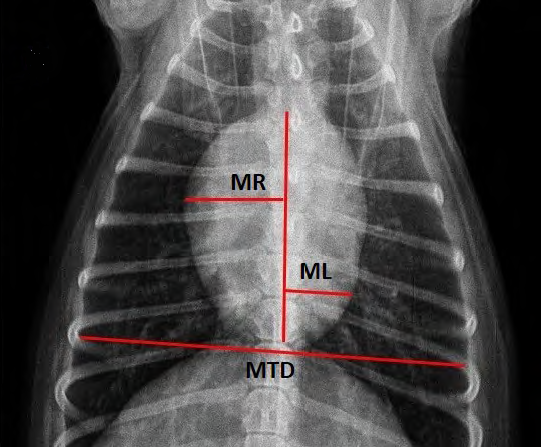 In
a
September 2016 article, a team of Brazilian veterinary researchers
propose using the Cardiothoracic Ratio (CTR) to measure heart
enlargement. The CTR is a scheme previously proposed by others for
assessing human heart enlargement. Using the "dorsoventral" x-ray of the dog's heart (see
the photo at right here, from the article), the CTR is calculated
by adding the largest distance from the heart's vertical center line to
the right side of the heart (MR) and the largest distance from that line
to the left side (ML). Then divide that combined amount by the greatest
thoracic diameter (MTD).
In
a
September 2016 article, a team of Brazilian veterinary researchers
propose using the Cardiothoracic Ratio (CTR) to measure heart
enlargement. The CTR is a scheme previously proposed by others for
assessing human heart enlargement. Using the "dorsoventral" x-ray of the dog's heart (see
the photo at right here, from the article), the CTR is calculated
by adding the largest distance from the heart's vertical center line to
the right side of the heart (MR) and the largest distance from that line
to the left side (ML). Then divide that combined amount by the greatest
thoracic diameter (MTD).
CTR = MR + ML
MTD
In that article, the Brazilian researchers compared the VHS with the CTR in poodles and concluded:
"Our results demonstrated that VHS and CTR showed strong correlation in their measurements, suggesting that CTR, constantly used in humans, could be considered as a tool to assess the size of the heart silhouette in dogs of the poodle breed."
September 2016:
CSU vets aptly summarize using anesthesia on MVD-affected dogs.
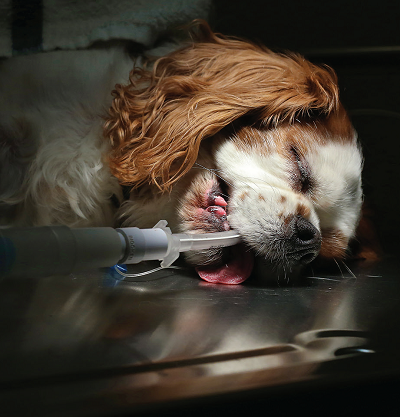 In
the
August 2016 issue of Clinician's Brief, Colorado State University
veterinarians Khursheed Mama and Marisa Ames thoroughly summarize the
current views on the use of anesthesia on dogs in varying stages
of mitral valve disease, as well as with common concurrent disorders.
They state:
In
the
August 2016 issue of Clinician's Brief, Colorado State University
veterinarians Khursheed Mama and Marisa Ames thoroughly summarize the
current views on the use of anesthesia on dogs in varying stages
of mitral valve disease, as well as with common concurrent disorders.
They state:
"Proper anesthetic management of patients with cardiac disease depends on the nature and severity of the disease. In a broad sense, the anesthetic approach to the cardiac patient is different for compensated vs decompensated heart disease. In addition, concurrent disease and requisite supportive therapies can cause decompensation of previously compensated heart disease. Understanding the underlying structural abnormalities and resultant physiologic consequences can influence the anesthesia protocol, periprocedural monitoring, and plans for emergency interventions."
August 2016: The EPIC Trial's final report is expected soon. The EPIC Trial is a 360 dog study by 36 cardiologists to determine if and when pimobendan can safely and effectively be prescribed to dogs affected by mitral valve disease but before heart failure -- that is, dogs which are "asymptomatic"*. The final report has been accepted by the publisher and is expected to be published soon. Roughly 45% of the dogs in the study were cavalier King Charles spaniels.
* Asymptomatic means that the dog has mitral valve regurgitation but does not display any signs or symptoms of heart failure, such as lung congestion, coughing, lethargy, hind leg weakness, etc.
 The report will show
that treatment with pimobendan of some MVD-affected dogs prior to heart failure will lengthen the
time period before the onset of heart failure, over dogs which were
given only a placebo. We may expect to find that the
recommendation with be to start dosing pimobendan once the dog is
determined to have moderate to severe mitral valve regurgitation and
significant heart enlargement as determined by two specific
echocardiograph measurements and one x-ray measurement. Also, other echo
parameters, such as the fractional shortening percentage, will be a
factor in making the determination.
The report will show
that treatment with pimobendan of some MVD-affected dogs prior to heart failure will lengthen the
time period before the onset of heart failure, over dogs which were
given only a placebo. We may expect to find that the
recommendation with be to start dosing pimobendan once the dog is
determined to have moderate to severe mitral valve regurgitation and
significant heart enlargement as determined by two specific
echocardiograph measurements and one x-ray measurement. Also, other echo
parameters, such as the fractional shortening percentage, will be a
factor in making the determination.
An overall consequence of this report likely will be that cardiologists and internal medicine specialists will be playing a much larger role in treating dogs with asymptomatic MVD, because of the requirement of careful measurements of the heart using ultrasound, to determine if pimobendan would be an appropriate drug to start before heart failure.
July 2016: Japanese researchers find serum fatty acids differ between dogs with and without MVD. In a July 2016 article by a team of Japanese cardiologists and others (Hiroki Yoshimatsu, Hirotaka Matsumoto, Masanari Minamoto, Ryohei Suzuki, Yohei Mochizuki, Takahiro Teshima, Hidekazu Koyama), they studied 30 dogs with various stages of mitral valve disease, including seven cavalier King Charles spaniels, to determine whether serum fatty acid concentrations in dogs with MVD differ from those in normal dogs (12 healthy dogs, including 1 CKCS). They found that several fatty acid concentrations were significantly lower in dogs with MVD, and that some of these concentrations and ratios correlated with echocardiographic parameters.
June 2016:
USA study finds small breed dogs in heart failure live 100+ days longer
if treated by cardiologists.
 In a
July 2016 article by a
pair of Virginia cardiologists (Bonnie K. Lefbom [right], Neal K. Peckens), they
studied 26 small breed dogs in congestive heart failure due to mitral
valve disease and compared the survival times of MVD-affected dogs
treated solely by primary care veterinarians with the survival times of
MVD-affected dogs treated in collaboration by primary care vets and
board certified cardiologists. They found that dogs which received
colaborative care had a median survival time of 254 days, while dogs
treated only by primary care vets had a median survival time of 146
days. They also found that the longer vets can keep alive dogs in heart
failure, the more revenue the primary care vets earn.
In a
July 2016 article by a
pair of Virginia cardiologists (Bonnie K. Lefbom [right], Neal K. Peckens), they
studied 26 small breed dogs in congestive heart failure due to mitral
valve disease and compared the survival times of MVD-affected dogs
treated solely by primary care veterinarians with the survival times of
MVD-affected dogs treated in collaboration by primary care vets and
board certified cardiologists. They found that dogs which received
colaborative care had a median survival time of 254 days, while dogs
treated only by primary care vets had a median survival time of 146
days. They also found that the longer vets can keep alive dogs in heart
failure, the more revenue the primary care vets earn.
June 2016:
Studies
find that most published research findings are false and that most clinical research is not useful,
with clinical evidence becoming an industry advertisement tool.
 In a
June 2016
article, "Why Most Clinical Research Is Not Useful". Prof. John P. A. Ioannidis (right) of the Stanford University
medical school reports that most clinical research is not useful. His
article follows one he wrote in
August
2005, titled "Why Most Published Research Findings Are False" and
another more recently, in
May 2016
titled "Evidence-based medicine has been hijacked". He
defines clinical research as experimental intervention studies, which
include all types of investigation that address questions on the
treatment, prevention, diagnosis/screening, or prognosis of disease or
enhancement and maintenance of health. He states that "clinical
evidence [is] becoming an industry advertisement tool".
In a
June 2016
article, "Why Most Clinical Research Is Not Useful". Prof. John P. A. Ioannidis (right) of the Stanford University
medical school reports that most clinical research is not useful. His
article follows one he wrote in
August
2005, titled "Why Most Published Research Findings Are False" and
another more recently, in
May 2016
titled "Evidence-based medicine has been hijacked". He
defines clinical research as experimental intervention studies, which
include all types of investigation that address questions on the
treatment, prevention, diagnosis/screening, or prognosis of disease or
enhancement and maintenance of health. He states that "clinical
evidence [is] becoming an industry advertisement tool".
 June 2016:
Researchers may have an explanation for why ACE-inhibitors often are
ineffective in treating cavaliers prior to heart failure.
In a
June 2016 abstract, an international team of cardiologists (Kathryn
Meurs, Maria Josefine Reimann, Lisbeth Høier Olsen) studied the
angiotensin converting enzyme (ACE) activity in 62 cavaliers for
variations in responses to ACE-inhibitor therapy. They found that the
DNA of a large majority of these CKCSs -- 61% -- had common ACE mutation
(polymorphism) which results in them having a lower baseline level of
ACE activity.
June 2016:
Researchers may have an explanation for why ACE-inhibitors often are
ineffective in treating cavaliers prior to heart failure.
In a
June 2016 abstract, an international team of cardiologists (Kathryn
Meurs, Maria Josefine Reimann, Lisbeth Høier Olsen) studied the
angiotensin converting enzyme (ACE) activity in 62 cavaliers for
variations in responses to ACE-inhibitor therapy. They found that the
DNA of a large majority of these CKCSs -- 61% -- had common ACE mutation
(polymorphism) which results in them having a lower baseline level of
ACE activity.
June 2016: Tufts study of 43 dogs (9 CKCSs) shows median survival time in Stage D MVD is nearly a year. In a June 2016 abstract, a team of Tufts University researchers (Amelie Beaumier, John E. Rush, Lisa M. Freeman) reviewed 43 cases of dogs in Stage D of mitral valve disease (MVD). Nine of the dogs were cavalier King Charles spaniels. In summary:
• Median duration between diagnosis of congestive heart failure (CHF) and Stage D was 157 days.
• Median duration between diagnosis of Stage D and death was 311 days.
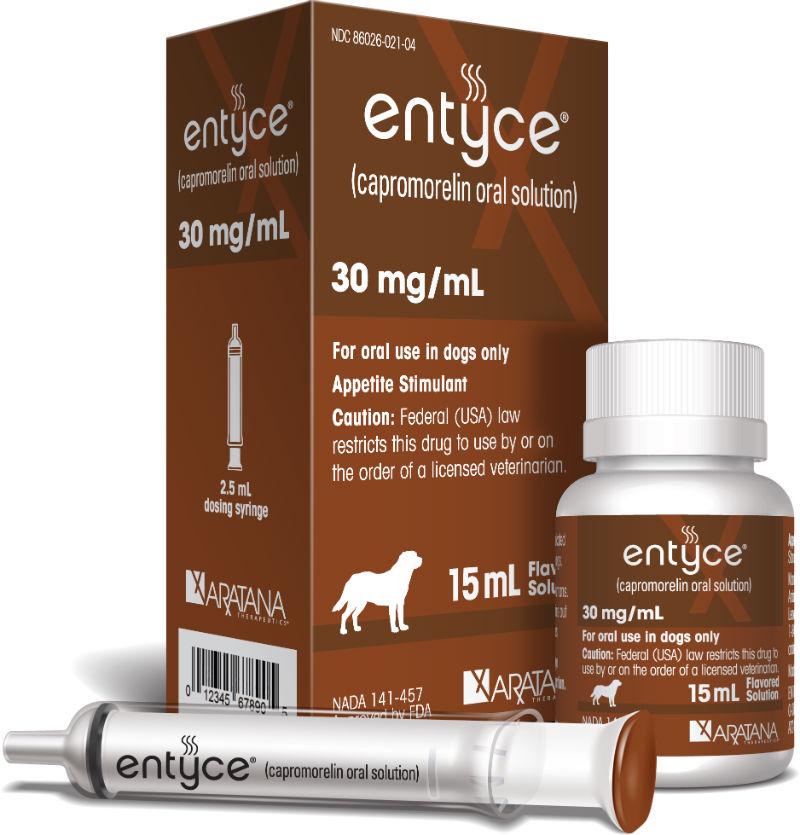 June 2016:
FDA approves an appetite stimulant for ill dogs which will not eat.
The USA's Food & Drug Administration (FDA) has just approved the canine
appetite stimulant Entyce (capromorelin). Capromorelin is a ghrelin
receptor agonist which mimics the activity of ghrelin, a hormone which
reportedly causes a sense of hunger. This drug may be helpful for
cavaliers in end-stage MVD --
Stage D -- which refuse to eat. The FDA
approval was issued on May 16, 2016 and grants exclusivity to its owner,
Aratana Therapeutics, Inc., through February 25, 2020. The product is
expected to be available as a prescription drug beginning in February
2017. For more information, check out
this webpage.
June 2016:
FDA approves an appetite stimulant for ill dogs which will not eat.
The USA's Food & Drug Administration (FDA) has just approved the canine
appetite stimulant Entyce (capromorelin). Capromorelin is a ghrelin
receptor agonist which mimics the activity of ghrelin, a hormone which
reportedly causes a sense of hunger. This drug may be helpful for
cavaliers in end-stage MVD --
Stage D -- which refuse to eat. The FDA
approval was issued on May 16, 2016 and grants exclusivity to its owner,
Aratana Therapeutics, Inc., through February 25, 2020. The product is
expected to be available as a prescription drug beginning in February
2017. For more information, check out
this webpage.
April 2016:
Researchers summarize pimobendan's adverse effects
reported in dogs with mild mitral valve insufficiency.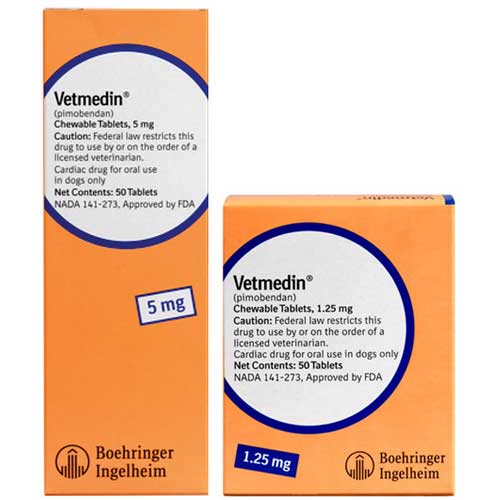 In a
March 2016
article, a team of Japanese veterinary researchers summarized the
current peer-reviewed studies finding that pimobenan can cause adverse
effects, including the acceleration of mitral valve degeneration, in
dogs. They stated:
In a
March 2016
article, a team of Japanese veterinary researchers summarized the
current peer-reviewed studies finding that pimobenan can cause adverse
effects, including the acceleration of mitral valve degeneration, in
dogs. They stated:
"Pimobendan (PIMO) can cause adverse effects, such as mitral valve degeneration, in dogs. ... Despite the benefits of treatment, adverse effects have been reported with the use of PIMO in dogs. In a case report of two dogs with mitral insufficiency, a long-term administration of PIMO worsened mitral regurgitation and ventricular hypertrophy. Similarly, in dogs with mild mitral insufficiency, the long-term administration of PIMO was shown to worsen mitral regurgitation and valve lesions. Adverse effects on mitral valves were considered to occur because of increasing cardiac contraction, but it was unclear whether PIMO directly affected the mitral valves."
April 2016: Dutch government singles out cavaliers in a study asking "Are purebreds really less healthy than crossbreeds?". The Dutch Ministry of Economic Affairs, Agriculture and Innovation has commissioned a study to answer the questions:
• Are purebreds really less healthy than crossbreeds?
• Is there a difference even between a purebred with pedigree and its look-alike without?
• What can be done if so?
Utrecht University has been assigned to research this pilot project:
"To what extend occur harmful breed characteristics and heritable disorders in The Bernese Mountain Dog, The Dutch Shepherd Dog, the Cavalier King Charles Spaniel and the Maine Coon Cat in the Netherlands?"
In September 2016, the university will publish a list with the most important disorders in the cavalier in the Netherlands. See this April 2016 article for more details.
April 2016: Orthopedic
Foundation for Animals (OFA) creates new database for MVD.
 As of
April 1, OFA has joined with the American College of Veterinary Internal
Medicine (ACVIM) to create a new "Advanced Cardiac Database" to
distinguish between congenital and what OFA has labeled "adult-onset"
cardiac diseases. It will serve two primary purposes:
As of
April 1, OFA has joined with the American College of Veterinary Internal
Medicine (ACVIM) to create a new "Advanced Cardiac Database" to
distinguish between congenital and what OFA has labeled "adult-onset"
cardiac diseases. It will serve two primary purposes:
"1. Develop an appropriate screening protocol for adult onset cardiac diseases; and
2. Begin collecting better data on cardiac disease prevalence and progression in the purebred dog."
According to OFA, the examinations for the Advanced Cardiac Database must be performed by board certified veterinary cardiologists. This is a huge step forward for OFA. Previously, practitioner veterinarians have been allowed to perform these tests for OFA's database purposes.
The most significant change will be the reporting procedure to OFA. Previously, the only copy of the veterinarian's exam report was given to the dog's owner, to either submit to OFA for its database or to not do so. Hereafter, the new OFA advanced cardiac examination forms will be in triplicate. Regardless of whether or not the owner sends his copy of the form to OFA for official certification, the examining cardiologist will retain one copy of the form and submit it to OFA and the ACVIM. As in the past, one copy of the completed exam form will be given to the dogs owner. The cardiologist will submit a copy of the form to OFA, to be used only to record results on its database, in order to collect better heart disease prevalence and progression data by breed. If the cardiologist also performs an echocardiogram, the new form's echo section is far more detailed, to collect statistics regarding flow rates, velocities, etc.
The dog's owner's responsibility for obtaining an official OFA clearance certification number remains the same as in the past. Owners must submit their copy of the completed, signed form to OFA along with the filing fee. OFA clearances under the Advanced Cardiac Database will be valid for only 12 months. If the owner wants the adult onset cardiac clearance to remain current, repeat exams will be necessary.
For more information, see OFA's press release here.
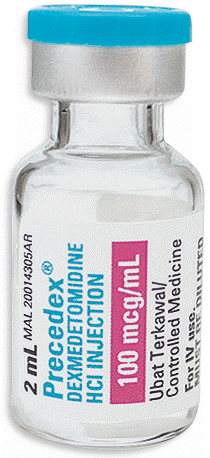 March 2016:
Study shows that the heart x-ray and echo sedative dexmedetomidine can
cause false diagnoses of MVD and heart enlargement.
Dexmedetomidine often is used to sedate dogs before heart x-rays and
echocardiographs. In a January 2016 report, a team of
Taiwan researchers examined the effects of dexmedetomidine on six
heart-healthy dogs undergoing chest x-rays and echocardiograms to
determine if the sedative caused any changes in the resulting
measurements. They found that the x-rays and echos performed after
dosing dexmedetomidine resulted in significantly higher measurements of
the vertebral heart score and cardiac size, and that moderate to severe
mitral regurgitation and mild pulmonary regurgitation occurred in all
six dogs. They concluded:
March 2016:
Study shows that the heart x-ray and echo sedative dexmedetomidine can
cause false diagnoses of MVD and heart enlargement.
Dexmedetomidine often is used to sedate dogs before heart x-rays and
echocardiographs. In a January 2016 report, a team of
Taiwan researchers examined the effects of dexmedetomidine on six
heart-healthy dogs undergoing chest x-rays and echocardiograms to
determine if the sedative caused any changes in the resulting
measurements. They found that the x-rays and echos performed after
dosing dexmedetomidine resulted in significantly higher measurements of
the vertebral heart score and cardiac size, and that moderate to severe
mitral regurgitation and mild pulmonary regurgitation occurred in all
six dogs. They concluded:
"Findings indicated that dexmedetomidine could cause false-positive diagnoses of valvular regurgitation and cardiomegaly in dogs undergoing thoracic radiography and echocardiography."
February 2016:
UK Kennel Club's 2014 Health Survey shows 10 years is the average
lifespan of CKCSs. In a
February 2016 report, the UK Kennel Club published its 2014 breed
health survey of the cavalier
 King Charles spaniel. The most commonly
reported disease condition in live CKCSs was heart (cardiac) murmur. The
leading cause of death was cardiac related at 37.67% of the reported
deceased dogs. The median longevity for the cavalier was 10 years. By comparison, the
2004 Health Survey results were similar except for the breed's
average lifespan. The median longevity for the cavalier King Charles
spaniel in the 2004 survey was 11 years, 5 months, which was
significantly higher than the 10 years in the 2014 report. In both
surveys, the most commonly reported
disease condition in live dogs was heart (cardiac) murmur. Similarly, the most
commonly reported cause of death was cardiac (heart) failure, at 42.8%
of the reported deceased dogs in 2004.
King Charles spaniel. The most commonly
reported disease condition in live CKCSs was heart (cardiac) murmur. The
leading cause of death was cardiac related at 37.67% of the reported
deceased dogs. The median longevity for the cavalier was 10 years. By comparison, the
2004 Health Survey results were similar except for the breed's
average lifespan. The median longevity for the cavalier King Charles
spaniel in the 2004 survey was 11 years, 5 months, which was
significantly higher than the 10 years in the 2014 report. In both
surveys, the most commonly reported
disease condition in live dogs was heart (cardiac) murmur. Similarly, the most
commonly reported cause of death was cardiac (heart) failure, at 42.8%
of the reported deceased dogs in 2004.
February 2016:
NC
State's Kate Meurs researches causes of MVD in cavaliers.
Dr.
Kate Meurs (right) a
 board certified cardiologist and geneticist at North
Carolina State University's veterinary school, is heading a research
team which hopes to identify genetic variants that lead to the
development of mitral valve degeneration in cavalier King Charles
spaniels (and other breeds), and use that information to innovate
treatment and prevention plans for dogs with high-risk DNA variants. She
stated:
board certified cardiologist and geneticist at North
Carolina State University's veterinary school, is heading a research
team which hopes to identify genetic variants that lead to the
development of mitral valve degeneration in cavalier King Charles
spaniels (and other breeds), and use that information to innovate
treatment and prevention plans for dogs with high-risk DNA variants. She
stated:
"I firmly believe that once you really understand a disease etiology, you can most effectively develop treatments for the primary disease, and gradually remove or at least reduce the disease prevalence in the population."
She has received an award of funds for this research from the Morris Animal Foundation, and she is seeking funds from other sources.
 February 2016:
UK researchers find cell changes are similar in cavaliers and mixed
breeds with advanced MVD. In a
February 2016 article by a
team of UK cardiology researchers (C.-C. Lu, M.-M. Liu, G. Culshaw, Anne
French [right], B. Corcoran), they compared the cellular changes in six
cavalier King Charles spaniels (CKCS) with four mixed breed dogs, all
with severe mitral valve disease (MVD). They found no significant
differences in the cell marker expression in the two groups and
concluded:
February 2016:
UK researchers find cell changes are similar in cavaliers and mixed
breeds with advanced MVD. In a
February 2016 article by a
team of UK cardiology researchers (C.-C. Lu, M.-M. Liu, G. Culshaw, Anne
French [right], B. Corcoran), they compared the cellular changes in six
cavalier King Charles spaniels (CKCS) with four mixed breed dogs, all
with severe mitral valve disease (MVD). They found no significant
differences in the cell marker expression in the two groups and
concluded:
"In conclusion, this study confirms that there is no evidence for inflammatory cell involvement in canine MMVD, that the cell changes appear similar for CKCS as for other dogs, and that the changes in cell numbers in MMVD are possibly due to cell proliferation. This study suggests that MMVD is not a heterogeneous disease, at least in terms of cellular changes and that the CKCS form of the disease differs only in its time of onset and speed of progression. However, the pathogenesis of MMVD is unknown and it is possible different mechanisms could result in the same end-stage findings. From these studies it would be reasonable to presume that studies of any dog with MMVD are applicable to all dogs and breeds."
January 2016:
Japanese researchers find the right ventricular Tei-index (RVTX)
"strongly correlated with early death in dogs with MMVD".
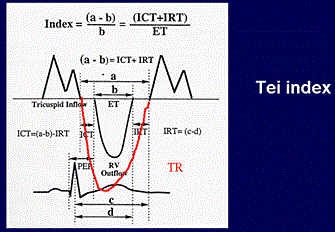 In a
January 2016 article, a team of Hokkaido University, Japan,
veterinary researchers (K. Nakamura, T. Morita, T. Osuga, K. Morishita,
N. Sasaki, H. Ohta, M. Takiguchi) calculated the "right ventricular
Tei-index" (RVTX)* of 30 dogs diagnosed with MVD by echocardiograph. The
dogs were included in Group A (19 dogs) if they survived a year from
their first echo, and in Group B (11 dogs) if they suffered
cardiac-related death within that year. A lack of tricuspid
regurgitation (TR) velocity in 2 of the 11 dogs in Group B disqualified
them. All of the remaining 9 Group B dogs
(which died during the first year) had increased RVTX (>0.61). Three of
the dogs with lower RVTX (<0.61) died before the study ended but
after the first year, and the 18
other dogs with lower RVTX were alive when the study ended.
In a
January 2016 article, a team of Hokkaido University, Japan,
veterinary researchers (K. Nakamura, T. Morita, T. Osuga, K. Morishita,
N. Sasaki, H. Ohta, M. Takiguchi) calculated the "right ventricular
Tei-index" (RVTX)* of 30 dogs diagnosed with MVD by echocardiograph. The
dogs were included in Group A (19 dogs) if they survived a year from
their first echo, and in Group B (11 dogs) if they suffered
cardiac-related death within that year. A lack of tricuspid
regurgitation (TR) velocity in 2 of the 11 dogs in Group B disqualified
them. All of the remaining 9 Group B dogs
(which died during the first year) had increased RVTX (>0.61). Three of
the dogs with lower RVTX (<0.61) died before the study ended but
after the first year, and the 18
other dogs with lower RVTX were alive when the study ended.
Notwithstanding the small number of dogs involved, the researchers concluded:
"The results of the present study indicate that RVTX is strongly correlated with early death in dogs with MMVD. Although several echocardiographic variables were significantly different between the two groups, we found that RVTX, a variable that corresponds to the RV function, was the most significant independent predictor of mortality. This study demonstrates that RV function analysis may be the most reliable prognostic indicator for dogs with MMVD."
*
 In 1995, Dr.
Chuwa Tei (right) devised an index of myocardial performance (the Tei index)
that evaluates the left ventrical (LV) systolic and diastolic function
in combination. The Tei index reportedly is a reliable method for the
evaluation of LV systolic and diastolic performance, with advantages
over previous indexes and prognostic value in many kinds of heart
disease. Calculation of the Tei index is a number calculated from the
ratio of time intervals (a-b/b) determined by pulsed Doppler
echocardiography. See
this December 1995 article,
this November 1996 article, and
this January 2005 article.
In 1995, Dr.
Chuwa Tei (right) devised an index of myocardial performance (the Tei index)
that evaluates the left ventrical (LV) systolic and diastolic function
in combination. The Tei index reportedly is a reliable method for the
evaluation of LV systolic and diastolic performance, with advantages
over previous indexes and prognostic value in many kinds of heart
disease. Calculation of the Tei index is a number calculated from the
ratio of time intervals (a-b/b) determined by pulsed Doppler
echocardiography. See
this December 1995 article,
this November 1996 article, and
this January 2005 article.
January 2016:
Researchers find dogs' heart enlargement in cases of MVD and DCM has
disease-specific causes and not just volume overload.
 In a
January 2016 article, a team of Polish veterinary researchers (Izabela
Janus [right], Agnieszka Noszczyk-Nowak, Marcin Nowak, Rafał Ciaputa, Małgorzata
Kandefer-Gola, Urszula Pasławska) studied 16 dogs with dilated
cardiomyopathy (DCM) and 15 with chronic mitral valve disease (MVD or
CMVD) to
determine the diseases relationship to enlargement of the dogs' hearts'
left atrial chambers. None of the dogs were cavalier King Charles
spaniels; the MVD-affected breeds were: 10 mixed-breed dogs, 2
dachshunds, 1 Cairn terrier, 1 miniature pinscher, and 1 German
pinscher. They concluded:
In a
January 2016 article, a team of Polish veterinary researchers (Izabela
Janus [right], Agnieszka Noszczyk-Nowak, Marcin Nowak, Rafał Ciaputa, Małgorzata
Kandefer-Gola, Urszula Pasławska) studied 16 dogs with dilated
cardiomyopathy (DCM) and 15 with chronic mitral valve disease (MVD or
CMVD) to
determine the diseases relationship to enlargement of the dogs' hearts'
left atrial chambers. None of the dogs were cavalier King Charles
spaniels; the MVD-affected breeds were: 10 mixed-breed dogs, 2
dachshunds, 1 Cairn terrier, 1 miniature pinscher, and 1 German
pinscher. They concluded:
"Dogs with dilated cardiomyopathy show a different distribution of connective tissue, have less severe intra-myocardial arterial narrowing, and have more severe degenerative changes in the cardiomyocytes of the left atrium compared to dogs with chronic mitral valve disease. The changes noted in the atrial tissue from dogs in both groups resemble lesions noted in the ventricular tissue of dogs with the same diseases. Those differences may indicate that the atrial enlargement noted in DCM and CMVD has a different, disease-specific underlying mechanism and does not result only from volume overload."
RETURN TO TOP
2015 News
December 2015: Study shows that the severity of asymptomatic MVD shows no association with serum C-reactive protein concentrations. In a March 2016 report, Swedish and Danish cardiologists (M.J. Reimann, I. Ljungvall, A. Hillstrom, J.E. Møller, R. Hagman, T. Falk, K. Hoglund, J. Haggstrom, L.H. Olsen) studied 188 dogs (156 of them being cavalier King Charles spaniels) with varying degrees of mitral valve disease (MVD), to determine whether serum C-reactive protein (CRP) concentrations are associated with the severity of MVD, using an automated canine-specific high-sensitivity CRP assay called "Gentian hsCRP". They found that serum CRP concentrations were mildly increased in dogs with congestive heart failure due to MVD, but that the severity of MVD in asymptomatic dogs showed no association with serum CRP concentrations.
December 2015:
Dr. Josh Stern gives up on finding MVD-free cavaliers for genetic
research.
 At the AKC Canine Health Foundation's 2015
National Parent Club Canine Health Conference, held in St. Louis,
Missouri in August, veterinary cardiologist
Josh Stern
(right) of the University of
California, Davis, spoke of the current status of genetic research into
mitral valve disease (MVD). He said that MVD is so widespread
among cavalier King Charles spaniels that researchers have not been able
to find enough MVD-free ("normal") CKCSs over the age of 10 years, to
be able to work with for genetic research. He spoke of finding only
three normal 10+ year old cavaliers out of 400 tested. He subsequently
told us that he was hoping to identify 48 CKCSs that are unrelated within
3 generations and have a normal echocardiogram at 10 years and was
unable to find them. He explained that, in order to be considered a
"control", the dogs must be old enough to expect that they would not
develop MVD at a later date. He wrote:
At the AKC Canine Health Foundation's 2015
National Parent Club Canine Health Conference, held in St. Louis,
Missouri in August, veterinary cardiologist
Josh Stern
(right) of the University of
California, Davis, spoke of the current status of genetic research into
mitral valve disease (MVD). He said that MVD is so widespread
among cavalier King Charles spaniels that researchers have not been able
to find enough MVD-free ("normal") CKCSs over the age of 10 years, to
be able to work with for genetic research. He spoke of finding only
three normal 10+ year old cavaliers out of 400 tested. He subsequently
told us that he was hoping to identify 48 CKCSs that are unrelated within
3 generations and have a normal echocardiogram at 10 years and was
unable to find them. He explained that, in order to be considered a
"control", the dogs must be old enough to expect that they would not
develop MVD at a later date. He wrote:
"Echocardiogram is the screening test that we require and it must be performed by a cardiologist. The 400 dogs mentioned were screened on both coasts and many places in between. They were not all over ten years - so please don't get the wrong idea. I'd love to find 400 senior cavaliers to screen but that doesn't seem very feasible despite our best attempts. If you have a dog that meets this criteria - please let me know! Feel free to email me if you are interested in supporting this research in some way! Jstern@ucdavis.edu."
As a result, he has turned his focus to another breed with a high incidence of MVD, the whippet. He is searching for a genetic marker associated with early-onset or severe MVD status in that breed. Dr. Stern is the principal investigator in the "Identification of genetic variants associated with myxomatous mitral valve degeneration in the whippet dog through whole-genome sequencing", sponsored by the AKC Canine Health Foundation, the Whippet Health Foundation, and the American Whippet Club. Hopefully, cavaliers will benefit indirectly from this ongoing research. Here is a link to his most recent whippet heart research.
As for his cavalier research, Dr. Stern has not given up. He explained:
"We are simply taking a different approach to the genetics of this condition and searching for genetic reasons that some CKCS have this as an early or more severe disease than others. This eliminates the need for such a large control group and has worked in other breeds recently! The prevalence in the cavalier is extremely high. This is not such a challenge in other breeds. It necessitates a fresh approach and that's what we are working on!"
November 2015:
Japanese surgeons study differences in mitral valve chordae tendineae to
determine where surgical repairs are most needed.
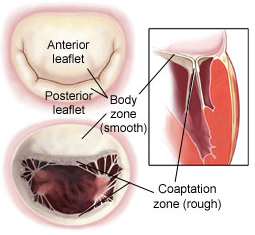 In an
October 2015 article, a team of Japanese veterinary heart surgeons
examined the physical differences in the chordae tendineae (chords)
supporting the mitral valve, particularly the anterior leaflet of the
valve. They found from echo exams of 12 MVD-affected dogs, including 5
cavalier King Charles spaniels, that in 75% of them the regurgitation
was occurring from the tip of the anterior leaflet (AL) of the valve.
(See diagram at right.*)
They also found that the tip of the AL (also called marginal chords) was
secured by chords which were thinner than those attached to the base of
the AL (also called strut chords). They noted that the strut chords are
wider than the marginal chords, and that the chords' strength is
proportional to their cross-sectional area, and that, therefore,
although the marginal chords have smaller loads than the strut chords,
they might be prone to elongation and breakage, due to fatigue, because
they are so thin. They noted that their studies suggest that although
the strut chordae tendineae, attached to the base of the AL, might be
slightly elongated, they were not the main cause of MR. The researchers
further found that the pathological change was more severe in the
posterior half of the AL than in the anterior half -- that the posterior
half of the AL might be more affected than the anterior half because of
its broader area, which subjects it to larger blood pressure loads. They
concluded that the marginal chords attached to the tip of the AL might
contribute to mitral regurgitation in dogs because those chords are
relatively thin. They therefore recommended that in mitral valve repair
surgery, the marginal chords should be reconstructed, since they secure
the tip of the valve cusp in the left ventricle for a good closure --
coaptation -- of
the mitral valve.
(See diagram at right above.*) They also pointed out that the posterior half of the
AL might require more artificial chords because it is broader than the
anterior half of the AL.
In an
October 2015 article, a team of Japanese veterinary heart surgeons
examined the physical differences in the chordae tendineae (chords)
supporting the mitral valve, particularly the anterior leaflet of the
valve. They found from echo exams of 12 MVD-affected dogs, including 5
cavalier King Charles spaniels, that in 75% of them the regurgitation
was occurring from the tip of the anterior leaflet (AL) of the valve.
(See diagram at right.*)
They also found that the tip of the AL (also called marginal chords) was
secured by chords which were thinner than those attached to the base of
the AL (also called strut chords). They noted that the strut chords are
wider than the marginal chords, and that the chords' strength is
proportional to their cross-sectional area, and that, therefore,
although the marginal chords have smaller loads than the strut chords,
they might be prone to elongation and breakage, due to fatigue, because
they are so thin. They noted that their studies suggest that although
the strut chordae tendineae, attached to the base of the AL, might be
slightly elongated, they were not the main cause of MR. The researchers
further found that the pathological change was more severe in the
posterior half of the AL than in the anterior half -- that the posterior
half of the AL might be more affected than the anterior half because of
its broader area, which subjects it to larger blood pressure loads. They
concluded that the marginal chords attached to the tip of the AL might
contribute to mitral regurgitation in dogs because those chords are
relatively thin. They therefore recommended that in mitral valve repair
surgery, the marginal chords should be reconstructed, since they secure
the tip of the valve cusp in the left ventricle for a good closure --
coaptation -- of
the mitral valve.
(See diagram at right above.*) They also pointed out that the posterior half of the
AL might require more artificial chords because it is broader than the
anterior half of the AL.
* Diagram is from Carpentier's Reconstructive Valve Surgery. Carpentier A, Adams DH, Filsoufi F. 2010; Saunders; Elsevier.
November 2015:
Denmark Kennel Club proves a rigorous mandatory MVD breeding protocol
works.
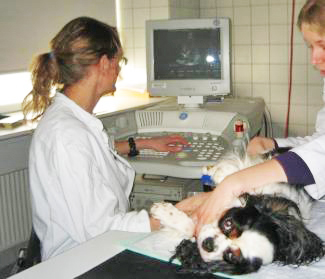 In a
November 2015 article, a team of Danish and
Swedish cardiologists (A.C. Birkegård, M.J. Reimann, T. Martinussen, J.
Haggstrom, H.D. Pedersen, L.H. Olsen [right]) report that the Danish Kennel
Club's 2001 mandatory MVD breeding scheme has reduced the risk of having
a mitral regurgitation murmur caused by MMVD by 73% among 997 cavalier
King Charles spaniels.
In a
November 2015 article, a team of Danish and
Swedish cardiologists (A.C. Birkegård, M.J. Reimann, T. Martinussen, J.
Haggstrom, H.D. Pedersen, L.H. Olsen [right]) report that the Danish Kennel
Club's 2001 mandatory MVD breeding scheme has reduced the risk of having
a mitral regurgitation murmur caused by MMVD by 73% among 997 cavalier
King Charles spaniels.
Denmark's MVD breeding guidelines are:
1. Dogs examined at 1½ years of age or older were approved for breeding until 4 years of age if cardiac health criteria were fulfilled.
2. To continue breeding after 4 years of age, the dogs had to be reexamined. In January 2007, an additional restriction was added, requiring a reexamination after 6 years of age for male dogs.
3. At all examination time points, dogs were excluded from breeding if they had MVP (mitral valve prolapse by echocardiograph) grade 3 or a mitral regurgitation murmur grade 3 or higher.
4. The degree of MVP was assessed as:
• Grade 0 (≤1.5 mm as the sum of the maximum protrusion of the cranial, caudal and coaption point of the mitral valve according to annulus plane)
• Grade 1 (>1.5 and ≤4.5 mm)
• Grade 2 (>4.5 and ≤7.5 mm)
• Grade 3 (>7.5 mm).
5. Dogs with grade 2 murmurs were excluded if they had:
• MVP grades 2 or 3;
• Mitral regurgitation murmur of 1 at a maximum combined with a MVP grade 2 at a maximum; or
• A grade 2 murmur combined with a degree of MVP not above grade 1.
• Before 2007, dogs with a grade 3 MVP were approved if they had a murmur grade not above 1.
The researchers concluded:
"Our study shows that a breeding scheme based on cardiac auscultation and echocardiography markedly decreased the risk of having a mitral regurgitation murmur caused by MMVD after an 8- to 10-year period. The reduction in risk was only significant for offspring where both parents had been approved by the breeding scheme (PB), not for offspring where 1 or both parents not were approved by the breeding scheme (non-PB). The risk of having moderate to severe MVP (MVP > 1) was not decreased after the 8- to 10-year period, but PB had lower risk of MVP > 1 than did non-PB within the years 2010 and 2011. ... A mandatory breeding scheme based on auscultation and echocardiography findings significantly decreased the prevalence of MMVD over the 8- to 10-year period. Such a breeding scheme therefore is recommended for CKCS."
October 2015:
Austrian cardio-surgeon performs mitral valve surgery on cavalier with
MVD.
 In a
February 2015 article, Austrian cardio-surgeon
Dr. Peter Modler (right) reports on a successful mitral valve
replacement surgery on a 6-year-old cavalier King Charles spaniel in
congestive heart failure. He stated:
In a
February 2015 article, Austrian cardio-surgeon
Dr. Peter Modler (right) reports on a successful mitral valve
replacement surgery on a 6-year-old cavalier King Charles spaniel in
congestive heart failure. He stated:
"Because of his rapid deterioration and the poor prognosis with medical therapy alone, mitral valve repair under CPB was discussed with the owners. Even though the prognosis was guarded given the marked systolic dysfunction the owners decided for the surgery. The procedure was scheduled four weeks later. In the mean time Pimobendan was increased to tid, and Spironolactone was added. On the day of surgery, Henri still had some degree of pulmonary edema. Thus, Torasemide was given 6 hrs before surgery. Systolic dysfunction had increased and some ventricular runs were noted on the Sono-ECG. Open heart mitral valve repair was performed (mitral annuloplasty, chordal replacement with Gore-Tex) on cardiopulmonary bypass. Cross-Clamp time was 85 min. After clamp removal and electrical defibrillation the heart started spontaneously in a sinus rhythm and blood pressure was immediately restored. The patient woke up 5 hrs after surgery and was able to walk a short distance after 7 hrs. He is now doing quite well, starts eating and walks around in the yard. The mitral valve coadaption has increased with mild residual regurgitation. Systolic function is markedly impaired but is improving day to day. The prognosis for this patient is still guarded given the number of possible complications and the fact that it is uncertain if systolic function will improve."
October 2015: Japan study of insured dogs shows the cavalier has the highest odds of having a cardiovascular disorder. In an October 2015 article, veterinary reports on 299,555 insured dogs in Japan for one year in 2010-2011 were analyzed for the prevalence of cardiovascular disorder diagnosis. Overall for the year, the prevalence was 2.1%. However, the cavalier King Charles spaniel had the highest odds, with a ratio of 16.2. Of the CKCSs, diagnostic reports of 5,743 were included, of which 779 had at least one claim of a cardiovascular disorder, for a prevalence of 13.6%. Male dogs had increased odds of 1.2, and the dogs had increased odds of having cardiovascular disorder by 1.5 times each year they aged.
October 2015: UK researchers compare echocardiography with cardiac magnetic resonance imaging in assessing MVD. In an October 2015 article, a team of neurologists, cardiologists, and radiologists (J. Sargent, D. J. Connolly, V. Watts, P. Mõtsküla, H. A. Volk, C. R. Lamb, V. Luis Fuentes) while MRI-scanning MVD-affected dogs for neurological disorders, also compared measuring mitral regurgitant fraction by echocardiograph scans and cardiac magnetic resonance imaging (CMR). In the context of human medicine, CMR is considered to be "a non-invasive gold standard" for quantification of ventricular volumes and for clinical evaluation of mitral regurgitation (MR). In this study, by comparing CMR to echocardiogram, the researchers were able to identify the echocardiographic measurements that are the most accurate and useful in screening MVD-affected dogs. Working with the results of 10 dogs, including cavalier King Charles spaniels, they found that echo measurements of vena contracta/aortic diameter and E-wave* velocity had the strongest correlations to CMR measurements of mitral regurgitation. They concluded:
"Measurement of cardiac magnetic resonance imaging-derived mitral regurgitant fraction is feasible but technically demanding. The echocardiographic measures that correlated most closely with cardiac magnetic resonance imaging-derived mitral regurgitant fraction were vena contracta/aortic diameter and E-wave velocity."
* E-wave is the initial rush of blood as soon as the mitral valve opens, causing a peak velocity.
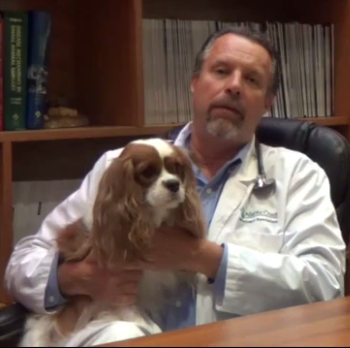 October
2015:
Cardiologist George Kramer seeks funding for his Tucker valve to prevent
backflow through heart valves. Dr. George Kramer (right), board
certified veterinary cardiologist with
Ultravet Medical
Devices, is seeking funds through an Indiegogo campaign to help
finance his research of the "Tucker valve". The mechanical
valve is designed to be inserted through the mitral valve or tricuspid
valve and block backflow of blood through the valve.
His YouTube video is linked here.
October
2015:
Cardiologist George Kramer seeks funding for his Tucker valve to prevent
backflow through heart valves. Dr. George Kramer (right), board
certified veterinary cardiologist with
Ultravet Medical
Devices, is seeking funds through an Indiegogo campaign to help
finance his research of the "Tucker valve". The mechanical
valve is designed to be inserted through the mitral valve or tricuspid
valve and block backflow of blood through the valve.
His YouTube video is linked here.
October 2015:
Dutch researchers determine that the optimum time for daily doses of
ACE-inhibitors to dogs in congestive heart failure is expected to be at
bedtime.
 In an
October 2015 article, Dutch researchers Jonathan Paul Mochel
(left) and
Meindert Danhof have developed an integrated
pharmacokinetic-pharmacodynamic model that captures the disposition
kinetics of the drug benazeprilat, as well as the time-varying changes
of systemic renin-angiotensin-aldosterone biomarkers. Based upon their
chronobiological investigations, they conclude that the optimal efficacy
of ACE inhibitors is expected with bedtime dosing. They note, however,
that their research "is not a static and completed piece of work but is,
instead, a starting point for further data integration and hypothesis
testing."
In an
October 2015 article, Dutch researchers Jonathan Paul Mochel
(left) and
Meindert Danhof have developed an integrated
pharmacokinetic-pharmacodynamic model that captures the disposition
kinetics of the drug benazeprilat, as well as the time-varying changes
of systemic renin-angiotensin-aldosterone biomarkers. Based upon their
chronobiological investigations, they conclude that the optimal efficacy
of ACE inhibitors is expected with bedtime dosing. They note, however,
that their research "is not a static and completed piece of work but is,
instead, a starting point for further data integration and hypothesis
testing."
September 2015:
Belgian researchers find the pulmonary-vein-to-pulmonary-artery ratio
increases with severity of MVD.
 In a
September 2015
article, a team of Belgian researchers (Anne-Christine Merveille
[right] , G. Bolen, E.
Krafft, E. Roels, S. Gomart, A.-L. Etienne, C. Clercx, K. Mc Entee)
performed echocardiographs on 98 dogs -- 61 of which were affected with
mitral valve disease (MVD), including 14 cavaliers -- to determine if
the pulmonary vein diameter-to-pulmonary artery diameter ratio (PV/PA)
can predict congestive heart failure (CHF). They found that the PV/PA
index in control dogs equalled approximately 1 and increased with class
of heart failure. They concluded:
In a
September 2015
article, a team of Belgian researchers (Anne-Christine Merveille
[right] , G. Bolen, E.
Krafft, E. Roels, S. Gomart, A.-L. Etienne, C. Clercx, K. Mc Entee)
performed echocardiographs on 98 dogs -- 61 of which were affected with
mitral valve disease (MVD), including 14 cavaliers -- to determine if
the pulmonary vein diameter-to-pulmonary artery diameter ratio (PV/PA)
can predict congestive heart failure (CHF). They found that the PV/PA
index in control dogs equalled approximately 1 and increased with class
of heart failure. They concluded:
"The PV/PA is a simple and reproducible echocardiographic variable that increases with class of heart failure and may help discriminate dogs in CHF from asymptomatic dogs with DMVD. Additional studies are required to determine whether PV/PA might provide additional information in the integrated interpretation of Doppler-echocardiographic indices of left ventricular filling pressures and could be used for rapid assessment of CHF in dogs in a critical care setting."
September 2015:
Swedish researchers find echocardiographic variables that can identify
pulmonary hypertension in dogs with MVD.
 In a
September
2015 article, a team of Swedish cardiologists (Anna Tidholm [right], K.
Hoglund, J. Haggstrom, I. Ljungvall) investigaged the diagnostic value
of echocardiographic variables related to pulmonary hypertension (PH) in
dogs affected with mitral valve disease (MVD). They studied 156 dogs,
including 27 cavaliers. They found that, among MVD-affected dogs, with
MMVD, the presence of PH might be suspected with the combination of
decreased pulmonary arterial acceleration to deceleration time ratio
(AT/DT), increased right ventricular end-diastolic and systolic internal
diameters, increased left atrial to aortic root ratio (LA/Ao), and a
small or great left ventricular end-diastolic and systolic internal
diameter.
In a
September
2015 article, a team of Swedish cardiologists (Anna Tidholm [right], K.
Hoglund, J. Haggstrom, I. Ljungvall) investigaged the diagnostic value
of echocardiographic variables related to pulmonary hypertension (PH) in
dogs affected with mitral valve disease (MVD). They studied 156 dogs,
including 27 cavaliers. They found that, among MVD-affected dogs, with
MMVD, the presence of PH might be suspected with the combination of
decreased pulmonary arterial acceleration to deceleration time ratio
(AT/DT), increased right ventricular end-diastolic and systolic internal
diameters, increased left atrial to aortic root ratio (LA/Ao), and a
small or great left ventricular end-diastolic and systolic internal
diameter.
September 2015:
Tufts researchers find possible cardiac cachexia preventative is well
tolerated by dogs in CHF.
 In a
September 2015 study, a team
of cardiologists and others from Tufts University's Cummings School of
Veterinary Medicine (Lisa M. Freeman, John E. Rush, Suzanne M.
Cunningham, Vicky K. Yang, Barret J. Bulmer) tested the myostatin
antagonist "CAP-031" on dogs suffering from "cardiac cachexia" (loss of
lean muscle mass due to MVD). Myostatin (growth differentiation factor 8
-- "GDF-8") is a protein which under some circumstances can interfere
with muscle growth. The study injected a myostatin blocker, "CAP-031",
into seven dogs suffering from both CHF and cardiac cachexia, to
determine whether the dogs could tolerate the drug and whether it
increased their muscle mass. At the end of the four week test, they
found no significant changes in body weight, body condition score,
appetite, or quality-of-life score; the change in the dogs' muscle
condition score was not statistically significant. They concluded:
In a
September 2015 study, a team
of cardiologists and others from Tufts University's Cummings School of
Veterinary Medicine (Lisa M. Freeman, John E. Rush, Suzanne M.
Cunningham, Vicky K. Yang, Barret J. Bulmer) tested the myostatin
antagonist "CAP-031" on dogs suffering from "cardiac cachexia" (loss of
lean muscle mass due to MVD). Myostatin (growth differentiation factor 8
-- "GDF-8") is a protein which under some circumstances can interfere
with muscle growth. The study injected a myostatin blocker, "CAP-031",
into seven dogs suffering from both CHF and cardiac cachexia, to
determine whether the dogs could tolerate the drug and whether it
increased their muscle mass. At the end of the four week test, they
found no significant changes in body weight, body condition score,
appetite, or quality-of-life score; the change in the dogs' muscle
condition score was not statistically significant. They concluded:
"The myostatin antagonist appeared to be well tolerated in most dogs. Earlier identification of cachexia is important, and randomized, controlled trials of myostatin antagonists or other drugs to treat cardiac cachexia are needed."
September 2015: Japanese cardiologists find overdose of pimobendan accelerates progression of MVD. In a September 2015 clinical report of a Shih Tzu not in heart failure, the dog ingested an overdose of its prescribed pimobendan. The team of treating cardiologists (Tsuyoshi Tokuriki, Yuichi Miyagawa, Naoyuki Takemura) reported:
"The present report describes the clinical condition of a dog who exhibited previously unreported temporary increases in the T wave amplitude in addition to hypertension, tachycardia, increased grades of cardiac murmurs, increased fractional shortening (FS), and systolic anterior motion of the mitral valve (SAM) following the overingestion of pimobendan."
They concluded:
"These findings suggest that it is necessary to monitor T/R [T wave to R wave amplitude ratio], SAM, and systemic hypertension in dogs who have ingested a large amount of pimobendan."
September 2015: International team of cardiologists and nephrologists issue a Consensus Statement on cardio-renal disorders. In a September 2015 report, a team of 9 veterinary cardiologists and 7 veterinary nephrologists from Europe and North America (J. L. Pouchelon, C. E. Atkins, C. Bussadori, M. A. Oyama, S. L. Vaden, J. D. Bonagura, V. Chetboul, L. D. Cowgill, J. Elliot, T. Francey, G. F. Grauer, V. Luis Fuentes, N. Sydney Moise, D. J. Polzin, A. M. Van Dongen, N. Van Israël) have issued a "Consensus Statement" to increase the awareness of and codify the definition, classification, diagnosis, and management strategies for veterinary patients with cardio-renal syndrome (CRS), with an emphasis on the pathological interplay between the two organ systems. They acknowledge "a growing understanding of the complexity of interplay between renal and cardiovascular systems in both health and disease."
 They
have observed: "The concept of CRS, which involves a bidirectional
pathway of injury wherein disease of either organ directly or indirectly
contributes to injury of the other." And they have included a chart
showing postulated mechanisms underlying the relationship between heart
failure (HF) and renal dysfunction. (Click on the thumbnail chart at
right.)
They
have observed: "The concept of CRS, which involves a bidirectional
pathway of injury wherein disease of either organ directly or indirectly
contributes to injury of the other." And they have included a chart
showing postulated mechanisms underlying the relationship between heart
failure (HF) and renal dysfunction. (Click on the thumbnail chart at
right.)
Among their consensus statements, are:
"Statement 8: Thoracic radiography is recommended to assess the presence or absence of congestive heart failure, and echocardiography is recommended to assess cardiac morphology, lesions, and to estimate relevant haemodynamic parameters.
"Statement 9: Renal imaging is recommended to improve diagnosis, prognosis and guide potential therapies in CvRD. Conventional abdominal radiographs and ultrasound are recommended to help detect morphological abnormalities and determine underlying aetiology.
"Statement 10: As the kidney and heart are two organs at risk for damage due to systemic hypertension, and as kidney disease is often associated with systemic arterial hypertension, systemic arterial blood pressure should be systematically monitored in both kidney and cardiovascular diseases. * * *
"Statement 13: ... particular attention should be directed towards the following when managing any form of [CRS]: 1) identification and treatment of elevated blood pressure as per IRIS recommendations; 2) stepwise titration of dosages of diuretics, ACEI, inotropes and/or fluids with frequent monitoring of renal function, body weight, hydration, electrolyte status, and systemic blood pressure (i.e. performed and rechecked within 3-5 days following initiation or dose adjustment of these drugs); 3) proper nutrition, with respect to reduced dietary sodium and phosphate and appropriate protein and caloric intake."
September 2015:
 Study of healthy hounds finds enalapril suppresses ACE activity but does
not suppress circulating RAAS. In an
October 2015 study, US
cardiologists (A. C. Lantis [right], M. K. Ames, S. Werre, C.
E. Atkins) tested enalapril on 16 healthy hounds to evaluate
enalapril's ability to suppress angiotensin-converting enzyme (ACE) and
also furosemide-induced circulating activation of the renin-angiotensin
aldosterone system (RAAS). They found that, as with benazepril,
enalapril inhibited ACE activity but did not significantly reduce
aldosterone excretion. They concluded, therefore, that " that failure to
suppress aldosterone suppression with furosemide stimulation may be a
drug class effect."
Study of healthy hounds finds enalapril suppresses ACE activity but does
not suppress circulating RAAS. In an
October 2015 study, US
cardiologists (A. C. Lantis [right], M. K. Ames, S. Werre, C.
E. Atkins) tested enalapril on 16 healthy hounds to evaluate
enalapril's ability to suppress angiotensin-converting enzyme (ACE) and
also furosemide-induced circulating activation of the renin-angiotensin
aldosterone system (RAAS). They found that, as with benazepril,
enalapril inhibited ACE activity but did not significantly reduce
aldosterone excretion. They concluded, therefore, that " that failure to
suppress aldosterone suppression with furosemide stimulation may be a
drug class effect."
August 2015:
Japanese researchers find that vitamin D concentration declines with the
progression of MVD in dogs, including cavaliers.
 In an
August 2015 study, a team of Japanese researchers (T. Osuga, K.
Nakamura, T. Morita, S.Y. Lim, K. Nisa, N. Yokoyama, N. Sasaki, K.
Morishita, H. Ohta, M. Takiguchi) examined vitamin D concentrations --
specifically serum 25-hydroxyvitamin D (25(OH)D) concentrations -- in 43
MVD-affected dogs, including 4 cavalier King Charles spaniels. They
observed that serum 25(OH)D concentration begins to decrease before the
onset of heart failure in MVD-affected dogs, and that vitamin D status
is associated with the extent of heart enlargement.
In an
August 2015 study, a team of Japanese researchers (T. Osuga, K.
Nakamura, T. Morita, S.Y. Lim, K. Nisa, N. Yokoyama, N. Sasaki, K.
Morishita, H. Ohta, M. Takiguchi) examined vitamin D concentrations --
specifically serum 25-hydroxyvitamin D (25(OH)D) concentrations -- in 43
MVD-affected dogs, including 4 cavalier King Charles spaniels. They
observed that serum 25(OH)D concentration begins to decrease before the
onset of heart failure in MVD-affected dogs, and that vitamin D status
is associated with the extent of heart enlargement.
August 2015: Thai researchers find plasma Galectin-3 increases with cardiac fibrosis in MVD-affected dogs. In an April 2015 abstract, Thai researchers (S. Sakarin, A. Rungsipipat, S. Disatian Surachetpong) report finding that MVD-affected dogs have more cardiac fibrosis compared to normal dogs, and that plasma Galectin-3 (Gal-3) concentration was increased in MVD-dogs. They concluded that the results suggested that the expression of Gal-3 is associated with cardiac fibrosis. See also, this January 2016 article about the same study, in which these researchers concluded that Gal-3 expression in cardiac muscle was associated with cardiac fibrosis, and that tissue Gal-3 is a candidate of fibrosis biomarker in MVD, but that further investigation of associations between plasma Gal-3 and myocardial fibrosis is necessary.
August 2015:
Study of MVD-affected dogs shows a progressive inflammatory component.
 A team of European cardiologists
and researchers (Zoe S. Polizopoulou (right), Christos K.
Koutinas, Jose J. Cerón, Asta Tvarijonaviciute, Silvia Martínez-Subiela,
Anastasia Dasopoulou, Malcolm J. York, Ian F. Roman, Mitul Gandhi, Sonal
Patel, Peter J. O'Brien) compared serum cardiac troponin I and
CRP concentrations in 46 dogs diagnosed with MVD, in an
August 2015
report. They divided the dogs by severity of the disease (group I:
asymptomatic; group II: mild to moderate CHF; group III: advanced CHF),
and they measured concentrations of cardiac troponin I (cTnI),
C-reactive protein (CRP), ceruloplasmin (Cp), and haptoglobin (Hp)
bimonthly over a 4-month period. The researchers found a "statistically
significant difference" in CRP concentrations between MVD-affected dogs
as their MVD progressed from asymptomatic to advanced heart failure.
They noted that CRP concentrations were "significantly higher" in the
asymptomatic group, and that:
A team of European cardiologists
and researchers (Zoe S. Polizopoulou (right), Christos K.
Koutinas, Jose J. Cerón, Asta Tvarijonaviciute, Silvia Martínez-Subiela,
Anastasia Dasopoulou, Malcolm J. York, Ian F. Roman, Mitul Gandhi, Sonal
Patel, Peter J. O'Brien) compared serum cardiac troponin I and
CRP concentrations in 46 dogs diagnosed with MVD, in an
August 2015
report. They divided the dogs by severity of the disease (group I:
asymptomatic; group II: mild to moderate CHF; group III: advanced CHF),
and they measured concentrations of cardiac troponin I (cTnI),
C-reactive protein (CRP), ceruloplasmin (Cp), and haptoglobin (Hp)
bimonthly over a 4-month period. The researchers found a "statistically
significant difference" in CRP concentrations between MVD-affected dogs
as their MVD progressed from asymptomatic to advanced heart failure.
They noted that CRP concentrations were "significantly higher" in the
asymptomatic group, and that:
"Differences in CRP concentrations between clinical stages of MVD suggest a clinically and therapeutically relevant inflammatory component."
August 2015:
UK research points to gene expression causing the transition of cells in
the development of MVD in cavaliers.
 In an
August 2015 study
published by a team of UK cardiologists and researchers (Chi-Chien Lu,
Meng-Meng Liu, Michael Clinton, Geoff Culshaw, David J. Argyle, Brendan
M. Corcoran [right]), they examined the mitral valve leaflets of 14 deceased
cavalier King Charles spaniels which had suffered from MVD, and compared
them with the leaflets of 5 unaffected mixed breed dogs. The aim of
their study was to investigate the possibility of re-activation --
meaning post-embryotic -- and recruitment of developmental
processes MVD, such as the transition of epithelial cells and
endothelial cells to mesenchymal cells.
In an
August 2015 study
published by a team of UK cardiologists and researchers (Chi-Chien Lu,
Meng-Meng Liu, Michael Clinton, Geoff Culshaw, David J. Argyle, Brendan
M. Corcoran [right]), they examined the mitral valve leaflets of 14 deceased
cavalier King Charles spaniels which had suffered from MVD, and compared
them with the leaflets of 5 unaffected mixed breed dogs. The aim of
their study was to investigate the possibility of re-activation --
meaning post-embryotic -- and recruitment of developmental
processes MVD, such as the transition of epithelial cells and
endothelial cells to mesenchymal cells.
"Epithelial cells" line the cavities of tissues throughout the body and cover flat surfaces and form glands. "Endothelial cells" line the interior of blood vessels and are the layer that is in continuous contact with blood. Endothelial cells therefore are a specialized category of epithelial cells. "Mesenchymal cells" develop into any types of connective or supporting tissues, smooth muscle, vascular endothelium, and blood cells. "EMT" is a process by which epithelial cells lose their cell polarity and cell-cell adhesion, and gain migratory and invasive properties to become mesenchymal stem cells. Similarly, "EndoMT" is the same process for the transition of endothelial cells to mesenchymal cells. Previous research has shown that EMT and EndoMT contribute to a range of chronic degenerative diseases and cancer metastasis.
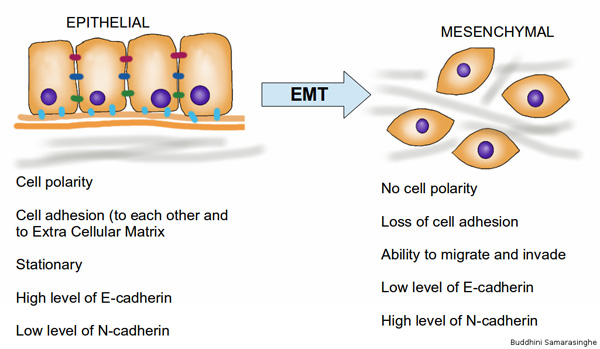
The researchers found significant differential expression for genes typically associated with EndoMT -- including markers of inflammation (IL6, IL18 and TLR4), basement membrane disarray (NID1, LAMA2 and CTSS), mesenchymal and endothelial cell differentiation (MYH11 and TAGLN) and EndoMT (ACTA2, SNAI1, CTNNB1, HAS2, CDH5, and NOTCH1). In heart valves of MVD-affected dogs, there was increased expression of these genes, with the exception of NOTCH1, and a reduction in CDH5. Apart from down-regulation of NOTCH1 expression, all other changes support a potential contribution of EndoMT and endothelial migration in the development of MVD.
The research findings confirm the study's aim and "strongly suggest involvement of developmental signaling pathways and mechanisms, including EndoMT, in the pathogenesis of canine MMVD." Most significantly, the findings suggest that, instead of MVD being a degenerative condition, MVD may be due to the development of EMT and EndoMT. The researchers point out that this is the first report of involvement of development signaling pathways and endothelial to mesenchymal transition in canine MVD. They also provide information on biological mechanisms that have therapeutic potential for new drug discovery.
August 2015: Cavalier in congestive heart failure suffers blood clots, a tear in the left atrium wall, and a cardiac stroke. In an August 2015 article, University of Pennsylvania veterinarians (Meg M. Sleeper, Meredith E. Maczuzak, Susan J. Bender) found that a deceased cavalier King Charles spaniel which had been in congestive heart failure due to mitral valve disease, also had suffered from a partial tear of his left atrium wall, and blood clot blockage in his left atrium and right foreleg, and a stroke (myocardial infarction).
July 2015:
Fortekor Plus -- combination of benazepril and pimobendan -- gets a
green light in Europe. In a
July 2015 opinion, the European
Medicines Agency's Committee for Medicinal Products for Veterinary Use
has recommended granting marketing authorization for Fortekor Plus, a
combination of benazepril and pimobendan. The committee warns that the
combination "should only be used in patients whose
 clinical signs are
successfully controlled by administration of the same doses of the
individual components (pimobendan and benazepril hydrochloride) given
concurrently."
clinical signs are
successfully controlled by administration of the same doses of the
individual components (pimobendan and benazepril hydrochloride) given
concurrently."
EDITOR'S NOTE: A potential drawback to this combination drug, with its fixed ratio of ACE-inhibitor to pimobendan, is that it would prevent the ability of the cardiologist to change the dose of just one of the two drugs and not the other.
July 2015:
Shocking survey of UK vets on treatment of CKCS in heart failure is very
troubling.
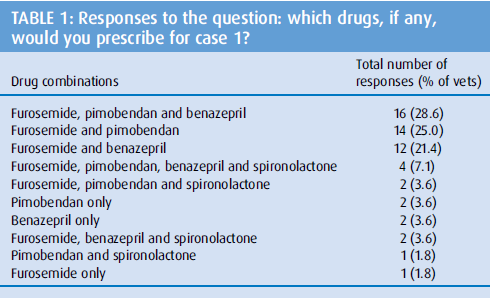 In an
April 2015 study, a team of UK researchers
(T. Davies, S. Everitt, M. Cobb) conducted a survey of general practice
veterinarians as to how they would handle a clinical case scenario of a
cavalier King Charles spaniel in heart failure. The researchers stated
that the proper response would be consistent with the
ACVIM's 2009
Consensus Statment. They found that, instead of following the Consensus
Statement recommendations, the most common recommendations they would
give the cavalier's owner was a change in the dog's exercise regime
(69.6%), and
the second most common
In an
April 2015 study, a team of UK researchers
(T. Davies, S. Everitt, M. Cobb) conducted a survey of general practice
veterinarians as to how they would handle a clinical case scenario of a
cavalier King Charles spaniel in heart failure. The researchers stated
that the proper response would be consistent with the
ACVIM's 2009
Consensus Statment. They found that, instead of following the Consensus
Statement recommendations, the most common recommendations they would
give the cavalier's owner was a change in the dog's exercise regime
(69.6%), and
the second most common
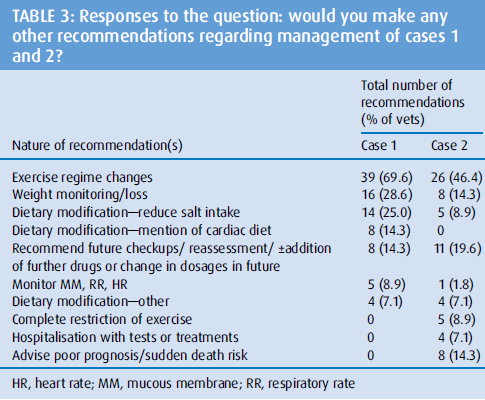 one was monitoring of, or encouraging loss of,
the dog's weight (28.6%). Fewer than half of the vets would perform an
echocardiograph scan, despite being told in the scenario that money was
not a limiting factor. The researchers concluded:
one was monitoring of, or encouraging loss of,
the dog's weight (28.6%). Fewer than half of the vets would perform an
echocardiograph scan, despite being told in the scenario that money was
not a limiting factor. The researchers concluded:
"In conclusion, this study has demonstrated that profound variation exists in the management of heart failure in general veterinary practice in the UK despite considerable reliable published evidence supporting the use of many of the agents, and recently guidelines on the management of CCF due to canine degenerative valve disease (Atkins and others 2009); goals of future research should be to investigate why this is the case and importantly what the impact of this variation in approach might have on patient survival."
June 2015: US researchers study microRNAs as possible biomarkers of MVD progression. In a June 2015 study, US researchers (Qinghong Li, Lisa M. Freeman, John E. Rush, Dorothy P. Laflamme) examined the role circulating microRNAs (miRNAs) may play as biomarkers of mitral valve disease. They examined 18 dogs, divided into three groups of six dogs each: (1) Stage A: normal dogs at risk of heart disease; Stage B1/B2: (2) asymptomatic dogs with MVD and mild to moderate cardiac enlargement; and (3) Stage C/D: dogs with MVD and CHF requiring multiple cardiac medications. They found that dogs in Stage B1/B2 or C/D had four upregulated miRNAs, including three cfa-let-7/cfa-miR-98 family members, while seven other miRNAs were downregulated, compared to Stage A. Expression of six of the 11 miRNAs also were significantly different between dogs in Stage C/D and those in Stage B1/B2. They observed that the expression changes were greater as disease severity increased. They concluded that their study suggests that there is an opportunity for using some circulating miRNAs as biomarkers for diagnosis, prognosis or monitoring response to treatment in MVD in dogs.
June 2015:
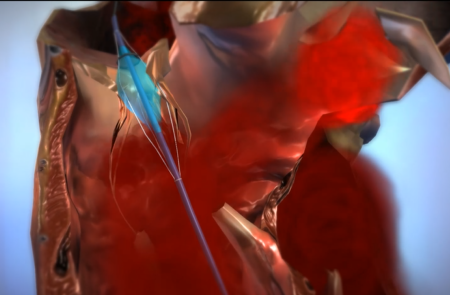 Cardiologist George Kramer competes for Wells Fargo prize for his Tucker
valve to prevent backflow through heart valves. Dr. George
Kramer, board certified veterinary cardiologist with
Ultravet Medical
Devices, is competing for a $25,000 prize from Wells Fargo Works, to
help finance his research of the "Tucker valve" (at right). The mechanical valve is
designed to be inserted through the mitral valve or tricuspid valve and
block backflow of blood through the valve. Dr. Kramer needs as many
votes for his project on the
Wells Fargo Works Project website. You may
vote daily for his valve research.
Cardiologist George Kramer competes for Wells Fargo prize for his Tucker
valve to prevent backflow through heart valves. Dr. George
Kramer, board certified veterinary cardiologist with
Ultravet Medical
Devices, is competing for a $25,000 prize from Wells Fargo Works, to
help finance his research of the "Tucker valve" (at right). The mechanical valve is
designed to be inserted through the mitral valve or tricuspid valve and
block backflow of blood through the valve. Dr. Kramer needs as many
votes for his project on the
Wells Fargo Works Project website. You may
vote daily for his valve research.
June 2015:
Mitrex researchers report success and safety of its device with pigs.
 In a
June 2015 abstract presented at the ACVIM Forum by Mitrex
researchers (Jeffrey Solomon [right], Thomas Fogarty, Evan Anderson, Pierluca
Lombardi), they report testing ten laboratory swine to evaluate the
safety, compatibility, and effectiveness of the Mitrex epicardial
annuloplasty device. They state that: (1) the devices were placed
without incident; (2) coronary flow, ejection fraction, left ventricular
wall motion and mitral valve anteroposterior dimension were normal post
implantation and at term; (3) there were no remarkable postoperative
events; (4) all subjects survived to term with the exception (due to a
non device related complication); (5) the devices were well tolerated
causing only minimal to mild fibrosis and chronic inflammation; (6) no
significant changes were observed in the myocardium except for muscle
fiber atrophy near the tip of the anterior arm; (7) there appeared to be
ample tissue over the tip and no danger of perforation in all but one
subject; (8) no meaningful changes were noted in cardiac shape,
ventricular wall thickness, chamber size, heart valves, and blood
vessels. They concluded that: "Myocardial compression necessary to
perform epicardial annuloplasty was well tolerated. The Mitrex® device
was safe and biocompatible."
In a
June 2015 abstract presented at the ACVIM Forum by Mitrex
researchers (Jeffrey Solomon [right], Thomas Fogarty, Evan Anderson, Pierluca
Lombardi), they report testing ten laboratory swine to evaluate the
safety, compatibility, and effectiveness of the Mitrex epicardial
annuloplasty device. They state that: (1) the devices were placed
without incident; (2) coronary flow, ejection fraction, left ventricular
wall motion and mitral valve anteroposterior dimension were normal post
implantation and at term; (3) there were no remarkable postoperative
events; (4) all subjects survived to term with the exception (due to a
non device related complication); (5) the devices were well tolerated
causing only minimal to mild fibrosis and chronic inflammation; (6) no
significant changes were observed in the myocardium except for muscle
fiber atrophy near the tip of the anterior arm; (7) there appeared to be
ample tissue over the tip and no danger of perforation in all but one
subject; (8) no meaningful changes were noted in cardiac shape,
ventricular wall thickness, chamber size, heart valves, and blood
vessels. They concluded that: "Myocardial compression necessary to
perform epicardial annuloplasty was well tolerated. The Mitrex® device
was safe and biocompatible."
 June
2015:
Cardiologist Rebecca Stepien confirms "no proven benefit" to pimobendan
at Stage B2 MVD. In a
March 2015 article
in the IVIS journal, Veterinary Focus, board certified veterinary cardiologist
Rebecca L. Stepien (right) confirms that routine administration of pimobendan
has "no proven benefit" in dogs prior to heart failure. Referring
specifically to ACVIM's Stage B2, she states: "Currently
there is no proven benefit to routine initiation of pimobendan therapy
at this stage."
June
2015:
Cardiologist Rebecca Stepien confirms "no proven benefit" to pimobendan
at Stage B2 MVD. In a
March 2015 article
in the IVIS journal, Veterinary Focus, board certified veterinary cardiologist
Rebecca L. Stepien (right) confirms that routine administration of pimobendan
has "no proven benefit" in dogs prior to heart failure. Referring
specifically to ACVIM's Stage B2, she states: "Currently
there is no proven benefit to routine initiation of pimobendan therapy
at this stage."
May 2015:
PennVet researchers reduce plasma NT-proBNP concentration in MVD-dogs in
congestive heart failure. In a
June 2015 study presented at
the 2015 ACVIM Forum, PennVet cardiologists (Melanie Hezzell [left], Chloe
Thorn, Danielle Laughlin, Mark Oyama) report that by tweaking
medications (furosemide, enalapril, pimobendan) and adding Aldactazide,
they were able to reduce the concentration of N-terminal pro-B-type
natriuretic peptide (NT-proBNP) in dogs with chronic congestive heart
failure (CHF) due to mitral valve disease (MVD). They noted evidence in
human patients with CHF that therapies reducing NT-proBNP improved their
outcomes. Fifteen dogs were recruited, with 8 in a control group and 7
in the test group. Depending upon the results of periodic blood tesing
over 21 days, if NT-proBNP was above 1500pmol/L in the test group, the
researchers would increase the dosages of the medications. They found
that:
In a
June 2015 study presented at
the 2015 ACVIM Forum, PennVet cardiologists (Melanie Hezzell [left], Chloe
Thorn, Danielle Laughlin, Mark Oyama) report that by tweaking
medications (furosemide, enalapril, pimobendan) and adding Aldactazide,
they were able to reduce the concentration of N-terminal pro-B-type
natriuretic peptide (NT-proBNP) in dogs with chronic congestive heart
failure (CHF) due to mitral valve disease (MVD). They noted evidence in
human patients with CHF that therapies reducing NT-proBNP improved their
outcomes. Fifteen dogs were recruited, with 8 in a control group and 7
in the test group. Depending upon the results of periodic blood tesing
over 21 days, if NT-proBNP was above 1500pmol/L in the test group, the
researchers would increase the dosages of the medications. They found
that:
"In conclusion, a pre-specified treatment escalation algorithm in dogs with stable CHF due to MMVD and with NT-proBNP >1500pmol/L resulted in significant decreases in plasma NTproBNP concentration over time. Serum BUN and creatinine measurements significantly increased over baseline in these dogs, suggesting that careful monitoring of renal function is necessary during therapeutic escalation. Further study is warranted to determine whether targeted reductions in NT-proBNP result in improved outcomes in dogs with CHF secondary to MMVD."
May 2015:
International team of
cardiologists compile echocardiographic findings in
older cavaliers.
 In a
June 2015 report to the 2015 ACVIM
Forum, an international team of veterinary cardiologists (Jorge
Prieto-Ramos [right], Simon Swift, Andrea Corda, Brendan Corcoran , Kim Summers,
Iñigo Sanz, Anne French) report on the results of echocardiographic
scans of 126 cavalier King Charles spaniels between the ages of 8 and 16
years. All of the dogs had mitral valve thickening and regurgitation,
and 98% had tricuspid valve regurgitation. However, only 17% had
pulmonary hypertension.
In a
June 2015 report to the 2015 ACVIM
Forum, an international team of veterinary cardiologists (Jorge
Prieto-Ramos [right], Simon Swift, Andrea Corda, Brendan Corcoran , Kim Summers,
Iñigo Sanz, Anne French) report on the results of echocardiographic
scans of 126 cavalier King Charles spaniels between the ages of 8 and 16
years. All of the dogs had mitral valve thickening and regurgitation,
and 98% had tricuspid valve regurgitation. However, only 17% had
pulmonary hypertension.
Summary of results:
• Males: 35%; Females: 65%
•
Mitral valve thickening and regurgitation: 100%
• Mitral valve
prolapse: 88%; severe prolapse: 18%
• Tricuspid valve
regurgitation: 98%
• Pulmonary hypertension: 17%
•
Remodeling markers: 58%
May 2015:
US researchers find pimobendan made no difference on incidence of
arrhythmias in dogs in heart failure, compared to a placebo.
 In a
May 2015 report by US researchers at the University of California -
Davis (Geri A. Lake-Bakaar [right], Manreet K. Singh, Philip H. Kass,
Leigh G. Griffiths), they studied eight small breed dogs with congestive
heart failure (CHF) due to mitral valve disease (MVD). They wanted to
determine the effect , if any, of pimobendan on the incidence of
arrhythmias in MVD-dogs in CHF. They found no significant difference
between pimobendan and placebo. However, they had two additional
findings: (1) the dogs' quality of life significantly improved two weeks
following the start of administration of either pimobendan or placebo;
and (2) the average heart rates and sleeping respiratory rates (SRR) of
the dogs given pimobendan were significantly lower than those given the
placebo. The researchers speculated that the decrease in average heart
rate and SRR were due to superior heart failure control with pimobendan.
In a
May 2015 report by US researchers at the University of California -
Davis (Geri A. Lake-Bakaar [right], Manreet K. Singh, Philip H. Kass,
Leigh G. Griffiths), they studied eight small breed dogs with congestive
heart failure (CHF) due to mitral valve disease (MVD). They wanted to
determine the effect , if any, of pimobendan on the incidence of
arrhythmias in MVD-dogs in CHF. They found no significant difference
between pimobendan and placebo. However, they had two additional
findings: (1) the dogs' quality of life significantly improved two weeks
following the start of administration of either pimobendan or placebo;
and (2) the average heart rates and sleeping respiratory rates (SRR) of
the dogs given pimobendan were significantly lower than those given the
placebo. The researchers speculated that the decrease in average heart
rate and SRR were due to superior heart failure control with pimobendan.
May 2015:
Researchers do not find a relationship between serotonin in
blood platelets and development of MVD in cavaliers. In a
June 2015 study, an international team of veterinary researchers
(Signe E. Cremer, Annemarie T. Kristensen, Maria J. Reimann, Nynne B.
Eriksen, Stine F. Petersen, Clara B. Marschner, Inge Tarnow, Mark A.
Oyama, Lisbeth H. Olsen) analyzed blood samples of 62 cavalier King
Charles spaniels (15 healthy dogs; 18 with mild MVD; 19 with
moderate-to-severe MVD; and 10 in congestive heart failure). They were
looking for (a) any relationship between serotonin concentrations in
blood platelets ("percentage of serotonin-positive platelets, level of
surface-bound platelet serotonin expression"), and (b) platelet
activation, in CKCSs with MVD. They found no differences in either
surface-bound serotonin expression or platelet activation among the four
categories of cavaliers in the study.
They did observe that dogs
with low platelet numbers (thrombocytopenic dogs) had significantly
lower serum serotonin concentrations than non-thrombocytopenic dogs.
And, they found in 26 of the dogs a "flow cytometry scatterplot
subpopulation (FSSP)" of platelets. Dogs with an FSSP had a higher
percentage of serotonin-positive platelets, and a higher level of
surface-bound serotonin expression, and higher platelet activation, than
did dogs without an FSSP. An FSSP was present in 93.8% of the
thrombocytopenic dogs and in 29.5% of the nonthrombocytopenic dogs. They
concluded from those observations that an FSSP of highly activated
platelets with pronounced serotonin binding was strongly associated with
thrombocytopenia but not with MVD.
May 2015:
US cardiologists find mitral valve measurements are larger
for dogs with advanced MVD.
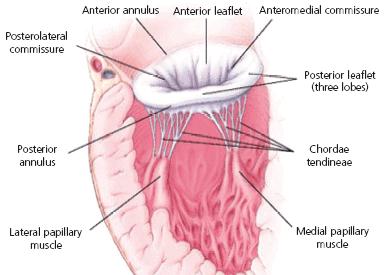 In a
May 2015 report by US cardiologists (S. Wesselowski, M. Borgarelli,
G. Menciotti, J. Abbott), they compared the dimensions of anterior
mitral valve leaflets and annulus (the ring-like base of the heart valve
that supports the valve's leaflets) of 60 dogs (including 9 cavaliers)
with various stages of mitral valve disease to those of 22 normal dogs,
using echocardiography. They indexed the measurements to body weights.
They found that the leaflet and annulus measurements of MVD-affected
dogs in Stages B2 and C all were significantly greater than those in
Stage B1 and normal dogs, and that the valve widths of Stage B1 dogs
were significantly greater than the normal dogs.
In a
May 2015 report by US cardiologists (S. Wesselowski, M. Borgarelli,
G. Menciotti, J. Abbott), they compared the dimensions of anterior
mitral valve leaflets and annulus (the ring-like base of the heart valve
that supports the valve's leaflets) of 60 dogs (including 9 cavaliers)
with various stages of mitral valve disease to those of 22 normal dogs,
using echocardiography. They indexed the measurements to body weights.
They found that the leaflet and annulus measurements of MVD-affected
dogs in Stages B2 and C all were significantly greater than those in
Stage B1 and normal dogs, and that the valve widths of Stage B1 dogs
were significantly greater than the normal dogs.
May 2015:
ACVIM cardiologists downplay the need for echocardiograms
of cavaliers with newly discovered heart murmurs.
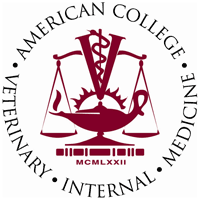 In a
May 2015 report in the Journal of the American Veterinary Medical
Association, an international panel of ACVIM cardiologists (Etienne
Cote, N. Joel Edwards, Stephen J. Ettinger, Virginia Luis Fuentes,
Kristin A. MacDonald, Brian A. Scansen, D. David Sisson, Jonathan A.
Abbott) explained the current diagnositic protocols once heart murmurs
are detected by stethoscope.
In a
May 2015 report in the Journal of the American Veterinary Medical
Association, an international panel of ACVIM cardiologists (Etienne
Cote, N. Joel Edwards, Stephen J. Ettinger, Virginia Luis Fuentes,
Kristin A. MacDonald, Brian A. Scansen, D. David Sisson, Jonathan A.
Abbott) explained the current diagnositic protocols once heart murmurs
are detected by stethoscope.
They emphasize the importance of obtaining x-rays of the heart, and they downplay obtaining echocardiograms. They state:
"In adult small-breed dogs with incidentally detected murmurs, serial follow-up of cardiac size on thoracic radiographs [chest x-rays] can be a useful tool to monitor disease progression. For example, CKCS [cavalier King Charles spaniels] with DMVD [degenerative mitral valve disease] may have a VHS [Vertebral Heart Score] that is stable and may not have clinical signs for years, followed by a rapid increase in VHS and, eventually, the development of CHF. ... In the absence of any other clinical signs possibly related to heart disease, geriatric small-breed dogs with systolic murmurs that have a point of maximal intensity over the left apex can be evaluated by thoracic radiography. As mentioned for adult small-breed dogs, thoracic radiographs can provide important prognostic and therapeutic information for patients with presumed or confirmed DMVD: a cardiac silhouette of normal size and shape in a dog that has no overt signs of decompensated heart disease is consistent with mild DMVD, and no treatment currently available appears to alter the progression of DMVD at this stage. Additionally, such radiographs may then provide baseline information for comparison as the disease progresses."
They conclude:
"It is easy to recommend that all patients with incidentally detected heart murmurs undergo echocardiography. A true understanding of the realities and imperatives of clinical practice says otherwise. This report is intended to provide a summary of the patient-, client-, and veterinarian-based factors that can help attending veterinarians recommend whether or not to pursue further diagnostic evaluation of patients with incidentally detected murmurs and the advantages and suitability of various diagnostic approaches." (Emphasis added.)
May 2015: Canadian researchers find that the timing of x-rays during breathing patterns can affect the vertebral heart score. In a May 2015 article, Canadian researchers (Julien Olive, Romain Javard, Swan Specchi, Marie-Claude Bélanger, Catherine Bélanger, Guy Beauchamp, Kate Alexander) compared x-rays taken at varying points during dogs' breathing patterns and found that vertebral heart scores (VHS) can differ by as much as 1.11 vertebral units. They conclude that:
"Clinicians should be aware of the potential influence of these factors when assessing VHS in dogs; in addition to allowing optimal pulmonary assessment, consistently taking radiographs at end-inspiratory tidal volume may help to limit VHS variability attributable to the respiratory cycle. Further research is needed to assess the effects of cardiac and respiratory phases on VHS in dogs with cardiac or respiratory disease."
April 2015:
UK review of veterinary records of 1,875 cavaliers shows UK Kennel Club
dogs had significantly low MVD diagnoses.
 In an
April 2015
report by UK and Australian veterinarians (Jennifer F Summers, Dan G
O'Neill, David B Church, Peter C Thomson, Paul D McGreevy, David C
Brodbelt), the veterinary records of 1,875 cavalier King Charles
spaniels treated between 2009 and 2013 and on the database of the
VetCompass animal health surveillance project, were dissected. Only 75
of the 1,875 cavaliers had a confirmed KC-registration status. Heart
murmurs were the highest ranking category of diagnoses (541 dogs,
representing 30.9% of study group). overall, the most common disorder
category was cardiac, affecting 31.7% of the dogs.
In an
April 2015
report by UK and Australian veterinarians (Jennifer F Summers, Dan G
O'Neill, David B Church, Peter C Thomson, Paul D McGreevy, David C
Brodbelt), the veterinary records of 1,875 cavalier King Charles
spaniels treated between 2009 and 2013 and on the database of the
VetCompass animal health surveillance project, were dissected. Only 75
of the 1,875 cavaliers had a confirmed KC-registration status. Heart
murmurs were the highest ranking category of diagnoses (541 dogs,
representing 30.9% of study group). overall, the most common disorder
category was cardiac, affecting 31.7% of the dogs.
Interestingly, a far lower percentage of UK Kennel Club registered dogs had reported murmurs (12%) compared to dogs of unknown registration status. Regarding this statistic, the authors speculate:
"It is possible that this finding reflects a genuinely lower prevalence of murmurs (and by implication existing or developing heart disease) in KC-registered CKCSs. Bias could have also been introduced (in either direction) by the comparative willingness of breeders to screen for heart murmurs in animals intended to produce puppies for KC registration, but it was not possible to explore this finding using the study data available."
April 2015: UK review of 111,967 dogs' veterinary records confirms that the cavalier ranks highest in MVD cases. In an April 2015 report, Royal Veterinary College (UK) researchers (M.J. Mattin, A. Boswood, D.B. Church, J. López-Alvarez, P.D. McGreevy, D.G. O'Neill, P.C. Thomson, D.C. Brodbelt) examined the veterinary records of 111,967 dogs treated at primary care clinics in 2010 and 2011. The aim of the study was to estimate the prevalence of mitral valve disease (MVD) among those dogs, and to identify risk factors for MVD diagnosis. They found 405 dogs diagnosed with MVD, of which 131 (32.4%) were cavalier King Charles spaniels (CKCS). This percentage was 5 times higher than any other breed and 3 times higher than cross-breeds. Their conclusion confirmed that CKCSs have the highest odds of MVD.
 April 2015: Penn
Vet seeks cavaliers for new drug test. Dr. Mark Oyama
(right) of
Penn Vet's cardiology department is asking for volunteer CKCSs with
"stable untreated mitral valve disease" to participate in a 6-hour test
of the tolerability and effects of a new drug believed to help delay the
progression of MVD. Participation will involve a one-day hopital visit
in Philadelphia and two injections of the new drug. The investigators
will monitor blood pressure and various blood and urine measurements to
determine if the drug has favorable effects on fluid retention. Contact:
Dr. Mark A Oyama, email: maoyama@vet.upenn.edu, telephone 215-898-2964;
click for website.
April 2015: Penn
Vet seeks cavaliers for new drug test. Dr. Mark Oyama
(right) of
Penn Vet's cardiology department is asking for volunteer CKCSs with
"stable untreated mitral valve disease" to participate in a 6-hour test
of the tolerability and effects of a new drug believed to help delay the
progression of MVD. Participation will involve a one-day hopital visit
in Philadelphia and two injections of the new drug. The investigators
will monitor blood pressure and various blood and urine measurements to
determine if the drug has favorable effects on fluid retention. Contact:
Dr. Mark A Oyama, email: maoyama@vet.upenn.edu, telephone 215-898-2964;
click for website.
Editor's Note: As with all such drug studies, CavalierHealth.org urges cavalier owners to ask questions and proceed with caution.
March 2015: Dr. Sleeper moves from Penn Vet to University of Florida. Dr. Meg Sleeper, formerly the cardiology department chief at the University of Pennsylvania in Philadelphia, has transfered to the University of Florida in Gainesville. Dr. Mark Oyama has succeeded Dr. Sleeper as chief of cardiology at Penn Vet.
March 2015:
UK researchers
develop a clinical severity score (CSS) to predict MVD severity
 and
outcome. In a
March 2015 report, a team of UK's Royal Veterinary College researchers (J. López-Alvarez, J.
Elliott, D. Pfeiffer, Y.-M. Chang, M. Mattin, W. Moonarmart, M.J.
Hezzell, A. Boswood) studied the symptoms and physical conditions of 224
MVD-affected dogs, including 97 cavaliers, to determine risk
stratification of MVD-affected dogs and create a clinical severity score
(CSS). They found:
and
outcome. In a
March 2015 report, a team of UK's Royal Veterinary College researchers (J. López-Alvarez, J.
Elliott, D. Pfeiffer, Y.-M. Chang, M. Mattin, W. Moonarmart, M.J.
Hezzell, A. Boswood) studied the symptoms and physical conditions of 224
MVD-affected dogs, including 97 cavaliers, to determine risk
stratification of MVD-affected dogs and create a clinical severity score
(CSS). They found:
"In summary, this study shows that data obtained from history and PE [physical examination], specifically history of cough, exercise intolerance, decreased appetite, breathlessness (difficulty breathing) and syncope as well as murmur grades louder than III/VI and loss of respiratory sinus arrhythmia, are independent indicators of disease progression for DMVD and are predictive of cardiac death. This knowledge can be developed into a scoring system to assist clinical decision making and may improve the interpretation of subsequent diagnostic test results for improved management of cases both in first opinion and referral practice."
March 2015: Researchers determine that moderate to severe pulmonary hypertension worsens outcome of dogs with MVD. In a March 2015 study, an international team of cardiologists (M. Borgarelli, J. Abbott, L. Braz-Ruivo, D. Chiavegato, S. Crosara, K. Lamb, I. Ljungvall, M. Poggi, R.A. Santilli, J. Haggstrom) reviewed the cases of 212 dogs with mitral valve disease, including 30 cavaliers. They concluded that, "In dogs with MMVD, moderate to severe PH worsens outcome."
March 2015:
U. of Georgia researchers compare ACE-inhibitors with aldosterone
receptor blockers to combat aldosterone breakthrough in MVD-affected
dogs.
 Drs. Amanda Coleman and Amelia Sinkin
(right) of the University of Georgia, are researching alternative
medications to ACE-inhibitors (ACE-i), to better counteract the role of
renin-angiotensin-aldosterone system (RAAS) stimulation in MVD. Recent
studies have shown an unexpected and undesirable phenomenon known as
"aldosterone breakthrough" (ABT) can occur in some dogs despite being
treated with an ACE-i. These researchers hypothesize that treatment with
the aldosterone receptor blocker (ARB) telmisartan will
be associated with a significantly lower incidence of ABT than will
treatment with the ACE-i enalapril, in dogs with advanced MVD.
Drs. Amanda Coleman and Amelia Sinkin
(right) of the University of Georgia, are researching alternative
medications to ACE-inhibitors (ACE-i), to better counteract the role of
renin-angiotensin-aldosterone system (RAAS) stimulation in MVD. Recent
studies have shown an unexpected and undesirable phenomenon known as
"aldosterone breakthrough" (ABT) can occur in some dogs despite being
treated with an ACE-i. These researchers hypothesize that treatment with
the aldosterone receptor blocker (ARB) telmisartan will
be associated with a significantly lower incidence of ABT than will
treatment with the ACE-i enalapril, in dogs with advanced MVD.
March 2015: Researchers find gene expression of 5-HT2BR is higher in MVD-affected dogs. In a March 2015 study of the serotonin markers 5-HT2A and 5-HT2B receptors (R) in dogs with and without MVD, an international team of researchers (S.E. Cremer, S.G. Moesgaard, C.E. Rasmussen, N.E. Zois, T. Falk, M.J. Reimann, S. Cirera, H. Aupperle, M.A. Oyama, L.H. Olsen) reported finding gene expression of 5-HT2BR was "significantly higher" in dogs with MVD.
 March 2015:
Japanese research shows pimobendan causes sudden death in end-stage
heart failure in mice. In a
March 2015 study, a team of
Japanese pharmacology researchers (Miki Nonaka, Sachio Morimoto, Takashi
Murayama, Nagomi Kurebayashi, Lei Li, Yuan-Yuan Wang, Masaki Arioka)
found that, in mice, pimobendan prevented myocardial remodelling in
compensated heart failure (HF) and significantly extended the life span in both
compensated and end-stage HF, but that it increased
the risk of their sudden cardiac death in end-stage HF.
March 2015:
Japanese research shows pimobendan causes sudden death in end-stage
heart failure in mice. In a
March 2015 study, a team of
Japanese pharmacology researchers (Miki Nonaka, Sachio Morimoto, Takashi
Murayama, Nagomi Kurebayashi, Lei Li, Yuan-Yuan Wang, Masaki Arioka)
found that, in mice, pimobendan prevented myocardial remodelling in
compensated heart failure (HF) and significantly extended the life span in both
compensated and end-stage HF, but that it increased
the risk of their sudden cardiac death in end-stage HF.
March 2015:
Flanders, Belgium requires MVD and CM/SM testing of cavalier breeding
stock.
 The government of
the Flemish region of Belgium announced on March 3, 2015, new breeding
rules for cavalier King Charles spaniels, requiring that all breeding
stock be tested for mitral valve disease (and Chiari-like malformation
and syringomyelia) in order for litters to be registered by the Flemish
government. Twenty other breeds also will now have additional testing
requirements.
The government of
the Flemish region of Belgium announced on March 3, 2015, new breeding
rules for cavalier King Charles spaniels, requiring that all breeding
stock be tested for mitral valve disease (and Chiari-like malformation
and syringomyelia) in order for litters to be registered by the Flemish
government. Twenty other breeds also will now have additional testing
requirements.
 Joke Schauvliege (left), Flemish Minister for
Environment, Nature and Agriculture, signed the ministerial decision,
which will come into force, along with details of the testing
procedures, 10 days after official publication in the government's
journal, which is expected to occur in April. The new regulation is the
result of a study ordered by Minister Schauvliege two years ago,
involving the calculation of the genetic diversity and most common
health problems in the 21 breeds, which also includes the Schipperke,
Papillon, Bichon Frise, Groenendael, Petit Brabancon, Ardennes cattle
dog, Laekenois, Bloodhound, Golden Retriever, Irish setter and border
collie.
Joke Schauvliege (left), Flemish Minister for
Environment, Nature and Agriculture, signed the ministerial decision,
which will come into force, along with details of the testing
procedures, 10 days after official publication in the government's
journal, which is expected to occur in April. The new regulation is the
result of a study ordered by Minister Schauvliege two years ago,
involving the calculation of the genetic diversity and most common
health problems in the 21 breeds, which also includes the Schipperke,
Papillon, Bichon Frise, Groenendael, Petit Brabancon, Ardennes cattle
dog, Laekenois, Bloodhound, Golden Retriever, Irish setter and border
collie.
March 2015: Scottish researchers identify 591 differentially expressed genes related to MVD in cavaliers. In a March 2015 report, a team of Scottish researchers (C-C Lu, M-M Liu, G Culshaw, M Clinton, D A Argyle, and B M Corcoran, right) examined 5,397 differentially expressed canine genes, narrowing down their examination to 591 genes in six to ten biological function clusters -- relevant to inflammation, cell movement, cardiovascular development, extracellular matrix organisation and epithelial-to-mesenchymal (EMT) transition in dogs with mitral valve disease (MVD). They state:
"Considering the biological relevance to MMVD, the gene families of importance with significant difference between groups included collagens, ADAMTS peptidases, proteoglycans, matrix metalloproteinases (MMPs) and their inhibitors, basement membrane components, cathepsin S, integrins, tight junction cell adhesion proteins, cadherins, other matrix-associated proteins, and members of the serotonin (5-HT)/transforming growth factor -β signaling pathway."
 February 2015:
Ukrainian researchers opine that the small dog genes IGF1
and/or STC2 relate to MVD
in cavaliers. In a
February 2015 report
reviewing previous
research into candidate genes causing dwarfism and heart development in
dogs, a team of National University of Life and Environmental Sciences
of Ukraine researchers speculate on the genetic cause of
mitral valve disease in small breeds, particularly the cavalier King
Charles spaniel. They conclude that MVD may be due to a mutation of the
gene IGF1 (insulin-like growth factor-1), which is connected to small
body size in canines. They suggest that if the heart is not reduced at
the same scale as the overall smaller dog, the IGF1 mutation may be
responsible for excessive compression, leading to valve damage. They
further conclude that MVD may be due to mutations in areas closely
linked to the STC2 gene, which also is a candidate for the small size,
although STC2 is not involved with the development of the heart.
February 2015:
Ukrainian researchers opine that the small dog genes IGF1
and/or STC2 relate to MVD
in cavaliers. In a
February 2015 report
reviewing previous
research into candidate genes causing dwarfism and heart development in
dogs, a team of National University of Life and Environmental Sciences
of Ukraine researchers speculate on the genetic cause of
mitral valve disease in small breeds, particularly the cavalier King
Charles spaniel. They conclude that MVD may be due to a mutation of the
gene IGF1 (insulin-like growth factor-1), which is connected to small
body size in canines. They suggest that if the heart is not reduced at
the same scale as the overall smaller dog, the IGF1 mutation may be
responsible for excessive compression, leading to valve damage. They
further conclude that MVD may be due to mutations in areas closely
linked to the STC2 gene, which also is a candidate for the small size,
although STC2 is not involved with the development of the heart.
February 2015: Swedish study finds serotonin levels increase in spayed bitches. In a February 2015 report by veterinary doctoral student Elin Larsson, she studied 7 female dogs and 3 males, including on cavalier King Charles spaniel male, she found that "Among the bitches, the serotonin levels tended to increase after castration [sic]. The male dogs were few in number and no obvious changes in hormone levels were shown."
 February 2015:
German cardiologist examines serum MicroRNAs as diagnostic markers for
mitral valve disease. Dr. Gerhard Wess (right), board certified
veterinary cardiologist at Ludwig-Maximilians-Universitaet in Germany,
is researching MicroRNA molecules in dogs' blood serum to determine if
they can serve as diagnostic markers for stages of mitral valve disease.
MicroRNAs are RNA molecules which have been found to play key roles in
the regulation of gene expression. To corroborate the specificity, a
group of dogs with dilated cardiomyopathy will also be included. His
project began this month and is expected to continue until January 2016,
after which he will publish a report of his findings and conclusions.
February 2015:
German cardiologist examines serum MicroRNAs as diagnostic markers for
mitral valve disease. Dr. Gerhard Wess (right), board certified
veterinary cardiologist at Ludwig-Maximilians-Universitaet in Germany,
is researching MicroRNA molecules in dogs' blood serum to determine if
they can serve as diagnostic markers for stages of mitral valve disease.
MicroRNAs are RNA molecules which have been found to play key roles in
the regulation of gene expression. To corroborate the specificity, a
group of dogs with dilated cardiomyopathy will also be included. His
project began this month and is expected to continue until January 2016,
after which he will publish a report of his findings and conclusions.
January 2015: Korean researchers find link between advanced MVD and pancreatitis. In a January 2015 study of 62 dogs -- 40 with various stages of MVD and 22 healthy ones (none were cavaliers) -- a team of South Korean researchers (D. Han, R. Choi, and C. Hyun) found an increase in serum canine pancreatic lipase immunoreactivity (cPLI) concentrations with the worsening of heart failure signs in the affected dogs. They concluded that pancreatic injury is associated with congestive heart failure (CHF) caused by MVD. They acknowledged that there were limitations to the study, primarily due to the number of dogs and the extent of the assessment of pancreatitis in the dogs. Nevertheless, they stated:
"Despite these study limitations, our study results clearly suggest that the increased serum PLI concentration, to levels accepted as indicating pancreatitis, is a common comorbidity with congestive heart failure. Therefore, regular check-up for serum PLI level is warranted for early detection of pancreatitis from chronic heart diseases."
January 2015: Echocardiographic measures of mitral regurgitation severity and mitral valve pathology enable researchers to reliably predict mortality. In a January 2015 report, UK and Brazilian researchers (Julia Sargent, Ruthnea Muzzi, Rajat Mukherjee, Sharlene Somarathne, Katherine Schranz, Hannah Stephenson, David Brodbelt, and Virginia Luis Fuentes) reviewed echocardiograms of 70 dogs (including 34 cavalier King Charles spaniels) diagnosed with MVD to estimate their survival times. They report that their results proved to be 95% correct.
January 2015: Scandinavian cardiologists find that increased left heart size can predict the risk of congestive heart failure in CKCSs. In a September 2014 report to the 24th ECVIM-CA Congress, Scandinavian veterinary cardiologists S. Eriksson-Palojarvi, K. Hansson, H. Duelund Pedersen, J. Haukka, and J. Haggstrom examined 225 echocardiograms of 78 cavalier King Charles spaniels over a period of up to 4.5 years. They found that overall, increased left heart size can predice the risk of congestive heart failure in cavaliers with mitral regurgitation due to mitral valve disease.
January 2015:
Dr. Oyama seeks serotonin-blocking drug to stop MVD before heart failure. Dr. Mark Oyama
(right) of the University of Pennsylvania veterinary school has
announced that he aims to develop a serotonin-blocking drug to stop or
reverse mitral valve disease (MVD) before congestive heart failure
occurs. In previous research, he and his team have found that in dogs
with MVD:
Dr. Mark Oyama
(right) of the University of Pennsylvania veterinary school has
announced that he aims to develop a serotonin-blocking drug to stop or
reverse mitral valve disease (MVD) before congestive heart failure
occurs. In previous research, he and his team have found that in dogs
with MVD:
• Serotonin activates degenerative changes within the dog mitral valve.
• Drugs that block serotonin receptors reduce this response.
• Cavalier King Charles spaniels and other dog breeds that are predisposed to MVD have increased serotonin in their blood stream and heart tissues.
Dr. Oyama stated that once a new drug is developed, or the best existing alternative is identified, a clinical trial will follow, involving several hundred dogs worldwide with naturally occurring early MVD.
Editor's Note: Join the effort to raise funds for this research. Cavalier Health Fund.
RETURN TO TOP
2014 News
November 2014: Infiniti Medical reports successful results of 6-month trial of its Mitrex mitral valve implant device. In a report to the ACVS Surgery Summit in October 2014, researchers (Drs. Jeffrey Adam Solomon, Pierluca Lombardi, Evan Anderson, Tachi Callas, Mark Juravic, Mark Cunningham, and Thomas Fogarty) for manufacturer Infiniti Medical reported that the results of a six month trial of its Mitrex epicardial annuloplasty device implanted on the beating hearts of ten swine without requiring the use of a cardiopulmonary bypass. Necropsy was performed at 180 days. The researchers found that:
"Coronary flow, ejection fraction, left ventricular wall motion and mitral valve function were normal post implantation and at term. ... Devices were well tolerated causing only minimal to mild fibrosis and chronic inflammation. No significant changes were observed in the myocardium except for muscle fiber atrophy near the tip of the anterior arm. There appeared to be ample tissue over the tip and no danger of perforation in all but one subject. No meaningful changes were noted in cardiac shape, ventricular wall thickness, chamber size, heart valves, and blood vessels. The myocardial compression necessary to perform epicardial annuloplasty was well tolerated. The Mitrex device was safe and biocompatible."
We previously reported on two 2010 research articles about this device, then called the Mitral Touch. See our January 2010 report and our December 2010 report.
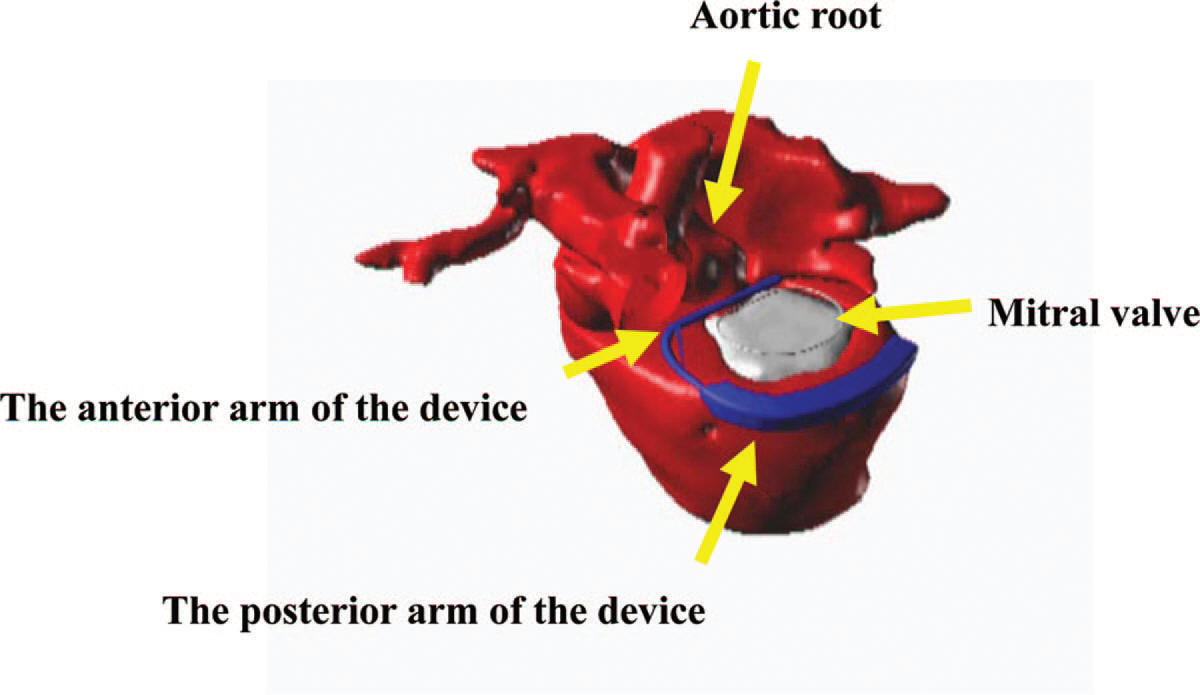
November 2014:
UK Prof. Corcoran reports to UK's cavalier club on current research.
 In
a November 2014 report to the UK's cavalier King Charles spaniel
club, Professor Brendan Corcoran of the Royal (Dick) School of
Veterinary Studies, The University of Edinburgh, updated the club on the
topics of Mitral Valve Pathology ("any genetic cause of CKCSs likely
affects the age of onset of the disease and not the eventual
pathology."); Genetics ("... MMVD in CKCSs is heterogeneous (has
different forms) in the way it develops and provides a powerful model to
allow us to identify the genes that drive this disease."); Genomics
("The problem is determining what is "cause" and what "effect" is. ...
We are interested to know how the expression of these genes might change
as dogs get older and as the disease becomes more severe."); and Tissue
Engineering ("... what if we could grow our own valves in the
laboratory?")
In
a November 2014 report to the UK's cavalier King Charles spaniel
club, Professor Brendan Corcoran of the Royal (Dick) School of
Veterinary Studies, The University of Edinburgh, updated the club on the
topics of Mitral Valve Pathology ("any genetic cause of CKCSs likely
affects the age of onset of the disease and not the eventual
pathology."); Genetics ("... MMVD in CKCSs is heterogeneous (has
different forms) in the way it develops and provides a powerful model to
allow us to identify the genes that drive this disease."); Genomics
("The problem is determining what is "cause" and what "effect" is. ...
We are interested to know how the expression of these genes might change
as dogs get older and as the disease becomes more severe."); and Tissue
Engineering ("... what if we could grow our own valves in the
laboratory?")
November 2014:
A troubling medical treatment study of unsuspecting MVD-affected dogs in
heart failure.
 Ceva Animal Health, a veterinary
pharmaceutical company, is sponsoring a stealth-like clinical trial of
dogs in heart failure, evaluating what it refers to as a "new medical
therapy" called C635 (which we suspect to be Ceva's Cardalis, a combination of the
ACE-inhibitor benazepril and the aldosterone antagonist spironolactone) at veterinary
schools and cardiology clinics in the USA, including North Carolina
State University's veterinary school. If our understanding of the
outline of the study is accurate, the study is disturbing because it
severely limits medications to be given to the dogs in heart
failure (Stage C) which are participating in it. Reportedly, the dogs are divided
into three groups, one receiving Cardalis -- Ceva's combination pill of
benazepril and spironolactone -- and the second receiving just
benazepril, and the third receiving just spironolactone, for up to a
year. In addition, the dogs may be given the diuretic furosemide and
either digoxin or diltiazem if necessary to control heart rate in artial
fibrillation.
Ceva Animal Health, a veterinary
pharmaceutical company, is sponsoring a stealth-like clinical trial of
dogs in heart failure, evaluating what it refers to as a "new medical
therapy" called C635 (which we suspect to be Ceva's Cardalis, a combination of the
ACE-inhibitor benazepril and the aldosterone antagonist spironolactone) at veterinary
schools and cardiology clinics in the USA, including North Carolina
State University's veterinary school. If our understanding of the
outline of the study is accurate, the study is disturbing because it
severely limits medications to be given to the dogs in heart
failure (Stage C) which are participating in it. Reportedly, the dogs are divided
into three groups, one receiving Cardalis -- Ceva's combination pill of
benazepril and spironolactone -- and the second receiving just
benazepril, and the third receiving just spironolactone, for up to a
year. In addition, the dogs may be given the diuretic furosemide and
either digoxin or diltiazem if necessary to control heart rate in artial
fibrillation.
EDITOR'S NOTE:The troubling significance of this study is that the ACVIM Consensus Statementcurrently recommends as medications for MVD-affected dogs in heart failure -- Stage C -- a combination of a diuretic, an ACE-inhibitor, pimobendan, and possibly spironolactone. In this study, it appears that two-thirds of these dogs will receive only the diuretic and ACE-inhibitor or only the diuretic and spironolactone, and none of the dogs will be given pimobendan. It therefore is very important for the owners of any cavaliers asked to join this study to be aware that they could be putting their dogs at great risk of their heart-health by allowing them to be denied a full dose of medications deemed necessary by most cardiologists to manage their heart failure.
November 2014: Tufts University's vet school seeks healthy CKCSs for muscle mass clinical trial. Tuft's Cummings veterinary school needs healthy cavaliers to participate in a clinical trial to evaluate the use of ultrasound to measure dogs' muscle mass. Loss of muscle mass is a common consequence of advanced mitral valve disease and associated kidney disease. Eligible dogs must be from one to five years old and neutered and have no heart murmurs or significant medical conditions. Participating dogs will receive a free examination, x-ray, ultrasound of back muscles, and have a small blood sample collected. If interested, contact Dr. Lisa Freeman, telephone 508-887-4696.
October 2014:
Veterinary cardiologist Mark Kittleson dumps on EPIC Trial -- says it
has a 50-50 chance.
 In a September 2014 presentation before
the World Small Animal Veterinary Association (WSAVA) Congress, board
certified veterinary cardiologist
Mark Kittleson (of
the School of Veterinary Medicine,
University of California-Davis) spoke very frankly about the ongoing EPIC Trial
studying whether pimobendan is safe and effective in delaying the onset
of heart failure in dogs with mitral valve disease. He said:
In a September 2014 presentation before
the World Small Animal Veterinary Association (WSAVA) Congress, board
certified veterinary cardiologist
Mark Kittleson (of
the School of Veterinary Medicine,
University of California-Davis) spoke very frankly about the ongoing EPIC Trial
studying whether pimobendan is safe and effective in delaying the onset
of heart failure in dogs with mitral valve disease. He said:
"Because this study found pimobendan to be detrimental to dogs with MMVD it is the opinion of the author that further study was warranted prior to exposing 150 dogs to it in a large clinical trial (the EPIC study). Primum non nocere (first do no harm). It is also the opinion of the author that pimobendan should not be administered to dogs with MMVD prior to the onset of heart failure until the results of the EPIC trial are published. ... Will it prolong the time until a dog with MMVD goes into heart failure? That remains to be seen. Given the one study that has been done to date I don't believe you can give this anything more than a 50:50 chance."
He concluded:
"And so, once again, it is my recommendation that pimobendan not be administered to dogs with mitral regurgitation due to MMVD prior to the results of the EPIC study being published in a peer-reviewed journal."
EDITOR'S NOTE: Dr. Kittleson's comments about the obvious dangers of the premature use of pimonbenan are music to our ears, since we pointed out the same flaws and hazards in our April 2011blog entry, "Beware the pimobendan/Vetmedin 'EPIC clinical trial': There is no upside", urging that cavalier owners not risk their dogs' lives by allowing them to participate in the study. At the time, we frankly were stunned that so many board certified cardiologists would agree to participate in such a risky study, including some who previously had issued the same warnings about the dangers of giving pre-heart-failure dogs such a drug. Interestingly, the list of names of these 36 cardiologists no longer is present on the Internet, since Vetmedin's manufacturer shut down its EPIC Trial website earlier this year. Dr. Kittleson's use of the bioethics Latin phrase, primum non nocere (first do no harm), certainly has been on our minds for the past 4+ years since the commencement of this life-threatening study.
October 2014: Japanese veterinary heart surgeon summarizes current methods of canine mitral valve repairs. In a September 2014 presentation before the World Small Animal Veterinary Assosciation Congress (WSAVA), Japanese veterinary heart surgeon Isamu Kanemoto summarized the current methods of mitral valve surgeries and their pitfalls for small dogs.
October 2014:
Japanese researchers find left atrial enlargement and function correlate
with prognosis of early death of MVD dogs.
 In
an October
2014 report by a team of Japanese cardiologists (T. Osuga, K.
Morishita, S. Suzuki, T. Morita, N. Yokoyama, H. Ohta, M. Yamasaki, and
Mitsuyosh Takiguchi [right]) of
38 dogs (breeds unidentified) in various stages of mitral valve disease
(MVD), they found that the size of the left atrium (LA) and the LA's
booster pump function strongly correlated with predictions of early
death of the dogs. LA's booster pump function was the most significant
independent predictor of mortality.
In
an October
2014 report by a team of Japanese cardiologists (T. Osuga, K.
Morishita, S. Suzuki, T. Morita, N. Yokoyama, H. Ohta, M. Yamasaki, and
Mitsuyosh Takiguchi [right]) of
38 dogs (breeds unidentified) in various stages of mitral valve disease
(MVD), they found that the size of the left atrium (LA) and the LA's
booster pump function strongly correlated with predictions of early
death of the dogs. LA's booster pump function was the most significant
independent predictor of mortality.
They also observed that LA
"enlargement does not always result in its functional incompetence.
During chronic MR [mitral regurgitation], the left atrium enlarges in
size and the LA chamber becomes more compliant. Thus, the enlarged left
atrium appears to exert an important compensatory mechanism by buffering
the rise in pressure in the atrium and by providing an adequate
ventricular filling volume."
October 2014: Another month, another plasma NT-proBNP concentration study shows higher concentrations in dogs with CHF. In an October 2014 study of 291 dogs, including 38 cavaliers, the 16 researchers found that plasma NT-proBNP concentrations once again were higher in dogs in congestive heart failure (CHF) than in dogs with non-cardiac respiratory distress. See last month's entry, below. Can you spell d-e-r-i-v-a-t-i-v-e?
September 2014: Benazepril does not prevent furosemide-induced RAAS activation, in a study of 10 healthy hounds. In a September 2014 study (by A. C. Lantis, M. K. Ames, C. E. Atkins, T. C. DeFrancesco, B. W. Keene, and S. R. Werre) of ten healthy hound dogs, the researchers found that the ACE-inhibitor benazepril did not prevent the activation of the renin-angiotensin aldosterone system (RAAS), a cause of renal dysfunction.
September 2014:
European cardiologists study 78 CKCSs and find high NT-proANP levels
predict future heart failure with 95% confidence factor. In
a
September 2014 report by a team of Finnish, Swedish, and Danish
cardiologists (Anders S. Eriksson, Jens Haggstrom, Henrik Duelund
Pedersen, Kerstin Hansson, Anna-Kaisa Jarvinen, Jari Haukka, Clarence
Kvart), they examined 78 cavalier King Charles spaniels for 4.5 years
and found that high levels of NP-proANP (over >1000 pmol/l) was 95%
accurate, with a median time to congestive heart failure (CHF) of 11
months, compared to 54 months for cavaliers with lower ANP levels.
They also reported that the risk of CHF increased with a heart rate
over 130 beats per minute and a mitral valve murmur grade over grade 3.
 September
2014:
International study confirms the obvious: the louder the murmur, the
worse the MVD. This is a "DUH!" moment. A
September 2014 study by an international team of respected
cardiologists (I. Ljungvall, M. Rishniw, F. Porciello, L. Ferasin, D. G.
Ohad) studied 578 small breed dogs with MVD and found what we
have been told for the past 25 years: Murmur intensity reflects MVD
severity. However, the details in
this abstract are worth reading. Details include: (1) No dogs with
grade I or II murmurs had congestive heart failure (CHF), and 90% had no
enlargement; (2) 56% of dogs with grade III, 29% of dogs with grade IV,
and 8% of dogs with grade V or VI murmurs and not yet in CHF had no
enlargement.
September
2014:
International study confirms the obvious: the louder the murmur, the
worse the MVD. This is a "DUH!" moment. A
September 2014 study by an international team of respected
cardiologists (I. Ljungvall, M. Rishniw, F. Porciello, L. Ferasin, D. G.
Ohad) studied 578 small breed dogs with MVD and found what we
have been told for the past 25 years: Murmur intensity reflects MVD
severity. However, the details in
this abstract are worth reading. Details include: (1) No dogs with
grade I or II murmurs had congestive heart failure (CHF), and 90% had no
enlargement; (2) 56% of dogs with grade III, 29% of dogs with grade IV,
and 8% of dogs with grade V or VI murmurs and not yet in CHF had no
enlargement.
EDITOR'S NOTE: Under the "Nothing New Under The Sun" department, this study topic has been performed before, as should be obvious. The Sheldon Cooper character on the television program Big Bang Theory would refer to this 2014 study rather derisively as "derivative". We found a similar study reach similar conclusions, limited to cavalier King Charles spaniels (81 of them, to be precise), published nearly 20 years earlier, in March 1995.
August 2014: Serotonin study shows concentration highest in cavaliers, with or without mitral valve disease . In an August 2014 study by an international team of veterinary cardiologists (S.E. Cremer, G.E. Singletary, L.H. Olsen, K. Wallace, J. Haggstrom, I. Ljungvall, K. Hoglund, C.A. Reynolds. N. Pizzinat, and M.A. Oyama), 45 dogs, including 12 healthy cavaliers and 14 MVD-affected cavaliers, were tested for concentrations of serotonin (5-hydroxytryptamine, 5HT) in their blood platelets and heart valve tissues. The researchers found that 5HT levels were significantly higher in CKCSs than non-CKCSs, and that the 5HT was highest in healthy cavaliers. As for 5HT in the dogs' heart valve tissues, it was significantly higher in mitral valve tissues of dogs with MVD than in the heart tissues of those with other heart disorders. They conclude that serotonin may be a signal for potential MVD. They recommend further investigation of interactions of platelet, valvular, and myocardial 5HT.
 August
2014:
NC State veterinarians make progress in stem cell therapy for
damaged heart tissue. In
an October 2014 report, a veterinary research team at North Carolina
State University, led by Dr. Ke Cheng (right), has figured out
a way to magnetize cardiac stem cells so that they are directed to the
hearts of rats and remain there to perform therapeutic effects. A
recurring problem with cardiac stem cells is that the heart's constant
motion will wash cells out of the heart and into the blood system, where
they are wasted. Dr. Cheng has attached metalic nanoparticles from an
FDA-approved drug, Feraheme, to cardiac stem cells and used a magnetic
field to keep the cells in the heart. The process has resulted in a
three-fold increase in cell retention in the rats' hearts.
August
2014:
NC State veterinarians make progress in stem cell therapy for
damaged heart tissue. In
an October 2014 report, a veterinary research team at North Carolina
State University, led by Dr. Ke Cheng (right), has figured out
a way to magnetize cardiac stem cells so that they are directed to the
hearts of rats and remain there to perform therapeutic effects. A
recurring problem with cardiac stem cells is that the heart's constant
motion will wash cells out of the heart and into the blood system, where
they are wasted. Dr. Cheng has attached metalic nanoparticles from an
FDA-approved drug, Feraheme, to cardiac stem cells and used a magnetic
field to keep the cells in the heart. The process has resulted in a
three-fold increase in cell retention in the rats' hearts.
July 2014:
International team of cardiologists find cavaliers have higher
serotonin concentrations in platelets . In a
July 2014 study, cardiologist researchers from Denmark, Sweden, the
USA, and France (S.E. Cremer, G.E. Singletary, L.H. Olsen, K. Wallace,
J. Haggstrom, I. Ljungvall, K. Hoglund, C.A. Reynolds, N. Pizzinat, M.A.
Oyama) compared serotonin concentrations in blood plasma of 26 cavaliers
(12 healthy and 14 with mitral valve disease) and 19 non-CKCSs (8
healthy and 11 with MVD). They found that platelet serotonin was
elevated in cavaliers compared to the other breeds. They also found that
left ventricular myocardial and mitral valve leaflet tissue in deceased
MVD dogs was elevated compared to dogs which died without cardiac
disease.
In a
July 2014 study, cardiologist researchers from Denmark, Sweden, the
USA, and France (S.E. Cremer, G.E. Singletary, L.H. Olsen, K. Wallace,
J. Haggstrom, I. Ljungvall, K. Hoglund, C.A. Reynolds, N. Pizzinat, M.A.
Oyama) compared serotonin concentrations in blood plasma of 26 cavaliers
(12 healthy and 14 with mitral valve disease) and 19 non-CKCSs (8
healthy and 11 with MVD). They found that platelet serotonin was
elevated in cavaliers compared to the other breeds. They also found that
left ventricular myocardial and mitral valve leaflet tissue in deceased
MVD dogs was elevated compared to dogs which died without cardiac
disease.
July 2014: Thailand researchers find no difference in serotonin concentrations between healthy dogs and those with MVD, but ... In a July 2014 study by Thailand researchers Tanawan Mangklabruks and Sirilak Disatian Surachetpong, they examined serotonin concentrations in 20 healthy dogs and 23 dogs with MVD. They did not find any difference in either the plasma or the platelet serotonin concentrations between the two groups. They concluded that:
"Circulating plasma serotonin is unlikely a major source of serotonin signaling in canine MMVD. Platelets could be a source of serotonin in canine MMVD through platelet adhesion to the mitral valve; however, the amount of serotonin stored in platelets of healthy dogs and dogs with MMVD is not different."
EDITOR'S NOTE: However, they did not focus exclusively on cavaliers. A July 2013 study of 120 dogs, including 92 cavaliers, found that cavaliers had higher concentrations of serum serotonin (serum 5HT) than other breeds not predisposed to mitral valve disease, and that serum 5HT concentrations decreased with increased left atrial enlargement. They concluded that, "the finding of higher serum 5HT concentrations in dogs predisposed to MMVD (CKCS) and dogs with mild MMVD suggests that alterations in 5HT signaling might play a role in progression of early stages of MMVD."
And in the July 2014 international study described directly above this article, the researchers found that platelet serotonin was elevated in cavaliers compared to the other breeds. And, in the August 2014 study, also above this article, researchers found that 5HT levels were significantly higher in CKCSs than non-CKCSs, and that the 5HT was highest in healthy cavaliers. As for 5HT in the dogs' heart valve tissues, it was significantly higher in mitral valve tissues of dogs with MVD than in the heart tissues of those with other heart disorders.
July 2014: Swedish researchers find high blood NT-proANP concentrations can predict onset of CHF within months. In a July 2014 study, a team of Swedish cardiologists and other researchers, Drs. Anders S. Eriksson, Jens Haggstrom, Henrik Duelund Pedersen, Kerstin Hansson, Anna-Kaisa Jarvinen, Jari Haukka, and Clarence Kvart, examined 78 cavaliers with mitral valve disease over 4.5 years, to evaluate the predictive value of plasma N-terminal pro-atrial natriuretic peptide (NT-proANP) as a marker for progression of mitral regurgitation caused by mitral valve disease. They found that the risk of CHF increased with NT-proANP concentrations above 1000 picomoles per liter (pmol/l). They further found that the risk of the onset of congestive heart failure (CHF) increased with a heart rate greater than 130 beats per minute and a mitral valve murmur grade of 4 to 6.
 June
2014:
UK's Simon Swift moves to University of Florida veterinary
school. Mr. Simon Swift (right), board certified
veterinary cardiologist and long-time official cardiologist for the UK's
Cavalier Club, has moved to the State of Florida and now is a professor
at the University of Florida's veterinary school in Gainesville. For
well over a decade, Mr. Swift has examined the hearts of thousands of
CKCSs at conformation shows in the UK and each year has presented
reports and statistics on mitral valve disease at the Cavalier Club's
annual general meetings. He is a welcome addition to the board certified
cardiologists in Florida.
June
2014:
UK's Simon Swift moves to University of Florida veterinary
school. Mr. Simon Swift (right), board certified
veterinary cardiologist and long-time official cardiologist for the UK's
Cavalier Club, has moved to the State of Florida and now is a professor
at the University of Florida's veterinary school in Gainesville. For
well over a decade, Mr. Swift has examined the hearts of thousands of
CKCSs at conformation shows in the UK and each year has presented
reports and statistics on mitral valve disease at the Cavalier Club's
annual general meetings. He is a welcome addition to the board certified
cardiologists in Florida.
May 2014: Brazil specialists find pimobendan improves clinical signs of MVD congestive heart failure, compared to digoxin. In a February 2014 report, a team of Brazilian cardiologists and researchers compared 14 dogs in congestive heart failure (CHF) given pimobendan, with 11 CHF dogs given digoxin and 7 CHF dogs given a placebo. All dogs also received doses of ACE-inhibitors and furosemide. They found that the digoxin and placebo groups showed no significant difference throughout the 28 days of treatment. The pimobendan group showed an increased early mitral inflow velocity on day 28, and that serum creatinine increased on days 14 and 28 compared to the baseline, but within normal limits. They concluded that the increase in early mitral inflow velocity on day 28 for pimobendan group is suggestive of diastolic dysfunction improvement, but that this is only one variable related to diastolic function. Only the pimobendan group showed increase in blood creatinine between baseline and days 7 and 28, and this result must be explored in later studies.
May 2014: Japanese researchers find histamine concentration is higher in dogs with MVD. In a May 2014 study by Japanese veterinarians, they studied 28 dogs, including 8 cavaliers, to evaluate whether blood concentration of histamine is associated with mitral valve disease. They concluded:
"In conclusion, the histamine concentration was higher in the population of dogs with CVD [canine valvular disease] compared with the healthy controls. Although the etiopathogenesis of CVD is complex and incompletely understood, it likely involves histamine. Ultimately additional studies are required to determine whether histamine blockers might be useful for the management of dogs with cardiac valvular disease."
May 2014: International team finds link between high-level serotonin-binding and highly-activated blood platelets and mitral valve disease and oversized platelets in cavaliers. In an April 2014 report, a team of researchers from Denmark and the USA studied the levels of serotonin-binding and of platlet activation in 61 CKCSs. They found that cavaliers with moderate-severe MVD and severe MVD tended to have higher levels of platelet activation, and that highly-active platelets and high-level serotonin-binding was strongly associated with oversized platelets. They concluded that further investigation into the significance of serotonin-binding is warranted.
May 2014: French researchers study 134 cavaliers and find their body weights affect echocardiographic interpretations. In an April 2014 study of 134 healthy cavalier King Charles spaniels, a team of French researchers concluded that: "Body weight should be taken into account when interpreting echocardiographic values in CKCS, except for LA/Ao, FS%, and mitral E/A ratio."
April 2014: Study of LCZ696 shows promise in managing heart failure in dogs. In an April 2014 report by an international team of heart specialists, the angiotensin receptor neprilysin inhibitor LCZ696 significantly reduced aldosterone (AL) exposure in 18 healthy Beagle dogs with activated renin-angiotensin system. They concluded that "these results support further development of LCZ696 for the management of cardiovascular diseases."
April 2014:
Italian
investigator finds cavaliers' MVD is tied to chronic inflammation.
In a
March
 2014 thesis, Italian Ph.D. student Giulia Riscazzi
(right)
studied mitral valve disease in cavaliers and Cirneco dell'Etna dogs (an
Italian hunting breed). She examined serological biomarkers in
MVD-affected dogs and compared blood samples from the healthy dogs of
the groups with blood samples from the dogs affected by different stages
of MVD. She then matched the proteomics results with the clinical and
echocardiographic data. She found that "MVD is a pathology that is
strictly connected to a chronic inflammation state."
2014 thesis, Italian Ph.D. student Giulia Riscazzi
(right)
studied mitral valve disease in cavaliers and Cirneco dell'Etna dogs (an
Italian hunting breed). She examined serological biomarkers in
MVD-affected dogs and compared blood samples from the healthy dogs of
the groups with blood samples from the dogs affected by different stages
of MVD. She then matched the proteomics results with the clinical and
echocardiographic data. She found that "MVD is a pathology that is
strictly connected to a chronic inflammation state."
Her conclusions regarding the CKCS:
"The proteomic analysis conducted on our samples and correlated to the clinical results, indicate that the MVD is a pathology that is strictly connected to a chronic inflammation state. The up-regulation of A1AT, IgG, IgM, and the down-regulation of complement C3 and serum albumin are connected with an inflammatory status, that cause a depletion of the components of the complement system, an activation of the acute phase proteins and of the components of immunity response like IgG and IgM immunoglobulins. The hypothesis that MVD could be related to a chronic inflammation was already speculated in the last years, and, based on the present study results, we think that the analysis of the inflammatory mediators in MVD patients could be a great chance to uncover the pathogenic mechanism at the base of mitral valve disease."
EDITOR'S NOTE: Another question which remains is: Is the MVD caused by inflammation, or does MVD cause the inflammation?
April 2014:
US study finds low serum vitamin D concentration is associated with poor
 outcomes of dogs with CHF. In a January 2014 study by a
team of US cardiologists, of serum vitamin D concentration in the
bloodstreams of 82 dogs (31 with congestive heart failure [CHF] -- 20
with acquired valve disease (AVD) and 11 with dilated cardiomyopathy
(DCM) -- and 51 unaffected control dogs, all over 5 years old), they
found that low serum vitamin D concentration was associated with poor
outcome in dogs with CHF. They suggested that strategies to improve
vitamin D status in some dogs with CHF may prove beneficial without
causing toxicity.
outcomes of dogs with CHF. In a January 2014 study by a
team of US cardiologists, of serum vitamin D concentration in the
bloodstreams of 82 dogs (31 with congestive heart failure [CHF] -- 20
with acquired valve disease (AVD) and 11 with dilated cardiomyopathy
(DCM) -- and 51 unaffected control dogs, all over 5 years old), they
found that low serum vitamin D concentration was associated with poor
outcome in dogs with CHF. They suggested that strategies to improve
vitamin D status in some dogs with CHF may prove beneficial without
causing toxicity.
February 2014: Healthy cavaliers are found to have the highest concentration of proANP out of 9 breeds. In a 2014 study of 535 healthy dogs of nine breeds, researchers found that CKCSs and German shepherds had the highest median proANP concentrations, twice the median concentration in the breed with the lowest concentration, the Doberman Pinscher. There were 34 cavaliers in the study, all from Sweden.
January
2014:
Dr. Penny Watson looks for ties between fibrosis in MVD, SM, and chronic
 pancreatitis in CKCSs
.
Dr. Penny Watson (right) of UK's Cambridge University's veterinary school is
spearheading a new study into whether several of the CKCS breed's hereditary
health problems are the result of the same genetic defect. Specifically, she
intends to explore the possibility that disparate cavalier diseases,
including mitral valve disease (MVD), syringomyelia (SM), and chronic
pancreatitis are connected at the cellular level by unusual patterns of
fibrotic changes. "Pronounced perivescular fibrosis", a feature in dogs with
chronic pancreatitis, also has been tied to a condition of the central
nervous system in cavaliers with SM. Dr. Watson has suggested that
deterioration of cavaliers' mitral valves also may be a result of a process
connected to the causes of fibrosis.
pancreatitis in CKCSs
.
Dr. Penny Watson (right) of UK's Cambridge University's veterinary school is
spearheading a new study into whether several of the CKCS breed's hereditary
health problems are the result of the same genetic defect. Specifically, she
intends to explore the possibility that disparate cavalier diseases,
including mitral valve disease (MVD), syringomyelia (SM), and chronic
pancreatitis are connected at the cellular level by unusual patterns of
fibrotic changes. "Pronounced perivescular fibrosis", a feature in dogs with
chronic pancreatitis, also has been tied to a condition of the central
nervous system in cavaliers with SM. Dr. Watson has suggested that
deterioration of cavaliers' mitral valves also may be a result of a process
connected to the causes of fibrosis.
The CKCS breed's documented overabundance of serotonin, a
neurotransmitter protein, has been identified as a plausible
mechanism which may trigger the development of fibrotic changes in
the heart's valves. Her study entails establishing primary stellate
cell (SC) cultures from CKCS and define 5HT receptor subtype
expression. Stellate cell (SC) activation is a key event in the
development of hepatic and pancreatic fibrosis. Serotonin has been
shown to activate SCs via 5HT receptors. The study is measuring the
response of these cells to serotonin and other stimulators of
fibrosis. She then intends to attempt to block SC activation in
vitro using 5HTreceptor antagonists. Increased understanding of the
factors driving fibrosis will be of benefit to the CKCS and may
allow a drug trial in the breed.
RETURN TO TOP
2013 News
December 2013: Cavaliers in congestive heart failure due to MVD have higher concentrations of the coenzyme biopterin than other dogs. A research team of Danish and Swedish cardiologists studied 57 cavaliers with MVD and 27 other dogs to study the status of the coenzyme biopterin (BH2 and BH4) in blood plasma, in relation to MVD. They report in a December 2013 study that age, gender, body weight, passive smoking and plasma and cardiac status correlate with plasma BH2 and BH4 concentrations in dogs. They specifically found that dogs in congestive heart failure (CHF) had significantly higher BH4 and BH2 levels than other dog groups.
December
2013:
PennVet cardiologist Meg Sleeper reiterates cavaliers' unfortunate
MVD
 uniqueness.
In a chapter of the
just
released book, "Handbook of Laboratory Animal Science,
Volume III, Third Edition: Animal Models", University of
Pennsylvania veterinary school's cardiologist Dr. Meg
Sleeper (right) has summarized the unique
unfortunate MVD dilemma of the cavalier King Charles spaniel. She
writes:
uniqueness.
In a chapter of the
just
released book, "Handbook of Laboratory Animal Science,
Volume III, Third Edition: Animal Models", University of
Pennsylvania veterinary school's cardiologist Dr. Meg
Sleeper (right) has summarized the unique
unfortunate MVD dilemma of the cavalier King Charles spaniel. She
writes:
"In Cavalier King Charles Spaniels (CKSPs), the disease often occurs at a younger age, and the prevalence in dogs that are older than 10 years of age is 90%. ... One study performed in the United Kingdom demonstrated that 59% of CKSPs older than 4 years of age had evidence of the disease. Similar results were noted in a study performed in the United States, which demonstrated that 56% of CKSP dogs were affected at 4 years of age. The disease starts with the formation of small nodules followed by progressive thickening and contraction of the mitral valve cusps and leakage of the valve. The disease is characterized by a long preclinical period. ... At present, it is not known how chronic valve degeneration is inherited. although a recent study identified two loci associated with the disease in CKSPs."
October 2013: Swedish cardiologists find that pimobendan tops benazepril in reducing heart rate and heart size in cavaliers in CHF. In an October 2013 report issued by Swedish cardiologists J. Haggstrom, P.F. Lord, K. Hoglund, I. Ljungvall, O. Jons, C. Kvart and K. Hansson, they studied 16 dogs in congestive heart failure (CHF) due to mitral valve disease, including eleven cavaliers. They compared pimobendan to benazepril and found that in dogs with CHF caused by MVD, pimobendan significantly reduces the heart rate (HR), left ventricle (LV) and atrium (LA) dimensions, heart rate-normalized pulmonary transit time (nPTT), and N-terminal proatrial natriuretic peptide (NT-proANP), and increases the ejection fraction, in comparison to benazepril. The reduction in heart size in response to pimobendan treatment in dogs with CHF is in agreement with previous studies, but reductions in HR, NT-proANP, and nPTT in response to pimobendan treatment have not previously been described in naturally occurring MVD.
They concluded:
"Pimobendan improves short-term cardiac function more than benazepril in dogs with CHF caused by MMVD. Pimobendan treatment enables the heart to work at smaller end-systolic and diastolic dimensions while maintaining adequate forward stroke volume. Some of the treatment responses found in neuroendocrine profile might have therapeutic relevance."
October 2013:
Thai grad students find ramipril did not improve Stage B2 MVD dogs.
In a
2013
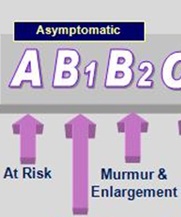 study
by Thai graduate students Prakit Kohkayasit and
Sirilak Surachetpong of twenty dogs (none CKCS) in
Stage B2 (right), they found that the
ACE-inhibitor ramipril did not affect cardiac chamber size,
mitral regurgitation severity and systolic function assessed by
echocardiography in 91-day period of treatment.
study
by Thai graduate students Prakit Kohkayasit and
Sirilak Surachetpong of twenty dogs (none CKCS) in
Stage B2 (right), they found that the
ACE-inhibitor ramipril did not affect cardiac chamber size,
mitral regurgitation severity and systolic function assessed by
echocardiography in 91-day period of treatment.
Our take is this means that ramipril was ineffective in improving the condition of the Stage B2 dogs. It did not reduce the size of the enlarged heart; it did not reduce the amount of regurgitation; it did not positively affect the heart's pumping ability.
September
2013:
QUEST Study shows pimobendan (versus benazepril) slowed progress
of
congestive heart failure, slowed increase in heart size, maintained higher
body temperature, and
 lessened
fluid retention. In the QUEST Study (comparing pimobendan with
benazepril and conducted from 2002 to 2006 with 260 dogs in congestive heart
failure [CHF], including 82 cavaliers) the researchers found in a
September 2013
report that the two medications resulted in similar quality of life
during the study. However, they found that pimobendan conferred increased
time before the progression of CHF and resulted in smaller heart size,
higher body temperature, and less retention of water.
lessened
fluid retention. In the QUEST Study (comparing pimobendan with
benazepril and conducted from 2002 to 2006 with 260 dogs in congestive heart
failure [CHF], including 82 cavaliers) the researchers found in a
September 2013
report that the two medications resulted in similar quality of life
during the study. However, they found that pimobendan conferred increased
time before the progression of CHF and resulted in smaller heart size,
higher body temperature, and less retention of water.
See the September 2008 QUEST Study report, in which the same researchers found that "pimobendan plus conventional therapy prolongs time to sudden death, euthanasia for cardiac reasons, or treatment failure in dogs with CHF caused by MMVD compared with benazepril plus conventional therapy."
August 2013: USA researchers find pimobendan has no effect upon the RAAS when combined with furosemide. In an August 2013 study, a team of North Carolina State University veterinary researchers report that high doses of pimobendan, when combined with a moderate dose of furosemide, had no greater effect upon six dogs' renin-angiotensin-aldosterone system (RAAS) than did furosemide alone upon six other dogs in the study.
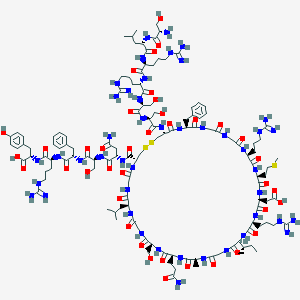 August
2013:
Japanese
researchers compare carperitide to furosemide in dogs with MVD.
In an
August 2013 report, a team of Japanese veterinary heart surgeons
compared dosing lab dogs with carperitide and furosemide. Carperitide
(right), an alpha-human atrial natriuretic peptide, is a human drug
which is known to reduce pressure in the left atrial and left ventricle
chambers of the human heart. The team reports that both drugs similarly
reduced left atrial pressure in six lab Beagles. They found that carperitide
had less adverse effects than furosemide because it did not activate the
renin-angiotensin-aldosterone system (RAAS). They concluded that additional
studies are warranted in clinical patients with degenerative MVD and
congestive heart failure.
August
2013:
Japanese
researchers compare carperitide to furosemide in dogs with MVD.
In an
August 2013 report, a team of Japanese veterinary heart surgeons
compared dosing lab dogs with carperitide and furosemide. Carperitide
(right), an alpha-human atrial natriuretic peptide, is a human drug
which is known to reduce pressure in the left atrial and left ventricle
chambers of the human heart. The team reports that both drugs similarly
reduced left atrial pressure in six lab Beagles. They found that carperitide
had less adverse effects than furosemide because it did not activate the
renin-angiotensin-aldosterone system (RAAS). They concluded that additional
studies are warranted in clinical patients with degenerative MVD and
congestive heart failure.
July 2013: Spironolactone is found safe in study funded by manufacturer of Prilactone. In a July 2013 study of the possible increased risk of adverse events for dogs taking spironolactone in addition to conventional therapies, the researchers concluded that dogs with heart failure receiving spironolactone in addition to conventional treatment are not at a higher risk for any adverse events, death caused by cardiac disease, renal disease, or both, hyperkalemia, or azotemia. The study was funded by the manufacturer of Prilactone.
July 2013: Study finds serotonin levels in cavaliers may relate to progression of early MVD. In a July 2013 international study (Drs. I. Ljungvall, K. Hoglund, I. Lilliehook, M.A. Oyama, A. Tidholm, H. Tvedten and J. Haggstrom) of serotonin concentrations in 120 dogs, including 92 cavaliers, the researchers found that CKCSs had higher concentrations of serotonin than other breeds, and that dogs with severe MVD had lower serotonin levels than dogs without MVD and dogs with milder MVD. They concluded, therefore, that changes in serotonin levels "might play a role in progression of early stages of MMVD."
July 2013: NC State vet school needs cavaliers for MVD study of activity levels. North Carolina State University College of Veterinary Medicine's Comparative Pain Research Lab is undertaking a study of cavaliers and other breeds, to better understand the effect of heart disease on the quality of life in dogs. Dogs enrolled in the study will have heart disease (causing a murmur) but have not yet developed signs of heart failure, as well as dogs of similar breed, size and age but without significant heart disease. Click here for details. Contact Andrea Thomson, research technician in the Comparative Pain Research Lab, telephone 919-513-6854.
June 2013: US researchers find injections of alginate hydrogel into heart-failure dogs' hearts improves heart structure and function. In a June 2013 study by a team of US cardiologists, they found that injecting alginate hydrogel directly into the left ventricle (LV) of the hearts of 7 dogs in heart failure, increased the thickness of the LV wall, and LV structure and function improved. Alginate is a naturally derived polysaccharide that is used in drug delivery and as cell encapsulation material. The brand name Algisyl-LVR is manufactured by LoneStar Heart, Inc. of Laguna Hills, California.
June
2013:
Tufts researchers examine effects of statin drug on dogs with congestive
heart failure.
 A team of researchers at Tufts University's
Cummings School of Veterinary Medicine conducted a preliminary study of how
dogs in congestive heart failure (CHF) could tolerate atorvastatin (a
3-Hydroxy-3-methylglutaryl coenzyme A reductase inhibitor -- statin) and its
short-term effects of CHF. Two of the 12 dogs in CHF were cavalier King
Charles spaniels. In their
June 2013 report, they found that atorvastatin
was well tolerated at clinically relevant doses in both healthy dogs and
dogs with CHF.
A team of researchers at Tufts University's
Cummings School of Veterinary Medicine conducted a preliminary study of how
dogs in congestive heart failure (CHF) could tolerate atorvastatin (a
3-Hydroxy-3-methylglutaryl coenzyme A reductase inhibitor -- statin) and its
short-term effects of CHF. Two of the 12 dogs in CHF were cavalier King
Charles spaniels. In their
June 2013 report, they found that atorvastatin
was well tolerated at clinically relevant doses in both healthy dogs and
dogs with CHF.
Significant decreases in total white blood cell (WBC) -- an inflammatory bio-marker -- and neutrophil counts were seen in the CHF group after both 2 and 8 weeks of atorvastatin administration. This effect was seen only in the CHF group, and the WBC count of CHF dogs no longer differed from those of the healthy dogs after statin administration. Post-atorvastatin WBC counts remained within the reference range in all animals and neutropenia was not documented. It is not clear whether the observed decrease in WBC count seen in CHF dogs was the direct result of atorvastatin, or perhaps secondary to overall better control of CHF or habituation to the hospital environment. They did not observe any significant short-term effects on echocardiographic or ECG parameters, quality of life questionnaire, or NT-proBNP.
They stated that the lack of observed improvement in those clinical parameters may indicate that statins are not helpful in dogs with nonischemic heart failure, but the lack of observed effect also could relate to the small number of dogs, short duration of this trial or both. They stated that modest decreases in systolic blood pressure seen in dogs with CHF after atorvastatin administration may have resulted from statin treatment, habituation to the hospital environment, or the effects of concomitant cardiac medications. They concluded that future prospective studies are needed to evaluate the potential clinical benefits of statin administration in dogs with cardiac disease.
Editor's Note: CavalierHealth.org is very skeptical of any value of statin drugs for dogs in CHF. Statins are known to interfere with the production of CoQ10 and are suspected of weakening the heart muscle. Dogs in CHF need both an abundance of CoQ10 and a very strong heart. If reducing inflammation is of value, the solution is to give the CHF dog fish oils. However, many knowledgeable cardiologists do not believe that any significant inflammatory process is involved in MVD. Canine-speaking, statins remain a remedy in search of a disease.
May
2013:
Dr. Buchanan reports mitral valve thickening is worst at chordae tendineae
contact
 points. Dr. James Buchanan (right), in a
May 2013 article
surveying the history of veterinary cardiology, observes that mitral valve
thickening occurs mainly in the insertion points of the chordae tendineae
into the valves. Regarding CKCSs, he wrote:
points. Dr. James Buchanan (right), in a
May 2013 article
surveying the history of veterinary cardiology, observes that mitral valve
thickening occurs mainly in the insertion points of the chordae tendineae
into the valves. Regarding CKCSs, he wrote:
"Since the late 1980s Cavalier King Charles spaniels have shown striking breed predisposition evidenced by mitral systolic murmurs in 50% of 5-year-old Cavaliers and 95 - 100% of 10-year-old ones."
May 2013: UK study finds cavaliers at "significant risk" for chronic kidney disease. In a May 2013 study of 107,214 dogs treated in 2010 and 2011 at 89 UK veterinary clinics, the researchers found that cavalier King Charles spaniels and Cocker spaniels were a "significant risk factor" for developing chronic kidney disease (CKD). They also reported that cardiac disease was a significant co-disease with CKD.
May 2013: UK Kennel Club announces MVD as a "candidate" for EBVs. The UK Kennel Club, in its 2012 Dog Health Group Annual Report, announced that mitral valve disease (along with syringomyelia) "are candidates for the development of EBVs [estimated breeding values] but require appropriate data collection procedures to be in place." The report goes on:
"A BVA/KC scheme for syringomyelia was launched in 2012 and once enough data has accumulated through the scheme then EBVs for the condition will become a possibility."
For more information about EBVs, see our webpage on the topic.
April 2013: German
researchers find natriuretic peptides not useful to distinguish between
grades
 of MVD. In an
April 2013
report, a team of German veterinary cardiologists studied 352 dogs and
have found that:
of MVD. In an
April 2013
report, a team of German veterinary cardiologists studied 352 dogs and
have found that:
"NPs [natriuretic peptides] in canine MMVD are useful to discriminate between asymptomatic dogs and dogs with CHF. Due to a large overlap of NP-concentrations between the groups, NPs do not seem to be useful to differentiate between dogs in stages B1 and B2. Interpretation of NT-proBNP and proANP values should include consideration of sex-specific differences."
April 2013: Researchers find that cardiac troponin-I could be a biomarker for formation of scar tissue in MVD dogs. In an April 2013 study of 50 dogs affected with congestive heart failure due to MVD, including 20 cavaliers, a team of Swedish and Danish veterinary researchers found that:
"Cardiac fibrosis and arteriosclerosis in dogs with MMVD are reflected by circulating cTnI [cardiac Troponin-I] concentration, but not by aldosterone concentration or renin activity. Cardiac troponin I could be a valuable biomarker for myocardial fibrosis in dogs with chronic cardiac diseases."
March 2013: Prof. Brendan Corcoran reports on MVD research to UK's cavalier club. Royal (Dick) School of Veterinary Studies researchers Brendan Corcoran and Chi-Chien (Fox) Liu reported to the UK Cavalier Club in February that their study has "demonstrated that the damage that occurs to the CKCS valve is the same as occurs to non-CKCS dogs, and in that respect the CKCS is not unique when describing the pathology of this disease."
Further, in their focus upon whether MVD is due to damage to the endothelial cells lining the valve surface, they have isolated and grown "canine valve endothelial cells, generating pure clones (each cell an exact copy of each other), monitoring response to different agents, growing cells in a form of artificial valve and physically injuring the cells. Further work is to be done with the plan to complete by end of 2013." They also are studying whether there is increased expression of genes normally associated with the development of diseased valves. They report that "The gene data should be available in the next few weeks and then will be analysed. On the basis of these results some aspects of Aim 2 will be addressed further."
February 2013: International study finds no statistical relationship between coughing in MVD dogs, due to pulmonary edema, and congestive heart failure. A team of veterinary cardiologists from the UK, US, and Canada examined the medical records of 206 dogs affected with MVD to determine whether a cough is a clinical sign of congestive heart failure (CHF). In their February 2013 report, they found no statistical association between coughing and CHF, identified by cardiogenic pulmonary edema, and that isolated coughing (without shortness of breath or rapid breathing) is a very unlikely sign of CHF in dogs. Instead, their statistics indicated that the coughing typical of dogs with MVD is due to their airways being disrupted by the enlargement of their hearts associated with the MVD.
February 2013: Dr. Oyama hints at new diuretic for MVD. In an interview with AKC's Canine Health Foundation, board certified cardiologist Dr. Mark Oyama of University of Pennsylvania's veterinary school, said:
"Thus far we have high hopes that a new diuretic offers distinct advantages over furosemide, which is the most commonly prescribed diuretic in dogs with heart failure. We are working to establish the efficacy and safety of this diuretic in preparation of planning clinical trials to evaluate its effects as compared to furosemide."
January 2013: Potential
Adverse Effects of Omega-3 Fatty Acids in Dogs. Texas
researchers
report
 potential adverse effects of Omega-3 fatty acids, including
altered platelet function, gastrointestinal adverse effects, detrimental
effects on wound healing, lipid peroxidation, potential for nutrient excess
and toxin exposure, weight gain, altered immune function, effects on
glycemic control and insulin sensitivity, and nutrient-drug interactions.
They found that adverse effects are likely to be dose-dependent, which is a
significant factor to take into account when weighing the value of this
report.
potential adverse effects of Omega-3 fatty acids, including
altered platelet function, gastrointestinal adverse effects, detrimental
effects on wound healing, lipid peroxidation, potential for nutrient excess
and toxin exposure, weight gain, altered immune function, effects on
glycemic control and insulin sensitivity, and nutrient-drug interactions.
They found that adverse effects are likely to be dose-dependent, which is a
significant factor to take into account when weighing the value of this
report.
The same enzymes are involved in metabolism of omega-6 and omega-3 fatty acids, resulting in competition between these fatty acids for incorporation into cell membranes and other biological properties. Because diets with alpha-linolenic acid (ALA) have different effects when compared with diets enriched in EPA and DHA, the type of omega-3 fatty acids is crucial information. There are potential risks associated with usage of omega-3 fatty acids.
Clinicians and dog owners alike should understand the adverse effects that may occur with omega-3 fatty acid supplementation, and that potential risks should be assessed in conjunction with the potential benefits. A lesson from this study is that owners should be cautious when using fish oil supplements in the presence of certain concurrent serious diseases such as pancreatitis, thrombocytopenia, and diabetes.
RETURN TO TOP
2012 News
November 2012: Report finds that CKCSs with MVD have higher concentrations of collagen and urinary aldosterone than other breeds. In a November 2012 report, researchers found that left ventricular heart enlargement in dogs with MVD is associated with a decrease in the serum concentration of a marker of collagen type III turnover, and an increase in urinary aldosterone concentration (UAC). They also reported that both serum N-terminal procollagen type III concentration and UAC were higher in Cavalier King Charles Spaniels than in other breeds when other measured variables were controlled for.
October 2012:
Spanish researchers devise new method of measuring heart enlargement.
A team
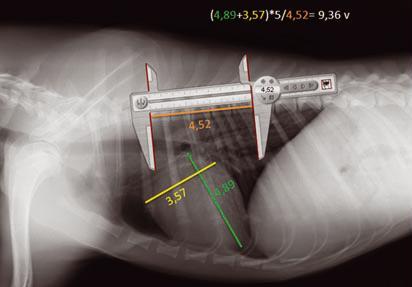 of
primarily Spanish researchers have devised a "simplified vertebral heart
scale computation method (Objective VHS)" for determining the extent of
enlargement of dogs' hearts affected by mitral valve disease. At least, they
claim it is "simplified" and "objective". In their
October 2012 report, they assert to have improved upon
the
Buchanan VHS devised by
Dr. James Buchanan
in 1995. However, their method requires a mathematic formula to convert
their measurements to compare with the Buchanan VHS method. So, whether or
not the new Objective VHS method really is "simplifed" may be in the eyes of the
beholder.
of
primarily Spanish researchers have devised a "simplified vertebral heart
scale computation method (Objective VHS)" for determining the extent of
enlargement of dogs' hearts affected by mitral valve disease. At least, they
claim it is "simplified" and "objective". In their
October 2012 report, they assert to have improved upon
the
Buchanan VHS devised by
Dr. James Buchanan
in 1995. However, their method requires a mathematic formula to convert
their measurements to compare with the Buchanan VHS method. So, whether or
not the new Objective VHS method really is "simplifed" may be in the eyes of the
beholder.
September 2012: Swedish study shows cavaliers tend to have higher heart rates than Labrador retrievers. A September 2012 study of 33 CKCSs, compared to 41 Labrador retrievers and 15 Dachshunds, by Swedish vets, showed that blood pressure and heart rates for all breeds were higher when owners were not present, and that cavaliers had higher heart rates than Labradors in most settings. The researchers recommend that the dogs' owners be present during blood pressure and heart rate recordings. And as usual, they recommend further studies.
September 2012:
NC State Drs. Meurs and Stern plan study of genetics of heart valve
degeneration in CKCSs
 . Board certified cardiologists Kate Meurs
(left) and
Josh Stern of North Carolina State University veterinary school
are beginning a study of the genetics of heart valve degeneration in the
cavalier King Charles spaniel. They plan to examine dogs by echocardiograph,
DNA, and pedigree. Their goal is to provide a new MVD breeding protocol.
Cavaliers of the Northeast (CNE) is cooperating in this study, which begins
on October 21, 2012 by examining dogs at
the CNE show in Parsippany, NJ.
Ideal dogs for the study are (a) young and MVD-affected (moderate to severe
MVD) and (b) 8 years and older with no MVD. However, the researchers are
interested in examining CKCSs of all ages, affected and unaffected. All
involvement in the study and results of screening are confidential.
. Board certified cardiologists Kate Meurs
(left) and
Josh Stern of North Carolina State University veterinary school
are beginning a study of the genetics of heart valve degeneration in the
cavalier King Charles spaniel. They plan to examine dogs by echocardiograph,
DNA, and pedigree. Their goal is to provide a new MVD breeding protocol.
Cavaliers of the Northeast (CNE) is cooperating in this study, which begins
on October 21, 2012 by examining dogs at
the CNE show in Parsippany, NJ.
Ideal dogs for the study are (a) young and MVD-affected (moderate to severe
MVD) and (b) 8 years and older with no MVD. However, the researchers are
interested in examining CKCSs of all ages, affected and unaffected. All
involvement in the study and results of screening are confidential.
August 2012: Dr. Andy Beardow lectures on-line about MVD. For an in-depth on-line seminar about the symptoms, diagnosis, progression, and treatment of mitral valve disease, watch Dr. Andrew Beardow, with his terrific active graphics, explain MVD.
July
2012:
International team of cardiologists conclude the mean average sleeping
respiratory
rate of healthy dogs is less than 30 breaths per minute.
In the
October 2012 issue of Research in
 Veterinary Science, an international
group of veterinary cardiologists, M. Rishniw, I. Ljungvall, F. Porciello,
J. Haggstrom, and D.G. Ohad, observed that
respiratory rate monitoring of cardiac patients is recommended by many
cardiologists, but that little objective data exist about respiratory rates
in apparently healthy dogs when collected in the home environment. They
measured the sleeping respiratory rates in 114 apparently healthy dogs. The
found that apparently healthy adult dogs generally have mean sleeping
respiratory rates less than 30 breaths per minute and rarely exceed that
rate at any time.
Veterinary Science, an international
group of veterinary cardiologists, M. Rishniw, I. Ljungvall, F. Porciello,
J. Haggstrom, and D.G. Ohad, observed that
respiratory rate monitoring of cardiac patients is recommended by many
cardiologists, but that little objective data exist about respiratory rates
in apparently healthy dogs when collected in the home environment. They
measured the sleeping respiratory rates in 114 apparently healthy dogs. The
found that apparently healthy adult dogs generally have mean sleeping
respiratory rates less than 30 breaths per minute and rarely exceed that
rate at any time.
May 2012: Japanese surgeons report on mitral valve repairs of 48 dogs. A team of 16 Japanese veterinary heart surgeons published their report on 48 mitral valve surgeries on small-breed dogs, including cavaliers. They performed mitral annuloplasties and replaced the chordae tendineae with a carbon and fluorine based synthetic polymer, expanded polytetrafluoroethylene chordal prostheses. 45 of the 48 dogs survived to discharge. In 3 months, murmurs were reduced to as low as 0/6; heart enlargement was reduced; mitral valve regurgitation was markedly reduced. They concluded that "Mitral valve repair with cardiopulmonary bypass can be beneficial for the treatment of mitral regurgitation in small-breed dogs."
March 2012:
Penn's Oyama and
Sweden's Lord, et al. correspond about periodic x-rays to predict start of
CHF in cavaliers. In a round of letters published in the Journal of
Veterinary Internal Medicine, Dr.
 Mark
Oyama of the University of Pennsylvania, and Drs. Peter
Lord, Kerstin Hansson, Cristina Carnabuci, Clarence Kvart, and
Jens Haggstrom of Sweden corresponded about the latter's
September 2011 article on using periodic x-rays to detect the onset of
congestive heart failure in 94 cavalier King Charles spaniels. The Swedish
team concluded " The true velocity can only be measured with a relatively
short time interval. ... [I]t would require frequent (monthly?) monitoring
to measure them. ... [M]easured rate of change was affected by the time
interval; VHS was of little use to predict time to onset of CHF; a rise of
∆VHS/month above a selected percentile of the values at the interval
preceding the last one might be a useful sign of impending CHF; combining
interval likelihood ratios for VHS and ∆VHS/month greatly improved the
accuracy of diagnosis of CHF. The study shows the value of incorporating the
element of time dependency from serial measurements as rate of change, a
summary of the response over time of each subject." Read
Oyama's letter here and
Lord's letter here.
Mark
Oyama of the University of Pennsylvania, and Drs. Peter
Lord, Kerstin Hansson, Cristina Carnabuci, Clarence Kvart, and
Jens Haggstrom of Sweden corresponded about the latter's
September 2011 article on using periodic x-rays to detect the onset of
congestive heart failure in 94 cavalier King Charles spaniels. The Swedish
team concluded " The true velocity can only be measured with a relatively
short time interval. ... [I]t would require frequent (monthly?) monitoring
to measure them. ... [M]easured rate of change was affected by the time
interval; VHS was of little use to predict time to onset of CHF; a rise of
∆VHS/month above a selected percentile of the values at the interval
preceding the last one might be a useful sign of impending CHF; combining
interval likelihood ratios for VHS and ∆VHS/month greatly improved the
accuracy of diagnosis of CHF. The study shows the value of incorporating the
element of time dependency from serial measurements as rate of change, a
summary of the response over time of each subject." Read
Oyama's letter here and
Lord's letter here.
 March
2012: UK cardiologist reports
on MVD research status. Professor Brendan Corcoran
(right), professor of
veterinary cardiopulmonary medicine at the Royal (Dick) School of Veterinary
Studies in Edinburgh, Scotland, issued his school's Spring 2012 report on
the status of the school's research into MVD in the cavalier. He listed them
as follows:
March
2012: UK cardiologist reports
on MVD research status. Professor Brendan Corcoran
(right), professor of
veterinary cardiopulmonary medicine at the Royal (Dick) School of Veterinary
Studies in Edinburgh, Scotland, issued his school's Spring 2012 report on
the status of the school's research into MVD in the cavalier. He listed them
as follows:
1. The genetics of MVD in the CKCS: we have recently published a report supporting the long held view that if inherited in some CKCSs, it is a polygenic (involves many genes) rather than monogenic (one gene) trait. This study is being followed up with a much bigger study which will look at CKCSs that have MVD and are clinically affected, older CKCS with murmurs that are never clinically affected and older CKCSs that never develop murmurs.
2. Pathology of MVD specific to the CKCS: MVD in the CKCS is the same as that for all other breeds of dogs and we plan to present and publish this data as soon as possible. This finding suggests that the early onset of disease in the CKCS, and not the disease itself, is the feature specific to the breed.
3. Novel genes in MVD: We have looked at what genes and proteins are active in the valves themselves (not the same as the genetics of inheritance). The opportunity now exists to look at this more closely with greater accuracy and for it to be affordable. The opportunity now exists to look at a range of genes we suspect might be involved in MVD more closely with greater accuracy and for it to be affordable. The hoped aim is that this will give a better idea as to potential drug targets that could be used to control or even reverse valve pathology.
 4.
Cell culture systems and tissue engineering: We are actively exploring
growing valve cells in the laboratory and taking that one step forward and
growing complete valves. This is known as tissue engineering. It allow us to
examine ideas on why MVD happens in a controlled laboratory environment.
From that we can then try and extrapolate to the real patient, asking
questions we would never be able to ask in the live animal. With these
artificial valves (see photo at left) we are now able to examine what
happens when heart valves are damaged and how valve respond to damage and
how might they repair.
4.
Cell culture systems and tissue engineering: We are actively exploring
growing valve cells in the laboratory and taking that one step forward and
growing complete valves. This is known as tissue engineering. It allow us to
examine ideas on why MVD happens in a controlled laboratory environment.
From that we can then try and extrapolate to the real patient, asking
questions we would never be able to ask in the live animal. With these
artificial valves (see photo at left) we are now able to examine what
happens when heart valves are damaged and how valve respond to damage and
how might they repair.
For more information, see Dr. Corcoran's full report at the UK Cavalier Club's website.
February 2012: Penn researchers report torsemide appears more effective than furosemide as MVD diuretic. University of Pennsylvania vets, including Gordon D. Peddle and Mark A. Oyama, compared doses of torsemide and furosemide in treating seven dogs with stable congestive heart failure. They found in their 2012 report that "torsemide is equivalent to furosemide at controlling clinical signs of CHF in dogs and is likely to achieve greater diuresis vs. furosemide." See also this October 2011 study of torsemide.
 February
2012:
Texas A&M researchers
find carvedilol "well tolerated" in treating cavaliers with pre-clinical MVD.
In a 2012 report,
Drs. Sonya G. Gordon,
Ashley B. Saunders,
Matthew W. Miller and
others studied the effect of carvedilol in treating 33 cavaliers and 5 other
dogs with Stage B2 MVD (meaning, asymptomatic but with significant valve
regurgitation and left-sided heart enlargement). They found no adverse
effects and median survival of 48.5 months.
February
2012:
Texas A&M researchers
find carvedilol "well tolerated" in treating cavaliers with pre-clinical MVD.
In a 2012 report,
Drs. Sonya G. Gordon,
Ashley B. Saunders,
Matthew W. Miller and
others studied the effect of carvedilol in treating 33 cavaliers and 5 other
dogs with Stage B2 MVD (meaning, asymptomatic but with significant valve
regurgitation and left-sided heart enlargement). They found no adverse
effects and median survival of 48.5 months.
February 2012: Japanese surgeons find Gore-Tex works as mitral valve chord and leaflet replacement. Japanese veterinary surgeons report in a February 2012 article that using an artificial mitral valve chordae tendineae and valve leaflet implant made of expanded polytetrafluoroethylene (ePTFE) "has excellent tissue compatibility and durability and can be effectively used for canine mitral valve repair." ePTFE is made of a carbon and fluorine based synthetic polymer (e.g., Gore-Tex and SoftForm) that is biologically inert and non-biodegradable in the body.
February 2012: An intriguingly titled article, "Myxomatous mitral valve disease in dogs: Does size matter?", wastes our time. Two researchers published this article in the Journal of Veterinary Cardiology, which would lead one to believe that they have something to add to our quest to solve early-onset MVD in the cavalier. Alas, they waste our time. The lesson learned is that if a title has a question mark in it, the authors have no answers. Read excerpts here.
January 2012: How I treat hypertension. By Dr. Clarke Atkins. Vet.Focus. 2012;22(1):17-23.
January 2012: UK cardiologists to compare MVD murmurs with echocardiograms of 200 CKCSs. UK cardiologists Simon Swift and Anne French announced that they will study in detail the incidence of MVD is 200 mature cavaliers, using echocardiography in combination with auscultation. They will evaluate the heart valves and heart chamber sizes. They also intend to collect DNA for analysis.
RETURN TO TOP
2011 News
November
2011: UK's
Royal Veterinary College seeks cavaliers with asymptomatic MVD for
 cardiac MRIs.
Drs. Julia Sargent, Virginia Luis Fuentes,
and Holger Volk are leading a research team at Queen Mother Hospital for Animals
which is enrolling cases for a cardiac MRI (cMRI) clinical study in order to
validate a new echocardiographic scoring system for assessing the severity
of degenerative mitral valve disease in asymptomatic dogs.
cardiac MRIs.
Drs. Julia Sargent, Virginia Luis Fuentes,
and Holger Volk are leading a research team at Queen Mother Hospital for Animals
which is enrolling cases for a cardiac MRI (cMRI) clinical study in order to
validate a new echocardiographic scoring system for assessing the severity
of degenerative mitral valve disease in asymptomatic dogs.
They have developed the new echocardiographic scoring system, based upon
a number of different measurements that they believe can offer more reliable
information on the severity of MVD than current echo protocols. They are
testing their new scoring system by comparing it to cardiac magnetic
resonance imaging (cMRI), which is considered the most reliable test for
quantifying valve disease in humans.
Due to the necessity of anaesthetizing the dogs for the cMRIs, the
researchers want to recruit dogs already scheduled for MRIs for other
reasons, such as syringomyelia examinations. All dogs will undergo
conventional echocardiography to assess their heart disease prior to
anaesthesia and the MRI scan, and only dogs with stable heart disease will
be recruited.
The researchers expect to be able to provide more accurate information for
the individual dogs on the severity of their valve disease as a result of
the MRI scan, and new echo score. They believe that the scoring system should
be particularly useful for standardizing the severity of MVD at entry for
clinical studies. Contact Dr. Sargent at
sargent@rvc.ac.uk and Dr. Luis
Fuentes at vluisfuentes@rvc.ac.uk
November 2011: UK researchers fail to find genetic differences between early-onset and late-onset MVD in cavaliers. A team of UK cardiologists and geneticists divided 36 CKCSs into groups of early and late onset MVD and assessed whether the distinction is determined by a small number of genetic factors. They report that they came up dry. They concluded:
"There were no regions of highly discrepant homo/heterozygosity in the two groups. Similarly, there was no evidence for loci associated with mitral valve murmur in a genome-wide association study. This analysis suggests that familial occurrence of mitral valve murmur in the CKCS breed is not due to a single major gene effect, indicating that breeding strategies to eliminate the disease cannot be based on genotype information at this time."
This seems to contradict a much more successful report issued in September 2011 by a team of veterinarians from Denmark, Sweden, Germany, England, and France. They reported that they identified two specific locations on cavaliers' chromosomes CFA13 and CFA14 which are associated the breed's hereditary mitral valve disease. They grouped 139 cavaliers with early-onset MVD and 102 old CKCSs with no or mild signs of MVD as controls. Then they conducted a genome-wide association study to find specific locations associated with development of MVD. Read more here.
October 2011: Univ. of Penna. cardiologists study torsemide as alternative to furosemide. University of Pennsylvania veterinary cardiologists report that they have tested the loop diuretic torsemide as alternative to furosemide in dogs with advanced heart failure, including a 12 year old cavalier. They have found torsemide "has several characteristics that make it suitable for treatment of advanced heart failure including longer half-life, increased potency of diuretic action, and anti-aldosterone effects." See also this follow-up report in February 2012.
September 2011: Swedish researchers find periodic x-rays of cavaliers can detect onset of congestive heart failure. A team of cardiologists at the Swedish University of Agricultural Sciences, including Drs. Kvart and Haggstrom examined periodic x-rays of 94 CKCSs to determine the value of the vertebral heart scale and its rate of increase per month, to predict the onset of congestive heart failure. They concluded in their report that the monthly rate of increase in heart size along the veterbral heart scale was a useful measurement for that purpose. They found that radiographic vertebral heart size (VHS) changes most rapidly in the period of time immediately preceding development of congestive heart failure (CHF). In the 8.6 months preceding CHF, the VHS changed by an average of 0.17 vertebra/month as compared to 0.03 vertebra per month during earlier intervals. This finding raises questions regarding the appropriate timing of radiographic examinations..
September 2011: International study finds specific genetic locations for mitral valve disease in cavaliers. A team of veterinarians from Denmark, Sweden, Germany, England, and France report they have identified two specific locations on cavaliers' chromosomes CFA13 and CFA14 which are associated the breed's hereditary mitral valve disease. They grouped 139 cavaliers with early-onset MVD and 102 old CKCSs with no or mild signs of MVD as controls. Then they conducted a genome-wide association study to find specific locations associated with development of MVD. Read more here. They also stated:
"We will initiate studies of the most promising candidate genes in the 2 candidate regions which hopefully will lead us to the mutations affecting the development of mitral valve disease."
August 2011: UK researchers conclude that leptin may play a role in canine cardiac disease. In an August 2011 report, a panel of UK cardiologists examined the relationship which leptin (a protein produced by dogs' fat cells) may have with MVD and other forms off cardiac disease. They found that dogs in congestive heart failure had significantly higher blood concentrations of leptin than dogs without cardiac disease. They concluded that leptin may "play a role in canine cardiac disease."
August 2011: Belgium researchers find that spironolactone did not extend survival times of dogs with advanced heart failure. See report citation and abstract.
July 2011: Dr. E. Christopher Orton, board certified veterinary surgeon at of the James L. Voss Veterinary Teaching Hospital at Colorado State University (CSU) in Ft. Collins, Colorado and board certified veterinary cardiologist Dr. Allison K. Adams have been conducting clinical trials replacing the mitral valve with an artificial heart valve called MitralSeal. This mechanical valve is designed to be installed using a minimally invasive approach into the beating heart. For details, click here. Dr. Orton may be reached by telephone at 970-297-1250, and e-mail at corton@colostate.edu and Dr. Allison's email address is allison.adams@colostate.edu
July 2011: Bayer's HECTOR Study fizzles out. Bayer Animal Health's HECTOR Study of a beta-blocker to treat MVD has quietly ended without success. The study, conducted since August 2009 (see introduction announcement) among at least eight veterinary schools and specialty clinics throughout the United States, has ended prematurely due to the interim statistics showing no significant difference between the beta-blocker and the placebo in extending time between grade 3 murmur and onset of heart failure.
June 2011: Cytokine concentrations may indicate MVD progression in CKCSs. In a study of 41 cavaliers and 27 other dogs, Danish and Swedish cardiology researchers have found that certain cytokine concentrations either increase or decrease as the cavaliers' hearts enlarge due to MVD or mitral regurgitation increases. Cytokines are proteins released by cells that effect interactions between cells. The researchers have concluded that there may be a role for cytokines in canine MVD and congestive heart failure.
June 2011: Enlarged heart size reduced after mitral valve replacement surgeries in Japan. Dr. Masami Uechi reports to the ACVIM that mitral valve repair surgeries of 50 dogs with heart enlargement, overall the heart rate decreased and mitral regurgitation reduced, resulting in reduction of the enlargement of the hearts.
June 2011: Advanced electrocardiography can predict severity of MVD in cavaliers. In a June 2011 study by Slovenian and Danish researchers, they were able to use advanced ECG to predict the severity of mitral regurgitation in dogs with MVD. They reported:
"Our results indicate that for a cut-off criteria of MR [mitral regurgitation] 50% jet the five selected ECG parameters could predict the severity of MR caused by MMVD in CKCSs with sinus rhythm with sensitivity 65% (78% with age inclusion) and specificity 98% (92% with age inclusion) (P < 0.05)."
March 2011: Holter monitoring study shows CKCSs have significantly higher heart rates than other small breeds. University of Copenhagen researchers obtained Holter recordings from 54 clinically healthy dogs: 23 cavaliers ("at high risk to develop MVD"), 18 wired-haired Dachshunds ("at moderate risk"), and 13 Cairn terriers ("at low risk"), to compare Holter readings between CKCS and the other breeds. The results showed that the cavaliers had "significantly higher" heart rates. They concluded: "However, further studies are required to clarify the possible influence of high HR [heart rate] in the development of MMVD in CKCS." Read more here.
February 2011: Vetmedin's EPIC trial begins. Pimobendan's developer and manufacturer, Boehringer Ingelheim GmbH, a German pharmaceutical company, which markets the drug under the registered brand name Vetmedin, has enlisted thirty-six board certified veterinary cardiologists throughout four continents, including eighteen in the United States and one in Canada, to participate in a long term study of 360 dogs with mitral valve murmurs, to determine if pimobendan can delay the onset of signs of congestive heart failure. The study, called "EPIC" (for "Evaluating Pimobendan in Cardiomegaly") by the sponsor, is expected to conclude in 2015. Half of the 360 MVD-affected dogs will be given a dose of pimobendan twice daily, while the other 180 MVD-affected dogs will be given a non-medicated placebo until they reach congestive heart failure.
EDITOR'S NOTE: In an April 2011 editorial, CavalierHealth.org has warned against cavaliers participating in this EPIC study, due to the unacceptable risk of the too-early administration of pimobendan to dogs which are not yet in congestive heart failure. If your cardiologist suggests that your cavalier participate in this EPIC Trial, beware and proceed at your dog's risk.
January 2011: EuroVet offers pimobendan in the UK as "Cardisure". EuroVet Animal Health has introduced pimobendan tablets under the brand name "Cardisure". It also is available in Belgium, Germany, and the Netherlands. See the press release here.
RETURN TO TOP
2010 News
December 2010: Cleveland Clinic researchers find new mitral valve implant device is effective in significantly reducing regurgitation and valve opening dimensions without requiring bypass surgery. In a December 2010 report (following up on this January 2010 report), the same team of Cleveland Clinic researchers inserted the Mitral Touch epicardial annuloplasty device in 13 dogs. All implants took no more than 30 seconds to install. The results were that the mitral regurgitation (MR) grades were reduced, as was the septal-lateral (S-L) dimension of the mitral annulus (the ring that is attached to the mitral valve leaflets). They stated that additional studies are necessary to confirm the long-term maintenance of MR and S-L reductions."
December
2010: Dr. Oyama studies links
between cavaliers' giant platelets and MVD.
 Dr. Mark A. Oyama
(right) of the University of Pennsylvania is continuing his research into links
between cavaliers' giant platelets and the breed's high incidence of mitral
valve disease. His previous research has shown that CKCSs have elevated
levels of serotonin (5-HT). The hypothesis is that 5-HT signaling is an
important component of MVD in dogs. He suspects that the source of elevated
serum 5HT is the blood platelets, since platelets are believed to contain
99% of all circulating 5-HT. It has been recently shown that platelet
contents can activate disease changes within the heart muscle of
experimental animals. The platelet, heart muscle, and valve-specific content
of 5-HT in dogs with heart disease has not been previously reported. Dr.
Oyama wants to determine if platelet 5-HT is the source of elevated serum
5-HT in cavaliers with MVD, as well as to quantify the amount of 5-HT in
both the left ventricular muscle and mitral valve leaflets of affected dogs.
His report is due in December 2011.
Dr. Mark A. Oyama
(right) of the University of Pennsylvania is continuing his research into links
between cavaliers' giant platelets and the breed's high incidence of mitral
valve disease. His previous research has shown that CKCSs have elevated
levels of serotonin (5-HT). The hypothesis is that 5-HT signaling is an
important component of MVD in dogs. He suspects that the source of elevated
serum 5HT is the blood platelets, since platelets are believed to contain
99% of all circulating 5-HT. It has been recently shown that platelet
contents can activate disease changes within the heart muscle of
experimental animals. The platelet, heart muscle, and valve-specific content
of 5-HT in dogs with heart disease has not been previously reported. Dr.
Oyama wants to determine if platelet 5-HT is the source of elevated serum
5-HT in cavaliers with MVD, as well as to quantify the amount of 5-HT in
both the left ventricular muscle and mitral valve leaflets of affected dogs.
His report is due in December 2011.
October 2010: Vetmedin's "EPIC Trial" has begun. UK cardiologists are conducting a study (the "EPIC Trial") giving Vetmedin (pimobendan) to cavaliers with low grade MVD murmurs to see if the drug will slow the progression of MVD to congestive heart failure. About 300 dogs are participating, with half receiving pimo and the other half a placebo.
October 2010: Japanese cardiologists successfully perform open heart MVD surgery on small dogs, using deep surface-induced hypothermia (sHT) and low-flow cardiopulmonary bypass (CPB). See report summary.
September 2010: Swedish study shows watered-down MVD breeding protocol may not be working. Sweden's Kennel Club and its CKCS Club introduced a watered-down, but mandatory version of the MVD Breeding Protocol in 2001. In this program, dogs are not allowed to breed until four years of age and need a heart auscultation without murmurs within eight months before mating. However, dogs are allowed to breed at an age of 24 months, if the dog and its parents are examined and no murmurs are detected. Male dogs that have a heart auscultation at seven years of age without murmurs are allowed to breed without further heart evaluation. Breeding animals whose parents have heart murmurs before four years of age are not allowed to breed. The result from Dr. Clarence Kvart's investigation indicates that the prevalence of MMVD in six-year-old cavalier King Charles spaniels, born 2001 and 2003, is at least 50% and lacks signs of decrease despite the current breeding program introduced in Sweden 2001.
As a result, the Swedish clubs are considering toughening their relaxed protocol to follow the MVD protocol recommended by Lennart Swenson in 1998.
July 2010: NC State's veterinary college seeks dogs with mild heart murmurs for activity study. The school's press release states: "Does your dog have a heart murmur? If so, he may be eligible for a new study of heart disease! We are enrolling dogs with early heart disease into a clinical trial to measure their activity at home. We will record their activity with a small device (the size of a quarter) that is attached to their collar. Activity will be recorded before, and during treatment with a medication used to treat heart disease. Requirements: The study will require an outpatient appointment with the cardiology service at the Veterinary Teaching Hospital. Your dog will then wear the collar/activity recording device for two weeks, then for another two weeks after twice-daily medication is started. Benefits to you: The study will pay $300 towards the cost of an evaluation by the cardiology service and the cost of the medication. The evaluation includes an extensive health screening. By comparing your pet's activity before and after addition of the medication, and by comparing activity with that of a similar dog without heart disease, we hope to be able to measure any increase in your pet's activity and vigor when treated with the medication." Contact Andrea Thomson, telephone 513-513-6854, email cvm_cprl@ncsu.edu
May 2010: Dr. Sarah Blott issues her first report on using estimation of breeding values (EBVs). She writes in her May 2010 article:
"EBVs will allow breeders to distinguish between potential parents of high and low risk, after removing the influence of life history events. Analysis of current population structure, including numbers of dogs used for breeding, average kinship and average inbreeding provides a basis from which to compare breeding strategies. Predictions can then be made about the number of generations it will take to eradicate disease, the number of affected individuals that will be born during the course of selective breeding and the benefits that can be obtained by using optimisation to constrain inbreeding to a pre-defined sustainable rate."
April 2010: Univ. of Pennsylvania MVD researchers need blood samples for gene study. The researchers are seeking to identify gene variation, and to verify it as the actual cause of MVD in the breed. Dr. Paula Henthorn asks for blood samples from cavaliers in these categories:
4CKCS with Grade 3 or louder murmur (by cardiologist) at age 5 years or younger.
4CKCS with no murmur (by cardiologist) at age 9 years or older.
4Older dogs which currently have a murmur but were cardiac clear at 9 years of age can be enrolled as long as a copy of the clearance at 9 years of age (or greater) is available.
If possible, they would also like a copy of the pedigree, but it is not necessary for enrollment. Click here for further information and the enrollment form.
If you are interested in making a financial donation to this research project, please send a check written to "Trustees of the University of Pennsylvania" with "Cavalier heart fund" in the memo to Dr. Paula Henthorn, Veterinary Hospital - Room 4033, University of Pennsylvania, 3900 Delancey Street, Philadelphia, PA 19104-6010; email: cmichel@vet.upenn.edu; telephone 215-898-8894; fax 215-573-2162. Donations are tax deductible. See also the September 2007 entry below for additional information about this research project.
March 2010: UK researchers report early-onset MVD is "highly heritable" in cavaliers. Drs. Tom Lewis, Simon Swift, John A. Woolliams, and Sarah Blott also found that "selection against the disease should be successful." See report summary.
March 2010: Swedish MVD researchers find cavaliers' most rapid heart enlargement only in last year before congestive heart failure. Drs. Clarence Kvart, Jens Haggstrom, and others studied 24 cavalier King Charles spaniels with MVD for the rate of change of their heart size before congestive heart failure. They found in their research journal article that "The left heart chambers increase in size rapidly only in the last year before the onset of congestive heart failure."
March 2010: Two recent studies examine connection between cardiac troponin I (cTnI) concentrations and severity of MVD. In a UK study soon to be published in The Veterinary Journal, 120 dogs, including cavaliers, were enrolled, and in a Swedish study in the Journal of Veterinary Internal Medicine, 81 dogs, including 67 CKCSs, were studied. Both groups observed that increases in cTnI concentrations in dogs with poor prognoses, and both also concluded that cTnI has potential in assessing the prognosis and severity of MVD and enlargement of the heart. Both reports also recommend more detailed future studies.
January 2010:
Surgically
implanted device reduces dimensions of the mitral valve opening and
eliminates mitral regurgitation without surgical bypass. In a
January 2010 report by a
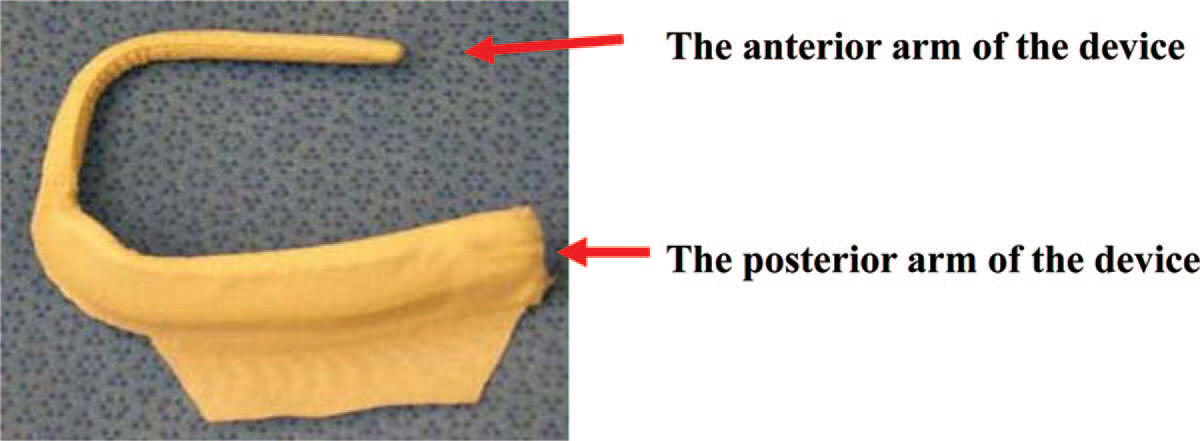 Cleveland
Clinic medical team, an epicardial mitral annuloplasty device
(right) was implanted on the beating hearts of two dogs in less
than 30 seconds. The device reduced the septal-lateral (S-L) dimension
of the mitral annulus (the ring that is attached to the mitral valve
leaflets) dimension and eliminated mitral regurgitation without
requiring the use of a cardiopulmonary bypass. The device, called Mitral
Touch, is manufactured by MAQUET Cardiovascular LLC of San Jose,
California.
Cleveland
Clinic medical team, an epicardial mitral annuloplasty device
(right) was implanted on the beating hearts of two dogs in less
than 30 seconds. The device reduced the septal-lateral (S-L) dimension
of the mitral annulus (the ring that is attached to the mitral valve
leaflets) dimension and eliminated mitral regurgitation without
requiring the use of a cardiopulmonary bypass. The device, called Mitral
Touch, is manufactured by MAQUET Cardiovascular LLC of San Jose,
California.
January 2010: Dr. Mark Oyama summarizes research into the possible roles of serotonin (5HT) and transforming growth factor-b in transforming valvular interstitial cells (VIC) into a more active myofibroblast, which is an important component of MVD in cavaliers. See his "insights". Also check out his September 2009 entry, below. Dr. Oyama also suggests that ketaerin, a 5HT-R2A receptor blocker, or GR55562, a 5HT-R1B receptor blocker, may be effective in dealing with serotonin's affect on dogs' mitral valves.
RETURN TO TOP
2009 News
December 2009: Research physicians at the University of Pittsburgh conduct experimental mitral valve repairs on dogs, using radiofrequency ablation (RFA). The RFA energy is applied to the deteriorating valve flaps and chords, resulting in controlled damage which has the affect of qualitatively reducing the leaflet surface and the chordal length. The researchers found that the result of the application of RFA was to reduce the mitral regurgitation by statistically significant amounts. Read the details below.
November 2009: ACVIM's "Guidelines for the Diagnosis and Treatment of Canine Chronic Valvular Heart Disease". A panel of board certified veterinary cardiologists have published a "Consensus Statement", classifying the stages of MVD and the recommended treatment at each stage.
September 2009: The Serotonin Concentration Studies Continue. "Healthy CKCS dogs had significantly higher serum [serotonin] 5HT concentrations than other healthy dogs predisposed to DMVD [degenerative mitral valve disease]," concludes the University of Pennsylvania team studying serontonin's connection to mitral valve disease (see the January 2009 Current Research entry below) in its report to be published in the November/December 2009 issue of the Journal of Veterinary Internal Medicine. They also found that "Dogs with DMVD had significantly higher serum 5HT concentrations when compared with large breed control dogs."
August 2009: Researchers need dogs with Grade 3 heart murmurs. [NOTE: See July 2011 entry: "HECTOR Study fizzles out"] HECTOR Study: Free screening tests -- a consultation ,an echocardiogram, chest radiographs, blood sample analysis and ECG -- are included. At several veterinary schools, the University of Pennsylvania's Veterinary Hospital (VHUP), in Philadelphia, PA, Washington State University's veterinary medicine's cardiology department, in Pullman, WA, the University of Missouri's veterinary medicine teaching hospital, in Columbia, MO, North Carolina State University's veterinary medicine cardiology department in Raleigh, NC, Cornell University's veterinary medicine cardiology department in Ithaca, NY, and Texas A&M University's (TAMU) veterinary medicine's cardiology department, in College Stations, TX, as well as the Animal Medical Center in New York City, and the MedVet Medical and Cancer Center for Pets in Worthington, Ohio, are recruiting dogs for a study evaluating a beta-blocker to treat heart disease due to MVD. All breeds are eligible. The dogs must have at least a Grade 3 murmur, be at least a year old, and have never had any clinical signs of heart disease of any kind.
Dogs included in the study will receive the beta-blocker or placebo, and will be required to return for rechecks four times the first year and twice yearly each year after. The study's title is "Clinical Evaluation of the Efficacy and Safety of a Beta-blocker Medication used to Treat Heart Disease due to Chronic Valvular Heart Disease".
The beta-blocker being tested is not one of the ones commonly being prescribed and is administered in liquid form. It is a selective andrenoceptor blocker, identified as BAY 41-9202. The researchers hope to have up to 400 dogs participate in the study, over up to a four year period. The study is sponsored by Bayer Animal Health.
June 2009: Japan Surgeons Report Successful Repairs to CKCS Mitral Valves. Nihon University veterinary surgeons have been conducting "mitral valve plasty" surgery on cavalier King Charles spaniels and other small dogs since 2006. Mitral valve plasty involves suture repairs to the mitral valve leaflets and includes the insertion of artificial chords made of a polymer, expanded polytetrafluoroethylene (e-PTFE). They report in a 2009 journal article, "Mitral Valve Plasty in 11 Cavalier King Charles Spaniels", that "these results suggest that mitral valve plasty is beneficial in CKCS with MVD."
While two of their CKCS patients died during the post-operative study due to complications, and three were diagnosed with syringomyelia, the researchers found that among the nine survivors, "at 1 and 3 months after surgery, the left atrial to aortic root diameter ratio ... and the plasma atrial natriuretic peptide level ... were lower than those before surgery ... There were also significant improvements in the number of prescribed cardiovascular drugs 1 month after surgery ... and in the cardiac murmur grade ... ."
January
2009: Colorado State Univ. researchers to test drug inhibiting
serotonin in mitral valves.
 Dr. E. Christopher Orton
(right)
of the of Colorado State University's James L. Voss Veterinary Teaching
Hospital and its Animal Heart Center in Ft. Collins, Colorado, and
Dr. Sirilak Disatian, have issued
a report on their study begun in
June 2008, "Autocrine
Serotonin and TGF-beta Signaling in Human Myxomatous Mitral Valve",
which has been sponsored by the American Heart Association. The researchers
have found that serotonin is created locally in heart mitral valves, thereby
causing pathologic changes in the valves, resulting in their malfunction.
Dr. E. Christopher Orton
(right)
of the of Colorado State University's James L. Voss Veterinary Teaching
Hospital and its Animal Heart Center in Ft. Collins, Colorado, and
Dr. Sirilak Disatian, have issued
a report on their study begun in
June 2008, "Autocrine
Serotonin and TGF-beta Signaling in Human Myxomatous Mitral Valve",
which has been sponsored by the American Heart Association. The researchers
have found that serotonin is created locally in heart mitral valves, thereby
causing pathologic changes in the valves, resulting in their malfunction.
Serotonin is made by an enzyme called tryptophan hydroxylase 1 (TPH1). Serotonin then goes into the blood stream where it is picked up by platelets which are involved in blood clotting. Orton's group has shown that TPH1 is present in high levels in abnormal mitral valves from both dogs and humans.
Dr. Orton's group is seeking to find what triggers the enzyme in the valve which produces the serotonin. He plans to start a clinical trial on dogs to examine the impact of a drug that inhibits the enzyme that produces serotonin in the heart.
See also June 2008 entry for Dr. Mark Oyama.
RETURN TO TOP
2008 News
October 2008: UK Kennel Club to Add "Health Plan" to Cavalier King Charles Spaniel Breed Standard. The (UK) Kennel Club announced that it will include a "breed health plan" in the CKCS breed standard, to "ensure that no dog is bred for features that might prevent it from seeing, walking and breathing freely." A meeting to include representatives of the UK's cavalier club and cardiologists is set for December 1. The club expects to issue the CKSC health plan by early 2009.
The UK club also is asking the UK government to "give it statutory powers to make its established Accredited Breeder Scheme compulsory throughout the country. If successful, this would mean that all breeders who are not part of the scheme and who have not officially confirmed their willingness to follow the health standards set by the Kennel Club would be unable to produce or sell puppies within the law." Additionally, the UK's cavalier breed club is "now required to adopt the Kennel Club's Code of Ethics, to ensure that their practices fall in line with Kennel Club policy for putting the health and welfare of puppies first. This includes a clause that explicitly forbids the compulsory culling (killing) of healthy puppies." See website www.thekennelclub.org.uk
September 2008: UK Kennel Club and British Veterinary Association Plan Possible Heart Testing Protocol for Cavalier Breeding Stock. On September 15, 2008, the UK Kennel Club and British Veterinary Association representatives met with representatives of UK cavalier King Charles spaniel clubs to discuss introducing a heart testing scheme, which would be applied to CKCS and three other breeds. The test results would be published in the Kennel Club's breed registration quarterly supplements and on the progeny's registration certificates. The group plans to meet again in December to consider adopting the scheme. The UK Kennel Club also is looking at ways by which breeders could access health results of dogs/ bloodlines. This service will be available to breeders and pet owners.
July 2008: ACVIM Announces "ARCH" -- New Registry of Cardiac Health. The board certified cardiologists of the American College of Veterinary Internal Medicine (ACVIM) have introduced a new registry, ARCH, to certify dogs' hearts are clear of mitral valve disease and other genetic heart disorders. ARCH certifications are issued only by board certified veterinary cardiologists. Look for the ARCH symbol and check out the website.
June 2008: Serum Serotonin Concentration Is Elevated in CKCSs. University of Pennsylvania Drs. Jason W. Arndt, Mark A. Oyama, and C. A. Reynolds have completed initial research showing that CKCSs have higher levels of serotonin (5-HT) than other breeds which are pre-disposed to MVD. (CKCS, 903.9 [321.5] ng/ml vs. non-CKCS, 536.0 [153.7]; P50.004). The team studied 51 dogs, including 32 cavaliers, which either were affected with or pre-disposed to MVD (CKCSs as a breed are pre-disposed to MVD), plus 28 control dogs. They report: "In humans, elevated serotonin (5-HT) is associated with development of valvular lesions. Canine mitral valve cells demonstrate dose-dependent 5-HT-mediated ERK1/2 signaling, suggesting a possible link with canine DMVD. ... Our results suggest that 5-HT may play a role in the development of DMVD in small breed dogs, and in particular in the CKCS. Further studies involving the relationship between 5-HT, DMVD, breed, and platelet number, morphology, and function are warranted."
Meanwhile, at Colorado State University, Dr. E. Christopher Orton of the of CSU's James L. Voss Veterinary Teaching Hospital and its Animal Heart Center in Ft. Collins, Colorado, has started a study, "Autocrine Serotonin and TGF-beta Signaling in Human Myxomatous Mitral Valve", which is sponsored by the American Heart Association.
May 2008: Auburn University Researchers Find Possible Link Between Oversized Platelets and MVD in Cavaliers. A team of researchers at Auburn University in Alabama (Drs. B. Davis, M. Toivio-Kinnucan, S. Schuller, M.K. Boudreaux) determined that "a mutation in the gene encoding β1-tubulin correlated with macrothrombocytopenia in CKCS." They concluded that "this information will aid in distinguishing inherited from acquired thrombocytopenia. It also provides insight into the mechanism of platelet production by megakaryocytes, and also may prove useful in understanding heart-related changes in macrothrombocytopenic CKCS with concurrent mitral valve regurgitation." See citation below.
May 2008: Researchers Need Heart Tissue From Deceased MVD Canines. Dr. Allison M. Heaney, board certified veterinary cardiologist, heads a research program at the College of Veterinary Medicine at Washington State University studying the difference in the balance between these proteins affecting collagen in normal cultured mitral valve cells and mitral valve cells cultured from diseased leaflets. Differences that exist between normal and diseased valve cells will help target future research projects and aid in determining the cause of the breakdown of collagen in diseased valve cells.
Dr. Heaney is requesting mitral valve tissue from dogs of any breed that have died or have been euthanized that have significant degenerative MVD. The valve tissue will be used to culture cells from the tissue in order for the researchers to study the disease from a cell culture perspective. For inclusion in the study, dogs need to have a diagnosis of degenerative mitral valve disease from their veterinarian (if echocardiography findings are available, those should be provided as well) and the owner needs to be willing to let their referring veterinarian remove the mitral valve from the dog after it dies or is euthanized. The tissue should be removed within 2 hours of death or euthanasia.
She requests that the anterior mitral valve leaflet (the larger leaflet most associated with the septum and aorta) -- but if there is any confusion the entire mitral valve can be shipped and they can collect the anterior mitral valve leaflet once it arrives here. The sample should be shipped in phosphate buffered saline. If needed, the researchers can ship tubes of phosphate buffered saline for sample collection. The sample should be shipped on ice overnight to the address below. For more information, contact Dr. Heaney or her research technician, Marsha Robertson, at Department of Veterinary Clinical Sciences, College of Veterinary Medicine, Washington State University 100 Dairy Road, Pullman, WA 99164-1120, telephone 509-335-0711, fax 509-335-0880, email aheaney@vetmed.wsu.edu, websites: www.vetmed.wsu.edu.This study is supported by AKC Canine Health Foundation, webpage www.akcchf.org/news/index.cfm?article_id=249
May 2008: DNA
Project Needs UK Cavaliers.
 Simon Swift, MA VetMB Cert SAC MRCV
(right), at the
University of Liverpool, heads a DNA study of cavalier King Charles
spaniels. The study is based upon a novel genetic method intended to
discover the genes behind mitral valve disease in the CKCS. The researchers
need 100 cavaliers with early onset MVD (defined as developing mitral
insufficiency before age 4 years or developed signs of heart failure before
8 years) and 100 CKCSs with late onset MVD (dogs over 10 years without a
murmur or with very mild mitral insufficiency). The group also is currently
working to locate qualified dogs in Sweden and Denmark, as well as the UK.
Simon Swift, MA VetMB Cert SAC MRCV
(right), at the
University of Liverpool, heads a DNA study of cavalier King Charles
spaniels. The study is based upon a novel genetic method intended to
discover the genes behind mitral valve disease in the CKCS. The researchers
need 100 cavaliers with early onset MVD (defined as developing mitral
insufficiency before age 4 years or developed signs of heart failure before
8 years) and 100 CKCSs with late onset MVD (dogs over 10 years without a
murmur or with very mild mitral insufficiency). The group also is currently
working to locate qualified dogs in Sweden and Denmark, as well as the UK.
If you live in the UK and have a dog which meets these standards, contact Mr. Swift about obtaining blood samples and pedigrees: (1) Dogs under 4 years with a loud murmur. (2) Dogs under 8 years that have developed heart failure. This does not necessarily mean a cough. They should also have breathlessness, weight loss, and exercise intolerance. They should also need medication. (3) Dogs over 8 years with no murmur or a very quiet one. A cardiologist should examine the dog. There will no charge if the examination is coordinated with Mr. Swift at a participating centre. The researchers are prepared to travel to examine large groups of dogs. The team is rganising a health clinic in Bagworth on September 27, 2008. If you can attend with a suitable dog, please bring your pedigree.
You may contact Mr. Swift at: Small Animal Teaching Hospital, The University of Liverpool. Leahurst, Chester High Road, Neston, Cheshire CH64 7TE; telephone (0151) 795 6100, fax: (0151) 795 6101, email sath@liv.ac.uk, website www.liv.ac.uk/sath/index.htm
March 2008: Reducing Rejection of
Replacement Mitral Valves.
 Dr. E. Christopher Orton
(right) of Colorado State
University's Animal Heart Center in Ft. Collins, Colorado leads a team
researching the use of "tissue engineering" to build a better replacement
for canine heart valves. "All replacement heart valves in use today are
based on non-living tissues and have limitations," said Dr. Orton in an
interview published in CSU's Insight magazine, Spring 2008 issue. "In
humans, there are two options, a mechanical valve that requires the patient
to be on blood thinners for the rest of their lives, or a bioprosthetic
valve, using a pig valve fixed with glutaraldehyde. Humans can tolerate
these valves, but dogs not so much. As a species, dogs are more likely to
reject foreign tissue." Dr. Orton's work focuses on tissue engineering that
studies methods for removing antigens from living tissues and repopulating
the tissue with the animal's own cells.
Dr. E. Christopher Orton
(right) of Colorado State
University's Animal Heart Center in Ft. Collins, Colorado leads a team
researching the use of "tissue engineering" to build a better replacement
for canine heart valves. "All replacement heart valves in use today are
based on non-living tissues and have limitations," said Dr. Orton in an
interview published in CSU's Insight magazine, Spring 2008 issue. "In
humans, there are two options, a mechanical valve that requires the patient
to be on blood thinners for the rest of their lives, or a bioprosthetic
valve, using a pig valve fixed with glutaraldehyde. Humans can tolerate
these valves, but dogs not so much. As a species, dogs are more likely to
reject foreign tissue." Dr. Orton's work focuses on tissue engineering that
studies methods for removing antigens from living tissues and repopulating
the tissue with the animal's own cells.
The team is developing new methods for screening a large number of proteins for antigenicity -- the degree to which a substance induces an immune response, across species. To accomplish this, Dr. Orton's team is using proteomics to look at all of the proteins in the tissues used for bioprosthetic heart valves.
Proteomics is a new focus in the field of biotechnology that enables a system-wide analysis of proteins produced by cells. With proteomics, researchers can detect proteins that elicit an immune response, and subsequently identify the protein antigen, categorize the antigens into broad groups according to their origin, and then place them into smaller categories according to structure, type, physical and chemical properties.
By exposing separated proteins to naturally-occurring and acquired antibodies, Dr. Orton seeks to determine which proteins are responsible for the antigenicity of biomaterials, and this knowledge can be used to develop strategies to selectively remove those proteins. This study is expected to provide important insights about the bioprostheses and about tissue transplantation in general.
RETURN TO TOP
2007 News
September 2007: Indentifying
DNA markers and altered genes that predispose cavaliers to develop
early-onset MVD:
 Drs. Margaret M. (Meg) Sleeper, Petra Werner, and
James Buchanan (right), of the University of Pennsylvania's School of Veterinary
Medicine, are conducting a genetic analysis of CKCS hearts and blood
samples, with the goal to identify DNA markers and altered versions of genes
that predispose cavaliers to develop early-onset mitral valve disease. The
inclusion criteria are CKCSs that develop from grade 3 to grade 6 MVD
murmurs before the age of 5 years; and their immediate relatives (parents,
siblings, and grandparents); and dogs over age 6 years without murmurs. They
are obtaining samples consisting of: 3 mls of EDTA blood. For more
information about sending blood samples to this project, contact either the
ACKCSC trust's Bettina M. Sterling, email Sterlingtoys@aol.com, or Dr.
Werner, telephone number 215-898-8894, email cmichel@vet.upenn.edu. An
application form is available by
clicking here. Drs. Sleeper and Buchanan are
board certified cardiologists. Dr. Buchanan has contributed over sixteen
years of his time to research of MVD in the CKCS. Dr. Werner, who has a
doctorate in molecular genetics from the University of Zürich, has been
leading a team of researchers at the Center for Comparative Medical Genetics
and Section of Medical Genetics at the School of Veterinary Medicine,
University of Pennsylvania for the past ten years in developing a genetic
map of the canine genome.
Drs. Margaret M. (Meg) Sleeper, Petra Werner, and
James Buchanan (right), of the University of Pennsylvania's School of Veterinary
Medicine, are conducting a genetic analysis of CKCS hearts and blood
samples, with the goal to identify DNA markers and altered versions of genes
that predispose cavaliers to develop early-onset mitral valve disease. The
inclusion criteria are CKCSs that develop from grade 3 to grade 6 MVD
murmurs before the age of 5 years; and their immediate relatives (parents,
siblings, and grandparents); and dogs over age 6 years without murmurs. They
are obtaining samples consisting of: 3 mls of EDTA blood. For more
information about sending blood samples to this project, contact either the
ACKCSC trust's Bettina M. Sterling, email Sterlingtoys@aol.com, or Dr.
Werner, telephone number 215-898-8894, email cmichel@vet.upenn.edu. An
application form is available by
clicking here. Drs. Sleeper and Buchanan are
board certified cardiologists. Dr. Buchanan has contributed over sixteen
years of his time to research of MVD in the CKCS. Dr. Werner, who has a
doctorate in molecular genetics from the University of Zürich, has been
leading a team of researchers at the Center for Comparative Medical Genetics
and Section of Medical Genetics at the School of Veterinary Medicine,
University of Pennsylvania for the past ten years in developing a genetic
map of the canine genome.
The American Cavalier King Charles Spaniel Club's charitable trust's Darcy Fund is helping to underwrite this research, and the ACKCSC trust is actively participating in the project by collecting selected blood samples and pedigrees during health clinics around the United States. Financial donations to support this research project may be made by sending checks payable to "Trustees of the University of Pennsylvania", with "Cavalier Heart Fund" in the memo, directly to Dr. Petra Werner, Room 4033, Ryan Veterinary Hospital, University of Pennsylvania, 3900 Delancey Street, Philadelphia, PA 19104-6010. Donations are tax deductible.
June 2007: Dogs needed for reduced rate Ohio State study to improve ultrasound imaging for diagnosing congestive heart failure: Dr. Karsten E. Schober of the cardiology department at the Ohio State University's College of Veterinary Medicine in Columbus, Ohio is looking for dogs with diagnosed heart disease to be a part of a non-invasive study titled: "Can better imaging predict heart failure?". The researchers seek to utilize cardiac ultrasound to identify and stage congestive heart failure (CHF) in dogs. Dogs with asymptomatic dilated cardiomyopathy (DCM) and degenerative mitral valve disease (MVD) and dogs with CHF caused by MVD or DCM will be enrolled.
Any dog with DCM or MVD -- unless treated with high doses of diuretics and no concurrent systemic disease -- is eligible. Participating dogs would be examined twice at the Ohio State Veterinary Hospital, five to fourteen days apart. During these two visits, the dogs will be given a complete physical examination, chest x-rays, an echocardiogram, blood pressure measurement, and a blood sample drawn. Benefits for dog owners include low cost examinations (50 percent cost reduction for the first visit and free second visit), short scheduling and waiting times, and important contribution to a research study that can improve the health of dogs. The results of this study may help to earlier diagnose CHF, better stratify cardiovascular risk, tailor therapy to specific dog needs, and reduce the exposure of personnel and animals to the ionizing radiation required for repeated thoracic radiography.
Contact: Dr. Schober, telephone 614-292-3551, email schober.4@osu.edu, or Laura Spayd, telephone 614-292-3551. Also visit http://www.vet.ohio-state.edu/2404.htm
June 2007: 3-D echocardiographics and image reconstruction of cavaliers with MVD: Dr. Mark A. Oyama at the School of Veterinary Medicine, University of Pennsylvania, is leading a team of investigators to determine whether the heart valves of dogs with MVD possess inherently different geometrical characteristics when compared to those of non-affected dogs. They propose using a novel 3-D echocardiographic technique and specialized image reconstruction to visualize the geometry of the valve annulus and valve leaflets in greater detail. They intend to correlate the valve geometry with disease severity, ventricular function and geometry, and conventional 2-D echocardiographic measurements of mitral valve disease.
June 2007: Pathophysiological aspects of early mitral valve diseases in cavaliers: Dr. Inge Tarnow, at the University of Copenhagen's Department of Animal and Veterinary Basic Sciences, heads a group of specialists studying pathophysiological aspects of early mitral valve disease in cavaliers, including changes in platelet function, hemostatic changes, and prognostic factors. They currently are performing a large longitudinal study of 100 cavaliers with examinations (echocardiographic and blood tests) at ages 2, 4, and 8 years.
June 2007: DNA to discover
genes causing MVD.
 Dr. Clare Rusbridge
(right) at the Stone Lion Veterinary Centre
in the UK is coordinating an international group of geneticists and other
specialists who are researching DNA samples from a variety of categories of
cavalier King Charles spaniels throughout the world, in an effort to
discover the genes causing mitral valve disease. In an April 2006 research
update, Ms. Rushbridge reports that "a full genome scan looking for the
causal gene/s of syringomyelia and mitral valve disease is underway!" The
Cavalier Health Foundation (associated with the Cavalier King Charles
Spaniel Club, USA) has contributed a grant to help underwrite this project.
Donations are tax deductible.
Dr. Clare Rusbridge
(right) at the Stone Lion Veterinary Centre
in the UK is coordinating an international group of geneticists and other
specialists who are researching DNA samples from a variety of categories of
cavalier King Charles spaniels throughout the world, in an effort to
discover the genes causing mitral valve disease. In an April 2006 research
update, Ms. Rushbridge reports that "a full genome scan looking for the
causal gene/s of syringomyelia and mitral valve disease is underway!" The
Cavalier Health Foundation (associated with the Cavalier King Charles
Spaniel Club, USA) has contributed a grant to help underwrite this project.
Donations are tax deductible.
Also participating are Marie Pierre Dube, a genetics epidemiologist at the Montreal Heart Institute, and Dr. Zoha Kibar, the molecular geneticist in charge of fine mapping and identification of the gene(s) defective in MVD and syringomyelia in CKCSs, at Centre for the Study of Brain Diseases, CHUM - Montreal. Dr. Kibar reports in the April 2006 update:
"Both Syringomyelia and Mitral valve disease are particularly common in the cavaliers. Such high incidence in a particular breed as compared to other breeds suggests the involvement of genetic factors. The mode of inheritance including the number, identity and relative contribution of the causative genes is not determined yet. The etiology of both conditions could be further complicated by variable penetrance of the various genotypes and the involvement of environmental factors.
"The first step which is genetic mapping is currently underway. Due to the complex inbreeding in the CKCS, a preliminary genetic analysis was necessary to evaluate the informativeness of the genetic markers and hence the feasibility of a whole genome scan in such breed. Consequently, 10 dogs were selected for genotyping with 122 markers distributed among the 38 autosomes and X chromosome. The markers were found to be sufficiently polymorphic and informative. Next, 200 dogs were selected for a whole genome scan, primarily for Chiari malformation. However with additional phenotypic information on mitral valve disease, it is possible to use the same data to map the gene(s) defective in this disease. The whole genome scan was conducted at the Mammalian genotyping Center at the Marshfield Clinic in Wisconsin, USA. The genotyping data will now be analyzed using both linkage-based and association studies. In the latter, we will be taking advantage of the founder effect demonstrated for both these disorders in the CKCS breed.
"This strategy involves: 1) genetic mapping of the underlying gene(s), 2) identification of these defective gene(s) using the positional candidate gene approach and characterization of the mutation(s) and 3) initial functional characterization of the protein(s) encoded by the gene(s). This will help better understand the underlying pathogenic mechanisms for better diagnosis, prognosis and clinical management of these devastating conditions. These studies will also help unravel some of the complexity involved in this malformation in humans and in the embryonic development of the affected structures."
June 2007: Genomic expression patterns of mitral valve
tissues from dogs with MVD:
 Dr. Mark A. Oyama
(right) at the School of Veterinary
Medicine, University of Pennsylvania, and Sridar V. Chittur, PhD, Center for
Functional Genomics, State University of New York at Albany, have published
"Genomic expression patterns of mitral valve tissues from dogs with
degenerative mitral valve disease" in the August 2006 issue of the American
Journal of Veterinary Research. Their conclusion is that "Evaluation of
global expression patterns provides a molecular portrait of mitral valve
disease, yields insight into the pathophysiologic aspects of DMVD
[degenerative mitral valve disease], and identifies intriguing genes and
pathways for further study."
Dr. Mark A. Oyama
(right) at the School of Veterinary
Medicine, University of Pennsylvania, and Sridar V. Chittur, PhD, Center for
Functional Genomics, State University of New York at Albany, have published
"Genomic expression patterns of mitral valve tissues from dogs with
degenerative mitral valve disease" in the August 2006 issue of the American
Journal of Veterinary Research. Their conclusion is that "Evaluation of
global expression patterns provides a molecular portrait of mitral valve
disease, yields insight into the pathophysiologic aspects of DMVD
[degenerative mitral valve disease], and identifies intriguing genes and
pathways for further study."
June 2007: Repairing damaged heart cells by transplanting stem cells: Dr. Mark A. Oyama at the School of Veterinary Medicine, University of Pennsylvania, is investigating whether dogs' damaged heart cells can be repaired by transplanting the dogs' own stem cells into their hearts, a procedure called cardiac cellular transplantation.
January 2007:
Studying cellular changes that occur as the mitral valve deteriorates:
 Dr. Brendan M. Corcoran
(right) and Richard Han of the veterinary school at the
University of Edinburgh, in collaboration with University College Galway,
are conducting studies of the cell type of cavaliers afflicted with MVD,
including the cellular changes that occur as the mitral valve deteriorates,
assessing affected valves for the presence of a variety of markers that
identify cell types, and determining if there is increased cell enzymatic
activity which could result in valve destruction. The investigating panel
suspects that that reason dogs develop MVD is because of a cell type, known
as a valvular interstitial cell, which is malfunctioning and failing to
produce normal structural components. These components are crucial to
maintaining the valves structural rigidity, its shape and function, and to
prevent it from leaking.
Dr. Brendan M. Corcoran
(right) and Richard Han of the veterinary school at the
University of Edinburgh, in collaboration with University College Galway,
are conducting studies of the cell type of cavaliers afflicted with MVD,
including the cellular changes that occur as the mitral valve deteriorates,
assessing affected valves for the presence of a variety of markers that
identify cell types, and determining if there is increased cell enzymatic
activity which could result in valve destruction. The investigating panel
suspects that that reason dogs develop MVD is because of a cell type, known
as a valvular interstitial cell, which is malfunctioning and failing to
produce normal structural components. These components are crucial to
maintaining the valves structural rigidity, its shape and function, and to
prevent it from leaking.
The study is looking at the structure and appearance of the valve cells using electron microscopy, thereby enabling the researchers to characterize the differences between normal and abnormal cells. The immediate aim of the studies is to prove these cells are abnormal, in what way they are abnormal, and why they are abnormal. In conjunction with that work, they are hope to determine procedures to isolate normal and abnormal cells and investigate the function of the cells in a controlled laboratory environment. See Dr. Corcoran's 2004 article, "Identification of surface morphologic changes in the mitral valve leaflets and chordae tendineae of dogs with myxomatous degeneration", in the American Journal of Veterinary Research.
The Scottish study also involves evaluating the changes in the structural elements (collagen and elastin) in the valves, using routine and special stains for light microscopy, and looking at the expression of immunoglobulins in affected dogs. In a February 2006 interim report, the researchers stated that they are "confident that there are recognisable changes in the cell types that are crucial for maintaining healthy valves, and preliminary data suggests this is resulting in altered protein expression by the valve cells." According to the February 2006 interim report, Richard Han is leading two other projects related to the Scottish study. In the first, he is looking into "the structural change in the valve, particularly the spatial arrangement of the matrix, which gives the valves their structural rigidity and which is disorganised in disease." The researchers are using a powerful x-ray technique to investigate this problem.
Also, Mr. Han is leading a second related study, which is of innervation (nerve supply) of the mitral valve. Dr. Corcoran states that, "We know that a derangement of nerve supply has an adverse affect on valve function and we suspect on valve cells. This study is using immuno-histochemistry to map the innervation of the valve in normal and diseased dogs."
In their January 2007 report to the U.K.Cavalier King Charles Spaniel Club, the researchers state that their work is divided into five categories: (1) Immunohistochemical localization and identification of cell types in affected valves; (2) Quantification of cellular changes in diseased valves; (3) Identification of alteration in connective tissue elements and the factors that control these elements; (4) Evaluation of alteration in endothelial cell morphology and function; and (5) Analysis of differential protein and gene expression in diseased valves.
Dr. Corcoran concludes in his January 2007 report that, "We have identified fundamental changes in the valve that were not previously known and we have also identified the nature of change that occurs with disease progression. We have begun to look at the more fundamental changes that occur at the gene expression level and the consequence of changes in gene expression, namely what protein are expressed or absent. Like all research, this project has answered some questions, but has also raised new questions that will need investigation. Historically, we have known very little about the mitral valve disease in either dogs or humans and by its very nature this type of research slowly fills in the gaps in our knowledge hopefully eventually leading to the answer to the question of why does mitral valve disease occur."
Dr. Corcoran next (as of May 2007) is proceeding to investigate the phenomenon of interstitial cell phenotypic change further, using proteomics (two-dimensional gel electrophoresis) to identify potential proteins of interest. He states that, "From these data, in future studies we would use RT-PCR to identify differential gene expressions and identify potential genes of interest." The American Cavalier King Charles Spaniel Club's charitable trust's Darcy Fund, is helping to underwrite Dr. Corcoran's new area of research. Donations are tax deductible.
Dr. Corcoran may be reached at telephone 0131 650 6070, email Brendan.Corcoran@ed.ac.uk Mr. Han's telephone number is 0131 650 7680.
RETURN TO TOP
2005 News
September 2005: Swedish mortality studies of 350,000+ dogs confirm cavaliers are at highest risk of heart disease death. In two September 2005 articles [Article 1] [Article 2] by a team of Swedish researchers (A Egenvall, BN Bonnett, Å Hedhammar, P Olson) analyzing the deaths of over 350,000 dogs, they not surprisingly found that cavalier King Charles spaniels' leading cause of death is heart disease, and that the CKCS leads the list of breeds dying of heart disorders. They stated:
"Heart disease in the Cavalier King Charles spaniel accounts for over 50% of deaths in that breed (in dogs under 10 years of age) and for over one-quarter of the heart deaths in the insured population. Although heart disease in Cavalier King Charles spaniels is well recognized, these statistics give further insight into the impact of this cause of death in this breed."
Their charts show some interesting comparisons. Figure 1 at left shows the mortality rates for cavaliers' total and diagnostic mortality, as well as for the categories tumours, trauma, locomotor problems and heart. Figure 5 at right shows mortality rate ratios (MRR) from the heart model are shown by breed, age and gender (F-female, M-male) for a few selected breeds, as well as for the baseline.
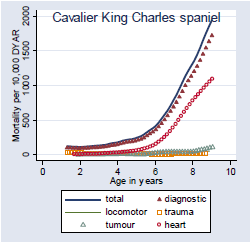
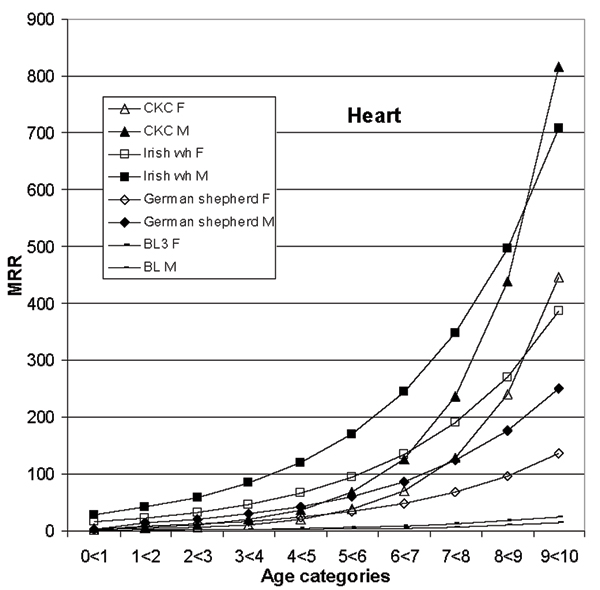
Table 1 below, as noted, shows the probability of death by ages 5, 8, and 10 years. The full table included 20 other breeds, but the CKCS was at the top of the list.

It shows that, while only 7% of Sweden's cavaliers were dead by five years of age, 23% were dead by eight years, and 48% were dead by ten years.


CONNECT WITH US